





Marriott SpringHill Suites Winter Park 1127 N Orlando Ave, Winter Park, Florida 32789
Thursday, November 3, 2022 Session I: 10:00 AM EDT Session II: 4:00 PM EDT Session III: 8:00 PM EDT
Friday, November 4, 2022 Session IV: 10:00 AM EDT Session V: 3:00 PM EDT Session VI: 6:00 PM EDT Session VII: 7:00 PM EDT
Daniel Frank Sedwick, LLC P.O. Box 1964
Winter Park, FL 32790 U.S.A.
Fax (407) 975-3327
Bid LIVE at
Auction and catalog production by Daniel Sedwick, Augi García-Barneche, Cori Sedwick Downing, and Connor Falk Daniel Frank Sedwick, licensed Florida auctioneer #AU3635, AB2592
All images and
of Daniel Frank Sedwick, LLC, 2022. All rights reserved.
By participating in this auction, you (hereafter referred to as the “Bidder”) are entering into a binding contract with Daniel Frank Sedwick, LLC (“Auctioneer”) and agree to the following Terms and Conditions:
1) Each lot will be sold to the highest Bidder unless the reserve or starting price is not met. Bids may be submitted in person or by mail, telephone, fax, email, or live on the Internet until each lot is closed during the live session. All non-live bids must be received before the auction session begins. The Auctioneer or any of its employees individually cannot be responsible for errors in bidding or the loss or delay of any bids that do not reach us by the closing date and time, or for any technical glitches that prevent internet bids from being executed. All bidders must be registered before their bids will be entered. New bidders must register 72 hours prior to the auction so that references can be verified, otherwise their bids may not be accepted. All bids are in U.S. dollars.
2) Winning bids will be reduced automatically by the iCollector platform to the next increment above the second-highest bid. In the case of tie bids, the earliest bidder will win the lot. Bidders are advised to provide allowable percentage increases to avoid losing lots due to a tie.
3) A winning bid is a contract between the winning Bidder (hereafter referred to as the “Buyer”) and the Consignor. The Buyer, even if acting as an agent for someone else, agrees to purchase the lot(s) he has won and to pay the Buyer’s Premium and any shipping costs, sales tax, bank-wire fees, customs duties, or other surcharges involved in delivering the lot(s) to the Buyer. Certain lots (particularly artifacts) may require special packaging and handling, for which a surcharge will be levied (also note shipping calculations will delay invoicing). In some special cases delivery may be arranged directly between the Consignor and the Buyer, at the buyer’s cost. At no time shall the Buyer have any legal recourse against the Consignor for any reason. Buyers will be notified as soon as possible after the auction with an invoice reflecting the total amount due and shall remit payment within 15 days of the invoice date. Buyers who do not receive notification for whatever reason are NOT released from their obligation to pay on time. If payment has not been received within these terms, the Auctioneer reserves the right to sell the lot(s) to any under-bidders for their lower bid amounts. If the winning bidder provides a credit card before the sale, Daniel Frank Sedwick, LLC reserves the right to charge the credit card for the total of the auction purchases if payment has not been received within thirty (30) calendar days. Title to each lot does not pass until the item has been paid in full. Any late payments (30 days past invoice date) will be assessed an accrued interest charge of 5% per month.
4) Lot pickup will be available after the auction (not during). Any lots not picked up in person (unless other arrangements are made) will be sent to Buyer via U.S. Mail when the invoice has been paid in full. All domestic shipments will carry full insurance, but foreign shipments are made at the Buyer’s risk (insurance available in some cases). Daniel Frank Sedwick, LLC is responsible for loss or damage to lots only up until they are received at the address to which they are sent; any transshipment from there is the buyer’s responsibility alone. Any special instructions for shipping, delivery or payment must be in writing (letter, fax, email or text) and will be effective only upon confirmation by us (verbal requests may not be honored). Generally, lots will be shipped in the order in which they are paid.
5) Due to new UK and EU regulations regarding VAT collection on international purchases, we are no longer able to ship orders under £135 to the United Kingdom or under €150 to any countries in the EU.
6) A Buyer’s Premium of 20% will be added to the winning bid for the total purchase price before any applicable taxes, fees or surcharges. Any payments by credit/debit card will incur a 2% surcharge on the total; payments by PayPal will include a 4% surcharge.
7) Acceptable forms of payment are cash, check, echeck, money order, wire transfer, direct deposit, PayPal, Zelle, Visa/MC, American Express and Discover. All payments by check or money order should be made payable to Daniel Frank Sedwick, LLC. Payments per auction and per buyer are limited to the following amounts: PayPal and Zelle (to auction@sedwickcoins.com), $2,500; credit card, $10,000; checks, $100,000 (must be paid via wire beyond that). All payments shall be in U.S. dollars drawn on a U.S. bank. Please contact us for instructions for wire-transfer payments, for which bank charges may be necessarily added to the amount to be paid, generally depending on the country from which the wire originates. Note: Overseas/international wires are not allowed for amounts below $1000.
8) New bidders who do not have established credit with us must supply commercial references in the numismatic field and/or a 25% deposit. Credit cards are acceptable in lieu of a deposit. If your bids are unsuccessful, your deposit will be refunded, but if you are a winning bidder, your deposit will be applied to your purchase unless other arrangements are made. Any bidders with an overdue balance with Daniel Frank Sedwick, LLC must complete payment of their previous balance before their bids will be accepted.
9) Bidders have several options for bidding method: Bids prior to the auction may be submitted by mail, fax, email, or in person, or by bidding online directly on iCollector or via NumisBids. During the live auction, bids may be executed only in person, online directly on iCollector, or by phone by prior appointment. Phone bidding is offered only as a courtesy and we do not guarantee any line condition or accessibility during or before the auction. You must remain available to receive our call when the lots you wish to bid on come up. Proxy bidders (prior to live) have the option of preemptive bidding, in which our system will place a full maximum bid amount during live bidding when the asking price is a single increment under the maximum bid, which means it might skip and move to the maximum bid during live bidding, even if past the increment. Preemptively bidding at your maximum protects you by using your full maximum to prompt one increment higher from your competition. Example: Your secret maximum is $500 with $25 increments, starting at $425, and someone has bid against you at $450. Normally your bid would be increased to $475, but with preemptive bidding the system will place your maximum amount of $500 so that your maximum will not be tied by the next bid. This preemptive bidding only occurs when the asking price is a single increment below your maximum. As always, a higher bid amount can still outbid you.
10) Most lots are unreserved, but some lots do have a reserve or minimum bid assigned by the consignor. Any reserve will generally be at or below the stated low estimate and starting price. All estimates are given in U.S. dollars.
11) As an active dealer, Daniel Frank Sedwick, LLC is able to estimate a reasonably low wholesale level for each lot and reserves the right to reject any bids below this level (generally at least 70% of low estimate). Furthermore we reserve the right to reject any bids that we have reason to believe are not submitted in good faith. Starting bids are provided on iCollector when the auction is published, and bids below those starting bids cannot be entered. Prices realized do not necessarily reflect accurate market values so much as what the high bidder is willing to pay based on his own needs.
12) All items are guaranteed genuine and as described. Daniel Frank Sedwick, LLC does NOT guarantee that any lots can be successfully encapsulated. Auctions are NOT approval sales, and therefore returns will NOT be accepted UNLESS there was an error in the listing. Note that grading and estimation of corrosion are subjective and differences of opinion cannot be considered errors. Lots encapsulated by PCGS, NGC or any other third-party company may not be returned for any reason. Disputes as to authenticity shall be resolved by submission to PCGS or NGC, and if their determination is inconclusive, then the opinion of Daniel Frank Sedwick, LLC shall stand. Any disputes, including proposed returns, must be brought to our attention no later than
2 days after receipt of the lot(s) by the Buyer and BEFORE return shipment to us, with any applicable refunds to be made immediately upon receipt of the returned item(s) by us. All returns must be received by us in unaltered condition and in their original, unopened, sealed flips no later than one month after the date of the first auction session (note that late remittance, therefore, can negate return privileges). Any refunds for returns paid for by credit card will be subject to a 2% return fee; those paid by PayPal will incur a 4% return fee. In the event of loss or damage, Daniel Frank Sedwick, LLC’s liability shall be limited to the hammer price plus buyer’s fee only. NGC or PCGS census data (“finest known,” etc.) are given based on the date of cataloging and are not presumed to be accurate forever. Note that any group-lots returned due to error in listing must be returned in entirety. Where not already included in the lot description, we will provide our own certificate of authenticity upon request by the buyer for a fee.
13) In case of loss or theft the guaranty is limited to either the reserve price (if unsold) or the hammer price plus buyer’s fee (if sold). Any extra expenses incurred by the winning bidder or consignor in order to bid, inspect, consign or pick up the lots are not covered and are the sole responsibility of the winning bidder/consignor. Any potential or speculative value is not guaranteed.
14) Lots may be inspected before the auction at our private office in Florida by appointment only between Monday through Friday, 10 a.m. to 4 p.m. Eastern Time. High-quality photos of all items are viewable on our website and on iCollector 24 hours a day, 7 days a week. All photographs in the catalog and online are of the actual lots being sold but may not be actual size or to scale. Color and brightness of online photos may vary according to your monitor and video-card specifications. We welcome requests of additional photos or HD video of the items to be sold. Photos taken by grading services may be included in the online lot listings; they may differ in color and brightness plus the holder prongs may not be visible.
15) If buyer does not supply a Florida resale certificate, then Florida sales tax will apply as follows: If picked up in person, 6.5% will be added to the total (hammer plus buyer’s fee) for all items that are NOT coins or bullion, and to all non-U.S. coins whose cumulative total is less than $500. Same applies to lots shipped to Florida addresses, but the rate (6% to 7.5%) will be according to county of delivery. There is no Florida sales tax on U.S coins or on any lots shipped out of state, or total coin/bullion purchase over $500.
16) All bidders and consignors acknowledge and agree that the Auctioneer (Daniel Frank Sedwick, LLC) does NOT guarantee that auctions will be unimpaired, uninterrupted or error-free and accordingly shall not be liable for such eventualities. Any errors in the printed catalog will be rectified on the website and iCollector as they come to our attention, and those corrected listings shall be deemed the binding descriptions at the time of the auction. The Auctioneer in its sole and absolute discretion may accept or decline any bid, remove bids and reopen bidding, withdraw lots, or change lot sequence or bidding increments at any time, even after the winning bid and winning bidder have been announced. Any bidding disputes shall be adjudicated by the Auctioneer, whose decision shall be deemed binding and final.
17) This auction is conducted in accordance with the auction laws of the State of Florida. The licensed auctioneer is Daniel Frank Sedwick, AU#3635, AB#2592. The Auctioneer and Bidder agree that the venue for all claims and disputes shall be the applicable court having jurisdiction in Orange County in the State of Florida, and that the prevailing party shall be entitled to all attorneys’ fees and costs. THE BIDDER AGREES TO WAIVE THE RIGHT TO A JURY TRIAL.
18) All Bidders must meet Auctioneer’s qualifications to bid. Any Bidder who is not a client in good standing of the Auctioneer may be disqualified at Auc tioneer’s sole option and will not be awarded lots. Such determination may be made by Auctioneer in its sole and unlimited discretion, at any time prior to, during, or even after the close of the Auction. Auctioneer reserves the right to exclude any person or company from the Auction. Daniel Frank Sedwick, LLC reserves the right to reject any bids suspected not to be submitted in good faith. If an entity places a bid, then the person executing the bid on behalf of the entity agrees to personally guarantee payment for any successful bid.

This catalog contains some great worldwide numismatic rarities - a perfect appeal to this robust and enthusiastic market. With Session I, we have a variety of Gold Cobs - both from Spain as well as the New World. Spain sees the finest and only graded 1690 (M) Seville-minted gold cob 8 escudos in NGC MS 64 (lot 22). The New World selection holds some high grade and rarer 1715 Fleet gold including a discovery piece Bogotá 1712/1 gold cob 2 escudos graded NGC MS 66 (lot 60), a Mexico City gold cob 8 escudos 1713 J graded NGC MS 64 (lot 26), a Lima gold cob 8 escudos 1708 H graded NGC MS 63 pedigreed to the John Pullin Collection (lot 44) and two different varieties of Cuzco gold cob 2 escudos 1698 M both in NGC MS 63 holders (lots 41 and 42). Among non-shipwreck gold cobs, there is the “top pop” Lima gold cob 8 escudos 1729 N graded NGC MS 62 (lot 47) plus the substantially difficult Lima gold cob 8 escudos 1748 R graded by NGC as MS 63.
A wide variety of Shipwreck Ingots includes two hefty gold “finger” bars from the Atocha (1622) from the J.P. Silberman Estate (lots 71 and 72), a fascinating 28.75 kilogram silver ingot from the Maravillas (1656) with original uncleaned coral encrustation (lot 79), and a rectangular gold bar weighing 915 grams from the Corrigan’s wreck site of the 1715 Fleet with ties to Florida salvage history (lot 73). In addition, we have three lustrous gold disk ingots recovered from the Luz (1752) (lots 74-76) whose origins are analyzed by Daniel Frank Sedwick in this catalog’s feature article.
Our popular Shipwreck Coins section features an assortment of high grade Atocha coins (lots 94-183) - this year marks the 400th anniversary of its sinking off the Key West. Many of these also come with vintage Mel Fisher certificates of interest to the salvage history col lector. Notable coins include a very rare French gold louis d’or 1723-Z from the Chameau (1725) (lot 279), a Santiago gold bust 8 escudos 1751 J from the Luz (1752) graded NGC MS 62 (lot 298), and a clump of seven US Seated Liberty silver half dollars from the SS Republic (1865) - the first time we have offered a clump from this wreck (lot 316).
We’ll begin Session II with our second offering of selections from the Clyde Hubbard Collection of Charles-Joanna Coinage (lots 323-393) in Mexico Silver Cobs with notable rarities like the “Early Series” 4 reales with assayer P to right (lot 323) and the very difficult “Late Series” 4 reales of assayer S unlisted in Nesmith (lot 332). The finest known NGC-graded Lima 8 reales 1684 V in an NGC AU 53 holder (lot 422) stands out in our Lima Silver Cobs section. Watch for some well-struck Royals in Potosí Silver Cobs like the very rare Louis I 8 reales Royal of 1727 Y (lot 485) or the impressively defined 8 reales Royal of 1680 V with pomegranate above the pillars (lot 465).
We’re pleased to host the Gansu Collection of Chinese Panda Coinage in Session III representing 250 lots of very high grade and rare examples from 1982 to 2005 of the iconic Chinese flagship coin series. Some of the series’ greatest rarities make appearances - the 1995 large and small date gold 50 yuans graded NGC MS 69 (lot 646 and 641), the “top pop” 1998 large date 50 yuan graded MS 69 (lot 693), and a gorgeous denomination set of the 1992-P proof gold Pandas (lot 603).
The second day of our auction begins with World Coins in Session IV. Desirable coins from across the globe will be sold - from the finest NGC-graded Seville, Spain, gold 8 escudos 1701 M graded NGC MS 65 (lot 1080) to the extremely rare and finest Lima, Peru, gold 4 escudos 1838 M graded NGC AU 53 and pedigreed to the Hammel and Goodman Collections (lot 1040). A pair of key Venezuelan rarities are being offered for the first time publicly in this sale: a gold essai 5 venezolanos 1875-A graded NGC PF 62 Cameo (lot 1115) and a silver essai 1/2 real 1863 E graded NGC SP 61 (lot 1114).
In Session V’s Medals and Decorations, we’ll host our third offering of Admiral Vernon medals from the John Adams Collection (lots 1127-1201). Several very rare silver Bolívar medals are also available such as the Colombia 1828-dated “Bolívar saved from assassination” medal graded NGC AU 58 (lot 1120) and the Bolivia 1825 “Potosí Gratitude to Bolívar” medal (lot 1118). One of the top lots in the entire auction resides in US Coins and Medals: the unique proof silver Declaration of Independence medal crafted by Charles Cushing Wright in the 1850s and based on John Trumbull’s famous 1818 painting (lot 1238). This special medal bears a pedigree chain going back to the original owner, Charles Ira Bushnell, and continuing on to notable collectors such as John Work Garrett and the aforementioned John Adams.
US Paper Money holds the tough South Carolina 7 shillings 6 pence note of 1778 (lot 1241) along with Continental Congress half dollar note of 1776 designed by Benjamin Franklin (lot 1242). In World Paper Money, rare Cuban revolutionary notes like the Junta Central Republicana 10 pesos of 1869 graded PMG VF 25 (lot 1269) and the high-denomination República de Cuba 1000 pesos note of 1869 signed by Carlos Manuel de Céspedes graded PMG XF 40 (lot 1268) are on display.
The Coin Jewelry selection in Session VI hosts some beautiful Spanish colonial coins in jewelry mounts ready for wearing like a Lima gold cob 8 escudos of Philip V in an 18-karat pendant setting (lot 1292) as well as a Bogotá gold cob 2 escudos from the 1715 Fleet in a 14-karat gold anchor pendant (lot 1293). For the ultimate 1715 Fleet collector, we have an impressive conserved iron signal cannon from the Fleet, still possessing much original detail like the full yoke and lifting handle “dolphins” (lot 1340) in Shipwreck Artifacts. Within NonWreck Artifacts, there is a “duel-ready” pair of European flintlock pistols from the 1700s (lot 1344).
Our Express session features some 400 lots of more cost-efficient coins, paper money, and artifacts. We aptly end this auction on lot 1622, the year of the Atocha and Santa Margarita’s sinking. We wish you the best of luck in this auction!
The Daniel Frank Sedwick, LLC team:
Daniel Sedwick, Agustín (Augi) García-Barneche, Cori Sedwick Downing, Connor Falk
Cobs
Article:
SESSION I: 10:00 AM EDT
Study
The Clyde Hubbard Collection
Cobs of Mexico City,
Cobs of Lima,
Cobs of Potosí, Bolivia
from the Gansu
SESSION II: 4:00 PM EDT
Coins (by country)

and Decorations
Paper
SESSION III: 8:00 PM EDT
SESSION IV: 10:00 AM EDT
SESSION V: 3:00 PM EDT
SESSION VI: 6:00 PM EDT
Jewelry
SESSION VII: 7:00 PM EDT
Session
149-212
213-232
233-240
241-244
245-252
253-260
As the world’s leading purveyors of New World cobs and shipwreck coins, we have always separated and highlighted our cob and shipwreck offerings from the rest of what we sell. We have preserved that arrangement in our auctions as well, with cobs presented in order of establishment of each mint and the shipwreck coins, ingots and artifacts presented in chronological order by wreck.

Where possible, in the description for each lot we supply one or more numbers in reference to acknowledged publications in the field. References used in this catalog include the following:
Cal = Calicó’s Numismática española (2019), formerly by Calicó and Trigo (ten previous editions). Note: In previous auctions we referred to the 2008 edition as CT-, but we now refer to the 2019 edition as Cal-, for the numbers changed and we want to keep the old CTreference intact for anyone who refers to our older auctions.
Fonrobert = Fonrobert’s Sammlung uberseeischer Munzen: III. Abtheilung Sud-Amerika (1878).
Janson = Janson’s La Moneda Circulante en el Territorio Argentino 1574-2015 (2016).
KM = Krause-Mishler’s Standard Catalog of World Coins, various editions, including Spain, Portugal and the New World. Restrepo = Restrepo’s Monedas de Colombia, 1619-2006, fourth edition (2012).
S = Sedwick’s The Practical Book of Cobs, fourth edition (2007).
Sp = Spink’s (formerly Seaby’s) Coins of England and the United Kingdom, fiftieth edition (2015).
A list of other, more specialized references used in our catalogs is available at www.sedwickcoins.com/references.htm
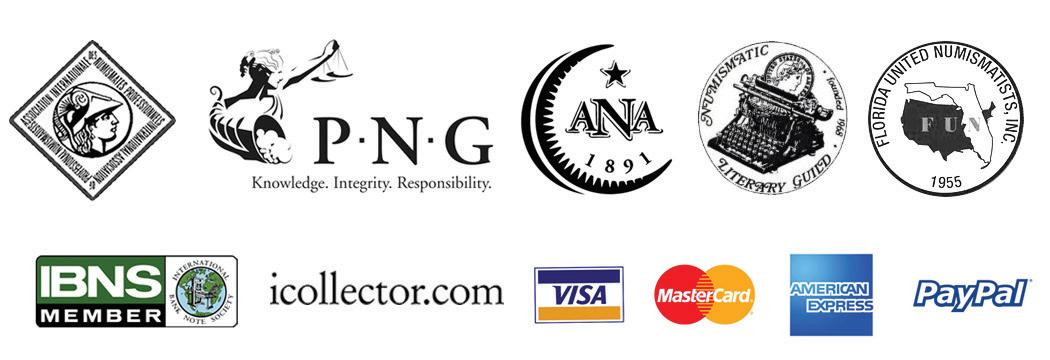
Please visit our website at www.sedwickcoins.com/wreckhistory.pdf for brief historical backgrounds on the various shipwrecks in this auction.


From best to worst, UNC is Uncirculated, AU is Almost Uncirculated, XF is Extra Fine, VF is Very Fine, F is Fine, VG is Very Good, and G is Good, with Fair and Poor below that. (“About” or “A” means the coin is just shy of the indicated grade. Mint State refers to lustrous, choice UNC coins.) We do not always assign numismatic grades to sea-salvage and land-burial coins, which were usually Uncirculated (or close to it) before the effects of corrosion and/or cleaning. Corrosion is usually assessed, from least to most, as follows: none, minimal, light, moderate, and heavy. Also note that we sometimes use the abbreviations E for escudos and R for reales in the listings for Spanish and Spanish colonial items.
Coin photos in this catalog are generally shown at actual size, with the exception of large lots, which are often reduced, as are most medals, paper money, artifacts, documents, artwork and media. Photos of coins in the most recent NGC capsules have four white intrusions into the rims of the coins due to a special design meant to enable viewing of the edges of those coins.
We encourage bidders to contact us if they have any questions or would like additional photos or videos of any lot in our auction. Inquiries can be sent through the auction site or by emailing us at office@sedwickcoins.com.
March 18, 1963 – June 29, 2022
Frank Ponzio passed away unexpectedly on June 29, 2022, at age 59. Frank helped bidders view lots and recorded auction results at our live auction sessions.

Frank was born in NY and remained in the NYC area until he moved to Windermere, FL, in 2007 to be closer to his family. In NY, he worked as an accounts payable manager for the American Society of Composers, Authors and Publishers (ASCAP). He also worked part-time at the Disney Store.
Frank became a full time cast member at Walt Disney World when he moved south. He worked at several Disney hotels, both as a desk clerk and as a member of the concierge team, until he transferred to Disney Food Services, where he worked as a training coordinator for employees who would be handling food at dining facilities in the Magic Kingdom. His office was under Main Street not far from the Hub.
In his spare time, Frank enjoyed cooking, gardening, and visiting with family. He is survived by his parents, brother, nephew, and niece. The Sedwick Team extends their condolences to Frank’s family.
Anybody who worked with Frank or who knew him as a friend will miss him greatly.


1. Seville, Spain, gold 1 escudo, Charles-Joanna, assayer * to right, mintmark S to left, NGC MS 61. Cal-196. 3.21 grams. Well-detailed full shield and cross, some legend, nicely toned. NGC #6476382-038. Estimate: $1,250-$2,000.
2. Seville, Spain, gold 1 escudo, Charles-Joanna, assayer Gothic D to left, mintmark S to right, NGC AU 55. Cal-199. 3.36 grams. Good full shield and cross plus most of legend, a few minor spots of crude strike (assayer weak as a result), sediment in crevices. NGC #6286852-013. Estimate: $1,000-$1,500.
3. Seville, Spain, gold 1 escudo, Charles-Joanna, assayer Gothic D to left, mintmark S to right, NGC AU 53. Cal-199. 3.26 grams. Bold full shield set off by dark sediment in crevices, good full cross and tressure, much legend and crown. NGC #6476382-035. Estimate: $1,000-$1,500.
4. Toledo, Spain, gold 1 escudo, Charles-Joanna, assayer M to right, mintmark T to left, NGC MS 62. Cal-202. 3.36 grams. Better mint, broad flan with choice full legends and interior details, nice luster and light toning, begging a higher grade (in fact it would be tied for finest in the NGC census if properly attributed as Charles-Joanna, since NGC attributed it to Philip II in error). NGC #6476382-037. Estimate: $1,500-$2,250.
5. Seville, Spain, gold cob 4 escudos, Philip II, assayer Gothic D below mintmark
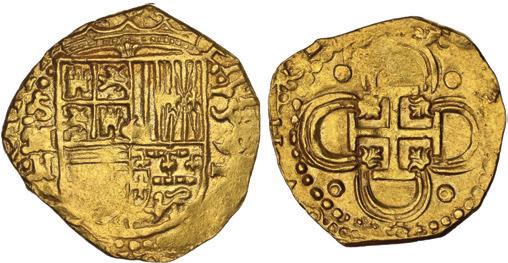

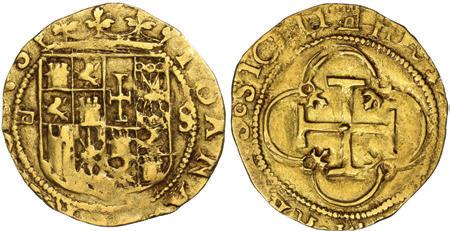

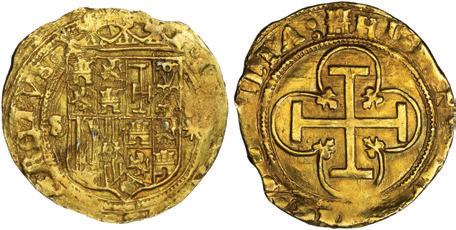
S to left, NGC AU 55. Cal-887. 13.40 grams. Broad flan with choice full cross and shield, bold S-Gothic D and denomination o-IIII, some legend, slightly lustrous. NGC #6476382-023. Estimate: $2,500-$3,750.
6. Seville, Spain, gold cob 2 escudos, 1591 date to right, assayer H below mintmark
S and denomination II to left, NGC AU 58, finest and only example in NGC cen sus. Cal-836. 6.75 grams. Choice example with full S-II-H to left and most of 1591 to right of well-detailed full shield below sharp bottom half of crown, full cross with bold tressure except for one end, much luster for the assigned grade, fully worthy of its finest-known status. NGC #6481297-001. Estimate: $2,500-$3,750.

7. Seville, Spain, gold cob 2 escudos, 1597 date to right, assayer B below mintmark S and denomination II to left. Cal-797. 6.60 grams. XF with dark sediment in crevices making for great contrast. Significantly, the Calicó listing says “assayer not visible,” whereas this coin clearly shows a bold full S-II-B in addition to the bold date. Estimate: $1,250-$2,000.
8. Seville, Spain, gold cob 1 escudo, Philip II, assayer Gothic D to right, mintmark S to left, NGC AU 55. Cal-784. 3.40 grams. Good full cross, nearly full (and well-detailed) crown and shield, parts of edge on both sides crude (as made). NGC #6476382-012. Estimate: $800-$1,200.
9. Seville, Spain, gold cob 1 escudo, Philip II, assayer Gothic D to right, mintmark S to left, NGC VF 35. Cal-784. 3.19 grams. Bold full cross, most of shield (flat spot near edge), contrasting sediment in crevices. NGC #6476382-011. Estimate: $700-$1,000.
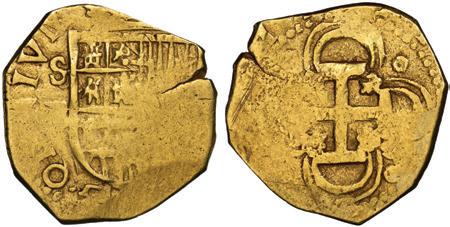




10. Seville, Spain, gold cob 1 escudo, Phillip II, assayer B, NGC AU 58. Cal-Type 229. 3.38 grams. Well-centered full shield with full but slightly doubled S-B to left, bold full denomination to right, off-center cross, small area of flatness in periphery. NGC #6476382-009. Estimate: $900-$1,350.
11. Toledo, Spain, cob 2 escudos, Philip II, assayer M below mintmark T [sic] to left.


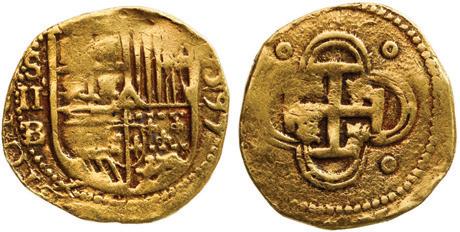
Cal-unl (cf 862). 6.72 grams. Rare variety with no o above mintmark (unlisted in Calicó), typically well-detailed full shield and crown and cross, full T-M to left and bold full denomination II with two dots above to right, nice XF+ with faint red toning Estimate: $1,750-$2,500.
12. Granada, Spain, gold cob 2 escudos, 1606/593 M, very rare, PCGS MS62, finest and only example in PCGS census (none at NGC). Cal-1033. 6.68 grams. Very bold full shield with most of crown above and full G-M to right inside a bold PHILIP(PVS), good full cross (slightly doubled) with much legend including bold full date (the overdate quite evident), light sediment in crevices, a premium coin in many ways. PCGS #44783487. Estimate: $3,000-up.
13. Madrid, Spain, gold cob 2 escudos, 1620 G, very rare, NGC AU 58, finest and only example in the NGC census. Cal-1041. 6.73 grams. Choice broad flan with 100% full crown and shield, full and clear date, mintmark and assayer, much legend, light toning and faint luster, another premium coin like the previous lot. It is interesting to note the similarity between this coin and the famous 1622 issues of Bogotá, Colombia, with SF to left (ostensibly the first gold coins struck in the New World), hardly a coincidence since the Madrid engraver had made the dies for Bogotá! NGC #6481019-001. Estimate: $3,000-up.
14. Seville, Spain, gold cob 2 escudos, Phillip III, assayer B, OMNIVM variety, NGC XF 45. Cal-1050. 6.75 grams. Crude strike with much flatness yet with clear O(M)NIVM in legend (not noted by NGC), hairline edge-split. NGC #6476382-021. Estimate: $800-$1,200.
15. Seville, Spain, gold cob 2 escudos, 1617 D, PCGS MS62, finest known in both PCGS and NGC censuses. Cal-1075. Very bold date outside of choice full cross (also bold), also bold full S-D to left of full and bold shield (well deserving of its “finest known” status), hairline edge-split. PCGS #44783488. Estimate: $2,500-up.
16. Seville, Spain, gold cob 2 escudos, Philip III, assayer not visible, NGC AU 55. CalType 197. 6.69 grams. Most of shield and cross but some peripheral flatness and rusty-die strike, good contrast from sediment in crevices. NGC #6476382-020. Estimate: $800-$1,200.
17. Seville, Spain, gold cob 1 escudo, Philip III, assayer B, OMNIVM variety, NGC
AU details / cleaned. Cal-1017. 3.33 grams. Off-center shield with clear S-B and parts of OMNIVM (not noted by NGC), full cross struck from rusty die. NGC #6476382-004. Estimate: $700-$1,000.
18. Seville, Spain, gold cob 1 escudo, Philip III, assayer V, NGC XF 40. Cal-Type 186. 3.38 grams. Bold full cross and nice full shield, weak mintmark and assayer to left, light rose-colored sedi ment in crevices. NGC #64392215-005. Estimate: $700-$1,000.
19. Madrid, Spain, gold cob 2 escudos, 1627 V, rare, NGC MS 63, finest and only example in NGC census. Cal-1775. 6.72 grams. Choice full shield with bold mintmark-assayer to left, crown above and denomination •II• to right inside PHI- of king’s name, choice full cross with bottom of last digit of date visible (not noted by NGC), attractive toning and sediment, exceptional in grade and notably similar to the 1622 SF issues of Bogotá (by the same engraver). NGC #6476382-015. Estimate: $1,500-$2,250.
20. Seville, Spain, gold cob 4 escudos, 1634/3 R, very rare, NGC MS 61, finest and only example in NGC census. Cal-unl (cf 1831). 13.56 grams. Full date with clear overdate (missing in Calicó, not noted by NGC), bold full shield and cross-and-tressure, lustrous and choice for the period despite an overall crudeness and natural edge-crack. NGC #6476382-024. Estimate: $2,000-$3,000.
21. Seville, Spain, gold cob 2 escudos, Philip IV, assayer R, NGC AU details / cleaned. Cal-Type 388. 6.77 grams. Good but off-center full cross, nearly full shield with clear S-R to left inside king’s ordinal IIII, a few minor marks here and there. NGC #6476382-018. Estimate: $800-$1,200.








22. Seville, Spain, gold cob 8 escudos, 1690 (M), NGC MS 64, finest and only example in the NGC census. Cal-1043. 26.83 grams. Choice shield (nearly full) with bold full denomination VIII to right, good full cross and most of tressure, clear bottom half of 169 of date with weaker but certain final digit 0, choice color with hint of luster, tiny edge-split in flat area of periphery. NGC #6481458-001. Estimate: $6,000-$9,000.
23. Seville, Spain, gold cob 8 escudos, Charles II, assayer not visible, NGC AU 55. Cal-Type 181. 26.83 grams. Most of cross and shield despite large areas of peripheral flatness. Curiously, the mintmark S appears in the legend at eleven o’clock, and beneath it is a G that could either be the assayer or the end of the legend (D.G.). NGC #6286303-001. Estimate: $3,500-$5,000.


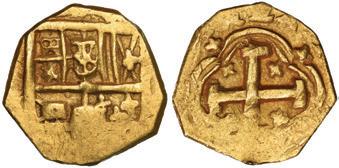


24. Seville, Spain, gold cob 1 escudo, Charles II, assayer M to right (vertical), NGC AU 53. Cal-Type 137. 3.36 grams. Off-center shield with bold assayer to right inside most of king’s name CAROLVS, nice and nearly full cross-and-tressure, minor marks and flan-crack. NGC #6476382-008. Estimate: $700-$1,000.
25. Seville, Spain, gold cob 1 escudo, Charles II, assayer not visible (M), NGC AU 58. Cal-Type 137. 3.24 grams. Nice bold shield and cross (both nearly full and well centered), light contrasting sediment in crevices. NGC #6476382-010. Estimate: $700-$1,000.
26. Mexico City, Mexico, gold cob 8 escudos, 1713 J, NGC MS 64 (1715 Fleet Label). S-M30; KM-57.1; Cal-2211; Tauler-390. 27.06 grams. Bold date and oXMJ and denomination VIII, most of shield and crown, good full cross (slightly doubled), typically beveled edge (as made), nice luster per the choice grade. From the 1715 Fleet. NGC #6476082-001. Estimate: $15,000$22,500.
27. Mexico City, Mexico, gold cob 8 escudos, 1713 J, NGC UNC details
/ reverse spot removed (1715 Fleet Label), with hand-signed certificate from 1977. S-M30; KM-57.1; Cal-2211; Tauler-390. 26.82 grams. Bold strike with nearly full shield and cross and date, 100% bold and full oXMJ, most of periphery flat and beveled as usual, small dig near edge on reverse, toned but a bit shiny. From the 1715 Fleet, with Fisher photo-certificate (small) from 1977 hand-signed by Dolores (Deo) Fisher, pedigreed to the J.P. Silberman Estate (stated on the label). NGC #6478589-003. Estimate: $8,000-$12,000.
28. Mexico City, Mexico, gold cob 8 escudos, (1714) J, “GRAT” variety (date on reverse not visible), NGC MS 62 (1715 Fleet Label). S-M30; KM-57.2; Cal-2212; Tauler-396. 26.75 grams. While the “GRAT” dies (so named for the placement of GRAT where the date normally appears, along with moving the date to the legend on the reverse) were clearly a refinement of the details, unfortunately the planchets were not so well prepared and you tend to see flat areas and doubling where multiple attempts were made to impart the die details onto the coin. This coin is a classic example, with some parts choice (like the all-important GRAT plus the crown and most of the cross) but much of the centers are weak or flat or slightly doubled, with luster throughout per the grade, also with clear denomination VIII over IIIV, one of several die-punching errors that characterize the “GRAT” dies. From the 1715 Fleet, with original Cobb Coin Co. (Mel Fisher) plastic and paper tags NCB-MOE4295 (1987). NGC #6481032-001. Estimate: $10,000-$15,000.
29. Mexico City, Mexico, gold cob 8 escudos, 1714 J, NGC MS 62 (1715 Fleet Label), ex-Anderson. S-M30; KM57.2; Cal-2213; Tauler-393. 26.92 grams. Choice full shield with much legend including most of date and full king’s ordinal V, also denomination VIII, the very bold cross and tressure also full with some legend on that side too, light luster, the obverse periphery partially beveled and flat (as made). From the 1715 Fleet, with original Cobb Coin Co. (Mel Fisher) photo-certificate 4298, pedigreed to the collection of Don Anderson (the investor origi nally responsible for computerization of the Treasure Salvors division records, mentioned several times in The Search for the Atocha [1979], by Eugene Lyon). NGC #6481571001. Estimate: $10,000-$15,000.

30. Mexico City, Mexico, gold cob 4 escudos, Philip V, assayer not visible (style of 1702-10), very rare, NGC MS 62 (1715 Fleet Label), finest known in NGC census. KM-55.1. 13.63 grams. Lustrous and clearly high grade where details are showing (nearly full shield and cross, both slightly off-center, also full denomination IIII), but with much peripheral flatness and hammered-in points on edge (as made), very rare type with “box-end cross,” for which the only dates currently known to exist are 1705 under assayer L and 1706 and 1707 under assayer J (the last-mentioned represented by a single AU 58 at NGC). From the 1715 Fleet, pedigreed to the J.P. Silberman Estate (stated on the label). NGC #6478589-002. Estimate: $6,000-$9,000.


31. Mexico City, Mexico, gold cob 4 escudos, 1711 J, ornate-tressure cross, very rare, NGC MS 64 (1715 Fleet Label). S-M30; KM-55.1; Cal-unl. 13.43 grams. Superb full shield with bold full oXMJ, clear bottom part of 1711 date, double-struck cross of the “ornate tressure” type (with odd “ears” between the arms of the cross), an unlisted type in Calicó but listed in Tauler as 107, lustrous and lightly toned. From the 1715 Fleet. NGC #6476082-002. Estimate: $15,000-$22,500.
32. Mexico City, Mexico, gold cob 4 escudos, 1713 J, NGC MS 65 (1715 Fleet Label). S-M30; KM-55.1; Cal-2028; Tauler-109. 13.50 grams. Superb grade (second highest at NGC) with luster and nice color, bold full oXMJ and clear date with x-shape ornaments characteristic of this year only, nearly full crown and shield and cross. From the 1715 Fleet, pedigreed to the R. Herbruger Collection, with original 1970s cardboard tag. NGC #6482194-002. Estimate: $10,000-$15,000.
33. Mexico City, Mexico, gold cob 4 escudos, Philip V, assayer J, crosslet-end cross (1711-13), NGC MS 64 (1715 Fleet Label). S-M30; KM-55.1. 13.59 grams. Nearly full shield with bold full oXMJ above ornament (characteristic of the date 1713 only), also nearly full cross, flat around edge (as usual), nicely toned. From the 1715 Fleet. NGC #6476017-001. Estimate: $7,000-$10,000.

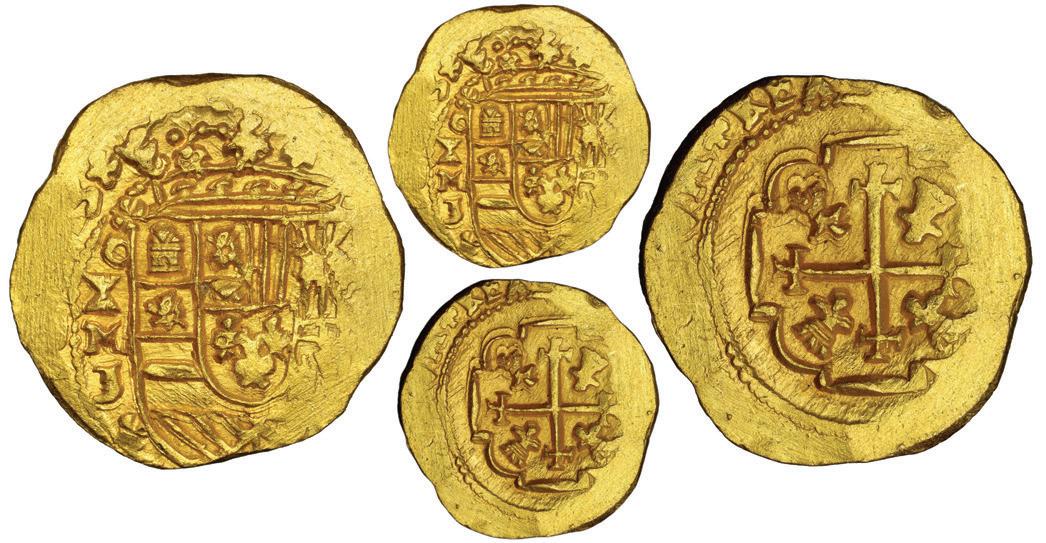

34. Mexico City, Mexico, gold cob 4 escudos, Philip V, assayer J, crosslet-end cross (1711-13), NGC MS 63 (1715 Fleet Label). S-M30; KM-55.1. 13.60 grams. Nice full shield and cross (the latter slightly off-center), typically filed and beveled peripheries (as made), lightly toned. From the 1715 Fleet. NGC #6476017-002. Estimate: $6,000-$9,000.
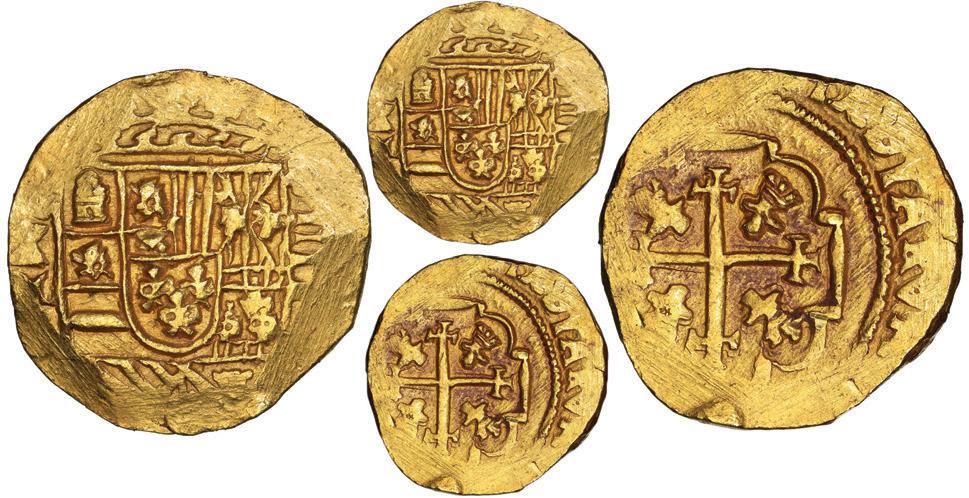
35. Mexico City, Mexico, gold cob 2 escudos, 1714 J, NGC
MS 64 (1715 Fleet Label). S-M30; KM-53.2; Cal-1887; Tauler-275. 6.75 grams. Choice and sharply detailed full crown, shield and cross with much luster and nice color, most of oMJ and trace of date, second highest grade in NGC census. From the 1715 Fleet, pedigreed to the J.P. Silberman Estate (stated on the label). NGC #6478589-001. Estimate: $6,000-$9,000.
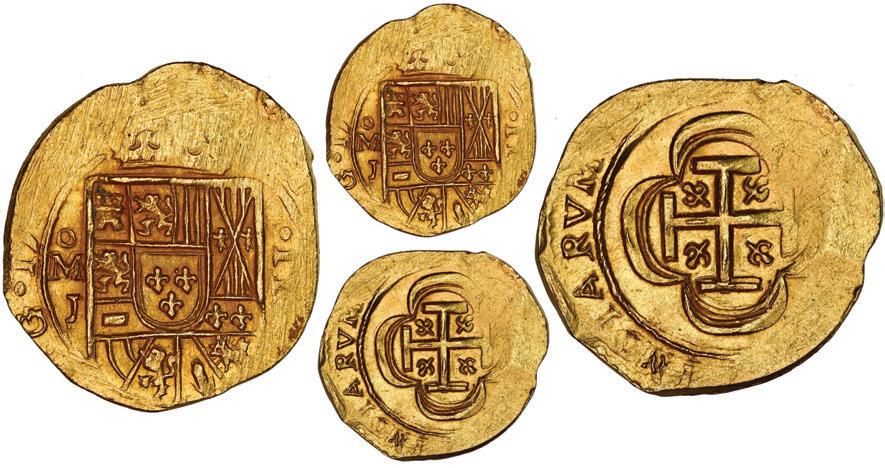

38. Mexico City, Mexico, gold cob 2 escudos, (1714) J, NGC
MS 65 (1715 Fleet Label). S-M30; KM-53.2; Cal-1887; Tauler-275. 6.69 grams. Sharply detailed full shield with full oMJ, clear denomination II and 171 of date (last digit not visible but attributed by NGC as being dated 1714, hence not a tie with prior lot in the census), nearly full cross-and-tressure, lustrous and lightly toned but with some peripheral flatness as usual. From the 1715 Fleet, pedigreed to the R. Herbruger Collection, with original 1970s cardboard tag. NGC #6482194-003. Estimate: $4,000-$6,000.
36. Mexico City, Mexico, gold cob 2 escudos, (1714) J, NGC
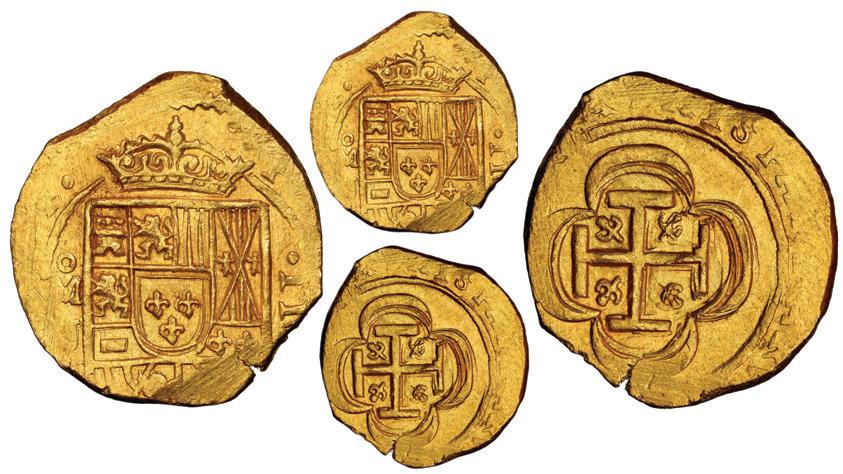
MS 66 (1715 Fleet label), finest known in NGC census. S-M30; KM-53.2; Cal-1887; Tauler-275. 6.80 grams. While a visible date would be more desirable (can only be 1714 by style), the extreme high grade of this piece sets it apart, with the crispest and fullest shield and cross imaginable, also with bold full oMJ and crown, highly lustrous all over, the lone MS 66 among the (currently) 30 entries for this date and type at NGC. From the 1715 Fleet. NGC #6476306-001. Estimate: $5,000-$7,500.
39. Mexico City, Mexico, gold cob 1 escudo, 1714 J, NGC
MS 65 (1715 Fleet Label). S-M30; KM-51.2; Cal-1739; Tauler-172. 3.40 grams. Lustrous and sharp, with crown and shield and cross all nearly full, also full and bold oMJ, bold bottom half of all four digits of date 1714, tied with eight others for second finest in NGC census behind a single MS 66. From the 1715 Fleet, pedigreed to the R. Herbruger Collection, with original 1970s cardboard tag. NGC #6482194-004. Estimate: $5,000-$7,500.
37. Mexico City, Mexico, gold cob 2 escudos, (1714) J, NGC

MS 65 (1715 Fleet Label). S-M30; KM-53.2; Cal-1887; Tauler-275. 6.74 grams. Sharp full shield and cross, flat peripheries with as-issued adjust ment marks, second finest in the NGC census (not counting those with visible date) behind the previous lot at MS 66. From the 1715 Fleet. NGC #6476082-003. Estimate: $4,000-$6,000.
40. Mexico City, Mexico, gold cob 1 escudo, (1714) J, NGC
MS 65 (1715 Fleet Label, “top pop”). S-M30; KM-51.2; Cal-1739; Tauler-172. 3.34 grams. Oval flan with very choice full cross-and-tressure, sharp full crown and nearly full cross, full oMJ, much luster, tied with three others for finest in NGC census for examples without visible dates. From the 1715 Fleet. NGC #6476082-004. Estimate: $4,000-$6,000.

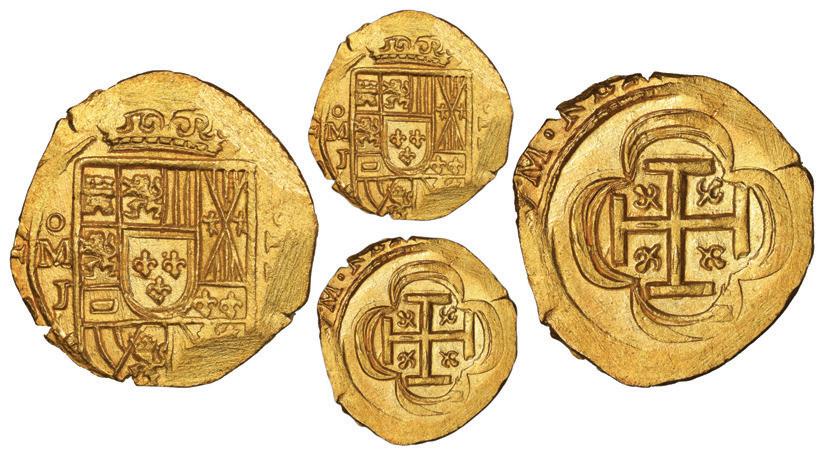
41. Cuzco, Peru, gold cob 2 escudos, 1698 M, large flan with RX in legend, NGC MS 63 (1715 Fleet Label). S-CZ1; KM28; Cal-855. 6.71 grams. At 25mm, this is probably the broadest flan we have ever seen for this type, a perfect example of the “Lima cut” style (characterized by the error RX for REX in legend), with full crown and nearly full legends (including clear C.II for Charles II), choice full cross-lions-castles, full but doubled pillars-and-waves, lustrous and very lightly toned. From the 1715 Fleet. NGC #6475677-001. Estimate: $15,000-$22,500.
42. Cuzco, Peru, gold cob 2 escudos, 1698 M, small flan, NGC MS 63 (1715 Fleet Label). S-CZ1; KM-28; Cal-855. 6.74 grams. Choice full pillars-and-waves, full but doubled cross, nearly full crown and much legend (including C.II for Charles II), which is unusual for this “Bogotá cut” style of smaller flan, nicely lustrous all over. From the 1715 Fleet. NGC #6476173-001. Estimate: $15,000-$22,500.
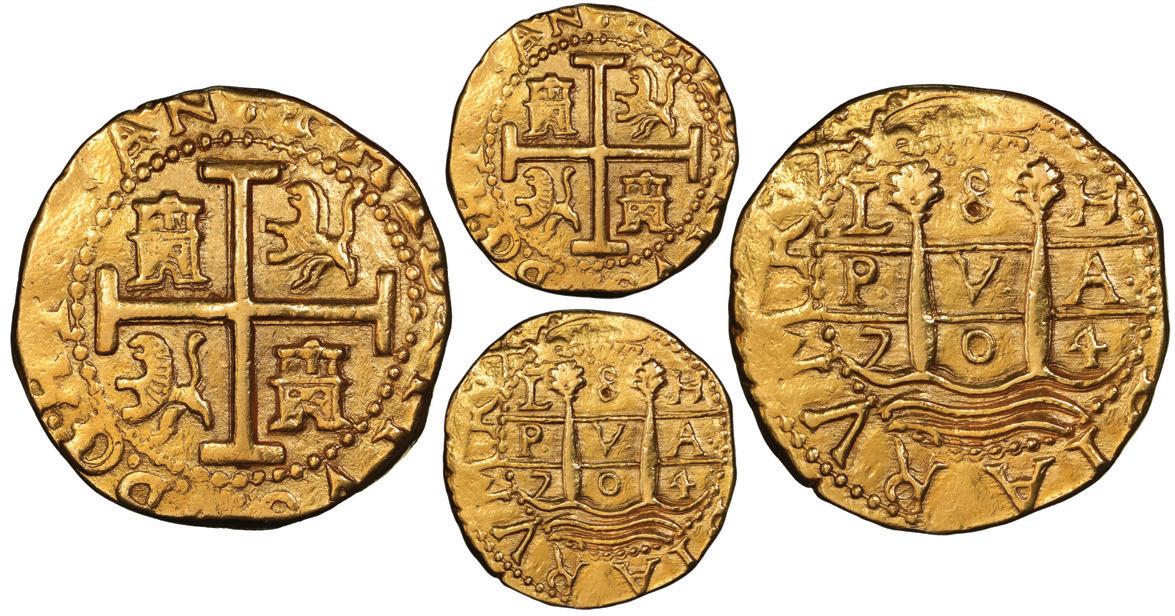


43. Lima, Peru, gold cob 8 escudos, 1704 H, rare, NGC AU details / removed from jewelry (1715 Fleet label). S-L25a; KM-38.1; Cal2111. 26.81 grams. Bold full pillars-and-waves and cross-lions-castles with much legend on both sides, no doubling, lightly toned, a bit shiny from former mounting. Curiously, despite its status as a rare date, Tauler lists four different varieties, depending on the spelling and truncation of HISPANIARVM, this being Tauler 223 with HISPAN (“muy rara”). From the 1715 Fleet. NGC #6476416-001. Estimate: $8,000-$12,000.
44. Lima, Peru, gold cob 8 escudos, 1708 H, NGC MS 63 (1715 Fleet Label), ex-Pullin. S-L25a; KM-38.1; Cal-2114. 26.95 grams. Broad flan with full crown and nearly full legends around choice full pillars-and-waves and cross-lions-castles (both well centered and devoid of doubling), nice rich color with muted luster, variety with legend ending in HISPAN per Tauler 232a. From the 1715 Fleet, pedigreed to the John Pullin Collection (stated on label), with original Cobb Coin Co. (Mel Fisher) tag and photo-certificate NCB 3761 MO. NGC #6474436-001. Estimate: $15,000-$22,500.
45. Lima, Peru, gold cob 8 escudos, 1711 M, rotated legend, NGC UNC details / edge filing (1715 Fleet Label). S-L28; KM-38.2; Cal-2119. 26.90 grams. Bold full pillars-and-waves and cross-lions-castles, also choice full crown and much legend on cross side (starting at six o’clock, per Tauler 239), nice color with toned fields on cross side, just a small spot of modern filing to right of crown. From the 1715 Fleet. NGC #6478404-001. Estimate: $8,000-$12,000.
46. Lima, Peru, gold cob 8 escudos, 1712 M, NGC MS 63 (1715 Fleet Label). S-L28; KM-38.2; Cal-2120. 26.84 grams. Choice color with luster on pillars side, great full cross-lions-castles and pillars-and-waves, well centered and not doubled, enough legend to identify as Tauler 240 with HISPANIAR and trace of second date 712. From the 1715 Fleet, pedigreed to the R. Herbruger Collection, with original collector’s paper flip. NGC #6482194-001. Estimate: $10,000-$15,000.

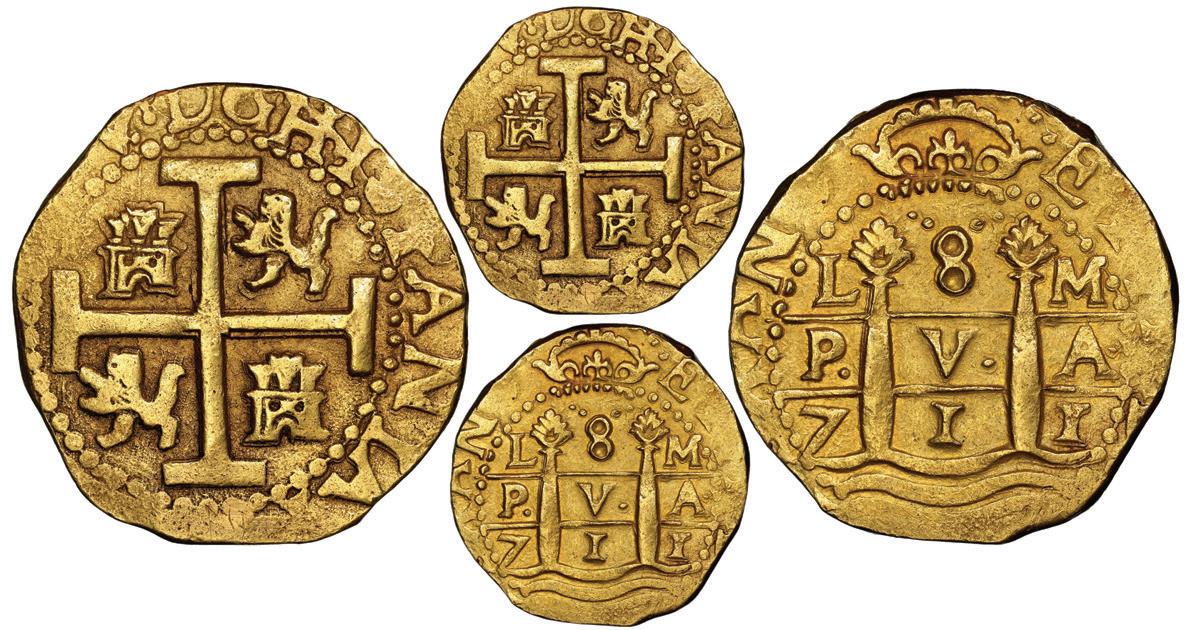

47. Lima, Peru, gold cob 8 escu dos, 1729 N, NGC MS 62 (“top pop”). S-L29; KM-38.2; Cal-2142. 27.00 grams Exceptionally broad flan for the issue (33mm) with much legend in cluding bold full second date 729 (per Tauler 291b) due to slightly off-center strike, the pillars-and-waves and crosslions-castles nevertheless full, all with choice deep toning, tied with one other for finest known in the NGC census and certainly the best example we have seen. NGC #6476175-001. Estimate: $12,500-$20,000.
48. Lima, Peru, gold cob 8 escudos, 1738 N, NGC MS 62 (“top pop”). S-L29; KM-38.2; Cal-2153. 27.14 grams. Small, thick flan with full but slightly off-center cross-lions-castles, full but slightly doubled pillars-and-waves, just enough legend to see it ends in HISPANIA (per Tauler 321, “rara”), tied for fin est in NGC census. NGC #6611628-001. Estimate: $10,000-$15,000.
49. Lima, Peru, gold cob 8 escudos, 1745 V, NGC AU details / cleaned. S-L30; KM-38.2; Cal-2164. 26.57 grams. Broad flan with clear second date and king’s name and ordinal in legend, full pillars-and-waves and crosslions-castles with trifle flatness in centers, bright yellow gold, Tauler 344 (“rara”). NGC #6476382-001. Estimate: $8,000-$12,000.



50. Lima, Peru, gold cob 8 escudos, 1748 R, NGC MS 63. S-L31; KM-47; Cal-758. 26.89 grams. Choice full cross-lions-castles and (offcenter) pillars-and-waves, with clear bottom half of second date 48 in legend (Tauler 560a), lustrous and very boldly struck, tied with one other for second finest in NGC census behind a single MS 65. NGC #6475661-001. Estimate: $12,500-$20,000.
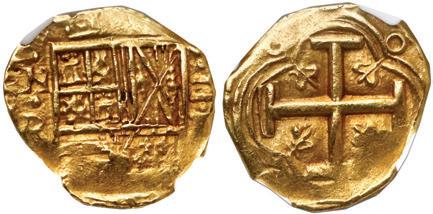
51. Cartagena, Colombia, gold cob 2 escudos, Philip IV, assayer E below mintmark C to left, dots inside and outside tressure on reverse (1630-1), NGC MS 61, ex-Fisher, ex-Lasser. Restrepo-unl (M52 for type); S-C7; KM-4.6. 6.79 grams. Bold full C-E to left of nearly full shield below nearly full crown, just enough of the denomination to right to see that it is the “normal” version (II sideways, not up right), also part of king’s ordinal II in legend, the cross-and-tressure complete and well struck, just no part of the date in the legend (but this variety with dots inside and outside the tressure only known for 1630 and 1631, strangely missing in Restrepo with the CE2 obverse), lustrous all over. Note that the Fisher tag and certificate call it “Lasser plated coin” based on what was probably a “fill-down” typographical error in the Ponterio catalog. Pedigreed to the Joseph R. Lasser Collection (Ponterio auction of January 2006, lot 403), with original Mel Fisher tag and photo-certificate PC6-30970. NGC #6482492-001. Estimate: $2,500-$3,750.
52. Bogotá, Colombia, gold cob 4 escudos, Ferdinand VI, assayer S above denomination 4 to right, mintmark F-S to left (ca. 1750), NGC MS 62. Restrepo-M96.6; S-B27a; KM-27. 13.41 grams. Choice full cross and shield (lions and castles transposed as usual) with bold full F•S• to left and S-4 (tilted) to right, nice luster and light toning, a few light marks and bits of encrustation but overall rather well preserved, in fact second finest in NGC census behind a single MS 64. Pedigreed to the J.P. Silberman Estate (stated on the label). NGC #6478610-001. Estimate: $4,000-$6,000.
53. Bogotá, Colombia, gold cob 2 escudos, Philip IV, assayer A below mintmark NR to left (ca. 1635), NGC MS 60, ex-Mesuno Treasure (designated on label). Restrepo-M50.13; S-B20; KM-4.1. Small flan with edge-crack, full NRA next to king’s ordinal IIII, full but off-center shield, good full cross, some light toning. From the ca.-1636 “Mesuno Hoard.” NGC #3392728-011. Estimate: $1,750-$2,500.

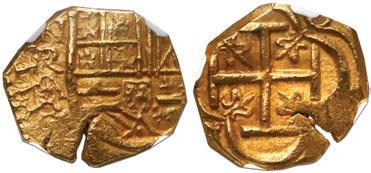



54. Bogotá, Colombia, gold cob 2 escudos, Phillip IV, assayer A below mintmark NR to left (ca. 1640), NGC AU 58. Restrepo-M50.17; S-B20; KM-4.1. 6.67 grams. Good full shield with clear (N)RA to left, full but slightly doubled cross-and-tressure, encrustation in crevices. NGC #6476382-029. Estimate: $1,250-$2,000.
55. Bogotá, Colombia, gold cob 2 escudos, Philip IV, assayer R below denomination II to right (1642-51), mintmark NR to left, NGC AU 58. Restrepo-M50.25; S-B21; KM-4.1. 6.68 grams. Bold upper half of shield with clear •N-•R to left and denomination •II• to right above the upper-left part of assayer R (not noted by NGC), bold full cross, parts of edge slightly crude (as made). NGC #6454905-007. Estimate: $1,250-$2,000.
56. Bogotá, Colombia, gold cob 2 escudos, Philip IV, assayer R below domination II to right, mintmark NR to left, NGC MS 62 / Maravillas (Shipwreck Blue Label). Restrepo-M50.25; S-B21; KM-4.1. 6.77 grams. Welldetailed full shield with clear N•R to left, also clear denomination II above the top of assayer R to right, bold full cross, faint traces of encrustation in crevices. From the Maravillas (1656). NGC #6476385-003. Estimate: $1,750-$2,500.



57. Bogotá, Colombia, gold cob 2 escudos, Philip IV, assayer R below domination II to right, mintmark NR to left, NGC MS 61 / Maravillas (Shipwreck Blue Label). Restrepo-M50.25; S-B21; KM-4.1. 6.69 grams. Nearly full crown above full shield with bold full II-R to right, full cross with encrustation in crevices, fairly broad flan. From the Maravillas (1656). NGC #6476385-002. Estimate: $1,750-$2,500.
58. Bogotá, Colombia, gold cob 2 escudos, (1683 G), one-year type with distinctive fleurs, NGC

AU 58. Restrepo-M66.12; S-B22a; KM-14.1; Cal-890. 6.66 grams. Choice full shield and cross with contrasting sedi ment in crevices, well centered, with left side of assayer G visible to right, quadrants of cross showing distinctive fleurs with ball tips separated from “leaves” (attributable to 1683 only, but NGC only notes Charles II). NGC #6476382-042. Estimate: $1,250-$2,000.
59. Bogotá, Colombia, gold cob 2 escudos, (1683 G), one-year type with distinctive fleurs, NGC XF details / cleaned. Restrepo-M66.12; S-B22a; KM-14.1; Cal-890. 6.71 grams. Small flan with full and well-centered cross and shield but no peripheries, contrasting toning and sediment in crevices, distinctive fleurs in quadrants of cross showing ball tips separated from the “leaves,” which research has shown is only known for the date 1683 (NGC only notes Charles II). NGC #6476382-027. Estimate: $1,000-$1,500.
60. Bogotá, Colombia, gold cob 2 escudos, Charles II posthumous, 1712/1, no assayer (Arce), unique, NGC MS 66 (1715 Fleet Shipwreck Label), finest and only example in NGC census. Restrepo-unl (M66.32 for type); S-B24; KM-unl (14.2 for type); Cal-unl (cf 1930 under Ph. V). 6.70 grams. Odd-shaped flan with nearly full shield and cross showing great depth of strike and complete lack of wear, but best numismatic feature is the bold 712 of the date with clear 2/1 for the last digit, an overdate that we have never encountered before, followed by two dots, the first of which also appears to be punched over a 1. It is worth noting that this coin is top grade for the entire colonial series at NGC, and a previously unknown overdate from such a prolific source as the 1715 Fleet is quite a rare occurrence! From the 1715 Fleet, with original Fisher photo-certificate 1715-0033. NGC #6349467-001. Estimate: $7,500-up.
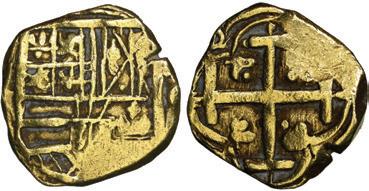
61. Bogotá, Colombia, gold cob 2 escudos, Charles II posthumous, no assayer (Arce), NGC MS 65 (1715 Fleet label). Restrepo-M66.32; S-B24; KM-14.2. 6.79 grams. Very broad flan with choice full shield and bottom part of king’s ordinal II in leg end, also good full cross (very slightly doubled), lustrous fields and sharp details commensurate with its assigned Gem Uncirculated condition (second highest grade in the census for this type). From the 1715 Fleet. NGC #6266145-002. Estimate: $4,000-$6,000.

62. Bogotá, Colombia, gold cob 2 escudos, Philip V, no assayer (Arce, 1716-22), NGC MS 62 (“top pop”). Restrepo-M80.4; S-B24a; KM-17.2. 6.76 grams. Broad flan with full shield and cross (the latter slightly crude, with distinctively dotted ringlets in tressure-dimples), full PHILIP of king’s name and no space for any assayer or denomination between the shield and legend, somewhat lustrous, tied with one other for finest in NGC census for this scarce type. NGC #6454912-002. Estimate: $2,000-$3,000.
63. Bogotá, Colombia, gold cob 2 escudos, Philip V, assayer not visible (S) to right, mint mark F to left, NGC AU 53. Restrepo-M80.8; S-B25b; KM-17.2. 6.74 grams. Choice bold shield and cross, both full and deeply contrasted with dark fields, also full crown and bold mintmark F, the assayer to right off the flan but style of post-Louis I S (1726-29) with full ringlets in tressure-dimples around the cross. NGC #6476382-031. Estimate: $1,250-$2,000.
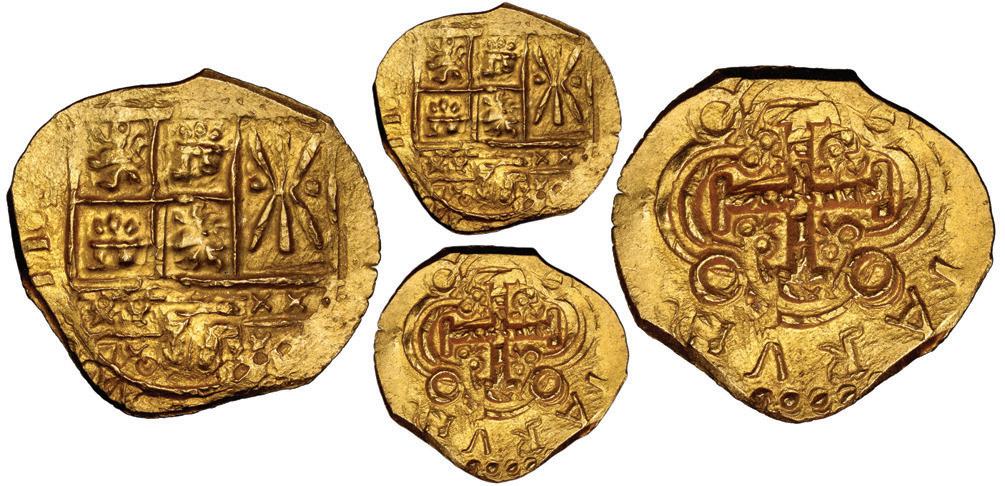
64. Bogotá, Colombia, gold cob 2 escudos, 1741 M, NGC AU 53. Restrepo-M80.12; S-B26; KM17.2; Cal-1961. 6.75 grams. Very bold full cross with 100% full 41 of date, full but off-center shield with PHI- of king’s name outside of full, horizontal assayer M (not noted by NGC), good contrast from heavy encrustation in crevices. NGC #6476382-032. Estimate: $1,500-$2,250.
65. Bogotá, Colombia, gold cob 2 escudos, 1745 (S), very rare, NGC AU 55, finest and only example in NGC census. Restrepo-M80.16; S-B27; KM-17.2; Cal-unl. 6.80 grams. Small, round, thick flan with choice full cross-and-tressure, clear and bold date, contrasting sediment on fields, assayer not visible by S by default (incorrectly attributed to assayer M by NGC). NGC #6469744-002. Estimate: $1,500-$2,250.
66. Bogotá, Colombia, gold cob 1 escudo, Charles II posthumous, no assayer (Arce), NGC MS 63 (1715 Fleet label). Restrepo-M64.16; S-B24; KM-13. 3.26 grams. Choice full cross (bold and well centered), oversized shield, small spots of coral encrustation here and there. From the 1715 Fleet. NGC #6476416-002. Estimate: $2,500-$3,750.



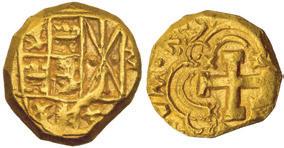

67. Bogotá, Colombia, gold cob 1 escudo, Philip V, assayer M (vertical) to right, mintmark F to left not visible, NGC AU 55, Restrepo Plate Coin (stated on label). Restrepo-M78.12; S-B26; KM-22. 3.34 grams. Choice full shield with small die-break near center, clear assayer M to right, bold but off-center cross, richly red-toned all over. Plate Coin on page 97 of Restrepo’s Coins of Colombia (4th ed., 2012). NGC #6480715-009. Estimate: $1,500-$2,250.
68. Bogotá, Colombia, gold cob 1 escudo, Philip V, assayer M (horizontal) to right, mintmark F to left, NGC XF 45. Restrepo-M78.12; S-B26; KM-22. 3.37 grams. Broad flan for the type, with clear king’s name and ordinal outside full and bold shield (exhibiting a small die-break on upper half), full but weaker cross-andtressure with indistinct legend that appears to end in a two-digit date (38? 40/39?), nicely contrasting toning all over. NGC #6454905-011. Estimate: $1,000-$1,500.
69. Bogotá, Colombia, gold cob 1 escudo, Ferdinand VI, assayer S, NGC XF 40. Restrepo-M92.4; S-B27a; KM-28. 3.32 grams. Very bold assayer S to right of nearly full shield, the cross-and-tressure also nearly full and exhibiting late fleurs without ringlets. NGC #6476382-026. Estimate: $900-$1,350.

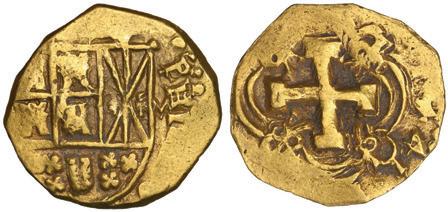
70. Bogotá, Colombia, gold cob 1 escudo, Ferdinand VI, assayer not visible (S), NGC XF 40. Restrepo-M92.2; S-B27a; KM-28. 3.34 grams. Bold full cross with distinctive “droplets between arcs” (per NGC) and most of HISPAN(IARVM) in legend, full shield with assayer and mintmark not visible but almost certainly F-S to left and S to right, nice yellow color. NGC #6454905-012. Estimate: $900-$1,350.

71. Gold “finger” bar ingot #3126, 463 grams, marked with three partial tax stamps, tested at 21.25K fine gold, ex-Atocha (1622), with hand-signed certificate from 1979. 6-1/4” x 1” x 1/2”. A complete ingot, like a fine cigar halved lengthwise as cast in a neat trough, the flat top with a deep, squarish cavity (extending laterally inside the ingot) where an air bubble was trapped as the metal cooled, also with three deep stamps showing only the dotted outer border of a Royal seal used to indicate that the quinto (20% tax) had been paid, one end naturally round but the other crudely chiseled where it was tested in its time for fineness, albeit without any markings for fineness or assayer/foundry or serial number, natural bright yellow in color and very tidy overall, significant as an early, pre-”Mother Lode” find. From the Atocha (1622), with original Fisher photo-certificate 3126 from 1979, hand-signed by Eugene Lyon, Claudia Singer, Don Kincaid, Mel and Dolores (Deo) Fisher, pedigreed to the J.P. Silberman Estate. Estimate: $35,000-up.
72. Gold “finger” bar ingot #548, 455 grams, marked with three partial tax stamps, tested at 21.5K fine gold, ex-Atocha (1622), with hand-signed certificate from 1976. 6” x 1” x 1/2”. Dark gold in color and neatly cast in a “half cigar” shape with relatively flat top bearing three light stamps that show only the outer dotted border of a Royal tax seal (typically minimally applied to conserve the seal itself), no markings of serial number, assayer/foundry or fineness but with typical removal at one end for testing in its time (the other end naturally round), desirable as not just a pre-”Mother Lode” find but also certified as recovered several years prior to the big yield of gold bars in 1980 when the site of the Santa Margarita was positively identified. From the Atocha (1622), with original Fisher photo-certificate 548 from 1976 (Cape Coral Bank), hand-signed by Eugene Lyon, Duncan Mathewson, Austin Fowles, Melvin (Mel) and Dolores (Deo) Fisher, pedigreed to the J.P. Silberman Estate. Estimate: $35,000-up.


73. Gold bar ingot from Colombia, 915 grams, marked with fineness XXII (22K), circular tax stamp and foundry BARBACO(A)S, ex-1715 Fleet, ex-Anderson, Craig and Richards Plate. 5-1/4” x 1-1/2” x 1/2”. A complete, wide, rectangular ingot with rounded bottom and relatively flat top with a wealth of markings interspersed with natural ripples from the metal-cooling process, includ ing fineness XXII in a box at one end and a nearly full crowned-shield tax stamp in center, between which is a large and fairly clear rectangular assayer/foundry cartouche with dotted border containing the name (B)ARBACO(A)S, the same as seen on a very similar ingot we sold in 2015 but with a different part of the cartouche visible (which we mistakenly called BARBAROSA), both ingots in fact featured in the Craig and Richards book as being among five high-karat gold bars found “in one day by divers from John Brandon’s M/V Endeavor working the 1715 site commonly called ‘Corrigan’s’ at Vero Beach,” the design of their markings leading us to conclude they were cast in Colombia, in which we now note there is an important gold-mining town in Nariño Department called Barbacoas, no doubt where this bar was produced. From the 1715 Fleet, with original Cobb Coin Co. photo-certificate 255 from 1983 (748 points) and official re-issued photo-certificate (1000 points), plated on page 114 and back cover of Spanish Treasure Bars (2003), by Craig and Richards, a copy of which accompanies this lot, also pedigreed to the collection of Don Anderson (the investor originally responsible for computerization of the Treasure Salvors division records, mentioned several times in The Search for the Atocha [1979], by Eugene Lyon) Estimate: $60,000-$90,000.
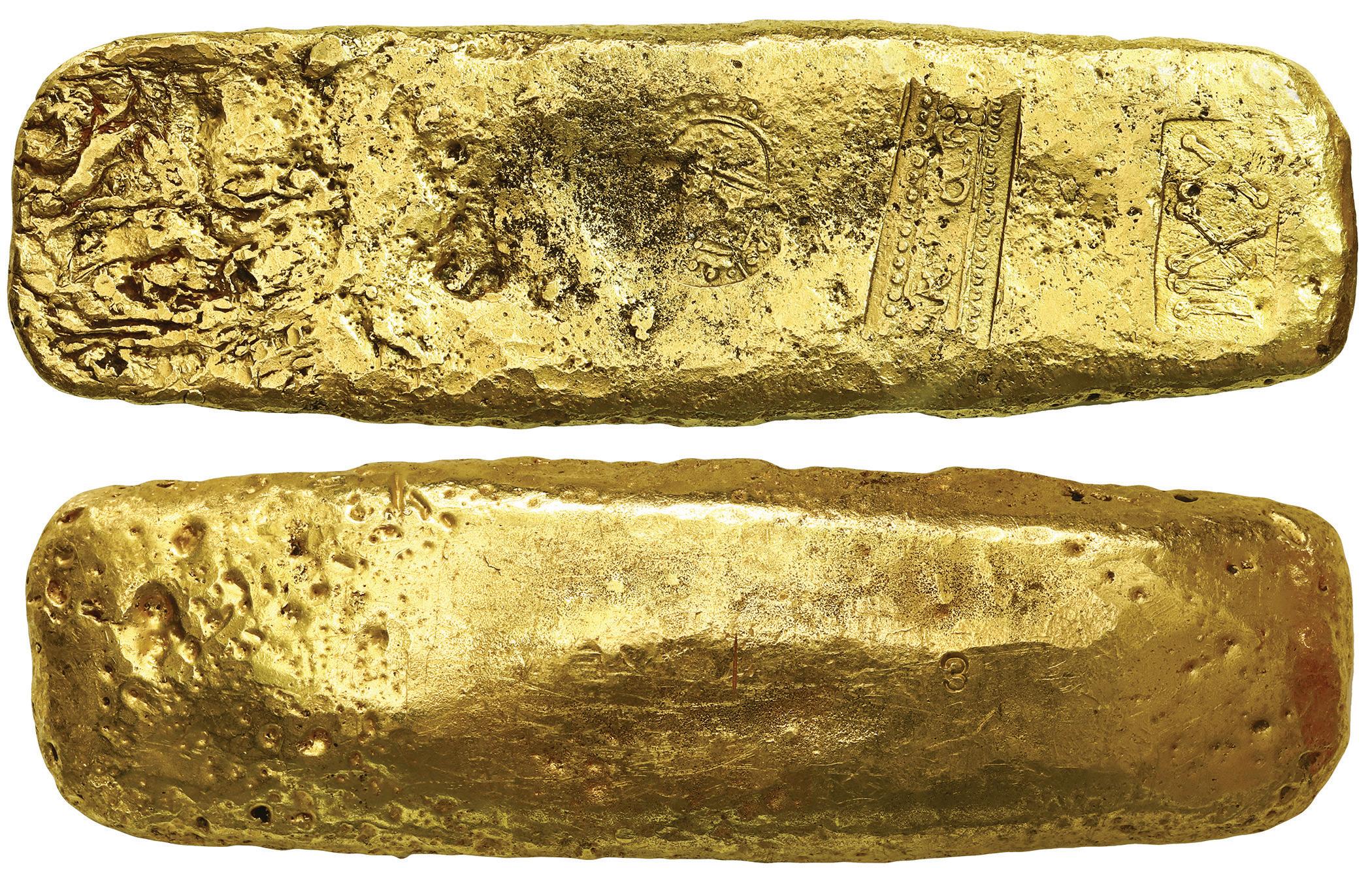
at

The gold ingots from the Luz, recovered in 1992 by a team led by Rubén Collado, have proven to be a fascinating part of the history of the Río de la Plata area of South America where the ship was found. The Luz was not a Spanish “treasure fleet” vessel, and the circumstances behind its cargo, sinking and salvage are well outside the norm. Similarly, the gold ingots it yielded are also unusual, with no tax or fineness markings, but still marked by owners’ or shippers’ ciphers, and they have been marginalized by researchers as a result, despite their possible geopolitical significance.
Most of what we know about the ship and cargo comes from the work of Dr. Juan Alejando Apolant, who published Crónica del naufragio del navio Nuestra Señora de la Luz in 1968, an opus that was reprinted in 1992 under the title El naufragio del navio Nuestra Señora de la Luz. This book provides many pages of contemporaneous documentation, including manifests, salvage reports and even listings of recovered items sold at auction in the mid-1700s. But before we can understand the meaning behind these data, first we must examine the political situation in the area at the time.
The region around the Río de la Plata in the 1700s was Spain’s version of the “Wild West,” largely governed by corrupt or even murderous officials and merchants competing with Portuguese colonists just to the north. The indigenous Guaraní, already decimated by European diseases, were stuck in the middle. Filling the role of protecting and educating these unfortunate natives were Spanish Jesuit missions. The Jesuits were and always have been rather adaptable, and in this corner of South America they were able to use their semi-autonomy to become wealthy and powerful, typically (and ironically) through the fruits of the natives’ labors. Eventually Spain and Portugal became intolerant of the Jesuits and expelled them from the New World entirely in 1767.
The Spanish Jesuit missions in this area were effectively city-states known as “reductions” in which the Guaraní were educated and indoctrinated in European culture and religion. The natives served the Compañía de Jesús (as the Jesuit society was known) in return for protection from virtual enslavement (encomienda) by the Spanish and Portuguese. As a part of the Catholic Church, the Jesuits were exempt from the 20% tax (quinto) imposed by the crown on silver and gold mined from the ground. To avoid a shipping tax (avería) as well, the Jesuit missions sometimes transported their wealth back to their headquarters in Spain in the form of contraband ingots. One particularly noteworthy anecdote from 1701 reports that a crate of chocolate from the New World en route to the Jesuit General in Spain was opened and examined due to a higher weight than declared; nestled inside the chocolate were gold ingots, and after they were confiscated the Jesuit General never claimed his chocolate!1 Keep this idea in mind—boxes marked for one thing but containing something else and later disavowed—as it could come into play with the Luz.
In the mid-1700s the missions got squeezed. Portuguese Brazil had expanded westward to conduct illegal trade between Spanish Peru and Portugal’s ally Great Britain (Spain’s enemy), and Spain wanted to put an end to that. Portugal, meanwhile, wanted to solidify its claim to gold-bearing regions that were technically outside the demarcation set by the 1494 Treaty of Tordesillas. The result was a new treaty between Spain and Portugal known as the Treaty of Madrid of 1750 that defined the modern borders of Brazil, which acquired the lands east of the Uruguay River where seven Spanish Jesuit missions stood. The missions were ordered to be abandoned and relocated across the river, but the Guaraní refused to either move or accept Portuguese rule, resulting in the Guaraní War of 1756, also known as the War of the Seven Reductions, which pitted the natives against the Spanish and Portuguese. The Guaraní did not prevail, and eventually about half finally relocated into the Spanish areas of modern-day Argentina and Paraguay.
It is exactly within this time frame that the story of Nuestra Señora de la Luz took place.
1 Ronchi, page 440.
The Río de la Plata and its environs were far removed from the usual Spanish colonial trade routes in the Caribbean and Pacific, and therefore its primary cities of Buenos Aires and Montevideo mostly had to rely on contraband trade, particularly with the Portuguese (allied with English). This changed in the 1740s, after the sacking of Portobelo in Panama by the English Admiral Edward Vernon, which caused the Spanish to create a new route from Peru around the southern tip of the continent (known as Cape Horn). Buenos Aires and Montevideo, the pillars of the Río de la Plata, became regular ports of call.
During that change, the inhabitants of Buenos Aires and Montevideo needed to take special measures to ensure trade with Spain would take place. One of those measures was to hire a Portuguese warship in Spain to come to Buenos Aires with various commodities and return to Spain with coins and other specie. A special company was set up for the purpose with Juan de Vargas Masías as one-half owner; the ship was called Nuestra Señora de la Luz
The Luz left Lisbon and came to Buenos Aires in 1748, where it offloaded its cargo of commodities bound for Peru. It was supposed to leave Buenos Aires at the end of 1749 but ended up staying there for three and a half years, finally leaving in March 1752. Rather than heading directly to Cádiz, the Luz instead stopped in Montevideo for three months. Exactly why is a matter of conjecture; it is possible the stop was to receive contraband.
The official estado2 of cargo loaded in Buenos Aires calculated 1,071,000 pesos in coins (899,500 in silver pesos fuertes and 171,500 in gold doblones, with 16 pesos of gold being a single 8 escudos, hence over 10,000 8 escudos), plus 416 + 535½ marcos (equating to almost 219 kg) of plata labrada (wrought silver) and 326 onzas in gold tejos (disks).3 It is important to note that these ingots were treated separately because the purity of each was unknown (or at least unstated), an important distinction that will come into play later. It is also important to understand that the Spanish onza (ounce) was a unit of weight equal to 1/16 of a libra (pound) of 460 grams, akin to the modern avoirdupois weights and not troy weights as we are used to for precious metals today. Therefore, 326 onzas amounted to 9,372½ grams.

Before proceeding, it is useful to understand how weights in gold (only) were calculated in Spain and its territories at the time (the gram weights rounded to the nearest full gram):4
1 marco = 50 castellanos = 400 tomines = 4800 granos = 230.0448 grams
1 castellano = 8 tomines = 96 granos = 4.600896 grams
1 tomín = 12 granos = 0.575112 gram
1 grano = 0.047926 gram
The detailed manifest of the ship’s cargo, known as the registro (registry), consisted of a list of 267 sequentially numbered partidas (consignments) with their consignors and other details, each actual partida typically being a leather-wrapped box marked with the mark of the consignor. Many shippers consigned multiple partidas. Among the 267 partidas registered to the Luz were nine consignments from two Jesuits, as follows:
2 In this context estado means “status” and refers to a summary of the cargo as a sort of “current status.”
3 In this context tejo means “disk” (see Burzio, p. 392).
4 This table is adapted from a similar tabulation on Apolant p. 99.
#90. From R.P. [Reverend Father] Alonso Fernández to Padre Pedro Arroyo, Procurador General5 of the province of Paraguay: 35,550 pesos y 4 reales en plata doble6 #91. From R.P. Alonso Fernández to Padre Pedro Ignacio Altamirano, Procurador of the Indies in Madrid: 12,000 pesos en 750 doblones de a 16 pesos del nuevo cordoncillo de Chile7 #92. From R.P. Alonso Fernández to Padre Francisco de Castañeda, Procurador of the Indies in the port of Santa María: 12,000 pesos en 750 doblones de a 16 pesos del nuevo cordoncillo de Chile #103. From Padre Jayme Passino, Procurador General of the missions, to Sebastián de Larraondo y Villamonte: 10,000 pesos en plata doble del cuño perulero en 4 zurrones de a 2500 pesos cada uno, marcados a fuego con la marca de enfrente8 #104. From Padre Jayme Passino to Andrés de Loyo of Cádiz: 4780 pesos y 1 real en plata doble #155. From R.P. Jayme Passino to Andrés de Loyo of Cádiz: 952 pesos y 3 reales en plata doble #156. From R.P. Jayme Passino to Andrés de Loyo of Cádiz: 463 pesos y 3 reales en plata doble #198. From R.P. Jaime [sic] Passino to Padre Pedro de Logu: 1000 pesos plata doble #223. From R.P. Alonso Fernández to Juan Andino of Cádiz: 9000 pesos en plata doble y 3000 pesos en doblones del nuevo cordoncillo
This equates to about 97,297 silver 8 reales coins and 1687½ gold 8 escudos coins, for a total of 124,297 pesos of value. That’s a lot of money for Jesuit missions! But no gold tejos are mentioned in these Jesuit partidas… could some have been hidden inside the boxes of coins?
The non-coin gold listed in the 267 partidas on the registro is as follows:
#31. Juan de Vargas Masías [half owner of the venture, as mentioned]: un tejo de oro quintado con peso de 71 onzas y 2 adarmes9 y según su quilca10 444 castellanos y 5 tomines11 [note this is the only tejo listed as being quintado (taxed)] #130. Juan de Eguía: un tejo de oro con 8 onzas y una adarme #162. Juan de Lezica: un cajoncito forrado en crudo y marcado con la marca de enfrente que contiene 11 cajetas de oro con peso de 55 onzas y 12 adarmes #173. Ventura Ferrer: 7 onzas, 12 adarmes de oro #209. Juan Francisco de Bazurco: 2 tejos de oro con 125¼ onzas #243. Marcos Joseph de Riglos: 54 onzas y 6 adarmes de oro #255. Francisco de Sagardia y Palencia: una cajeta de oro con peso de 3 onzas y 14 adarmes
The total weight in onzas of all this gold indeed adds up to the 326 onzas listed as a sum in the estado. Even though not all the partidas listed above say that the gold is in tejos, and in fact #162 and #255 only mention cajetas, which in this context should mean gold boxes (i.e., snuff boxes, of which several were found later), the fact is that the total weight agrees with what the estado lists as tejos. In any case, from this we can see that any amount of gold ingots recovered from the shipwreck beyond this amount had to be contraband, and the gold ingots in the Sotheby’s 1993 auction alone consisted of over 1,330 onzas!
5 The term procurador general is usually translated as “attorney general,” but according to Léxico Jurídico Español-Inglés (www.rebeccajowers.com), a procurador is not really an attorney in the sense that we use today; in this context, probably the best translation for procurador is “legal agent.”
6 The term plata doble (literally “double silver”) or plata fuerte (“strong silver”) denotes 8 and 4 reales coins (in this case probably cobs), with a peso being equal to 8 reales. The other term that occurs is plata sencilla (or pesos sencillos), a designation for the smaller denominations of ½, 1, and 2 reales. The reason for this distinction is that Spain had devalued their smaller coins (known by the English as “pistareens”) in both fineness and weight, but the 4 and 8 reales remained “strong.” (See Burzio, p. 206.)
7 Doblones de a 16 pesos del nuevo cordoncillo de Chile refers the new milled “bust type” 8 escudos gold coins that were struck at the mint of Santiago, Chile, starting in 1749; remember that one escudo in gold equaled two pesos in silver.
8 Here we have a new term, plata doble del cuño perulero, which means larger silver coins of the “Peru die,” hence Peruvian cobs (including those from Potosí). The rest of the entry says that the coins were packed in bags (zurrones) inside boxes branded with a marca (mark) on the outside. It is worth noting that the actual registro shows these marcas, but unfortunately Apolant did not think it was necessary to reproduce the marks in his opus.
9 An adarme was 1/16th of an onza
10 The term quilca in this context (unbeknownst to Burzio or Apolant, who thought it had to do with fineness) refers to an actual marking on the ingot denoting its weight in castellanos, tomines and granos. We see such markings on the Sotheby’s ingots that lack marcas, as mentioned in point 4 below.
For more information about this term, see Gargurevich Regal, p. 73.
11 This is either an error in the manifest itself or more likely an error in Apolant’s transcription, as the weight of the ingot is equivalent to 444 castellanos and 5 granos (not tomines), namely 2,045 grams. Again, the Sotheby’s ingots show these markings, and in most cases we see two colons in between the numbers to show zero tomines in the middle (x:x:x).
Other marks/notes Pesos** 236238.667.678.300.848A/VXXVI26130.52 237601.0519.3320.910.946ŠN-XI-11366.70 238285.989.209.950.926P170.79 239682.1021.9323.730.900A/VXXV25threelargefleurs,onewithA/Vover395.91 240690.8422.2124.030.975A/VXIV14threesix-pointstars,RAinbox434.40 241372.5511.9812.960.750A/V48,,48180.20 242414.1713.3214.410.878threescallopsaround90::1[weight]*234.52 243914.5929.4131.810.955ŠXIII13563.30 2441135.2436.5039.490.928A/VXXXXIIII44679.43 2451126.0936.2139.170.909A/VXXXXVI46660.16 2462237.1071.9377.810.962Miguel…1387.94 247732.4823.5525.480.857A/VXXXVI36threescallopsaround159[weight]*404.84 2481442.5346.3850.170.902P839.15 515756.0324.3126.300.797164-1[weight]*388.60 516458.2214.7315.940.791A/V4747233.76 517596.5819.1820.750.938ŠXVII17360.90 518494.2315.8917.190.731A/VXXVIII28233.00 519979.6031.5034.070.896P566.07 520919.7029.5731.990.923A/VXXXIII33[anactualbar,notrounded]547.47 5211222.3339.3042.520.975MAGNA/PATER/AGITinheart768.61 5221922.8161.8366.880.977Miguel…1211.55 523785.9325.2727.340.811threescallopsaround171::1[weight]*411.07 5242290.5073.6579.670.962Miguel…1421.07 525620.5419.9521.580.848A/VXXIV24339.37 526308.899.9310.740.969A/VXXXXII42193.04 527235.207.568.180.935ŠXVIII18[anactualbar,notrounded]141.83 528675.4121.7223.490.975ŠVIIII8threehollowsix-pointstars424.70 5291436.6546.1949.970.975A/VNo4949JRTomonograminform-fittingbox903.37 7552024.9065.1170.430.966Miguel…1261.51 756307.039.8710.680.927A/VXXVII27threescallopsaround66::5[weight]*183.56 757645.2620.7522.440.819A/VXXIII23340.82 758981.3731.5634.130.888P562.03 759929.6429.8932.340.945ŠXIIII14566.57
These gold tejos can be summarized by their markings as follows:
1. A/V monogram is most prevalent (nineteen ingots), numbered sequentially 23-29 and 41-49, plus 14, 33 and 36 (all in Roman numerals except for 47-49), with the widest range of purities (0.731 to 0.975) and weights (7.67 to 46.19 oz each) in the whole group.
2. Second commonest is Š (six ingots), numbered 8, 11, 13, 14, 17, 18 (all in Roman numerals), all high in fineness (0.935 to 0.975) and small to medium in weight (7.56 to 29.89 oz each).
3. Tied for third (five ingots each) are script P and a whole signature that starts with Migl…, neither with any other marks, with fineness from 0.888 to 0.977, all but one being among the heaviest ingots found (script P being 31.50 to 46.38 oz each except for one small one at 9.20 oz, and Migl… being 61.83 to 73.65 oz each).
4. Four others have no marca but instead show weights (quilcas) stated in castellanos and granos (equating to 13.32 to 60.63 oz each), all but one with scallop marks around the weight, all rather low in fineness (0.797 to 0.884).
5. Just one big ingot (39.30 oz) has a large Sacred Heart marca containing the words MAGNA / PATER / AGIT, also high in fineness (0.975), this one more than any others believed to be connected to the Jesuits for obvious reasons.
Note that the 40 ingots sold in 1993 total 1,330.71 onzas in weight, which, when multiplied by their individual purities and converted to pesos, total about 22,726 pesos. We will come back to this figure, but for now it is enough to know that it well exceeds the 326 onzas on the ship’s official manifest.
Mysteriously, there were also reports of 200,000 pesos that the Portuguese captain of the ship, Felicio da Fonseca, and the ship’s chaplain, who was “Padre Fray Joseph de Santo Tomás del Orden de la Victoria,”12 according to partida #195, carried in the gunpowder locker bound for Lisbon, a consignment that did not appear in the registry and therefore was considered contraband. It is not known whether this “200,000 pesos” was all coins or included tejos or something else. Amazingly, there was very little discussion about this mysterious consignment after the sinking, even though Fonseca was already under scrutiny for taking passage money for additional passengers without authorization.
On July 2, 1752, while the passengers and crew (including the aforementioned captain and the supercargo, Pedro de Lea) tried to board the ship, the wind picked up and blew the Luz away from the port. Montevideo’s infantry captain, José Zumelzu, described it as the worst storm he had ever seen in that river, the kind of storm now referred to locally as a pampero (akin to a strong cold front in the U.S.). The ship was not heard from again.
Officially, 133 people (everyone on board) perished with the ship13, while 22 remained on shore, including the captain Fonseca and supercargo Lea. The chaplain, Fr. Joseph de Santo Tomás, sank with the ship. Over the next several weeks, dead bodies and kegs of water and wine washed up on shore, followed by trunks and boxes. Everything (supposedly) was turned in and inventoried, including all kinds of personal goods, clothing, bedding, utensils etc., but eventually also some gold and silver.
The search for the shipwreck site itself soon began, using local divers led by Captain Luis Fort. The hull was found on September 4, just one mile offshore and about five meters down, and by the end of November 1752 the ship’s treasure had been located. Recoveries took place continuously through May 1753 (basically until the start of winter for the southern hemisphere). After some complicated negotiation with the consignors in Buenos Aires, who would be compensated with whatever was found, the divers were granted a 3% cut of the recoveries, and Captain Fort retained 6,000 pesos, plus the deduction of other expenses totaling 2,071¼ pesos. Eventually the total amount of coins and tejos recovered (valuing the gold at 16 to 1) amounted to 1,029,326 pesos, or about 96% of the registered cargo.14 This included some gold tejos specifically mentioned in the daily recoveries in 1752, as follows:
12 I was unable to find any reference to an Order of Victoria, nor any other mention of the ship’s mysterious chaplain, except that he was among those who died when the ship sank.
13 Apolant (p. 40) feels this number was too low, based on (among other things) a letter from Captain Fonseca saying that 141 lost their lives. In addition to gold and silver, it is possible people were being smuggled as well.
14 Confusingly, Apolant (p. 71) speaks of the recovery of 92½% of the registered treasure “en cifras redondas” (in round figures), but that is AFTER the divers’ 3% and other expenses were taken out, plus he later reduces it to 87% after other expenses; his point was simply to show how the shippers made out, not to say how much was actually recovered.

December 13: 2 tejos de oro con valor de 2,032 pesos
December 14: un tejo de oro con valor de 132 pesos
December 23: un tejo con valor de 1,127 pesos
The weights of these four tejos are not indicated, nor do we know how their values in pesos were determined since their purities were unknown (it does not help that, by his own admission, Apolant “simplified” the list). If the divers got 3% of the full 1,029,326 pesos stated, then the remainder should have been 998,446 pesos. However, an official treasury report in July 1753 gave a total of 989,145 pesos on hand (i.e., after the 3% was paid out to the divers), but with four gold tejos (presumably the same ones listed above) weighing a total of “12 libras y 12 onzas” (204 onzas, equivalent to 5,865 grams15) that were not converted into pesos “por no saber su regla”; in other words, the tejos could not be converted because their purities were unknown, but a value had to be assigned to them in order to pay the divers an accurate 3%. A further sum of 6,577½ pesos “from the final days of the salvage” were added to make the total 995,722½ pesos.
With little explanation, a final report on August 8 gave the total (after the 3% was taken out for the divers, but before 8,071¼ pesos were removed to pay Luis Fort and other expenses) as “en las especies de plata doble, oro acuñado y tejos 998,831½ líquida y 112 marcos plata chafalonía y 22½ onzas de oro en la misma especie.” This presents two obscure terms that are difficult to translate (even for Apolant): líquida and chafalonía. I believe the former means “net” and the latter means “unusable.” In other words, the treasure consisted of net 998,831½ pesos in silver coins, gold coins and tejos, plus a bunch of silver and gold that could not be converted (“unusable” for the total). The difference between 998,831½ and the previously reported 995,722½ is 3,109 pesos; the sum of the values given to the four tejos in December was 3,126 pesos—close enough for government work!16 But is it possible the 22½ onzas of gold mentioned as “unusable” were also tejos? Even if so, that means at most only 226½ onzas (22½ plus the 204 onzas that were somehow converted) were recovered in 1752-3 from the 326 onzas of gold tejos that were registered to be on board the Luz. Even without considering contraband, at least 100 onzas were still missing.
The 1752-53 dive effort and recovery of 998,831½ pesos (however it was tallied) managed to satisfy the shippers in Buenos Aires whose registered cargo had gone down, even though it was evident there was still much more to be salvaged due to contraband.17 Interestingly, the loss ended up not being so disastrous for these official shippers at the expense of the smugglers, who lost everything; as the Argentines say: El que roba a un ladrón, tiene cien años de perdón (literally, “a thief who steals from a thief gets 100 years of pardon,” meaning it is no thievery to steal from a thief). It is unclear how shippers of gold ingots were reimbursed when only the weights and not the purities were recorded on the manifest. Suspiciously, the Jesuit padres Fernández and Passino were not listed among the shippers who were to receive compensation, nor were they among the officially recorded survivors (those who were left on shore) or casualties of the sinking. The fact that they did not have an interest in compensation for their losses seems like a cover-up, just like the 1701 incident mentioned above!
Most of the official documentation following the salvage effort reflected an obsession with accounting for expenses and collecting money to pay for them, particularly sales through various merchants and local auctions (called remates and almonedas as opposed to the term subastas that we see today) of non-treasure items like clothing and wine recovered on the beaches. More interesting to us is the statement in late 1753 by Montevideo’s Captain General Andonáegui, while setting up a new dive effort, that once the expected finds to be made had fulfilled the remaining total of the registered cargo, any excess should be saved for the king, “igual que todo el oro y plata en tejos y barras sin quintar” (just like all the untaxed silver bars and gold disks)! This statement confirms that the first divers had recovered gold tejos like the ones we see from the 1992 salvage… and they were indeed contraband.
15 Apolant calculated this incorrectly, as he stated it totaled “5.842 kgs.” The correct calculation is: 12 libras @ 460 grams/libra = 5520 grams, 12 onzas @28.75 grams/onza (1/16 of a libra) = 345 grams, total: 5,865 grams.
16 Apolant says the slight difference could be due to how they converted the values of the gold tejos into doblones and pesos in the daily reports. He does not address how the conversions were done in the first place, as there is no mention of any assays and it is clear from the ingots recovered in 1992 that all the tejos lacked fineness markings, which of course Apolant did not know in 1968.
17 It is unclear how Vargas himself was somehow reimbursed, as he was half owner of the venture but also a shipper on record, both of coins and of gold tejos. He was later quoted as saying in December 1752 that he was not interested in the remaining “fragments” since the ship was insured. Two other shippers of gold tejos apparently also were not among the recipients of the finds: Ventura Ferrer, who died on the ship, and Francisco de Sagardia y Palencia (reason unknown).

More salvage took place in four seasons in 1753-57. While we do not have a record of those recoveries, official correspondence in August 1757 regarding how much more needed to be found to reach the original registered total of 1,071,000 implied that an additional 27,000 pesos had been recovered since that initial 1752-53 season. The next effort was not till February-April 1760, for which we do have an itemized tally of 3,153 pesos dobles (i.e., all large silver coins), all found within a span of less than eleven weeks. This seems to have re-energized the salvage idea and created a bit of a competition. The next two seasons (December 1760 to April 1761 and November 1761 to February 1762) produced another 994 + 2840½ pesos dobles. During this time, more significant personal effects were auctioned off, including several gold boxes (cajetas, presumably snuff boxes like the ones sold in the Sotheby’s auction in 1993), gold jewelry (including a toothpick on a chain, like we see from other shipwrecks) and all kinds of silverware and other valuables. Much reporting concerned the documentation and distribution of the proceeds to the king and interested parties… but no mention of any gold tejos
No more official salvage took place until 1771, and efforts from that year through 1774 yielded only a bit over 1,000 pesos, all in silver and gold coins. In September 1773 one of the divers claimed to know where the stern of the ship was located—away from the main deposit—including the gunpowder locker with its 200,000 pesos of unregistered specie. The long hoped-for contraband cache was not found, however, contributing to the growing belief that it had scattered in with the previous finds.
Of course, we know better from the finds in our time. The Luz was re-discovered in April 1992 by the Argentine treasure hunter Rubén Collado, whose divers recovered a total of 1658 gold coins and 320 silver coins, 18 along with some artifacts and of course all the gold disks in the 1993 Sotheby’s auction. At some point it was determined that they had found the stern and the contents of the long-sought gunpowder locker. However, even if all the gold coins were 8 escudos (most were, but many were not), this would equate to less than 27,000 pesos, a far cry from the 200,000 pesos in contraband being smuggled to Lisbon by the captain and chaplain of the ship. As we have already seen, the gold disks auctioned in 1993 amounted to nearly 1,331 onzas, equating to 22,726 pesos. Since at least 100 onzas of tejos on the official manifest were still unaccounted for after salvage in the 1700s, that means that more than 1200 onzas in gold disks recovered in 1992 had to be contraband. As mentioned, these could have been smuggled by the Jesuits in their partidas, or they could have been part of the 200,000 pesos being smuggled by the captain and chaplain. If the latter, that still leaves over three quarters of the smuggled specie unaccounted for. Since a total of maybe 1,065,000 pesos of the original 1,071,000 in registered cargo was found officially, and we know of 200,000 pesos of contraband on top of that, of which only around 50,000 pesos were recovered in 1992, that leaves at least 156,000 pesos unaccounted for. Did that treasure consist of coins or ingots, and is it still down there, or was it secretly recovered sometime in the 18th century? We may never know.
Clearly, we have created more questions than answers, but hopefully we are closer to at least a quantitative understanding of the fate of the gold tejos. Whether or not they were tied to the Jesuit exodus will probably remain no more than a circumstantial connection. If the original manifests summarized by Apolant can be found, perhaps we can connect some of the marcas shown next to their partidas to the tejos sold in 1993, or even better, maybe the markings on these gold ingots can be positively linked to specific Jesuit missions.
In any case, if you are a collector of ingots, whether as an individual or for an institution, you owe it to yourself to own one of these beautiful pieces of history if given the opportunity. Whether they represent the wealth of retreating Jesuits or of Spanish contrabandistas, they are a unique part of the Spanish colonial history of the Río de la Plata area of South America.
Lovardo, p. 282.
Bibliography:
Apolant, Dr. Juan Alejando. Crónica del naufragio del navio Nuestra Señora de la Luz. Montevideo: 1968. Reprinted in 1992 under the title El naufragio del navio Nuestra Señora de la Luz. Burzio, Humberto. Diccionario de la moneda Hispanoamericana. Santiago: 1958. Castells & Castells (Montevideo). “Nuestra Señora de la Luz”, auction catalog of October 27, 1997. Gargurevich Regal, Juan. La comunicación imposible: información y comunicación en el Perú (siglo XVI). Lima: 2002. Lovardo, Mariano. Reuniendo un tesoro español pieza por pieza. Buenos Aires: 2015. Ronchi, Aquiles. Educación política para establecer la libertad de los pueblos, o sea Los males y los remedios sobre la organización administrativa social con un apéndice resúmen histórico de los borbones y de Pio IX. Madrid: 1869. Sotheby’s (New York). The Uruguayan Treasure of the River Plate, auction catalog of March 24-25, 1993.
74. Gold disk ingot, 1340.88 grams, tested at 0.926 fine gold (22.224K), marked with script P, ex-Luz (1752), ex-Sotheby’s. 3-1/4” in diameter and up to 3/4” thick. A thick, heavy and very neatly cast disk with rounded bottom and flat top (all hammered smooth in its time) showing small barnacle “footprints” over the bright yellow gold, the surface bearing just one marking, an elegant script P, notably without any evidence of taxation via stamp or cutting, hence most likely contraband and/or possibly connected to the Jesuit missions (which were exempt from taxation), but with one small area of filing on the edge where the metal was tested contemporaneously. From the Luz (1752), pedigreed to Sotheby’s Uruguayan Treasure of the River Plate auction of March 1993, with original lot-tag 764 and Sotheby’s catalog. Estimate: $70,000-$100,000.

75. Gold oval ingot, 1126.09 grams, tested at 0.909 fine gold (21.816K), marked with V-over-upside-down-V monogram and XXXXVI, ex-Luz (1752), ex-Sotheby’s. 4” x 3-1/4” in diameter and up to 3/4” thick. Slightly irregular in shape but with very smooth top from hammering in its time (the bottom left in its natural, pitted state), possessing very deeply engraved markings that stand for a serial number 46 and an owner or consignor whose name or “call sign” looks like XX but is really a V over an upside-down V (if you follow the serifs in the corners), also with traces of barnacle “footprints” here and there, no tax stamps or cuts (as probably contraband and/or connected to Jesuit missions) but with light file marks where the metal was tested contemporaneously in a couple of areas on the edge, a very attractive ingot that contains much intrinsic value in a small and manageable size. From the Luz (1752), pedigreed to Sotheby’s Uruguayan Treasure of the River Plate auction of March 1993, with original lot-tag 245 and Sotheby’s catalog. Estimate: $60,000-$90,000.

76. Gold oval ingot, 645.26 grams, tested at 0.819 fine gold (19.656K), marked with V-over-upside-down-V monogram and XXIII, ex-Luz (1752), ex-Sotheby’s. 3-1/2” x 1-3/4” in diameter and up to 3/4”

thick. A cute little piece, deceivingly heavy, with all surfaces hammered smooth in its time, both on the rounded bottom and on the flat top, with markings on both sides including a serial number 23 (on bottom) and an owner/consignor whose name or “call sign” was a monogram that looks like A/V (on top), no tax stamps or cuts (as probably contraband and/or connected to Jesuit missions) but with some faint file marks on part of edge where the fineness was tested contemporane ously. From the Luz (1752), pedigreed to Sotheby’s Uruguayan Treasure of the River Plate auction of March 1993, with original lot-tag 757 and Sotheby’s catalog. Estimate: $35,000-$50,000.
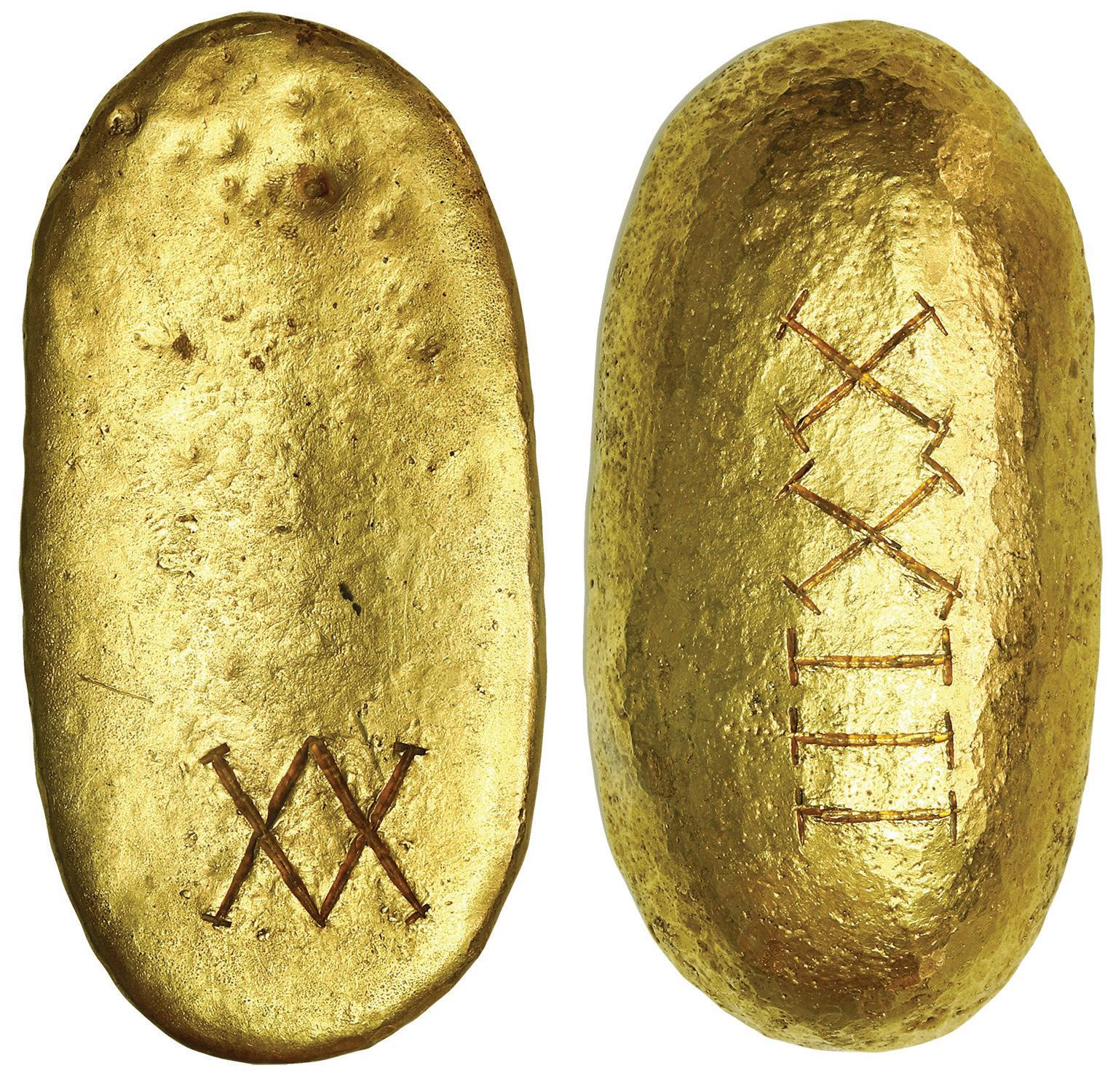
77. Silver “splash” ingot, 528 grams, marked with fineness IIU CCC L X (2360/2400, 98.3% fine) and circular crowned-C tax stamp (Charles I), ex”Golden Fleece wreck” (ca. 1550). 5” diameter, 1/4” thick. About the size and thick ness of a pancake but with about seven little “drip blobs” on top surface, across the middle of which appears clear markings of fineness in five small boxes bookended with two clear and nearly full crowned-C tax stamps, the bottom with areas of peripheral coral encrustation and minor corrosion, bright silver in color overall, desirable as among the better-marked ingots from this early wreck. From the “Golden Fleece wreck” (ca. 1550). Estimate: $2,000-$3,000.
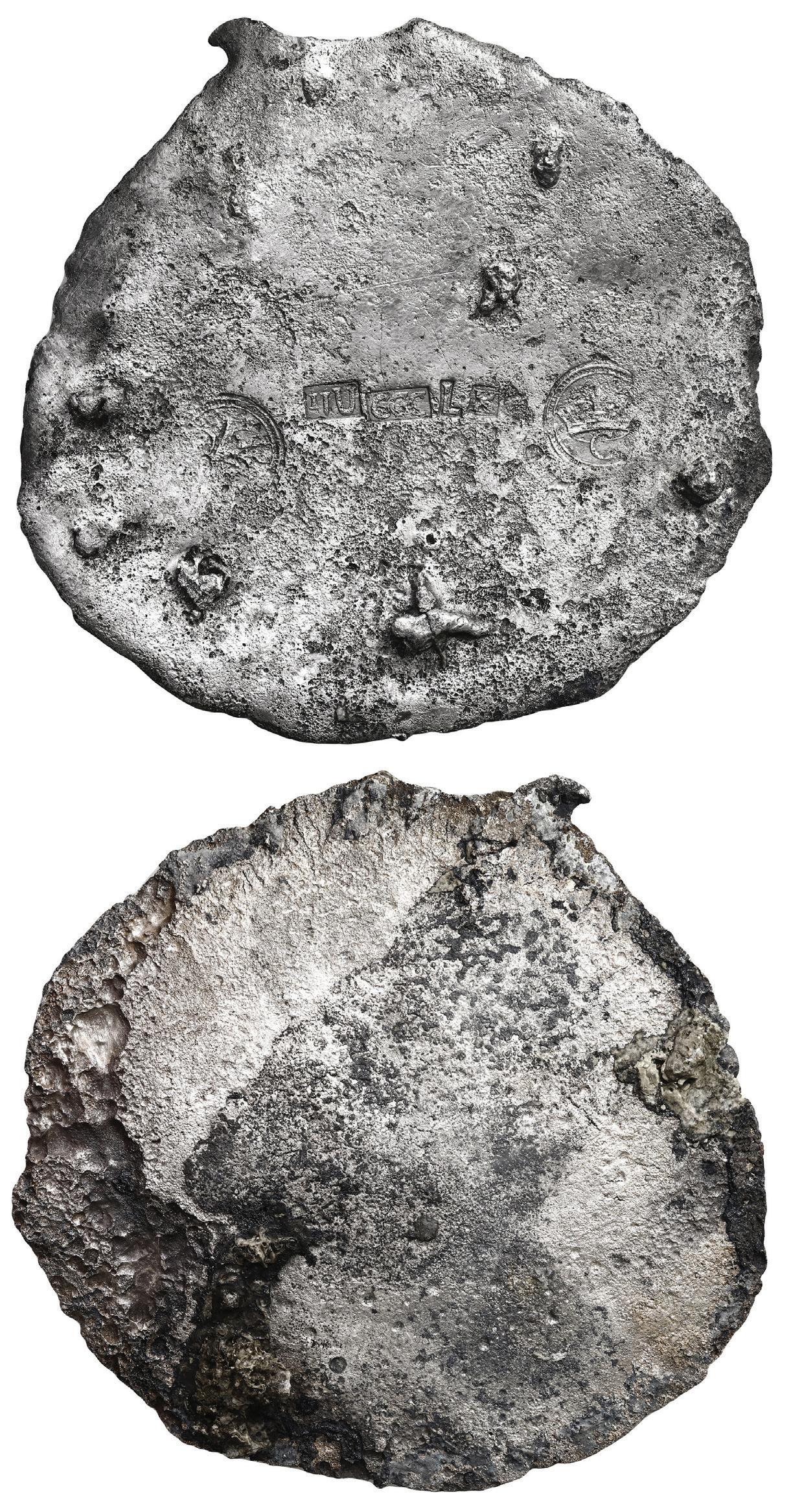
78. Large silver ingot #699 made in Potosí, Bolivia, 78 lb 9.28 oz troy, Class Factor 1.0, marked with fineness IIUCCCLXXX (2380/2400, 99.16% fine), date 1622, manifest number IUCLXIII (1163), assayer MEXIA, tax stamps and owner/shipper marks, ex-Atocha (1622). 13-1/2” x 5” x 3”. This is a choice Atocha ingot, with all the markings full and clear on top, including the rarely seen cartouches for mine-date Po1622 and assayer Iov.ssE. / MEXIA (Juan Sánchez Mexía), the latter placed to right of the fineness in eight bold boxes, also with four partial coin-like tax seals (one with clear S to right, just inside the full king’s name and ordinal PHYLYPVS IIII, as it was being spelled at Potosí then), bold manifest number IUCLXIII and owner/shippers’ marks (siglas) A and diamond-topped T (which somehow corresponds to “Ucarraga by Muñibe to Rodríguez” on the manifest), plus a V in one corner for silvermaster de Vreder. Also on top is the typical peanut-shaped double-scoop “assayer’s bite” (bocado), characteristic of Potosí-mine ingots. With minimal surface corrosion and nice toning in the markings, this is a very attractive bar, one of the best we have had in a while. From the Atocha (1622), with original Fisher certificate 85A-S699. Estimate: $35,000-up.

79. Large silver ingot made in Oruro, Bolivia, 28.75 kg, tested at 98% fine, no markings, encrusted with large piece of coral (as found), ex-Maravillas (1656). 15” x 4-1/2” x 3”. Large ingots like this one from the Maravillas are very similar in size and shape to Atocha ingots, but for whatever reason they were found in much smaller numbers, this one in fact being only the third we have offered. Unfortunately, this ingot bears no visible markings due to corrosive pitting on the top surface, now toned in an even gray color; but it is unique in having a large section (about 6”) of oystery coral encrustation in one corner, very thick and stable, making for a fabulous display, also with small spots of coral elsewhere on the bar, including in the cylindrical “assayer’s bite” at one end indicative of the Oruro mine. From the Maravillas (1656), pedigreed to the J.P. Silberman Estate. Estimate: $20,000-up.
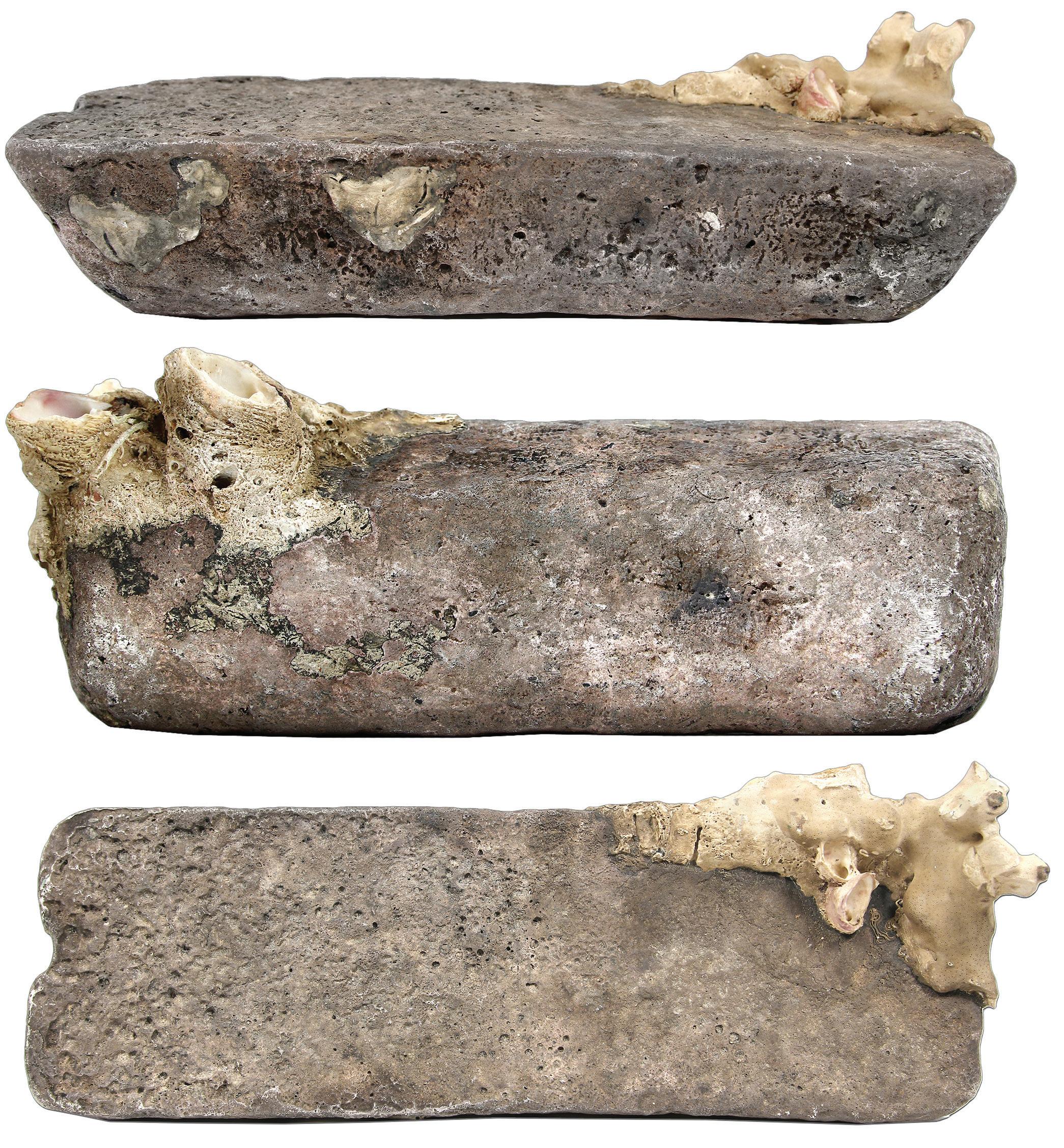
80. Small silver contraband “finger” bar ingot, 608 grams, mixed fineness (up to 98%), no markings, ex-Maravillas (1656). 5-1/4” x 1-1/4” x 3/4”. Typical shape with rounded bottom and sides but flat top, most of the surfaces silvery but punctuated with significant areas of copper color, no markings of course and truly contraband in having a wide range of fineness across its volume (as tested by XRF), having clearly avoided official testing and taxation. From the Maravillas (1656). Estimate: $1,250-$2,000.
81. Small silver contraband “finger” bar ingot, 519 grams, mixed fineness (up to 98%), no markings, exMaravillas (1656). 5-1/4” x 1-1/4” x 3/4”. Typical shape with rounded bottom and sides but flat top, dull-gray silver in color all over except for a few dark patches on top, characteristically unmarked and with a range of tested fineness as not being part of the official refining, testing and taxation at the mine. From the Maravillas (1656). Estimate: $1,250-$2,000.
82. Neatly cast Dutch silver ingot, 1148 grams, about 98.5% fine, marked with the Zeeland/Middelburg VOC stamp and F-E assayer cartouche, ex-Bredenhof (1753), ex-Christie’s. 6” x 1-1/2” x 1-1/2”. For whatever reason, several of the ingots from this wreck were found with significant areas lost to oxidation and wear, like the present piece, but this one experienced a stroke of luck, as one of the unaffected areas happened to contain the chamber stamp and assayer cartouche, but fully and clearly represented here, the former consist ing of a VOC monogram with Z above (the M below not visible) and the latter with fleur-de-lis above F-•E for assayer François Engelsen Jr, all nicely toned. From the Bredenhof (1753), with original (small) certificate from the salvors and lot-bag from the original Christie’s (Amsterdam) auction of December 1986. Estimate: $2,000-$3,000.



83. Mexico City, Mexico, 4 reales, Charles-Joanna, “Late Series,” assayer R to left, mintmark M to right (R-M), rare, NGC AU details / saltwater damage / Golden Fleece (Shipwreck Label). Nesmith-74; Cal-134; S-M7; KM-18. 12.38 grams. Nearly black in color but with full details as with only very light surface cor rosion, the somewhat rare (for the Golden Fleece wreck) assayer R to left very clear, certainly a better specimen from this shipwreck. NGC #6474485-007. Estimate: $700-$1,000.
84. Mexico City, Mexico, 4 reales, Charles-Joanna, “Late Se ries,” assayer A to right, mintmark M to left (M-A). Nesmith-58 type; Cal-131, S-M6; KM-18. 12.47 grams. Full legends and inner details, just some light to moderate corrosion toward the edge, light-gray silver in color, lustrous AU with full, well-struck legends. Estimate: $400-$600.
85. Mexico City, Mexico, 2 reales, Charles-Joanna, “Late Series,” assayer L to right, mintmark M to left (M-L). Nesmith-85, Cal-101; S-M9; KM-12. 5.02 grams. Typically rusty brown in color (some sedimentation remains), with details a bit worn from oxidation but with clear interiors and crown and most of legends. Estimate: $200-$300.
86. Mexico City, Mexico, 2 reales, Charles-Joanna, “Late Series,” assayer O to right, mintmark oM to left (oM-O). Nesmith-109; Cal-103; S-M10; KM-12. 6.51 grams. Bold full shield with O to right but peripherally flat on that side, full pillars-and-waves with some areas of pitting, scarce as from this wreck. With generic (small) certificate from the salvor. Estimate: $200-$300.
87. Mexico City, Mexico, cob 4 reales, Philip II assayer O below mintmark oM to left, denomination o-IIII to right. S-M11; KM-36; Cal-505. 13.40 grams. Choice broad flan with very sharp and well-struck interior details and most of legends including a full PHILIPPVS:II:, attractively toned and virtually corrosion-free. With generic (small) certificate from the salvor. Estimate: $350-$500.
88. Mexico City, Mexico, cob 4 reales, Philip II assayer O below mintmark oM to left, denomination not visible to right. S-M11; KM-36; Cal-505. 12.71 grams. Good full shield with full oMO, full but lightly pitted cross-lions-castles, nicely toned, edge-split. With generic (small) certificate from the salvor. Estimate: $250-$375.



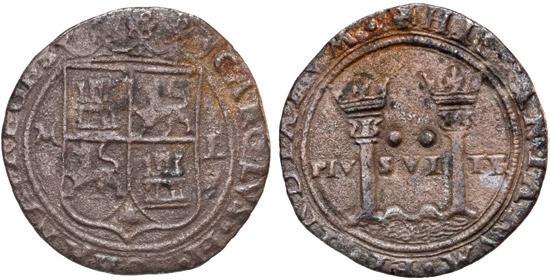

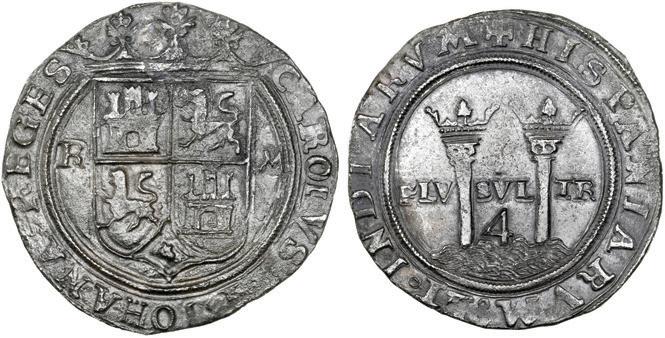
89. Seville, Spain, cob 4 reales, Ferdinand-Isabel, assayer Gothic D on reverse. Lopez de la Fuente-H5.6; Cal-564. 11.38 grams. Full and clear inner details including bold mintmark S to left and denomination o-IIII to right, with contrasting toning in crevices, only light surface corrosion, the legends a bit truncated due to rounding of the edge by a modern jeweler, scarce early issue as from this wreck. With generic (small) certificate from the salvor. Estimate: $200-$300.
91. Seville, Spain, cob 4 reales, Philip II, assayer Gothic D at four o’clock outside tressure on reverse. Cal-573. 12.86 grams. Bold mintmark S to left of full shield, full cross-lions-castles, light surface corrosion, gunmetal toning. With generic (small) certificate from the salvor. Estimate: $250-$375.
90. Seville, Spain, cob 8 reales, Philip II, assayer Gothic D at four o’clock outside tressure on reverse. Cal-720. 26.18 grams. Sharply detailed full shield and cross-lions-castles, king’s ordinal II in legend, attractively toned and only corroded on part of edge, one neat edge-split. With generic (small) certificate from the salvor. Estimate: $300-$450.






92. Seville, Spain, cob 2 reales, Philip II, assayer Gothic D at four o’clock outside tressure on reverse. Cal-400. 6.49 grams. Excellent full shield and cross-lions-castles with contrasting toning and minimal corrosion, also much legend and with full mintmark S to left and denomination II to right. With generic (small) certificate from the salvor. Estimate: $200-$300.
93. Potosí, Bolivia, cob 8 reales, Philip II, assayer B (5th period). S-P14; KM-5.1; Cal-672. 21.04 grams. With bold full shield and lightly corroded full cross-lionscastles, all nicely toned, this is one of the best examples we have ever handled from this less-well-known shipwreck, most of whose finds were razor-thin. With Sedwick photo-certificate from 1997. Estimate: $500-$750.
94. Mexico City, Mexico, cob 8 reales, 1621 D, Grade 3 (16 points), with hand-signed certificate from 1975. S-M18; KM-44.3; Cal-908. 23.64 grams. Nearly full shield with clear oMD to left inside a date that shows a full Z (2) and bottom of I (1) of date (not mentioned on the certificate), the cross side heavily corroded and darker, desirable pre-”Mother Lode” certificate. With original Fisher carboard holder and photo-certificate 2078 from 1975 (Cape Coral Bank), hand-signed by Eugene Lyon, Claudia Singer, Austin Fowles, Mel and Dolores (Deo) Fisher, pedigreed to the J.P. Silberman Estate. Estimate: $700-$1,000.
95. Mexico City, Mexico, cob 8 reales, Philip III, assayer D, Grade 1. S-M18; KM-44.3. 24.58 grams. Broad flan with good full cross inside a flat periphery, the shield side similar but with a little less de tail yet including a clear oMD, lightly toned and with only very light surface corrosion. With original Fisher tag and certificate 85A-218888, pedigreed to the J.P. Silberman Estate. Estimate: $1,250-$2,000.




96. Mexico City, Mexico, cob 4 reales, Philip III, assayer D, Grade 2 (22 points), with hand-signed certificate from 1978. S-M18; KM-37.2. 10.18 grams. Full shield and cross despite moderate corrosion all over and with small edge-split, lightly toned, the oMD fairly clear, desirable pre-”Mother Lode” certificate. With original Fisher cardboard holder and photo-certificate 914 from 1977, hand-signed by Eugene Lyon, Duncan Mathewson, Claudia Singer, Mel and Dolores (Deo) Fisher, pedigreed to the J.P. Silberman Estate. Estimate: $800-$1,200.
97. Potosí, Bolivia, cob 8 reales, Philip II, assayer B (3rd period), Grade 2. S-P10; KM-5.1; Cal-672. 21.13 grams. Full shield and cross somewhat obscured by surface corrosion, toned all over, the mintmark-assayer P-B a bit weak but clear (tag and certificate say Philip III in error). With original Fisher tag and certificate 86A-189984, pedigreed to the J.P. Silberman Estate. Estimate: $800-$1,200.

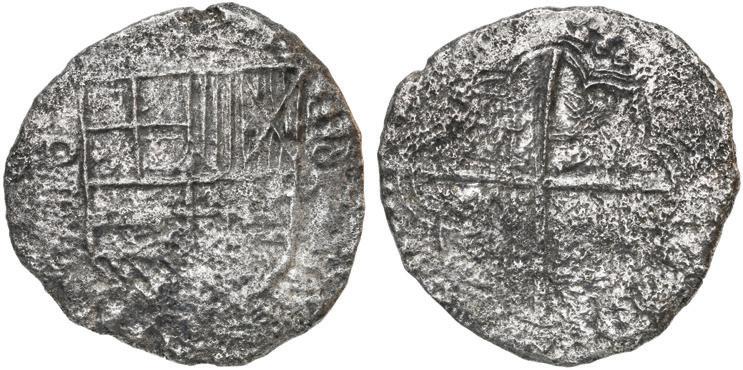
99. Potosí, Bolivia, cob 8 reales, Philip II, assayer B (4th period), Grade 1, with hand-signed certificate from 1982. S-P12; KM-5.1; Cal-672. 21.75 grams. Broad flan with choice full crown, also full shield and cross but lightly to moderately corroded all over, lightly toned, desirable pre-”Mother Lode” certificate. With original Fisher tag and photo-certificate SR-1298 from 1982, hand-signed by Leah Miguel, pedigreed to the J.P. Silberman Estate. Estimate: $1,000-$1,500.
98. Potosí, Bolivia, cob 8 reales, Philip II, assayer not vis ible (style of 3rd-period B), Grade 2. S-P10; KM-5.1; Cal-672. 25.96 grams. Broad round flan with choice full cross-and-tressure (slightly doubled), full but weaker shield, minimal surface corrosion, silvery in color, overall choice for the stated Grade (note the tag and certificate state Philip III in error). With original Fisher tag and certificate 85A204523. Estimate: $900-$1,350.
100. Potosí, Bolivia, cob 8 reales, Philip II, assayer B (4th period), Grade 3 (13 points), with hand-signed certificate from 1975. S-P12; KM-5.1; Cal-672. 24.11 grams. Bold mintmark P above fairly clear B (certificate says Philip III assayer T in error), full but slightly doubled shield and cross, lightly to moderately corroded but nicely toned all over, desirable pre-”Mother Lode” certificate. With original Fisher tag and photo-certificate 1987 from 1975 (Cape Coral Bank), hand-signed by Eugene Lyon, Duncan Mathewson, Austin Fowles, Mel and Dolores (Deo) Fisher, pedigreed to the J.P. Silberman Estate. Estimate: $600-$900.
101. Potosí, Bolivia, cob 8 reales, Philip II, assayer RL, Grade 1. S-P13; KM-5.1; Cal-675. 24.61 grams. A very choice coin for this wreck, among the nicest we have seen, with practically no corrosion, full and bold shield and cross, nearly full crown, bold full P-RL (misattributed to Philip III “B over R” on the tag and certificate), even much leg end, all with an elegant toning that makes the coin look non-salvage. With original Fisher tag and photo-certificate 85A-220126. Estimate: $1,500-$2,250.
104. Potosí, Bolivia, cob 8 reales, Philip III, assayer R (curved leg), Grade 2 (16 points), with hand-signed certificate from 1975. S-P15; KM-10; Cal-912. 23.67 grams. Darkly toned, with full P-R to left and denomination o-VIII to right of full shield, the nearly full cross slightly doubled and partially corroded, desirable pre-”Mother Lode” certificate. With original Fisher cardboard holder and photo-certificate 2097 from 1975 (Cape Coral Bank), hand-signed by Eugene Lyon, Claudia Singer, Austin Fowles, Mel and Dolores (Deo) Fisher, pedigreed to the J.P. Silberman Estate. Estimate: $800-$1,200.
102. Potosí, Bolivia, cob 8 reales, Philip II, assayer B (5th period), Grade 2. S-P14; KM-5.1; Cal-672. 14.87 grams. Thin from heavy corrosion (and bright from cleaning) but with good full shield and cross, fairly clear mintmark-assayer P-B (misattributed to Philip III on tag and certificate, also called a 4 reales in error). With original Fisher tag and certificate 85A-206606, pedigreed to the J.P. Silberman Estate. Estimate: $700-$1,000.
105. Potosí, Bolivia, cob 8 reales, Philip III, assayer R (curved leg), Grade 2. S-P15; KM-10; Cal-912. 25.53 grams. Broad and solid flan with clear P-R, full shield and cross, much crown and legend, a bit silvery but with practically no corrosion, very choice for the stated Grade. With original Fisher tag and certificate 85A-146337, pedigreed to the J.P. Silberman Estate. Estimate: $800-$1,200.
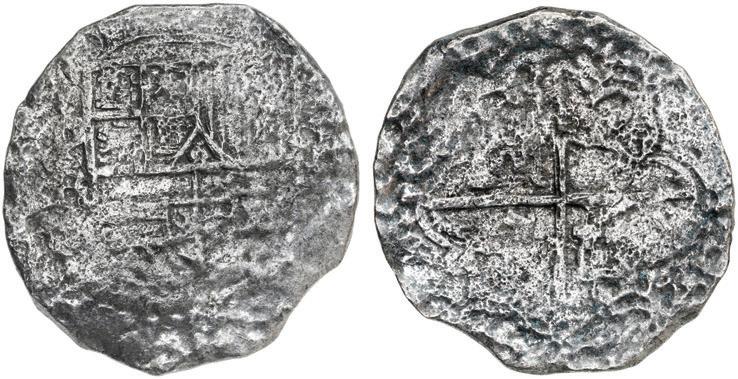

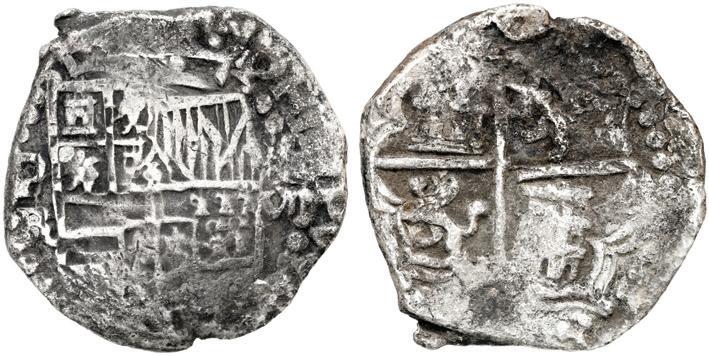



103. Potosí, Bolivia, cob 8 reales, Philip II, assayer B (5th period), border of x’s on reverse only, Grade 1. S-P14; KM-5.5; Cal-672. 26.28 grams. Choice full shield side with bold P-B and de nomination o-VIII, full cross with bold border of x’s, centers a bit weak but only minimally corroded, no toning. With original Fisher tag and certificate 85A-100433, pedigreed to the J.P. Silberman Estate. Estimate: $1,250-$2,000.
106. Potosí, Bolivia, cob 8 reales, Philip III, assayer R (curved leg), Grade 3. S-P15; KM-10; Cal-912. 18.52 grams. Moderately corroded but with clear P-R, full shield and cross, lightly toned. With original Fisher tag and certificate 86A-190353, pedigreed to the J.P. Silberman Estate. Estimate: $500-$750.
107. Potosí, Bolivia, cob 8 reales, Philip III, assayer Q, Grade
1. S-P17; KM-10; Cal-916. 26.45 grams. Choice and uncorroded, with bold full P-Q and denomination o-VIII, full shield and cross, hint of toning in crevices. With original Fisher tag and certificate 85A-19152, pedigreed to the J.P. Silberman Estate. Estimate: $1,250-$2,000.
110. Potosí, Bolivia, cob 8 reales, Philip III, assayer Q, Grade 1. S-P17; KM-10; Cal-916. 25.66 grams. Superb full shield (uncor roded) with bold P-Q to left, also good full cross with only very light surface corrosion, silvery in color all over. With original Fisher tag and certificate 86A-190989, pedigreed to the J.P. Silberman Estate. Estimate: $1,000-$1,500.
108. Potosí, Bolivia, cob 8 reales, Philip III, assayer Q, Grade 1 (20 points), with hand-signed certificate from 1976. S-P17; KM-10; Cal-916. 25.44 grams Very solid specimen with practically no cor rosion and deep rich toning all over, bold full assayer (variety with tail emanating from left side), nice full shield and cross, overall choice for an early find with desirable pre-”Mother Lode” certificate. With original Fisher photo-certificate 2896 from 1976 (Cape Coral Bank), hand-signed by Eugene Lyon, Duncan Mathewson, Austin Fowles, Mel and Dolores (Deo) Fisher (tag missing). Estimate: $1,000-$1,500.
111. Potosí, Bolivia, cob 8 reales, Philip III, assayer Q, Grade 1. S-P17; KM-10; Cal-916. 23.68 grams. Choice full shield and cross, also full denomination o-VIII above king’s ordinal III, light surface corrosion only, toned in crevices. With original Fisher tag and certificate 86A-191810, pedigreed to the J.P. Silberman Estate. Estimate: $1,000-$1,500.


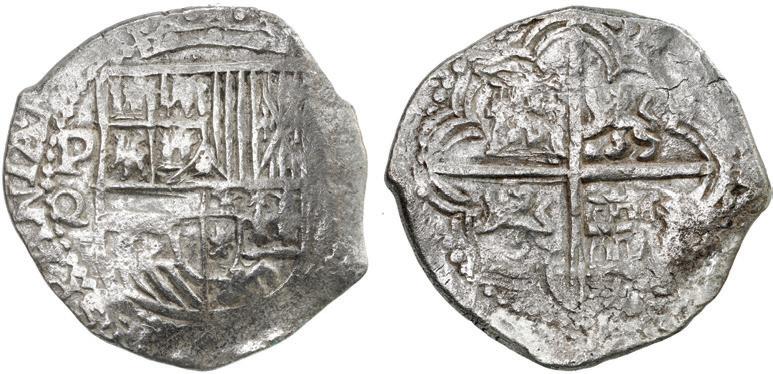

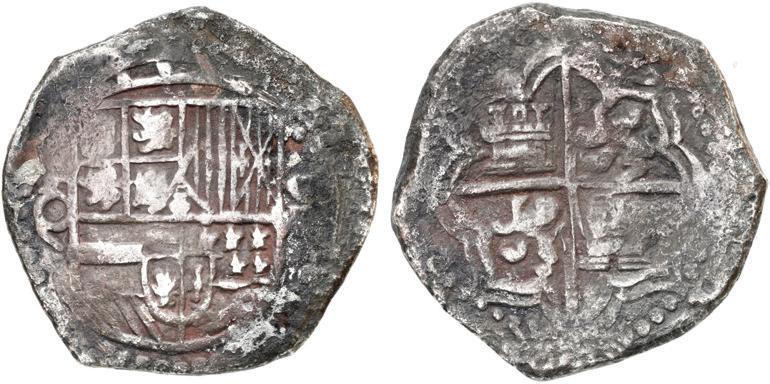

109. Potosí, Bolivia, cob 8 reales, Philip III, assayer Q, Grade
1. S-P17; KM-10; Cal-916. 25.64 grams. Broad flan with good full shield and cross and nearly full crown, full P-Q and denomination o-VIII, slightly silvery but practically no corrosion except for a few small pits. With original Fisher tag and certificate 85A-197929, pedigreed to the J.P. Silberman Estate. Estimate: $1,000-$1,500.
112. Potosí, Bolivia, cob 8 reales, Philip III, assayer Q, Grade 1. S-P17; KM-10; Cal-916. 23.29 grams. Solid flan with bold full P-Q and denomination o-VIII flanking nice full shield (actually somewhat lustrous on this side), bold full cross with traces of toning in crevices plus dark spot of corrosion near center. With original Fisher tag and certificate 86A-191121, pedigreed to the J.P. Silberman Estate. Estimate: $1,000-$1,500.
113. Potosí, Bolivia, cob 8 reales, Philip III, assayer Q, Grade 1, with hand-signed certificate from 1982. S-P17; KM-10; Cal-916. 19.41 grams. Bold full cross, full but corroded shield with clear P-Q to left (in agreement with the tag, but certificate says assayer R), lightly toned all over with a few darker areas, desirable pre-”Mother Lode” certificate. With original Fisher tag and photo-certificate 80-208 from 1982 (425 Caroline Street), hand-signed by Bleth McHaley, pedigreed to the J.P. Silberman Estate. Estimate: $800-$1,200.

116. Potosí, Bolivia, cob 8 reales, Philip III, assayer Q, Grade 2. S-P17; KM-10; Cal-916. 22.15 grams. Bold full P-Q, full but partially flat shield and cross, minimal surface corrosion, nice toning, tiny edge-splits. With original Fisher tag and certificate 85A-104486. Estimate: $800-$1,200.
114. Potosí, Bolivia, cob 8 reales, Philip III, assayer Q, Grade 2 (16 points), with hand-signed certificate from 1975. S-P17; KM-10; Cal-916. 24.41 grams. Broad round flan with full P-Q, full shield and cross, light to moderate corrosion but deeply toned all over, desir able pre-”Mother Lode” certificate. With original Fisher cardboard holder and photo-certificate 1111 from 1975 (Cape Coral Bank), hand-signed by Eugene Lyon, Duncan Mathewson, Austin Fowles, Melvin (Mel) and Dolores (Deo) Fisher, pedigreed to the J.P. Silberman Estate. Estimate: $800-$1,200.
117. Potosí, Bolivia, cob 8 reales, Philip III, assayer Q, Grade 2. S-P17; KM-10; Cal-916. 23.70 grams. Broad flan with bold full P-Q, good full shield and cross despite light surface corrosion, silvery overall but with area of rusty dark copper color on obverse. With original Fisher tag and certificate 86A-194270, pedigreed to the J.P. Silberman Estate. Estimate: $800-$1,200.


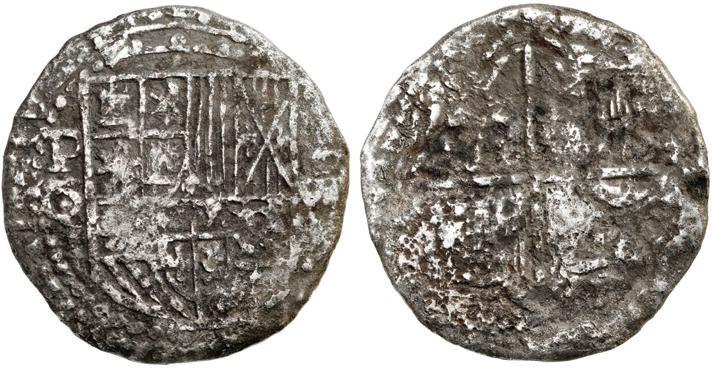
115. Potosí, Bolivia, cob 8 reales, Philip III, assayer Q, Grade 2 (22 points), with hand-signed certificate from 1975. S-P17; KM-10; Cal-916. 20.69 grams. Nicely round but heavily corroded, the P-Q bold nevertheless and with good full shield, darkly toned and encrusted all over, desirable pre-”Mother Lode” certificate. With original Fisher cardboard holder and photo-certificate 1897 from 1975 (Cape Coral Bank), hand-signed by Eugene Lyon, Claudia Singer, Austin Fowles, Mel and Dolores (Deo) Fisher, pedigreed to the J.P. Silberman Estate. Estimate: $800-$1,200.
118. Potosí, Bolivia, cob 8 reales, Philip III, assayer Q,


Grade 2. S-P17; KM-10; Cal-916. 24.75 grams. Bold full cross, full but weaker shield with bold assayer Q to left and denomination o-VIII to right, very light surface corrosion, typically silvery. With original Fisher tag and certificate 85A-107047, pedigreed to the J.P. Silberman Estate. Estimate: $800-$1,200.
Watch and bid LIVE on the Internet at
119. Potosí, Bolivia, cob 8 reales, Philip III, assayer Q, Grade 2. S-P17; KM-10; Cal-916. 25.27 grams. Large, odd-shaped flan with thinning and corrosion on parts of edge (also hairline edge-split), full but partially flat shield and cross, mostly toned. With original Fisher tag and certificate 85A-214149, pedigreed to the J.P. Silberman Estate. Estimate: $800-$1,200.
122. Potosí, Bolivia, cob 8 reales, Philip III, assayer M, Grade 1. S-P18; KM-10; Cal-919. 24.25 grams. Good full shield with clear left half of assayer M (not mentioned on tag or certificate) and most of crown, stress fractures from striking, good full cross with toning in crevices (otherwise silvery), light surface corrosion only. With original Fisher tag and certificate 85A-215127, pedigreed to the J.P. Silberman Estate. Estimate: $1,000-$1,500.
120. Potosí, Bolivia, cob 8 reales, Philip III, assayer Q, Grade 3. S-P17; KM-10; Cal-916. 20.23 grams. Very silvery and moder ately corroded, with most of shield and cross bold, weak but certain assayer, two dark spots near center of shield. With original Fisher tag and certificate 86A-133653, pedigreed to the J.P. Silberman Estate. Estimate: $500-$750.

123. Potosí, Bolivia, cob 8 reales, Philip III, assayer M, Grade 2. S-P18; KM-10; Cal-919. 27.00 grams. Uncorroded and full weight, with full shield and cross and half of crown, silvery, edge-splits. With original Fisher tag and certificate 86A-190960, pedigreed to the J.P. Silberman Estate. Estimate: $800-$1,200.


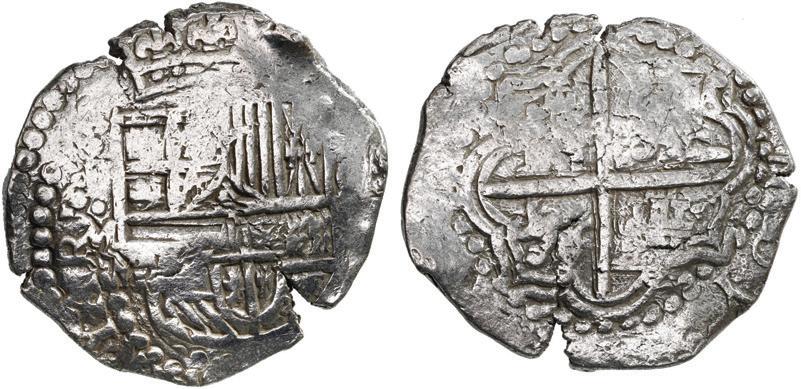


121. Potosí, Bolivia, cob 8 reales, Philip III, assayer M/Q, rare, Grade 2. S-P18; KM-10; Cal-918. 19.99 grams. Nice full shield with fairly clear P-•M to left, a rounded right side of under-letter Q protrud ing (not mentioned on tag or certificate), full but corroded cross, toned all over. With original Fisher tag and certificate 86A-189450, pedigreed to the J.P. Silberman Estate. Estimate: $700-$1,000.
124. Potosí, Bolivia, cob 8 reales, 1618, assayer not visible, quadrants of cross transposed, Grade 1. KM-10. 24.83 grams. Full 618 of date outside full cross-and-tressure, nice full shield, minimal corrosion, lightly toned, small edge-split. With original Fisher tag and certificate 85A-167902, pedigreed to the J.P. Silberman Estate. Estimate: $1,500-$2,250.

125. Potosí, Bolivia, cob 8 reales, 1620 T, retrograde mintmark “q”, Grade 1 (75 points), with hand-signed certificate from 1975. S-P21; KM-10; Cal-929. 24.39 grams. Full and bold date 16ZO, full mintmark-assayer q+T (retrograde P) and king’s name and ordinal qHYLYqVS III, bold full shield and full cross (both lightly corroded), deeply toned in crevices for good contrast, a premium coin with desirable pre-”Mother Lode” certificate to boot! With original Fisher cardboard holder and photo-certificate 1188 from 1975 (Cape Coral Bank), hand-signed by Eugene Lyon, Duncan Mathewson, Austin Fowles, Melvin (Mel) and Dolores (Deo) Fisher, pedigreed to the J.P. Silberman Estate. Estimate: $2,000-$3,000.
128. Potosí, Bolivia, cob 8 reales, Philip III, assayer T, quad rants of cross transposed, Grade 1. S-P21; KM-10. 25.86 grams. Bold full shield with bold *T to left and nearly full crown above, 100% full cross-and-tressure with clear partial date _62_ in legend (not mentioned on certificate), minimal surface corrosion, spots of light toning. With original Fisher tag and certificate 85A-164460, pedigreed to the J.P. Silberman Estate. Estimate: $1,250-$2,000.

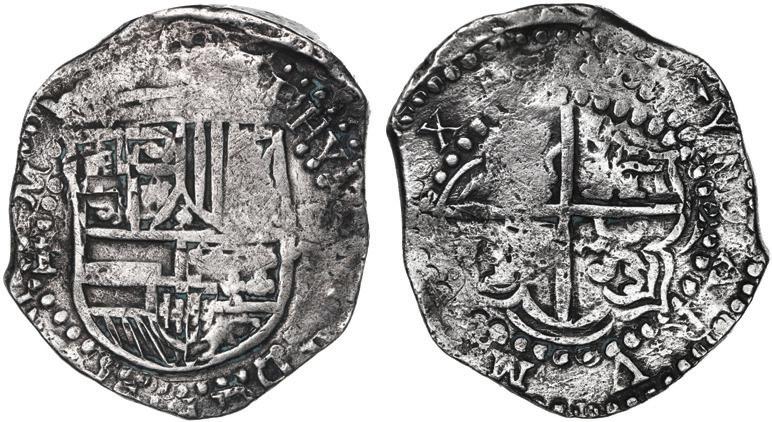




126. Potosí, Bolivia, cob 8 reales, 1620 (T), Grade 1. S-P21; KM-10; Cal-929. 24.66 grams. Unevenly thick flan (as made) with cor rosion and thinning just on parts of edge, nice full shield and cross, clear date with the 20 in small letters (zo), lightly toned. With original Fisher tag and certificate 85A-210055, pedigreed to the J.P. Silberman Estate. Estimate: $1,500-$2,250.
129. Potosí, Bolivia, cob 8 reales, Philip III, assayer T, quadrants of cross transposed, Grade 1, ex-Heber. S-P21; KM-10. 27.24 grams. Solid and uncorroded (full weight) but unevenly thick, with much legend including PHYL- of king’s name, bold assayer, good full shield and cross, nicely toned all over. With Fisher/Miguel tag and photo-certificate H1391 (Heber Collection). Estimate: $1,250-$2,000.
127. Potosí, Bolivia, cob 8 reales, 1620 T, retrograde mintmark “q”, quadrants of cross transposed, Grade 2. S-P21; KM-10; Cal-930. 25.16 grams. Unevenly thick flan with good full cross and shield, the former with bottom of date visible (mentioned on certificate as just 16##) and the latter with bold q+T (retrograde P) to left, only light corrosion near edge on both sides, silvery but with dark spot at top left on obverse. With original Fisher tag and certificate 86A-191914, pedigreed to the J.P. Silberman Estate. Estimate: $900-$1,350.
130. Potosí, Bolivia, cob 8 reales, Philip III, assayer T, quadrants of cross transposed, Grade 1 (10 points), with hand-signed certificate from 1977. S-P21; KM-10. 23.38 grams. Very darkly toned over corroded surfaces but with full shield and cross nonetheless, clear date 16Z (the Z tilted and the 6 doubled and missing the top, prompting Treasure Salvors to put a date of “1607” on the certificate) which may not have had a final digit in error, edgesplit, assessed as “Grade I” on both certificate and holder despite a relatively low point value on the certificate (desirably pre-”Mother Lode”). With original Fisher cardboard holder and photo-certificate 545 from 1977, hand-signed by Eugene Lyon, Duncan Mathewson, Claudia Singer, Mel and Dolores (Deo) Fisher, pedigreed to the J.P. Silberman Estate. Estimate: $1,000-$1,500.
131. Potosí, Bolivia, cob 8 reales, Philip III, assayer T, error denomination IIII, Grade 1. S-P21; KM-10. 25.37 grams. Superb full shield and cross-lions-castles with nicely toned fields, also full crown, tiny mintmark P and error denomination o-IIII inside most of king’s name and ordinal PHYLYPVS III, only small parts of edge corroded. With Fisher photo-certificate 96A-20276 (tag missing). Estimate: $1,000-$1,500.

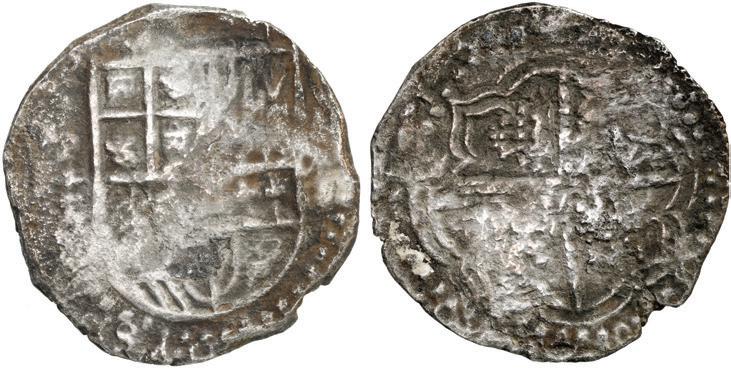
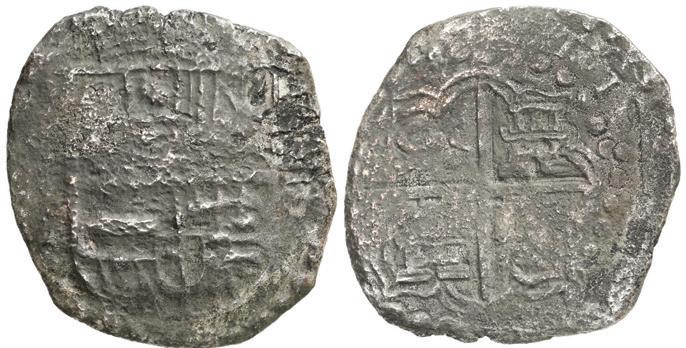



134. Potosí, Bolivia, cob 8 reales, Philip III, assayer T, quadrants of cross transposed, Grade 2 (19 points), with hand-signed certificate from 1976. S-P21; KM-10. 21.11 grams. Very dark and corroded but with full shield and cross nevertheless, desirable pre-”Mother Lode” certificate. With original Fisher cardboard holder and photo-certificate 3595 from 1976 (Cape Coral Bank), hand-signed by Eugene Lyon, Claudia Singer, Austin Fowles, Mel and Dolores (Deo) Fisher, pedigreed to the J.P. Silberman Estate. Estimate: $800-$1,200.
132. Potosí, Bolivia, cob 8 reales, Philip III, assayer T, Grade
1. S-P21; KM-10. 24.83 grams. Nicely round flan with full shield and cross, some peripheral corrosion, lightly toned in crevices. With original Fisher tag and certificate 85A-117883, pedigreed to the J.P. Silberman Estate. Estimate: $1,000-$1,500.
135. Potosí, Bolivia, cob 8 reales, Philip III, assayer T, quad rants of cross transposed, Grade 2 (19 points), with handsigned certificate from 1976. S-P21; KM-10. 22.66 grams. Bold full shield and full cross-and-tressure despite moderate corrosion all over, small P+T, dark brown encrustation on fields, desirable pre-”Mother Lode” certificate. With original Fisher cardboard holder and photocertificate 4394 from 1976 (Cape Coral Bank), hand-signed by Eugene Lyon, Duncan Mathewson, Austin Fowles and Mel Fisher, pedigreed to the J.P. Silberman Estate. Estimate: $800-$1,200.
1. S-P21; KM-10. 25.87 grams. Solid flan (uncorroded) with nice full cross and shield and nearly full crown, full P+T and denomination o-VIII, lightly toned on fields. With original Fisher tag and certificate 85A-158355, pedigreed to the J.P. Silberman Estate. Estimate: $1,000$1,500.
136. Potosí, Bolivia, cob 8 reales, Philip III, assayer T, quadrants of cross transposed, Grade 2 (16 points), with hand-signed certificate from 1976. S-P21; KM-10. 22.42 grams. Good full cross and shield despite moderate surface corrosion, darkly toned all over, desirable pre-”Mother Lode” certificate. With original Fisher cardboard holder and photo-certificate 2797 from 1976 (Cape Coral Bank), hand-signed by Eugene Lyon, Claudia Singer, Austin Fowles, Mel and Dolores (Deo) Fisher, pedigreed to the J.P. Silberman Estate. Estimate: $800-$1,200.
137. Potosí, Bolivia, cob 8 reales, Philip III, assayer T, quad rants of cross transposed, Grade 2. S-P21; KM-10. 24.22 grams. Brightly silvery from cleaning (typical for 1994), with mostly bold full shield and cross despite light to moderate corrosion, bold P+T. With original Fisher tag and certificate 94A-6430, pedigreed to the J.P. Silberman Estate. Estimate: $800-$1,200.




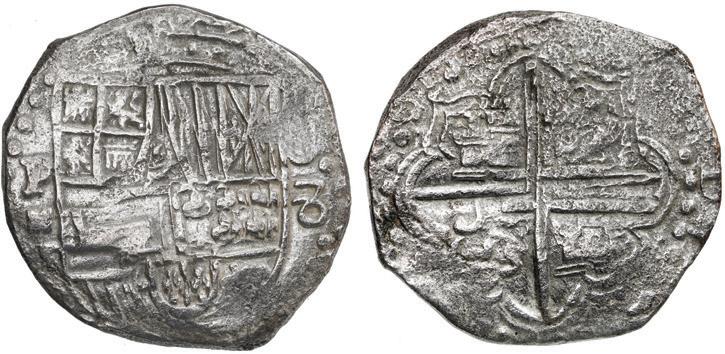

140. Potosí, Bolivia, cob 8 reales, Philip III, assayer T, up per half of shield transposed, Grade 2. S-P21; KM-10. 25.63 grams. Minimally corroded but flat in centers, bold full P+T, bottom of Z for penultimate digit of date in legend, toned all over. With original Fisher tag and certificate 85A-230763, pedigreed to the J.P. Silberman Estate. Estimate: $700-$1,000.
138. Potosí, Bolivia, cob 8 reales, Philip III, assayer T, Grade
2. S-P21; KM-10. 24.86 grams. Choice full shield with bold P-x-T to left and denomination o-8 (flat top) to right, the cross also full but with light surface corrosion and very minor doubling, silvery all over. With original Fisher tag and certificate 85A-104021, pedigreed to the J.P. Silberman Estate. Estimate: $700-$1,000.
141. Potosí, Bolivia, cob 8 reales, Philip III, assayer T, quadrants of cross transposed, Grade 3 (13 points), with hand-signed certificate from 1976. S-P21; KM-10. 24.72 grams. Thick but crudely toned and somewhat corroded, with full shield and (doubled) cross, clear P+T, desirable pre-”Mother Lode” certificate. With original Fisher tag and photo-certificate 208 (photo missing) from 1976 (Cape Coral Bank), hand-signed by Eugene Lyon, Claudia Singer, Austin Fowles, Mel and Dolores (Deo) Fisher, pedigreed to the J.P. Silber man Estate. Estimate: $600-$900.
2. S-P21; KM-10. 25.51 grams. Silvery from cleaning, the cross and shield both full and bold despite light corrosion, solid overall. With original Fisher tag and certificate 85A-105933, pedigreed to the J.P. Silberman Estate. Estimate: $700-$1,000.
142. Potosí, Bolivia, cob 8 reales, Philip III, assayer T, up per half of shield transposed, Grade 3. S-P21; KM-10. 17.35 grams. Darkly toned, full shield and cross despite moderate corrosion all over, bold assayer T. With original Fisher tag and certificate 86A-189807, pedigreed to the J.P. Silberman Estate. Estimate: $500-$750.
143. Potosí, Bolivia, cob 8 reales, Philip III, assayer T, Grade 3. S-P21; KM-10. 19.48 grams. Full but corroded cross, nearly full shield with bold P+T to left, lightly toned. With original Fisher tag and certificate 85A-145704, pedigreed to the J.P. Silberman Estate. Estimate: $500-$750.

144. Potosí, Bolivia, cob 8 reales, Philip III, assayer not visible, Grade 1. KM-10. 25.03 grams. Thick round flan with some surface corrosion, the cross and shield full otherwise, lightly toned. With original Fisher tag and certificate 85A-116234, pedigreed to the J.P. Silberman Estate. Estimate: $1,000-$1,500.
147. Potosí, Bolivia, cob 8 reales, Philip III, assayer not visible, Grade 1. KM-10. 26.61 grams. Oddly rectangular flan with full shield and cross (both slightly doubled), silvery in color but practically no corrosion. With original Fisher tag and certificate 86A-190745, pedigreed to the J.P. Silberman Estate. Estimate: $1,000-$1,500.
145. Potosí, Bolivia, cob 8 reales, Philip III, assayer not visible, Grade 1. KM-10. 26.53 grams. Full shield with bold full de nomination O-VIII inside king’s name and ordinal PHYLYPVS III, also full cross-lions-castles, minimal surface corrosion and nice toning. With original Fisher tag and certificate 85A-162447, pedigreed to the J.P. Silberman Estate. Estimate: $1,000-$1,500.
148. Potosí, Bolivia, cob 8 reales, Philip III, assayer not vis ible, Grade 2 (16 points), with hand-signed certificate from 1976. KM-10. 17.21 grams. Low-contrast example with dark toning and encrustation over corroded surfaces, the cross somewhat bold, desirable pre-”Mother Lode” certificate. With original Fisher cardboard holder and photo-certificate 3196 from 1976 (Cape Coral Bank), hand-signed by Eugene Lyon, Claudia Singer, Austin Fowles, Mel and Dolores (Deo) Fisher, pedigreed to the J.P. Silberman Estate. Estimate: $700-$1,000.
146. Potosí, Bolivia, cob 8 reales, Philip III, assayer not visible, Grade 1. KM-10. 27.25 grams. Good full shield with unusually full HYSPANYARVM in legend, also full cross, no corrosion, coppery toning in crevices. With original Fisher tag and certificate 86A-134359, pedigreed to the J.P. Silberman Estate. Estimate: $1,000-$1,500.
149. Potosí, Bolivia, cob 8 reales, Philip III, assayer not visible, Grade 2 (16 points), with hand-signed certificate from 1976. KM-10. 19.73 grams. Full cross and most of shield despite moderate corrosion and dark toning all over, desirable pre-”Mother Lode” certificate that says assayer Q, which may be correct, but the assayer is really not visible. With original Fisher cardboard holder and photo-certificate 3595 from 1976 (Cape Coral Bank), hand-signed by Eugene Lyon, Claudia Singer, Austin Fowles, Mel and Dolores (Deo) Fisher, pedigreed to the J.P. Silberman Estate. Estimate: $700-$1,000.
150. Potosí, Bolivia, cob 8 reales, Philip III, assayer not visible, Grade 2. KM-10. 18.57 grams. Silvery and thin from corrosion but with most of shield and bold cross that is double-struck in such a way that it appears to have three lions. With original Fisher tag and certificate 85A-158762, pedigreed to the J.P. Silberman Estate. Estimate: $700-$1,000.



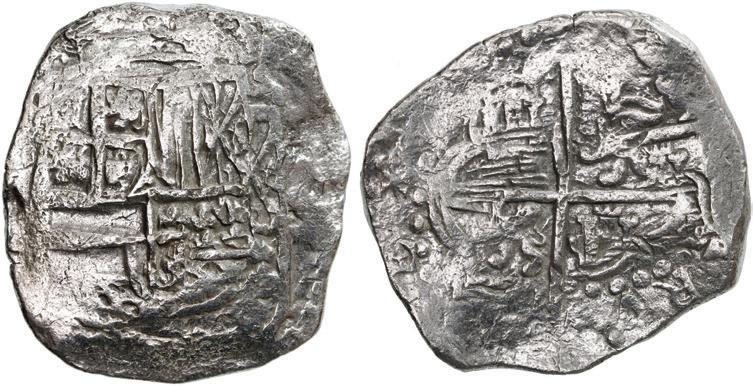
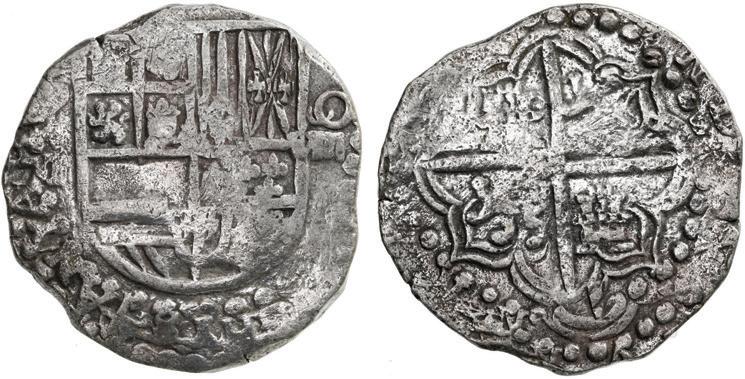


151. Potosí, Bolivia, cob 8 reales, Philip III, assayer not vis ible, Grade 2. KM-10. 24.58 grams. Oval flan with corrosion on edge but interiors nice, including full shield and cross, lightly toned over silvery surfaces. With original Fisher tag and certificate 85A-173914, pedigreed to the J.P. Silberman Estate. Estimate: $700-$1,000.
155. Potosí, Bolivia, cob 8 reales, Philip III, assayer not visible, Grade 3. KM-10. 22.13 grams. Round flan with full but mod erately corroded shield and cross, lightly toned. With original Fisher tag and certificate 86A-135269, pedigreed to the J.P. Silberman Estate. Estimate: $500-$750.
152. Potosí, Bolivia, cob 8 reales, Philip III, assayer not visible, Grade 2. KM-10. 22.66 grams. Round flan with much surface corrosion but still-sharp full shield and cross, hint of ANOD161 in legend (which would make it 1617 M). With original Fisher tag and certificate 85A-183799, pedigreed to the J.P. Silberman Estate. Estimate: $700-$1,000.
156. Potosí, Bolivia, cob 8 reales, Philip III, assayer not visible, Grade 3. KM-10. 21.25 grams. Broad flan with thinning from corrosion, good full shield and cross. With original Fisher tag and cer tificate 86A-139330, pedigreed to the J.P. Silberman Estate. Estimate: $500-$750.
157. Potosí, Bolivia, cob 8 reales, Philip III, assayer not vis ible, Grade 3. KM-10. 18.61 grams. Silvery and moderately to heavily corroded but with full shield and cross nonetheless. With original Fisher tag and certificate 86A-189259, pedigreed to the J.P. Silberman Estate. SEE INTERNET FOR PHOTO. Estimate: $500-$750.






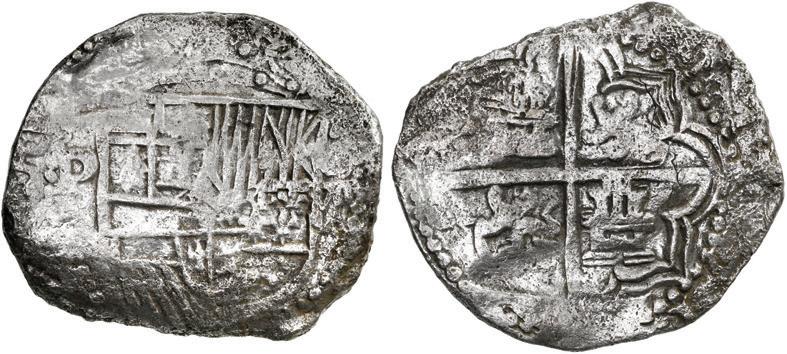
153. Potosí, Bolivia, cob 8 reales, Philip III, assayer not visible, quadrants of cross transposed, Grade 2. KM-10. 24.97 grams. Choice full shield, corroded cross, nice round flan, faintly toned. With original Fisher tag and certificate 85A-189110, pedigreed to the J.P. Silberman Estate. Estimate: $700-$1,000.
158. Potosí, Bolivia, cob 8 reales, Philip III, assayer not visible, Grade 3. KM-10. 18.82 grams. Broad flan that is somewhat thin from corrosion, with bold full cross, full but weaker shield. With original Fisher tag and certificate 86A-192292, pedigreed to the J.P. Silberman Estate. Estimate: $500-$750.
154. Potosí, Bolivia, cob 8 reales, Philip III, assayer not visible, quadrants of cross transposed, Grade 2. KM-10. 23.98 grams. Excellent full shield, the cross also full but slightly corroded (also some peripheral corrosion and edge-split), nicely toned. With original Fisher tag and certificate 85A-200039, pedigreed to the J.P. Silberman Estate. Estimate: $700-$1,000.
159. Potosí, Bolivia, cob 8 reales, Philip III, assayer not vis ible, quadrants of cross transposed, Grade 3. KM-10. 22.36 grams. Round flan with good full cross but corroded shield, toned in crevices only (note tag and certificate call it a 4 reales in error). With original Fisher tag and certificate 86A-191935, pedigreed to the J.P. Silberman Estate. Estimate: $500-$750.


160. Potosí, Bolivia, cob 8 reales, Philip III, assayer not visible, Grade 3. KM-10. 16.58 grams. Heavily corroded and silvery but with full shield and cross still in evidence. With original Fisher tag and certificate 86A-190120, pedigreed to the J.P. Silberman Estate. SEE INTERNET FOR PHOTO. Estimate: $400-$600.
163. Potosí, Bolivia, cob 4 reales, Philip III, assayer RL (curved leg), Grade 2 (20 points), with hand-signed certifi cate from 1976. S-P15; KM-9; Cal-768. 10.06 grams. Bold full P-RL, full shield and cross (the latter bolder), moderately corroded and darkly toned, desirable pre-”Mother Lode” certificate. With original Fisher cardboard holder and photo-certificate 204 from 1976 (Cape Coral Bank), hand-signed by Eugene Lyon, Claudia Singer, Austin Fowles, Mel and Dolores (Deo) Fisher, pedigreed to the J.P. Silberman Estate. Estimate: $800-$1,200.
164. Potosí, Bolivia, cob 4 reales, Philip III, assayer Q,




Grade 1. S-P17; KM-9; Cal-770. 12.78 grams. Broad, odd-shaped flan with good full shield (the cross also full but weaker), clear P-Q, very light surface corrosion only, a bit silvery. With original Fisher tag and certificate 85A-159309, pedigreed to the J.P. Silberman Estate. Estimate: $1,000-$1,500.
161. Potosí, Bolivia, cob 8 reales, Philip III, assayer not visible, no Grade on certificate. KM-10. 25.36 grams. Full but crude cross and shield, full denomination o-VIII inside bold king’s name (PHY)LYPVS, minimal corrosion except for a couple of long, thin, green-filled pits and some areas of dark oxidation, edge-crack. With Fisher tag and photo-certificate 85A-119074. Estimate: $750-$1,100.
165. Potosí, Bolivia, cob 4 reales, Philip III, assayer M/Q,
Grade 2. S-P18; KM-9; Cal-unl. 10.63 grams. Oblong flan with full cross and nearly full shield, the latter with full P-M/Q to left, silvery but toned in crevices. (Note: Tag and certificate do not mention M/Q.)
With original Fisher tag and certificate 85A-156111, pedigreed to the J.P. Silberman Estate. Estimate: $700-$1,000.
162. Potosí, Bolivia, cob 4 reales, Philip II, assayer not visible (style of 4th-period B), rotated lion, Grade 2. S-P12; KM-4.2; Cal-525. 11.06 grams. Round flan with superb full cross contain ing distinctive horse-like lions, the bottom-left of which is rotated 90 degrees counterclockwise from normal (first we have seen for this period in this denomination), the shield full but corroded, somewhat silvery. With original Fisher tag and certificate 86A-135589, pedigreed to the J.P. Silberman Estate. Estimate: $800-$1,200.
166. Potosí, Bolivia, cob 4 reales, Philip III, assayer M, Grade 2. S-P18; KM-9; Cal-771. 12.84 grams. Silvery but with only small areas of light corrosion, clear P•M and REX (hence pre-dated type), also full denomination O-IIII, bold full cross, edge-split. With original Fisher tag and certificate 85A-188100, pedigreed to the J.P. Silberman Estate. Estimate: $800-$1,200.

167. Potosí, Bolivia, cob 4 reales, 1619 T, Grade 1. S-P21; KM-9; Cal-777. 13.29 grams. Deep cross with bold full 19 of date, full but doubled shield, minimal corrosion (on edge only), contrastingly toned in crevices. With original Fisher tag and certificate 85A-161224, pedigreed to the J.P. Silberman Estate. Estimate: $1,500-$2,250.

171. Potosí, Bolivia, cob 4 reales, Philip III, assayer not visible, Grade 2 (16 points), with hand-signed certificate from 1976. KM-9. 8.27 grams. Nice full shield and nearly full cross, toned in crevices over light to moderate corrosion, tag says “I+” for Grade, but no Grade is listed on the certificate (desirably pre-”Mother Lode”), just a point value that corresponds to Grade 2. With original Fisher cardboard holder and photo-certificate 2752 from 1976 (Cape Coral Bank), hand-signed by Eugene Lyon, Duncan Mathewson, Austin Fowles and Mel Fisher, pedigreed to the J.P. Silberman Estate. Estimate: $800-$1,200.
168. Potosí, Bolivia, cob 4 reales, Philip III, assayer T, Grade
3. S-P21; KM-9. 9.27 grams. Bold full shield despite moderate corrosion all over, somewhat silvery. With original Fisher tag and certificate 86A136054, pedigreed to the J.P. Silberman Estate. Estimate: $500-$750.
172. Potosí, Bolivia, cob 4 reales, Philip III, assayer not vis ible, Grade 2. KM-9. 12.86 grams. Bold full shield and cross despite some light surface corrosion, very lightly toned. With original Fisher tag and certificate 85A-156148, pedigreed to the J.P. Silberman Estate. Estimate: $700-$1,000.
169. Potosí, Bolivia, cob 4 reales, Philip III, assayer T, Grade
3. S-P21; KM-9. 7.57 grams. Bold full cross and shield despite moderate corrosion and some loss on edge, nicely toned. With original Fisher tag and certificate 86A-190042, pedigreed to the J.P. Silberman Estate. Estimate: $500-$750.
173. Potosí, Bolivia, cob 4 reales, Philip III, assayer not visible, Grade 2. KM-9. 13.51 grams. Good full cross-lions-castles, full but doubled shield with areas of corrosion, toned all over. With original Fisher tag and certificate 85A-161946, pedigreed to the J.P. Silberman Estate. Estimate: $700-$1,000.

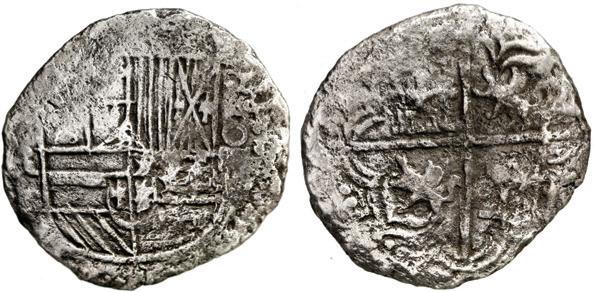

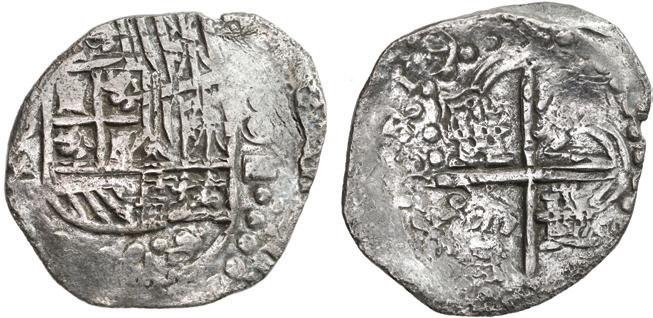
170. Potosí, Bolivia, cob 4 reales, Philip III, assayer not visible, Grade 1. KM-9. 12.47 grams. Full but partially flat shield and cross, the latter with both lions nice, minimal corrosion, silvery with toning in crevices. With original Fisher tag and certificate 85A-156091, pedigreed to the J.P. Silberman Estate. Estimate: $1,000-$1,500.

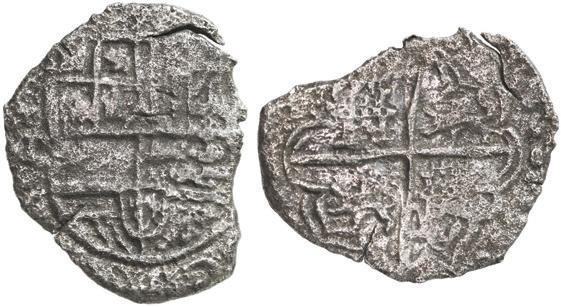
174. Potosí, Bolivia, cob 4 reales, Philip III, assayer not visible, Grade 3. KM-9. 5.12 grams. Thin and somewhat fragmentary but with choice full shield and toned in crevices. With original Fisher tag and certificate 86A-188778, pedigreed to the J.P. Silberman Estate. Estimate: $400-$600.
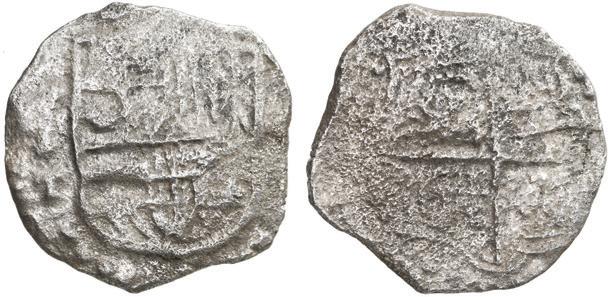
175. Potosí, Bolivia, cob 2 reales, Philip II, assayer B (5th period), Grade 1. S-P12; KM-3.2; Cal-370. 5.88 grams. Choice full shield with bold P-B to left, weaker full cross with surface corrosion, toned in crevices. With original Fisher tag and certificate 86A-191185, pedigreed to the J.P. Silberman Estate. Estimate: $1,250-$2,000.
176. Potosí, Bolivia, cob 2 reales, Philip III, assayer RL, Grade 1. S-P15; KM-8; Cal-unl. 8.22 grams. One hundred percent corrosion-free and actually overweight by about 20%, with full and bold shield and cross nicely contrasted with darkly toned fields, peripherally flat but with clear P-RL and denomination ii. With Fisher tag and photo-certificate 85A-117468. Estimate: $1,500-$2,250.
177. Potosí, Bolivia, cob 2 reales, Philip III, assayer R (straight leg), Grade 1. S-P15; KM-8; Cal-626. 6.77 grams. Silvery but corrosion-free, with bold full cross and nearly full shield and crown, bold P-R with a curiously straight and pointed leg (a common variety in this denomina tion only). With original Fisher tag and certificate 86A-132642, pedigreed to the J.P. Silberman Estate. Estimate: $1,250-$2,000.




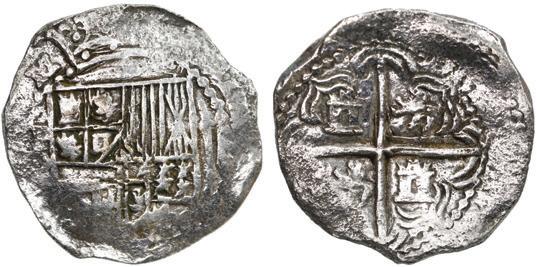

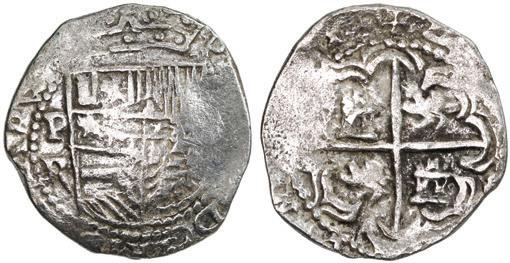
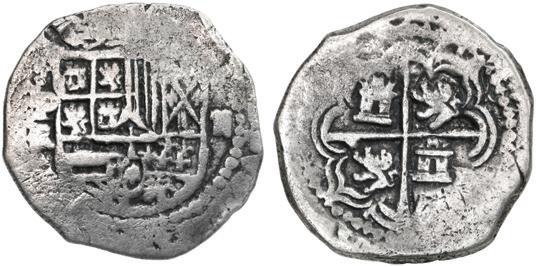

178. Potosí, Bolivia, cob 2 reales, Philip III, assayer T, Grade 2. S-P21; KM-8. 5.95 grams. Silvery but with only minimal surface corrosion, full P-T and denomination Z flanking a full shield, full but slightly off-center cross. With original Fisher tag and certificate 86A-191221, pedigreed to the J.P. Silberman Estate. Estimate: $800-$1,200.
179. Potosí, Bolivia, cob 2 reales, Philip III, assayer not visible, Grade 1. KM-8. 6.29 grams. Bold full cross (slightly off-center) and well-detailed shield, some peripheral flatness but really no corrosion, silvery with dark toning in crevices. With original Fisher tag and certificate 86A-132799, pedigreed to the J.P. Silberman Estate. Estimate: $1,250-$2,000.
180. Potosí, Bolivia, cob 2 reales, Philip III, assayer not visible, Grade 2. KM-8. 6.59 grams. Broad flan with choice full shield and cross but slightly crude peripheries, no corrosion, mostly darkly toned. With original Fisher tag and certificate 86A-109013, pedigreed to the J.P. Silberman Estate. Estimate: $800-$1,200.
181. Potosí, Bolivia, cob 2 reales, Philip III, assayer not visible, Grade 2. KM-8. 6.53 grams. Compact round flan with bold full shield and cross, minimal corrosion, silvery but with hint of toning in crevices. With original Fisher tag and certificate 86A-133199, pedigreed to the J.P. Silberman Estate. Estimate: $800-$1,200.
182. Potosí, Bolivia, cob 2 reales, Philip III, assayer not visible, Grade 3. KM-8. 3.51 grams. Thin from corrosion but with good full shield, the cross slightly off-center and doubled, mostly toned. With original Fisher tag and certificate 86A-133418, pedigreed to the J.P. Silberman Estate. Estimate: $600-$900.
183. Seville, Spain, cob 8 reales, Philip III, assayer not visible, Grade 2, with hand-signed certificate from 1982. KM-54; Cal-Type 171. 16.92 grams. Thin and out-of-round from corrosion (also silvery all over) but with well-detailed shield and enough cross-side detail to recognize Seville-style lions, also possible 2 of date (probably the penultimate digit), desirable pre-”Mother Lode” certificate. With original Fisher tag and photo-certificate SR-1294 from 1982, hand-signed by Leah Miguel, pedigreed to the J.P. Silberman Estate. Estimate: $700-$1,000.
184. Potosí, Bolivia, cob 8 reales, Philip III, assayer not visible, Grade 2.
KM-10. 19.68 grams. Choice full cross-lions-castles, nearly full shield despite corrosive edge-loss to left, mostly toned (note tag says “Grade III” in error). With original Fisher tag and photo-certificate 8895 from 1982, pedigreed to the J.P. Silberman Estate. Estimate: $700-$1,000.
185. Potosí, Bolivia, cob 8 reales, Philip III, assayer not visible, Grade
3. KM-10. 22.36 grams. Full cross and shield (both a little doubled) and bold de nomination o-VIII, lightly corroded and toned all over. With original Fisher tag and photo-certificate 2400 from 1982, pedigreed to the J.P. Silberman Estate. Estimate: $400-$600.
186. Mexico City, Mexico, cob 8 reales, Philip III, assayer D, ex-Eidel. S-M18; KM-44.3. 21.66 grams. Good full cross, some shield and crown and oMD, much flatness but much less corroded than most from this wreck, silvery from cleaning and with artifact number stickered onto the shield side. Pedigreed to the Charles Eidel collection, with original Seahawk certificate 91-1A-2081.0050. Estimate: $200-$300.
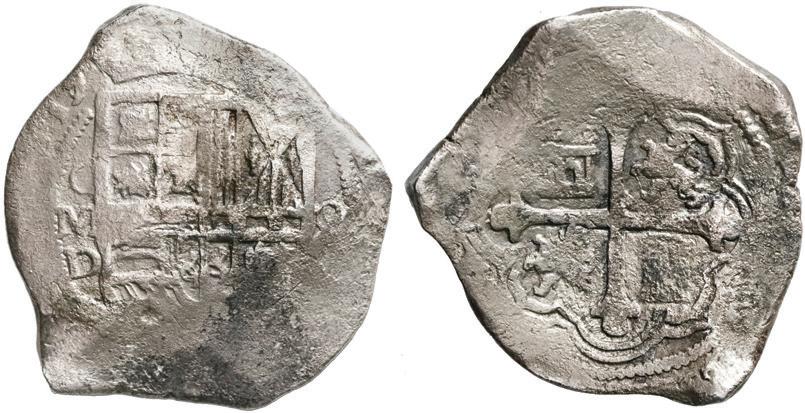
187. Mexico City, Mexico, cob 8 reales, 1619/8 D, rare. S-M18; KMunl; Cal-unl. 25.08 grams. Broad, solid, odd-shaped flan of uneven thickness with good full cross, nearly full shield with full oMD to left inside a clear bottom half of date (16)19 with bold 9/8, only very light surface corrosion, streak of toning on obverse. Pedigreed to Sedwick Auction 10 (lot 290). Estimate: $250-$375.




188. Toledo, Spain, cob 4 reales, Philip III, assayer V, NGC shipwreck effect
/ Sao Jose label, Grade 1. KM-36.3; Cal-Type 156. Good full shield and cross despite light surface corrosion, full assayer V and king’s ordinal III, a few rusty spots on obverse and black in crevices on reverse. NGC #1973973-048. Estimate: $200-$300.
189. Gelderland, United Netherlands, “lion” daalder, 1616. KM-15.1; Dav-4849. 25.87 grams. Choice specimen with full and bold legends including date, fully detailed lion, only light localized corrosion, no toning. Estimate: $200-$300.
190. Friesland, United Netherlands, “lion” half daalder, 1626, rare. Delm-883 (R2); KM-12.3. 13.14 grams. Much rarer than a full daalder, with choice full legends including date on reverse (which is actually somewhat lustrous), the interiors full but somewhat weakly struck as usual, practically no corrosion, minor edge-flaw (as made). Estimate: $200-$300.
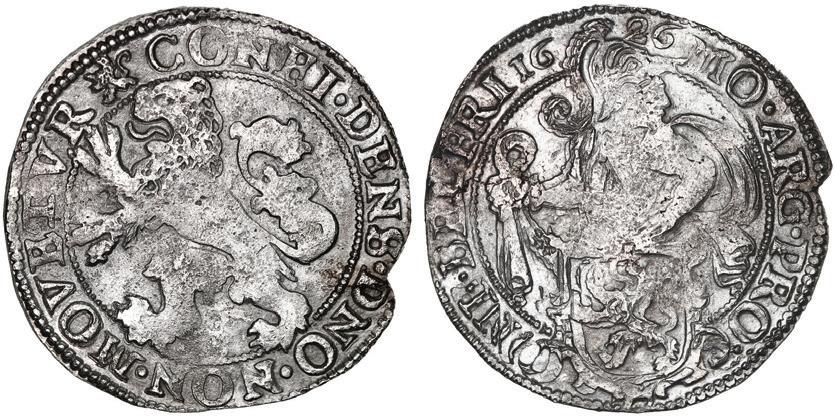

191. Mexico City, Mexico, cob 8 reales, Philip IV, assayer
D. S-M18a; KM-45. 27.10 grams. Solid and uncorroded flan with bold oMD and denomination 8 flanking a nearly full shield, the cross also nearly full with flat area at bottom left, flat peripheries on both sides, mostly deeply toned. Estimate: $200-$300.


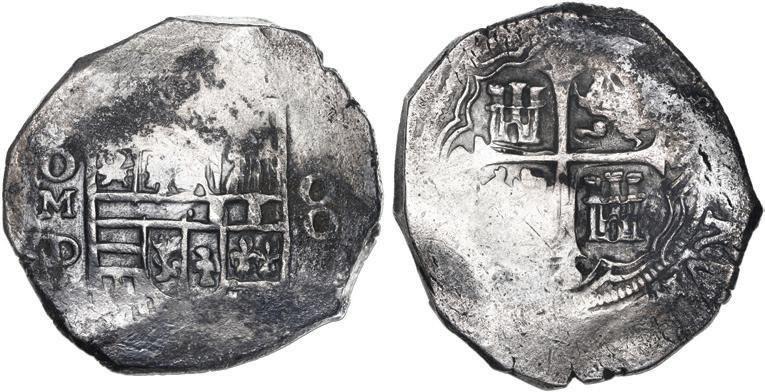
192. Mexico City, Mexico, cob 8 reales, Philip IV, assayer not visible. KM-45. 24.85 grams. Typical “barrel shape” with uneven thick ness, peripheral flatness, choice full shield, full but pitted cross, toned in crevices. With original Spink clamshell box. Estimate: $300-$450.
193. Mexico City, Mexico, cob 4 reales, Philip III, assayer D/F (ca. 1618). S-M18; KM-37.2. 12.35 grams. Very bold full oMD/F to left of nearly full shield, good full cross on a nearly corrosion-free flan with typically flat peripheries, deeply toned. With photo-certificate. Estimate: $200-$300.

194. Mexico City, Mexico, cob 4 reales, Philip IV, assayer not visible, NGC VF 30 / Lucayan Beach, ex-Spink (stated on label). KM-38. 13.40 grams. Rather rare as a straight-graded shipwreck silver coin (deservedly so, as there is no corrosion), with choice full cross and shield, bold denomination 4, richly toned all over. With original Spink clamshell box, small certificate and order form from the 1960s. NGC #5927226-012. Estimate: $500-$750.
195. Mexico City, Mexico, cob 8 reales, 164(?) P. S-M19; KM-45. 23.18 grams. Crude, odd-shaped flan with edge-split, uneven thickness and a couple blunted points (as made), also peripherally flat except for the full 64 of the date, bold cross and partial shield, deeply toned over lightly corroded surfaces. Estimate: $200-$300.
198. Mexico City, Mexico, cob 8 reales, Philip IV, assayer not visible (P). KM-45. 26.35 grams. Solid and roundish flan with varying thickness and much flatness but only very light surface corro sion, full cross and shield, deep but uneven toning all over. Estimate: $200-$300.





196. Mexico City, Mexico, cob 8 reales, 164(?) P. S-M19; KM-45. 25.75 grams. Broad flan with good full cross, clear oMP and 164 of date, minimal corrosion but mostly flat in the peripheries, well toned. Estimate: $200-$300.
199. Mexico City, Mexico, cob 8 reales, Philip IV, assayer not visible (P). KM-45. 24.06 grams. Broad flan with much variation in thickness resulting in flat areas, the full denomination 8 and most of the shield and cross bold, minor surface corrosion, patchy light toning. Estimate: $200-$300.
197. Mexico City, Mexico, cob 8 reales, Philip IV, assayer P. S-M19; KM-45. 25.78 grams. Choice full shield with full oMP and much crown, nearly full cross, minimal surface corrosion, contrastingly toned in crevices, parts of edge slightly crude (as made). Estimate: $200-$300.

200. Mexico City, Mexico, cob 8 reales, Philip IV, assayer not visible (P). KM-45. 26.25 grams. Crude flan with uneven thickness and flat areas but practically no corrosion, most of cross and shield, small spots of dark toning. Estimate: $200-$300.
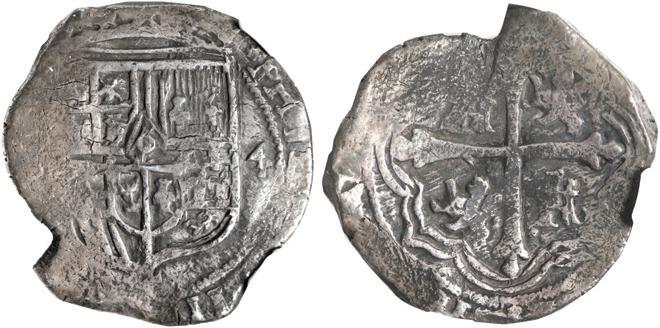
201. Mexico City, Mexico, cob 2 reales, 1632 D, very rare, ex-Christensen (“Treasures of the Conception” auction). S-M18a; KM-unl; Cal-unl. 5.86 grams. Dark and crude (some minor corrosion) but with 100% full 32 of date (possibly 2/1/0), also full oMD and shield, nearly full cross with “normal” fleurs (not exaggerated like we usually see for this period), darkly toned all over, so rare that it hammered for $265 in 1982. Pedigreed to the Christensen auction of May 1982, with original lot-envelope 91, and with tag from the salvors. Estimate: $250-up.
202. Potosí, Bolivia, cob 8 reales, (1649) O/Z, with crownedscript-L countermark (very rare, and a unique subtype) on cross, ex-Mastalir (Plate). S-P35; KM-19b; Cal-1486. 21.40 grams. Thin around the edges from corrosion (note Mastalir’s book gives incor rect weight) but with good full shield and cross, the former with full P-O/Z to left and the latter with nearly full countermark at bottom right, nicely toned, typical edge-split. Pedigreed to the Robert Mastalir Collection and plated on page 50 of Part A and page 172 of Part B of his books The Great Transition at the Potosí Mint, 1649-1652: The 1649-1652 Crowned Shield Coinage and the Countermarks of 1652 (2021), with copy of Moro certificate countersigned by Daniel Frank Sedwick. Estimate: $500-$750.
204. Potosí, Bolivia, cob 8 reales, (1649) O/Z, denomination as o above o, with crowned-•F• (two dots) countermark on shield, ex-Mastalir (Plate). S-P35; KM-19b; Cal-1486. 23.37 grams. Ob long flan with edge-split, choice toning over smooth surfaces (slightly worn from corrosion), the full shield (with nearly full countermark in center) and cross particularly nice, also full assayer O/Z to left and most of denomination oo to right. Pedigreed to the Robert Mastalir Collection and plated on page 49 of Part A and page 330 of Part B of his books The Great Transition at the Potosí Mint, 1649-1652: The 16491652 Crowned Shield Coinage and the Countermarks of 1652 (2021), with original (generic) Herman Moro certificate. Estimate: $300-$450.



203. Potosí, Bolivia, cob 8 reales, 1649 (O/Z), king’s name as PHELIPVS, with crown-alone countermark on shield, ex-Mastalir (Plate). S-P35; KM-19b; Cal-1486. 26.14 grams. Broad flan (slightly bent and uneven) with 100% full date and most of king’s name in legends, full but weaker cross and shield, the latter with very bold full countermark, denomination 8 to right, minimal corrosion, patchy toning. Pedigreed to the Robert Mastalir Collection and plated on page 48 of Part A and page 256 of Part B of his books The Great Transi tion at the Potosí Mint, 1649-1652: The 1649-1652 Crowned Shield Coinage and the Countermarks of 1652 (2021). Estimate: $350-$500.

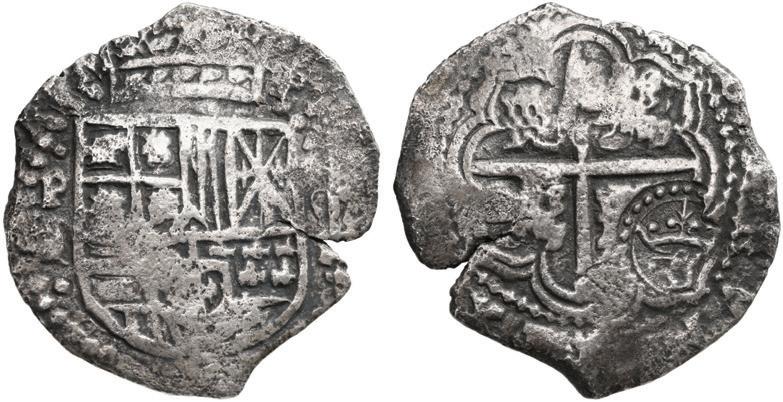
205. Potosí, Bolivia, cob 8 reales, 1649 O/sR (rare), king’s name as PHILIPVS (with I instead of E), with crown-alone countermark (rare variety) on cross, ex-Mastalir (Plate).
S-P35; KM-19b; Cal-unl. 25.33 grams. Broad flan with edge-crack, minimal surface corrosion, full but weak shield with very clear O/sR to left and denomination 8 to right, good full cross with very bold and nearly full countermark near center, bottom of 6 and 9 of date, toned in crevices. The mysterious under-assayer sR is only known over-struck by O (and only in 8R except for a single-known 1R--see lot 451 of this auction) and was apparently concurrent with O/Z for the changeover from Zambrano to Rodas, who most likely realized an “sR” for his name was too similar to the plain R for the fraudster Ramírez de Arellano (who was eventually executed). Pedigreed to the Robert Mastalir Collec tion and plated on page 47 of Part A and page 308 of Part B of his books The Great Transition at the Potosí Mint, 1649-1652: The 1649-1652 Crowned Shield Coinage and the Countermarks of 1652 (2021), with original Herman Moro certificate LC01-351. Estimate: $350-$500.
206. Potosí, Bolivia, cob 8 reales, 1649 O/sR (rare), with crowned-•F• (two dots) countermark on shield, ex-Mastalir (Plate). S-P35; KM-19b; Cal-unl. 21.37 grams. Broad flan (slightly thin from corrosive wear) with good full shield bearing a nearly full coun termark, full and clear O/sR, full but off-center cross with tail of 9 of date visible, richly toned all over. (See lot 205 for explanation of this over-assayer.) Pedigreed to the Robert Mastalir Collection and plated on page 43 of Part A and page 331 of Part B of his books The Great Transi tion at the Potosí Mint, 1649-1652: The 1649-1652 Crowned Shield Coinage and the Countermarks of 1652 (2021), with original (generic) Herman Moro certificate. Estimate: $350-$500.
208. Potosí, Bolivia, cob 8 reales, 1649 O/sR (rare), with crowned-L countermark on cross, ex-Mastalir (Plate). S-P35; KM-19b; Cal-unl. 27.64 grams. Hefty coin (overweight, uncorroded) in oblong shape with some weak strike but otherwise full shield and cross, the former with very bold full assayer O/sR and the latter with full countermark and bold date rendered as ANO9 from a rotated double-strike (Mastalir considers it a die error) corresponding with a rotated doubling of the shield on the other side, nicely toned in crevices. (See lot 205 for explanation of this over-assayer.) Pedigreed to the Robert Mastalir Collection and plated on page 44 of Part A and page 137 of Part B of his books The Great Transition at the Potosí Mint, 1649-1652: The 1649-1652 Crowned Shield Coinage and the Countermarks of 1652 (2021), with original (generic) Herman Moro certificate. Estimate: $350-$500.
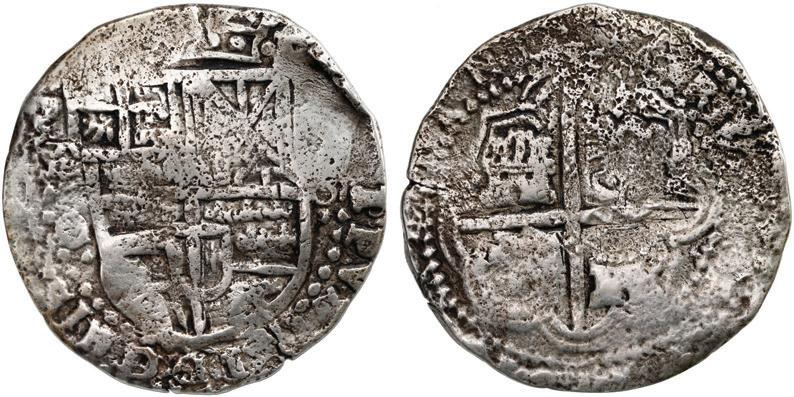



207. Potosí, Bolivia, cob 8 reales, 1649 O/sR (rare), with crowned-L countermark on cross, ex-Mastalir (Plate). S-P35; KM-19b; Cal-unl. 19.68 grams. Thin from corrosion and with two edgesplits but nevertheless well detailed, with bold assayer O/sR to left of full shield, good full cross with nearly full countermark and full 64 plus partial 9 of date, toned in crevices. (See lot 205 for explanation of this over-assayer.) Pedigreed to the Robert Mastalir Collection and plated on page 44 of Part A and page 132 of Part B of his books The Great Transi tion at the Potosí Mint, 1649-1652: The 1649-1652 Crowned Shield Coinage and the Countermarks of 1652 (2021), with photo-certificate. Estimate: $350-$500.
209. Potosí, Bolivia, cob 8 reales, (1649) O/sR (rare), early castles, rotated reverse legend, with crowned-O countermark on cross, ex-Hudson, ex-Mastalir (Plate). S-P35; KM-19b; Cal-unl. 23.30 grams. Broad round flan with some flatness and corrosion but technically full shield and cross, fairly clear O/sR assayer (misattributed to O/Z in the Hudson Collection), date not visible but with enough reverse legend to see the rotation, very weak countermark, toned in crevices. Note that the castles resemble much earlier issues, this coin being the only one of O/sR known with that feature, according to Mastalir. (See lot 205 for explanation of this over-assayer.) Pedigreed to the Louis Hudson Collection (Sedwick Auction 6, lot 294) and to the Robert Mastalir Collection, plated on page 46 of Part A and page 177 of Part B of his books The Great Transition at the Potosí Mint, 1649-1652: The 1649-1652 Crowned Shield Coinage and the Countermarks of 1652 (2021). Estimate: $300-$450.
210. Potosí, Bolivia, cob 8 reales, 1649 O, with three countermarks (very rare): crown alone on shield, crowned-O on cross, and arms on cross; ex-Mastalir (Plate). S-P35; KM-19b; Cal-1487. 19.75 grams. Broad flan but thin from corrosion (toned in crevices), still with full shield and crown and cross, also bold full assayer and king’s ordinal (the date also clear), but most important feature is the presence of THREE prominent countermarks, including a nearly full crown-alone countermark on the shield (common type), a partial crowned-O countermark on the cross and a partial arms countermark near the edge on the reverse, one of very few examples known to have visited three different cajas reales for validation in its brief time (no more than five years) in circulation. Pedigreed to the Robert Mastalir Collection and plated on pages 59, 186 and 273 of Part B of his book The Great Transition at the Potosí Mint, 1649-1652: The 1649-1652 Crowned Shield Coinage and the Countermarks of 1652 (2021), with copy of Moro certificate countersigned by Daniel Frank Sedwick. Estimate: $1,000-$1,500.


212. Potosí, Bolivia, cob 8 reales, 1649 (O), with crowned•PH• countermark on shield, ex-Mastalir (Plate). S-P35; KM-19b; Cal-1487. 23.05 grams. Solid flan with minimal surface corrosion, good full cross and shield, the former with right side of 9 of date visible and the latter with practically full countermark near center, attractively toned for good contrast. Pedigreed to the Robert Mastalir Collection and plated on page 360 of Part B of his books The Great Transition at the Potosí Mint, 1649-1652: The 1649-1652 Crowned Shield Coinage and the Countermarks of 1652 (2021), with copy of Moro certificate countersigned by Daniel Frank Sedwick. Estimate: $400-$600.
211. Potosí, Bolivia, cob 8 reales, 1649 O, with crown-alone countermark (very rare variety) on cross, ex-Mastalir (Plate). S-P35; KM-19b; Cal-1487. 20.33 grams. Very broad flan (but thin from cor rosion) with two edge-splits, much bold legend including king’s name and ordinal and ANO 1649 date, also full and bold assayer, full shield and cross with bold and well-detailed countermark that is represented by only two known examples in 8R, toned in crevices. Pedigreed to the Robert Mastalir Collection and plated on page 58 of Part A and page 380 of Part B of his books The Great Transition at the Potosí Mint, 16491652: The 1649-1652 Crowned Shield Coinage and the Countermarks of 1652 (2021). Estimate: $500-$750.
213. Potosí, Bolivia, cob 8 reales, 1649 O, early lions, with crown-alone (rare variety) countermark on cross, ex-Mastalir (Plate). S-P35; KM-19b; Cal-1487. 21.16 grams. Round flan with some thinning from corrosion, parts of edge bent and split, with full 9 of fate and most of the countermark (bold) outside of full cross, nearly full shield and crown, toned on fields. Pedigreed to the Robert Mastalir Collection and plated on page 176 of Part A and page 300 of Part B of his books The Great Transition at the Potosí Mint, 1649-1652: The 16491652 Crowned Shield Coinage and the Countermarks of 1652 (2021), with original (generic) Herman Moro certificate. Estimate: $350-$500.
214. Potosí, Bolivia, cob 8 reales, 1649 O, rotated 4 in date, with crowned-L countermark on cross, ex-Mastalir (Plate). S-P35; KM-19b; Cal-1487. 24.64 grams. Roundish flan with much legend and full shield and cross (minimal surface corrosion), lightly toned, with bold denomination 8, half of countermark, full but weak date (the rotated 4 barely visible). Pedigreed to the Robert Mastalir Collec tion and plated on page 61 of Part A and page 122 of Part B of his books The Great Transition at the Potosí Mint, 1649-1652: The 1649-1652 Crowned Shield Coinage and the Countermarks of 1652 (2021). Estimate: $350-$500.
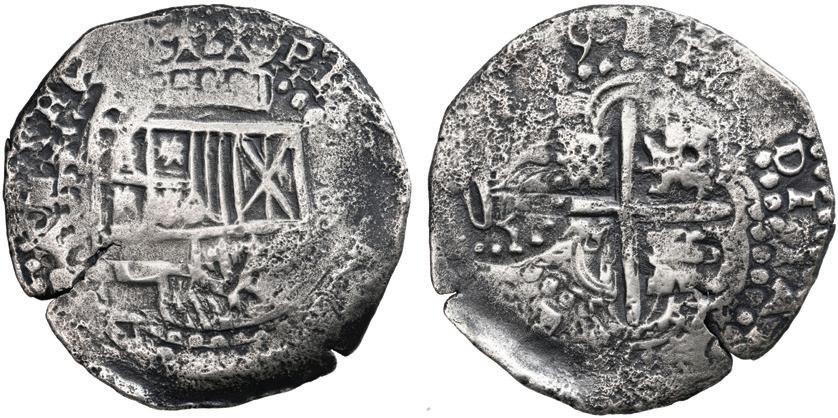


215. Potosí, Bolivia, cob 8 reales, 1649 O, with crown-alone countermark on shield, ex-Mastalir (Plate). S-P35; KM-19b; Cal1487. 17.96 grams. Very bold full countermark in center of shield, with some concavity and an edge-split as a result, full P-O and bold 9 of date, full shield and cross, thin from corrosion but nicely toned. Pedigreed to the Robert Mastalir Collection and plated on page 176 of Part A and page 275 of Part B of his books The Great Transition at the Potosí Mint, 1649-1652: The 1649-1652 Crowned Shield Coinage and the Countermarks of 1652 (2021), with certificate. Estimate: $350-$500.


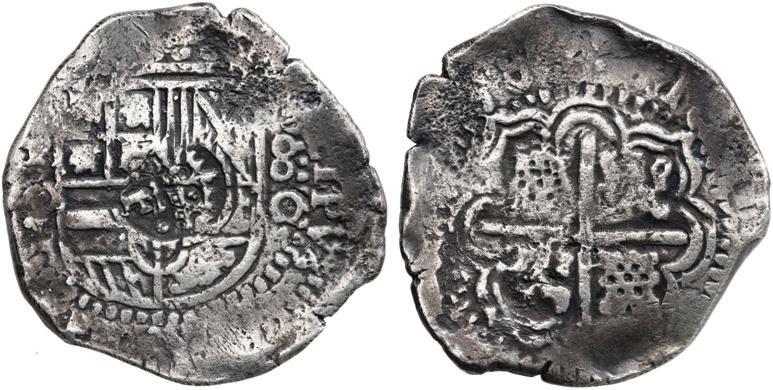

218. Potosí, Bolivia, cob 8 reales, 1650 O, date at top of cross with modern 5 and dots between digits, with crown-alone countermark on shield. S-P35; KM-unl; Cal-unl. 24.02 grams. Dark and corroded but with clear (albeit doubled) date .1.6.5.0. outside a full cross, also with choice full crown above full shield with half of countermark near center and bold assayer to right. Estimate: $200-$300.
216. Potosí, Bolivia, cob 8 reales, 1649 O, no countermark (very rare), ex-Mastalir (Plate). S-P35; KM-19b; Cal-1487. 26.61 grams. Broad flan with virtually no corrosion but worn and flat in places, still with full shield and cross and with much legend including PHELIPVS IIII and 9 of date, unevenly toned, parts of edge crude (as made), one of only two of this host type known without any countermarks. Pedigreed to the Robert Mastalir Collection and plated on page 58 of Part A and page 399 of Part B of his books The Great Transition at the Potosí Mint, 1649-1652: The 1649-1652 Crowned Shield Coinage and the Countermarks of 1652 (2021), with copy of Moro certificate countersigned by Daniel Frank Sedwick. Estimate: $350-$500.
219. Potosí, Bolivia, cob 8 reales, (1651) E, with crownedPH countermark on shield. S-P36; KM-19b; Cal-1491. 25.14 grams. Very broad flan with edge-split and sharp point, much legend including king’s ordinal IIII (but not the date), full but lightly corroded cross, good full shield with deep partial countermark in center and bold as sayer E to right, nicely toned but also with large area of copper color on obverse. Estimate: $300-$450.
217. Potosí, Bolivia, cob 8 reales, (16)50 O, with crowned•F• (two dots) countermark on shield. S-P35; KM-19b; Cal-1488. 24.10 grams. Solid flan (only a few areas of surface corrosion) with choice full shield bearing nearly full countermark, bold 8-O to right, good full cross with most of 50 of date in legend, nicely toned. Estimate: $250-$375.
220. Potosí, Bolivia, cob 4 reales, 1649 O, with crown-alone countermark on shield, ex-Mastalir (Plate). S-P35; KM-17b; Cal1105. 8.52 grams. Thin from corrosion but with about half of shield showing bold full countermark, bold P-O to left, good full cross displaying an interesting brockage of the countermark from the other side, bold full 49 of date, nicely toned, minor edge-split. Pedigreed to the Robert Mastalir Collection and plated on page 68 of Part A and page 283 of Part B of his books The Great Transition at the Potosí Mint, 1649-1652: The 1649-1652 Crowned Shield Coinage and the Countermarks of 1652 (2021), also pedigreed to the Ponterio auction of October 7, 2000, with original lot-tag 1303 and original (generic) Herman Moro certificate. Estimate: $400-$600.


221. Potosí, Bolivia, cob 8 reales, 1652 E Transitional Type IV/A, NGC XF details / sea salvaged / Capitana (Shipwreck Blue Label). S-P37; KM-A20.4; Cal-1493. 21.65 grams. Choice full pillars-and-waves with bold F-8-IIII for top line and E-8-E across bottom, weak date (from corrosion) in legend, the full shield even choicer, with nearly full crown above, A-P-8 to left and O-E-52 to right above full king’s ordinal IIII, beautifully toned. NGC #6096970-004. Estimate: $1,000-$1,500.
222. Potosí, Bolivia, cob 8 reales, 1652 E post-transitional (Type VIII/B), 1-PH-6 at top. S-P37a; KM-21; Cal-1500. 25.76 grams. Bold 1-PH-6 above fat pillars with 52 (date) visible twice on that side, weaker cross (from corrosion) with third date below, lightly toned all over. Estimate: $200-$300.
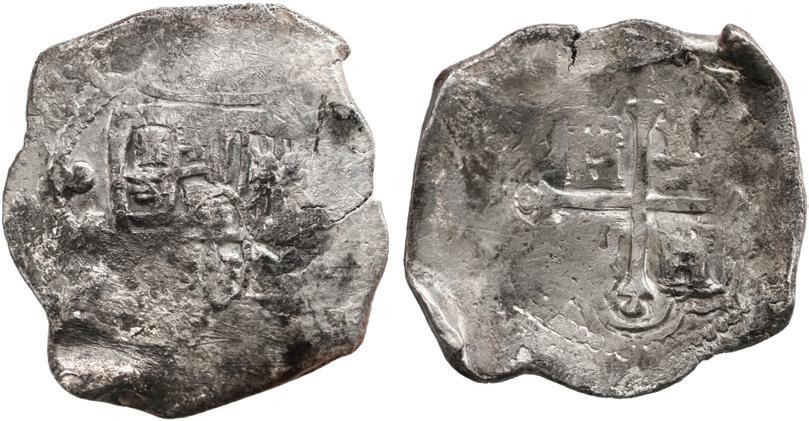
223. Potosí, Bolivia, cob 8 reales, 1653 E, •PH• at top, date in three digits below cross. S-P37a; KM-21; Cal-1503. 23.17 grams. Full pillars-and-waves with two full dates, good full cross with full third date below, all three mintmarks and assayers too, lightly corroded all over, some dark spots. Estimate: $200-$300.


224. Mexico City, Mexico, cob 8 reales, 1648(?) (P). S-M19; KM-45; Cal-1343. 25.23 grams. Solid flan with varying thickness corre sponding to peripheral flatness but not much corrosion, decent full cross, about half of shield with last two digits of date visible (last digit not 100% certain), patchy gunmetal toning. Estimate: $250-$375.
225. Mexico City, Mexico, cob 8 reales, 1652 P. S-M19; KM-45; Cal-1354. 26.52 grams. Bold date, oMP and denomination 8, full shield and cross with tiny natural bubble-hole in center, much flatness but minimal corrosion, lightly toned. With original MAREX tag 91-8R0278. Estimate: $350-$500.
226. Mexico City, Mexico, cob 8 reales, 1655 (P). S-M19; KM-45; Cal-1359. 22.76 grams. Choice centers (shield and cross) but peripher ies corroded, nevertheless with full date, spots of light toning. With original MAREX photo-certificate 91-8R-801. Estimate: $250-$375.
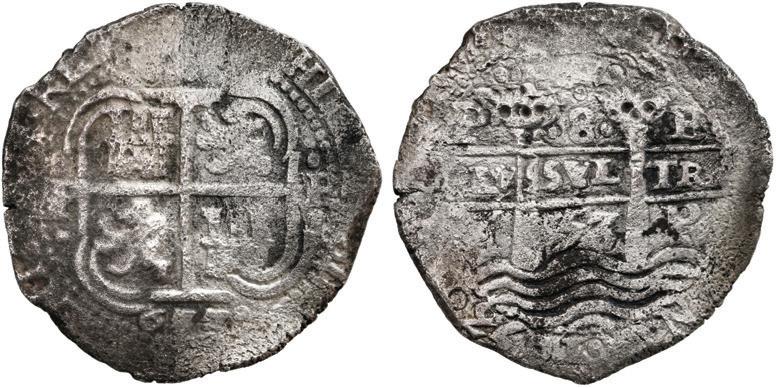


227. Mexico City, Mexico, cob 8 reales, Philip IV, assayer
P. S-M19; KM-45. 25.41 grams. Impressively bold cross, full but weaker shield, broad flan with peripheral flatness but almost no corrosion, lightly toned. Estimate: $200-$300.
228. Mexico City, Mexico, cob 8 reales, Philip IV, assayer P, cocooned in coral (as found). S-M19; KM-45. 29.96 grams total. Neat urn-shaped flan with entire cross side coated in gray-white coral, as is most of the shield side except (by chance) the assayer and a flat area at top where you can see an old (pre-encrustation) gouge in the deeply toned metal. Estimate: $350-$500.
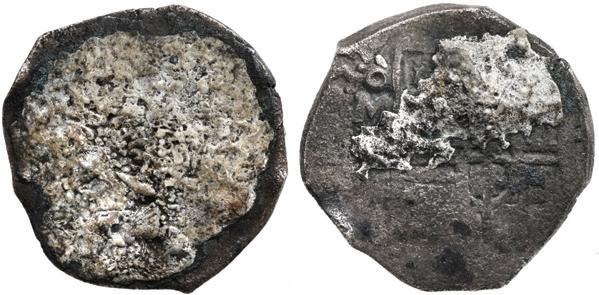
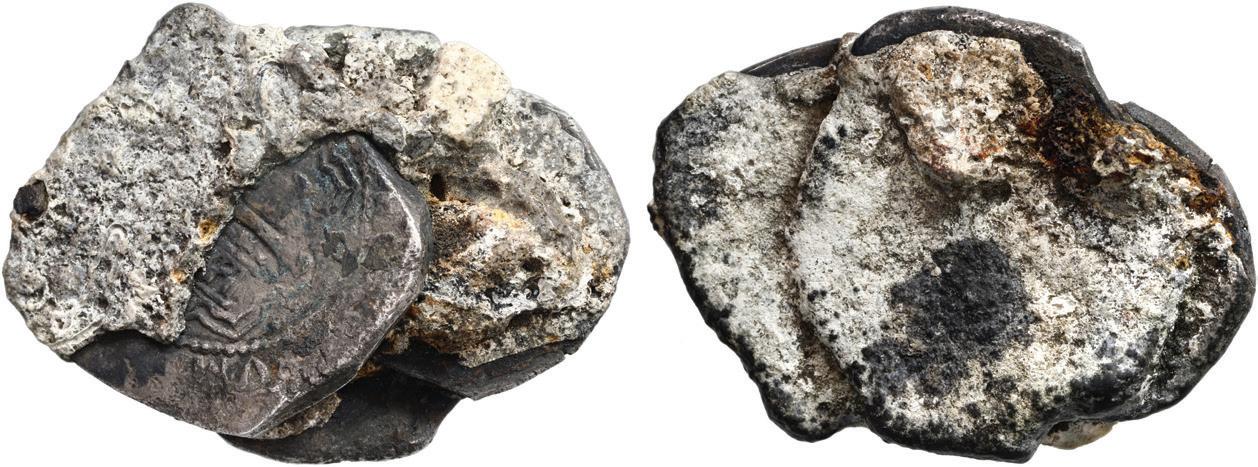
229. Clump of three Mexico City, Mexico, cobs, two 8R and one 4R, probably Philip IV, assayers not visible, in coral concretion (as found). 83.03 grams total. A very solid clump with what appear to be well-preserved coins (rare for this wreck), with the 4R sandwiched between the two 8R, mostly covered in white-gray-brown coral except for about half the cross side on the “top” coin, a compact but impressive display. Estimate: $800-$1,200.
230. Mexico City, Mexico, cob 4 reales, 1655 (P), cocooned in coral (as found). S-M19; KM-38; Cal-1073. 13.60 grams total. Round and apparently solid flan with the entire cross side covered in gray-white coral that extends to about a third of the obverse, outside of which is a clear mintmark oM and 655 of date, the exposed metal darkly toned. Estimate: $350-$500.

231. Mexico City, Mexico, cob 4 reales, Philip IV, assayer P. S-M19; KM-38. 12.83 grams. Broad, round flan with full but peripherally flat cross, lightly corroded full shield with full and clear denomination 4 to right, nearly full crown above, dark brown toning throughout. Estimate: $200-$300.
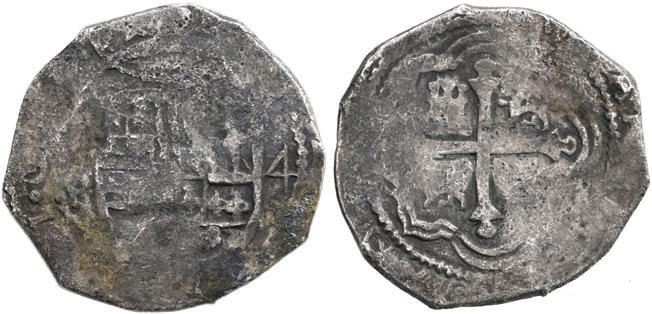

232. Potosí, Bolivia, cob 8 reales, (1649) O/Z/T (unique), early castles, rotated reverse legend, with crowned-L coun termark on shield (very rare thus), ex-Mastalir (Plate). S-P35; KM-unl; Cal-unl. 26.06 grams. Bold full assayer O with clear diagonal of the Z and faint but certain vertical of the T inside (not mentioned by Mastalir in his books), somewhat confirmed by the early-style castles and dark brassy color indicative of debased silver, very bold full coun termark near middle of full shield (one of only seventeen 8R known with this countermark on the obverse), full but somewhat flat cross, crude thick flan with much flatness but no corrosion, edge-split. Pedigreed to the Robert Mastalir Collection and plated on page 116 of Part B of his book The Great Transition at the Potosí Mint, 1649-1652: The 1649-1652 Crowned Shield Coinage and the Countermarks of 1652 (2021), with photo-certificate. Estimate: $500-up.

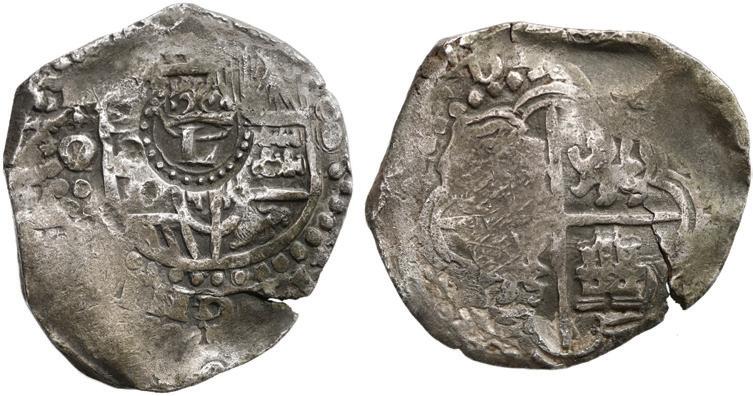
234. Potosí, Bolivia, cob 8 reales, 1650 O, with crowned-L countermark on cross, ex-MAREX. S-P35; KM-19b; Cal-1488. 22.80 grams. Good full shield with bold P-O to left and 8-O to right, offcenter cross with nearly full countermark near edge (odd placement for this type), faint 0 of date visible, lightly corroded and brown-toned. With original MAREX tag 91-8R-1014. Estimate: $350-$500.

233. Potosí, Bolivia, cob 8 reales, 1650 O, with crowned-L countermark on cross. S-P35; KM-19b; Cal-1488. 27.05 grams. Broad flan with no corrosion, choice full cross-and-tressure with bold full date, the countermark nearly full, also full but weaker shield with interesting five• ornaments above and below the mintmark-assayer to left and denomination-assayer to right (also with three horizontal dots between 8 and O) per Mastalir IIG muled with cross side “a” (date in normal position), which is rare, the obverse deeply toned but the reverse just toned on fields. Estimate: $600-$900.
235. Potosí, Bolivia, cob 8 reales, 1651 E, with crown-alone (rare) countermark on cross. S-P36; KM-19b; Cal-1491. 21.77 grams. Thin from corrosion but with good full cross showing most of coun termark (full crown, Mastalir K1a) and bold full 651 of date, the obverse moderately corroded but with full shield, mostly brown-toned. Estimate: $300-$450.

236. Potosí, Bolivia, cob 4 reales, 1649 O/Z, with crowned•F• (four dots) countermark on shield (very rare), ex-Harley, ex-Mastalir (Plate). S-P35; KM-17b; Cal-unl. 8.52 grams. Corroded and thin but with enough of the countermark to recognize it, also with full P-O/Z and tail of 9 of date, making it one of only three known with this combination, toned all over. Pedigreed to the Alan Harley Collection (Baldwin auction of September 2011, with original lot-card 1855 and collector’s tag) and to the Robert Mastalir Collection and plated on page 67 of Part A and page 356 of Part B of his books The Great Transition at the Potosí Mint, 1649-1652: The 1649-1652 Crowned Shield Coin age and the Countermarks of 1652 (2021). Estimate: $350-$500.

237. Potosí, Bolivia, cob 8 reales, 1652 E post-transitional (Transitional Type VIII/B), 1-PH-6 at top. S-P37a; KM-21; Cal-1500. 22.00 grams. Choice full pillars (fat) with bold full 1-PH-6 at top, also choice full cross-lions-castles, two dates, three mintmarks and assayers, nicely toned but with edge-split (as made) and thin edge from corro sion. With original certificate signed by Goin “Jack” Haskins, pedigreed to the J.P. Silberman Estate. Estimate: $700-$1,000.
238. Potosí, Bolivia, cob 8 reales, 1654 E, • PH• at top, pomegranate above cross. S-P37a; KM-21; Cal-1506. 20.55 grams. Bold full pillars-and-waves and good full cross despite moderate surface corrosion, two dates and assayers, bold king’s ordinal IIII, lightly brown-toned. Estimate: $200-$300.
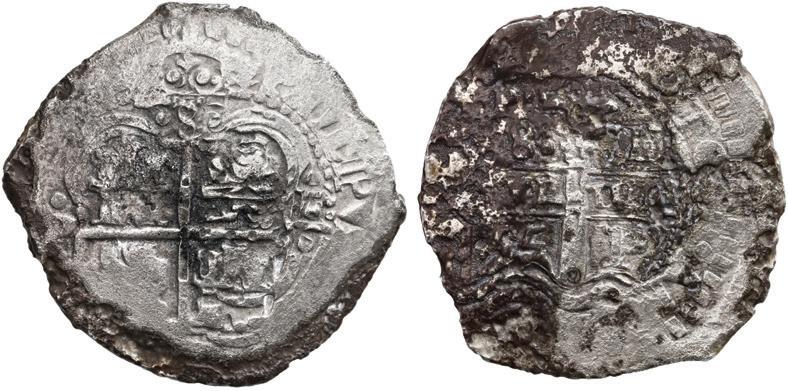
239. Potosí, Bolivia, cob 8 reales, 1655 E, • PH• at top, denomination 8 above cross. S-P37a; KM-21; Cal-1510. 21.95 grams. Bold full cross-lions-castles, one full pillar due to poor centering on that side (also corroded and about half dark), the date still clear as are the mintmarks and assayers (two each). Estimate: $200-$300.





240. Potosí, Bolivia, cob 8 reales, 1672 E. S-P37b; KM-26; Cal-703.
20.35 grams. Choice full cross-lions-castles, nearly full pillars-and-waves despite thinning from typical corrosion, two bold assayers and parts of all three dates, toned in crevices, tiny edge-split. With original ROBCAR photo-certificate MO15001. Estimate: $200-$300.
241. Potosí, Bolivia, cob 8 reales, 1678 E. S-P37b; KM-26; Cal-711.
21.07 grams. Bold full waves and nearly full cross (slightly doubled), parts of all three dates, typically corroded and lightly toned, edgesplit. With ROBCAR tag and photo-certificate 2022129. Estimate: $200-$300.
242. Potosí, Bolivia, cob 8 reales, 1679 C. S-P38; KM-26; Cal-714.
18.31 grams. Broad flan with smooth surfaces, thin from corrosion, three full dates, bold full waves, nearly full cross, deep brown toning, edge-split. Estimate: $250-$375.
243. Mexico City, Mexico, cob 8 reales, 1681 L. S-M21; KM-46; Cal-642. 26.13 grams. Very bold and 100% full date and oML, much flat ness but the flan unusually solid and uncorroded (albeit a bit abraded), with two sharp points blunted in its time, some small dark spots. With generic (small) certificate from the salvors. Estimate: $350-$500.
244. Mexico City, Mexico, cob 8 reales, 1681 L. S-M21; KM-46; Cal-642. 20.51 grams. Bold full date and full oML, typically mostly flat and thin from corrosion, silvery, rectangular flan. With generic (small) certificate from the salvors. Estimate: $200-$300.
245. Mexico City, Mexico, cob 4 reales, 1681 L, rare. S-M21; KM-unl; Cal-unl. 7.98 grams. Bold full oML and clear 1681 date, most of cross and shield, somewhat corroded but not as flat or thin as most, lightly toned. With generic (small) certificate from the salvors. Estimate: $200-$300.
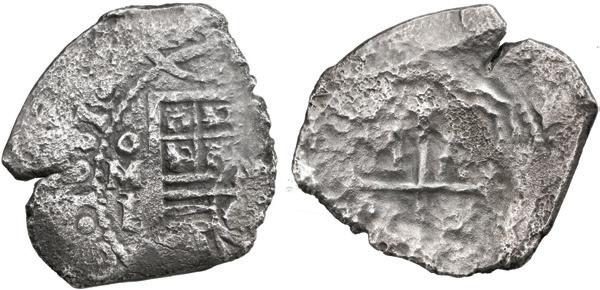


246. Brabant, Spanish Netherlands (Antwerp Mint), portrait ducatoon, Philip IV, 1644. KM-72.1. 32.16 grams.

Beautiful specimen with practically no corrosion and lovely toning (looks non-salvage), choice full inner details and bold legends, hairline edge-crack to right of date (as made). Estimate: $200-$300.
247. Clump of four Dutch silver “rider” ducatoons (mints and dates not visible). 101.64 grams total. Very tight sandwich of coins with “top” coin showing full and well detailed knight on horse (“rider”), the “bottom” coin corroded, darkly toned all over. With generic (small) certificate from the salvor. Estimate: $250-$375.

248. Potosí, Bolivia, cob 8 reales, 1680 V. S-P39; KM-26; Cal717. 23.56 grams. Very broad flan (albeit thin from corrosion) with exceptional details including 100% full and bold pillars-and-waves and cross-lions-castles, three full dates and mintmarks and assayers, somewhat darkly gray-toned all over. Estimate: $250-$375.
249. Potosí, Bolivia, cob 8 reales, 1683 V. S-P39; KM-26; Cal-721.

26.79 grams. Virtually corrosion-free and deeply toned, with choice full pillars-and-waves and nearly full (slightly off-center) cross-lions-castles, three dates, two mintmarks and assayers, very choice for this wreck. Estimate: $200-$300.
250. Potosí, Bolivia, cob 8 reales, 1687 VR. S-P40; KM-26; Cal-729. 25.85 grams. Broad flan with full but partially weak pillars-and-waves (nice tops) and cross-lions-castles, both slightly doubled, two dates and mintmarks, three assayers, minimal surface corrosion, toned in crevices. Estimate: $200-$300.




251. Utrecht, United Netherlands, “rider” ducatoon, 1711. KM-83.1. 32.39 grams. Good full details with nice (albeit slightly uneven) toning, only a trace of surface oxidation. Estimate: $200-$300.
252. Mexico City, Mexico, cob 8 reales, Philip V, assayer not visible, ex-Jaggers. KM-47. 25.62 grams. Choice full shield and cross with 100% full details in both, full denomination 8, solid and nicely toned, with minimal surface corrosion, one of the better coins from this scarce and desirable wreck. Pedigreed to the Tony Jaggers collection, with his photo-certificate. Estimate: $350-$500.
253. Mexico City, Mexico, cob 8 reales, 1713 J. S-M22; KM-47; Cal-1400. 25.57 grams. Very solid flan with two sharp points blunted in its time, with bold full date and oMJ, nearly full cross, uncorroded but peripherally flat, toned in crevices. With photo-certificate. Estimate: $400-$600.
256. Mexico City, Mexico, cob 8 reales, 1714 J. S-M22; KM-47; Cal-1401. 25.82 grams. Full date and mintmark, most of crown and shield and cross despite some corrosion (especially on edge), mostly toned. With photo-certificate. Estimate: $350-$500.
254. Mexico City, Mexico, cob 8 reales, 1713 J. S-M22; KM-47; Cal-1400. 26.74 grams. Thick and solid flan without corrosion but mostly flat, yet with full oMJ and bottom half of date, most of cross, toned in crevices. With Sedwick photo-certificate. Estimate: $350-$500.
257. Mexico City, Mexico, cob 8 reales, Philip V, assayer J. S-M22; KM-47. 24.64 grams. Solid but smallish flan with bold assayer J, most of shield and cross despite peripheral flatness, light surface corrosion, toned in crevices. Pedigreed to the J.P. Silberman Estate. Estimate: $250-$375.
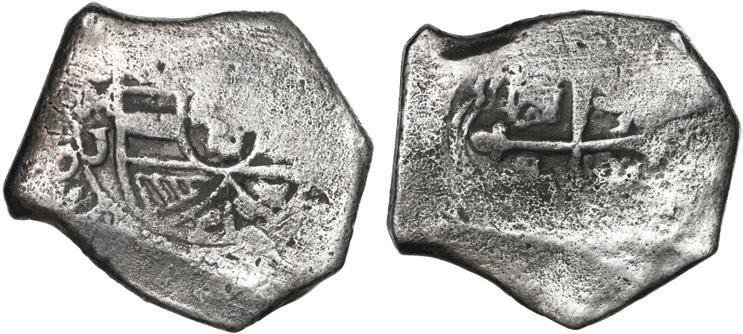
255. Mexico City, Mexico, cob 8 reales, 1714 J, ex-Real Eight. S-M22; KM-47; Cal-1401. 23.94 grams. Bold 14 of date, some shield and cross but mostly worn or flat and lightly corroded, patchy dark toning, desirable certificate from the early 1970s. With original Real Eight Co. certificate signed by Harry Cannon, pedigreed to the J.P. Silberman Estate. Estimate: $500-$750.


258. Mexico City, Mexico, cob 8 reales, Philip V, assayer not visible (small shield-style obverse of 1714 J). KM-47. 25.19 grams. Typically rectangular flan with rounded sides neatly aligned with the full and well-detailed shield and crown (distinctive small design), full but lightly corroded cross, darkly toned in crevices. With photo-certificate. Estimate: $200-$300.


Watch and bid LIVE on the Internet at www.auction.sedwickcoins.com

259. Mexico City, Mexico, cob 8 reales, Philip V, assayer not visible. KM-47. 26.20 grams. Fascinating shape, like a fat bottle with wide long neck, nicely aligned with both the full shield and the partial cross, peripherally flat but virtually uncorroded, spots of dark “horn silver” here and there. Pedigreed to the J.P. Silberman Estate. Estimate: $250-$375.


262. Mexico City, Mexico, cob 8 reales, Philip V, assayer not visible. KM-47. 26.30 grams. Very thick flan with well-centered (and nearly full) shield and cross, light surface corrosion with some gold color in addition to toning in crevices. Pedigreed to the J.P. Silberman Estate. Estimate: $200-$300.
260. Mexico City, Mexico, cob 8 reales, Philip V, assayer not visible. KM-47. 25.79 grams. Choice shield (nearly full) and most of cross, peripherally flat but only lightly corroded on reverse, attractively toned, somewhat rectangular in shape. Pedigreed to the J.P. Silberman Estate. Estimate: $250-$375.
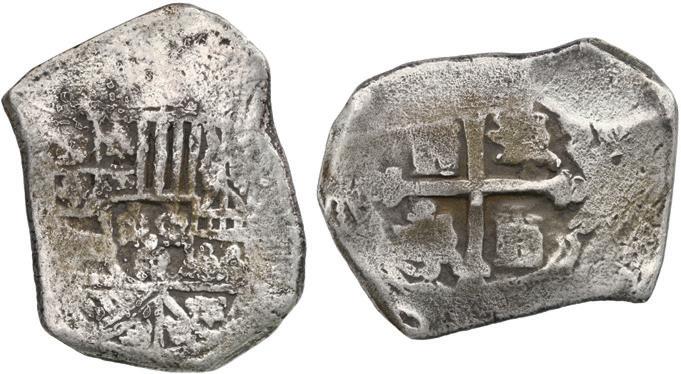


263. Mexico City, Mexico, cob 8 reales, Philip V, assayer not visible. KM-47. 26.60 grams. Solid, squarish flan with good cross (nearly full) and some shield and crown but otherwise largely flat (as made), nicely toned, no corrosion. Pedigreed to the J.P. Silberman Estate. Estimate: $200-$300.
264. Mexico City, Mexico, cob 8 reales, Philip V, assayer not visible. KM-47. 25.61 grams. Broad flan with minimal corrosion but extensive flatness, most of shield and cross still in evidence, unevenly toned with very light surface corrosion. Pedigreed to the J.P. Silberman Estate. Estimate: $200-$300.
261. Mexico City, Mexico, cob 8 reales, Philip V, assayer not visible. KM-47. 26.69 grams. Squarish flan aligned diagonally with the (approximately) 75% full shield, nice upper half of cross, flat in peripheries but minimal surface corrosion, lightly toned. Pedigreed to the J.P. Silberman Estate. Estimate: $200-$300.
Please visit our website
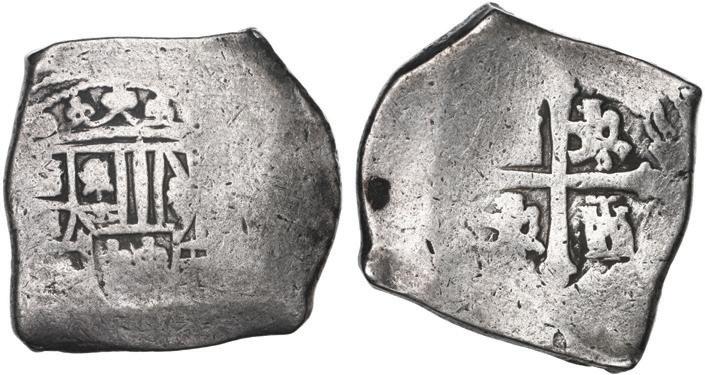
265. Mexico City, Mexico, cob 8 reales, Philip V, assayer not visible. KM-47. 25.11 grams. Neatly rectangular with one diagonal corner (all sides appear to be straightly cut, which is unusual), practi cally no corrosion but one spot of dark oxidation on partial shield, the cross nearly full, peripherally flat but lightly toned. Pedigreed to the J.P. Silberman Estate. Estimate: $200-$300.
268. Mexico City, Mexico, cob 8 reales, Philip V, assayer not visible, partially encrusted (as found). KM-47. 29.83 grams. Very weird, curved shape accentuated by a large patch of thick encrustation at one end containing lots of small shell-bits in orange and gray, the coin itself deeply toned and fairly solid, with clear denomination 8 next to a well-detailed nearly full shield, a rare and attractive display. With photo-certificate. Estimate: $250-$375.
266. Mexico City, Mexico, cob 8 reales, Philip V, assayer not visible. KM-47. 25.46 grams. Odd “anvil” shape with interesting golden-brown toning all over, minimal surface corrosion, nearly full cross, partial shield and crown. Pedigreed to the J.P. Silberman Estate. Estimate: $200-$300.
269. Mexico City, Mexico, cob 8 reales “greenie” (uncleaned, as found), Philip V, assayer not visible. KM-47. 25.36 grams. Solid flan with probably little or no corrosion but still coated in dark oxida tion with small bits of orange and sea foam green, the cross apparently full. Pedigreed to the J.P. Silberman Estate. Estimate: $200-$300.
267. Mexico City, Mexico, cob 8 reales, Philip V, assayer not visible. KM-47. 25.89 grams. Odd shape with natural indentation, bold cross but weak shield, solid but with area of pitting on reverse, unevenly toned. Pedigreed to the J.P. Silberman Estate. Estimate: $200-$300.


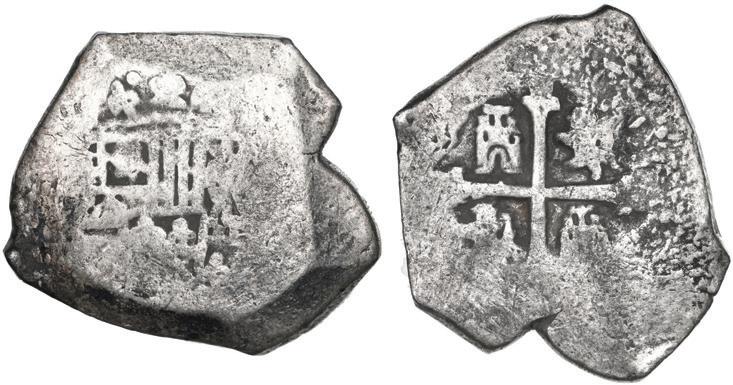

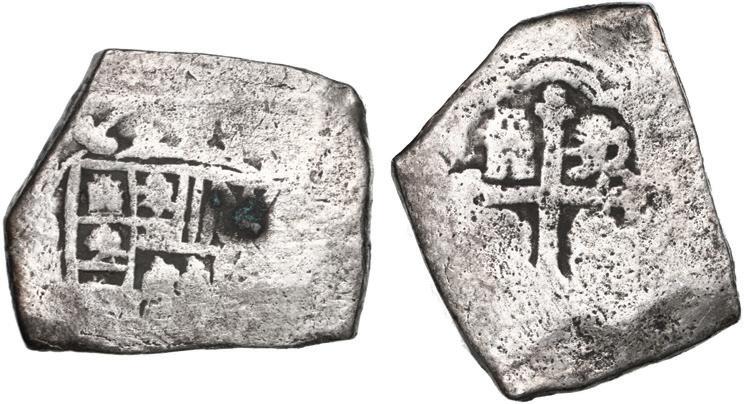
270. Mexico City, Mexico, cob 4 reales, 1714 J, ex-Real Eight. S-M22; KM-40; Cal-1084. 13.02 grams. Good full cross, nearly full shield with oMJ to left, trace of 4 of date in legend, a bit worn but not overly corroded, toned in crevices, desirable certificate from the early 1970s. With original Real Eight Co. certificate signed by Harry Cannon, pedigreed to the J.P. Silberman Estate. Estimate: $350-$500.
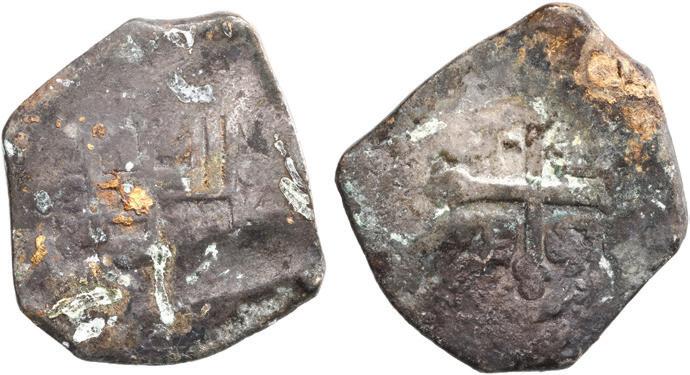
271. Mexico City, Mexico, cob 4 reales, 1714 (J), “new style.” S-M22; KM-40; Cal-1084. 11.44 grams. Bold full 14 of date, most of shield with original salvor’s or collector’s “H” sticker in middle, flat and lightly corroded cross, lightly toned. Estimate: $250-$375.

272. Mexico City, Mexico, cob 4 reales, Philip V, assayer not visible. KM-40. 12.86 grams. Solid flan of interesting shape, practically uncorroded, with bold full denomination 4 to right of most of shield, nearly full cross-lions-castles, darkly toned all over. Pedigreed to the J.P. Silberman Estate. Estimate: $200-$300.

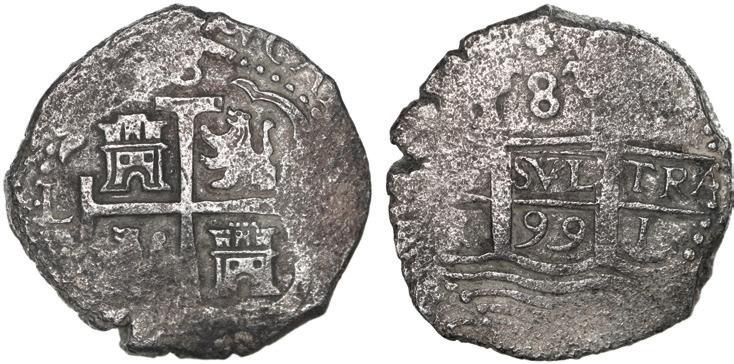
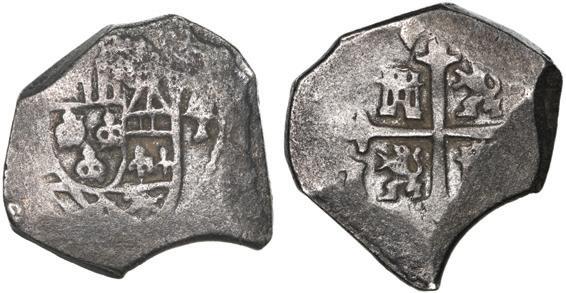
273. Lima, Peru, cob 8 reales, 1699 R, with hand-signed Fisher certifi cate. S-L14; KM-24; Cal-606. 24.02 grams. Bold full date above full waves, good full cross-lions-castles, lightly toned over surface corrosion. With small, hand-signed Fisher certificate from the late 1960s or early 1970s. Estimate: $250-$375.

274. Madrid, Spain, gold cob 2 escudos, 1707/6 Y/F, unique and unlisted. KM-unl; Cal-unl. 6.74 grams. Very boldly struck, with choice full cross-and-tressure and clear bottom half of 07/6 of date at top, well-detailed full shield with very bold over-assayer Y/F below mintmark to left, bright yellow AU with spots of mercury damage here and there typifying this wreck (actually two ships sunk together, collectively nicknamed the “quicksilver galleons” for their cargo of mercury). This coin, while damaged, is numismatically very important in defining a link from assayer F (Fernando Vázquez?) to assayer Y (Ysidoro Parraga?) in the middle of the first decade of the 1700s, despite the apparent intervention of assayer BR (Bernardo Pedrera y Negrete) in 1703-4 and assayer J (Joseph García Caballero) in 1704-6. Before the appearance of this 2 escudos, which is not yet recognized in the major Spanish publications, the only dates and denominations recorded for these two assayers (including as under-assayers) have been the following: 1R—1706(?) F, 1704 Y, 1707 Y; 8R—1706 Y, 1706 BR/Y; 1E—1706(?) F/ BR; 4E—1707 F; 8E—1706/4/3 Y/BR, 1707 F. Also note that no other Madrid 2E are recorded for the entire period of 1703 to 1710. With Sedwick photo-certificate. Estimate: $2,000-up.
275. Utrecht, United Netherlands, gold ducat, 1724, NGC
MS 63 / Akerendam (Shipwreck Blue Label). KM-7.1. 3.48 grams. Much luster and satin-smooth surfaces, struck on an out-of-round flan with minor crudeness in peripheries (knight’s head flat), slightly concave (as made). NGC #6481454-001. Estimate: $900-$1,350.
276. Utrecht, United Netherlands, gold ducat, 1724, NGC
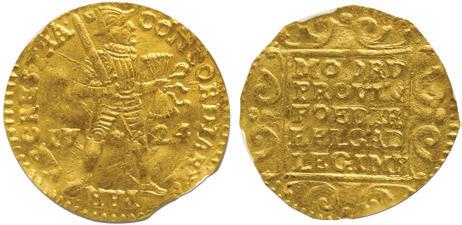
MS 62 / Akerendam (Shipwreck Certification Label). KM-7.1.
Full details including knight’s head, alternating luster and matte spots. NGC #5854994-049. Estimate: $800-$1,200.
277. Utrecht, United Netherlands, gold ducat, 1724, NGC MS 61. KM-7.1. Deep orange color with traces of luster on relatively smooth surfaces, knight’s head typically flat. NGC #2602000002. Estimate: $700-$1,000.
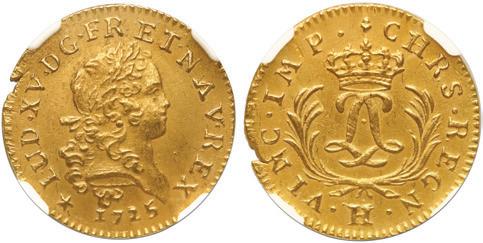
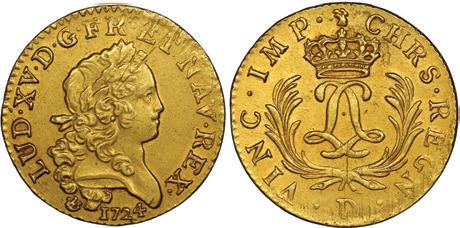

278. France (Bayonne mint), gold louis d’or mirliton, Louis XV, 1723-L, LL monogram with palm branches, rare, NGC UNC details / cleaned / Le Chameau (Shipwreck Blue Label). Gad-338; KM-468.9. Boldly struck obverse with adjustment marks on bust, center of reverse slightly weak, surfaces somewhat matte, rated R2 in Gadoury. Pedigreed to the Stack’s Bowers auction of November 2015, with original lot-tag 23146. NGC #6481048-001. Estimate: $2,000-$3,000.
279. France (Grenoble mint), gold louis d’or mirliton, Louis XV, 1723-Z, LL monogram with palm branches, rare, NGC UNC details / saltwater damage / Le Chameau (Shipwreck Blue Label). Gad-338; KM-unl. Choice bold strike with muted luster, minor die-cracks but no adjustment marks, small spots of red toning, rare mint and date (none listed in the original 1971 Parke-Bernet auction and unlisted in KM, also rated R4 in Gadoury). NGC #6475849-001. Estimate: $2,500-up.
280. France (Lyon mint), gold louis d’or mirliton, Louis XV, 1724-D, LL monogram with palm branches, NGC UNC details / saltwater damage / Le Chameau (Shipwreck Blue Label). Gad-339; KM-470.5. Bold strike and nice color with muted luster, light adjustment marks on both sides (chiefly at rims). NGC #6475849-002. Estimate: $2,000-$3,000.
281. France (Tours mint), gold louis d’or mirliton, Louis XV, 1724-E, LL monogram with palm branches, NGC AU details / saltwater damage / Le Chameau (Shipwreck Blue Label). Gad-339; KM-470.6. Bold strike with muted luster and no adjustment marks, slight staining on obverse and peripheral patch of brown encrustation on reverse (interesting thus), scarce mint (rated R in Gadoury). NGC #6475849-003. Estimate: $2,000-$3,000.

282. France (La Rochelle mint), gold louis d’or mirliton, Louis XV, 1725-H, large palms variety, NGC UNC details / saltwater damage / Le Chameau (Shipwreck Blue Label), ex-Ford, ex-Partrick (both stated on label). Gad-339; KM-470.8. Nice color, bold strike with muted luster, small natural notch in edge, desirable pedigrees. Pedigreed to the famous collections of John J. Ford, Jr. and Donald G. Partrick. NGC #6054740-003. Estimate: $2,500-$3,750.
283. France (La Rochelle mint), ecu, Louis XV, 1725-H. Gad320; KM-472.9; Dupl-1670. 22.12 grams. Exceptional quality for this wreck (most are slivers) with bold full details on both sides, minimal surface corrosion and nice toning all over. Estimate: $350-$500.
284. France (La Rochelle mint), ecu, Louis XV, 1725-H. Gad-320; KM-472.9; Dupl-1670. 19.34 grams. Typically worn and corroded (especially the obverse, which is a bit shiny), but with bold reverse showing clear date, nice toning, typical adjustment marks, actually above average quality for this wreck that was salvaged in a high-energy ocean environment. Estimate: $200-$300.


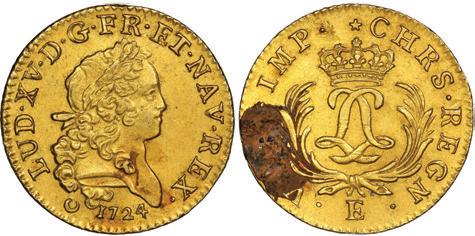

285. Holland, United Netherlands, gold ducat, 1729, NGC MS 62 / Vliegenthart (Shipwreck Blue Label). KM-12.2. Choice luster and details per the mint, parts of edge slightly crude (as made) and with evidence of die-clashing on both sides. With original (generic) certificate from the salvors and ANACS photo-certificate TR2214. NGC #6478395-001. Estimate: $1,000-$1,500.


286. Utrecht, United Netherlands, gold ducat, 1729, NGC MS 64 / Vliegenthart (Shipwreck Blue Label). KM-7.1. Super-sharp strike with strong luster throughout, 100% full details including knight’s head. With original (generic) certificate and booklet from the salvors. NGC #6478395-002. Estimate: $1,000-$1,500.
287. Westfriesland, United Netherlands, gold ducat, 1729. KM-93.2. 7” x 4” x 1-1/2” (box). Typically lustrous and choice, Mint State with just a few light marks, weakness near part of edge, attractive promotional display. Housed in a plastic promotional holder with information printed inside, with small certificate from the salvors, all in a 6-1/2” X 3-1/2” clamshell case & box also printed with name of wreck. Estimate: $1,250-$2,000.
288. Mexico City, Mexico, cob 8 reales “biscuit” (completely cocooned in thick oxidation with shells), probably Philip V, assayer not visible. 32.36 grams total. Hefty and thick rectangular chunk of black oxidation (following the contour of the coin itself) with lots of tiny white shell-bits, a neat display that could contain a choice coin (based on weight). With certificate. Estimate: $250-$375.
289. Overijssel, United Netherlands, “rider” ducatoon, 1734, NGC UNC details / saltwater damage. KM-80; Dav-1829. Nontoned and lustrous, with choice full details and almost no corrosion except around edge. NGC #6327011-001. Estimate: $250-$375.
290. Mexico City, Mexico, klippe 4 reales, 1733 F. S-M27; KM-unl; Cal-1099. 13.16 grams. Very choice full details with virtually no corrosion (just some dark oxidation and minute pitting), off-center strike enabling a full date and oMF, attractively toned and scarce. With original (generic) certificate from the salvors. Estimate: $1,000-$1,500.

291. Mexico City, Mexico, pillar 8 reales, Philip V, 1737 MF. Yonaka-M8.37; KM-103; Cal-1446. 25.63 grams. Sharp AU details with faint luster despite light surface corrosion all over, very lightly toned with dark brassy spot above crown. With original (generic) certificate B 5117 from the salvors. Estimate: $200-$300.




292. Lima, Peru, cob 8 reales, 1727 M. S-L20b; KM-34a; Cal-1300. 23.29 grams. Odd shape (a broad oval) with some corrosion near edge on both sides but the cross and pillars clear, two dates and assayers, natural lamination near edge, toned in crevices. Estimate: $200-$300.


293. Mexico City, Mexico, pillar 8 reales, Philip V, 1744 MF, very rare provenance, ex-McKee, ex-Eidel. Yonaka-M8.44; KM-103; Cal-1466. 25.47 grams. Near-AU details with minimal surface corrosion and deep, rich toning all over, first and only example we have ever seen from this obscure wreck that was found in 1950 but not identified until years later (despite the name of the adjoining island, Looe Key), yielding “a number of fine artifacts” (according to Marty Meylach). Pedigreed to the Charles Eidel collection, with original certificate hand-signed by Mrs. Arthur McKee, Jr. (Art’s wife) stating origin as “found by Bob Cruz on the Tom Gurr expedition.” Estimate: $500-up.
294. Guatemala, cob 4 reales, 1739 (J), ex-Katz. JP-4R7; S-G1; KM-5; Cal-1010. 12.97 grams. Sharply five-sided flan (thick and solid) with typically soft strike but minimal surface corrosion, clear full date, nicely toned. Pedigreed to the Estate of Wallace Katz. Estimate: $200-$300.
295. Mexico City, Mexico, pillar 8 reales, Philip V, 1739 MF. Yonaka-M8.39; KM-103; Cal-1453. 26.65 grams. AU details with traces of luster peeking through deep toning, minimally corroded but also a bit abraded on pillars side. With JCI promotional case (small) printed with wreck details. Estimate: $200-$300.
296. Mexico City, Mexico, pillar 8 reales, Philip V, 1740 MF.




Yonaka-M8.40; KM-103; Cal-1456. 25.91 grams. AU details, bright white in color with traces of luster and with toning on pillars-side rim, minimal surface corrosion. With JCI promotional case (small) printed with wreck details. Estimate: $200-$300.
297. Mexico City, Mexico, pillar 8 reales, Philip V, 1742 MF. Yonaka-M8.42; KM-103; Cal-1461. 26.72 grams. Bold AU with practically no corrosion except for some minor pitting, lightly toned all over. Estimate: $200-$300.
298. Santiago, Chile, gold bust 8 escudos, Ferdinand VI, 1751 J, NGC MS 62 / La Luz (Shipwreck Blue Label). Cal824; KM-3. Nice luster, the strike typically weak in centers but the fields fairly smooth (just a few light marks and hairlines), incomplete rims as usual. NGC #6481048-002. Estimate: $2,500-$3,750.
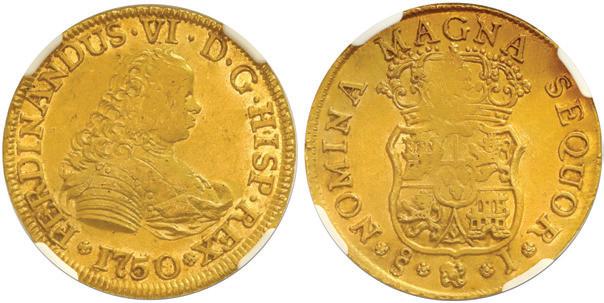
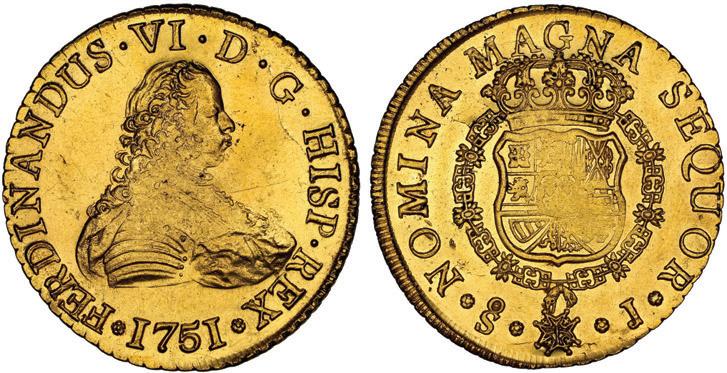
300. Lima, Peru, cob 8 reales, 1751 (R), very rare. S-L23; KM44; Cal-449. 24.94 grams. Solid flan (very thick) with minimal surface corrosion except for pit on cross side, deeply toned, with clear tops of the digits of the date despite peripheral flatness. Estimate: $350-$500.

299. Santiago, Chile, gold bust 4 escudos, Ferdinand VI, 1750/5 J, NGC UNC details / saltwater damage / La Luz (Shipwreck Blue Label). Cal-742; KM-2. Bold legends with traces of luster, the centers typically weak but relatively free of marks, traces of orange staining in bottom of shield. NGC #5961243-008. Estimate: $1,750-$2,500.
301. Potosí, Bolivia, cob 8 reales, 1731 M. S-P44; KM-31a; Cal1564. 17.97 grams. Clear date and assayer above bold full waves, most of cross with bold mintmark to left and partial second date below, moderately corroded with contrasting burgundy toning throughout. With original tag and photo-certificate 970049 from Uruguay. Estimate: $200-$300.


302. Mexico City, Mexico, pillar 8 reales, Ferdinand VI, 1755 MM. KM-104.2; Cal-489. 25.67 grams. XF details with darkly oxidized surfaces (not overly corroded, however). With original (small) certificate 931 from the salvagers. Estimate: $200-$300.
303. Lima, Peru, pillar 8 reales, Ferdinand VI, 1756 JM, dots over both mintmarks, ex-ANA “Treasures of the Deep.” KM-55.1; Cal-unl. 23.84 grams. AU details despite light surface corrosion, lightly toned and with patches of dark “horn silver.” Pedigreed to the Thomas Gray collection and formerly displayed at the ANA Money Mu seum’s “Treasures of the Deep” exhibit (2014-15). Estimate: $200-$300.

304. France (Caen Mint), 1/2 ecu, Louis XV, 1729-C. Gad-313; KM-484.5. 14.29 grams. No corrosion except for part of obverse rim, silvery surfaces (toned in crevices), VF details, very solid for this wreck, scarce mint (rated R in Gadoury). With photo-certificate. Estimate: $200-$300.

305. France (mint uncertain), ecu, Louis XV, 1771, rare provenance, ex-Eidel. 26.16 grams. Broad flan with mostly bold details despite areas of moderate corrosion and heavy pits, beautifully toned all over. We have sold a number of artifacts from this wreck in the past, but this remains the only coin we have ever seen or heard of, the wreck itself being important for its role in the American Revolutionary War. Pedigreed to the Charles Eidel collection, with hand-signed Frank Sedwick letter of provenance from 1992. Estimate: $250-$375.
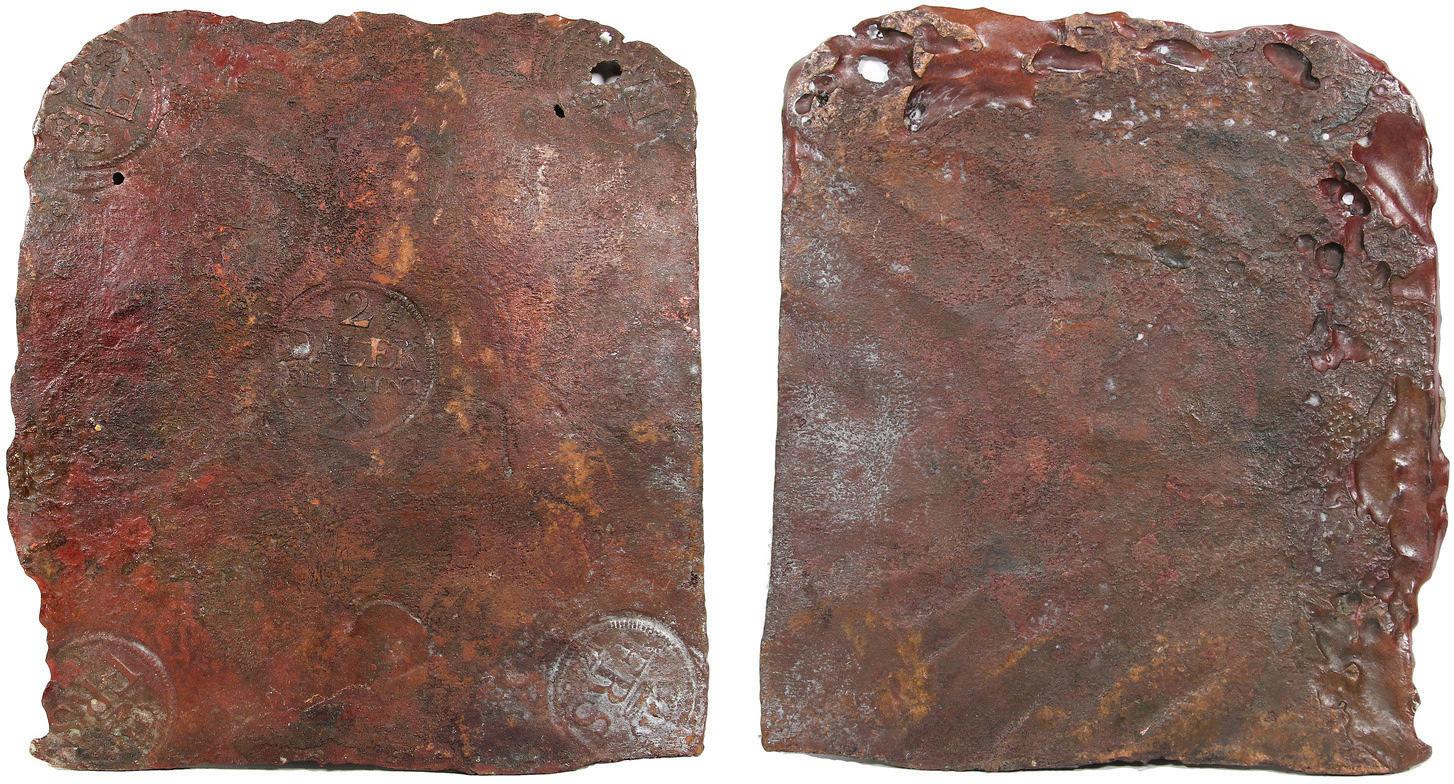

306. Swedish copper “plate money” 2 dalers, Fredrik I, 1726. KM-PM71. 1193 grams; 7” x 7-1/2”. All five stamps fairly clear (one cor roded through) showing denomination, king’s monogram and date 1726, which appears to be rare, as only one is mentioned in the original Ponterio auction for this wreck (January 1990), nice color and really quite solid except for two edges and parts of reverse. Estimate: $350-$500.
307. Encrusted clump of three Spanish colonial 8 reales, probably all busts of Mexico City, Mexico, Charles III. 73.84 grams total. Three fairly solid coins, one offset from the other two sandwiched together, all darkly toned and encrusted (mostly orange but some traces of green), the “top” coin with barely visible date that looks like 1782 or 1783, a very stable display. Estimate: $400-$600.
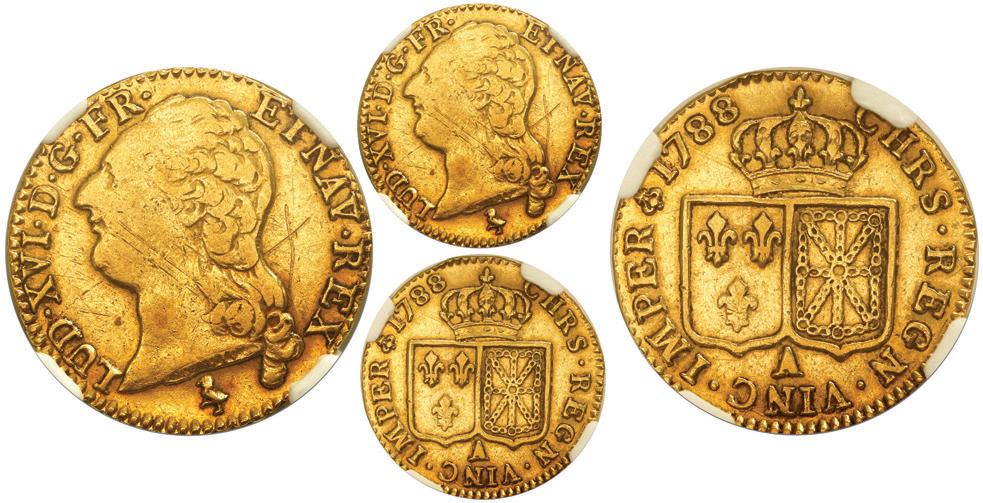
308. France (Paris mint), gold louis d’or a la tête nue, Louis XVI, 1788-A, very rare provenance, NGC VF details / obv graffiti. Gad-361; KM-591.1. 7.69 grams. Bold details with light toning around and traces of luster, a few minor marks including a small X (test mark) behind the head (also some light adjustment marks on bust), a generally rare date but particularly valuable for its provenance as among a group of thirteen gold coins wrapped inside a West Indies newspaper from 1809 (advertising a slave auction) and found inside an elegant gold snuff box (which we sold in Auction 7 in 2010), ostensibly an “arras” (Spanish dowry) and the key to pinpointing the date and possible trade of this mysterious shipwreck that was found and salvaged by robot in 2001 at a depth of about three miles (at the time, the deepest treasure salvage ever undertaken), following accidental discovery while searching for Gus Grissom’s capsule, Liberty Bell 7 (which was lost in 1961 and recovered in 1999). Pedigreed to the Stack’s auction of January 2008 (lot 7016). NGC #6062278-007. Estimate: $2,500-up.
309. USA (Philadelphia Mint), Seated Liberty half dollar, 1854, with arrows, NGC Shipwreck Effect / SS Republic. Only 338 Philadelphia-minted 1854 halves were found aboard the SS Republic, a small fraction when compared to the 3,434 New Orleansminted halves that were salvaged. XF with light surface corrosion, some areas of original luster including most of the reverse. NGC #1797738002. Estimate: $350-$500.
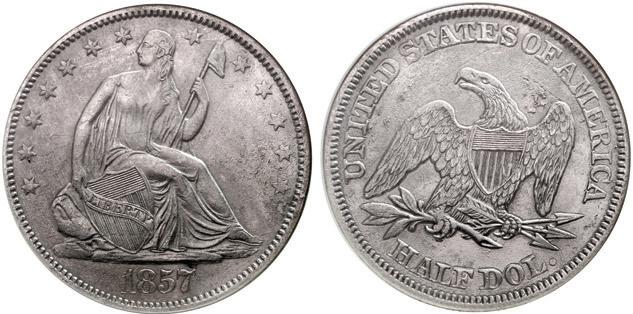

310. USA (Philadelphia mint), Seated Liberty half dollar, 1857, NGCShipwreck Effect/ SS Republic. A scarce date as just 257 Philadelphia-minted 1857 halves were salvaged from the wreck compared to the 747 New Orleans-minted 1857 halves recovered. Nice AU with plenty of luster, some areas of minor saltwater corrosion. NGC #1796656-020. Estimate: $350-$500.

311. USA (New Orleans Mint), Seated Liberty half dollar, 1858-O, NGC Ship wreck Effect / SS Republic label (royal blue core). Sharply detailed AU with lustrous reverse, minor surface corrosion. With special NGC SS Republic label and blue holder. NGC #2128714-033. Estimate: $250-$375.
312. USA (New Orleans Mint), Seated Liberty half dollar, 1858-O, 1 in border variety, NGC Shipwreck Effect / SS Republic label (royal blue core). Interesting variety with the 1 in date erroneously punched low and into the border at first, then corrected. AU with patches of surface corrosion yet other areas quite lustrous and untouched. With special NGC SS Republic label and blue holder. NGC #2128756-018. Estimate: $250-$375.
313. USA (New Orleans Mint), Seated Liberty half dollar, 1858-O, doubled 8 variety, NGC Shipwreck Effect / SS Republic label (royal blue core). Nice example from this shipwreck of a die variety with a faint 8 in the rock above the corrected date. Full AU details with much luster and only minor surface corrosion. With special NGC SS Republic label and blue holder. NGC #2128723-037. Estimate: $250-$375.

314. USA (New Orleans Mint), Seated Liberty half dollar, 1858-O, 8 in rock variety, NGC Shipwreck Effect / SS Republic label (royal blue core). Scarce variety with the 18 from date punched into the rock at Liberty’s feet. Lightly corroded AU with much retained luster and detail. With special NGC SS Republic label and blue holder. NGC #2128761-037. Estimate: $250-$375.
315. USA (New Orleans mint), Seated Liberty half dollar, 1859-O, NGC Shipwreck Effect / SS Republic. Bright, about AU piece with very light surface corrosion. NGC #1793455-247. Estimate: $200-$300.
316. Clump of seven USA Seated Liberty half dollars, very rare. 80.69 grams; 2” x 1-1/2”. Solid, encrusted leaning stack of seven halves as recovered from the SS Republic and quite scarce since most coins were cleaned up, slabbed, and sold individually. This is the first time we’ve offered a clump from this wreck. Although most of the coins are heavily encrusted, the top coin shows off its eagle plus UNITED in the legend. With certificate #7059. Estimate: $800-up.





317. Sydney, Australia (under Great Britain), gold 1/2 sovereign, Victoria (young head), 1872-S. Sp-3862A; KM-5. 4.00 grams. AU details with somewhat matte surfaces but no marks or other flaws. With original (generic) certificate from the salvor. Estimate: $600-$900.
318. Great Britain (London, England), gold sovereign, Victoria (young head), 1872, St. George type, NGC AU 58 / RMS Douro label. Sp-3856A; KM-752. Rather lustrous (especially the reverse) with minor bagmarks only. NGC #4472337-142. Estimate: $600-$900.


319. Guanajuato, Mexico, cap-and-rays 8 reales, 1883 BR, with chopmarks from circulation in Asia, very rare provenance, ex-Mendel Peterson. DP-Go65; KM-377.8. 27.09 grams. Lustrous AU cap-and-rays side with five large, bold chopmarks, the eagle side more like XF with deep, rich toning and three weaker chops, an incredible yield from the wreck of a coaling schooner that was driven onto rocks at Point Reyes in rolling seas and heavy fog, dived on by the famous adventurer and Smithsonian curator Mendel Peterson sometime in the 1950s-70s. Pedigreed to the collection of the late Mendel Peterson (Curator of Underwater Archeology for the Smithsonian Institution), with small certificate from Gene Brandenburg. Estimate: $250-up.

320. Great Britain (London, England), gold sovereign, Victoria (widow bust), 1890, very rare provenance. Sp-3866B; KM-767. 7.96 grams. XF details with bits of dark encrustation in crevices, slightly abraded surfaces, first and only coin we have ever offered from this World War I steamer tor pedoed by the Germans off Bardsley Island, North Wales, and salvaged by divers in 1985-86. With certificate and hand-signed letter from the salvor. Estimate: $800-$1,200.

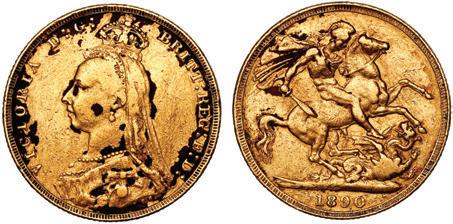
321. USA, $1 silver certificate, series 1935E, serial G97960215H, Priest-Humphrey, PCGS Currency Grade B, with display box, COA, and DVD. Fr-755. Nice example of a Grade B note from this wreck with some pre-sinking circulation folds (VF in terms of grade) and some post-sinking edge degradation and staining from 25 years of oceanwater immersion yet still possessing bold ink colors and good paper quality due to being tightly bound in packs while in the purser’s safe. Encased in a Lucite holder contained in a display box accompanied by a certificate from the salvors and a promotional DVD entitled “S.S. Andrea Doria: A Journey of Adventure.” PCGS #80019258. Estimate: $200-$300.


322. USA, $1 silver certificate, series 1935E, serial T91960663H, Priest-Humphrey, PCGS Currency Grade B, with display box, COA, and DVD. Fr-755. Choice for the assigned B grade with very minor edge degradation and staining along with great paper qual ity and ink color due to being tightly bound in bundles when stored in the purser’s safe. Encased in a Lucite holder contained in a display box accompanied by a certificate from the salvors and a promotional DVD entitled “S.S. Andrea Doria: A Journey of Adventure.” PCGS #80017264. Estimate: $200-$300.





323. Mexico City, Mexico, 4 reales, Charles-Joanna, “Early Series,” assayer P to right, mintmark M to left (oMo-oPo), AU details / cleaned. Nesmith-26b; Cal-123; S-M4; KM- 17. 13.52 grams. Well struck with clear legends and interiors on a full flan, this type (oMo-oPo with left-leaning panel) encompassing the largest variety of legends, a majority from the later HISPANIARVM period like this example. Pedigreed to the Clyde Hubbard Collection of Mexican CharlesJoanna Coinage (stated on label). Accompanied by original tag or holder. NGC #6482293-002. Estimate: $3,000-$4,500.
325. Mexico City, Mexico, 4 reales, Charles-Joanna, “Late Series,” assayer G to right, mintmark oM to left (oM-G), rare, NGC MS 61. Nesmith-54a; Cal-127; S-M5; KM-18. 13.63 grams. Very rare variety (oM-G) with only one other known to have sold at auction (see lot 267 in our Auction 29) and two others in the Banco de Mexico collection, all of which are of much lesser quality than this beauty, despite its two flan cracks. Full legends and details with a lovely patina make this example a coveted prize, especially considering it is tied for finest in the NGC census. Pedigreed to the Clyde Hubbard Collection of Mexican Charles-Joanna Coinage (stated on label). Accompanied by original tag or holder. NGC #6478181-008. Estimate: $800-$1,200.
324. Mexico City, Mexico, 1/2 real, Charles-Joanna, “Early Series,” assayer G, mintmark oMo to left, oM/F/Po to right, extremely rare, NGC VF details / rev scratched. Nesmith-unl; Cal-unl; S-M2; KM-unl. In Auction 31 we featured a 1/2 real with oMooM/Fo and this one is even more important as oMo-oM/F/Po, barely visible with magnification. Both are unique, the present example a much better specimen despite the scratches on both sides, given its virtually full legends. There are no die-matches to assayer P and F coins, the differences having to do with stops used in legends, whether the panel leans right or left, and even what is within the panel (only PLV under assayers F and G while assayer P has both PLS and PLV). Until more examples become available, we make assumptions based on the few 1/2 reales coins minted under each of the assayers. Pedigreed to the Clyde Hubbard Collection of Mexican Charles-Joanna Coinage (stated on label). Accompanied by original tag or holder. NGC #6482293-001. Estimate: $2,000-$3,000.
326. Mexico City, Mexico, 4 reales, Charles-Joanna, “Late Series,” assayer G to right, mintmark M to left (M-G), king’s name as CHAROLVS, NGC AU details / cleaned. Nesmith50b; Cal-125; S-M5; KM-18. 13.46 grams. Fully struck with great details in legends and interiors, a lovely coin despite having been cleaned, pretty much what one would expect from this assayer, and among his earliest emissions. Pedigreed to the Clyde Hubbard Collection of Mexican Charles-Joanna Coinage (stated on label) and to the Superior Auction of June 1975, lot 1561. Accompanied by original tag or holder. NGC #6478181-005. Estimate: $500-$750.

327. Mexico City, Mexico, 4 reales, Charles-Joanna, “Late Series,” assayer G to right, mintmark M to left (M-G), king’s name as CHAROLVS, NGC AU details / stained. Nesmith-50 type; Cal-125; S-M5; KM-18. 13.63 grams. Softly struck on an oversized planchet with legends and interiors visible, some staining on the pil lars’ upper-right quadrant, a curious legend spelling error of :: between ET and INDIARVM, which could just be doubling. Pedigreed to the Clyde Hubbard Collection of Mexican Charles-Joanna Coinage (stated on label). Accompanied by original tag or holder. NGC #6478181-004. Estimate: $400-$600.
330. Mexico City, Mexico, 4 reales, Charles-Joanna, “Late Series,” assayer G to right, mintmark M to left (M-G), NGC AU 55. Nesmith-50c; Cal-127; S-M5; KM-18. 13.23 grams. Tied with one other for second finest in the NGC census, darkly toned and struck on a broad flan such that there is excess metal outside the rims, clear legends and interiors, probably from the “Golden Fleece wreck” (ca. 1550). Pedigreed to the Clyde Hubbard Collection of Mexican CharlesJoanna Coinage (stated on label). Accompanied by original tag or holder. NGC #6478181-006. Estimate: $700-$1,000.

328. Mexico City, Mexico, 4 reales, Charles-Joanna, “Late Series,” assayer G to left, mintmark M to right (G-M), motto as PLV-SoVL-TRA, NGC AU 55, ex-Rumbel. Nesmith-46b; Cal-128; S-M5; KM-18. 13.54 grams. A rare and curious variety with PLV-SoVLTRA for the banner between pillars plus the unusual pillars legend with double annulets in IN : DIARVM and a trefoil or flower to finish the legend (only found in combination and used only by this assayer). Nesmith noted one seen although we have seen more, most recently another in lower grade from the Clyde Hubbard Collection as lot 424 in our Auction 31. Pedigreed to the Clyde Hubbard Collection of Mexican Charles-Joanna Coinage (stated on label) and to the Henry Christensen Auction of October 1959 of the O.K. Rumbel collection, lot 437. Accompanied by original tag or holder. NGC #6478181-001. Estimate: $800-$1,200.


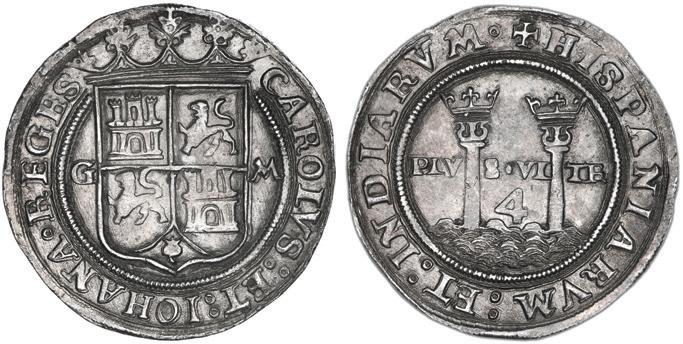


331. Mexico City, Mexico, 4 reales, Charles-Joanna, “Late Series,” assayer A to right, mintmark M to left (M-A), NGC XF details / tooled. Nesmith-58; Cal-131; S-M6; KM-18. 12.97 grams. An early purchase by Hubbard, the accompanying envelope bearing a handwritten note (perhaps by Nesmith) that only one example had been seen by him, which is understandable given that the shipwreck which contained many coins from this assayer, the “Golden Fleece wreck,” would not be discovered until almost thirty years later. The tooling is nothing more than multiple light old scratches, the coin itself lightly struck on a full flan with legends and interiors apparent. Pedigreed to the Clyde Hubbard Collection of Mexican Charles-Joanna Coinage (stated on label). Accompanied by original tag or holder. NGC #6478181-034. Estimate: $400-$600.
329. Mexico City, Mexico, 4 reales, Charles-Joanna, “Late Series,” assayer G to left, mintmark M to right (G-M), motto as PLV-SoVL-TR, NGC AU 55. Nesmith-46c type; Cal-128; S-M5; KM-18. 13.63 grams. Gunmetal gray-toned, struck on an oversized flan, beautifully centered with full legends and details, unusual ending of banner between pillars showing TR instead of TRA, probably from the “Golden Fleece wreck” (ca. 1550). Pedigreed to the Clyde Hubbard Col lection of Mexican Charles-Joanna Coinage (stated on label). Accompanied by original tag or holder. NGC #6478181-003. Estimate: $700-$1,000.
332. Mexico City, Mexico, 4 reales, Charles-Joanna, “Late Series,” assayer S to left, mintmark M to right (S-M), very rare. Nesmith-unl; Cal-130; S-M8; KM-18. 13.27 grams. Unlisted in Nesmith, understandable since most examples are sea salvage (from shipwrecks dis covered after Nesmith published his work), which this one is not, Hubbard’s note on the accompanying envelope stating that it is unique (and at the time of his purchase it most certainly was). Sea salvage or not, any of the assayer-S 4 reales are very rare and keys to any Charles-Joanna collections. NGC did not grade it because of plated surfaces, nevertheless this is a lovely specimen, rather shiny with virtually full legends and interiors, some scratches on the shield side. Pedigreed to the Clyde Hubbard Collection of Mexican Charles-Joanna Coinage. Accompanied by original tag or holder. Estimate: $3,500-$5,000.

333. Mexico City, Mexico, 4 reales, Charles-Joanna, “Late Series,” assayer L to right, mintmark M to left (M-L), NGC MS 62. Nesmith-86; Cal-135; M-9; KM-18. 13.52 grams. Tied with six others for finest in the NGC census, this deeply toned gem boasts well-struck legends and interiors on a full flan, devoid of corrosion despite its probably being from the “Golden Fleece wreck” (ca.1550). Pedigreed to the Clyde Hubbard Collection of Mexican Charles-Joanna Coinage (stated on label). Accompanied by original tag or holder. NGC #6478237-001. Estimate: $1,250-$2,000.
334. Mexico City, Mexico, 4 reales, Charles-Joanna, “Late Series,” assayer L to left, mintmark oM to right (L-oM), rare, NGC AU 53, ex-Rumbel. Nesmith94a type; Cal-136; S-M9; KM-18. 13.63 grams. A very decent example for this assayer, with full legends and interiors struck on a full flan, eye-appealing toning, slight doubling to right on pillars side. Pedigreed to the Clyde Hubbard Collection of Mexican Charles-Joanna Coinage (stated on label) and to the Henry Christensen Auction of October 1959 of the O.K. Rumbel collection, lot 453. Accompanied by original tag or holder. NGC #6478237-003. Estimate: $800-$1,200.
335. Mexico City, Mexico, 4 reales, Charles-Joanna, “Late Series,” assayer L to right, mintmark oM to left (oM-L), NGC VF 35, ex-Rumbel. Nesmith-90; Cal-135; S-M9; KM-18. 12.97 grams. Perhaps one of the coins that Nesmith enumerated in his book because it was part of the O.K. Rumbel collection (which Nesmith relied upon extensively for his research) before Hubbard purchased it at auction later, this example a bit worn and scratched but with virtually full legends and interiors under deep toning. Pedigreed to the Clyde Hubbard Collection of Mexican Charles-Joanna Coinage (stated on label) and to the Henry Christensen Auction of October 1959 of the O.K. Rumbel collection, lot 452. NGC #6478237-002. Estimate: $600-$900.
336. Mexico City, Mexico, 2 reales, Charles-Joanna, “Late Series,” assayer G to right, mintmark M to left (M-G), king’s name as CHAROLVS, spelling error HISPANIARVN in legend, NGC VF details / cleaned. Nesmith-49a type; Cal-93; S-M5; KM-12. 6.04 grams. Unusual spelling error (and unlisted in Nesmith) of HISPANIARVN on the pillars legend, not mentioned on NGC label, and the first we have seen. The coin shows signs of wear, with deep red sedimentation in shield-side crevices, a few scratches on the pillars side but all legends and inner details visible, especially the all-important error. Pedigreed to the Clyde Hubbard Collection of Mexican Charles-Joanna Coinage (stated on label). Accompanied by original tag or holder. NGC #6478181-014. Estimate: $300-$450.


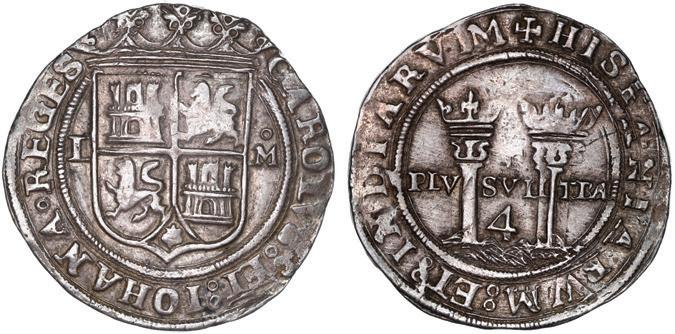

337. Mexico City, Mexico, 2 reales, Charles-Joanna, “Late Series,” assayer G to left, mintmark oM to right (G-oM), rare, NGC AU 55. Nesmith-41 type; Cal-94; S-M5; KM-12. 6.82 grams. With an unusual pillars-side legend ending (unlisted in Nesmith and only the second we have seen, the other being lot 437 in our Auction 31, also from the Hubbard collection), this example was struck on a broad flan with light toning all over, full legends and details, from a rarer variety in general (G-oM), tied with two others for finest in the NGC census. Pedigreed to the Clyde Hubbard Collection of Mexican Charles-Joanna Coinage (stated on label). Accompanied by original tag or holder. NGC #6478181-009. Estimate: $600-$900.
338. Mexico City, Mexico, 2 reales, Charles-Joanna, “Late Series,” assayer G to left, mintmark oM to right (G-oM), rare, NGC XF 45. Nesmith-41a; Cal-94; S-M5; KM-12. 6.80 grams. Nicely struck on a full flan, this well-executed example has great contrast with full legends and interior details, from a lower-population variety (G-oM). Pedigreed to the Clyde Hubbard Collection of Mexican Charles-Joanna Coinage (stated on label). Accompanied by original tag or holder. NGC #6478181-010. Estimate: $400-$600.
339. Mexico City, Mexico, 2 reales, Charles-Joanna, “Late Series,” assayer G to right, mintmark M to left (M-G), NGC MS 61. Nesmith-49e; Cal-93; S-M5; KM-12. 6.73 grams. Tied with one other for second-finest known in the NGC census, brightly toned with full legends and interiors on a full flan, slight doubling, surely an upgrade for many collec tors. Pedigreed to the Clyde Hubbard Collection of Mexican Charles-Joanna Coinage (stated on label). Accompanied by original tag or holder. NGC #6478181-015. Estimate: $700-$1,000.

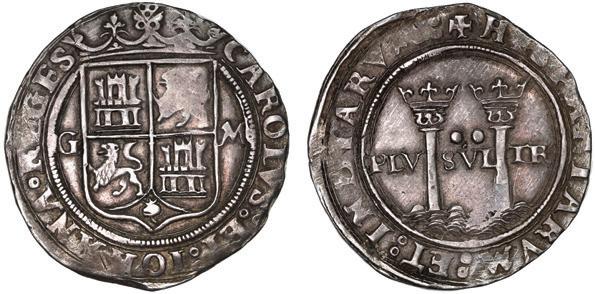



340. Mexico City, Mexico, 2 reales, Charles-Joanna, “Late Series,” assayer inverted G (very rare) to right, mintmark M to left (M-inverted G), rare, NGC VF details / environmental damage. Nesmith-unl; Cal-unl; S-M5; KM-12 for type. 6.63 grams. Unknown to Nesmith, this special error of an inverted G is rare, thus acquiring it in any condition is a prize. While some details are a bit fuzzy (probably due to land burial), the inverted G is clear, with scratches on both sides, some corrosion in legends and one edgesplit. Pedigreed to the Clyde Hubbard Collection of Mexican Charles-Joanna Coinage (stated on label). Accompanied by original tag or holder. NGC #6478181-013. Estimate: $300-$450.

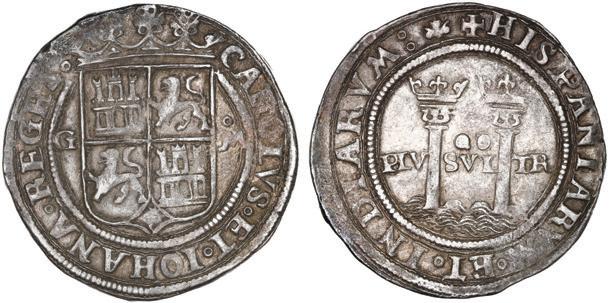
341. Mexico City, Mexico, 2 reales, Charles-Joanna, “Late Series,” assayer G to left, mintmark M to right (G-M), NGC AU 50. Nesmith-45b; Cal-94; S-M5; KM-12. 6.77 grams. Perhaps one of the coins that Nesmith used for study, originally from the O.K. Rumbel collection and purchased later at auction by Hubbard, with beautiful rainbow toning over a slightly off-center strike but readable legends and clear interior details. Pedigreed to the Clyde Hubbard Collection of Mexican Charles-Joanna Coinage (stated on label) and to the Henry Christensen Auction of October 1959 of the O.K. Rumbel collection, lot 467. Accompanied by original tag or holder. NGC #6478181-012. Estimate: $400-$600.
342. Mexico City, Mexico, 2 reales, Charles-Joanna, “Late Series,” assayer G to right, mintmark M to left (M-G), NGC AU 50. Nesmith-49e; Cal-93; S-M5; KM-12. 6.65 grams. Especially eye-appealing with lots of contrast and struck on a full flan, clear legends and inner details. Pedigreed to the Clyde Hubbard Collection of Mexican Charles-Joanna Coin age (stated on label) and to the Superior Auction of February 1984, lot 2411. Accompanied by original tag or holder. NGC #6478181-016. Estimate: $300-$450.
343. Mexico City, Mexico, 2 reales, Charles-Joanna, “Late Series,” assayer R to right, mintmark M to left (M-R), NGC AU details / cleaned. Nesmith-69 type; Cal-99; S-M7; KM-12. 6.84 grams. While Nesmith thought assayer-R coins were very rare and cataloged very few of them, we know they are not, at least in the 4 reales denomination (thanks to several salvaged shipwrecks), but minors are still not plentiful, especially M-R as we see here, in overall good condition despite some softly struck and worn legends and encrustation in crevices here and there, a spot of staining at one o’clock in the shield-side legend. Pedigreed to the Clyde Hubbard Collection of Mexican Charles-Joanna Coinage (stated on label). Accompanied by original tag or holder. NGC #6478181-032. Estimate: $300-$450.
344. Mexico City, Mexico, 2 reales, Charles-Joanna, “Late Series,” assayer A to right, mintmark M to left (M-A), NGC AU 55, ex-Rumbel. Nesmith-57b type; Cal-97; S-M6; KM-12. 6.70 grams. A very eye-appealing coin with full legends and details, lovely toning all over. Pedigreed to the Clyde Hubbard Collection of Mexican Charles-Joanna Coinage (stated on label) and to the Henry Christensen Auction of October 1959 of the O.K. Rumbel collection, lot 473. Accompanied by original tag or holder. NGC #6478181-035. Estimate: $400-$600.
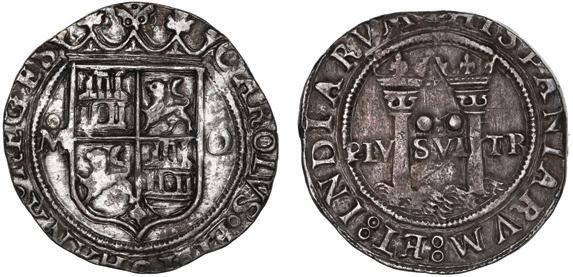
345. Mexico City, Mexico, 2 reales, Charles-Joanna, “Late Series,” assayer S to right, mintmark oM to left (oM-S), rare, NGC AU 53. Nesmith-77 type; Cal-95; S-M8; KM-12. 6.79 grams. Tied with one other for second finest in the NGC census behind a single AU 58, this de nomination/assayer combination was only seen once by Nesmith. While more have come to light in the intervening years, it is an important coin for the serious collector, a bit more obtainable than M-S or S-M, with virtually full legends (struck slightly off-center) and full interiors. Pedigreed to the Clyde Hubbard Collection of Mexican Charles-Joanna Coinage (stated on label). Accompanied by original tag or holder. NGC #6478181-044. Estimate: $1,000-up.
346. Mexico City, Mexico, 2 reales, Charles-Joanna, “Late Series,” assayer L to left, mintmark oM to right (L-oM), NGC AU 58. Nesmith-93 type; Cal-102; S-M9; KM-12. 6.82 grams. Second finest in the NGC census and an interesting example with a rosy patina all over, virtu ally full legends (struck slightly off-center) and full interiors, showing a curious run-together of letters at the end of the pillars-side legend. Pedigreed to the Clyde Hubbard Collection of Mexican Charles-Joanna Coinage (stated on label). Accompanied by original tag or holder. NGC #6478237008. Estimate: $500-$750.
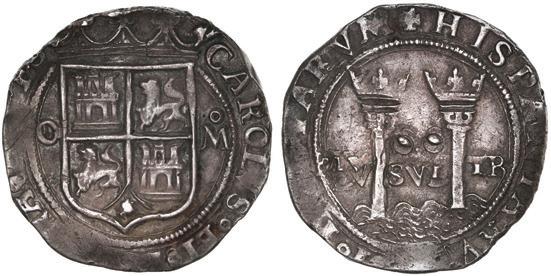




347. Mexico City, Mexico, 2 reales, Charles-Joanna, “Late Series,” assayer L to right, mintmark oM to left (oM-L), spelling error IHANA in legend (very rare), NGC AU 50. Nesmith-89c type; Cal-101; S-M9; KM-12. 6.80 grams. First time we have seen this spelling error of IHANA in the shield-side legend, and unlisted in Nesmith although not a rare type if the queen’s name were spelled correctly, with light sedimentation in crevices and virtually full legends and interior details. Pedigreed to the Clyde Hubbard Collection of Mexican Charles-Joanna Coinage (stated on label). Accompanied by original tag or holder. NGC #6478237-007. Estimate: $300-$450.
348. Mexico City, Mexico, 2 reales, Charles-Joanna, “Late Series,” assayer L/O to right, mintmark oM to left (oM-L/O), very rare, NGC AU 55. Nesmith-89b type; Cal-unlisted; S-M9; KM-unlisted. 6.77 grams. Nesmith listed only two coins seen of this rare over-assayer variety and this is the first we have seen, also second finest in the NGC census to boot. A solid grade for a coin struck on a smallish planchet, all details readable, important as showing alternations between L and O as assayers of the mint. Pedigreed to the Clyde Hubbard Collection of Mexican Charles-Joanna Coinage (stated on label). Accompanied by original tag or holder. NGC #6478237006. Estimate: $500-$750.
349. Mexico City, Mexico, 2 reales, Charles-Joanna, “Late Series,” assayer O/L to left, mintmark oM to right (O/L-oM), very rare, NGC AU details / bent. Nesmith-105a; Cal-unlisted; S-M10; KM-12. 6.77 grams. Nesmith listed only one example seen but this the third one we have catalogued (see lot 1454 in this auction for another), it is obviously a hard over-assayer to find and, as with the previous lot, important as showing alternations between L and O as assayers of the mint. Pedigreed to the Clyde Hubbard Collection of Mexican Charles-Joanna Coinage (stated on label). Accompanied by original tag or holder. NGC #6478237-022. Estimate: $300-$450.
350. Mexico City, Mexico, 2 reales, Charles-Joanna, “Late Series,” assayer O/L to right, mintmark oM to left (oM-O/L), rare, NGC AU details / tooled. Nesmith-110a type; Cal-unl; S-M10; KM-unl. 6.75 grams. Nesmith listed only two examples seen and this variety is slightly different from those, but rare nonetheless and important as showing alternations between L and O as assayers of the mint. A well-struck example with especially fine details on the pillars side, all legends and details visible. Pedigreed to the Clyde Hubbard Collection of Mexican Charles-Joanna Coinage (stated on label). Accompanied by original tag or holder. NGC #6478237-025. Estimate: $300-$450.

351. Mexico City, Mexico, 2 reales, Charles-Joanna, “Late Series,” assayer O to left, mintmark oM to right (O-oM), rare, NGC MS 62, finest known in the NGC census. Nesmith-105; Cal-104; S-M10; KM-12. 6.51 grams. Rare stellar grade for this assayer, with full legends and interior details, a pleasant gold patina overall, slight unevenness to the flan in the upper left quadrant of the shield side. Pedigreed to the Clyde Hubbard Collection of Mexican Charles-Joanna Coinage (stated on label). Accompanied by original tag or holder. NGC #6478237024. Estimate: $500-$750.
352. Mexico City, Mexico, 2 reales, Charles-Joanna, “Late Series,” assayer O to right, mintmark M to left (M-O), rare, NGC AU 55, finest known in the NGC census, ex-Rumbel. Nesmith-101; Cal-103; S-M10; KM-12. 6.80 grams. Possibly one of the three examples mentioned in Nesmith as it was part of the O.K. Rumbel collection before Hubbard purchased it at auction, also the finest at NGC despite some softness of strike and loss of legend due to off-center strike. Pedigreed to the Clyde Hubbard Collection of Mexican Charles-Joanna Coinage (stated on label) and to the Henry Christensen Auction of October 1959 of the O.K. Rumbel collec tion, lot 490. Accompanied by original tag or holder. NGC #6478237-021. Estimate: $400-$600.
353. Mexico City, Mexico, 1 real, Charles-Joanna, “Late Series,” assayer oGo to right, mintmark oMo to left (oMo-oGo), king’s name as CHAROLVS, rare, NGC


VF 25. Nesmith-32; Cal-65; S-M5; KM-9. 3.22 grams. A nice little coin (of which Nesmith had seen four copies) and important as among the earliest emissions from assayer G in the Late Series. Very few varieties exist in any denomination and none of the dies were re-used when the spell ing of the king’s name went from CHAROLVS to CAROLVS. This example has some softness in the legends but the details are clear. Pedigreed to the Clyde Hubbard Collection of Mexican Charles-Joanna Coinage (stated on label). Accompanied by original tag or holder. NGC #6478181019. Estimate: $500-$750.




354. Mexico City, Mexico, 1 real, Charles-Joanna, “Late Series,” assayer oG to right, mintmark oM to left (oM-oG), king’s name as CHAROLVS, rare, NGC XF 40, ex-Rumbel. Nesmith-36; Cal-65; S-M5; KM-9. 3.38 grams. Another early emission from assayer G’s tenure. Only 1R are known with oM-oG, all of them with king’s name spelled as CHA ROLVS, and Nesmith noted seeing thirteen of them. This example was struck on a full planchet and exhibits lovely patina with full legends and interior details, currently tied with three others for finest in the NGC census (including the next lot). Pedigreed to the Clyde Hubbard Collec tion of Mexican Charles-Joanna Coinage (stated on label) and to the Henry Christensen Auction of October 1959 of the O.K. Rumbel collection, lot 496. Accompanied by original tag or holder. NGC #6478181-020. Estimate: $500-$750.
355. Mexico City, Mexico, 1 real, Charles-Joanna, “Late Series,” assayer oG to right, mintmark oM to left (oM-oG), king’s name as CHAROLVS, rare, NGC XF 40. Nesmith-36a; Cal-65; S-M5; KM-9. 3.43 grams. A slightly different type of oM-oG coin with the banner between the pillars reading PLV-SVL-TR (instead of the usual PL-VS-VL), this was a variety known to Nesmith who noted having seen two of them. Nicely struck with clear legends, slightly off-center but nonetheless important as an early emission from assayer G in the Late Series period, currently tied with three others for finest in the NGC census (including the pre vious lot). Pedigreed to the Clyde Hubbard Collection of Mexican Charles-Joanna Coinage (stated on label). Accompanied by original tag or holder. NGC #6478181-021. Estimate: $500-$750.
356. Mexico City, Mexico, 1 real, Charles-Joanna, “Late Series,” assayer G to right, mintmark oM to left (oM-G), king’s name as CHAROLVS, motto as PL-VS-VL, rare, NGC XF 40. Nesmith-52 type; Cal-65; S-M5; KM-9. 3.34 grams. Tied with three others for finest in the current NGC census (including the next lot), a nicely struck, well-toned gem with virtually full legends and interior details. Pedigreed to the Clyde Hubbard Collection of Mexican Charles-Joanna Coinage (stated on label). Accompanied by original tag or holder. NGC #6478181028. Estimate: $400-$600.
357. Mexico City, Mexico, 1 real, Charles-Joanna, “Late Series,” assayer G to right, mintmark oM to left (oM-G), king’s name as CHAROLVS, motto as PL-VS:-VL, rare, NGC XF 40. Nesmith-52b; Cal-65; S-M5; KM-9. 3.32 grams. Tied with three others for finest in the NGC census (including the previous lot), this coin variety has a banner oddity of PL-VS:-VL. which was unknown to Nesmith. A well-struck and well-toned piece with virtually full legends and interiors. Pedigreed to the Clyde Hubbard Collection of Mexican Charles-Joanna Coinage (stated on label). Accompanied by original tag or holder. NGC #6478181-029. Estimate: $400-$600.


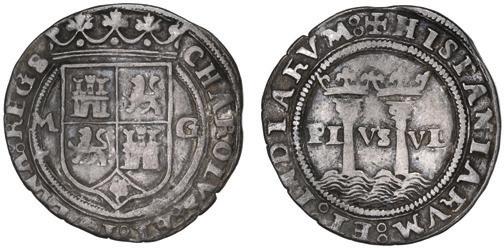
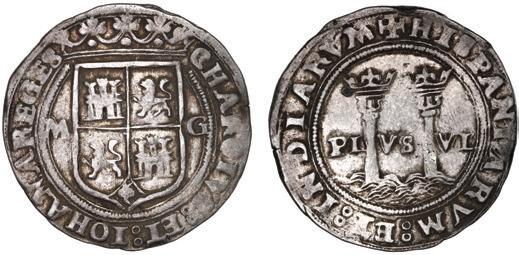

358. Mexico City, Mexico, 1 real, Charles-Joanna, “Late Series,” assayer G to right, mintmark M to left (M-G), king’s name as CHAROLVS, NGC XF 40. Nesmith-48; Cal-65; S-M5; KM-9. 3.41 grams. Nicely centered and round, with full legends and interior details, dark background providing good contrast and clarity. Pedigreed to the Clyde Hubbard Collection of Mexican Charles-Joanna Coinage (stated on label). Accompanied by original tag or holder. NGC #6478181-024. Estimate: $200-$300.

359. Mexico City, Mexico, 1 real, Charles-Joanna, “Late Series,” assayer G to right, mintmark M to left (M-G), king’s name as CHAROLVS, NGC VF 30. Nesmith-48a; Cal65; S-M5; KM-9. 3.28 grams. Hubbard’s note on the accompanying envelope indicates he purchased the coin in 1950, before Nesmith published his book. Even more importantly, Nesmith listed only one example seen, and it’s clear he meant this coin as he wrote that on the envelope! An eye-appealing coin with all details visible, its value also historical. Pedigreed to the Clyde Hubbard Collection of Mexican Charles-Joanna Coinage (stated on label). Accompanied by original tag or holder. NGC #6478181-025. Estimate: $300-$450.
360. Mexico City, Mexico, 1 real, Charles-Joanna, “Late Series,” assayer G to left, mintmark M to right (G-M), king’s name as CHAROLVS, NGC AU 50. Nesmith-44; Cal-66; S-M5; KM-9. 3.38 grams. Slightly soft strike, but with clear legends and details on a full flan, with some old scratches on the pillars side, small gouge above the right pillar, some corrosion on the shield side. Pedigreed to the Clyde Hubbard Collection of Mexican Charles-Joanna Coinage (stated on label). Accompanied by original tag or holder. NGC #6478181-022. Estimate: $300-$450.
361. Mexico City, Mexico, 1 real, Charles-Joanna, “Late Series,” assayer G to left, mintmark M to right (G-M), spelling error HISPNIARVM in legend (rare), NGC AU details / environmental damage. Nesmith-44f type; Cal-66; S-M5; KM-9. 3.25 grams While there is no visible G to the left of the shield, in our opinion it is from a poor die-punch, not struck without the G intentionally (notice that the GE in REGES is also missing). While “M-no assayer” is known (see next lot), this one is a shield-side die-match to lot 457 from our Auction 31 in which the G is visible. The coin is also an anomaly on the pillars side where HISPNIARVM appears as a spelling error. Overall a decent example with some corrosion and virtually full legends showing the error clearly. Pedigreed to the Clyde Hubbard Collection of Mexican Charles-Joanna Coinage (stated on label). Accompanied by original tag or holder. NGC #6478181-023. Estimate: $500-$750.
362. Mexico City, Mexico, 1 real, Charles-Joanna, “Late Series,” no assayer (G) to right, mintmark M to left (M-), motto as PL-VS-L, very rare, NGC VF 30. Nesmith-unl; Cal-unl; S-M5; KM-unl. 3.32 grams This gem is important in many ways. First it is tied with one other for finest in the NGC census. Second, there is an unusual spelling error of the motto across the pillars as PL-VS-L (instead of the usual PL-VS-VL). Last but certainly not least, the assayer-mark G to the right of the shield is missing. The die is consistent with Nesmith’s 48, so we presume the coin comes from this assayer. We have seen two others (see lot 1456 for another, lesser-quality example). It is also curious that Nesmith did not catalog this example since he most likely saw it and handwrote cursive notes on the ac companying. Regardless, there is a lot to like here. Pedigreed to the Clyde Hubbard Collection of Mexican Charles-Joanna Coinage (stated on label). Accompanied by original tag or holder. NGC #6478181-027. Estimate: $1,250-$2,000.
363. Mexico City, Mexico, 1 real, Charles-Joanna, “Late Series,” assayer R to right, mintmark M to left (M-R), NGC AU 50. Nesmith-68 type; Cal-70; S-M7; KM-9. 3.42 grams. While Nesmith thought assayer-R coins were very rare and cataloged few of them, we know they are not, at least in the 4 reales denomination (thanks to several salvaged shipwrecks), but minors are still not plentiful, especially M-R as we see here, which is also the third highest grade in the NGC census. A nice example with full legends and interior details, some small metal-loss on the edge. Pedigreed to the Clyde Hubbard Collection of Mexican Charles-Joanna Coinage (stated on label). Accompanied by original tag or holder. NGC #6478181-033. Estimate: $300-$450.
364. Mexico City, Mexico, 1 real, Charles-Joanna, “Late Series,” assayer A to right, mintmark oM to left (oM-A), rare, NGC AU 55. Nesmith-64; Cal-68; S-M6; KM-9. 3.38 grams. Second finest in the NGC census behind the MS 63 that was lot 465 in our Auction 31 (also from the Clyde Hubbard Collection), this variety from assayer A (oM-A) is not as rare as A-M but still much rarer than M-A. There is some double striking which caused the R in HISPANIARVM to disappear and made for a sloppy motto between the pillars, but all legends and inner details are vis ible. Pedigreed to the Clyde Hubbard Collection of Mexican Charles-Joanna Coinage (stated on label). Accompanied by original tag or holder. NGC #6478181-038. Estimate: $500-$750.
365. Mexico City, Mexico, 1 real, Charles-Joanna, “Late Series,” assayer A to left, mintmark M to right (A-M), top of shield curved, very rare, NGC AU 55, finest known in the NGC census. Nesmith-60; Cal-69; S-M9; KM-9. 3.29 grams. Second finest in the NGC census for good reason: While M-A is plentiful, A-M is not and was unknown to Nesmith although he gave it a number. This is the fifth example we have seen and it is well centered with full legends despite some corrosion on the edges, an important coin for the advanced collector. Pedigreed to the Clyde Hubbard Collection of Mexican Charles-Joanna Coinage (stated on label). Accompanied by original tag or holder. NGC #6478181-037. Estimate: $700-$1,000.
366. Mexico City, Mexico, 1 real, Charles-Joanna, “Late Series,” assayer A to right, mintmark M to left (M-A), top of shield curved, NGC AU 53. Nesmith-56; Cal-68; S-M9; KM-9. 3.33 grams. Clearly the most abundant variety of 1R from assayer A, this pretty little example is well centered with complete legends and interiors, some slight doubling on the pillars side. Pedigreed to the Clyde Hubbard Collection of Mexican Charles-Joanna Coinage (stated on label). Accompanied by original tag or holder. NGC #6478181-036. Estimate: $400-$600.





367. Mexico City, Mexico, 1 real, Charles-Joanna, “Late Series,” assayer S to right, mintmark M to left (M-S), very rare, NGC XF 45. Nesmith-76; Cal-67; S-M9; KM-9. 3.33 grams. A Charles-Joanna collection is not complete without coinage from assayer S, and this is a very competent example with virtually full legends and interiors against low-contrast toning. This is the only variety known to exist (no S-M or oM-S or S-oM). Interestingly, assayer-S coins were not found on the “Golden Fleece wreck.” Pedigreed to the Clyde Hubbard Collection of Mexican Charles-Joanna Coinage (stated on label). Accompanied by original tag or holder. NGC #6478181-045. Estimate: $1,000-up.
368. Mexico City, Mexico, 1 real, Charles-Joanna, “Late Series,” assayer L to right, mintmark M to left (M-L), NGC AU 58. Nesmith-84a; Cal-72; S-M9; KM-9. 3.41 grams. Eye-appealing specimen with low-contrast toning all over, virtually full legends (some doubling on the shield side), struck on a full flan. Pedigreed to the Clyde Hubbard Collection of Mexican Charles-Joanna Coinage (stated on label). Accompanied by original tag or holder. NGC #6478237-013. Estimate: $350-$500.

369. Mexico City, Mexico, 1 real, Charles-Joanna, “Late Series,” assayer L to right, mintmark M to left (M-L), NGC AU 50, ex-Rumbel. Nesmith-84c; Cal-72; S-M9; KM-9. 3.30 grams. A bold strike under dark toning, full legends and interiors, with a small gouge at the beginning of the pillars legend. Pedigreed to the Clyde Hubbard Collection of Mexican Charles-Joanna Coinage (stated on label) and to the Henry Christensen Auction of October 1959 of the O.K. Rumbel collection, lot 525. Accompanied by original tag or holder. NGC #6478237-015. Estimate: $300-$450.

370. Mexico City, Mexico, 1 real, Charles-Joanna, “Late Series,” assayer L to right, mintmark M to left (M-L), spelling error ISPANIARVM in legend, NGC VF 35. Nesmith-84c; Cal-72; S-M9; KM-9. 3.34 grams. Unusual misspelling of ISPANIARVM on the pillars legend (catalogued by Nesmith), purchased in 1952 so probably one of the coins included in Nesmith’s count. Some softness and sedimentation, but legends and interiors are visible. Pedigreed to the Clyde Hubbard Collection of Mexican Charles-Joanna Coinage (stated on label). Accompanied by original tag or holder. NGC #6478237-014. Estimate: $250-$375.
371. Mexico City, Mexico, 1 real, Charles-Joanna, “Late Series,” assayer L to left, mintmark M to right (L-M), missing cross at top of pillars-side legend (rare), NGC AU 58. Nesmith-80c type; Cal-72; S-M9; KM-9. 3.44 grams. An unlisted variety in Nesmith, this coin is missing the cross potent at the beginning of the pillars legend (first we have seen), overall a com petent example with highlights and full legends and interiors, some loss of metal resulting in the M mintmark being obscured. Pedigreed to the Clyde Hubbard Collection of Mexican Charles-Joanna Coinage (stated on label). Accompanied by original tag or holder. NGC #6478237-010. Estimate: $400-$600.
372. Mexico City, Mexico, 1 real, Charles-Joanna, “Late Series,” assayer L to left, mintmark M to right (L-M), no A’s in legend and missing cross at top of pillars-side legend (rare), NGC VF 35. Nesmith-80c type; Cal-72; S-M9; KM-9. 3.38 grams. Unlisted in Nesmith although Hubbard’s notes say he purchased it in 1952, this should be a notable coin. The letter A is missing in three places in the pillars-side legend but is visible in the shield-side legend. Instead of a missing cross potent as for the previous lot, an annulet takes its place. The coin shows signs of corrosion and double-striking but legends and interiors are readable. Pedigreed to the Clyde Hub bard Collection of Mexican Charles-Joanna Coinage (stated on label). Accompanied by original tag or holder. NGC #6478237-011. Estimate: $400-$600.
373. Mexico City, Mexico, 1 real, Charles-Joanna, “Late Series,” assayer L to left, mintmark M to right (L-M), motto as P-VS-V (rare), NGC XF details / environmental damage. Nesmith-80b type; Cal-73; S-M9; KM-9. 3.36 grams. While not an exceptional example due to corrosion and staining, what is clear is the unique misspelling of the motto between the pillars, missing the L punches after P and at end of motto. Pedigreed to the Clyde Hubbard Collection of Mexican Charles-Joanna Coinage (stated on label). Accompanied by original tag or holder. NGC #6478237-009. Estimate: $400-$600.



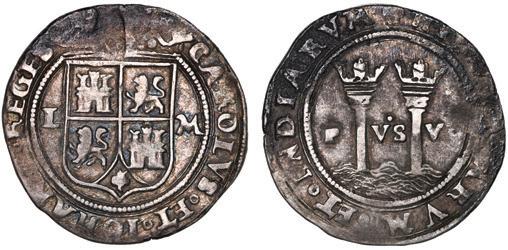

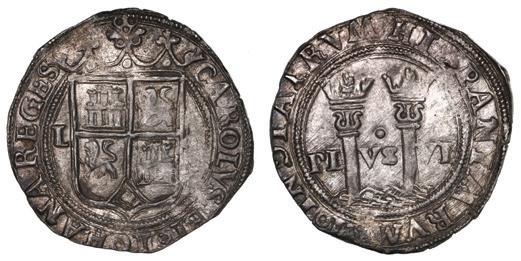

374. Mexico City, Mexico, 1 real, Charles-Joanna, “Late Series,” assayer L to right, mintmark oM to left (oM-L), NGC AU 55, ex-Rumbel. Nesmith-88f; Cal-73; S-M9; KM-9. 3.43 grams. Dark with rainbow overtones over partially lustrous surfaces, virtually full legends and in ner details. Pedigreed to the Clyde Hubbard Collection of Mexican Charles-Joanna Coinage (stated on label) and to the Henry Christensen Auction of October 1959 of the O.K. Rumbel collection, lot 532. Accompanied by original tag or holder. NGC #6478237-017. Estimate: $350-$500.
375. Mexico City, Mexico, 1 real, Charles-Joanna, “Late Series,” assayer L/O to right, mintmark oM to left (oM-L/O), rare, NGC AU 53. Nesmith-88b; Cal-73.1; S-M9; KM-9. 3.35 grams. A very respectable example of L/O, which is important for documenting the alterna tion of assayers L and O at the mint, this coin exhibiting lovely toning and virtually full legends, albeit with a slightly off-center strike on the pillars side. Pedigreed to the Clyde Hubbard Collection of Mexican Charles-Joanna Coinage (stated on label). Accompanied by original tag or holder. NGC #6478237-016. Estimate: $350-$500.
376. Mexico City, Mexico, 1 real, Charles-Joanna, “Late Series,” assayer L/O to left, mintmark M to right (L/O-M), rare, NGC VF 30. Nesmith-80e type; Cal-unlisted; S-M9; KM-unlisted. 3.23 grams. Nesmith listed three copies seen of this over-assayer variety and this is slightly different from the ones he cataloged. Regardless, it is rare and important in documenting the alternation of assayers L and O at the mint and a decent example with lots of contrast and almost full legends. Pedigreed to the Clyde Hubbard Collection of Mexican Charles-Joanna Coinage (stated on label). Ac companied by original tag or holder. NGC #6478237-012. Estimate: $250-$375.
377. Mexico City, Mexico, 1 real, Charles-Joanna, “Late Series,” assayer O to left, mintmark M to right (O-M), rare, NGC VF 30, ex-Rumbel. Nesmith-96a type; Cal-75; S-M10; KM-9. 3.29 grams. Incorrectly labeled by NGC as O-oM, this variety was seen only once by Nesmith. Darkly toned with full legends and interiors, the pillars side slightly off-center. Pedigreed to the Clyde Hubbard Collection of Mexican Charles-Joanna Coinage (stated on label) and to the Henry Christensen Auction of October 1959 of the O.K. Rumbel collection, lot 538. Accompanied by original tag or holder. NGC #6478237-026. Estimate: $300-$450.
378. Mexico City, Mexico, 1 real, Charles-Joanna, “Late Series,” assayer O to left, mintmark oM to right (O-oM), P over inverted P in HISPANIARVM (rare), NGC AU 58, finest known in the NGC census. Nesmith-104; Cal-75; S-M10; KM-9. 3.40 grams. Only one example seen by Nesmith of this particular variety. While variations of this variety are not rare, this one has a curious error of the letter P punched over an upside-down P in HISPANIARVM, with lovely iridescent toning and full legends and inner details. Pedigreed to the Clyde Hubbard Collec tion of Mexican Charles-Joanna Coinage (stated on label). Accompanied by original tag or holder. NGC #6478237-027. Estimate: $350-$500.

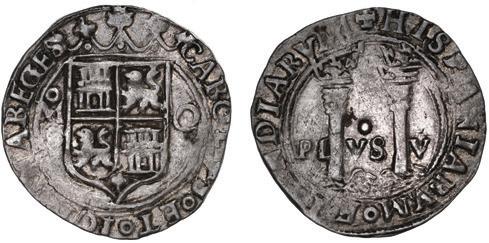
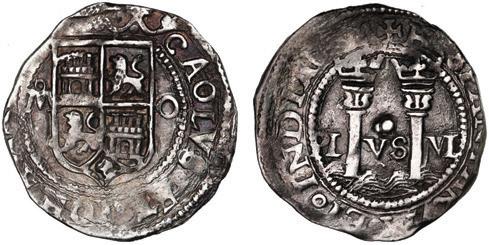
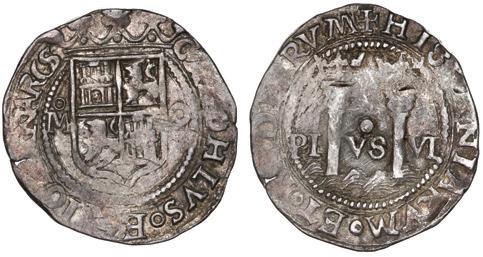
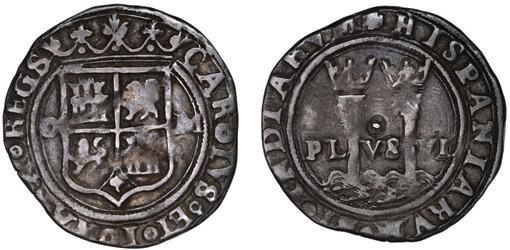
379. Mexico City, Mexico, 1 real, Charles-Joanna, “Late Series,” assayer O to right, mintmark oM to left (oM-O), king’s name as CAROHLVS (rare error), NGC VF 35. Nesmith-108d type; Cal-74; S-M10; KM-9. 3.40 grams. There are several types of errors in the spelling of CAROLVS on assayer-O coins, and Nesmith noted and even mentioned this one with CAROHLVS as the present example shows, although he spelled it CAROHLRVS (he was clearly talking about the same error as this coin). While Nesmith noted seeing only one, it is the second we have cataloged and would be a great addition for anyone wanting to collect errors. There are many soft spots and a lacuna of sorts at eight o’clock on the shield legend, but the legends are readable and the interior details visible. Pedigreed to the Clyde Hubbard Collection of Mexican Charles-Joanna Coinage (stated on label). Accompanied by original tag or holder. NGC #6478237-032. Estimate: $250-$375.
380. Mexico City, Mexico, 1 real, Charles-Joanna, “Late Series,” assayer O to right, mintmark oM to left (oM-O), king’s name as CAOLVS (rare error), NGC AU details / repaired. Nesmith-108d type; Cal-74; S-M10; KM-9. 3.41 grams. Another example of a misspelling of the king’s name, here as CAOLVS, this one noted by Nesmith. We have cataloged one other with this spelling error, the present example with an off-center strike, uneven toning, loss of legends, but the spelling error clearly visible. Pedigreed to the Clyde Hubbard Collection of Mexican Charles-Joanna Coin age (stated on label). Accompanied by original tag or holder. NGC #6478237-029. Estimate: $200-$300.
381. Mexico City, Mexico, 1 real, Charles-Joanna, “Late Series,” assayer O to right, mintmark oM to left (oM-O), spelling error HISPANIARV (rare), NGC AU 53. Nesmith108d type; Cal-74; S-M10; KM-9. 3.24 grams. An unusual spelling error with the M missing from HIS PANIARV, unlisted in Nesmith and the first we have seen. Legends are virtually full (one quadrant mostly smoothed over and unreadable), low toning, slightly doubled interiors. Pedigreed to the Clyde Hubbard Collection of Mexican Charles-Joanna Coinage (stated on label). Accompanied by original tag or holder. NGC #6478237-031. Estimate: $300-$450.
382. Mexico City, Mexico, 1 real, Charles-Joanna, “Late Series,” assayer O to right, mintmark oM to left (oM-O), motto PL-VS-V, reworked B-punch for R in CAROLVS and REGES (rare), NGC VF 35. Nesmith-108c type; Cal-74; S-M10; KM-9. 3.41 grams. There is an unusual appearance of the R in CAROLVS and REGES, a result of a reworked B punch (unlisted in Nesmith), also with the motto between the pillars as PL-VS-V (noted by Nesmith), the first we have seen, this example with almost full legends (the B/R clearly visible), nearly round and well centered. Pedigreed to the Clyde Hubbard Collection of Mexican Charles-Joanna Coinage (stated on label). Ac companied by original tag or holder. NGC #6478237-028. Estimate: $250-$375.
383. Mexico City, Mexico, 1 real, Charles-Joanna, “Late Series,” assayer O/oM to right, mintmark oM to left (oM-O/oM), reworked B-punch for R in HISPANIARVM and INDIARVM, very rare, NGC F 12. Nesmith-108c type; Cal-74; S-M10; KM-9. 3.25 grams. Unique assayer-over-mintmark O/oM to the right, not noted by NGC (and unlisted in Nesmith), this speci men also exhibiting the unusual appearance of the R punch as a reworked B punch in the pillars-side legend. The coin has a planchet crack at eleven o’clock on the shield side and was struck off-center such that some of the legends are not visible, but the interiors are complete and the over-assayer is apparent. Pedigreed to the Clyde Hubbard Collection of Mexican Charles-Joanna Coinage (stated on label). Accompanied by original tag or holder. NGC #6478237-030. Estimate: $200-$300.


384. Mexico City, Mexico, 1/2 real, Charles-Joanna, “Late Series,” assayer G to right, mintmark oM to left, motto P-LV-S, king’s name as CHAROLVS, NGC F 15. Nesmith-51; Cal-46; S-M5; KM-6.5. 1.47 grams. Second finest in the NGC census and the third example we have seen (Nesmith noted three examples seen in his book), with a handwritten note on the envelope by Nesmith in which he noted “2 others seen,” from the earlier period of assayer G with the king’s named spelled as CHAROLVS. Pedigreed to the Clyde Hubbard Collection of Mexican Charles-Joanna Coinage (stated on label). Accompanied by original tag or holder. NGC #6478181-031. Estimate: $300-$450.
385. Mexico City, Mexico, 1/2 real, Charles-Joanna, “Late Series,” assayer G to right, mint mark M to left, motto PL-V-S, rare, NGC F details / damaged, ex-Rumbel. Nesmith-31?; Cal-unl; S-M5; KM-unl. 1.48 grams. This oddity was in the O.K. Rumbel collection that was auctioned by Henry Christensen in 1959, after Nesmith had written both his book and an ANS monograph (#131) before that. A typewritten note on the paper envelope from that auction states that this coin was “unknown when ANS 131 was published” and if it was a Nesmith 31 as the catalog states (which Nesmith listed as unknown), it did not make it into the book either. Because of its very rough condition, it is impossible to say whether there are annulets above the mintmark and assayer but they do appear below. So, it may be an oMo-oGo variety (of which all known examples in other denominations came from the early period with the king’s name spelling as CHAROLVS) and it is difficult to discern the spelling of the king’s name. Other legend details don’t match any other varieties with the exception of the motto as PL-V-S rather than P-LV-S (more common than the other). Pedigreed to the Clyde Hubbard Collection of Mexican Charles-Joanna Coinage (stated on label) and to the Henry Christensen Auction of October 1959 of the O.K. Rumbel collection, lot 553. Accompanied by original tag or holder. NGC #6478181-030. Estimate: $200-$300.
386. Mexico City, Mexico, 1/2 real, Charles-Joanna, “Late Series,” assayer A to left, o to right, mintmark oMo below monogram, motto P-LV-S, flowers instead of crosses at top on both sides, very rare, NGC AU details / damaged. Nesmith-59a; Cal-49; S-M6; KM-6.5. 1.65 grams. A very rare variety, probably included in Nesmith’s count of only two seen (as the accompanying envelope has Nesmith’s handwriting on it), with visible legends and inner details but also a couple of areas of missing metal on the edges. It is the first we have seen with P-LV-S instead of the much more common PL-V-S. It seems that Nesmith did not note the flowers instead of crosses at the top on both sides, but we have seen this on all assayer-A coins of this denomination. Pedigreed to the Clyde Hubbard Collection of Mexican Charles-Joanna Coinage (stated on label). Accompanied by original tag or holder. NGC #6478181-040. Estimate: $500-$750. 387. Mexico City, Mexico, 1/2 real, Charles-Joanna, “Late Series,” assayer A to right, o to the left, mintmark oMo below monogram, motto PL-V-S, legend as HISPANIARVM.ET.INDIAR on both sides (very rare error), flowers instead of crosses at top on both sides, NGC VF 30. Nesmith-63; Cal-49; S-M6; KM-6.5. 1.63 grams. Very rare but known to Nesmith, this variety contains a mint error of the same legends of HISPANIARVMoEToINDIARVM on both sides of the coin, of which we have seen six including another one in this (lot 1457), the present example with full legends and interiors, a scratch across the right pillar. It seems that Nesmith did not note the flowers instead of crosses at the top on both sides, but we have seen this on all Assayer A coins of this denomination. Pedigreed to the Clyde Hubbard Collection of Mexican Charles-Joanna Coinage (stated on label). Accompanied by original tag or holder. NGC #6478181-041. Estimate: $500-$750.
388. Mexico City, Mexico, 1/2 real, Charles-Joanna, “Late Series,” assayer A to right, o to left, mintmark oMo below monogram, motto P-LV-S, legend as HISPANIARVM.ET.INDIAR on both sides (very rare error), flowers instead of crosses at top on both sides, NGC XF details / environmental damage. Nesmith-63a; Cal-49; S-M6; KM-6.5. 1.50 grams. As with the previous lot, this one has identical legends on each side, the only difference being the spelling of the motto between the pillars (P-LV-S instead of PL-V-S). Despite some metal loss on the edges, old scratches and corrosive spots on the pillars side, the legends and interiors are readable. It seems that Nesmith did not note the flowers instead of crosses at the top on both sides, but we have seen this on all assayer-A coins of this denomination. Pedigreed to the Clyde Hubbard Collection of Mexican Charles-Joanna Coinage (stated on label). Accompanied by original tag or holder. NGC #6478181-042. Estimate: $400-$600. 389. Mexico City, Mexico, 1/2 real, Charles-Joanna, “Late Series,” assayer L to right, o to left, mintmark oMo below monogram, motto PL-V-S, flowers instead of crosses at top on both sides (rare), NGC VF 30. Nesmith-87c; Cal-50; S-M9; KM-6.5. 1.53 grams. Second finest in the current NGC census behind a single XF 45, with full legends and details, this variety is like those from assayer A with flowers instead of crosses at the top of the legends on each side; unlike assayer-A coinage, however, that is not true of all 1/2R types from this assayer L. Pedigreed to the Clyde Hubbard Collection of Mexican Charles-Joanna Coinage (stated on label). Accompanied by original tag or holder. NGC #6478237-018. Estimate: $400-$600.






390. Mexico City, Mexico, 1/2 real, Charles-Joanna, “Late Series,” assayer L to left, mintmark M between K and I, o to right, motto P-LV-S, very rare, NGC F 15. Nesmith-79; Cal-50; S-M9; KM6.5. 1.49 grams. Rare mistake by Nesmith: His handwritten notes on the envelope accompanying this coin indicate he was looking at a new variety (91c) and had crossed out RN #79 which what he initially thought it was. It is indeed the 79 variety even though the legends are not completely legible. You can compare it to lot 488 in our Auction 31 (also from the Clyde Hubbard Collection) which is the 79 variety. Still rare and only the third we have catalogued. Pedigreed to the Clyde Hubbard Collection of Mexican Charles-Joanna Coinage (stated on label). Accompanied by original tag or holder. NGC #6478237-019. Estimate: $400-$600. 391. Mexico City, Mexico, 1/2 real, Charles-Joanna, “Late Series,” assayer O to left, no mintmark, o between monogram, motto oP-oL-oS, spelling error CAROLVSS in legend, rare, NGC XF 45, finest and only example in the NGC census. Nesmith-107m; Cal-unl; S-M10; KM-6.5. 1.58 grams. Nesmith listed three examples seen of this type, and many of the 1/2R from assayer O are char acterized by spelling errors and unusual mottos, this typifying both. It is a nice example with virtually full legends and interiors, the spelling error and motto clearly visible. Pedigreed to the Clyde Hubbard Collection of Mexican Charles-Joanna Coinage (stated on label). Accompanied by original tag or holder. NGC #6478237035. Estimate: $400-$600. 392. Mexico City, Mexico, 1/2 real, Charles-Joanna, “Late Series,” assayer O to right, oM to left, o between monogram, motto oP-oV-oS, very rare, NGC VF 30. Nesmith-107 for type; Cal-unlisted; S-M10; KM-6.5. 1.60 grams. An unlisted variety in Nesmith because of the motto as oP-oV-oS (first time we have seen this, although there are many spelling differences of the motto from this assayer), a decent strike with low toning, legends somewhat smudged but interiors clear. Pedigreed to the Clyde Hubbard Collection of Mexican Charles-Joanna Coinage (stated on label). Accompanied by original tag or holder. NGC #6478237034. Estimate: $400-$600.


393. Mexico City, Mexico, 1/2 real, Charles-Joanna, “Late Series,” assayer O to right, oM to left, o between monogram, motto P-LV-S, reworked B-punch for R in CAROLVS (rare), NGC XF 45, finest and only example in the NGC census. Nesmith-107; Cal-54; S-M10; KM-6.5. 1.65 grams. Mistakes abound with assayer-O coins, this one like 1R lot 382 in this auction in having an unusual appearance of the R in CAROLVS and RGS as a reworked B-punch. Nesmith did not make note of it, perhaps because many coins have partial or unreadable legends, but this is clear, the coin itself darkly toned and slightly out of round. Pedigreed to the Clyde Hubbard Collection of Mexican Charles-Joanna Coinage (stated on label). Accompanied by original tag or holder. NGC #6478237-033. Estimate: $350-$500.



394. Mexico City, Mexico, 4 reales, Charles-Joanna, “Early Series,” assayer F to right, mintmark M to left (oMo-oFo), left-leaning panel, very rare. Nesmith-16 type; Cal-120; S-M3; KM-unlisted. 11.99 grams. Struck on a broad flan with full AU details despite areas of moderate surface corrosion, clear assayer (rarest of the series), light toning here and there, less than a dozen known in all varieties. From an unidentified ca.-1554 wreck off Santo Domingo, Dominican Republic. Pedigreed to Sedwick Auction 24, with original lot-tag 662. Estimate: $3,000-$4,500.
395. Mexico City, Mexico, 1 real, Charles-Joanna, “Early Series,” assayer R (Gothic) at bottom between pillars, PLVSVL in rounded panel, very rare, ex-Eidel. Nesmith-3d/3e; Cal-60; S-M1; KM-7. 3.04 grams. VF with bold toning, edge-split, full details except for tops of some letters in legend, mostly Gothic lettering, the D in INDIARVM crafted from an I and O (as noted by Nesmith in his description of his 3e coin). Pedigreed to the Charles Eidel collection and to the Ponterio auction of May 1987 (lot 1121). Estimate: $1,000-$1,500.
396. Mexico City, Mexico, 1 real, Charles-Joanna, “Late Series,” assayer L to left, mintmark M to right (L-M), NGC MS 62, finest known in the NGC census. Nesmith80b; Cal-73; S-M9; KM-9. 3.38 grams Not rare but of exceptional quality, bright and shiny, with virtu ally complete legends and inner details, a beautiful example for this assayer. NGC #6281502-009. Estimate: $400-$600.
397. Mexico City, Mexico, cob 8 reales, Philip II, assayer F. S-M12; KM-43; Cal-664. 27.33 grams. Choice full shield and crown and cross with AU+ details, even somewhat lustrous, also with full oMF and denomination 8 and enough legend to recognize the king’s ordinal II and cinquefoil spacers, very lightly toned, with small areas of light pitting near edge. Estimate: $200-$300.
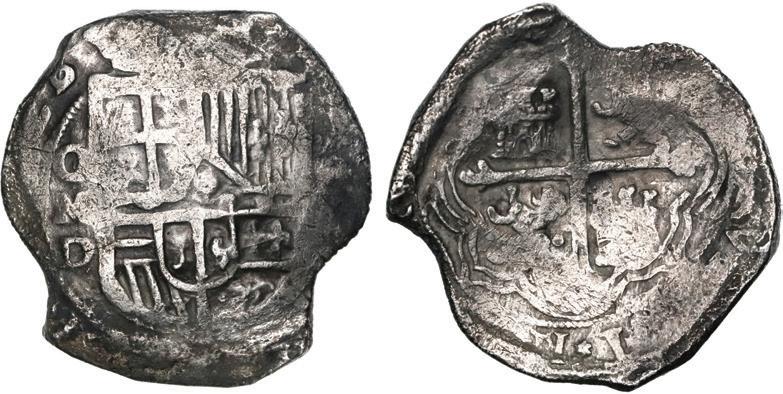





398. Mexico City, Mexico, cob 8 reales, Philip III, assayer oF, very rare. S-M13 (under Ph II); KM-43 (under Ph II); Cal-882. 26.36 grams. Unevenly thick flan with good full shield and cross and nearly full crown, toned VF, bottom of king’s ordinal III and fleur-de-lis spacers in legend, characteristic lions, clear oF assayer, touch of oxidation on part of edge. Estimate: $350-$500.
399. Mexico City, Mexico, cob 8 reales, 1628/7 D. S-M18a; KM-unl; Cal-1311. 25.15 grams. Typically barrel-shaped flan of varying thickness, good full shield and cross, full oMD and very clear bottom half of 28/7 of date, nicely toned AVF with slight traces of corrosion on edge. Estimate: $350-$500.
400. Mexico City, Mexico, cob 8 reales, 1646 P, rare. S-M19; KM-45; Cal-1339. 26.55 grams. Irregular flan of varying thickness, with particularly crude edge punctuated by blunted points, yet with clear full date (just the right side of the last digit weak) and oMP next to a full shield, nearly full cross, Fine with light toning and encrustation in crevices. Estimate: $500-$750.
403. Mexico City, Mexico, cob 8 reales, 1653 P, with chop marks as from circulation in Asia. S-M19; KM-45; Cal-1356. 27.26 grams. Very bold full date above oMP (bent and straightened there), good full cross and shield, Fine with nice toning, a few indistinct chops on reverse. Estimate: $200-$300.
401. Mexico City, Mexico, cob 8 reales, 1652 P, with chop marks as from circulation in Asia, ex-Bevill. S-M19; KM-45; Cal1354. 26.41 grams. Very bold full date and oMP, full cross but incomplete shield due to flatness (especially in the peripheries) from varying thick ness, nice VF+ overall, each side with clear single chopmark (same on both sides). Pedigreed to the James Bevill collection and to the Ponterio auction of March 1991 (lot 938). Estimate: $200-$300.


404. Mexico City, Mexico, cob 8 reales, Louis I, assayer not visible (D), very rare, ex-Vliegenthart (1735), ex-Katz. S-M23; KM-49. 15.52 grams. A crude survivor with heavy corrosion on entire cross side and much of the shield side as well, but with all-important LVD- of king’s name clearly visible outside the shield (one of very few known with clear evidence of the king’s name), lightly toned. From the Vliegenthart (1735) and pedigreed to the Estate of Wallace Katz. Estimate: $1,000-up.
402. Mexico City, Mexico, cob 8 reales, 1653 P, with chop mark as from circulation in Asia. S-M19; KM-45; Cal-1356. 27.08 grams. Odd-shaped flan of varying thickness, good full cross, full oMP and clear date (that side off-center), VF with light golden toning, in teresting tiny sunburst chopmark in periphery on reverse (looks like a too-small version of the common sun-over-mountains countermark of Guatemala). Estimate: $200-$300.
405. Mexico City, Mexico, cob 8 reales, Louis I, assayer not visible (D), very rare. S-M23; KM-49. 26.52 grams. Interesting shape with much flatness but some shield and cross visible (VG for wear), nice toning, clear trace of king’s ordinal I in legend (enough to see it is not a V), in fact one of just two confirmed with ordinal visible, perfect for die-study. Estimate: $500-up.




406. Mexico City, Mexico, cob 4 reales, Philip II, assayer O below denomina tion o-iiii to left, mintmark oM to right (rare). S-M11; KM-36; Cal-504. 13.73 grams. VF with choice full cross-lions-castles and shield, nearly full crown, full mintmark to right (rarely seen alone on that side) and full assayer below clear denomination to left, full (P)HILIPPVS II in legend with figure-8 spacers, lightly toned. Estimate: $200-$300.

407. Mexico City, Mexico, cob 4 reales, 1624/3/2 D, rare. S-M18a; KM-unl; Cal-unl. 13.37 grams. Roundish flan of varying thickness with resultant peripheral flatness except for the date, which is 100% full (just a bit messy on the multiple overdate), full oMD, nearly full cross (well centered), lightly toned AVF. Estimate: $200-$300.
408. Mexico City, Mexico, cob 4 reales, 1733 F. S-M26; KM-40a; Cal-1098. 13.30 grams. Thick and rectangular flan with full 733 of date (rare without overdate) and bold mintmark oM, nearly full cross, lightly toned VF with traces of black oxidation. Estimate: $200-$300.
409. Mexico City, Mexico, cob 1 real, Philip II, assayer O to right, mintmark M to left, NGC AU 55. S-M11; KM-unl; Cal-unl. 3.36 grams. Richly toned with choice full cross-lions-castles and well-detailed but double-struck full shield below full crown, bold king’s name in legend, clear assayer O to right but mintmark to left weak but decidedly without o above, second highest grade in NGC census (variety not specified). NGC #6476168-001. Estimate: $200-$300.
410. Mexico City, Mexico, cob 1 real, 1613 F, rare, ex-Concepción (1641). S-M17; KM-27.2; Cal-492. 2.71 grams. Choice full date and oMF, good full cross and nearly full shield, VF details but a bit thin from light corrosion, patchy dark toning. From the Concepción (1641). Estimate: $350-$500.



411. Mexico City, Mexico, cob 1 real Royal (galano), 1715 J, cross potent at top of reverse, very rare. S-M22; KM-unl; Cal-465. 3.10 grams. AU details with slightly porous surfaces but nice toning, cracks and marks from being partially bent and straightened, broad flan, particularly rare without hole. (See next lot for another example with different ornament above the cross.) Estimate: $1,250-$2,000.

412. Mexico City, Mexico, cob 1 real Royal (galano), 1715 J, quatrefoil at top of reverse, very rare. S-M22; KM-unl; Cal-465. 2.96

grams. Naturally toned AVF with full but partially faint legends (weak strike), full interior details, partial tiny hole at bottom next to a full hole. (See previous lot for another example with different ornament above the cross.) Estimate: $1,000-$1,500.

413. Mexico City, Mexico, klippe 8 reales, 1733 MF. S-M28; KM-48; Cal1431. 24.36 grams. Choice full interiors and crown plus most of legends including full date, richly toned XF with faint adjustment marks on high points, probably shaved or filed on edge as underweight. Estimate: $1,000-$1,500.
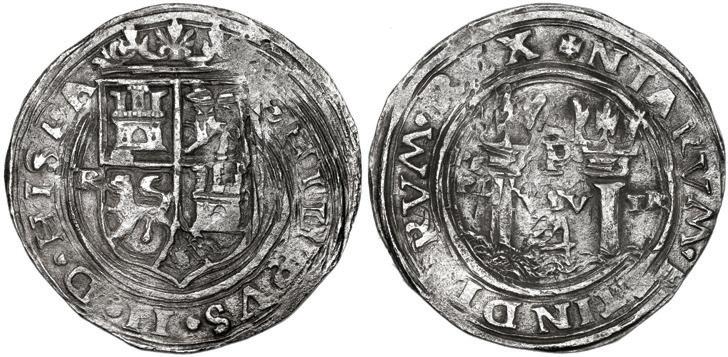
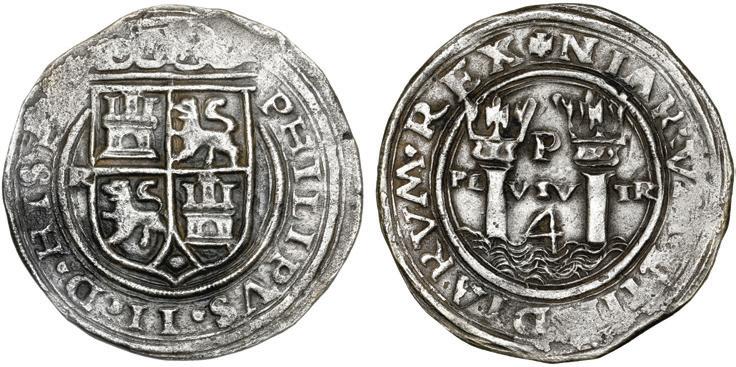
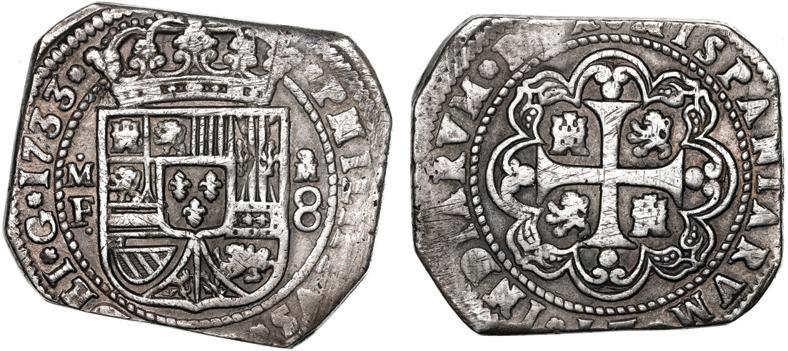
414. Lima, Peru, 4 reales, Philip II, assayer R (small) to left, motto PL-VSV-TR, legends HISPA / NIARVM S-L1; KM-10.1; Cal-495. 12.46 grams. Very broad flan with choice inner details, full and mostly bold legends, contrasting toning, practically no doubling, scarce variety with VSV without L between pillars, AU with very slight surface porosity. Estimate: $2,000-$3,000.
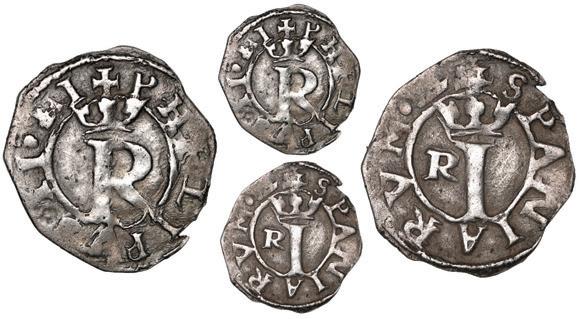
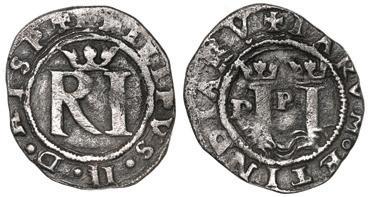

416. Lima, Peru, 1 real, Philip II, assayer R (Rincón) to left, motto P-LVS-V above dot, legends HISPA / NIARVM. S-L1; KM-6; Cal-209. 2.86 grams. Nice full inner details and legends (albeit slightly off-center), no doubling, attractively rich-toned AU with faint surface porosity. Estimate: $300-$450.
415. Lima, Peru, 4 reales, Philip II, assayer R (small) to left, motto PL-VSV-TR, legends HISPA / NIARVM. S-L1; KM-10.1; Cal-495. 11.91 grams. Broad round flan with full legends, bold full shieldlions-castles, full but weaker pillars-and-waves, some minor doubling, scarce variety with VSV without L between pillars, AU- with surface porosity, lightly toned in crevices. Estimate: $1,000-$1,500.
417. Lima, Peru, 1/2 real, Philip II, assayer R (Rincón) to left, legends HISP / IARVM. S-L1; KM-3; Cal-115. 1.27 grams. Full legends and inner full details on both sides, nicely toned XF with faint high-point abrasion and surface porosity. Estimate: $200-$300.
418. Lima, Peru, 1/4 real, Philip II, assayer R (Rincón) to left, legends HI / SPANIARVM. S-L1; KM-1; Cal-94. 0.80 gram. Broad flan that is fully intact and corrosion-free (especially rare thus), most of legends bold and full in addition to the centers, with very light toning all over, surely one of the finest extant. Estimate: $1,000-$1,500.
419. Lima, Peru, cob 8 reales, Philip II, assayer Diego de la Torre, *-8 (flat top) to left, P-oD to right, NGC AU 58. S-L4; KM-14; Cal-654. 27.22 grams. Richly toned and perfectly struck with full details including crown and legends, some traces of underlying luster, very scarce variety (Sellschopp 87, far rarer than round-top 8, and the first we have handled with flat-top 8 below star to left). With typewritten dealer tag from 1977 (Bill Webber). NGC #6478425-002. Estimate: $1,500-$2,250.
420. Lima, Peru, cob 2 reales, Philip II, assayer Diego de la Torre, *-ii to left, P-oD to right, NGC XF 40. S-L4; KM-9; Cal-338. Choice full shield and cross with most of legends (some surfaces crude, as made), bold P-oD to right and *-ii to left (the star being in six points with a dot inside a hollow center, rarely seen so clearly), lightly toned. NGC #3813301-014. Estimate: $200-$300.

421. Lima, Peru, cob 1/4 real, Philip II, assayer Diego de la Torre, P-* flanking castle. S-L4; KM-2; Cal-101. 0.74 gram. Superb full lion and castle (AU details) with bold P to left and * to right, most of PHILIPVS in legend, parts of both crowns, nicely toned but typically slightly porous, choice overall. Estimate: $400-$600.
422. Lima, Peru, cob 8 reales, 1684 V, NGC AU 53, finest known in NGC census. S-L6; KM-24; Cal-589. 27.28 grams. Thick flan with choice full cross-lions-castles, good pillars with 100% full waves, three full dates and mintmarks and assayers, lightly gold-toned over muted luster, the finest of just three in the NGC census for this scarce first date of Lima pillars-and-waves cobs. NGC #5856326-007. Estimate: $2,000-up.
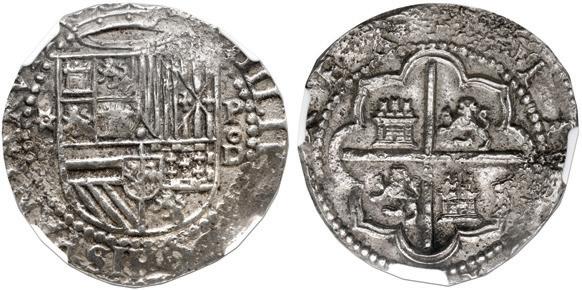
424. Lima, Peru, cob 8 reales, 1694 M, NGC AU 55 (“top pop”). S-L11; KM-24; Cal-599. 27.25 grams. Broad flan with 100% full pillars-and-waves, nearly full cross with bold king’s ordinal II in legend, all three dates and assayers, very lightly toned and lustrous, currently tied with three others for finest in NGC census. NGC #6454911-003.
Estimate: $500-$750.
423. Lima, Peru, cob 8 reales, 1687 R. S-L7; KM-24; Cal-592. 26.04 grams. Thin and flat peripheries around most of pillars, off-center cross, toned in crevices, VF+ for actual wear but with small areas of light corrosion as probably salvaged. Estimate: $200-$300.



425. Lima, Peru, cob 8 reales, 1700 H. S-L15; KM-24; Cal-607. 26.98 grams. Full but doubled cross and pillars, with two clear dates and mintmarks, AVF with contrasting encrustation in crevices (prob ably salvaged), peripheral flatness, hairline edge-split. Estimate: $200-$300.
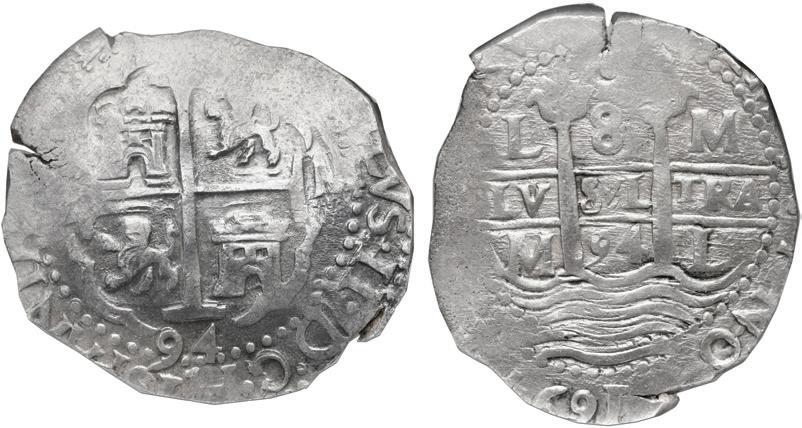

426. Lima, Peru, cob 8 reales, 1723 M. S-L20; KM-34; Cal-1297.
26.68 grams. Chunky flan with flat peripheries but clear date between nearly full pillars, most of cross, attractively toned Fine, parts of edge (and area near edge) slightly crude (as made). Estimate: $200-$300.
430. Lima, Peru, cob 8 reales, 1744 V. S-L22; KM-34a; Cal-1323. 25.53 grams. Chunky Fine with flat peripheries but full pillars-andwaves, most of cross, richly toned. Estimate: $200-$300.


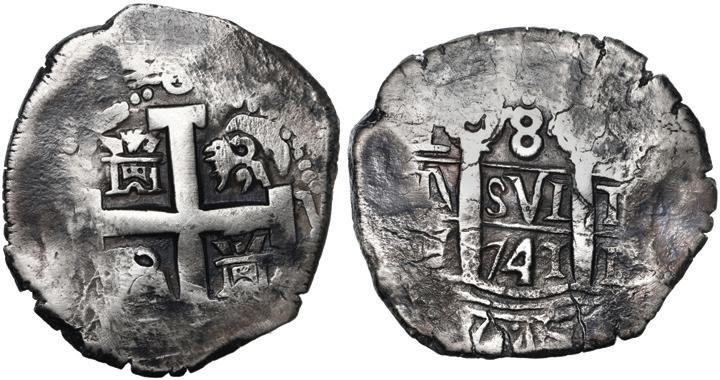


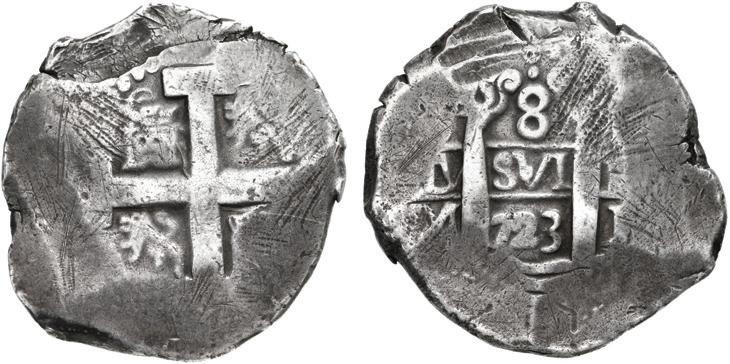
427. Lima, Peru, cob 8 reales, 1738 N. S-L21; KM-34a; Cal-1313. 26.44 grams. Chunky flan with good centers (and well-centered strike) but extensively flat peripheries, nice rich toning, Fine or so. Estimate: $350-$500.
431. Lima, Peru, cob 8 reales, 1746 V, rare, NGC Clipped. S-L22; KM-34a; Cal-1327. 23.49 grams. Nice centers including good cross and full date above waves, chunky flan with flat peripheries, deeply toned VF, neatly clipped once on edge, possibly to circulate at an African standard like others we have seen (like lot 490 in this same auction). NGC #6289382-001. Estimate: $350-$500.
428. Lima, Peru, cob 8 reales, 1739 V. S-L22; KM-34a; Cal-1315.

27.19 grams. Chunky flan with unusually full (but off-center) pillarsand-waves, bold full cross with full PHILIPPVS in legend, two dates and assayers, toned Fine+ with a few minor scratches. Estimate: $200-$300.
432. Lima, Peru, cob 1 real, 1694 M, NGC MS 61, finest known in NGC census. S-L11; KM-20; Cal-225. 3.71 grams. Broad flan with much legend (including date and CAROLVS II) and full inner details, all three dates and mintmarks and assayers, extremely high grade for a silver cob (next highest in census being XF 45) and positively dripping with luster, no toning, just a gleaming beauty. NGC #6289940-005. Estimate: $500-up.
429. Lima, Peru, cob 8 reales, 1741 V. S-L22; KM-34a; Cal-1320.
26.68 grams. Bold full pillars-and-waves and nearly full cross but flat peripheries, hairline edge-cracks, deeply toned AXF. Estimate: $200$300.
433. Potosí, Bolivia, cob 8 reales, Philip II, assayer C below erasure, very rare. S-P5; KM-5.1; Cal-671. 27.03 grams. Broad flan with choice full shield boldly flanked by P-erasure-C (the erasure clearly containing at least some combination with assayer B) to left and de nomination o-VIII to right, choice full cross-lions-castles and tressure, some legend despite peripheral flatness, beautifully toned XF, an excel lent example of this traditional rarity that was claimed by Sellschopp to be evidence of striking in La Plata, an error that was publicly eradicated by Cunietti in 1988 but still persists in older catalogs and references. Estimate: $3,000-$4,500.
436. Potosí, Bolivia, cob 8 reales, Philip III, assayer B (early 5th period). S-P14; KM-5.1; Cal-672. 27.38 grams. Choice full cross and shield (both slightly doubled) with bold full P-B to left, 100% full king’s name in legend, nicely toned AXF. Estimate: $200-$300.
434. Potosí, Bolivia, cob 8 reales, Philip III, assayer B (3rd period). S-P10; KM-5.1; Cal-672. 26.87 grams. Good full shield and cross despite central weakness due to flan concavity, also with full P-B and denomination, VF with dark toning in peripheries Estimate: $250$375.

437. Potosí, Bolivia, cob 8 reales, 1617 M, NGC VF 20. S-P19; KM-10; Cal-921. 27.10 grams. Bold 7 of date outside of good full cross-lions-castles, the unusually large shield also full with clear P-M to left and denomination O-VIII to right, light rich toning all over. It is interesting to note on this first issue with date in legend that the border dots were erased where the date was placed. NGC #6289913001. Estimate: $200-$300.
435. Potosí, Bolivia, cob 8 reales, Philip II assayer RL. S-P13; KM-5.1; Cal-675. 27.06 grams. Choice full shield and cross (no flatness or doubling), with bold full P-RL, much legend including full king’s name, XF with light toning over slightly shiny surfaces Estimate: $200-$300.

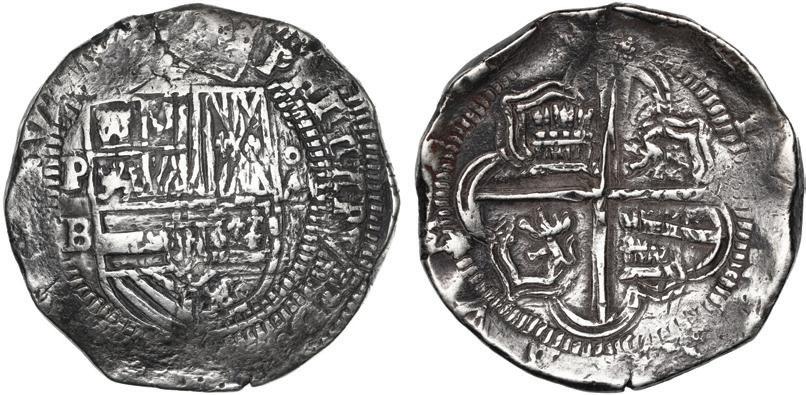


438. Potosí, Bolivia, cob 8 reales, Philip III, assayer T, mintmark as retrograde P (“q”) over normal P, q over rotated q in king’s name, quadrants of cross transposed (ca. 1620). S-P21; KM-10. 26.95 grams. Fascinating coin with mintmark appearing like the Greek letter “phi” and weird rendering of the king’s name as qHYLYqVS (the q’s punched over q’s that were initially punched in upside-down) due to the die-engraver’s misconception of what a P should look like (more incompetence than dyslexia), good full shield and cross-and-tressure despite some minor weak spots, non-toned VF. Estimate: $250-$375.

439. Potosí, Bolivia, cob 8 reales, 1625 P, quadrants of cross transposed, very rare. S-P23; KM-19a; Cal-1443. 22.29 grams. Corroded from salvage but with relatively clear date that shows about half the 6 and 2 and all of the 5 (narrower than expected, with straighter tail) outside a full but off-center cross with prominent lions (“flat” style typical of the mid-1620s), the shield also full and well centered with mostly clear P•P to left, Fine details overall, only the third example of this date we have ever heard of. Estimate: $200-$300.
442. Potosí, Bolivia, cob 8 reales, 1649 O/Z, with crownedO countermark on cross, ex-Mastalir (Plate). S-P35; KM-19b; Cal-1486. 23.76 grams. Atypically non-salvage yet still underweight (as made, the problems at the mint not fully eradicated at this point), with very bold P-O (the under-letter Z barely discernible), choice full countermark near center of full cross with full 164 and faint trace of 9 of date, deeply toned AVF with large edge-crack. Pedigreed to the Robert Mastalir Collection and plated on page 51 of Part A and page 177 of Part B of his books The Great Transition at the Potosí Mint, 1649-1652: The 1649-1652 Crowned Shield Coinage and the Countermarks of 1652 (2021). Estimate: $400-$600.


440. Potosí, Bolivia, cob 8 reales, 1630 T. S-P26; KM-19a; Cal-1455. 27.39 grams. Smallish flan for the era with thick edge harboring some surface metal disturbances but with choice full shield and cross (the latter with areas of light gray encrustation in crevices), clear denomi nation •8• (flat top) and assayer T, also the very bottom of 0 of date, toned XF. Estimate: $200-$300.
443. Potosí, Bolivia, cob 4 reales, Philip IV, assayer T/P (ca. 1628), rare. S-P24; KM-17a. 13.60 grams. Bold full cross-lions-castles, nearly full shield with full and clear •P-T/P• to left, non-toned XF. Estimate: $200-$300.
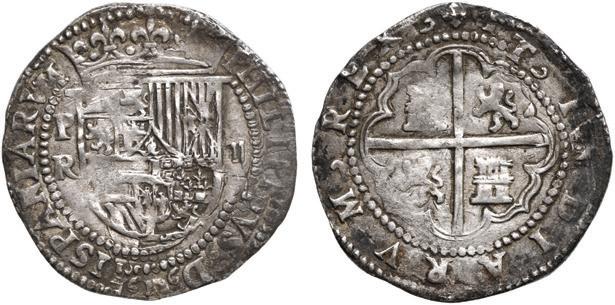
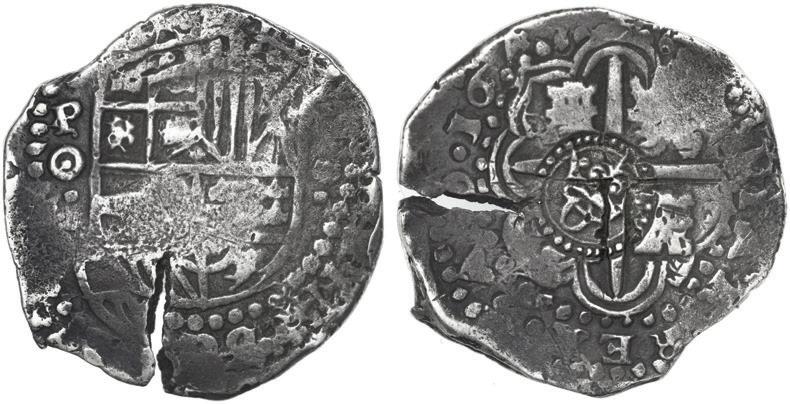

441. Potosí, Bolivia, cob 8 reales, 1632 T, cross-crosslet ornaments. S-P26; KM-19a; Cal-1457. 27.36 grams. Nearly full shield (flat at lower left) with clear P+T to left and +8+ to right (the +’s being cross-crosslets), also clear king’s ordinal IIII in legend, full but off-center cross (flat in same location) with clear bottom of 32 of date, VF with lots of small, greenish copper spots. Pedigreed to the Ponterio auction of April 1994, with original lot-tag 924. Estimate: $200-$300.
444. Potosí, Bolivia, cob 4 reales, (1650-1) O, with arms countermark on cross. S-P35; KM-17b. 12.77 grams. Attractively toned (and atypically non-salvage) VF+ with full cross, full upper half of shield, about 1/3 of the countermark (more than usually visible), peripherally flat. Estimate: $300-$450.
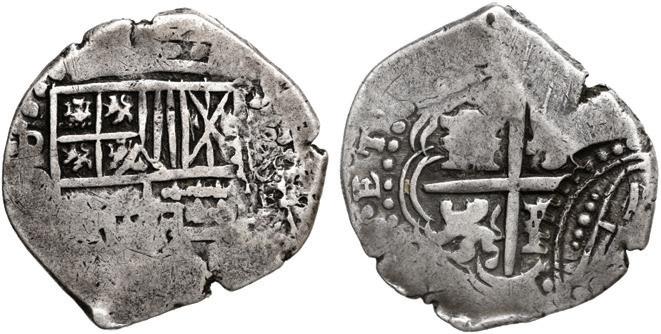
445. Potosí, Bolivia, cob 2 reales, Philip II, assayer R (Rincón), exStallard. S-P1; KM-3.2; Cal-364. 6.67 grams. Choice round flan that is broad enough to enable all the legends and crown to be visible (albeit slightly doubled), in ad dition to the choice interiors with bold full P-R, distinctive dies with Lima-style castles and HISP- with H (Stallard dies O3/A3), richly toned XF. Pedigreed to the Barry Stallard collection, purchased from Douglas Weaver in December 1972. Estimate: $400-$600.

446. Potosí, Bolivia, cob 2 reales, Philip II, assayer R (Rincón). S-P1; KM-3.2; Cal-364. 6.61 grams. Perfectly round (but small ish) flan with choice full cross-lions-castles and shield (trifle doubled) with bold P-R to left, attractively toned AXF with light old scratch diagonally across shield. Estimate: $200-$300.

449. Potosí, Bolivia, cob 2 reales, (1649) O/Z, dotted O, king’s name as PHELIPVS, rare, ex-Mastalir. S-P35; KM-14b; Cal-unl. 6.69 grams. Choice broad flan with clear PHELI- of king’s name in legend, 100% complete crown and shield and cross-lions-castles, full P-O to left (faint trace of under-assayer) and denomination z to right that appears to have been punched over a proper 2, deeply toned AXF with two edge-splits (one large, the other next to a spot of dark oxidation). Pedigreed to the Robert Mastalir Collection and plated on page 246 of Part A of his book The Great Transition at the Potosí Mint, 1649-1652: The 1649-1652 Crowned Shield Coinage and the Countermarks of 1652 (2021). Estimate: $200-$300.
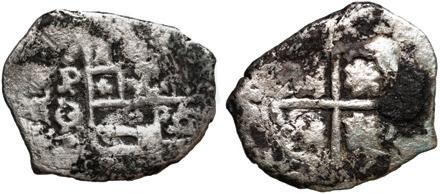
447. Potosí, Bolivia, cob 2 reales, Philip II, assayer M/R, very rare. S-P2; KM-3.2; Cal-unl. 6.53 grams. Very broad flan with nearly full crown and legends (including ISPAN- without H) and sharp full inner details (the cross slightly doubled) including a very bold P-M/R, lightly toned AU- with a trace of surface porosity. Estimate: $250-$375.
450. Potosí, Bolivia, cob 1 real, 1620 T, very rare. S-P21; KM-7; Cal-509. 2.91 grams. Choice full shield and full but slightly off-center cross enabling a clear “6zO” date, also clear P-T and denomination, lightly toned AVF. Estimate: $200-$300.
448. Potosí, Bolivia, cob 2 reales, (1649) O/TR, dotted O, very rare, ex-Mastalir. S-P35; KM-unl; Cal-unl. 7.18 grams. Full but somewhat messy assayer with clear R-shaped under-letter (presum ably TR monogram), full cross and most of shield despite extensive flatness, slightly crude edge (as made), bold full 16 of date, VF for actual wear with contrasting dark sediment in crevices. Pedigreed to the Robert Mastalir Collection and plated on page 243 of Part A of his book
The Great Transition at the Potosí Mint, 1649-1652: The 1649-1652 Crowned Shield Coinage and the Countermarks of 1652 (2021). Estimate: $200-$300.




451. Potosí, Bolivia, cob 1 real, (1649) O/sR, unique, exMastalir (Plate). S-P35; KM-unl; Cal-unl. 3.34 grams. Bold full P-O with clear evidence of sR under-assayer (first and only example known in any denomination except the 8R--see lot 205 for explanation), also with full cross and most of shield, About Fine details with cleaned surfaces punctuated by spots of black oxidation, a unique and important coin for the specialist. Pedigreed to the Robert Mastalir Collection and plated on pages 47 and 244 of Part A of his book The Great Transition at the Potosí Mint, 1649-1652: The 1649-1652 Crowned Shield Coinage and the Countermarks of 1652 (2021). Estimate: $250-$375.

452. Potosí, Bolivia, cob 8 reales Royal (galano), 1653 E, •PH• at top, NGC VF details / holed. S-P37a; KM-R21; Cal-1412. 26.07 grams. Fairly broad flan with nearly full legends (bold full date) and choice inner details (minimal doubling), all with a very rich old toning, neatly holed at the top of the pillars / right of the cross, scareto-rare date but these dies not listed by Lázaro (three dots around the denomination between pillar-tops, • pomegranate• above and date in three digits below cross, etc.). NGC #6102729-003. Estimate: $2,500-$3,750.
455. Potosí, Bolivia, cob 8 reales, 1663 E, NGC VF 35, ex-Espinola. S-P37a; KM-21; Cal-1527. 26.68 grams. Broad flan, full pillars-and-waves with two clear dates on that side including a full 1663 in legend (rare thus), good but off-center cross with full but doubled king’s name and ordinal PHILIPPVS IIII, lightly toned all over. Pedigreed to the Pablo Hernan Espinola Collection (stated on label). NGC #5845197-003. Estimate: $400-$600.
453. Potosí, Bolivia, cob 8 reales, 1653 E, PH at top (no dots), date in three digits below cross. S-P37a; KM-unl; Cal-unl. 26.95 grams. Broad flan with choice full cross-lions-castles (somewhat Royal-like) including crown and king’s name and ordinal, the other side cruder but with clear (fat) pillars, three dates and mintmarks and assayers, VF with light toning in crevices, old scrape on pillars side. Estimate: $350-$500.
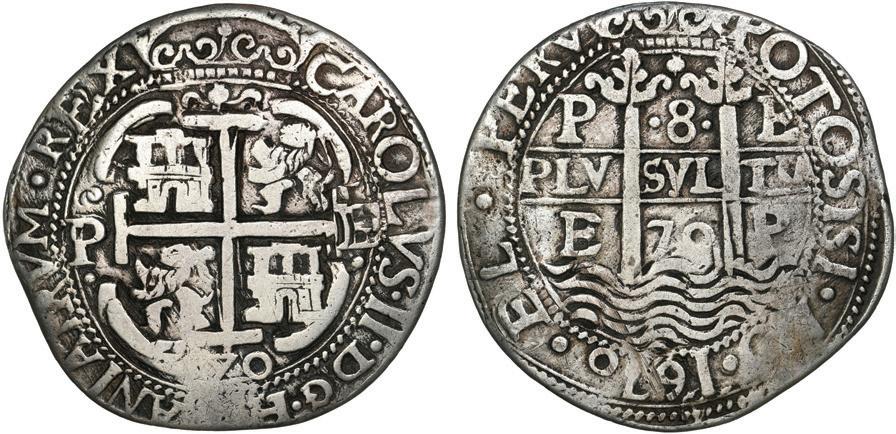


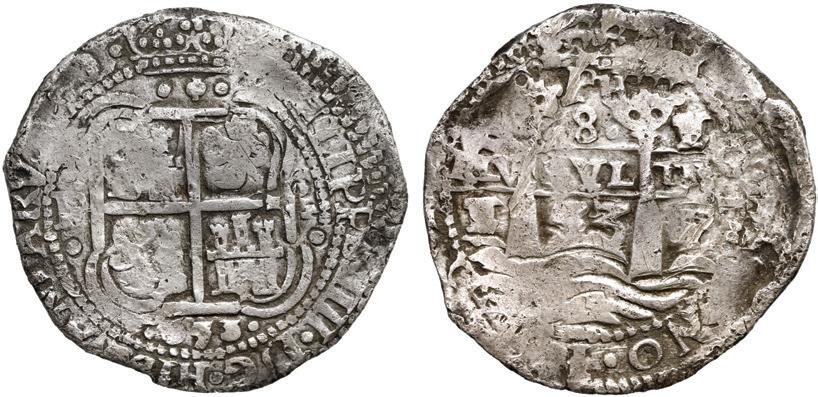

456. Potosí, Bolivia, cob 8 reales Royal (galano), 1669/8 E, NGC VF details / holed. S-P37b; KM-unl; Cal-664. 25.80 grams. Very
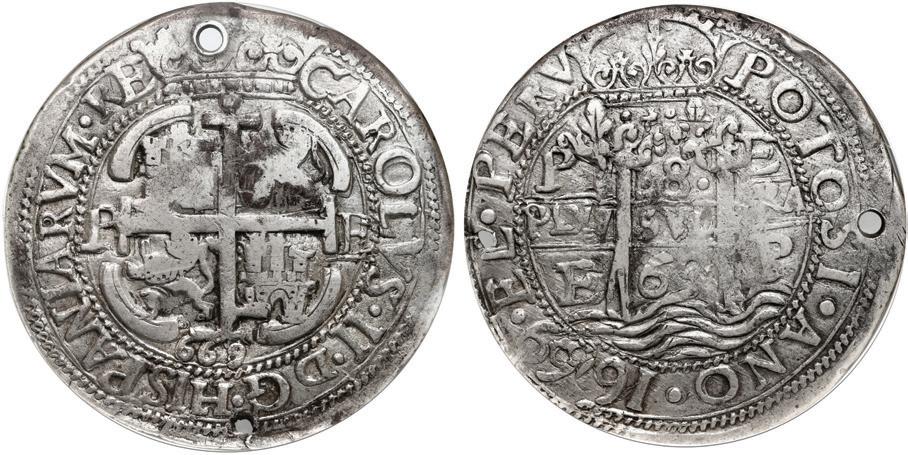
broad flan that extends past the order border in places, all details 100% as a result, the three-digit date below the cross showing a bold 9/8 (not noted by NGC), die-match with Lázaro 181 (who also missed the overdate, rated R2), very lightly toned and with just a modicum of doubling, with small holes at edge above and below cross. NGC #5779586-020. Estimate: $3,000-$4,500.
454. Potosí, Bolivia, cob 8 reales “pseudo-Royal,” 1657 E, PH at top of pillars, pomegranate above cross. S-P37a; KM-21; Cal-unl. 25.98 grams. Gorgeous details from an even strike and deep, rich, contrasting toning, the full pillars-and-waves well centered but the cross double-struck, all three dates and mintmarks and assayers, full and bold POTOSI in the ample legends, a few minor edge-splits, really looks like an attempted Royal (but not matching any of the dies in Lázaro). Estimate: $750-$1,100.
457. Potosí, Bolivia, cob 8 reales Royal (galano), 1670 E, NGC XF details / plugged, finest known in NGC census. S-P37b; KM-R26; Cal-666. 26.31 grams. Choice full details due even strike and contrastingly dark toning on fields, with expertly repaired hole to right of cross / about eight o’clock on pillars side (near a light old scrape), an apparent die-match with Lázaro 183 (whose pillars side is faintly doubled, making it hard to match up) with curiously small 0 in the date in the legend, technically finest in the NGC census in the absence of any “straight-graded” examples. NGC #6476187-001. Estimate: $3,000-$4,500.
458. Potosí, Bolivia, cob 8 reales, 1670 E. S-P37b; KM-26; Cal-701. 26.74 grams. Full but doubled cross, full but partially flat pillars-andwaves with full 70 of date in legend, deeply toned VF. Pedigreed to the Ponterio auction of April 1994, with original lot-tag 929. Estimate: $200-$300.
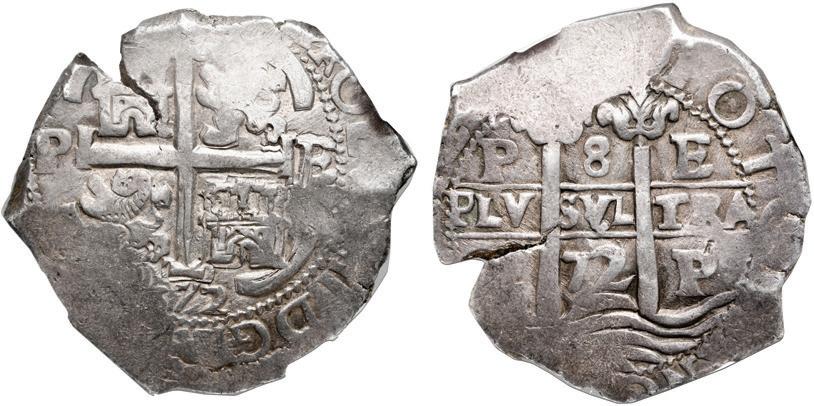
461. Potosí, Bolivia, cob 8 reales, 1678 E, NGC AU 53, ex-Espinola. S-P37b; KM-26; Cal-711. 27.25 grams. Bold full cross and (slightly doubled) pillars-and-waves, two dates and assayers, three mintmarks, lightly toned, second finest in NGC census behind a single MS 61. Pedigreed to the Pablo Hernan Espinola Collection (stated on label). NGC #5845198-005. Estimate: $400-$600.

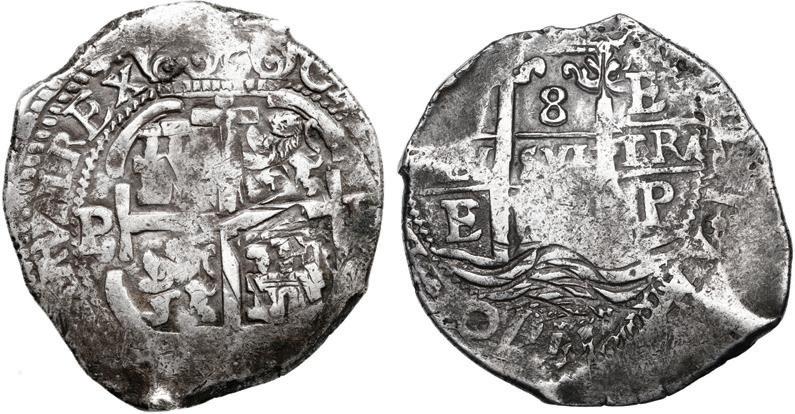
459. Potosí, Bolivia, cob 8 reales, 1672 E, NGC AU 55, finest known in NGC census. S-P37b; KM-26; Cal-703. 27.00 grams. Bold full pillars and nice (but slightly off-center) full cross-lions-castles, two dates and assayers, three mintmarks, lovely toned and near-pristine surfaces, edge-split. NGC #6286838-003. Estimate: $300-$450.
462. Potosí, Bolivia, cob 8 reales, 1678 E. S-P37b; KM-26; Cal-711. 25.93 grams. Full but partially flat pillars-and-waves and cross-lionscastles, bold •pomegranate• above cross, parts of all three dates, slightly porous VF with contrasting toning. Pedigreed to the Ponterio auction of July 1994, with original lot-tag 804. Estimate: $200-$300.

460. Potosí, Bolivia, cob 8 reales, 1675 E. S-P37b; KM-26; Cal-706. 26.32 grams. XF for actual wear but rather unevenly struck, about half flat, the date below the cross nevertheless full and the surfaces all very clean and untroubled. Pedigreed to the Ponterio auction of June 1994, with original lot-tag 154. Estimate: $200-$300.



463. Potosí, Bolivia, cob 8 reales, 1679 C. S-P38; KM-26; Cal-714. 28.03 grams. Atypically non-salvage AU with bright and unmolested surfaces, the waves particularly bold (the pillars and cross both techni cally full but weaker), also three bold assayers and three mintmarks. Estimate: $200-$300.
464. Potosí, Bolivia, cob 8 reales, 1679 C. S-P38; KM-26; Cal-714. 26.46 grams. Broad-flan Fine+ with 100% full pillars-and-waves and cross-lions-castles and contrasting toning, two dates, three mintmarks and assayers, hairline edge-crack. Pedigreed to the Ponterio auction of April 1994, with original lot-tag 931. Estimate: $200-$300.
465. Potosí, Bolivia, cob 8 reales Royal (galano), 1680 V, pomegranate at top of pillars, NGC AU details / holed, finest and only example in NGC census. S-P39; KM-R26; Cal-676. 26.54 grams. Impressively broad flan extending well past outer borders in places, all details full as a result, also with practically no doubling or weakness, die-match with Lázaro 202, richly toned, holed to left of cross / bottom of pillars. NGC #6454909-001 (large size holder). Estimate: $4,000-$6,000.
466. Potosí, Bolivia, cob 8 reales, 1681 V. S-P39; KM-26; Cal-719. 26.83 grams. Full but doubled cross and pillars-and-waves, three dates and assayers, VF details with contrasting brown toning but surfaces lightly porous, one small edge-crack. Pedigreed to the Ponterio auction of June 1994, with original lot-tag 158. Estimate: $200-$300.


468. Potosí, Bolivia, cob 8 reales, 1682 V, NGC VF 30. S-P39; KM-26; Cal-720. 26.85 grams. Very richly old-toned, with well-centered full pillars-and-waves, slightly off-center full cross with choice full crown above. NGC #4435033-008. Estimate: $400-$600.
467. Potosí, Bolivia, cob 8 reales, 1682 V, NGC XF 45. S-P39; KM-26; Cal-720. 27.50 grams. Choice full cross-lions-castles and pillarsand-waves (the tops of the pillars particularly choice), two dates, three mintmarks, nicely toned, second finest in NGC census behind a single AU 55. NGC #4462439-002. Estimate: $600-$900.

469. Potosí, Bolivia, cob 8 reales, 1685 VR. S-P40; KM-26; Cal726. 27.21 grams. Choice strike with perfectly centered (and doublingfree) full pillars-and-waves and cross-lions-castles, all three dates and mintmarks and assayers, contrastingly toned XF with edge-crack. Estimate: $600-$900.


470. Potosí, Bolivia, cob 8 reales, 1687 VR, NGC XF 45, ex-Espinola. S-P40; KM-26; Cal-729. 27.23 grams. Full and well-centered pillars-and-waves and cross-lions-castles, two dates and mintmarks, three assayers, somewhat crude edge (as made), lightly toned. Pedigreed to the Pablo Hernan Espinola Collection (stated on label). NGC #5845198-006. Estimate: $400-$600.
473. Potosí, Bolivia, cob 8 reales, 1691 VR. S-P40; KM-26; Cal-734.
27.52 grams. Choice full pillars-and-waves and cross-lions-castles, both well centered on a naturally round flan, all three dates and mintmarks and assayers visible, beautifully toned XF. Estimate: $600-$900.
471. Potosí, Bolivia, cob 8 reales, 1688 VR. S-P40; KM-26; Cal-730. 27.71 grams. Low-contrast Fine+ with much flatness but technically full pillars and cross (nice crown above), faintly toned. Pedigreed to the Ponterio auction of February 1998, with original lot-tag 793. Estimate: $200-$300.
474. Potosí, Bolivia, cob 8 reales, 1695 VR, NGC VF 30, ex-Espinola. S-P40; KM-26; Cal-738. 27.24 grams. Full pillars-and-waves and cross and most of both crowns, two dates, three assayers, gunmetal toning all over, edge-split. Pedigreed to the Pablo Hernan Espinola Col lection (stated on label). NGC #5846057-001. Estimate: $400-$600.
472. Potosí, Bolivia, cob 8 reales, 1690 VR, NGC VF 35. S-P40; KM-26; Cal-733. 26.74 grams. Bold and well-detailed full pillarsand-waves and cross-lions-castles with just a few flat spots, three dates, two mintmarks and assayers, attractively toned, arguably XF 45 to our eyes (still tied for second finest in NGC census behind a single XF 40). NGC #4925346-004. Estimate: $400-$600.
475. Potosí, Bolivia, cob 8 reales, 1698 F. S-P42; KM-26; Cal-744. 27.29 grams. Thick and chunky flan with well-centered full pillarsand-waves, partially flat but also well-centered cross, two dates and mintmarks, three assayers, low-contrast Fine with stray marks and tooling. Estimate: $200-$300.
476. Potosí, Bolivia, cob 8 reales, 1699 F, ex-Sellschopp. S-P42; KM-26; Cal-745. 26.51 grams. Oddly squarish flan with choice crown above full pillars, most of cross, double struck on both sides but with all three mintmarks and assayers and two dates visible, VF with spots of uneven toning, desirable pedigree. Pedigreed to the Ponterio auction of July 1994, with original lot-tag 813 and to the Sellschopp Collection (Swiss Bank Corp. auction of September 1988, lot 828). Estimate: $200-$300.




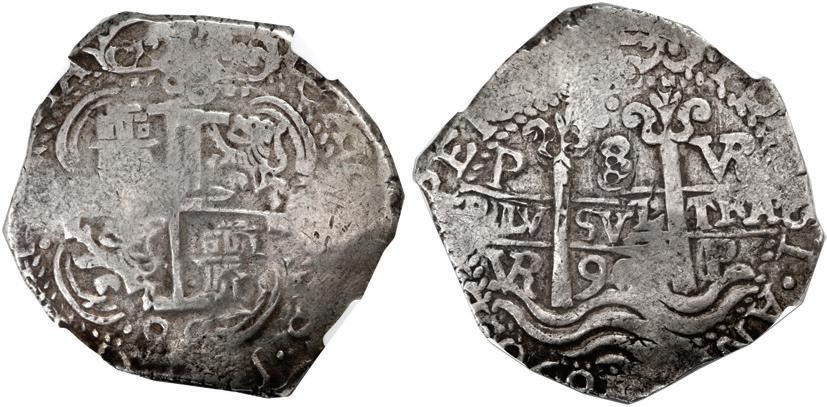


477. Potosí, Bolivia, cob 8 reales, 1701 F, Charles II posthumous. S-P42; KM-26; Cal-747. 26.13 grams. Chunky flan with one side neatly sliced, technically high grade (XF+) but with flat areas, the all-important date, assayer and king’s ordinal II all full and clear, streaky gunmetal toning. Estimate: $200-$300.

480. Potosí, Bolivia, cob 8 reales, 1712 Y, NGC XF 40, finest known in NGC census. S-P43a; KM-31; Cal-1548. 26.55 grams. Typically chunky but with nearly full cross and bold date on other side (peripheries flat), two full assayers, nicely toned all over, also somewhat scarce. NGC #4835108-002. Estimate: $250-$375.
478. Potosí, Bolivia, cob 8 reales Royal (galano), 1704 Y, rare, NGC VF details / plugged (“top pop”). S-P43a; KM-R31; Cal-1476. Perfectly round, with choice full cross side (including legend), the pillars side also full but doubled, curiously plugged at the top of the pillars with the crown details inaccurately recreated, die-match with Lázaro 243 (rarity R3, four to six known) and one of just two (the other at the same grade) in the NGC census for non-overdate. NGC #5779586-033. Estimate: $3,000-$4,500.
481. Potosí, Bolivia, cob 8 reales, 1714 Y, NGC AU 55, fin est known in NGC census, ex-Ugaz. S-P43a; KM-31; Cal-1550. 26.30 grams. Good full cross and pillars on a relatively broad (but still typi cally chunky) flan with edge-split and parts of edge crude (as made), parts of all three dates and assayers and mintmarks (very rare for this period), lightly toned and very high grade for the issue (scarce date). Pedigreed to the Jorge Ugaz collection (stated on label). NGC #6271297003. Estimate: $400-$600.
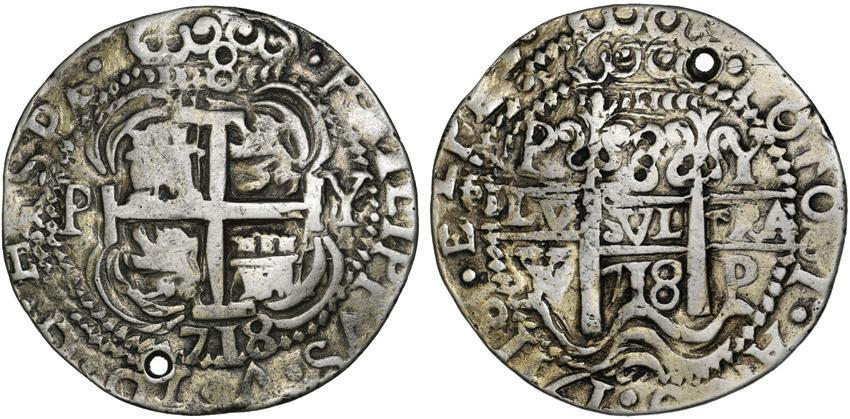





479. Potosí, Bolivia, cob 8 reales, 1706 Y. S-P43a; KM-31; Cal-1541. 26.68 grams. Very chunky with flat peripheries due to uneven thickness (amazing contrast to the previous lot), yet with full pillars (clear date, slightly doubled) and most of cross (bold mintmark), overall VF and very naturally toned. Pedigreed to the Ponterio auction of June 1994, with original lot-tag 170. Estimate: $200-$300.
482. Potosí, Bolivia, cob 8 reales, 1717 Y, Calbetó Plate. S-P43a; KM-31; Cal-1553. 27.23 grams. Chunky and crude but with clear date and assayer among technically full pillars, most of cross, Fine with patchy toning and some porosity, desirable pedigree. Plate Coin 1150 on page 326 of Gabriel Calbetó’s Compendio de las Piezas de Ocho Reales (1970), pedigreed to the Ponterio auction of June 1994, with original lot-tag 173. Estimate: $250-$375. 483. Potosí, Bolivia, cob 8 reales Royal (galano), 1718 Y, dots in legend, very rare, NGC Genuine / holed - plated. S-P43a; KM-R31; Cal-1490. 27.09 grams. Broad and perfectly round flan (in stark contrast to the previous lot) with good full inner details and nearly full legends and crowns, minimal doubling, VF with toning in crevices over traces of gilding (which prevented NGC from rendering an opinion on grade), holed near bottom of cross / top of pillars, apparently an unlisted variety (not in Lázaro) with dots instead of “condors” as spac ers in the legends. NGC #6475699-001. Estimate: $2,000-$3,000.
484. Potosí, Bolivia, cob 8 reales Royal (galano), 1720 Y, dots in legend, rare, NGC VF details / holed (“top pop”), ex-Sellschopp, Lázaro Plate. S-P43a; KM-R31; Cal-1492. 26.25 grams. Deeply toned over bold full details (the pillars slightly doubled), noticeably smaller than previous issues but still with much legend including king’s name and ordinal and date and POTOSI, crudely holed (an old, squarish piercing) at top of cross / bottom of pillars, tied with one other for finest in NGC census in the absence of any “straight grade” examples, rated R3 (four to six known) in Lázaro, desirable pedigree. Pedigreed to the Sellschopp Collection (Swiss Bank Corp. auction of January 1987, lot 1859) and Plate Coin 267 on page 345 of Reales de a Ocho: Los Redondos de Lima, Méjico y Potosí y otras acuñaciones especiales, by Jose Luis Lázaro (1996). NGC #5779586-041. Estimate: $3,000-$4,500.
485. Potosí, Bolivia, cob 8 reales Royal (galano), Louis I, 1727 Y, very rare, NGC AU details / holed. S-P43b; KM-R35; Cal-46. 26.83 grams. Superb full inner details and much legend for this smaller-flan period including full date and all-important LVIS PR (as noted by NGC), deeply toned all over, die-match with Lázaro 309 (rated R4, three to four known), a lovely coin despite the inevitable hole at top of pillars / left of cross, in fact second finest at NGC, bested only by an MS 61 monster in strong private hands. Pedigreed to the UBS auction of January 2001 (“Fifty Numismatic Rarities”), lot 5. NGC #6472679-003. Estimate: $10,000-up.
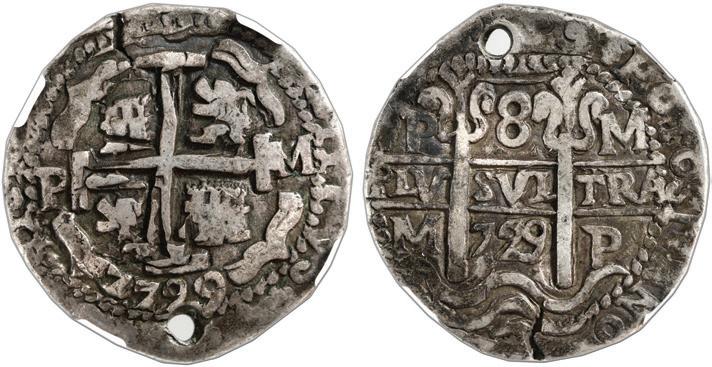

486. Potosí, Bolivia, cob 8 reales, 1727 Y, Louis I, rare. S-P43b; KM-35; Cal-50. 26.10 grams. Typically chunky, with bold full central date and both the others visible (very rare thus) in addition to the all-important R of the king’s ordinal PR in legend, both pillars and most of cross full and sharp, VF with flat peripheries, unevenly toned. Estimate: $750-$1,100.

487. Potosí, Bolivia cob 8 reales Royal (galano), 1729 M, rare, NGC XF details / holed. S-P44; KM-R31a; Cal-1498. Thick round flan with full but slightly off-center pillars, full but doubled cross, some legend, richly toned all over, holed near top of pillars / bottom of cross, die-match with Lázaro 276 (rated R3, four to six known). NGC #6281500-003. Estimate: $2,500-$3,750.
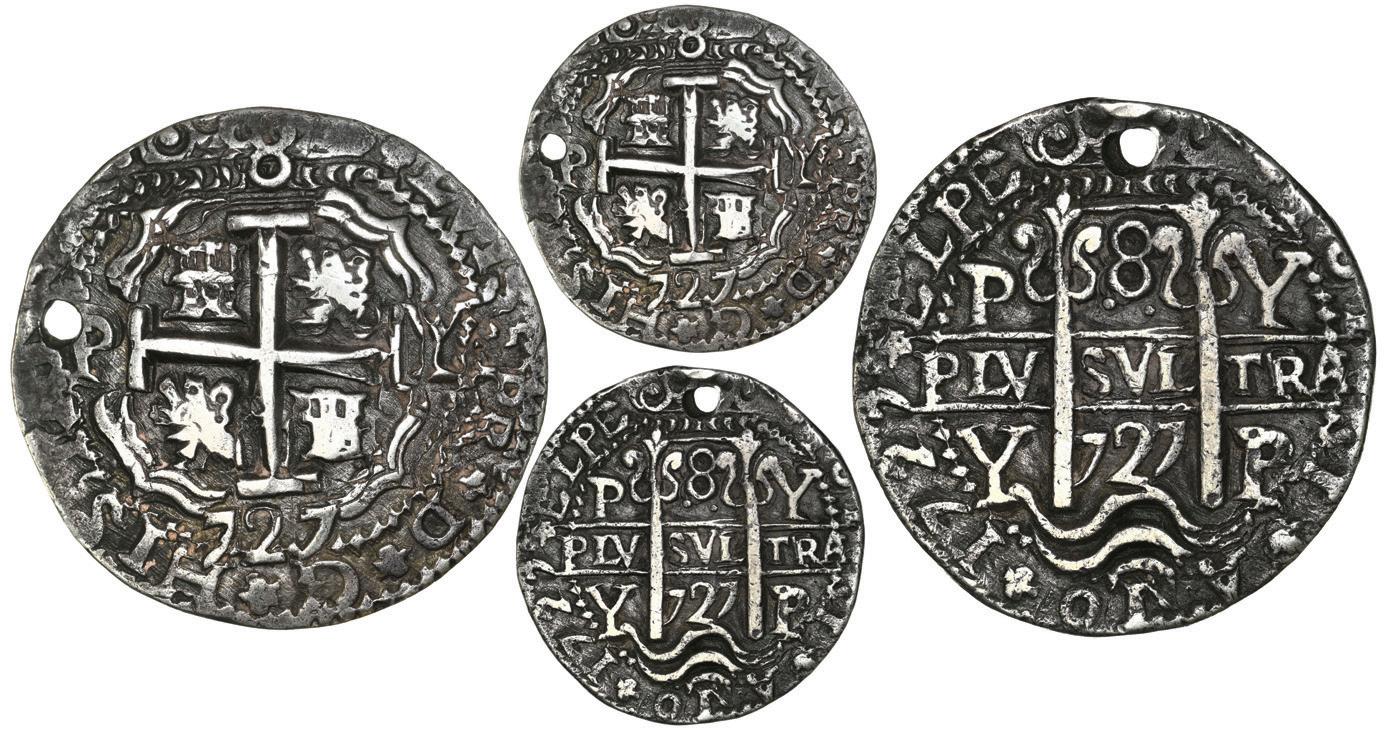
488. Potosí, Bolivia, cob 8 reales, 1733 YA, rare, NGC VF 35. S-P45; KM-31a; Cal-1567. 26.44 grams. Chunky but choice, with full and well-centered cross and pillars, two dates and assayers and mintmarks, bold king’s ordinal V, beautifully toned, much nicer overall than its technical grade implies. NGC #4835108-005. Estimate: $500-$750.





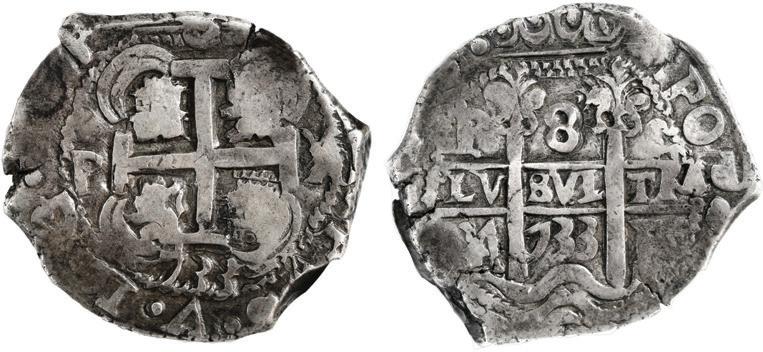
491. Potosí, Bolivia, cob 4 reales Royal (galano), 1697 CH, extremely rare, PCGS VF details / holed, finest and only ex ample in any census, ex-Pat Johnson. S-P41; KM-unl; Cal-505. 12.17 grams. Choice full pillars-and-waves with clear bottom of second date 1697 in legend, both assayers full and clear (an attractive monogram with H inside a large C), the cross side slightly doubled and a little more worn (perhaps in connection to being holed at the top of the cross, an old squarish piercing), but overall quite attractive (nicely toned) and probably unique, also probably struck from the same dies as the famous 1697 CH 4R Heart that hammered for $24,000 in 2008. It is also worth noting that no 8R Royals of assayer CH are known, so this is the largest denomination possible. Pedigreed to the Pat Johnson Collection. PCGS #44722367. Estimate: $2,500-up.
489. Potosí, Bolivia, cob 8 reales, 1765 V-Y. S-P57; KM-45; Cal1141. 25.35 grams. Chunky flan with parts of edge crude (including two cracks, one small overcut and even a spot of folded-over metal), but with good full cross above very bold full date, full pillars (choice top of left pillar), XF or better with slight surface porosity and faint toning. Pedigreed to the Ponterio auction of February 1998, with original lot-tag 798. Estimate: $200-$300.
492. Potosí, Bolivia, cob 4 reales Royal (galano), 1709 Y, very rare, NGC VF details / holed, tooled, finest known in NGC census. S-P43a; KM-R30; Cal-1136. 13.31 grams. Broad flan for this issue, with some legend around full inner details (the pillars nice but the cross doubled), with tiny hole at bottom of pillars / near bottom of cross, attractively toned but somewhat scratched on high points long ago. NGC #2885629-002. Estimate: $3,000-$4,500.
490. Potosí, Bolivia, cob 8 reales, 1770/69 V-(Y). S-P57; KM-45; Cal-1149. 23.91 grams. Chunky flan, neatly clipped once on edge, possibly to circulate at an African standard like others we have seen (like lot 431 in this same auction), with full date clearly showing scarce overdate, lightly toned VF+ with interesting surface roughness on opposing sides (as made). Pedigreed to the Ponterio auction of March 1998, with original lot-tag 1346. Estimate: $200-$300.
493. Potosí, Bolivia, cob 4 reales, 1738 M, NGC MS 62 (“top pop”). S-P47; KM-30a; Cal-1193. 12.96 grams. Completely white with luster and lack of toning (pristine), with full cross and pillars despite its typically chunky flan, three dates and assayers, typical surface roughness on opposing sides, tied with one other for finest in the NGC census. NGC #6289940-004. Estimate: $400-$600.
494. Potosí, Bolivia, cob 2 reales, 1701 Y, posthumous Charles II. S-P43; KM-24; Cal-unl. 6.28 grams. Very bold full pillars and cross, two dates and assayers, peripherally flat, VF with darkly toned fields, scarce posthumous issue (assumed, none known under Philip V). Estimate: $200-$300.
496. Potosí, Bolivia, cob 2 reales, 1747 q, NGC MS 61, finest known in NGC census. S-P50a; KM-38; Cal-313. 6.71 grams. Very deep strike imparting super-sharp details in the full cross-lions-castles and pillars, two dates, three assayers, chunky flan with edge-split, bright white with luster and lack of toning. NGC #6289940-003. Estimate: $300-$450.

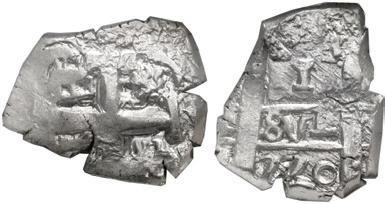



495. Potosí, Bolivia, cob 2 reales Royal (galano), 1747 q, very rare, NGC Genuine / clipped. S-P50a; KM-unl; Cal-unl. 5.86 grams. Well-centered strike on a small but perfectly round flan, no legends to confirm but believed to be a Philip V issue, good cross but center of pillars weak, richly toned, with hole at bottom of cross and second hole (stripped) at bottom of pillars, first example we have seen since the “Americas” piece in 1983 (Kagin’s). NGC #6474385-007. Estimate: $500-$750.
497. Potosí, Bolivia, cob 1 real, 1770 V-Y, NGC MS 62, finest known in NGC census. S-P57; KM-42; Cal-459. 3.38 grams. Lustrous and bright white as the day it was made, very deep strike and sharp details, bold full date between pillars, one of very few examples in this period in such a high grade. NGC #6289940-002. Estimate: $200-$300.

The following special section of Chinese Panda Coinage is the personal collection of a seasoned numismatist who has collected them since the concept of bullion Pandas was first started by the China Mint in 1982 and continues to this day, each year showing a different representation of Chinese panda bears in various-sized pieces struck in several different precious metals. Immediate interest in these coins upon release waxed and waned over the years, but third-party grading (NGC, PCGS, etc.) created a renaissance in the collector field, which has recognized that most Pandas were put into jewelry, perhaps inadvertently creating a “numbers game” for very high-grade pieces (MS or PF 69 and 70, in most cases). Many of the following are “top pop” and/or rare key pieces (reflecting current census data as of this writing in mid-September 2022, as well as current bullion prices). As a special section with special features, our catalog presentation here strays from our usual conventions. For one, the order follows a smaller-to-larger denomination order, but still with gold first, then other metals (platinum, palladium and silver, also bimetallic issues in gold and silver), followed by non-denominated pieces, all within a chronological order of dates of issue. Since these are all beautiful and flawless items (or virtually so, in some cases), gleaming with luster and lacking any wear, the descriptions generally do not describe the condition of the coins themselves. Instead, we offer information about mintage and survival estimates, all figures from the acknowledged Panda guru, Peter Anthony, whose book Gold & Silver Panda Coin Buyer’s Guide (2016) is considered the main reference on the topic (noted in references here as “PAN-“), as well as interesting and relevant tidbits from Anthony concerning individual rarity or importance (from the NGC site if not from the book). In some cases Anthony does not have actual mintage figures, as the China Mint often did not release those numbers (at least not right away), and large-scale meltage or jewelry use often decimated large mintages anyway; suffice to say the more important figures are Anthony’s estimates of pieces extant. Also, since these pieces are more sensitive to precious metals prices, the estimates are not what you usually see in our auctions, and in many cases we are starting well below the current bullion value, in fact typically 30% to 40% below the low estimates, which also reflect rarity and numismatic value. One last point: Not all these pieces are considered coins, even though they are all struck in coin sizes with coin axis, as there were several nondenominated issues made specifically for trade shows, which Anthony calls “medals” but NGC and most others (including us) refer to as “official Panda issues” instead. For clarity we provide the weights of each metal in troy ounces for each piece. We hope this is taken not only as an investment opportunity for those who seek diversification of their assets but also as a unique and valuable presentation of information rarely seen in catalogs to help start or build up your collection. Enjoy! 498. China (People’s Republic), gold 1/10 oz Panda, 1982, short leaf, NGC MS 69 (Red China Label). KM-XMB8; PAN-5A. Desirable first year of issue. Peter Anthony: “To this day the 1/10 oz. coin retains a significant premium, especially in MS-69.” Mintage: 77,598 (but <23,000 extant). The NGC label and census do not mention the “short leaf” variety for this piece, in reference to a difference in leaves to the left of the panda; among these non-differentiated entries, only three are graded higher at MS 70. Pedigreed to the Gansu Collection of Chinese Panda Coinage. NGC #3589148-067. Estimate: $300-$450.

499. China (People’s Republic), gold 1/10 oz Panda, 1982, long leaf, NGC MS 69. KM-XMB8; PAN-5B. Desirable first year of issue. Peter Anthony: “To this day the 1/10 oz. coin retains a significant premium, especially in MS-69.” Mintage: 77,598 (but <23,000 extant). The “long leaf” variety on this coin is noted by NGC, in whose census about 16% of the entries are differentiated by variety, none of those graded MS 70. Pedigreed to the Gansu Collection of Chinese Panda Coinage. NGC #6472363-001. Estimate: $300-$450.


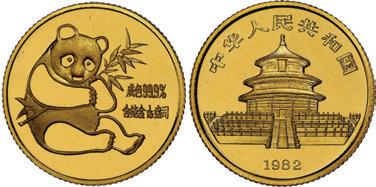
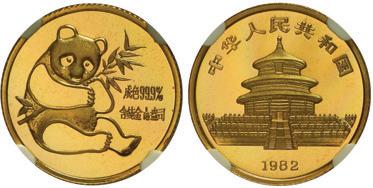
500. China (People’s Republic), gold 1/4 oz Panda, 1982, short leaf, NGC MS 69 (“top pop,” Red China Label). KM-XMB9; PAN-4A. Desirable first year of issue. Mintage: 42,243 (but <19,000 extant). As with the 1/10 oz, not all NGC entries are differentiated by variety (the “short leaf” referring to the leaves to left of the panda), which is the case here; across the entire NGC population, however, there is none at MS 70. Pedigreed to the Gansu Collection of Chinese Panda Coinage. NGC #3589148-049. Estimate: $500-$700.
501. China (People’s Republic), gold 1/4 oz Panda, 1982, long leaf, NGC MS 69 (“top pop”). KM-XMB9; PAN-4B. Desirable first year of issue. Mintage: 42,243 (but <19,000 extant). Among only 10% of NGC entries differentiated by variety, none in MS 70. Pedigreed to the Gansu Collection of Chinese Panda Coinage. NGC #3595399-006. Estimate: $500-$700.
502. China (People’s Republic), gold 1/2 oz Panda, 1982, NGC MS 69 (“top pop”). KM-XMB10; PAN-3A. Desirable first year of issue, and “the most difficult to find of the four Pandas of this date” (Anthony). Mintage: 13,391. The NGC census shows none at MS 70. Pedigreed to the Gansu Collection of Chinese Panda Coinage. NGC #4192709-029. Estimate: $2,000-$3,000.
506. China (People’s Republic), gold 10 yuan (1/10 oz) Panda, 1983, NGC MS 69. KM-69; PAN-9A. Mintage: 82,013 (but <14,000 extant). As Anthony points out, most of the early Pandas were wholesaled to jewelers and therefore undamaged examples exist in only fractions of their total mintage. Pedigreed to the Gansu Collection of Chinese Panda Coinage. NGC #6472363-006. Estimate: $250-$375.
503. China (People’s Republic), gold 1 oz Panda, 1982, NGC MS 68. KM-XMB11, PAN-2A. Desirable first year of issue. Anthony: “The 1982 1 oz gold Panda is a very popular, sought-after date… most coins have flaws and many were mishandled.” Mintage: 13,532. Pedigreed to the Gansu Collection of Chinese Panda Coinage. NGC #6472363-004. Estimate: $3,000-$4,500.
507. China (People’s Republic), gold 25 yuan (1/4 oz) Panda, 1983, NGC MS 69. KM-70; PAN-8A. Mintage: 43,827 (but <27,000 extant). Anthony: “A MS-69 will bring a bit of a premium above the value of the gold content,” this example lacking the “bit of rub on the high points” that tends to plague lesser grades. Pedigreed to the Gansu Collection of Chinese Panda Coinage. NGC #6472363-007. Estimate: $500-$750.
504. China (People’s Republic), brass proof 1 yuan Panda, 1983, NGC PF 69 Ultra Cameo. KM-85; PAN-12A. Anthony considers this piece a “Panda cousin” (not part of the same series but with a similar panda motif, the other side showing the Chinese arms as opposed to Beijing’s Temple of Heaven) but still calls them “Panda coins” and says: “Very, very few of these brass coins ever achieve a MS-69 grade” due to the fact that brass oxidizes and damages so eas ily. Pedigreed to the Gansu Collection of Chinese Panda Coinage. NGC #3801749-020. Estimate: $300-$450.
505. China (People’s Republic), gold 5 yuan (1/20 oz) Panda, 1983, NGC MS 70 (“top pop”). KM-68; PAN-10A. Among only 30 pieces at MS 70 in the NGC census. Anthony: “The 1983 5 Yuan is scarce… and ranks as a key coin.” First year with denomination shown on the coins. Mintage: 75,454 (but <7,000 extant). Pedigreed to the Gansu Collection of Chinese Panda Coinage. NGC #6472363-005. Estimate: $400-$600.
508. China (People’s Republic), gold 50 yuan (1/2 oz) Panda, 1983, NGC MS 69. KM-71; PAN-7A. Mintage: 28,596 (but <13,000 extant). Anthony: “A MS-69 will bring a significant premium above the value of the gold content,” this example lacking the “bit of rub on the high points” that tends to plague lesser grades. Anthony also notes that the 1/2 oz set of dates is the most difficult to assemble in BU grade. Pedigreed to the Gansu Collection of Chinese Panda Coinage. NGC #6472363-008. Estimate: $1,200-$1,800.
509. China (People’s Republic), gold 100 yuan (1 oz) Panda, 1983, NGC MS 68. KM-72; PAN-6A. Mintage: 25,363 (but <16,500 extant). Still a fairly low mintage for these popular coins and result ingly “not common” according to Anthony. Pedigreed to the Gansu Collection of Chinese Panda Coinage. NGC #6472363-009. Estimate: $1,700-$2,500.
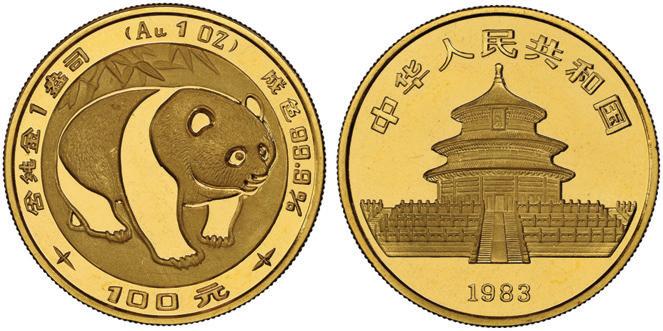

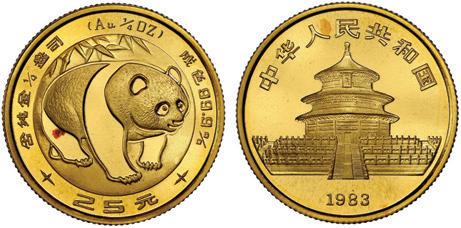



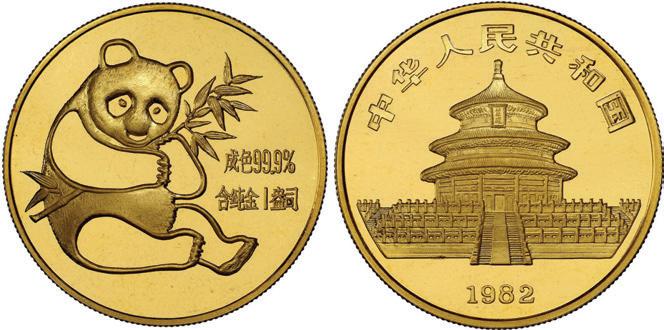

510. China (People’s Republic), silver proof 10 yuan Panda, 1983, NGC PF 69 Ultra Cameo. KM-67; PAN-11A. Very popular as the first silver Panda released, winner of the “Best Silver Coin of 1983” award, “quite scarce” in Proof 69 (Anthony). Mintage: 10,000 (planned; actual and surviving unknown). Only three higher in the NGC census at PF 70. Pedigreed to the Gansu Collection of Chinese Panda Coinage. NGC #3911462-037. Estimate: $2,200-$3,500.
513. China (People’s Republic), silver proof 10 yuan Panda, 1985, NGC PF 69 Ultra Cameo. KM-114; PAN-27A. Anthony: “The third and final coin in the 27 gm silver proof Panda series [that] remains popular among collectors.” Very few are in higher grade. Mintage: 10,000 (planned; actual and surviving unknown). Pedigreed to the Gansu Collection of Chinese Panda Coinage. NGC #3596989-003. Estimate: $1,000-$1,500.


514. China (People’s Republic), gold 1/20 oz proof official Panda issue, 1987, Tokyo Coin Show, NGC PF 70 Ultra Cameo (“top pop”). KM-XMB32; PAN-61A. Mintage: 25,000 (planned; actual and surviving unknown). One of four different 1987 gold Pandas released specifically for exhibitions (the others being San Francisco, New York and New Orleans). Note: NGC label and census attribute this as a “Sino-Japanese Friendship” issue in error, also calling it a MEDAL (as Anthony does) as opposed to OFFICIAL PANDA ISSUE. Pedigreed to the Gansu Collection of Chinese Panda Coinage. NGC #3712218-046. Estimate: $200-$300.
511. China (People’s Republic), silver proof 10 yuan Panda, 1984, NGC PF 69 Ultra Cameo. KM-87; PAN-19A. Anthony states that gem 10 Yuan silver proof Pandas of this date are rare, “a very beau tiful and charming design [that] remains popular among collectors.” Mintage: 10,000 (planned; actual and surviving unknown). Pedigreed to the Gansu Collection of Chinese Panda Coinage. NGC #3549475-001. Estimate: $800-$1,200.

515. China (People’s Republic), gold 25 yuan (1/4 oz) Panda, 1987 S, NGC MS 70 (“top pop”). KM-161; PAN-54A. Highly desirable as one of only nine pieces at MS 70 in the current NGC census. In this year we see a mintmark (here, S for Shanghai, but on other coins Y for Shenyang) and on proof coins a P for Proof. Mintage: 10,000 (planned; actual and surviving unknown). Pedigreed to the Gansu Collection of Chinese Panda Coinage. NGC #1000140-019. Estimate: $500-$750.



512. China (People’s Republic), gold 5 yuan (1/20 oz) Panda, 1985, NGC MS 70 (“top pop”). KM-113; PAN-26A. One of only 30 graded MS 70 at NGC. About 1985 Pandas in general, Anthony says: “not many are gems” because “vast quantities of these coins were shipped to jewelers to be placed in settings.” Mintage: 210,175 (but < 35,000 extant). Pedigreed to the Gansu Collection of Chinese Panda Coinage. NGC #3502758-116. Estimate: $300-$450.
516. China (People’s Republic), gold 1 oz proof official Panda issue, 1987, San Francisco International Coin Expo, NGC PF 69 Ultra Cameo. KM-XMB7; PAN-63A. Only two higher (MS 70) in NGC census. Mintage: 3,000 (planned; actual and surviv ing unknown). For what it’s worth, NGC refers to this as an OFFI CIAL PANDA ISSUE as opposed to MEDAL. Pedigreed to the Gansu Collection of Chinese Panda Coinage. NGC #6472480-001. Estimate: $1,800-$2,600.

517. China (People’s Republic), gold 1 oz proof official Panda issue, 1987, New Orleans International Investors Conference, NGC PF 70 Ultra Cameo (“top pop”). KM-XMB14; PAN-62A. One of only twelve pieces at MS 70 in the NGC census (la beled as a MEDAL). Mintage: 3,000 (planned; actual and surviving unknown). While the text on this piece mentions SINO-AMERICAN FRIENDSHIP, the occasion for its release was the 1987 New Orleans International Investors Conference, unfortunately misattributed in KM as “96th American Numismatic Association Convention - New Orleans” (the ANA that year was in Atlanta). Pedigreed to the Gansu Collection of Chinese Panda Coinage. NGC #3205707-001. Estimate: $2,000-$3,000.
520. China (People’s Republic), gold 1 oz proof official Panda issue, 1987, Sino-Japanese Friendship (Tong Tong), NGC PF 69 Ultra Cameo. KM-XMB12, PAN-60A. Mintage: 5,000 (planned; actual and surviving unknown). While Anthony calls these official issues medals, NGC calls them OFFICIAL PANDA ISSUE. This particular issue, with TONG-TONG below the larger panda in commemoration of the first anniversary of the birth of Tokyo’s most famous panda, is often confused (in KM, for example) for the 1987 To kyo International Coin Show issue without the bear’s name. Pedigreed to the Gansu Collection of Chinese Panda Coinage. NGC #6472480-005. Estimate: $1,800-$2,600.
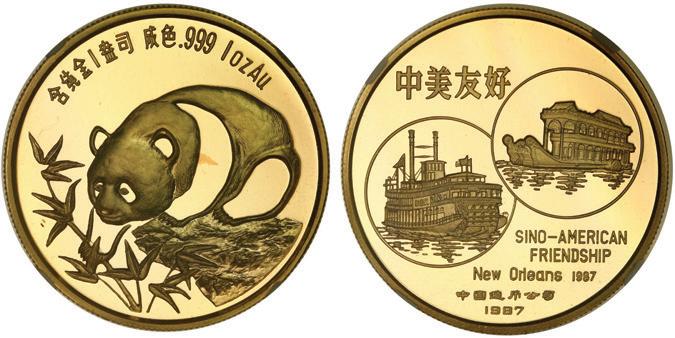
518. China (People’s Republic), gold 1 oz proof official Panda issue, 1987, 16th New York International Numismatic Convention, NGC PF 68 Ultra Cameo. KM-XMB18; PAN-64A. Toned to a slightly richer gold color than most. Mintage: 2,000 (planned; actual and surviving unknown). Perhaps popular with current owners or attendees of the long-running NYINC (labeled by NGC as NEW YORK EXPOSITION, also referred to as OFFICIAL PANDA ISSUE as opposed to MEDAL). Pedigreed to the Gansu Collection of Chi nese Panda Coinage. NGC #6472480-003. Estimate: $1,800-$2,600.


521. Mexico (United Mexican States), gold 1 oz proof Panda issue, 1987, fifth Birthday of Tohui, NGC PF 69 Ultra Cameo, finest known in NGC census. KM-unl. This is a Mexican bullion coin made in the style of the Chinese Panda series, ostensibly celebrating the 5th birthday of Mexico’s famous panda Tohui but also coinciding with the 5th anniversary of the Chinese Panda series. Only three examples currently appear in the NGC census, this being finest by two grades. Pedigreed to the Gansu Collection of Chinese Panda Coinage. NGC #6472528-012. Estimate: $1,800-$2,600.

519. China (People’s Republic), platinum 1 oz proof official Panda issue, 1987, 16th New York International Numismatic Convention, NGC PF 69 Ultra Cameo. KM-XMB19; PAN-65A. Mintage: 1,000 (planned; actual and surviving unknown). Perhaps popular with current owners or attendees of the long-running NY INC (labeled by NGC as NEW YORK EXPOSITION, also called an OFFICIAL PANDA ISSUE as opposed to MEDAL). Pedigreed to the Gansu Collection of Chinese Panda Coinage. NGC #6472480-004. Estimate: $2,000-$3,000.
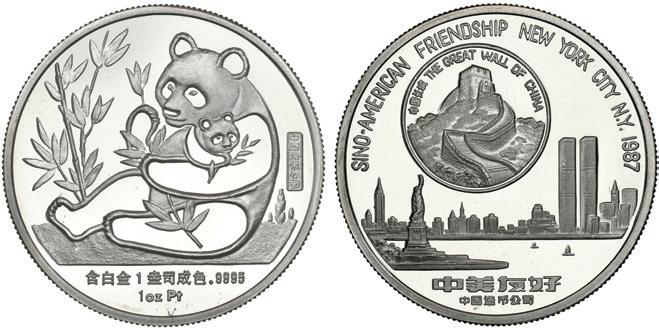
522. China (People’s Republic), platinum proof 100 yuan (1 oz) Panda, 1987 S, NGC PF 69 Ultra Cameo. KM-A163; PAN-51A. With S mintmark for Shanghai. Only one better (MS 70) at NGC. First of a four-year set of platinum 100 yuan that Anthony calls “both a challenge and a joy to assemble.” This date in particular Anthony calls: “a scarce coin but... rarer than the mintage suggests. During the mid-1990s there were times that the platinum content of this coin overshadowed its numismatic worth.” Mintage: 2,000 (planned; actual and surviving unknown). Pedigreed to the Gansu Collection of Chinese Panda Coinage. NGC #6472374-012. Estimate: $2,000-$3,000.

523. China (People’s Republic), silver proof 10 yuan (1 oz) Panda, 1987, NGC PF 69 Ultra Cameo. KM-167; PAN-58A. Whereas previous silver Pandas were in 0.900 silver, this year marks the first made in 0.999 fineness (hence exactly 1 troy ounce of silver). This issue also shows “excellent contrast between deep mirror fields and frosted devices” (Anthony). Currently only two are finer (at MS 69*) in the NGC census. Mintage: 31,000 (planned; actual and surviving unknown, but “much scarcer than that number [mintage] implies,” according to Anthony). Pedigreed to the Gansu Collection of Chinese Panda Coinage. NGC #2762422-001. Estimate: $300-$450.
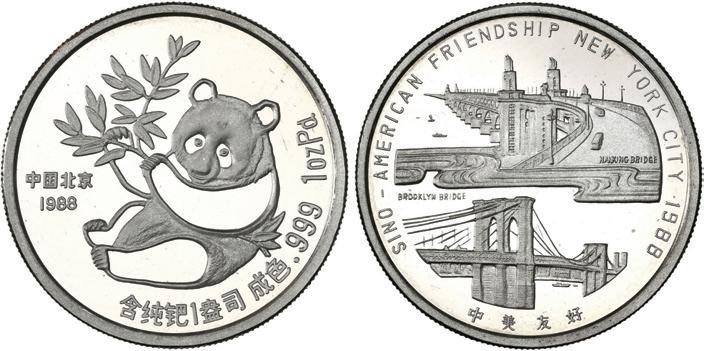

526. China (People’s Republic), gold 1 oz proof official Panda issue, 1988, Munich International Coins Fair, NGC PF 69 Ultra Cameo. KM-XMB25; PAN-91A. Only one graded higher (PF 70) by NGC. Mintage: 2,000 (planned; actual and surviving un known). While the name of the show was technically NUMISMATA, the Munich show in 1988 was specified on this coin as MUNICH INTERNATIONAL COINS FAIR (called Munich Coin Bourse by KM and MUNICH INT’L COIN SHOW by NGC). Pedigreed to the Gansu Collection of Chinese Panda Coinage. NGC #6472480-007. Estimate: $1,800-$2,600.
524. China (People’s Republic), gold 5 yuan (1/20 oz) Panda, 1988, NGC MS 70 (“top pop”). KM-221; PAN-73A. One of only 21 pieces at MS 70 in the current NGC census. A coin with a “history of attrition [for] in 1988 there was a single coin dealer shipping 10,000 of these Pandas each month to jewelry manufacturers” (Anthony). Mintage: 468,683 (but <27,000 extant). Pedigreed to the Gansu Collection of Chinese Panda Coinage. NGC #3502758-136. Estimate: $300-$450.


527. China (People’s Republic), gold 1 oz proof official Panda issue, 1988, New Orleans International Investors Conference, NGC PF 68 Ultra Cameo. KM-XMB31; PAN-85A. Similar to lot 517 above, this piece was misattributed by both KM and NGC as being issued for the ANA show that year (the actual ANA show was in Cincinnati--see next lot). Only six are finer (at MS 69) in the current NGC census. Mintage: 1,500 (planned; actual and surviving unknown). Curiously, the steamboat pictured on this piece clearly shows the name ROBT E LEE, probably the only time that name was ever connected with Chinese coins! Pedigreed to the Gansu Collection of Chinese Panda Coinage. NGC #6472480-008. Estimate: $1,600-$2,400.
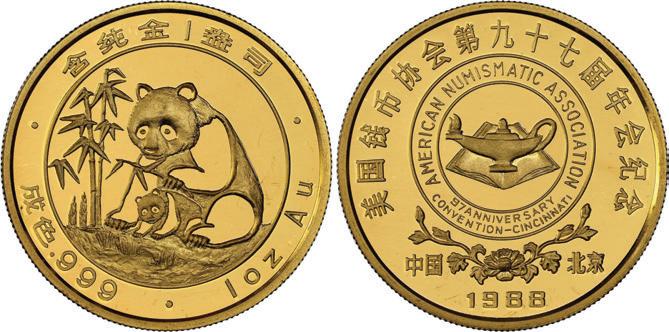
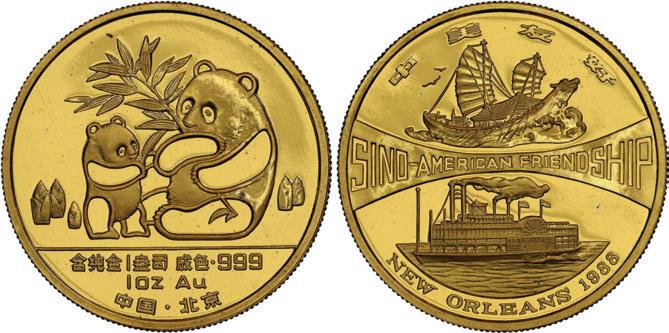
525. China (People’s Republic), palladium 1 oz proof official Panda issue, 1988, 17th New York International Numismatic Convention, NGC PF 68 Ultra Cameo. KM-XMB30; PAN-84A. The first issue of the Panda series to be struck in palladium, predating by one year the first palladium Panda coin (i.e., denominated)–perhaps this NYINC medal was a test of sorts? It is unclear why both Anthony and NGC refer to the event as NEW YORK EXPOSITION instead of the show’s proper name. Mintage: 1,000 (planned; actual and surviving unknown). Pedigreed to the Gansu Collection of Chinese Panda Coinage. NGC #6472480-006. Estimate: $2,000-$3,000.
528. China (People’s Republic), gold 1 oz proof official Panda issue, 1988, 97th ANA Convention Cincinnati, NGC PF 68 Ultra Cameo. KM-XMB29; PAN-87A. The central motif on the non-panda side of this beautiful piece is the ANA’s Lamp of Knowledge. Anthony: “The Cincinnati medal may well be the rarest gold Panda medal” due to the fact that by show time in August many dealers had already bought all the Pandas they wanted for the year and canceled their orders; of the 300 or so pieces delivered to the show, only 100 sold. Mintage: 1,000 planned but actual ~300. Pedigreed to the Gansu Collection of Chinese Panda Coinage. NGC #6472480-009. Estimate: $1,600-$2,400.
529. China (People’s Republic), gold 1 oz proof official Panda issue, 1988, Basel International Coin Week, NGC PF 68 Ultra Cameo. KMX-MB20; PAN-89A. For this low-mintage issue NGC changed from OFFICIAL PANDA ISSUE to OFFICIAL SHOW ISSUE for the label and census and placed it under their MED ALS category, unlike the other show issues for this year (the previous four lots, for example) and--crucially--the “Pt” error in the next lot. Mintage: 400 (estimated). Pedigreed to the Gansu Collection of Chinese Panda Coinage. NGC #6472480-011. Estimate: $1,800-$2,600.
532. China (People’s Republic), brass 32mm proof official Panda issue, 1988, Hong Kong Coin Exposition, NGC PF 69 Ultra Cameo (“top pop”). KM-unl; PAN-94A. As mentioned by Anthony, this brass issue was only given out to 100 or so dealers with tables at the show, so it may actually be the lowest-minted of the 1988 “show medals” series (here reverted to OFFICIAL PANDA ISSUE by NGC, none at higher grade). While the panda side is the same, the reverse of this issue is quite different from the gold. Mintage: <200 (actual). Pedigreed to the Gansu Collection of Chinese Panda Coinage. NGC #6472672-001. Estimate: $1,000-$1,500.
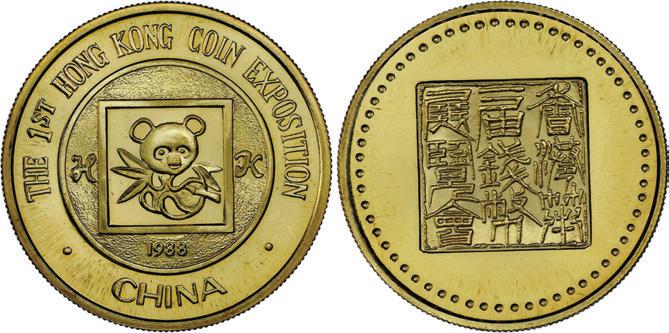

530. China (People’s Republic), gold 1 oz proof official Panda issue, 1988, Basel International Coin Week, “1 oz Pt” error, 1988, NGC PF 68 Ultra Cameo. KMX-MB21; PAN-90A. When browsing the NGC census for this error issue, one must search under PANDA SERIES as opposed to MEDALS per the previous lot, which is the same issue but struck with a proper gold die and not the platinum die (“Pt”) as we see here. Mintage: 600 (estimated), but supposedly only 298 pieces were put into circulation. Pedigreed to the Gansu Collection of Chinese Panda Coinage. NGC #6472480-012. Estimate: $1,800-$2,600.

533. China (People’s Republic), platinum proof 100 yuan (1 oz) Panda, 1988, NGC PF 69 Ultra Cameo. KM-192; PAN-76A. Only one graded higher (MS 70) by NGC. The second of a short, four-year date-set of platinum 100 yuan, struck in higher quantity than the previous year but no easier to obtain, largely due to the fact that so many were melted in the mid-1990s when their melt value exceeded their numismatic worth. Mintage: 3,000 (planned; actual and surviving unknown). Pedigreed to the Gansu Collection of Chinese Panda Coinage. NGC #6472374-013. Estimate: $2,000-$3,000.

531. China (People’s Republic), gold 1 oz proof official Panda issue, 1988, 1st Hong Kong Coin Exposition, NGC PF 69 Ultra Cameo. KM-XMB27; PAN-93A. Only one finer (MS 70) at NGC. For this issue as well (see lot 529 above), NGC categorizes it as OFFICIAL SHOW ISSUE instead of OFFICIAL PANDA ISSUE, but at least it does not appear under MEDALS! Mintage: 500, the lowest REPORTED mintage of the 1 oz medal series (planned; actual probably higher). Pedigreed to the Gansu Collection of Chinese Panda Coinage. NGC #6472480-010. Estimate: $4,000-$6,000.

534. China (People’s Republic), silver proof 50 yuan (5 oz) Panda, 1988, NGC PF 69 Ultra Cameo. KM-188; PAN-83A. Only two higher in NGC census at PF 69*. Lightly toned around rim. Anthony: “significantly scarcer than the 1987.” Mintage: 11,000 (planned; actual and surviving unknown). Pedigreed to the Gansu Collection of Chinese Panda Coinage. NGC #6472490-002. Estimate: $300-$450.
535. China (People’s Republic), silver proof 100 yuan (12 oz) Panda, 1988, NGC PF 69 Ultra Cameo. KM-189; PAN-77A. The first 12-oz silver Panda coin (i.e., denominated), less rare than later dates but “it is quite beautiful and is hardly a common coin” (Anthony). Mintage: 5,000 (planned; actual and surviving unknown). Pedigreed to the Gansu Collection of Chinese Panda Coinage. NGC #6472490-008. Estimate: $600-$900.


536. China (People’s Republic), gold 5 yuan (1/20 oz) Panda, 1989, small date (Shenyang mint), NGC MS 70 (“top pop”). KM-183; PAN-99B. One of only 34 pieces at MS 70 in the NGC census. Estimated extant population <5,500 from a reportedly much larger mintage that was surely overstated (and mostly put into jewelry, of course). Pedigreed to the Gansu Collection of Chinese Panda Coinage. NGC #3712218-068. Estimate: $300-$450.
537. China (People’s Republic), gold 10 yuan (1/10 oz) Panda, 1989, small date (Shenyang mint), NGC MS 69. KM223; PAN-98B. Estimated extant population <5,000 (from a much larger reported mintage that was probably overstated and mostly put into jewelry). Pedigreed to the Gansu Collection of Chinese Panda Coinage. NGC #6472366-012. Estimate: $300-$450.
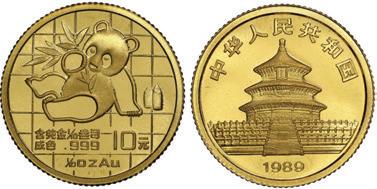

538. China (People’s Republic), gold 25 yuan (1/4 oz) Panda, 1989, small date (Shenyang mint), NGC MS 69. KM-224; PAN-97B. Only three higher at MS 70 in the current NGC census. Estimated extant population <3,500 from a much higher reported mintage (overstated), most of which became jewelry. Pedigreed to the Gansu Collection of Chinese Panda Coinage. NGC #6472366-013. Estimate: $500-$750.







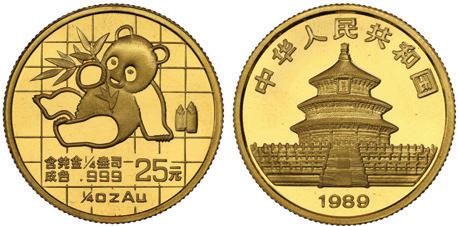
542. China (People’s Republic), gold 10 yuan Panda, 1989, large date (Shanghai mint), NGC MS 69. KM-223; PAN-98A. Only seven higher at MS 70 in the current NGC census. Estimated extant population <10,000. Pedigreed to the Gansu Collection of Chinese Panda Coinage. NGC #6472369-002. Estimate: $300-$450.
539. China (People’s Republic), gold 50 yuan (1/2 oz) Panda, 1989, small date (Shenyang mint), NGC MS 69. KM-226; PAN96B. Only one higher at MS 70 in the current NGC census. Estimated extant population <1,500 from a much larger reported mintage, prob ably overstated, that probably went into jewelry. Pedigreed to the Gansu Collection of Chinese Panda Coinage. NGC #6472366-014. Estimate: $700-$1,000.
543. China (People’s Republic), gold 25 yuan Panda, 1989, large date (Shanghai mint), NGC MS 69. KM-224; PAN-97A. Only one higher at MS 70 in the current NGC census. Estimated extant population <5,500 from a much higher reported mintage. Pedigreed to the Gansu Collection of Chinese Panda Coinage. NGC #6472369-003. Estimate: $600-$900.
540. China (People’s Republic), gold 100 yuan (1 oz) Panda, 1989, small date (Shenyang mint), NGC MS 69. KM-229; PAN95B. Only three higher at MS 70 in the current NGC census. Estimated extant population <4,500, the reported (but overstated) mintage much higher. Pedigreed to the Gansu Collection of Chinese Panda Coinage. NGC #6472366-015. Estimate: $1,800-$2,600.
544. China (People’s Republic), gold 50 yuan Panda, 1989, large date (Shanghai mint), NGC MS 69. KM-226; PAN-96A. Only one higher at MS 70 in the current NGC census. Estimated extant population <4,500 from a much higher reported mintage. Pedigreed to the Gansu Collection of Chinese Panda Coinage. NGC #3967049-003. Estimate: $1,000-$1,500.
541. China (People’s Republic), gold 5 yuan Panda, 1989, large date (Shanghai mint), NGC MS 69. KM-183; PAN-99A. Only nine higher at MS 70 in the current NGC census. Estimated extant population <21,500. Pedigreed to the Gansu Collection of Chinese Panda Coinage. NGC #6472369-001. Estimate: $200-$300.
545. China (People’s Republic), gold 100 yuan Panda, 1989, large date (Shanghai mint), NGC MS 69 (“top pop”). KM-229; PAN-95A. None at MS 70 in the current NGC census. Estimated extant population <6,500 from a much higher reported mintage. Pedigreed to the Gansu Collection of Chinese Panda Coinage. NGC #6472369-005. Estimate: $2,000-$3,000.
546. China (People’s Republic), silver proof 10 yuan (1 oz) Panda, 1989, NGC PF 70 Ultra Cameo (“top pop”). KM-A221; PAN-110A. One of only 45 pieces at MS 70 in the current NGC census. Anthony: “a very pretty addition to any collection.” Mintage: 25,000 (planned; actual and surviving unknown). Pedigreed to the Gansu Collection of Chinese Panda Coinage. NGC #3480512-007. Estimate: $400-$600.
550. China (People’s Republic), gold 1/4 oz proof official Panda issue, 1989, 18th New York International Numismatic Convention, NGC PF 69 Ultra Cameo. KM-XMB54; PAN-115A. As it did for the 1988 issue, NGC refers to this as NEW YORK EXPO SITION, but properly under the Panda Series as opposed to Medals. Mintage: 5,000 (planned; actual and surviving unknown). Pedigreed to the Gansu Collection of Chinese Panda Coinage. NGC #6472488-002. Estimate: $500-$750.

547. China (People’s Republic), palladium proof 50 yuan (1 oz) Panda, 1989, NGC PF 68 Ultra Cameo. KM-227; PAN-108A. The first palladium Panda coin (i.e., denominated), its population reduced by meltage in the 1990s, but also a “something of an orphan” (Anthony) since after this year palladium was discontinued until 2004. Mintage: 2,000 (planned; actual and surviving unknown). Pedigreed to the Gansu Collection of Chinese Panda Coinage. NGC #6472388-010. Estimate: $2,000-$3,000.

551. China (People’s Republic), palladium 1 oz proof official Panda issue, 1989, 98th ANA Convention - Pittsburgh, NGC PF 69 Ultra Cameo (“top pop”). KM-XMB52; PAN-117A. None at MS 70 in the current NGC census. Mintage: 1,000 (planned; esti mated <500 extant). Anthony: “The mintage of the 1989 palladium ANA Panda medals is lower than reported.” Pedigreed to the Gansu Collection of Chinese Panda Coinage. NGC #6472480-013. Estimate: $2,000-$3,000.
548. China (People’s Republic), platinum proof 100 yuan (1 oz) Panda, 1989, NGC PF 69 Ultra Cameo. KM-230; PAN-105A. Penultimate date of a short, four-year set in platinum. Mintage: 3,000 (planned; est <1,500 extant). Pedigreed to the Gansu Collection of Chi nese Panda Coinage. NGC #6472374-014. Estimate: $2,000-$3,000.



549. China (People’s Republic), gold 1/10 oz proof official Panda is sue, 1989, China-Japan Friendship, NGC PF 69 Ultra Cameo. KM-XMB41; PAN-111A. Only five higher at PF 70 in the current NGC census. Mintage: 30,000 (planned; actual and surviving unknown). KM and some catalogers misattribute this Sino-Japanese Friendship issue as “Tokyo International Coin Show.” Pedigreed to the Gansu Collection of Chinese Panda Coinage. NGC #6472488-001. Estimate: $200-$300.
552. China (People’s Republic), gold 1/2 oz proof official Panda issue, 1989 Y, 2nd Hong Kong Coin Exposition, NGC PF 69 Ultra Cameo. KM-XMB43; PAN-113A. Only one higher at PF 70 in current NGC census. As Anthony points out, this medal “has no English inscription to identify it; not even an obvious date,” caus ing some to misattribute it as simply GREAT WALL OF CHINA instead of Hong Kong. Mintage: 1,300 (planned; actual and surviving unknown). Pedigreed to the Gansu Collection of Chinese Panda Coinage. NGC #6472480-014. Estimate: $900-$1,350.

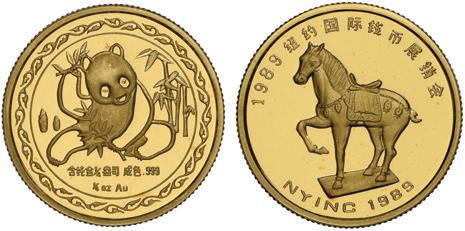
553. China (People’s Republic), gold 1/2 oz proof official Panda issue, 1989, Munich International Coin Fair, NGC PF 69 Ultra Cameo. KM-XMB44; PAN-112A. Only seven higher at PF 70 in current NGC census. Mintage: 1,500 (planned; actual and surviving unknown). While the name of the show was technically NUMISMATA, the Munich show in 1989 was specified on this coin as MUNICH INTERNATIONAL COINS FAIR (called Munich International Coin Exposition by KM and MUNICH INT’L COIN SHOW by NGC). Pedigreed to the Gansu Collection of Chinese Panda Coinage. NGC #6472480-015. Estimate: $900-$1,350. 554. China (People’s Republic), gold 5 yuan (1/20 oz) Panda, 1990, small date (Shenyang mint), NGC MS 69. KM-268; PAN-122B. Anthony: “scarcer than most of the years that preceded it,” the small-date variety being “the scarcer of the two 1990 gold Panda varieties,” with only four higher at MS 70 in the current NGC census for just the variety. Estimated extant population <6,500. Pedigreed to the Gansu Collection of Chinese Panda Coinage. NGC #6472369-006. Estimate: $160-$240. 555. China (People’s Republic), gold 10 yuan (1/10 oz) Panda, 1990, small date (Shenyang mint), NGC MS 69. KM-269; PAN-121B. An thony: “scarcer than most of the years that preceded it,” the small-date variety being “the scarcer of the two 1990 gold Panda varieties,” with only one higher at MS 70 in the current NGC census for just the variety. Estimated extant population <2,750. Pedigreed to the Gansu Collection of Chinese Panda Coinage. NGC #6472369-007. Estimate: $250-$375.
557. China (People’s Republic), gold 50 yuan (1/2 oz) Panda, 1990, small date (Shenyang mint), NGC MS 69. KM271; PAN-119B. Anthony: “scarcer than most of the years that preceded it,” the small-date variety being “the scarcer of the two 1990 gold Panda varieties,” with just one higher at MS 70 in the current NGC census. Estimated extant population <1,200. Pedigreed to the Gansu Collection of Chinese Panda Coinage. NGC #6472369-009. Estimate: $1,000-$1,500.

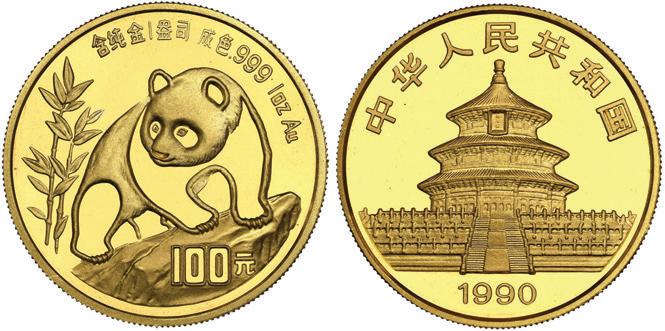


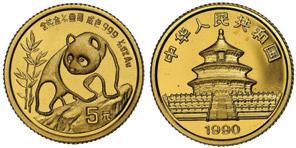

556. China (People’s Republic), gold 25 yuan (1/4 oz) Panda, 1990, small date (Shenyang mint), NGC MS 69 (“top pop”). KM-270; PAN-120B. Anthony: “scarcer than most of the years that pre ceded it,” the small-date variety being “the scarcer of the two 1990 gold Panda varieties” (none at MS 70 in the current NGC census, except for one whose variety was not determined). Estimated extant population <2,400. Pedigreed to the Gansu Collection of Chinese Panda Coinage. NGC #6472369-008. Estimate: $500-$750.
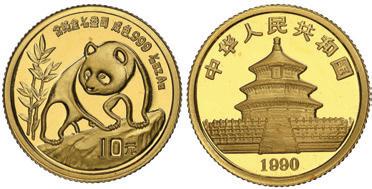

558. China (People’s Republic), gold 100 yuan (1 oz) Panda, 1990, small date (Shenyang mint), NGC MS 68. KM-272; PAN-118B. Anthony: “scarcer than most of the years that preceded it,” the small-date variety being “the scarcer of the two 1990 gold Panda varieties.” Estimated extant population <1,900. Pedigreed to the Gansu Collection of Chinese Panda Coinage. NGC #6472369-010. Estimate: $1,600-$2,400. 559. China (People’s Republic), gold 5 yuan (1/20 oz) Panda, 1990, large date (Shanghai mint), NGC MS 70 (“top pop”). KM-268; PAN-122A. One of only 54 pieces at MS 70 in the current NGC census. Anthony: “scarcer than most of the years that preceded it.” Estimated extant population <13,500. Pedigreed to the Gansu Collection of Chinese Panda Coinage. NGC #3881159-008. Estimate: $250-$375. 560. China (People’s Republic), gold 10 yuan (1/10 oz) Panda, 1990, large date (Shanghai mint), NGC MS 69. KM-269; PAN-121A. An thony: “scarcer than most of the years that preceded it.” Estimated extant population <10,750. Pedigreed to the Gansu Collection of Chinese Panda Coinage. NGC #6472369-012. Estimate: $220-$350.
561. China (People’s Republic), gold 25 yuan (1/4 oz) Panda, 1990, large date (Shanghai mint), NGC MS 69. KM-270; PAN120A. Anthony: “scarcer than most of the years that preceded it.” Esti mated extant population <3,600. Pedigreed to the Gansu Collection of Chinese Panda Coinage. NGC #6472369-013. Estimate: $450-$700.

562. China (People’s Republic), gold 50 yuan (1/2 oz) Panda, 1990, large date (Shanghai mint), NGC MS 69. KM-271; PAN119A. Anthony: “scarcer than most of the years that preceded it,” with only ten higher at MS 70 in current NGC census. Estimated extant population <2,800. Pedigreed to the Gansu Collection of Chinese Panda Coinage. NGC #6472369-014. Estimate: $1,000-$1,500.
566. China (People’s Republic), platinum proof 50 yuan (1/2 oz) Panda, 1990, NGC PF 69 Ultra Cameo. KM-279; PAN-132A. Unique design, as is the case for the smaller platinum Panda coins for this year; but unlike the lower denominations, the entire mintage of 50 yuan (the only 1/2 oz platinum Panda from the China Mint) was put into three-coin denomination sets, and therefore it is scarce individually, especially considering meltage in the 1990s. Mintage: 2,500 (planned; actual and surviving unknown but certainly much less). Pedigreed to the Gansu Collection of Chinese Panda Coinage. NGC #3596034-009. Estimate: $800-$1,200.



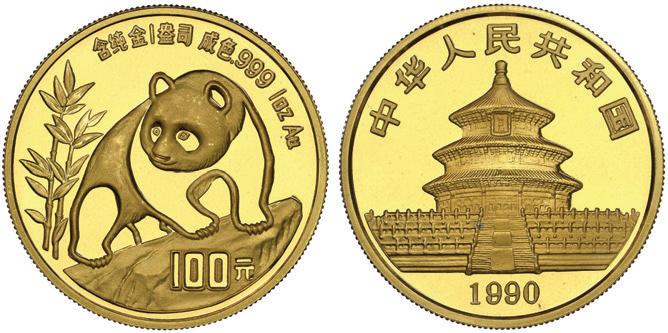
563. China (People’s Republic), gold 100 yuan (1 oz) Panda, 1990, large date (Shanghai mint), NGC MS 68. KM-272; PAN-118A. Anthony: “scarcer than most of the years that preceded it.” Estimated extant population <6,100. Pedigreed to the Gansu Collection of Chinese Panda Coinage. NGC #6472369-015. Estimate: $1,600$2,400.
564. China (People’s Republic), platinum proof 10 yuan (1/10 oz) Panda, 1990, NGC PF 69 Ultra Cameo. KM-277; PAN-135A. This issue marks the first platinum 10 Yuan in the series, with its own unique design (as opposed to later years in which the design is the same as for the gold). Only seven higher at PF 70 in the current NGC census. Mintage: 4,500 (planned; actual and surviving unknown but certainly much less due to meltage in the 1990s). Pedigreed to the Gansu Collection of Chinese Panda Coinage. NGC #3596034-003. Estimate: $300-$450.

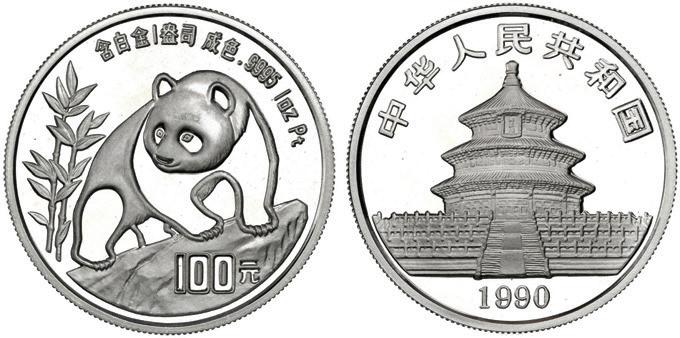
567. China (People’s Republic), platinum proof 100 yuan (1 oz) Panda, 1990, NGC PF 68 Ultra Cameo. KM-280; PAN-129A. The final date of a four-year set in platinum, in fact “the key to this short series” (Anthony), due to technical problems in minting, but also due to meltage in the 1990s. Mintage: 1,300 planned, but only 800 or so actually struck. Pedigreed to the Gansu Collection of Chinese Panda Coinage. NGC #6472374-015. Estimate: $1,800-$2,600.
565. China (People’s Republic), platinum proof 25 yuan (1/4 oz) Panda, 1990, NGC PF 69 Ultra Cameo. KM-278; PAN-134A. Anthony: “the only 1/4 oz. platinum Panda from the China Mint,” its design unique, with only eight higher at PF 70 in the current NGC census. Mintage: 3,500 (planned; actual and surviving unknown but certainly much less due to meltage in the 1990s). Pedigreed to the Gansu Collection of Chinese Panda Coinage. NGC #3637801-093. Estimate: $400-$600.
568. China (People’s Republic), bimetallic proof 50 yuan (1/2 oz gold, 1/5 oz silver) Panda, 1990, NGC PF 69 Ultra Cameo (“top pop”). KM-281; PAN-133A. Anthony: “The Mint brought a new type of Panda to the 3rd Hong Kong Coin Exposition in 1990… This multi-metallic style has developed a strong following among Panda afficionados.” None appear in MS 70 in the current NGC census. Mintage: 2,000 (all sold at the Hong Kong show in 1990). Pedigreed to the Gansu Collection of Chinese Panda Coinage. NGC #6472488-004. Estimate: $1,200-$1,800.

569. China (People’s Republic), bimetallic 36mm proof official Panda issue, 1990, 3rd Hong Kong International Coin Convention, NGC PF 68 Ultra Cameo. KM-XMB62; PAN-138A. Nicely toned on the silver ring. Along with the famous first bimetallic Panda coin, the China Mint also made this nondenominated issue for the Hong Kong show in 1990, presumably in the same quantity. Listed in KM as “7/10 ounce.” Mintage: 2,000 (planned; actual and surviving unknown). Pedigreed to the Gansu Collection of Chinese Panda Coinage. NGC #6472488-003. Estimate: $1,000-$1,500.
570. China (People’s Republic), gold 1/2 oz proof official Panda issue, 1990, Munich International Coin Fair, NGC PF 68 Ultra Cameo. KM-XMB60; PAN-140A. As mentioned previously, this issue bears the lettering MUNICH INTERNATIONAL COINS FAIR (which NGC calls SHOW and KM calls EXPOSITION) despite the show’s proper name of NUMISMATA. Mintage: 1,500 (planned; actual and surviving unknown). Pedigreed to the Gansu Collection of Chinese Panda Coinage. NGC #6472488-005. Estimate: $800-$1,200.
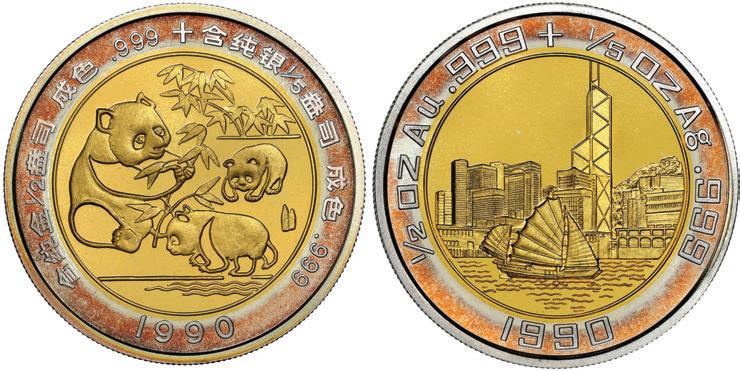
571. China (People’s Republic), gold 1 oz proof official Panda issue, 1990, 19th Zurich International Coin Exposition, NGC PF 67 Ultra Cameo. KMunl; PAN-139A. Spots of light red toning on rim. Very low mintage and even fewer extant. Mintage: 550 (planned; estimated <450 extant). Pedigreed to the Gansu Collection of Chinese Panda Coinage. NGC #6472488-006. Estimate: $1,800-$2,600.
572. China (People’s Republic), gold proof 50 yuan (1/2 oz) Panda, 1990 P, NGC PF 69* Ultra Cameo. KM-271; PAN-125A. Designed with a P for Proof to the right of the panda. This is the sole PF 69 example with star designation at NGC, with just eight higher at PF 70 in the current census. Mintage: 5,000 (planned; actual and surviving unknown). Pedigreed to the Gansu Collection of Chinese Panda Coinage. NGC #6472458-009. Estimate: $1,500-$2,250.




573. China (People’s Republic), gold proof 100 yuan (1 oz) Panda, 1990 P, NGC PF 69 Ultra Cameo. KM-272; PAN-124A. Only four higher at PF 70 in the current NGC census. With P for Proof to the right of the panda. Mintage: 5,000 (planned; actual and surviving unknown). Pedigreed to the Gansu Collection of Chinese Panda Coinage. NGC #6472458-010. Estimate: $1,800-$2,600.
574. China (People’s Republic), silver proof 50 yuan (5 oz) Panda, 1990, NGC PF 69 Ultra Cameo (“top pop”). KM-273; PAN-131A. None higher at PF 70 in the current NGC census. Mintage: 5,000 (planned; actual and surviving unknown). Pedigreed to the Gansu Collection of Chinese Panda Coinage. NGC #6472490-004. Estimate: $500-$750.

575. China (People’s Republic), silver proof 100 yuan (12 oz) Panda, 1990, NGC PF 68 Ultra Cameo. KM-274; PAN-130A. None higher at PF 70 in the current NGC census. Mintage: 2,500 (planned; actual and surviving unknown). Pedigreed to the Gansu Collection of Chinese Panda Coinage. NGC #6472490-010. Estimate: $450-$700.

576. China (People’s Republic), gold 3 yuan (1 gram) Panda, 1991, (10th Anniversary of the Issuance of Chinese Panda Commemorative Coins), NGC MS 69. KM-351; PAN-161A. Officially the smallest coin in the Panda series, most of which “found their way into jewelry or other promotional items… an MS69 example is a superior find” (Anthony). Only 17 higher at MS 70 in the current NGC census. Mintage: 110,000, but 100,000 of those were sold in Pandagram cards sent mostly to noncollectors (actual surviving unknown). Pedigreed to the Gansu Collection of Chinese Panda Coinage. NGC #6472374-001. Estimate: $150-$225.


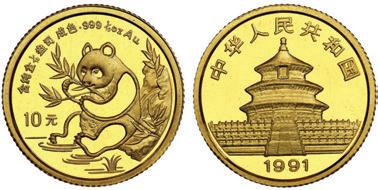


577. China (People’s Republic), gold 5 yuan (1/20 oz) Panda, 1991, small date (Shenyang mint), NGC MS 69. KM-346; PAN-146B. Only four higher at MS 70 in the current NGC census. Most of the issue must have been melted or put into jewelry, as only about 6% are estimated to have survived. Mintage (for both mints): 206,254 (but estimated extant population for this variety <8,500). Pedigreed to the Gansu Collection of Chinese Panda Coinage. NGC #6472374-002. Estimate: $160-$240.
578. China (People’s Republic), gold 10 yuan (1/10 oz) Panda, 1991, small date (Shenyang mint), NGC MS 68. KM-347; PAN-145B. Most of the issue must have been melted or put into jewelry, as only about 9% are estimated to have survived. Mintage (for both mints): 81,792 (but estimated extant population for this variety <5,200). Pedigreed to the Gansu Collection of Chinese Panda Coinage. NGC #6472374-003. Estimate: $200-$300.
579. China (People’s Republic), gold 25 yuan (1/4 oz) Panda, 1991, small date (Shenyang mint), NGC MS 69. KM-359; PAN-144B. Only ten higher at MS 70 in the current NGC census, less than 10% of the original minting estimated to have survived due to meltage and jewelry use. Mintage (for both mints): 54,548 (but estimated extant population for this variety <3,500). Pedigreed to the Gansu Collection of Chinese Panda Coinage. NGC #6472374-004. Estimate: $500-$750. 580. China (People’s Republic), gold 50 yuan (1/2 oz) Panda, 1991, small date (Shenyang mint), obverse struck through fiber NGC, Mint Error MS 69. KM-349; PAN143B. Eye-catching error with curly fiber emanating from the right side of the Temple. About the 1991 gold 50 yuan regular issue, Anthony says: “notably hard to find, especially in nice shape,” the estimated survival rate being less than 8%. Only two higher in MS 70 in the current NGC census. Mintage (for both mints): 32,717 (but estimated extant population for this variety <1,400). Pedigreed to the Gansu Collection of Chinese Panda Coinage. NGC #6472374-005. Estimate:
$1,000-$1,500.
581. China (People’s Re public), gold 100 yuan (1 oz) Panda, 1991, small date (Shenyang mint), NGC MS 68. KM-350; PAN-142B. Yet another gold issue that saw great attrition to meltage and jewelry use. Mintage (for both mints): 36,367 (but estimated extant population for this variety <3,900). Pedigreed to the Gansu Collection of Chinese Panda Coinage. NGC #6472374-006. Estimate: $1,600-$2,400.
582. China (People’s Republic), gold 5 yuan (1/20 oz) Panda, 1991, large date (Shanghai mint), NGC MS 69. KM-346; PAN-146A. Scarcer than the small-date variety, from an issue of which only about 6% are estimated to have escaped meltage and jewelry use. Mintage (for both mints): 206,254 (but estimated extant population for this variety <4,000). Pedigreed to the Gansu Collection of Chinese Panda Coinage. NGC #6472374-007. Estimate: $140-$220.

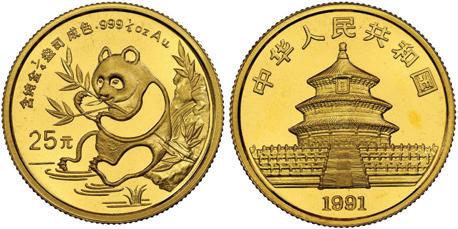


583. China (People’s Republic), gold 10 yuan (1/10 oz) Panda, 1991, large date (Shanghai mint), NGC MS 69. KM-347; PAN-145A. Much scarcer than the small-date variety, with only eleven higher at MS 70 in the current NGC census, among an estimated 9% of this issue that escaped melt age and jewelry use. Mintage (for both mints): 81,792 (but estimated extant population for this variety <2,200). Pedigreed to the Gansu Collection of Chinese Panda Coinage. NGC #6472374-008. Estimate: $200-$300.

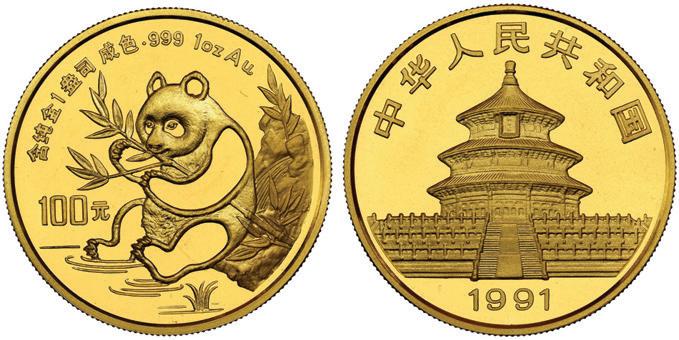
584. China (People’s Re public), gold 25 yuan (1/4 oz) Panda, 1991, large date (Shanghai mint), NGC MS 69. KM-359; PAN-144A. Much scarcer than the small-date variety, with only fourteen higher at MS 70 in the current NGC census, among less than 10% of the mintage estimated to have escaped meltage and jewelry use. Mintage (for both mints): 54,548 (but estimated extant population for this variety <1,600). Pedigreed to the Gansu Collection of Chinese Panda Coinage. NGC #6472374-009. Estimate: $500-$750.
585. China (People’s Republic), gold 50 yuan (1/2 oz) Pan da, 1991, large date (Shanghai mint), NGC MS 69. KM-349; PAN-143A. Much scarcer than the small-date variety, with only five higher at MS 70 in the current NGC census, among less than 8% of the mintage estimated to have escaped meltage and jewelry use. Mintage (for both mints): 32,717 (but estimated extant population for this variety <1,100). Pedigreed to the Gansu Collection of Chinese Panda Coinage. NGC #6472374-010. Estimate: $1,200-$1,800.
586. China (People’s Re public), gold 100 yuan (1 oz) Panda, 1991, large date (Shanghai mint), NGC MS 69. KM-350; PAN-142A. Slightly scarcer than the small-date variety, with only seven higher at MS 70 in the current NGC census. Mintage (for both mints): 36,367 (but estimated extant population for this variety <3,100). Pedigreed to the Gansu Collection of Chinese Panda Coinage. NGC #6472374-011. Estimate: $2,000-$3,000.
587. China (People’s Republic), gold proof five-coin Panda denomination set (5, 10, 25, 50 and 100 yuan), 1991 P, all NGC PF 69 Ultra Cameo. KM-346, 347, 349, 350, 359; PAN-152A, 151A, 150A, 149A, 148A. With P for Proof appearing behind the panda’s head. The Proof issues were made in much smaller numbers than the regular issues, due to lower demand; most are still usually found in sets, as we see here, with very few (zero to five) of each denomination known in higher PF 70 grade in the current NGC census. Mintage: 3,500 sets (planned; actual and surviving unknown). Pedigreed to the Gansu Collection of Chinese Panda Coinage. NGC #6472458-011, 6472458-012, 6472458-013, 6472458-014, 6472458-015. Estimate: $3,500-$5,000.

588. China (People’s Republic), bimetallic proof 25 yuan (1/4 oz gold, 1/8 oz silver) Panda, 1991, NGC PF 68 Ultra Cameo. KM-348; PAN-159A. The second year of this bimetallic issue, made in just one denomination specifically for the Hong Kong show (not mentioned by NGC or KM), which also received the release of a non-denominated bimetallic issue (next lot). Curiously, on this piece the inner design does not quite line up with the transition between the metals. Mintage: 10,000 (planned; actual and surviving unknown). Pedigreed to the Gansu Collection of Chinese Panda Coinage. NGC #6472488-007. Estimate: $700-$1,000.


591. China (People’s Republic), gold proof piefort 50 yuan (1 oz) Panda, 1991, 10th Anniversary of the Issuance of Chinese Panda Commemorative Coins, NGC PF 69 Ultra Cameo (“top pop”). KM-357; PAN-158A. One of only two double-thickness issues in the entire Panda series (the other being the next lot in silver), both struck this year to commemorate the 10th anniversary of Panda coinage. Anthony: The piefort 50 Yuan “stands out as the sole 1 oz. gold Panda with less than 100 Yuan in face value” and “commands a price several times higher than its intrinsic gold value.” None in PF 70 in the current NGC census. Mintage: 2,500 (planned; actual and surviving unknown). Pedigreed to the Gansu Collection of Chinese Panda Coinage. NGC #3835390-010. Estimate: $3,000-$4,500.


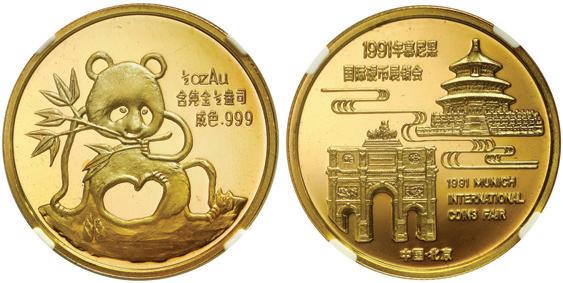
589. China (People’s Republic), bimetallic proof official Panda issue, 1/4 oz gold, 1/8 oz silver, 1991, Hong Kong International Coin Convention, NGC PF 69 Ultra Cameo. KM-XMB67; PAN-162A. Only one higher at PF 70 in the current NGC census (which calls it HONG KONG EXPO), listed in KM as “3/8 ounce.” Mintage: 2,000 (planned; actual and surviving unknown). Pedigreed to the Gansu Collection of Chinese Panda Coinage. NGC #6472488-008. Estimate: $700-$1,000.
590. China (People’s Republic), gold 1/2 oz proof official Panda issue, 1991, Munich International Coin Fair, NGC PF 68 Ultra Cameo. KM-XMB69; PAN-166A. As mentioned previously, this issue bears the lettering MUNICH INTERNATIONAL COINS FAIR (which NGC calls SHOW) despite the show’s proper name of NUMISMATA. Mintage: 1,500 (planned; actual and surviving un known). Pedigreed to the Gansu Collection of Chinese Panda Coinage. NGC #6472488-009. Estimate: $800-$1,200.
592. China (People’s Republic), silver proof piefort 10 yuan (2 oz) Panda, 1991, 10th Anniversary of the Issuance of Chinese Panda Commemorative Coins, NGC PF 69 Ultra Cameo. KM-356; PAN-160A. Starting to tone around the rims. One of only two double-thickness issues in the entire Panda series (the other being the previous lot in gold), both struck this year to commemorate the 10th anniversary of Panda coinage. Only two higher at PF 70 in the current NGC census. Mintage: 10,000 (planned; actual and surviving unknown). Pedigreed to the Gansu Collection of Chinese Panda Coinage. NGC #2131514-001. Estimate: $300-$450.
593. China (People’s Republic), silver proof 100 yuan (12 oz) Panda, 1991, NGC PF 69 Ultra Cameo (“top pop”). KM-352; PAN-153A. Commonest grade in the current NGC census but none higher at MS 70. Mintage: 2,500 (planned; actual and surviving unknown). Pedigreed to the Gansu Collection of Chinese Panda Coinage. NGC #6472490-011. Estimate: $600-$900.

594. China (People’s Republic), gold 5 yuan (1/20 oz) Panda, 1992, small date (Shenyang mint), NGC MS 69 (Red China Label). KM-391; PAN-172B. “There are no common coins or medals from this year” and “the 1992 gold Small Date is by no means a common coin,” says Anthony, who does not venture to guess surviving populations of the two different varieties due to errors in attribution, since they are very hard to tell apart, but overall less than 4% due to meltage and jewelry use. Mintage for both varieties: 216,305 (actual), with an estimated <8,500 surviving. Pedigreed to the Gansu Collection of Chinese Panda Coinage. NGC #3595757-018. Estimate: $150-$225.
595. China (People’s Republic), gold 10 yuan (1/10 oz) Panda, 1992, small date (Shenyang mint), NGC MS 69. KM-392; PAN-171B. “There are no common coins or medals from this year” and “the 1992 gold Small Date is by no means a common coin,” says Anthony, who does not venture to guess surviving populations of the two different varieties due to errors in attribution, since they are very hard to tell apart, but overall no more than about 6.5% due to meltage and jewelry use. Mintage for both varieties: 116,999 (actual), with an estimated <7,500 surviving. Pedigreed to the Gansu Collection of Chinese Panda Coinage. NGC #6472388-002. Estimate: $200-$300. 596. China (People’s Republic), gold 25 yuan (1/4 oz) Panda, 1992, small date (Shenyang mint), NGC MS 69. KM-393; PAN-170B. Only five higher at MS 70 in the current NGC census. “There are no common coins or medals from this year” and “the 1992 gold Small Date is by no means a common coin,” says Anthony, who does not venture to guess surviving populations of the two different varieties due to errors in attribution, since they are very hard to tell apart, but overall less than 6.5% due to meltage and jewelry use. Mintage for both varieties: 72,527 (actual), with an estimated <4,500 surviving. Pedigreed to the Gansu Collection of Chinese Panda Coinage. NGC #3593823-026. Estimate: $500-$750. 597. China (People’s Republic), gold 50 yuan (1/2 oz) Panda, 1992, small date (Shenyang mint), NGC MS 68. KM-476; PAN-169B. “There are no common coins or medals from this year” and “the 1992 gold Small Date is by no means a common coin,” says Anthony, who does not venture to guess surviving populations of the two different varieties due to errors in attribution, since they are very hard to tell apart. Mintage for both varieties: 35,000 planned, 26,495 actual, with an estimated <3,000 surviving. Pedigreed to the Gansu Collection of Chinese Panda Coinage. NGC #6472388-007. Estimate: $800-$1,200. 598. China (People’s Republic), gold 100 yuan (1 oz) Panda, 1992, small date (Shenyang mint), NGC MS 69. KM-395; PAN-168B. Only two higher at MS 70 in the current NGC census. “There are no common coins or medals from this year” and “the 1992 gold Small Date is by no means a common coin,” says Anthony, who does not venture to guess surviving populations of the two different varieties due to errors in attribution, since they are very hard to tell apart. Mintage for both varieties: 35,000 planned, 41,120 actual, with an estimated <9,000 surviving. Pedigreed to the Gansu Collection of Chinese Panda Coin age. NGC #6472388-008. Estimate: $1,800-$2,600.


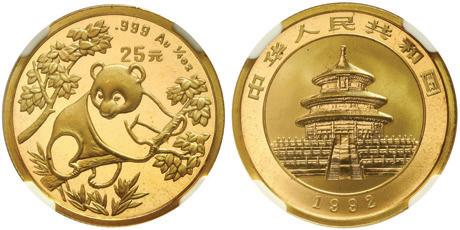

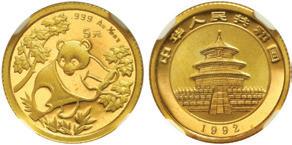
599. China (People’s Republic), gold 10 yuan (1/10 oz) Panda, 1992, large date (Shanghai mint), NGC MS 69. KM-392; PAN-171A. “There are no common coins or medals from this year” and “the 1992 gold Large Date is by no means a common coin,” says Anthony, who does not venture to guess surviving populations of the two different varieties due to errors in attribution, since they are very hard to tell apart, but overall no more than about 6.5% due to meltage and jewelry use. Mintage for both varieties: 116,999 (actual), with an estimated <7,500 surviving. Pedigreed to the Gansu Collection of Chinese Panda Coinage. NGC #6472388-006. Estimate: $200-$300. 600. China (People’s Republic), gold 50 yuan (1/2 oz) Panda, 1992, large date (Shang hai mint), NGC MS 69. KM-476; PAN-170A. Only six higher at MS 70 in the current NGC census. “There are no common coins or medals from this year” and “the 1992 gold Large Date is by no means a common coin,” says Anthony, who does not venture to guess surviving populations of the two different varieties due to errors in attribution, since they are very hard to tell apart. Mintage for both varieties: 35,000 planned, 26,495 actual, with an estimated <3,000 surviving. Pedigreed to the Gansu Collection of Chinese Panda Coinage. NGC #6472388-004. Estimate: $900-$1,350. 601. China (People’s Republic), gold 100 yuan (1 oz) Panda, 1992, large date (Shanghai mint), NGC MS 69. KM-395; PAN-169A. Only eleven higher at MS 70 in the current NGC census. “There are no common coins or medals from this year” and “the 1992 gold Large Date is by no means a common coin,” says Anthony, who does not venture to guess surviving populations of the two different varieties due to errors in attribution, since they are very hard to tell apart. Mintage for both varieties: 35,000 planned, 41,120 actual, with an estimated <9,000 surviving. Pedigreed to the Gansu Collection of Chinese Panda Coin age. NGC #6472388-005. Estimate: $1,800-$2,600. 602. China (People’s Republic), bimetallic proof 10 yuan (1/10 oz gold, 1/28 oz silver) Panda, 1992, NGC PF 68 Ultra Cameo. KM-396; PAN-168A. Deeply rainbow-toned outer ring (silver), creating a unique effect on this first smaller-size bimetallic coin in the Panda series. “There are no common coins or medals from this year” says Anthony, who does not state an actual mintage or venture to guess a surviving population from the planned mintage of 2000. Pedigreed to the Gansu Collection of Chinese Panda Coinage. NGC #6472388-009. Estimate: $700-$1,000.
603. China (People’s Republic), gold proof five-coin Panda denomination set (5, 10, 25, 50 and 100 yuan), 1992 P, all NGC PF Ultra Cameo, 68, 68, 69, 69 and 67 respectively. KM-PS38; PAN-179A, 178A, 177A, 176A, 175A. With P for Proof below the panda’s lower paw. For this year Anthony says: “All gold proofs are recognized as very scarce and much sought after,” their low mint age making them “keys to forming a set of proof Pandas.” Mintage: 2,000 sets authorized but only 806 actually issued. Pedigreed to the Gansu Collection of Chinese Panda Coinage. NGC #6472460-001, 6472460-002, 6472460-003, 6472460-004, 6472460-005. Estimate:
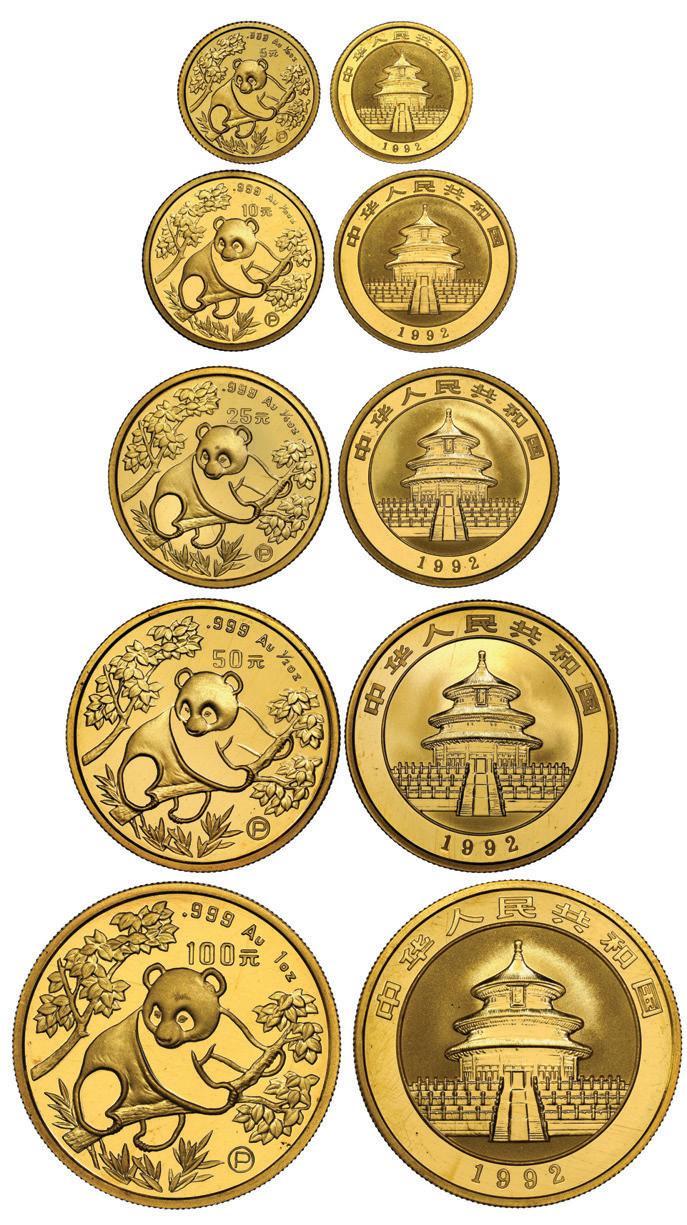
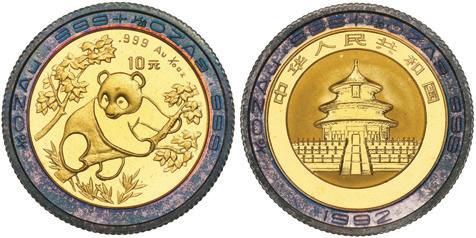

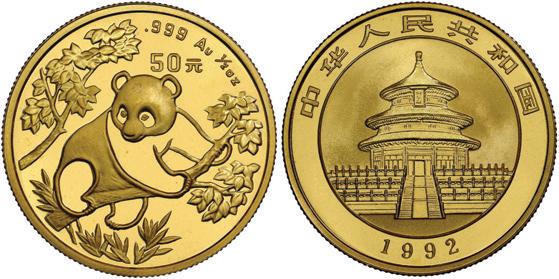

$5,000-$7,500.
604. China (People’s Republic), silver proof 50 yuan (5 oz) Panda, 1992, NGC PF 69 Ultra Cameo. KM-398; PAN-181A. Only one higher at PF 69* in the current NGC census. Mintage: 4,000 (planned; actual and surviving unknown). Pedigreed to the Gansu Collection of Chinese Panda Coin age. NGC #6472490-006. Estimate: $400-$600.


605. China (People’s Republic), silver proof 100 yuan (12 oz) Panda, 1992, NGC PF 69 Ultra Cameo (“top pop”). KM-399; PAN-180A. None at higher grade in current NGC census. Mintage: 2,500 (planned; actual and surviving unknown). Pedigreed to the Gansu Collection of Chinese Panda Coinage. NGC #6472490-012. Estimate: $800-$1,200.
606. China (People’s Republic), gold 1/10 oz proof official Panda issue, 1992, 20th Anniversary of the Normalization of Sino-Japanese Diplomatic Relations, NGC PF 68 Ultra Cameo. KM-XMB74; PAN-188A. Rather than OFFICIAL PANDA ISSUE, NGC opted for the label OFFICIAL MINT MEDAL for this issue (although the census shows it correctly), which Anthony points out shows a side-by-side pair of flying cranes, symbolizing “harmony between the two nations... one of those rare Panda designs that includes a second animal.” Mintage: 3,000 (planned; actual and surviving unknown). Pedigreed to the Gansu Collection of Chinese Panda Coinage. NGC #6472488-011. Estimate: $200-$300.

607. China (People’s Republic), gold 1/2 oz proof official Panda issue, 1992, Munich International Coin Show, NGC PF 68 Ultra Cameo. KM-XMB72; PAN-186A. As mentioned previously, there is confusion over the name of the show for which this issue was released, this year bearing the lettering MUNICH INTERNATIONAL COIN SHOW despite the show’s proper name of NUMISMATA. Mintage: 1,500 (planned; actual and surviving unknown). Pedigreed to the Gansu Collection of Chinese Panda Coinage. NGC #6472488-010. Estimate: $800-$1,200.

608. China (People’s Republic), gold 5 yuan (1/20 oz) Panda, 1993, small date (Shenyang mint), NGC MS 70 (“top pop”). KM-473; PAN-193B. One of only 21 pieces at MS 70 in the current NGC census for this variety. Anthony: “Despite a large reported mintage this is a surprisingly hard-to-find coin today… partly because so many were used in jewelry. Another attrition factor was the melting pot.” His survival estimate is just over 3%. Unlike the largest denominations, the difference between the small- and large-date varieties is easy to see in this denomination. Mintage for both mints: 100,000 planned, 158,364 actual, with an estimated extant population of <3,100 for this variety. Pedigreed to the Gansu Collection of Chinese Panda Coinage. NGC #3880788-039. Estimate: $250-$375. 609. China (People’s Republic), gold 10 yuan (1/10 oz) Panda, 1993, small date (Shenyang mint), NGC MS 69. KM-474; PAN-192B. Anthony: “Despite a large reported mintage this is a surprisingly hard-to-find coin today… partly because so many were used in jewelry. Another attrition factor was the melting pot.” His survival estimate is just over 5%. Unlike the largest denominations, the difference between the small- and large-date varieties is easy to see in this denomination. Mintage for both mints: 86,318 actual, with an estimated extant population of <2,500 for this variety. Pedigreed to the Gansu Collection of Chinese Panda Coinage. NGC #6472398-002. Estimate: $200-$300.
610. China (People’s Re public), gold 25 yuan (1/4 oz) Panda, 1993, small date (Shenyang mint), NGC MS 69. KM-A613; PAN-191B. Only four higher at MS 70 in the current NGC census for this variety. Anthony: “Despite a large reported mint age this is a surprisingly hard-to-find coin today … partly because so many were used in jewelry. Another attrition factor was the melting pot.” His survival estimate is just over 4%. Unlike the largest denomina tions, the difference between the small- and large-date varieties is easy to see in this denomination. Mintage for both mints: 80,006 actual, with an estimated extant population <1,800 for this variety. Pedigreed to the Gansu Collection of Chinese Panda Coinage. NGC #4081420-024. Estimate: $500-$750.
611. China (People’s Republic), gold 50 yuan (1/2 oz) Panda, 1993, small date (Shenyang mint), NGC MS 69. KMA614; PAN-190B. Only eight higher at MS 70 in the cur rent NGC census for this variety. Anthony: “Despite a large reported mintage this is a surprisingly hard-to-find coin today … partly because so many were used in jewelry. Another attrition factor was the melting pot.” His survival estimate is less than 10%. Mintage for both mints: 35,000 planned, 31,254 actual, with an estimated extant population of <1,750 for this variety. Pedigreed to the Gansu Collection of Chinese Panda Coinage. NGC #6472398-003. Estimate: $1,000-$1,500.
612. China (People’s Republic), gold 5 yuan (1/20 oz) Panda, 1993, large date (Shanghai mint), NGC MS 70 (“top pop”). KM-473; PAN-193A. One of only 32 pieces at MS 70 in the current NGC census, all characteristically well struck, “among the best looking Pandas of the decade,” according to Anthony, who also says: “Despite a large reported mintage this is a surprisingly hard-to-find coin today … partly because so many were used in jewelry. Another attrition factor was the melting pot.” His survival estimate is just over 3%. Unlike the largest denominations, the difference between the small- and large-date varieties is easy to see in this denomination. Mintage for both mints: 100,000 planned, 158,364 actual, with an estimated extant population of <2,000 for this variety. Pedigreed to the Gansu Collection of Chinese Panda Coinage. NGC #3880788-038. Estimate: $250-$375.
613. China (People’s Republic), gold 10 yuan (1/10 oz) Panda, 1993, large date (Shanghai mint), NGC MS 69. KM-474; PAN-192A. A characteris tically well-struck issue, “among the best looking Pandas of the decade,” according to Anthony, who also says: “Despite a large reported mintage this is a surprisingly hard-to-find coin today … partly because so many were used in jewelry. Another attrition factor was the melting pot.” His survival estimate is just over 5%. Unlike the largest denominations, the difference between the small- and large-date varieties is easy to see in this denomination. Mint age for both mints: 86,318 actual, with an estimated extant population of <2,200 for this variety. Pedigreed to the Gansu Collection of Chinese Panda Coinage. NGC #6472388-012. Estimate: $200-$300. 614. China (People’s Repub lic), gold 25 yuan (1/4 oz) Panda, 1993, large date (Shanghai mint), NGC MS 69. KM-A613; PAN-191A. A few tiny red spots near top of Temple can be discerned on this characteristically well-struck issue, “among the best looking Pandas of the decade,” according to Anthony, who also says: “Despite a large reported mintage this is a surprisingly hard-to-find coin today … partly because so many were used in jewelry. Another attrition factor was the melting pot.” His survival estimate is just over 4%. Unlike the largest denominations, the difference between the small- and large-date varieties is easy to see in this denomination. Mintage for both mints: 80,006 actual, with an estimated extant population of <1,700 for this variety. Pedigreed to the Gansu Collection of Chinese Panda Coinage. NGC #6472388-013. Estimate: $500-$750.


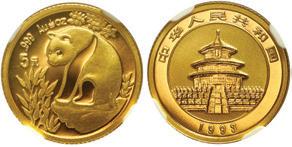

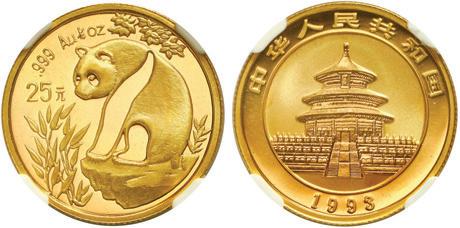


Watch and bid LIVE on the Internet at www.auction.sedwickcoins.com
615. China (People’s Republic), gold 50 yuan (1/2 oz) Panda, 1993, large date (Shanghai mint), NGC MS 69. KM-A614; PAN-190A. A characteristically well-struck issue, “among the best looking Pandas of the decade,” according to Anthony, who also says: “Despite a large reported mintage this is a surprisingly hard-to-find coin today … partly because so many were used in jewelry. Another attrition factor was the melting pot.” His survival estimate is less than 10%. The difference between the small- and large-date varieties is challenging to discern, as the dates themselves are prac tically the same, so experts must rely on minor differences in the Temple architecture. Mintage for both mints: 35,000 planned, 31,254 actual, with an estimated extant population of <1,250 for this variety. Pedigreed to the Gansu Collection of Chinese Panda Coinage. NGC #6472388-014. Estimate: $1,000-$1,500. 616. China (People’s Republic), gold 100 yuan (1 oz) Panda, 1993, large date (Shanghai mint), NGC MS 69. KM-477; PAN-189A. A characteristically well-struck issue, “among the best looking Pandas of the decade,” according to Anthony, who also says: “De spite a large reported mintage this is a surprisingly hard-to-find coin today … partly because so many were used in jewelry. Another attrition factor was the melting pot.” The difference between the small- and large-date varieties is challenging to discern, as the dates themselves are practically the same, so experts must rely on minor differences in the Temple architecture. Mintage for both mints: 35,000 planned, 40,449 actual, with an estimated extant popula tion of <2,750 for this variety. Pedigreed to the Gansu Collection of Chinese Panda Coinage. NGC #6472388-015. Estimate: $1,800-$2,600.

617. China (People’s Republic), gold proof five-coin Panda denomination set (5, 10, 25, 25 bimetallic and 50 yuan), 1993 P, all NGC PF Ultra Cameo, 69, 69, 69, 68 and 69 respectively. KM-473, 474, A613, 487, A614; PAN-202A, 201A, 200A, 199A, 198A. With P for Proof appearing to right of the Panda. Very few in each of the gold coins in this set are known in higher MS 70 grade in the current NGC census. Mintage: 2,500 sets. Pedigreed to the Gansu Collection of Chinese Panda Coinage. NGC #6472460-006, 6472460-007, 6472460-008, 6472460-009, 6472460-010. Estimate: $3,000-$4,500.
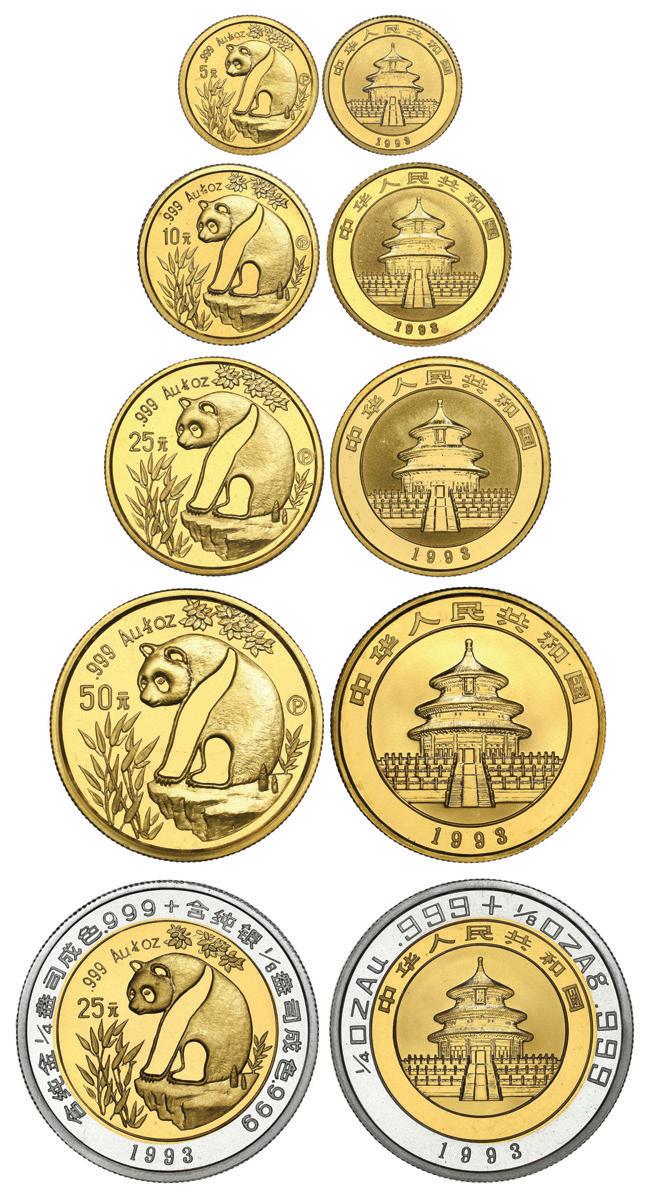

618. China (People’s Republic), platinum proof 10 yuan (1/10 oz) Panda, 1993, NGC PF 69 Ultra Cameo. KM-486; PAN-203A. Anthony: “In 1993 the China Mint rebooted the 10 Yuan 1/10 oz. platinum Panda and began a series that would continue for another five years. The mid-1990’s were a time of intense interest and speculation in platinum and the metal was popular for use in jewelry. The 1/10 oz. gold Pandas had always been popular with jewelers so it was a fair guess that a little platinum Panda would find a market, too. A mintage of 2,500 was authorized. That many of the coins were indeed used in pieces of jewelry is evidenced by the many coins today that show damage from mounting. This coin is quite scarce in undamaged condition and the number suitable for numismatists must be a fraction of the total struck.” Pedigreed to the Gansu Collection of Chinese Panda Coinage. NGC #6472420-011. Estimate: $500-$750.

619. China (People’s Repub lic), silver proof 50 yuan (5 oz) Panda, 1993, NGC PF 69 Ultra Cameo. KM-475; PAN-197A. Only three higher at PF 69* (one) and 70 (two) in the current NGC census. Mintage: 3,000 (planned; actual and surviving unknown). Pedigreed to the Gansu Col lection of Chinese Panda Coinage. NGC #6472490-007. Estimate: $600-$900.

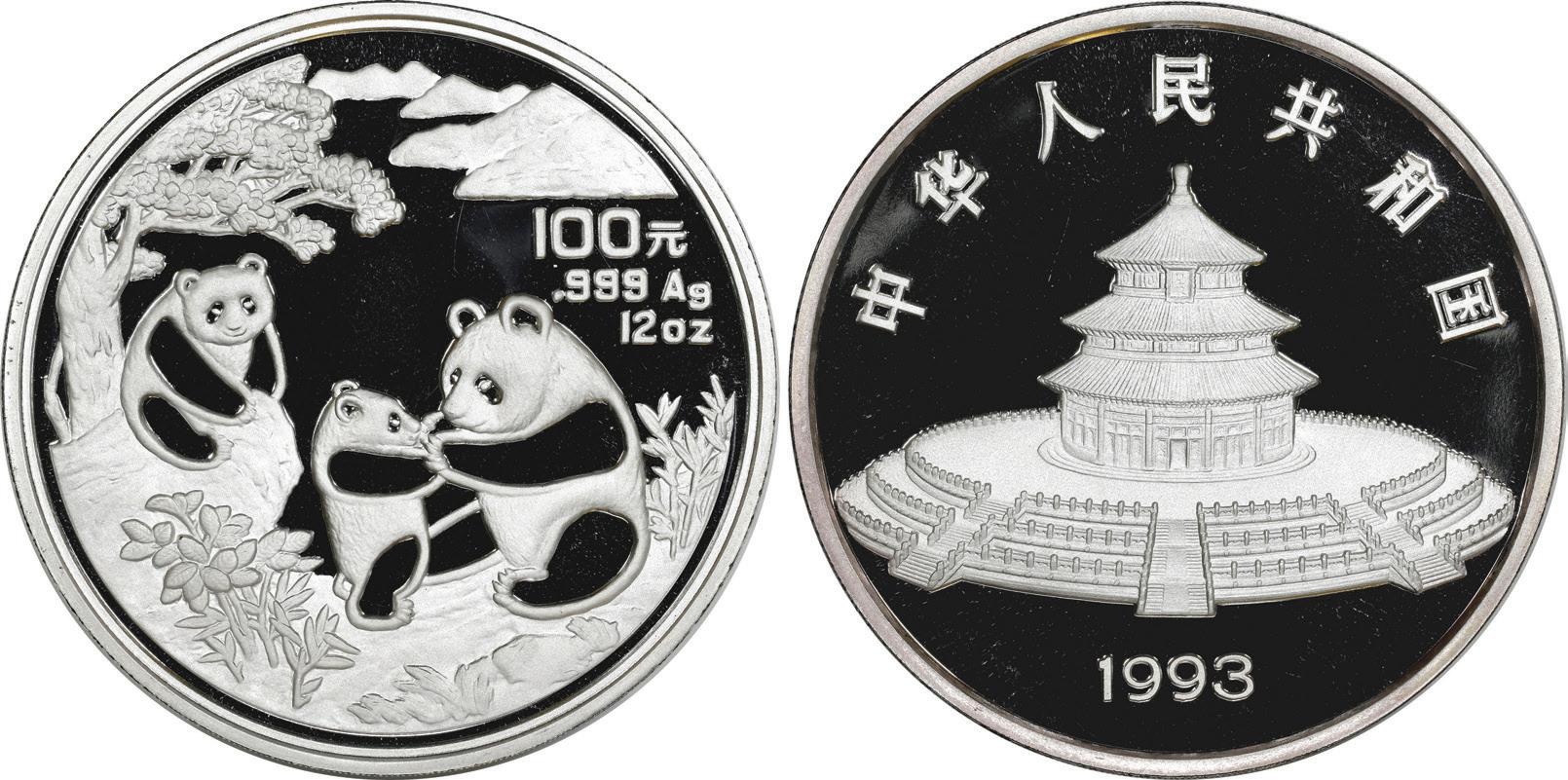
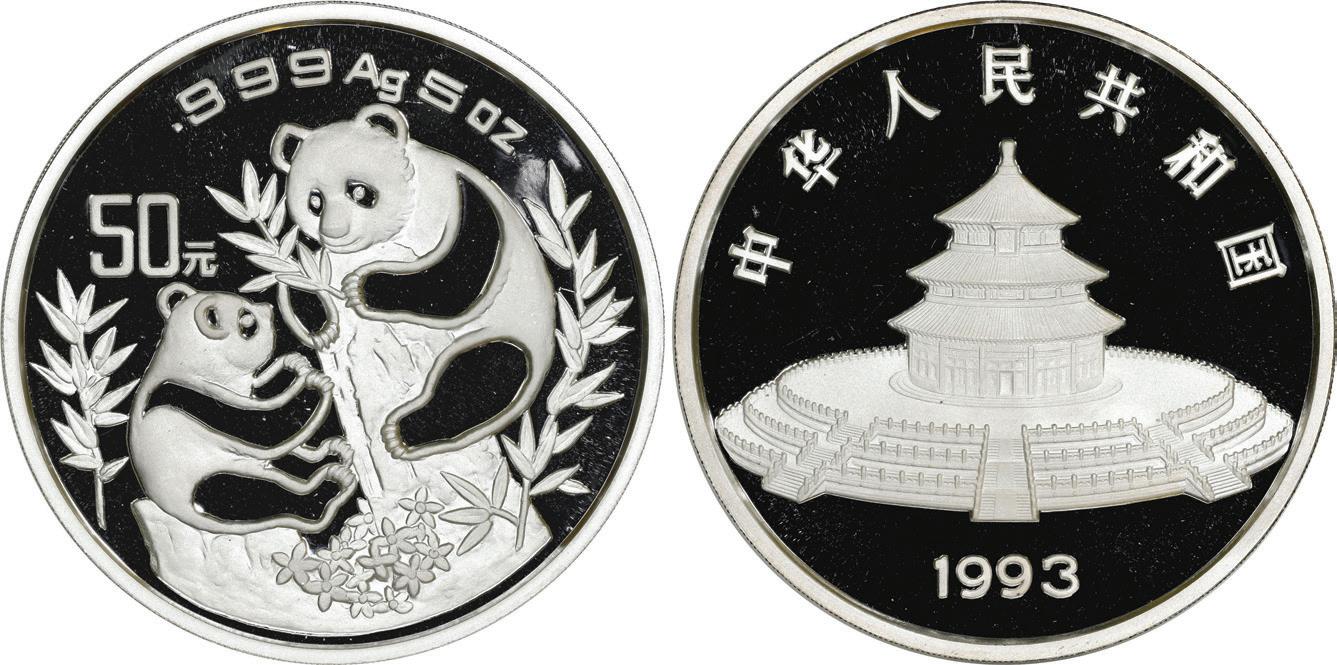
620. China (People’s Republic), silver proof 100 yuan (12 oz)
Panda, 1993, NGC PF 69 Ultra Cameo (“top pop”). KM-480; PAN-196A. None graded higher in current NGC census. Mintage: 2,000 (planned; actual and surviving unknown). Pedigreed to the Gansu Col lection of Chinese Panda Coinage. NGC #6472490-013. Estimate: $1,000-$1,500.
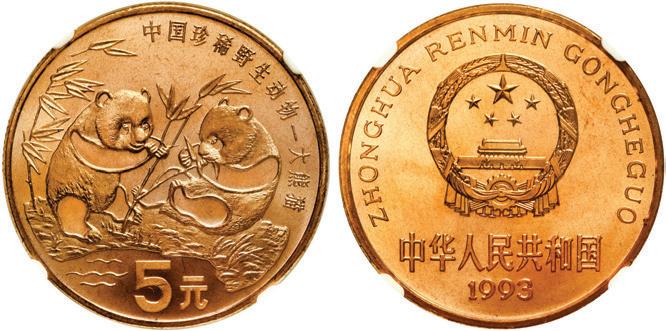
621. China (People’s Republic), copper 5 yuan (31 mm), 1993, NGC MS 69 Red (“top pop”). KM-469; PAN-208A. Technically not part of the Panda series but featuring pandas in a similar artistic design, from a reportedly much higher mintage of 2,000,000 pieces, about 5,000 of which appear in the current NGC census (no tably included in the “Panda Series”), in which this is one of only four at MS 69 (none finer). Anthony: “downright rare in MS-69.” Pedigreed to the Gansu Collection of Chinese Panda Coinage. NGC #3840367-002. Estimate: $600-$900.
622. China (People’s Republic), gold 1/2 oz proof official Panda issue, 1993, Munich International Coin Show, NGC PF 69 Ultra Cameo (“top pop”). KM-XMB76; PAN-209A. None graded higher in the current NGC census. As mentioned previously, there is confusion over the name of the show for which this issue was released, this year bearing the lettering MUNICH INTERNATIONAL COIN SHOW despite the show’s proper name of NUMISMATA. In any case it was the only coin show in this year to receive Panda issues. Mintage: 1,500 (planned; actual and surviving unknown). Pedigreed to the Gansu Collection of Chinese Panda Coinage. NGC #6472488-012. Estimate: $900-$1,350.
623. China (People’s Republic), gold 10 yuan (1/10 oz) Panda, 1994, small date (Shenyang mint), NGC MS 70 (“top pop”). KM-612; PAN-214B. One of only 55 pieces at MS 70 in the current NGC census. Anthony: “Despite a large reported mintage this is a surprisingly hard-to-find coin today. This is partly due to its popularity for use in jewelry. Another attrition factor was that the mid-nineties was a period when many other series of Chinese coins were in the spotlight. Collectors, or even hoarders, for small Pandas at that time were few. Many of these coins may have been melted. What is indisputable is that these are scarce coins today.” Actual mintage for both mints: 55,182; estimated extant population for this variety <2,700. Pedigreed to the Gansu Collection of Chinese Panda Coinage. NGC #3223041-056. Estimate: $400-$600. 624. China (People’s Repub lic), gold 25 yuan (1/4 oz) Pan da, 1994, small date (Shenyang mint), NGC MS 69. KM-613; PAN-213B. Only three higher at MS 70 in the current NGC census for this variety. Anthony: “Despite a large reported mintage this is a surprisingly hard-to-find coin today. One attrition factor was that the mid-nineties was a period when many other series of Chinese coins were in the spotlight. Collectors, or even hoarders, for ¼ oz. Pandas at that time were few and far between. To this day the ¼ oz. size is one of the less popular ones and many of these coins may have been melted.” Actual mintage for both mints: 20,388; estimated extant population for this variety <1,800. Pedigreed to the Gansu Collection of Chinese Panda Coinage. NGC #6472398-007. Estimate: $900-$1,350.
626. China (People’s Republic), gold 100 yuan (1 oz) Panda, 1994, small date (Shenyang mint), NGC MS 69. KM-615; PAN211B. One two higher at MS 70 in the current NGC census for this variety. Anthony: “Despite a decent reported mintage this is a truly scarce coin today. One attrition factor was that the mid-nineties was a period when many other series of Chinese coins were in the spotlight. Collectors, or even hoarders, for 1 oz. gold Pandas were few and far between. Not to mention that the 1 oz size has almost always been the least popular size of gold Pandas and many of these coins may have been melted.” Mintage for both mints: 35,000 planned; 24,438 actual; estimated extant population for this variety <4,500. Pedigreed to the Gansu Collection of Chinese Panda Coinage. NGC #6472398-010. Estimate: $2,000-$3,000.
625. China (People’s Republic), gold 50 yuan (1/2 oz) Panda, 1994, small date (Shenyang mint), NGC MS 69. KM-614; PAN212B. Only three higher at MS 70 in the current NGC census for this variety. Anthony: “Despite a decent reported mintage this is a truly scarce coin today. One attrition factor was that the mid-nineties was a period when many other series of Chinese coins were in the spotlight. Collectors, or even hoarders, for ½ oz. gold Pandas were few and far between. Not to mention that the ½ oz size has almost always been the least popular size of gold Pandas and many of these coins may have been melted.” Actual mintage for both mints: 16,788; estimated extant population for this variety <1,000. Pedigreed to the Gansu Col lection of Chinese Panda Coinage. NGC #6472398-008. Estimate: $3,500-$5,000.





627. China (People’s Republic), gold 5 yuan (1/20 oz) Panda, 1994, large date (Shanghai mint), NGC MS 70 (“top pop”). KM-611; PAN-215A. One of only 62 pieces at MS 70 in the current NGC census. Anthony: “Despite a large reported mintage this is a surprisingly hard-to-find coin today. This is partly because so many were used in jewelry. Another attrition factor was the melting pot as there were few collectors for this size Panda when it was new. This was also a time period when many other series of Chinese coins were in the spotlight and collectors, or even hoarders, for this coin were few.” Mintage for both mints: 100,000 planned; 133,226 actual; estimated extant population for this variety <3,600. Pedigreed to the Gansu Collection of Chinese Panda Coinage. NGC #3623041-042. Estimate: $200-$300. 628. China (People’s Republic), gold 10 yuan (1/10 oz) Panda, 1994, large date (Shanghai mint), NGC MS 69. KM-612; PAN-214A. Anthony: “Despite a large reported mintage this is a surprisingly hard-to-find coin today. This is partly due to its popularity for use in jewelry. Another attrition factor was that the mid-nineties was a period when many other series of Chinese coins were in the spot light. Collectors, or even hoarders, for small Pandas at that time were few. Many of these coins may have been melted. What is indisputable is that these are scarce coins today.” Actual mintage for both mints: 55,182; estimated extant population for this variety <1,800. Pedigreed to the Gansu Collection of Chinese Panda Coinage. NGC #3594819-092. Estimate: $300-$450.
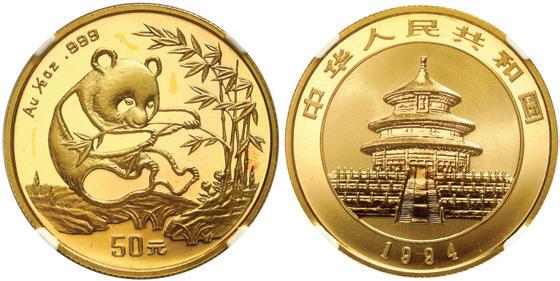
629. China (People’s Republic), gold 25 yuan (1/4 oz) Panda, 1994, large date (Shanghai mint), NGC MS 69. KM613; PAN-213A. Only ten higher at MS 70 in the current NGC census for this variety. Anthony: “Despite a large reported mintage this is a surprisingly hard-to-find coin today. One attrition factor was that the mid-nineties was a period when many other series of Chinese coins were in the spotlight. Collectors, or even hoarders, for ¼ oz. Pandas at that time were few and far between. To this day the ¼ oz. size is one of the less popular ones and many of these coins may have been melted.” Actual mintage for both mints: 20,388; estimated extant population for this variety <2,200. Pedigreed to the Gansu Collection of Chinese Panda Coinage. NGC #6472398-012. Estimate: $400-$600.
630. China (People’s Republic), gold 50 yuan (1/2 oz) Panda, 1994, large date (Shanghai mint), NGC MS 69. KM-614; PAN212A. Only twelve higher at MS 70 in the current NGC census for this variety. Anthony: “Despite a large reported mintage this is a surprisingly hard-to-find coin today. One attrition factor was that the mid-nineties was a period when many other series of Chinese coins were in the spotlight. Collectors, or even hoarders, for ½ oz. Pandas at that time were few and far between. To this day the ½ oz. size is one of the less popular ones and many of these coins may have been melted.” Actual mintage for both mints: 16,788; estimated extant population for this variety <1,000. Pedigreed to the Gansu Collection of Chinese Panda Coinage. NGC #6472398-013. Estimate: $3,500-$5,000.
632. China (People’s Republic), gold proof five-coin Panda denomination set (5, 10, 25, 25 bimetallic and 50 yuan), 1994 P, all NGC PF 69 Ultra Cameo. KM-611, 612, 613, 626, 614; PAN-225A 224A, 223A, 222A, 221A. With P for Proof to left of panda. Not many graded higher in the current NGC census. As Anthony points out, this five-coin proof set is interesting because two of its coins were also released in a different three-coin “Prestige Set” (750 released) that contained both types of 25 yuan along with a silver 10 yuan. While as many as 2500 of the five-coin denomination proof sets were authorized, reportedly only around 850 of the 50 yuan were actually made (the others all just over 1,600 pieces each). Pedigreed to the Gansu Collection of Chinese Panda Coinage. NGC #6472460-011, 6472460-012, 6472460-013, 6472460-014, 6472460-015. Estimate: $5,000-$7,500.





631. China (People’s Republic), gold 100 yuan (1 oz) Panda, 1994, large date (Shanghai mint), NGC MS 69. KM-615; PAN211A. Only nineteen higher at MS 70 in the current NGC census for this variety. Anthony: “Despite a large reported mintage this is a surprisingly hard-to-find coin today. One attrition factor was that the mid-nineties was a period when many other series of Chinese coins were in the spotlight. Collectors, or even hoarders, for 1 oz. Pandas at that time were few and far between. To this day the 1 oz. size is one of the less popular ones and many of these coins may have been melted.” Mintage for both mints: 35,000 planned; 24,438 actual; estimated extant population for this variety <4,000. Pedigreed to the Gansu Collection of Chinese Panda Coinage. NGC #6472398-014. Estimate: $2,000-$3,000.
633. China (People’s Republic), bimetallic proof 10 yuan (1/10 oz gold, 1/28 oz silver) Panda, 1994, NGC PF 68 Ultra Cameo. KM-701; PAN-229A. Deeply rainbow toned on the outer ring of silver. Mintage: 3,000 (planned; actual and surviving unknown). Pedigreed to the Gansu Collection of Chinese Panda Coinage. NGC #6472398-015. Estimate: $500-$750.
634. China (People’s Republic), platinum proof 10 yuan (1/10 oz) Panda, 1994, NGC PF 69 Ultra Cameo. KM-623; PAN-226A. Anthony: “Like the other small Pandas many of these coins fell into the hands of the jewelry industry. As a result it’s quite common to find them impaired. With an original mintage of 2,500 there weren’t that many to begin with.” Mintage: 2,500 (planned; actual and surviving unknown). Pedigreed to the Gansu Collection of Chinese Panda Coinage. NGC #6472420-012. Estimate: $500-$750.


635. China (People’s Republic), silver proof 100 yuan (12 oz) Panda, 1994, NGC PF 68 Ultra Cameo. KM-618; PAN-219A. Trace of light toning around part of rims. Mintage: <800 (planned; actual and surviving unknown), according to the Anthony book (NGC and KM say 2000). Pedigreed to the Gansu Collection of Chinese Panda Coinage. NGC #6472490-014. Estimate: $800-$1,200.
636. China (People’s Republic), gold proof 100 yuan (8 grams), 1994, Rare Chinese Animals (Panda), NGC PF 69 Ultra Cameo. KM-566; PAN-218A. Technically not part of the Panda series but minted in similar design in much lower weight, listed by both KM and NGC as “Endangered Wildlife” (Series V under Commemoratives) but as “Rare Chinese Animals” (under “Panda Cousins”) by Anthony. Mintage: 5,000. Pedigreed to the Gansu Collection of Chinese Panda Coinage. NGC #3497364009. Estimate: $800-$1,200.



637. China (People’s Republic), gold 1/2 oz proof official Panda issue, 1994, Munich International Coin Show, NGC PF 69 Ultra Cameo. KM-XMB78; PAN-232A. Only nine higher at MS 70 in the current NGC census. As mentioned previously, there is confusion over the name of the show for which this issue was released, this year bearing the lettering MUNICH INTERNATIONAL COIN SHOW despite the show’s proper name of NUMISMATA. In any case it was the only coin show in this year to receive Panda issues. Mintage: 1,500 (planned; ac tual and surviving unknown). Pedigreed to the Gansu Collection of Chinese Panda Coinage. NGC #6472488-013. Estimate: $800-$1,200.
638. China (People’s Republic), gold 5 yuan (1/20 oz) Panda, 1995, small date (Shenyang mint), NGC MS 70 (“top pop”). KM-715; PAN-239B. One of only 31 pieces at MS 70 in the current NGC census. Anthony: “1995 was an interesting year for Pandas. Although announced mintages were reasonable it soon became clear that Pandas from this year were difficult to come by. This was a time period when many other series of Chinese coins took over the spotlight and collectors, or even hoarders, for this coin were few. So it‘s no surprise that the 1995 5 Yuan remains a hard-to-find coin today. It is one of the key coins in the 1/20 oz. gold Panda series.” Actual mintage for both mints: 97,910; estimated extant population for this variety <3,800. Pedigreed to the Gansu Collection of Chinese Panda Coinage. NGC #6472402-001. Estimate: $300-$450.
639. China (People’s Republic), gold 10 yuan (1/10 oz) Panda, 1995, small date (Shenyang mint), NGC MS 69. KM-716; PAN-238B. Only twelve higher at MS 69* (two) and MS 70 (ten) in the current NGC census for this variety. Anthony: “1995 was an interesting year for Pandas. Although announced mintages were rea sonable it soon became clear that Pandas from this year were difficult to come by. This was a time period when many other series of Chinese coins took over the spotlight and collectors, or even hoarders, for this coin were few. So it‘s no surprise that the 1995 10 Yuan remains a hard-to-find coin today. It is one of the key coins in the 1/10 oz. gold Panda series.” Actual mintage for both mints: 45,007; estimated extant population for this variety <1,850. Pedigreed to the Gansu Collection of Chinese Panda Coinage. NGC #6472402-002. Estimate: $300-$450. 640. China (People’s Republic), gold 25 yuan (1/4 oz) Panda, 1995, small date (Shenyang mint), NGC MS 69. KM-717; PAN-237B. Only seven higher at MS 70 in the current NGC census for this variety. Anthony: “1995 was an interesting year for Pandas. Although announced mintages were reasonable it soon became clear that Pandas from this year were difficult to come by. This was a time period when many other series of Chinese coins took over the spotlight and collectors, or even hoarders, for this coin were few. So it‘s no surprise that the 1995 25 Yuan remains a scarce coin today. In fact it is now considered to be the key coin of the entire 1/4 oz. gold Panda series and commands a commensurate price.” Actual mintage for both mints: 13,710; estimated extant population for this variety <1,350. Pedigreed to the Gansu Collection of Chinese Panda Coinage. NGC #6472402-003. Estimate: $2,000-$3,000. 641. China (People’s Republic), gold 50 yuan (1/2 oz) Panda, 1995, small date (Shenyang mint), NGC MS 69. KM-718; PAN-236B. Key date and denomination, missing from many collections of the highly collected Panda gold series. Only nine higher at MS 70 in the current NGC census for this variety. An thony: “1995 was an interesting year for Pandas. Although announced mintages were reasonable it soon became clear that Pandas from this year were difficult to come by. This was a time period when many other series of Chinese coins took over the spotlight and collectors, or even hoarders, for this coin were few. So it‘s no surprise that the 1995 50 Yuan remains a scarce coin today. In fact it is now considered to be one of the key coins of the 1/2 oz. gold Panda series.” Actual mintage for both mints: 11,749; estimated extant population for this variety <1,300. Pedigreed to the Gansu Collection of Chinese Panda Coinage. NGC #6472402-004. Estimate: $8,000-$12,000.






642. China (People’s Republic), gold 100 yuan (1 oz) Panda, 1995, small date (Shenyang mint), NGC MS 69. KM-719; PAN235B. Only four higher at MS 70 in the current NGC census for this variety. Anthony: “1995 was an interesting year for Pandas. Although announced mintages were reasonable it soon became clear that Pan das from this year were difficult to come by. This was a time period when many other series of Chinese coins took over the spotlight and collectors, or even hoarders, for this coin were few. So it‘s no surprise that the 1995 100 Yuan remains a scarce coin today. In fact it is now considered to be one of the key coins of the 1 oz. gold Panda series.” Mintage for both mints: 35,000 planned; 17,412 actual; estimated extant population for this variety <1,750. Pedigreed to the Gansu Col lection of Chinese Panda Coinage. NGC #6472402-005. Estimate: $2,500-$3,750. 643. China (People’s Republic), gold 5 yuan (1/20 oz) Panda, 1995, large date (Shanghai mint), NGC MS 69. KM-715; PAN-239A. Anthony: “1995 was an interesting year for Pandas. Although announced mintages were reasonable it soon became clear that Pandas from this year were difficult to come by. This was a time period when many other series of Chinese coins took over the spotlight and collectors, or even hoarders, for this coin were few. So it‘s no surprise that the 1995 5 Yuan remains a hard-to-find coin today. It is one of the key coins in the 1/20 oz. gold Panda series.” Actual mintage for both mints: 97,910; estimated extant population for this variety <3,200. Pedigreed to the Gansu Collection of Chinese Panda Coinage. NGC #6472402-006. Estimate: $200-$300. 644. China (People’s Republic), gold 10 yuan (1/10 oz) Panda, 1995, large date (Shanghai mint), NGC MS 68. KM-716; PAN-238A. Anthony:
“1995 was an interesting year for Pandas. Although announced mintages were reasonable it soon became clear that Pandas from this year were difficult to come by. This was a time period when many other series of Chinese coins took over the spot light and collectors, or even hoarders, for this coin were few. So it‘s no surprise that the 1995 10 Yuan remains a hard-to-find coin today. It is one of the key coins in the 1/10 oz. gold Panda series.” Actual mintage for both mints: 45,007; estimated extant population for this variety <2,150. Pedigreed to the Gansu Collection of Chinese Panda Coinage. NGC #6472402-007. Estimate: $160-$240.
645. China (People’s Republic), gold 25 yuan (1/4 oz) Panda, 1995, large date (Shanghai mint), NGC MS 70 (“top pop”). KM-717; PAN-237A. One of only eleven pieces at MS 70 in the current NGC census. Anthony: “1995 was an interesting year for Pandas. Although announced mintages were reasonable it soon became clear that Pandas from this year were difficult to come by. This was a time pe riod when many other series of Chinese coins took over the spotlight and collectors, or even hoarders, for this coin were few. So it‘s no surprise that the 1995 25 Yuan remains a scarce coin today. In fact it is now considered to be the key coin of the entire 1/4 oz. gold Panda series and commands a commensurate price.” Actual mintage for both mints: 13,710; estimated extant population for this variety <1,150. Pedigreed to the Gansu Collection of Chinese Panda Coinage. NGC #6472402-008. Estimate: $3,000-$4,500.
646. China (People’s Republic), gold 50 yuan (1/2 oz) Panda, 1995, large date (Shanghai mint), NGC MS 69. KM-718; PAN236A. Key date and denomination of this highly collected series and always in demand, this variety even rarer than the small date, with the lowest estimated extant population of any gold Panda coins. Only two higher at MS 70 in the current NGC census. Anthony: “1995 was an interesting year for Pandas. Although announced mintages were reasonable it soon became clear that Pandas from this year were difficult to come by. This was a time period when many other series of Chinese coins took over the spotlight and collectors, or even hoarders, for this coin were few. So it‘s no surprise that the 1995 50 Yuan remains a scarce coin today. In fact it is now considered to be one of the key coins of the 1/2 oz. gold Panda series.” Actual mintage for both mints: 11,749; estimated extant population for this variety <450. Pedigreed to the Gansu Collection of Chinese Panda Coinage. NGC #6472402-009. Estimate: $10,000-$15,000.

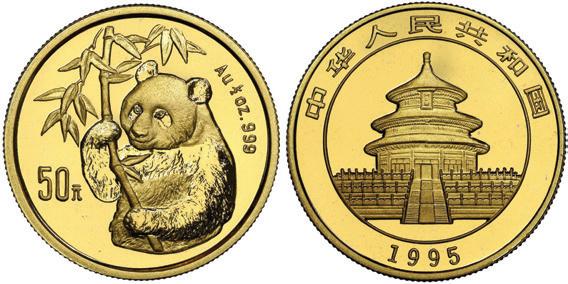
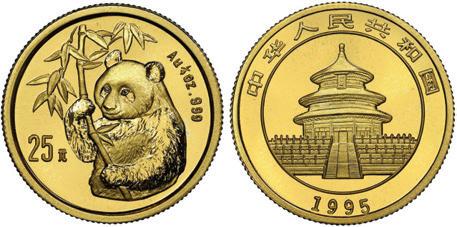
647. China (People’s Republic), gold 100 yuan (1 oz) Panda, 1995, large date (Shanghai mint), NGC MS 69. KM-719; PAN235A. Only eighteen higher at MS 70 in the current NGC census. An thony: “1995 was an interesting year for Pandas. Although announced mintages were reasonable it soon became clear that Pandas from this year were difficult to come by. This was a time period when many other series of Chinese coins took over the spotlight and collectors, or even hoarders, for this coin were few. So it‘s no surprise that the 1995 100 Yuan remains a scarce coin today. In fact it is now considered to be one of the key coins of the 1 oz. gold Panda series.” Mintage for both mints: 35,000 planned; 17,412 actual; estimated extant population for this variety <2,750. Pedigreed to the Gansu Collection of Chinese Panda Coinage. NGC #6472402-010. Estimate: $3,000-$4,500.
648. China (People’s Republic), bimetallic proof 10 yuan (1/10 oz gold, 1/28 oz silver) Panda, 1995, NGC PF 69 Ultra Cameo. KM-722; PAN-247A. Only one higher at PF 69* in the current NGC census (with the lowest percentage of PF 69-and-up instances for all the dates of the bimetallic 10 yuan). Mintage: 2,000 (planned; actual and surviving unknown). Pedigreed to the Gansu Collection of Chinese Panda Coinage. NGC #6472462-001. Estimate: $400-$600.
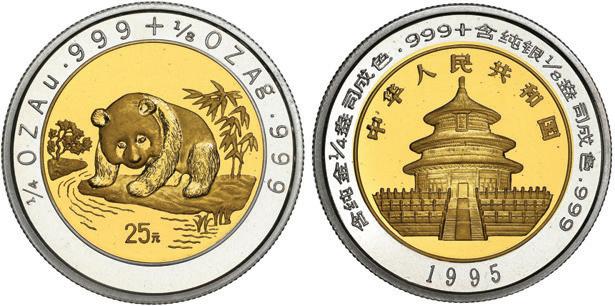
649. China (People’s Republic), bimetallic proof 25 yuan (1/4 oz gold, 1/8 oz silver) Panda, 1995, NGC PF 69 Ultra Cameo (“top pop”). KM-724; PAN-246A. None graded higher in the current NGC census. Mintage: 2,000 (planned; actual and surviving unknown). Pedigreed to the Gansu Collection of Chinese Panda Coinage. NGC #6472462-002. Estimate: $800-$1,200.

650. China (People’s Republic), bimetallic proof 50 yuan (1/2 oz gold, 1/5 oz silver) Panda, 1995, NGC PF 67 Ultra Cameo. KM-725; PAN-245A. Light area of discoloration in silver ring to right of fineness. Mintage: 2,000 (planned; actual and surviving unknown). Pedigreed to the Gansu Collection of Chinese Panda Coinage. NGC #6472462-003. Estimate: $1,000-$1,500.

653. China (People’s Republic), gold 1/2 oz proof official Panda issue, 1995, Munich International Coin Show, NGC PF 69 Ultra Cameo. KM-XMB81; PAN-254A. Only two higher at PF 70 in the current NGC census. As mentioned previously, there is confusion over the name of the show for which this issue was released, this year bearing the lettering MUNICH INTERNATIONAL COIN SHOW despite the show’s proper name of NUMISMATA. Mintage: 1,500 (planned; actual and surviving unknown). Pedigreed to the Gansu Collection of Chinese Panda Coinage. NGC #6472488-014. Estimate: $800-$1,200.

651. China (People’s Republic), gold proof 100 yuan (1 oz) Panda, 1995, NGC PF 69 Ultra Cameo. KM-726; PAN-242A. Key date, with only two higher at PF 70 in the current NGC census. Anthony: “The 1995 100 Yuan 1 oz. proof gold Panda marks the return of the 1 oz. gold proof coin to the Panda series. The 100 Yuan denomination had been dropped from the annual five-coin proof sets in 1993. In 1995 the five-coin proof sets themselves were discontinued in favor of a three-coin bimetallic proof set. At the same time, how ever, the China Mint revived the popular one oz. size in proof state and offered it for sale as a solo coin, not as part of a set.” Anthony also says: “much sought after and commands a lofty price.” Mintage: 2,000 planned; actual (and surviving) unknown but “reportedly well below the announced mintage” (Anthony). Pedigreed to the Gansu Collection of Chinese Panda Coinage. NGC #6472462-004. Estimate: $6,000-$9,000.
652. China (People’s Republic), platinum proof 10 yuan (1/10 oz) Panda, 1995, NGC PF 69 Ultra Cameo. KM-730; PAN-250A. Only fifteen higher at PF 70 in the current NGC census. Mintage: 5,000 (planned; actual and surviving unknown). Pedigreed to the Gansu Collection of Chinese Panda Coinage. NGC #6472420-013. Estimate: $300-$450.

654. China (People’s Republic), gold 10 yuan (1/10 oz) Panda, 1996, small date (Shanghai mint), NGC MS 69. KM-884; PAN-259A. Only three higher at MS 70 in the current NGC census. Note in this year the large and small dates flip-flopped mints from previous years, the small date being Shanghai and the large date being Shenyang, which continued for the following years. This coin was graded without variety by NGC. Mintage for both mints: 57,203; estimated extant population for this variety <2,700. Pedigreed to the Gansu Collection of Chinese Panda Coinage. NGC #3549307-007. Estimate: $200-$300.
655. China (People’s Republic), gold 25 yuan (1/4 oz) Pan da, 1996, small date (Shanghai mint), NGC MS 69. KM-885; PAN-258A. Only four higher at MS 70 in the current NGC census.
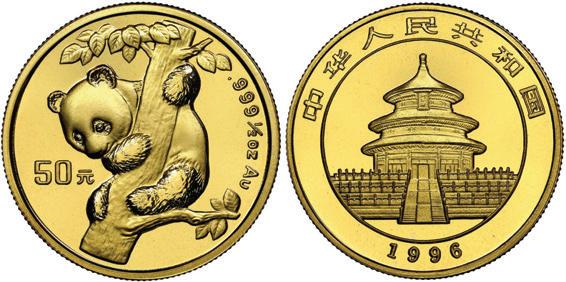


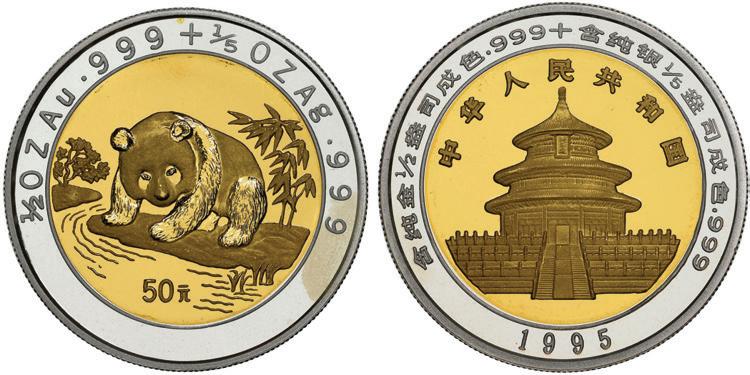
Note in this year the large and small dates flip-flopped mints from previous years, the small date being Shanghai and the large date being Shenyang, which continued for the following years. Mintage for both mints: 17,589; estimated extant population for this variety <2,650. Pedigreed to the Gansu Collection of Chinese Panda Coinage. NGC #6472402-013. Estimate: $500-$750.
656. China (People’s Republic), gold 50 yuan (1/2 oz) Panda, 1996, small date (Shanghai mint), NGC MS 69. KM-886; PAN257A. Only four higher at MS 70 in the current NGC census. Note in this year the large and small dates flip-flopped mints from previous years, the small date being Shanghai and the large date being Shenyang, which continued for the following years. Mintage for both mints: 13,849; estimated extant population for this variety <1,000. Pedigreed to the Gansu Collection of Chinese Panda Coinage. NGC #6472402-014. Estimate: $2,000-$3,000.
657. China (People’s Republic), gold 100 yuan (1 oz) Panda, 1996, small date (Shanghai mint), NGC MS 68. KM-887; PAN-256A. Only three higher at MS 70 in the current NGC census. Note in this year the large and small dates flip-flopped mints from previous years, the small date being Shanghai and the large date being Shenyang, which continued for the following years. Mintage for both mints: 35,000 planned; 22,009 actual; estimated extant population for this variety <1,900. Pedigreed to the Gansu Collection of Chinese Panda Coinage. NGC #6472402-015. Estimate: $1,800-$2,600. 658. China (People’s Republic), gold 5 yuan (1/20 oz) Panda, 1996, large date (Shenyang mint), NGC MS 70 (“top pop”). KM-883; PAN-260B. One of only 38 pieces at MS 70 in the current NGC census. Note in this year the large and small dates flip-flopped mints from previous years, the small date being Shanghai and the large date being Shenyang, which continued for the following years. Mintage for both mints: 145,347; estimated extant population for this variety <3,300. Pedigreed to the Gansu Collection of Chinese Panda Coinage. NGC #3681736-020. Estimate: $300-$450. 659. China (People’s Republic), gold 10 yuan (1/10 oz) Panda, 1996, large date (Shenyang mint), NGC MS 69. KM-884; PAN-259B. Only fifteen higher at MS 70 in the current NGC census. Note in this year the large and small dates flip-flopped mints from previous years, the small date being Shanghai and the large date being Shenyang, which continued for the following years. Mintage for both mints: 57,203; estimated extant population for this variety <3,300. Pedigreed to the Gansu Collection of Chinese Panda Coinage. NGC #6472418-002. Estimate: $200-$300. 660. China (People’s Repub lic), gold 25 yuan (1/4 oz) Pan da, 1996, large date (Shenyang mint), NGC MS 69. KM-885; PAN-258B. Only six higher at MS 70 in the current NGC census. Note in this year the large and small dates flip-flopped mints from previous years, the small date being Shanghai and the large date being Shenyang, which continued for the following years. Mintage for both mints: 17,589; estimated extant population for this variety <1,350. Pedigreed to the Gansu Collection of Chinese Panda Coinage. NGC #6472418-003. Estimate: $500-$750.
661. China (People’s Republic), gold 50 yuan (1/2 oz) Panda, 1996, large date (Shenyang mint), NGC MS 69. KM-886; PAN257B. Very low estimated surviving rate, with only six higher at MS 70 in the current NGC census. Note in this year the large and small dates flip-flopped mints from previous years, the small date being Shanghai and the large date being Shenyang, which continued for the following years. Mintage for both mints: 13,849; estimated extant population for this variety <750. Pedigreed to the Gansu Collection of Chinese Panda Coinage. NGC #6472418-004. Estimate: $2,000-$3,000.







662. China (People’s Republic), gold 100 yuan (1 oz) Panda, 1996, large date (Shenyang mint), NGC MS 69. KM-887; PAN256B. Only five higher at MS 70 in the current NGC census. Note in this year the large and small dates flip-flopped mints from previous years, the small date being Shanghai and the large date being Shenyang, which continued for the following years. Mintage for both mints: 35,000 planned; 22,009 actual; estimated extant population for this variety <4,100. Pedigreed to the Gansu Collection of Chinese Panda Coinage. NGC #6472418-005. Estimate: $2,000-$3,000. 663. China (People’s Republic), gold 10 yuan (1/10 oz) Panda, 1996, 15th Anniversary of the Issuance of Chinese Panda Gold Coinage, NGC MS 69. KM-889; PAN-269A. From a threedenomination set of special issues showing an additional legend below the Temple to commemorate the fact that this was the fifteenth year of Panda series coinage. Mintage: 20,000 (planned; actual and surviving unknown). Pedigreed to the Gansu Collection of Chinese Panda Coinage. NGC #6472462-011. Estimate: $300-$450. 664. China (People’s Repub lic), gold 25 yuan (1/4 oz) Panda, 1996, 15th Anniversary of the Issuance of Chinese Panda Gold Coinage, NGC MS 69. KM-891; PAN-267A. Only seven higher at MS 70 in the current NGC census. From a threedenomination set of special issues showing an additional legend below the Temple to commemorate the fact that this was the fifteenth year of Panda series coinage. Mintage: 8,000 (planned; actual and surviving unknown). Pedigreed to the Gansu Collection of Chinese Panda Coinage. NGC #6472462-012. Estimate: $500-$750.

665. China (People’s Republic), gold 100 yuan (1 oz) Panda, 1996, 15th Anniversary of the Issuance of Chinese Panda Gold Coinage, NGC MS 68. KM-896; PAN-263A. Largest of a three-denomination set of special issues showing an ad ditional legend below the Temple to commemorate the fact that this was the fifteenth year of Panda series coinage. Mintage: 3,800 (planned; actual and surviving unknown). Pedigreed to the Gansu Collection of Chinese Panda Coinage. NGC #6472462-013. Estimate: $1,800-$2,600.


666. China (People’s Republic), bimetallic proof three-coin Panda denomination set (10, 25, and 50 yuan), 1996, all NGC PF 69 Ultra Cameo. KM-893, 894, 895; PAN-268A, 266A, 265A.

Very few graded higher in the current NGC census. Mintage: 2,500 sets (planned; actual and surviving unknown). Pedigreed to the Gansu Collection of Chinese Panda Coinage. NGC #6472462-005, 6472462006, 6472462-007. Estimate: $3,000-$4,500.
668. China (People’s Republic), platinum proof 5 yuan (1/20 oz) Panda, 1996, NGC PF 69 Ultra Cameo. KM-888; PAN273A. Anthony: “Like most of the other 1/20 oz. platinum coins it is scarce. Also like most 1/20 oz. Pandas it is reportedly struck not in China but in Australia at the Perth Mint.” Mintage: 5,000 (planned; actual and surviving unknown). Pedigreed to the Gansu Collection of Chinese Panda Coinage. NGC #6472420-014. Estimate: $300-$450.

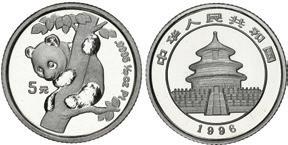
669. China (People’s Republic), platinum proof 10 yuan (1/10 oz) Panda, 1996, NGC PF 69 Ultra Cameo. KM-890; PAN-272A. Only eight higher in PF 70 in the current NGC census. Anthony: “By 1996 China was near to ending the 10 Yuan platinum series. The mintage was reduced from 5,000 in 1995 to 2,500 in 1996. Part of this was due to the Mint being extraordinarily busy with other coin series. That is reportedly why the Perth Mint in Australia was contracted to strike the 1996 10 Yuan platinum Panda.” Mintage: 2,500 (planned; actual and surviving unknown). Pedigreed to the Gansu Collection of Chinese Panda Coinage. NGC #6472420-015. Estimate: $300-$450.
667. China (People’s Republic), gold proof 100 yuan (1 oz) Panda, 1996, NGC PF 69 Ultra Cameo (“top pop”). KM-901; PAN-262A. None graded higher in the current NGC census. The final year of 100 Yuan proof gold Pandas in the 1 oz size, “quite popular today with collectors” (Anthony). Mintage: 1,500 (planned; actual and surviving unknown). Pedigreed to the Gansu Collection of Chinese Panda Coinage. NGC #3543232-007. Estimate: $4,000-$6,000.
670. China (People’s Republic), silver 1 oz proof official Panda issue, 1996, Munich International Coin Show, NGC PF 69 Ultra Cameo. KM-XMB84; PAN-278A. Only four higher at PF 70 in the current NGC census. As mentioned previously, there is confusion over the name of the show for which this issue was released, this year bearing the lettering MUNICH INTERNATIONAL COIN SHOW despite the show’s proper name of NUMISMATA. Mintage: 2,500 (planned; actual and surviving unknown). Pedigreed to the Gansu Collection of Chinese Panda Coinage. NGC #6472672-003. Estimate: $200-$300.
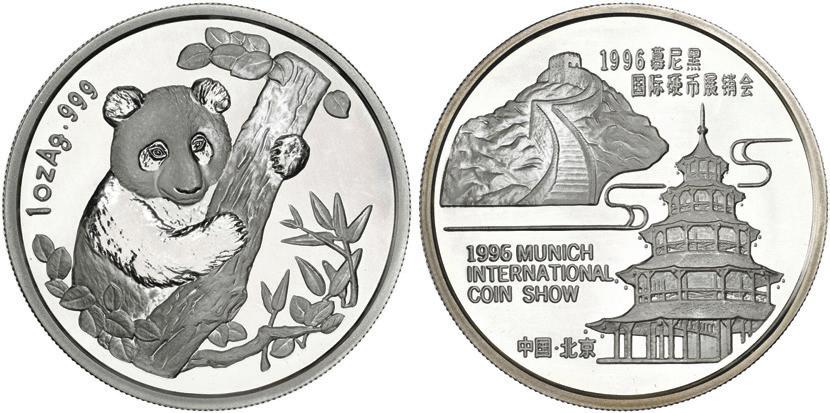
671. China (People’s Republic), bimetallic proof official Panda issue, 1/4 oz gold, 1/8 oz silver, 1996, Munich International Coin Show, NGC PF 69 Ultra Cameo (“top pop”). KM-XMB83; PAN-277A. None graded higher in the current NGC cen sus. As mentioned previously, there is confusion over the name of the show for which this issue was released, this year bearing the lettering MUNICH INTERNATIONAL COIN SHOW despite the show’s proper name of NUMISMATA. Mintage: 1,500 (planned; actual and surviving unknown). Pedigreed to the Gansu Collection of Chinese Panda Coinage. NGC #6472488-015. Estimate: $1,200-$1,800. 672. China (People’s Republic), gold 5 yuan (1/20 oz) Panda, 1997, small date (Shanghai mint), NGC MS 69. KM-984; PAN-283A. Anthony: “among the scarcer dates… only a small fraction of these coins have apparently survived.” Actual mintage for both mints: 54,853; estimated extant population for this variety <6,700. Pedigreed to the Gansu Collection of Chinese Panda Coinage. NGC #6472418-006. Estimate: $200-$300. 673. China (People’s Republic), gold 10 yuan (1/10 oz) Panda, 1997, small date (Shanghai mint), NGC MS 70 (“top pop”). KM-987; PAN-282A. One of only fourteen pieces at MS 70 in the current NGC census. Anthony: “among the scarcer dates… only a small fraction of these coins have apparently survived.” Actual mintage for both mints: 46,628; estimated extant population for this variety <5,200. Pedigreed to the Gansu Collection of Chinese Panda Coinage. NGC #3623030-059. Estimate: $400-$600. 674. China (People’s Republic), gold 25 yuan (1/4 oz) Panda, 1997, small date (Shanghai mint), NGC MS 68. KM-989; PAN-281A. Anthony: “among the scarcer dates… only a small fraction of these coins have apparently survived.” Actual mintage for both mints: 21,909; estimated extant population for this variety <2,300. Pedigreed to the Gansu Collection of Chinese Panda Coinage. NGC #6472418-008. Estimate: $400-$600.

675. China (People’s Republic), gold 50 yuan (1/2 oz) Panda, 1997, small date (Shanghai mint), NGC MS 69. KM-990; PAN280A. Only thirteen higher at MS 70 in the current NGC census. Anthony: “The 50 Yuan Pandas are considered to be the scarcest 1997 denomination and are in very short supply.” Actual mintage for both mints: 15,483; estimated extant population for this variety <1,950. Pedigreed to the Gansu Collection of Chinese Panda Coinage. NGC #6472418-009. Estimate: $1,800-$2,600.
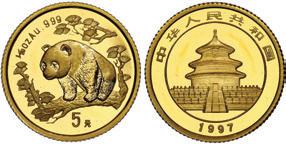
676. China (People’s Republic), gold 100 yuan (1 oz) Panda, 1997, small date (Shanghai mint), NGC MS 69. KM-991; PAN-279A. Only sixteen higher at MS 70 in the current NGC census. Anthony: “many of these coins have not survived in B.U. condition… still among the scarcer dates.” Mintage for both mints: 125,000 planned; 30,457 actual; estimated extant population for this variety <7,500. Pedigreed to the Gansu Collection of Chinese Panda Coinage. NGC #6472418-010. Estimate: $1,800-$2,600. 677. China (People’s Republic), gold 5 yuan (1/20 oz) Panda, 1997, large date (Shenyang mint), NGC MS 69. KM-984; PAN-283B. Anthony: “among the scarcer dates… only a small fraction of these coins have apparently survived.” Actual mintage for both mints: 54,853; estimated extant population for this variety <5,300. Pedigreed to the Gansu Collection of Chinese Panda Coinage. NGC #6472418-011. Estimate: $200-$300. 678. China (People’s Republic), gold 10 yuan (1/10 oz) Panda, 1997, large date (Shenyang mint), NGC MS 69. KM-987; PAN-282B. Anthony: “among the scarcer dates… only a small fraction of these coins have apparently survived.” Actual mintage for both mints: 46,628; estimated extant population for this variety <4,400. Pedigreed to the Gansu Collection of Chinese Panda Coinage. NGC #6472418-012. Estimate: $200-$300. 679. China (People’s Re public), gold 25 yuan (1/4 oz) Panda, 1997, large date (Shenyang mint), NGC MS 70 (“top pop”). KM-989; PAN-281B. One of only 42 pieces at MS 70 in the current NGC census. Anthony: “among the scarcer dates… only a small fraction of these coins have apparently survived.” Actual mintage for both mints: 21,909; estimated extant population for this variety <2,700. Pedigreed to the Gansu Collection of Chinese Panda Coinage. NGC #6472418-013. Estimate: $500-$750.







680. China (People’s Republic), gold 50 yuan (1/2 oz) Panda, 1997, large date (Shenyang mint), NGC MS 69. KM-990; PAN-280B. Only fifteen higher at MS 70 in the current NGC census. Anthony: “The 50 Yuan Pandas are considered to be the scarcest 1997 denomination and are in very short supply.” Actual mintage for both mints: 15,483; estimated extant population for this variety <2,050. Pedigreed to the Gansu Collection of Chinese Panda Coinage. NGC #6472418-014. Estimate: $1,800-$2,600.
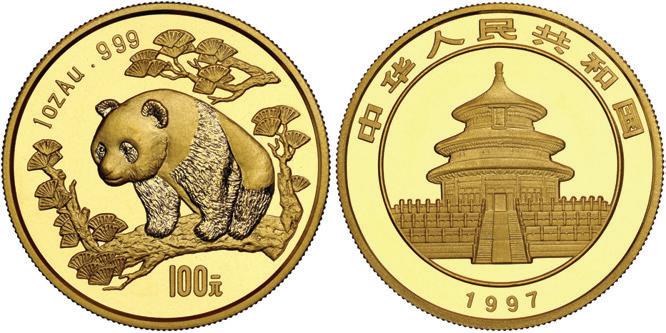

681. China (People’s Republic), gold 100 yuan (1 oz) Panda, 1997, large date (Shenyang mint), NGC MS 69. KM-991; PAN-279B. Only eight higher at MS 70 in the current NGC census. Anthony: “many of these coins have not survived in B.U. condition… still among the scarcer dates.” Mintage for both mints: 125,000 planned; 30,457 actual; estimated extant population for this variety <6,000. Pedigreed to the Gansu Collection of Chinese Panda Coinage. NGC #6472418-015. Estimate: $1,800-$2,600.
682. China (People’s Republic), bimetallic proof three-coin Panda denomination set (10, 25, and 50 yuan), 1997, all NGC PF Ultra Cameo, 69, 68 and 69 respectively. KM-998, 999, 1000; PAN-286A, 287A, 288A. The 50 yuan is “top pop” (none higher) with only one higher 10 yuan at PF 70 in the current NGC census. Mintage: 2,800 (planned; actual and surviving unknown). Pedigreed to the Gansu Collection of Chinese Panda Coinage. NGC #6472462-008, 6472462-009, 6472462-010. Estimate: $4,000-$6,000.



683. China (People’s Republic), gold 1/2 oz proof official Panda issue, 1997, Mu nich International Coin Show, NGC PF 69 Ultra Cameo. KM-XMB85; PAN-300A. Only five higher at PF 70 in the current NGC census. As mentioned previously, there is confusion over the name of the show for which this issue was released, this year bearing the lettering MUNICH INTERNATIONAL COIN SHOW despite the show’s proper name of NUMISMATA; also on this commemorative is 10 MUNICH PANDA for the fact that this was the tenth year of Panda issues for the Munich show. Mintage: 880 (planned; actual and surviving unknown). Pedigreed to the Gansu Collection of Chinese Panda Coinage. NGC #6472528-010. Estimate: $1,800-$2,600.
684. China (People’s Republic), silver 1 oz proof official Panda issue, 1997, Munich International Coin Show, NGC PF 69 Ultra Cameo. KM-XMB87; PAN-302A. Only two higher at PF 70 in the current NGC census. As mentioned previously, there is confusion over the name of the show for which this issue was released, this year bearing the lettering MUNICH INTERNA TIONAL COIN SHOW despite the show’s proper name of NUMISMATA; also on this commemorative is 10 MUNICH PANDA for the fact that this was the tenth year of Panda issues for the Munich show. Mintage: 1,800 (planned; actual and surviving unknown). Pedigreed to the Gansu Collection of Chinese Panda Coinage. NGC #6472672-004. Estimate: $200-$300.
685. China (People’s Republic), gold 5 yuan (1/20 oz) Panda, 1998, small date (Shanghai mint), NGC MS 68. KM-1125; PAN-307A. The entire 1998 series is rare. Anthony: “1998 has become perhaps the most sought-after year for gold Pandas. All the coins from this year are key coins in their sets.” Actual mintage for both mints: 27,483; estimated extant population for this variety <5,100. Pedigreed to the Gansu Collection of Chinese Panda Coinage. NGC #6472420-001. Estimate: $500-$750. 686. China (People’s Republic), gold 10 yuan (1/10 oz) Panda, 1998, small date (Shanghai mint), NGC MS 69. KM-1127; PAN-306A. The entire 1998 series is rare, and the mintage for this denomination was particularly low. Anthony: “1998 has become perhaps the most sought-after year for gold Pandas. All the coins from this year are key coins in their sets.” Only eight are graded higher at MS 70 in the NGC census. Actual mintage for both mints: 8,502; estimated extant population for this variety <4,900. Pedigreed to the Gansu Collection of Chinese Panda Coinage. NGC #6472420-002. Estimate: $600-$900. 687. China (People’s Republic), gold 25 yuan (1/4 oz) Panda, 1998, small date (Shanghai mint), NGC MS 69. KM-1128; PAN-305A. Only six higher at MS 70 in the NGC census. The entire 1998 series is rare. Anthony: “1998 has become perhaps the most sought-after year for gold Pandas. All the coins from this year are key coins in their sets.” Actual mintage for both mints: 13,009; estimated extant population for this variety <3,350. Pedigreed to the Gansu Collection of Chinese Panda Coinage. NGC #6472420-003. Estimate: $1,200-$1,800.
688. China (People’s Republic), gold 50 yuan (1/2 oz) Panda, 1998, small date (Shanghai mint), NGC MS 67. KM-1129; PAN304A. Lowest reported mintage of any year of 50 yuan gold Pandas. Anthony: “1998 has become perhaps the most sought-after year for gold Pandas. All the coins from this year are key coins and the 50 Yuan is considered the rarest of all.” Actual mintage just 4,168 across both mints; estimated extant population for this variety <1,950. Pedigreed to the Gansu Collection of Chinese Panda Coinage. NGC #6472420-004. Estimate: $3,500-$5,000.
689. China (People’s Republic), gold 100 yuan (1 oz) Panda, 1998, small date (Shanghai mint), NGC MS 68. KM-1130; PAN303A. Anthony: “1998 has become perhaps the most sought-after year for gold Pandas. All the coins from this year are key coins and sell for significant premiums above their value in gold.” Mintage for both mints: 125,000 planned; 20,507 actual; estimated extant population for this variety <3,250. Pedigreed to the Gansu Collection of Chinese Panda Coinage. NGC #6472420-005. Estimate: $1,800-$2,600. 690. China (People’s Republic), gold 5 yuan (1/20 oz) Panda, 1998, large date (Shenyang mint), NGC MS 69. KM-1125; PAN-307B. The entire 1998 series is rare. Anthony: “1998 has become perhaps the most sought-after year for gold Pandas. All the coins from this year are key coins in their sets.” Actual mintage for both mints: 27,483; estimated extant population for this variety <1,900. Pedigreed to the Gansu Collection of Chinese Panda Coinage. NGC #6472420-006. Estimate: $700-$1,000. 691. China (People’s Republic), gold 10 yuan (1/10 oz) Panda, 1998, large date (Shenyang mint), NGC MS 66. KM-1127; PAN-306B. The entire 1998 series is rare, and the mintage for this denomination was particularly low. Anthony: “1998 has become perhaps the most sought-after year for gold Pandas. All the coins from this year are key coins in their sets.” Actual mintage for both mints: 8,502; estimated extant population for this variety <1,100. Pedigreed to the Gansu Collection of Chinese Panda Coinage. NGC #6472420-007. Estimate: $500-$750. 692. China (People’s Republic), gold 25 yuan (1/4 oz) Panda, 1998, large date (Shenyang mint), NGC MS 69. KM-1128; PAN-305B. Very low survival estimate for this variety, with only eleven higher at MS 70 in the NGC census. The entire 1998 series is rare. Anthony: “1998 has become perhaps the most sought-after year for gold Pandas. All the coins from this year are key coins in their sets.” Actual mintage for both mints: 13,009; estimated extant popula tion for this variety <650. Pedigreed to the Gansu Collection of Chinese Panda Coinage. NGC #6472420-008. Estimate: $1,200-$1,800.





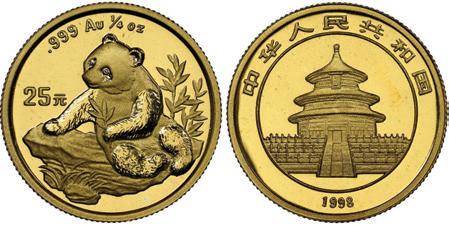


693. China (People’s Republic), gold 50 yuan (1/2 oz) Panda, 1998, large date (Shenyang mint), NGC MS 69 (“top pop”). KM-1129; PAN-304B. Lowest reported mintage of any year of 50 yuan gold Pandas, with very low survival estimate for this variety. Anthony: “1998 has become perhaps the most sought-after year for gold Pandas. All the coins from this year are key coins and the 50 Yuan is considered the rarest of all.” Actual mintage just 4,168 across both mints; estimated extant population for this variety <550. Pedigreed to the Gansu Collection of Chinese Panda Coinage. NGC #6472420-009. Estimate: $5,000-$7,500.
697. China (People’s Republic), gold 25 yuan (1/4 oz) Panda, 1999, small date (Shanghai mint), NGC MS 70 (“top pop”). KM-1219; PAN-318A. One of only 21 pieces at MS 70 in the current NGC census. This year is the only one in which all Pandas were struck at three separate mints. Anthony: “The 1999 25 Yuan 1/4 oz. gold Small Date Panda is another key coin.” Actual mintage for all the mints: 18,013; estimated extant population for this variety <1,000. Pedigreed to the Gansu Collection of Chinese Panda Coinage. NGC #6472422-008. Estimate: $2,000-$3,000.
694. China (People’s Republic), gold 100 yuan (1 oz) Panda, 1998, large date (Shenyang mint), NGC MS 69. KM-1130; PAN303B. Only one higher at MS 70 in the current NGC census. Anthony: “The 1998 100 Yuan 1 oz. gold Large Date Panda is one of the top dates in the Panda series. 1998 has become perhaps the most soughtafter year for gold Pandas. All the coins from this year are key coins... many from this year were melted and the remaining coins are few.” Mintage for both mints: 125,000 planned; 20,507 actual; estimated extant population for this variety <1,250. Pedigreed to the Gansu Col lection of Chinese Panda Coinage. NGC #6472420-010. Estimate: $2,000-$3,000.
695. China (People’s Republic), gold 5 yuan (1/20 oz) Panda, 1999, small date (Shanghai mint), NGC MS 69. KM-1215; PAN-320A. Only eighteen higher at MS 70 in the current NGC cen sus. This year is the only one in which all Pandas were struck at three separate mints. Anthony: “The 1999 5 Yuan 1/20 oz. gold Small Date Panda is another key coin.” Actual mintage for all the mints: 37,171; estimated extant population for this variety <2,500. Pedigreed to the Gansu Collection of Chinese Panda Coinage. NGC #6472422-006. Estimate: $300-$450.

696. China (People’s Republic), gold 10 yuan (1/10 oz) Panda, 1999, small date (Shanghai mint), NGC MS 69. KM-1218; PAN-319A. Only fifteen higher at MS 70 in the current NGC census. This year is the only one in which all Pandas were struck at three separate mints. Anthony: “The 1999 10 Yuan 1/10 oz. gold Small Date Panda is another key coin.” Actual mintage for all the mints: 25,501; estimated extant population for this variety <2,900. Pedigreed to the Gansu Collection of Chinese Panda Coinage. NGC #6472422-007. Estimate: $500-$750.


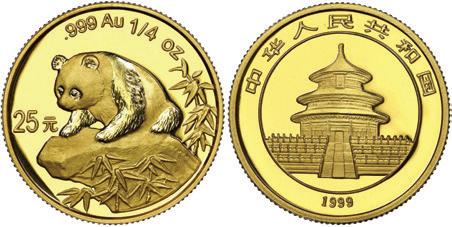



698. China (People’s Republic), gold 50 yuan (1/2 oz) Panda, 1999, small date (Shanghai mint), NGC MS 69 (“top pop”). KM-1220; PAN-317A. None graded higher in the current NGC census, with very low survival estimate. This year is the only one in which all Pandas were struck at three separate mints. Anthony: “The 1999 50 Yuan 1/2 oz. gold Small Date Panda is another key coin.” Actual mintage for all the mints: 12,482; estimated extant population for this variety <700. Pedigreed to the Gansu Collection of Chinese Panda Coinage. NGC #6472422-009. Estimate: $1,800-$2,600.
699. China (People’s Republic), gold 100 yuan (1 oz) Panda, 1999, small date (Shanghai mint), NGC MS 69 (“top pop”). KM-1221; PAN-316A. None graded higher in the current NGC census. This year is the only one in which all Pandas were struck at three separate mints. Anthony: “The 1999 100 Yuan 1 oz. gold Small Date Panda is another key coin.” Mintage for all the mints: 125,000 planned; 32,439 actual; estimated extant population for this variety <3,400. Pedigreed to the Gansu Collection of Chinese Panda Coinage. NGC #6472422-010. Estimate: $1,800-$2,600.
700. China (People’s Republic), gold 5 yuan (1/20 oz) Panda, 1999, large date plain 1 (Shenyang mint), NGC MS 69. KM-1215; PAN-320B. This year is the only one in which all Pandas were struck at three separate mints. Anthony: “The 1999 5 Yuan 1/20 oz. gold Large Date Panda Plain 1 is another impor tant coin.” Actual mintage for all the mints: 37,171; estimated extant population for this variety <10,000. Pedigreed to the Gansu Collection of Chinese Panda Coinage. NGC #6472422-001. Estimate: $200-$300.


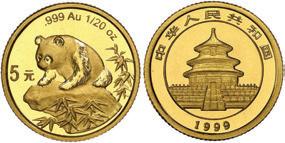


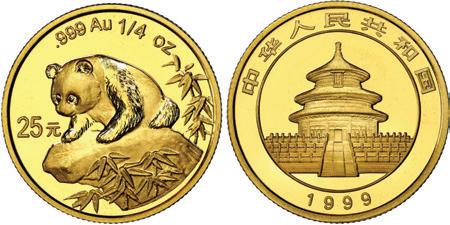
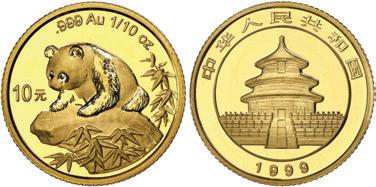
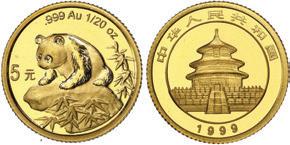
701. China (People’s Republic), gold 10 yuan (1/10 oz) Panda, 1999, large date plain 1 (Shenyang mint), NGC MS 69. KM-1218; PAN-319B. Only two higher at MS 70 in the current NGC census. This year is the only one in which all Pandas were struck at three separate mints. Anthony: “The 1999 10 Yuan 1/10 oz. gold Large Date Panda Plain 1 is another scarce coin.” Actual mintage for all the mints: 25,501; estimated extant population for this variety <9,450. Pedigreed to the Gansu Collection of Chinese Panda Coinage. NGC #6472422-002. Estimate: $300-$450.
702. China (People’s Repub lic), gold 25 yuan (1/4 oz) Panda, 1999, large date plain 1 (Shenyang mint), NGC MS 69. KM-1219; PAN-318B. Only seven higher at MS 70 in the current NGC census. This year is the only one in which all Pandas were struck at three separate mints. Anthony: “The 1999 25 Yuan 1/4 oz. gold Large Date Panda Plain 1 is another scarce coin.” Actual mintage for all the mints: 18,013; estimated extant population for this variety <4,750. Pedigreed to the Gansu Collection of Chinese Panda Coinage. NGC #6472422-003. Estimate: $800-$1,200.
703. China (People’s Republic), gold 50 yuan (1/2 oz) Panda, 1999, large date plain 1 (Shenyang mint), NGC MS 69. KM-1220; PAN-317B. Only two higher at MS 70 in the current NGC census. This year is the only one in which all Pandas were struck at three separate mints. Anthony: “The 1999 50 Yuan 1/2 oz. gold Large Date Panda Plain 1 is another scarce coin.” Actual mintage for all the mints: 12,482; estimated extant population for this variety <2,200. Pedigreed to the Gansu Collection of Chinese Panda Coinage. NGC #6472422-004. Estimate: $1,800-$2,600.
704. China (People’s Republic), gold 100 yuan (1 oz) Panda, 1999, large date plain 1 (Shenyang mint), NGC MS 69 (“top pop”). KM-1221; PAN-316B. None graded higher in the current NGC census. This year is the only one in which all Pandas were struck at three separate mints. Anthony: “The 1999 100 Yuan 1 oz. gold Large Date Panda Plain 1 is another scarce coin.” Mintage for all the mints: 125,000 planned; 32,439 actual; estimated extant population for this variety <6,400. Pedigreed to the Gansu Collection of Chinese Panda Coinage. NGC #6472422-005. Estimate: $1,800-$2,600. 705. China (People’s Republic), gold 5 yuan (1/20 oz) Panda, 1999, large date serif 1 (Shenzen Guobao mint), NGC MS 68. KM-1215; PAN-320C. This year saw the addi tion of the Shenzen Guobao mint to the lineup, in fact the only year in which all Pandas were struck at three separate mints. Actual mintage for all the mints: 37,171; estimated extant population for this variety <1,500. Pedigreed to the Gansu Collection of Chinese Panda Coinage. NGC #6472422-011. Estimate: $200-$300. 706. China (People’s Republic), gold 10 yuan (1/10 oz) Panda, 1999, large date serif 1 (Shenzen Guobao mint), NGC MS 69. KM-1218; PAN319C. New third-mint variety with very low survival estimate, only two higher at MS 70 in the current NGC census. Anthony: “The 1999 10 Yuan 1/10 oz. gold Large Date Panda Serif 1 is a very important coin.” Actual mintage for all the mints: 25,501; estimated extant population for this variety <650. Pedigreed to the Gansu Collection of Chinese Panda Coinage. NGC #3780759-005. Estimate: $300-$450. 707. China (People’s Repub lic), gold 25 yuan (1/4 oz) Panda, 1999, large date serif 1 (Shenzen Guobao mint), NGC MS 69. KM-1219; PAN-318C. New third-mint variety, only fifteen higher at MS 70 in the current NGC census. Anthony: “The 1999 25 Yuan 1/4 oz. gold Large Date Panda Serif 1 is a very important coin.” Actual mintage for all the mints: 18,013; estimated extant population for this variety <1,250. Pedigreed to the Gansu Collection of Chinese Panda Coinage. NGC #6472422-012. Estimate: $800-$1,200.
708. China (People’s Republic), gold 50 yuan (1/2 oz) Panda, 1999, large date serif 1 (Shenzen Guobao mint), NGC MS 70 (“top pop”). KM-1220; PAN-317C. One of only eight pieces at MS 70 in the current NGC census from this new third-mint variety, with very low survival estimate. The scarcest denomination of the 1999 gold Pandas, and another “very important coin” (Anthony). Actual mintage for all the mints: 12,482; estimated extant population for this variety <600. Pedigreed to the Gansu Collection of Chinese Panda Coinage. NGC #6472422-013. Estimate: $4,000-$6,000.
711. China (People’s Republic), gold 10 yuan (1/10 oz) Panda, 2000, mir rored ring (Shanghai mint), NGC MS 69. KM-1304; PAN-329B. Key coin with very low population estimate. In this year the differentiation between mints is made by the version of the outer ring; mirrored means Shanghai and frosted means Shenyang (none made at Shenzen Guobao). The mirrored-ring Pandas were intended for distribution only in China, hence they are all somewhat rare outside that country. Actual mintage for both mints: 44,511; estimated extant population for this variety <500. Pedigreed to the Gansu Collection of Chinese Panda Coinage. NGC #6472428-002. Estimate: $700-$1,000.
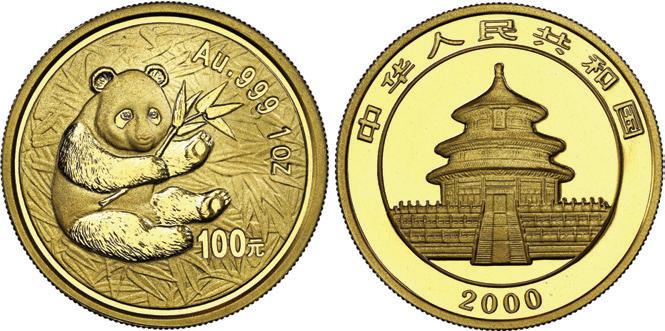




709. China (People’s Republic), gold 100 yuan (1 oz) Panda, 1999, large date serif 1 (Shenzen Guobao mint), NGC MS 68. KM-1221; PAN-316C. New third-mint variety. Anthony: “The 1999 100 Yuan 1 oz. gold Large Date Panda Serif 1 is a very important coin.” Mintage for all the mints: 125,000 planned; 32,439 actual; estimated extant population for this variety <3,200. Pedigreed to the Gansu Collection of Chinese Panda Coinage. NGC #6472422-014. Estimate: $1,600-$2,400.
710. China (People’s Republic), gold 5 yuan (1/20 oz) Panda, 2000, mirrored ring (Shanghai mint), NGC MS 69. KM-1302; PAN-330B. Key coin with very low population estimate, only two higher at MS 70 in the current NGC census, called by Anthony “quite possibly the rarest of all major Panda varieties.” In this year the differentiation between mints is made by the version of the outer ring; mirrored means Shanghai and frosted means Shenyang (none made at Shenzen Guobao). The mirrored-ring Pandas were intended for distribution only in China, hence they are all somewhat rare outside that country. Actual mintage for both mints: 41,837; estimated extant population for this variety <750. Pedigreed to the Gansu Collection of Chinese Panda Coinage. NGC #6472428-001. Estimate: $500-$750.

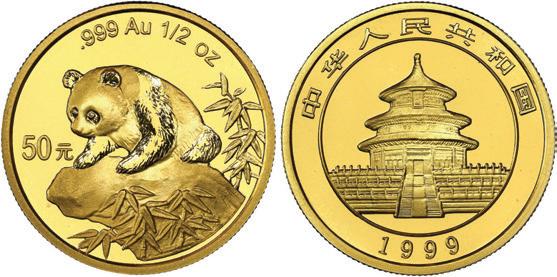
712. China (People’s Repub lic), gold 25 yuan (1/4 oz) Panda, 2000, mirrored ring (Shanghai mint), NGC MS 65. KM-1305; PAN-328B. Key coin with very low population estimate, this example under-graded in our opinion. In this year the differentiation between mints is made by the version of the outer ring; mirrored means Shanghai and frosted means Shenyang (none made at Shenzen Guobao). The mirrored-ring Pandas were intended for distribution only in China, hence they are all somewhat rare outside that country. Actual mintage for both mints: 24,811; estimated extant population for this variety <500. Pedigreed to the Gansu Collection of Chinese Panda Coinage. NGC #6472428-003. Estimate: $700-$1,000.
713. China (People’s Republic), gold 50 yuan (1/2 oz) Panda, 2000, mirrored ring (Shanghai mint), NGC MS 69 (“top pop”). KM-1306; PAN-327B. Key coin with very low population estimate. In this year the differentiation between mints is made by the version of the outer ring; mirrored means Shanghai and frosted means Shenyang (none made at Shenzen Guobao). The mirrored-ring Pandas were intended for distribution only in China, hence they are all somewhat rare outside that country. Actual mintage for both mints: 20,811; estimated extant population for this variety <500. Pedigreed to the Gansu Collection of Chinese Panda Coinage. NGC #6472428-004. Estimate: $3,000-$4,500.
714. China (People’s Republic), gold 100 yuan (1 oz) Panda, 2000, mir rored ring (Shanghai mint), NGC MS 69 (“top pop”). KM-1307; PAN-326B. Key coin with very low population estimate. In this year the differentiation between mints is made by the version of the outer ring; mirrored means Shanghai and frosted means Shenyang (none made at Shenzen Guobao). The mirrored-ring Pandas were intended for distribution only in China, hence they are all somewhat rare outside that country. Actual mintage for both mints: 29,011; estimated extant population for this variety <750. Pedigreed to the Gansu Collection of Chinese Panda Coinage. NGC #6472428-005. Estimate: $3,000-$4,500.
715. China (People’s Republic), gold 5 yuan (1/20 oz) Panda, 2000, frosted ring (Shenyang mint), NGC MS 69. KM-1302; PAN-330A. Anthony: “Like the 1998 and 1999 Pandas the 2000 was caught in the wake of the Asian financial crisis. Demand for gold Pandas plummeted and many are reported to have been melted. In addition there were cross-currents unique to this year as many coins were bought by non-collectors as keepsakes of the turn of the millennium.” Actual mintage for both mints: 41,837; estimated extant population for this variety <7,750. Pedigreed to the Gansu Col lection of Chinese Panda Coinage. NGC #6472428-006. Estimate: $200-$300.
716. China (People’s Republic), gold 10 yuan (1/10 oz) Panda, 2000, frosted ring (Shenyang mint), NGC MS 69. KM-1304; PAN-329A. Anthony: “Like the 1998 and 1999 Pandas the 2000 was caught in the wake of the Asian financial crisis. Demand for gold Pandas plummeted and many are reported to have been melted. In addition there were cross-currents unique to this year as many coins were bought by non-collectors as keepsakes of the turn of the mil lennium.” Actual mintage for both mints: 44,511; estimated extant population for this variety <8,500. Pedigreed to the Gansu Collection of Chinese Panda Coinage. NGC #6472428-007. Estimate: $300-$450.
717. China (People’s Republic), gold 25 yuan (1/4 oz) Panda, 2000, frosted ring (Shenyang mint), NGC MS 68. KM-1305; PAN-328A. Anthony: “Like the 1998 and 1999 Pandas the 2000 was caught in the wake of the Asian financial crisis. Demand for gold Pandas plummeted and many are reported to have been melted. In addition there were cross-currents unique to this year as many coins were bought by non-collectors as keepsakes of the turn of the mil lennium.” Actual mintage for both mints: 24,811; estimated extant population for this variety <5,000. Pedigreed to the Gansu Collection of Chinese Panda Coinage. NGC #6472428-008. Estimate: $400-$600.





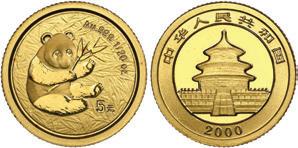
718. China (People’s Republic), gold 50 yuan (1/2 oz) Panda, 2000, frosted ring (Shenyang mint), NGC MS 69. KM-1306; PAN-327A. Scarcest denomination for this date set. Anthony: “Like the 1998 and 1999 Pandas the 2000 was caught in the wake of the Asian financial crisis. Demand for gold Pandas plummeted and many are reported to have been melted. In addition there were cross-currents unique to this year as many coins were bought by non-collectors as keepsakes of the turn of the millennium.”

Actual mintage for both mints: 20,811; estimated extant population for this variety <2,500. Pedigreed to the Gansu Collection of Chinese Panda Coinage. NGC #6472428-009. Estimate: $2,000-$3,000.

719. China (People’s Republic), gold 100 yuan (1 oz) Panda, 2000, frosted ring (Shenyang mint), NGC MS 68. KM-1307; PAN-326A. Anthony: “Like the 1998 and 1999 Pandas the 2000 was caught in the wake of the Asian financial crisis. Demand for gold Pandas plummeted and many are reported to have been melted. In addition there were cross-currents unique to this year as many coins were bought by non-collectors as keepsakes of the turn of the millennium.” Actual mintage for both mints: 29,011; estimated extant population for this variety <5,750. Pedigreed to the Gansu Collection of Chinese Panda Coinage. NGC #6472428-010. Estimate: $1,800-$2,600. 720. China (People’s Republic), gold 20 yuan (1/20 oz) Panda, 2001, NGC MS 68. KM-1366; PAN-339A. In this year the denomina tions on all the gold Pandas were increased by four or five times, but using the same weights as before, without any visible differentiation of mint. Also the outer ring on the Temple side became raised with incuse characters. Mintage: 200,000 (estimated extant <12,500). Pedigreed to the Gansu Collection of Chinese Panda Coinage. NGC #6472428-011. Estimate: $120-$180. 721. China (People’s Republic), gold 50 yuan (1/10 oz) Panda, 2001, NGC MS 69. KM-1367; PAN338A. Anthony: “not a common coin today.” In this year the denominations on all the gold Pandas were increased by four or five times, but using the same weights as before, without any visible differentiation of mint. Also the outer ring on the Temple side became raised with incuse characters. Mintage: 150,000 (estimated extant <9,000). Pedigreed to the Gansu Collection of Chinese Panda Coinage. NGC #6472428-012. Estimate: $200-$300. 722. China (People’s Republic), gold 100 yuan (1/4 oz) Panda, 2001, NGC MS 69. KM-1368; PAN-337A. Anthony: “not a common coin today.” In this year the denominations on all the gold Pandas were increased by four or five times, but using the same weights as before, without any visible differentiation of mint. Also the outer ring on the Temple side became raised with incuse characters. Mintage: 100,000 planned; 85,010 actual; estimated extant <6,200. Pedigreed to the Gansu Collection of Chinese Panda Coinage. NGC #6472428-013. Estimate: $500-$750.
Watch and bid LIVE on the Internet at www.auction.sedwickcoins.com
723. China (People’s Republic), gold 200 yuan (1/2 oz) Panda, 2001, NGC MS 69. KM-1369; PAN-336A. Only four higher at MS 70 in the current NGC census. Anthony: “not a common coin today.” In this year the denominations on all the gold Pandas were increased by four or five times, but using the same weights as before, without any visible differentiation of mint. Also the outer ring on the Temple side became raised with incuse characters. Mintage: 100,000 planned; 33,215 actual; estimated extant <3,000. Pedigreed to the Gansu Collection of Chinese Panda Coinage. NGC #6472428-014. Estimate: $1,200-$1,800.


727. China (People’s Republic), gold 100 yuan (1/4 oz) Panda, 2001 D, NGC MS 69. KM-1368; PAN-343A. The “D” mark (used only in this year) indicated production for domestic use as op posed to export. Naturally they are elusive outside of China. Anthony: “a scarcer coin today.” Mintage: 70,000 planned; 100,000 actual; estimated extant <3,000. Pedigreed to the Gansu Collection of Chinese Panda Coinage. NGC #6472430-003. Estimate: $500-$750.
728. China (People’s Republic), gold 200 yuan (1/2 oz) Panda, 2001 D, NGC MS 69. KM-1369; PAN-342A. The “D” mark (used only in this year) indicated production for domestic use as op posed to export. Naturally they are elusive outside of China. Anthony: “a very scarce coin today.” Mintage: 75,000 planned; 100,000 actual; estimated extant <2,000 extant. Pedigreed to the Gansu Collection of Chi nese Panda Coinage. NGC #6472430-004. Estimate: $1,200-$1,800.
724. China (People’s Republic), gold 500 yuan (1 oz) Panda, 2001, NGC MS 69. KM-1371; PAN-335A. Only six higher at MS 70 in the current NGC census. Anthony: “not a common coin today.” In this year the denominations on all the gold Pandas were increased by four or five times, but using the same weights as before, without any visible differentiation of mint. Also the outer ring on the Temple side became raised with incuse characters. Mintage: 150,000 planned; 41,411 actual; estimated extant <8,500. Pedigreed to the Gansu Col lection of Chinese Panda Coinage. NGC #6472428-015. Estimate: $1,800-$2,600.





725. China (People’s Republic), gold 20 yuan (1/20 oz) Panda, 2001 D, NGC MS 69. KM-1366; PAN-345A. The “D” mark (used only in this year) indicated production for domestic use as opposed to export. Naturally they are elusive outside of China. Anthony: “The 2001D 20Y 1/20 oz. B.U. gold Panda has no an nounced mintage and it is a fairly scarce coin today.” Mintage: 100,000 planned (estimated extant <6,000). Pedigreed to the Gansu Collection of Chinese Panda Coinage. NGC #6472430-001. Estimate: $150-$225. 726. China (People’s Republic), gold 50 yuan (1/10 oz) Panda, 2001 D, NGC MS 69. KM-1367; PAN-344A. The “D” mark (used only in this year) indicated production for domestic use as opposed to export. Naturally they are elusive outside of China. An thony: “The 2001D 50Y 1/10 oz. B.U. gold Panda has no announced mintage and it is a fairly scarce coin today.” Mintage: 100,000 planned (estimated extant <4,600). Pedigreed to the Gansu Collection of Chinese Panda Coinage. NGC #6472430-002. Estimate: $200-$300.
729. China (People’s Republic), gold 500 yuan (1 oz) Panda, 2001 D, NGC MS 69. KM-1371; PAN-341A. The “D” mark (used only in this year) indicated production for domestic use as opposed to export. Naturally they are elusive outside of China. Anthony: “a scarcer coin today.” Mintage: 100,000 planned; 150,000 actual; esti mated extant <3,800. Pedigreed to the Gansu Collection of Chinese Panda Coinage. NGC #6472430-005. Estimate: $1,800-$2,600.
730. China (People’s Republic), gold 20 yuan (1/20 oz) Panda, 2002, mirrored bamboo (Shanghai mint), NGC MS 69 (“top pop”). KM-1366; PAN-353A. One of only seven at this top grade in the current NGC census specifically for this variety (but many more at MS 70 without specified variety). All the MS gold of 2002 are scarce, and 2002 is a key year in general (in fact the only year to repeat the design from the previous year, albeit with a new edge-reeding that is diagonal instead of vertical). The “mirrored bamboo” versions, referring to branch tips at the rim, are accompanied by a lower neckline on the panda and indicate Shanghai mint; the “frosted bamboo” versions come from the Shenzen mint. Mintage for both mints: 200,000 planned; 74,601 actual; estimated extant (both varieties) <5,700. Pedigreed to the Gansu Collection of Chinese Panda Coinage. NGC #6472430-006. Estimate: $150-$225.
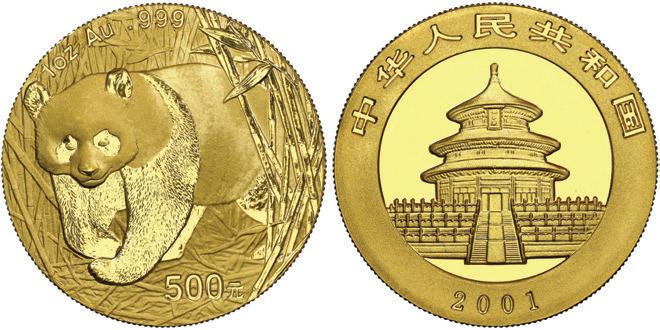
731. China (People’s Republic), gold 200 yuan (1/2 oz) Panda, 2002, mirrored bam boo (Shanghai mint), NGC MS 69 (“top pop”). KM-1459; PAN-350A. One of only four at this top grade in the current NGC census specifically for this variety, with only ten higher at MS 70 for all varieties (including unspecified). Anthony: “this coin can be a challenge to find.” All the MS gold of 2002 are scarce, and 2002 is a key year in general (in fact the only year to repeat the design from the previous year, albeit with a new edge-reeding that is diago nal instead of vertical). The “mirrored bamboo” versions, referring to branch tips at the rim, are accompanied by a lower neckline on the panda and indicate Shanghai mint; the “frosted bamboo” versions come from the Shenzen mint. Mintage for both mints: 100,000 planned; 28,514 actual; estimated extant (both varieties) <2,900. Pedigreed to the Gansu Collection of Chinese Panda Coinage. NGC #4192709-055. Estimate: $2,000-$3,000. 732. China (People’s Republic), gold 20 yuan (1/20 oz) Panda, 2002, frosted bamboo (Shenzen Guobao mint), NGC MS 69. KM-1366; PAN-353B. Only one higher at MS 70 in the current NGC census specifically for this variety (but many more without specified variety). All the MS gold of 2002 are scarce, and 2002 is a key year in general (in fact the only year to repeat the design from the previous year, albeit with a new edge-reeding that is diagonal instead of vertical). The “mirrored bamboo” versions, referring to branch tips at the rim, are accompanied by a lower neckline on the panda and indicate Shanghai mint; the “frosted bamboo” versions come from the Shenzen mint. Mintage for both mints: 200,000 planned; 74,601 actual; estimated extant (both varieties) <5,700. Pedigreed to the Gansu Collection of Chinese Panda Coinage. NGC #4192722-016. Estimate: $200-$300. 733. China (People’s Republic), gold 50 yuan (1/10 oz) Panda, 2002, frosted bamboo (Shenzen Guobao mint), NGC MS 69. KM-1457; PAN352B. All the MS gold of 2002 are scarce, and 2002 is a key year in general (in fact the only year to repeat the design from the previous year, albeit with a new edge-reeding that is diagonal instead of vertical). The “mirrored bamboo” versions, referring to branch tips at the rim, are accompanied by a lower neckline on the panda and indicate Shanghai mint; the “frosted bamboo” versions come from the Shenzen mint. Mintage for both mints: 150,000 planned; 36,092 actual; estimated extant (both varieties) <3,800. Pedigreed to the Gansu Collection of Chinese Panda Coinage. NGC #6472430-007. Estimate: $700-$1,000.
734. China (People’s Repub lic), gold 100 yuan (1/4 oz) Panda, 2002, frosted bamboo (Shenzen Guobao mint), NGC MS 69. KM-1458; PAN-351B. Only three higher at MS 70 in the cur rent NGC census specifically for this variety and only 26 more at that grade without variety specified. All the MS gold of 2002 are scarce, and 2002 is a key year in general (in fact the only year to repeat the design from the previous year, albeit with a new edge-reeding that is diagonal instead of vertical). The “mirrored bamboo” versions, referring to branch tips at the rim, are accompanied by a lower neckline on the panda and indicate Shanghai mint; the “frosted bamboo” versions come from the Shenzen mint. Mintage for both mints: 100,000 planned; 19,205 actual; estimated extant (both varieties) <5,000. Pedigreed to the Gansu Collection of Chinese Panda Coinage. NGC #6472430-008. Estimate: $800-$1,200.
735. China (People’s Republic), gold 200 yuan (1/2 oz) Panda, 2002, frosted bamboo (Shenzen Guobao mint), NGC MS 69. KM-1459; PAN-350B. Only one higher at MS 70 in the current NGC census specifically for this variety and only ten more at that grade without variety specified. Anthony: “this coin can be a challenge to find.” All the MS gold of 2002 are scarce, and 2002 is a key year in general (in fact the only year to repeat the design from the previous year, albeit with a new edge-reeding that is diagonal instead of vertical). The “mirrored bamboo” versions, referring to branch tips at the rim, are accompanied by a lower neckline on the panda and indicate Shanghai mint; the “frosted bamboo” versions come from the Shenzen mint. Mintage for both mints: 100,000 planned; 28,514 actual; estimated extant (both varieties) <2,900. Pedigreed to the Gansu Collection of Chinese Panda Coinage. NGC #6472430-009. Estimate: $2,000-$3,000.



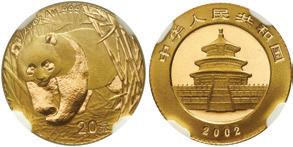
736. China (People’s Republic), gold 500 yuan (1 oz) Panda, 2002, frosted bamboo (Shenzen Guobao mint), NGC MS 69. KM-1460; PAN-349B. Only two higher at MS 70 in the current NGC census specifically for this variety and only eighteen more at that grade without variety specified. All the MS gold of 2002 are scarce, and 2002 is a key year in general (in fact the only year to repeat the design from the previous year, albeit with a new edge-reeding that is diagonal instead of vertical). The “mirrored bamboo” ver sions, referring to branch tips at the rim, are accompanied by a lower neckline on the panda and indicate Shanghai mint; the “frosted bamboo” versions come from the Shenzen mint. Mintage for both mints: 150,000 planned; 28,345 actual; estimated extant (both varieties) <5,000. Pedigreed to the Gansu Collection of Chinese Panda Coinage. NGC #6472430-010. Estimate: $1,800-$2,600.


737. China (People’s Republic), platinum proof 100 yuan (1/10 oz) Panda, 2002, 20th Anniversary of the Issuance of Chinese Panda Coinage, NGC PF 70 Ultra Cameo (“top pop”). KM-1415; PAN-357A. One of only eighteen pieces at MS 70 in the current NGC census. Anthony: “The 2002 100 Yuan platinum Panda stands out from all the other six hundred odd Panda coins... [as it] is the only one to ever display a Panda on both sides.” Mint age: 20,000 (surviving unknown). Pedigreed to the Gansu Collection of Chinese Panda Coinage. NGC #6472528-006. Estimate: $300-$450. 738. China (People’s Republic), gold 20 yuan (1/20 oz) Panda, 2003, mirrored bamboo (Shanghai mint), NGC MS 70 (“top pop”). KM-1467; PAN-366A. One of only 39 pieces at MS 70 in the current NGC census. Anthony: “Despite the high mintage it isn’t a common coin and sells for a premium.” For this year, “mirrored bamboo” (indicative of Shanghai mint) refers to the background of the bamboo forest around the panda. Mintage for both varieties: 400,000 planned; 117,000 actual; estimated extant <17,000. Pedigreed to the Gansu Collection of Chinese Panda Coinage. NGC #4192722-018. Estimate: $200-$300. 739. China (People’s Republic), gold 50 yuan (1/10 oz) Panda, 2003, mirrored bamboo (Shanghai mint), NGC MS 70 (“top pop”). KM-1469; PAN-365A. One of only 36 pieces at MS 70 in the current NGC census. Anthony: “Despite the somewhat high mintage it isn’t a common coin and sells for a premium.” For this year, “mirrored bamboo” (indicative of Shanghai mint) refers to the background of the bamboo forest around the panda. Mintage for both varieties: 250,000 planned; 47,500 actual; estimated extant <14,000. Pedigreed to the Gansu Collection of Chinese Panda Coinage. NGC #6472430-012. Estimate: $300-$450. 740. China (People’s Repub lic), gold 100 yuan (1/4 oz) Panda, 2003, mirrored bamboo (Shanghai mint), NGC MS 69. KM-1471; PAN-364A. An thony: “Despite the somewhat high mintage it isn’t a common coin and sells for a premium.” For this year, “mirrored bamboo” (indicative of Shanghai mint) refers to the background of the bamboo forest around the panda. Mintage for both varieties: 70,000 planned; 28,000 actual; estimated extant <5,000 extant. Pedigreed to the Gansu Collection of Chinese Panda Coinage. NGC #6472430-013. Estimate: $500-$750.
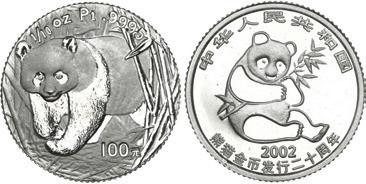
741. China (People’s Republic), gold 500 yuan (1 oz) Panda, 2003, mirrored bamboo (Shanghai mint), NGC MS 69. KM-1474; PAN-362A. Only nine higher at MS 70 in the current NGC census. Anthony: “Despite the somewhat high mintage it isn’t a com mon coin and sells for a premium.” For this year, “mirrored bamboo” (indicative of Shanghai mint) refers to the background of the bamboo forest around the panda. Mintage for both varieties: 120,000 planned; 36,300 actual; estimated extant <6,500. Pedigreed to the Gansu Col lection of Chinese Panda Coinage. NGC #6472430-015. Estimate: $2,000-$3,000.
742. China (People’s Repub lic), gold 100 yuan (1/4 oz) Panda, 2003, frosted bamboo (Shenyang mint), NGC MS 69. KM-1471; PAN-364B. Anthony: “De spite the somewhat high mintage it isn’t a common coin and sells for a premium.” For this year, “frosted bamboo” (indicative of Shenyang mint) refers to the background of the bamboo forest around the panda. Mintage for both varieties: 70,000 planned; 28,000 actual; estimated extant <5,000 extant. Pedigreed to the Gansu Collection of Chinese Panda Coinage. NGC #6472528-007. Estimate: $400-$600.

743. China (People’s Republic), gold 200 yuan (1/2 oz) Panda, 2003, frosted bamboo (Shenyang mint), NGC MS 69. KM-1472; PAN-363B. Only ten higher at MS 70 in the current NGC census for this specific variety (with another 24 at same grade either unspecified or of the mirrored variety). Anthony: “Despite the some what high mintage it isn’t a common coin and sells for a premium.” For this year, “frosted bamboo” (indicative of Shenyang mint) refers to the background of the bamboo forest around the panda. Mintage for both varieties: 75,000 planned; 25,000 actual; estimated extant <3,000. Pedigreed to the Gansu Collection of Chinese Panda Coinage. NGC #6472430-014. Estimate: $1,200-$1,800.


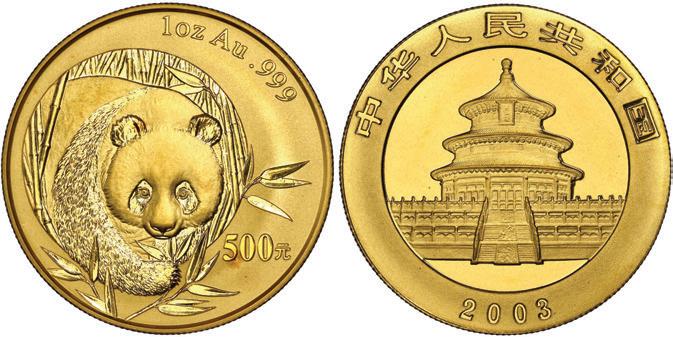


744. China (People’s Republic), platinum proof 50 yuan (1/20 oz) Panda, 2003, NGC PF 70 Ultra Cameo (“top pop”). KM-1470; PAN-320A. The first of just two years of 1/20 oz platinum pandas (and the only plati num Panda issue for this date). Mintage: 50,000 (surviving unknown). Pedigreed to the Gansu Collection of Chinese Panda Coinage. NGC #3768707-006. Estimate: $300-$450.
745. China (People’s Republic), palladium proof 100 yuan (1/2 oz) Panda, 2004, NGC PF 70 Ultra Cameo (“top pop”). KM-1531; PAN-379A. One of only three years in which any palladium Pandas were minted (the others being 1989 and 2005). Mintage: 8,000 planned (actual and surviving unknown). Pedigreed to the Gansu Collection of Chinese Panda Coinage. NGC #6472528-003. Estimate: $1,200-$1,800.
746. China (People’s Republic), platinum proof 50 yuan (1/20 oz) Panda, 2004, NGC PF 69 Ultra Cameo. KM-1532; PAN-380A. The final date of 1/20 oz platinum Pandas (and the only platinum Panda issue for this date). Mintage: 50,000 planned (actual and surviving unknown). Pedigreed to the Gansu Collection of Chinese Panda Coinage. NGC #6472462-014. Estimate: $150-$225.
747. China (People’s Republic), palladium proof 100 yuan (1/2 oz) Panda, 2005, NGC PF 69 Ultra Cameo. KM-1590; PAN-396A. The final date of all palladium Pandas. Mintage: 8,000 planned (actual and surviving unknown). Pedigreed to the Gansu Collection of Chinese Panda Coinage. NGC #6472528-004. Estimate: $1,200-$1,800.

748. China (People’s Republic), platinum proof 100 yuan (1/10 oz) Panda, 2005, NGC PF 69 Ultra Cameo. KM-1591; PAN-397A. The final date of all platinum Pandas. Mintage: 30,000 planned (actual and surviving unknown). Pedigreed to the Gansu Collection of Chinese Panda Coinage. NGC #6472462-015. Estimate: $150-$225.
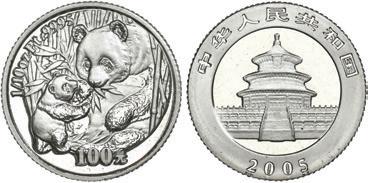





749. Argentina (River Plate Provinces), Potosí mint, 8 reales, 1813 J, NGC MS 63. Janson-4.1; KM-5. Choice strike with full rims and sharp details all over, nice luster, very minor lamination flaw at L of DEL, among the finest graded. NGC #6472683-001. Estimate: $2,000-$3,000.
750. Argentina (River Plate Provinces), Potosí mint, 8 reales, 1815 F, PROVICIAS error, NGC AU details / cleaned. Janson-5.2.2; KM-14. Lightly rainbow toned over luster and light surface hairlines, always a popular error. NGC #6610345-003. Estimate: $2,000-$3,000.
751. Argentina (River Plate Provinces), Potosí mint, 1/2 real, 1813 J, NGC AU 58. Janson-16.1.2; KM-1.1. Bold strike with light toning over luster, the rarer of two sunface dies listed in Janson. NGC #6475053-006. Estimate: $600-$900.

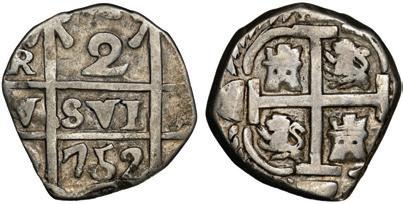

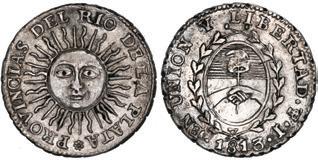
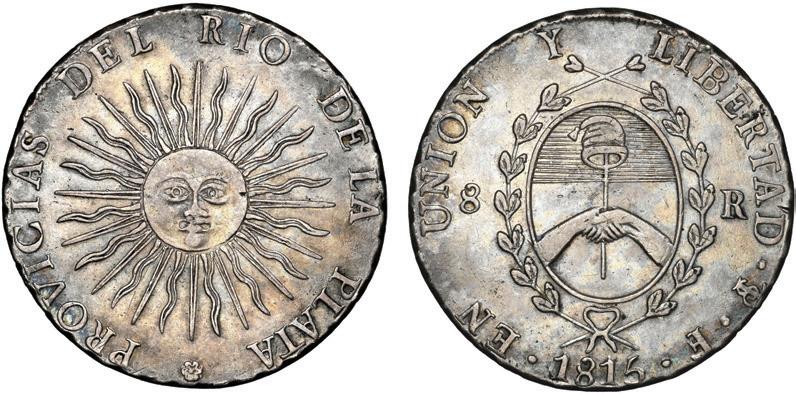

752. Argentina (River Plate Provinces), La Rioja mint, 4 soles, 1832 P, NGC MS 63 (“top pop”). Janson-40; KM-22. Muted luster with toning (including diagonal dark streak through center), minor natural flaw in center of shield, tied with one other for finest in current NGC census, notably superior to the Pat Johnson example. NGC #6475053-004. Estimate: $2,000-$3,000.
753. Tucumán, Argentina, “imitation cob” 2 reales, date “752” (unofficial issue, struck 1820-24), proper quadrants, R at top left, solid oval at bottom right, solid semi-oval at bottom left, rare, NGC VF 30. Janson-2.2; KM-1. 4.71 grams. Full pillars with clear date, bold R at top left and traces of oval figures flank ing the date (“clandestine striking,” according to Janson), choice full cross with castles and lions in proper quadrants, faintly toned. NGC #6477718-001. Estimate: $500-$750.
754. Tucumán, Argentina, “imitation cob” 2 reales, date “752” (official issue, struck 1820-24), proper quadrants, R at top right, oval with N/T at bottom right, rare, Janson Plate. Janson-1.2; KM-1. 5.00 grams. Bold and very richly toned AXF with full cross-lions-castles, off-center pillars with full date and clear partial R at top and N/T on oval at bottom on the right side. Plate Coin on page 487 of La Moneda Circulante En El Territorio Argentino 1547-2019, by Hector Carlos Janson (2020). Estimate: $600-$900.
755. Buenos Aires, Argentina, copper 20 décimos, 1830, NGC MS 64 BN, finest known in the NGC census. Janson-4.1; KM-5. Choice strike and nice natural copper-brown color with traces of luster, the finest in the NGC census by five grades. NGC #6443475008. Estimate: $700-$1,000.
756. Buenos Aires, Argentina, copper 5 décimos, 1827, coin axis, struck 30% off-center over a 1 décimo of 1822-3, NGC Mint Error MS 65 RB, finest known in NGC census. Janson-9; KM-3. Choice luster and original copper color, with full details on 30% of the under-coin (darker) visible due to the centering error. NGC #6474385-010. Estimate: $200-$300.

759. La Rioja, Argentina, 8 reales, 1831 P, very rare, NGC AU 58. Janson-32.2; KM-20. Frosty luster for the grade, with slightly weak strike in parts of legends, second finest in current NGC census behind a single MS 62. This coinage represents a fascinating period in history (as related in full in the accompanying book by Mariano Cohen): In 1829, the Unitary Party under the command of General Lamadrid invaded La Rioja, and in response the population left the city under orders by their provincial chief Facundo Quiroga, who also took all the coins and minting machinery to Los Llanos and buried them, thus creating the legend of Los Tapados de Quiroga (The Hoards of Quiroga). Lamadrid found the machinery in 1830 and struck new coins with new dies. Then in 1831 the Federalists took over, made new dies again (with some slight differences), and struck coins like the one you see here. Accompanied by the book Monedas Riojanas en La Era Quiroga 1824-1835 (2019), by Mariano Cohen. NGC #6475053-001. Estimate: $2,000-$3,000.
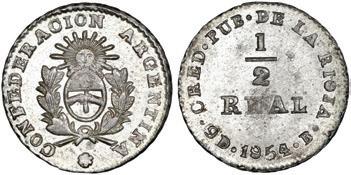


757. Buenos Aires, Argentina, copper 5 décimos, 1827, coin axis, struck 10% off-center over a 1 décimo of 1822-3, NGC Mint Error MS 64 RB. Janson-9; KM-3. Bright luster and original color, only a small part of the under-coin details visible at edge. NGC #6474385-011. Estimate: $200-$300.
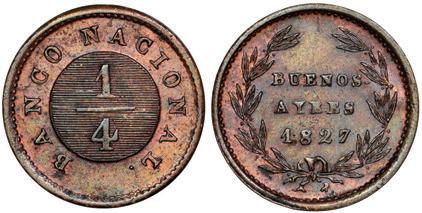


758. Buenos Aires, Argentina, copper 1/4 real, 1827, NGC MS 62 BN, ex-O’Brien. Janson-13; KM-2. Rainbow toned over luster, scarce one-year type, second finest (O’Brien: “finest seen”) in current NGC census behind a single MS 64. Pedigreed to the John O’Brien Col lection (stated on label), with his tag. NGC #6614418-003. Estimate: $400-$600.
760. La Rioja, Argentina, 8 reales, 1836 P, variety without leaves between laurels, very rare, NGC MS 65, ex-Janson, Cohen Plate Coin. Janson-37; KM-20. Brilliantly lustrous with trace of light toning, very deeply struck with choice details, small natural void in edge, desirable pedigree, second finest in current NGC census behind a single MS 66*. Pedigreed to the Carlos Janson Collection, also Plate Coin on page 107 of Mariano Cohen’s Monedas Riojanas en La Era Quiroga 1824-1835 (2019), with copy of that book. NGC #6477169001. Estimate: $2,000-$3,000. 761. La Rioja, Argentina, 1/2 real, 1854 B, CRED. PUB. variety, NGC MS 66, finest known in the NGC cen sus. Janson-69; KM-25. Nearly prooflike with bold details against brightly lustrous fields, finest at NGC by two grades above a single MS 64. NGC #6354751003. Estimate: $400-$600.
762. Córdoba, Argentina, 2 reales, 1844, CONFEDERADA, dot under rosette, NGC MS 63 (“top pop”). Janson-48.2.18; KM-23. From a complicated series of five groups differentiated by many minor details (including styles of castles and numbers of sun-rays, this one falling under Janson’s Type I Group b), with rather lustrous fields around full but slightly crude details, tied with two others for finest in current NGC census. NGC #6475053-003. Estimate: $200-$300.


763. Argentina, copper 1 centavo, 1886, NGC MS 63 BN. Janson-42.1; KM-7. Traces of original color and luster draped with light, uneven toning, tied with an RD example for second highest grade in current NGC census behind a single MS 64. NGC #6611408-006. Estimate: $400-$600.


764. Tierra del Fuego (struck in Buenos Aires), Argentina, gold 5 gramos, Popper, 1889, rare, NGC MS 63. Janson-5; KMTn8. Choice luster with light purplish toning, very natural-looking and pretty, the rarer of just two denominations in a one-year type (highly sought by numismatists) struck by Romanian-Jewish gold-prospector Julius Popper using gold dust found on the beach of El Paramo in the Patagonian peninsula. Popper’s expedition, under the name of Gold-Washing Company of the South (Lavaderos de Oro del Sud), achieved a sort of autonomy, with its own army and coins and stamps, as well as a notorious “wild west” atmosphere replete with crime and abuse of natives. Popper died suddenly and mysteriously in 1893. NGC #6478799-001. Estimate: $6,000-$9,000.
765. Tierra del Fuego (struck in Buenos Aires), Argentina, gold 1 gramo, Popper, 1889, large letters, NGC MS 62. Janson-7; KM-Tn5. Ample luster with traces of light rainbow toning, a one-year type (highly sought by numismatists) struck by Romanian-Jewish goldprospector Julius Popper using gold dust found on the beach of El Paramo in the Patagonian peninsula. Popper’s expedition, under the name of Gold-Washing Company of the South (Lavaderos de Oro del Sud), achieved a sort of autonomy, with its own army and coins and stamps, as well as a notorious “wild west” atmosphere replete with crime and abuse of natives. Popper died suddenly and mysteriously in 1893. NGC #6354751-001. Estimate: $2,000-$3,000.
766. Austria (Hall mint), thaler, Leopold, 1628/6, NGC AU 58, finest known in NGC census. Dav-3338 for type; KM-unl (629.2 for type). Very deeply rainbow toned all over, with some faint underly ing luster, wear on highest points only, the overdate quite discernible (unlisted in KM). NGC #6351122-010. Estimate: $400-$600.
768. Flanders, Belgium, gold lion d’or, Louis II de Male (1346-84), PCGS MS63. Fr-157. Broad flan with 100% legends and inner details (all well struck), nice luster and no wear, a monument to the intricately artistic style that characterizes this period. PCGS #18472032. Estimate: $5,000-$7,500.
767. Salzburg, Austria, 1/2 thaler, Johann Ernst, 1694, PCGS MS62. KM-253. Beautifully rainbow toned on reverse (featuring facing seated portraits of saints Rupert and Virgil), the obverse white with luster, sharply detailed all over. Pedigreed to a banker’s collection from the early 1900s. PCGS #44782638. Estimate: $700-$1,000.


769. Full denomination set of four copper Mechelen, Belgium, undated church tokens (1888), St. Rumbold’s Cathedral, in PCGS slabs: 100 centimes, MS62BN; 75 centimes, MS62RB; 50 centimes, MS64RB; and 25 centimes, MS64RD. Choice complete set of four dif ferent denominations, all with at least some violet toning and traces of original luster (especially on the middle two), all with lion in shield between S and R (for St. Rumbold) on one side and denomination within (or below, on the smallest) legends referring to the Ecclesia Metropolitana Mechliniae (Metropolitan Church of Mechelen), no others graded by PCGS or NGC and apparently quite rare in Mint State. The unusually shaped St. Rumbold’s Cathedral was supposed to be the tallest church tower in the world (a superlative owned instead by the Ulm Minster in Germany), but its construction was abandoned in the early 1500s due to financial reasons. Tokens like these mostly likely were used in the admin istration of alms to the needy during a lull in government services to that effect. PCGS #37805090, 37805091, 37805092 and 44839965. Estimate: $200-$300.


770. Potosí, Bolivia, gold bust 8 escudos, Charles III, 1778 PR, very rare, NGC AU 58, finest known in NGC census. Janson-68.1; KM-59; Cal-2061. Very highly desirable first date of type, struck in only 1,030 pieces, representing the very first gold coins struck at this prolific mint after two centuries of silver-only production, notably missing in major collections like Eliasberg and Garrett (and so many others), this example with good luster and only a few small marks away from Mint State, hands down the finest of only three that have made it to market in at least the past decade, including an AU 53 we offered in October 2013 (Sedwick Auction 14). NGC #6472679-004. Estimate: $6,000-$9,000.

771. Potosí, Bolivia, gold bust 8 escudos, Charles III, 1788 PR, NGC MS 61. Janson-68.11.1; KM-59; Cal-2075. Choice luster and strike, the reverse virtually pristine but the obverse surface slightly granular, tied with one other for second finest in the current NGC census behind a single MS 62 placed into a separate category without assayer (for no apparent reason). NGC #6472679-005. Estimate: $1,500-$2,250.


772. La Plata, Bolivia (minted in Potosí), gold 8 escudos proclamation medal, Ferdinand VII, 1808, by Moncayo, very rare. Medina-311; Herrera-26 (in silver). 26.97 grams; 37 mm. This is a very important medal that has yet to see its proper potential in multiple appear ances in both European and American auctions (with only one other example appearing in the meantime). The famous Argentine numismatic historian Arnaldo Cunietti-Ferrando (quoted in an article by Luciano Pezzano in 2014) described it thus: “The most magnificent medals of oath under this king refer to the city of La Plata. They represent the arms of this city artistically displayed while the obverse shows a scene of highly developed political reference: a crowned lion holds its right claw on a castle and the left on a two-headed eagle which lies dead on the ground, thus symbolizing the fall of the Napoleonic regime in Spain.” The legends read 1808 . FERDINANDO . VII . . . HISP . ET IND . R . [La Plata monogram] / OPTIMO . PRINC . PUBLICE . FIDELIT . IURAT, and the edge is diagonally reeded, as presumably struck on the flan for a Potosí 8 escudos. It is significant to note that Medina (1917) mentions an “example in gold owned by this collector” and relates details from an 1809 document about the dissemination of these medals (presumably the silver ones) to the public in a grand ceremony. In any case the present example is a beautiful medal, in lustrous AU grade, only lightly hairlined from cleaning, but also with a very expertly plugged hole at top, the overlooked presence and subsequent over-explanation of which seems to have dampened the importance and appeal, both historically and aesthetically, of what is potentially one of Bolivia’s greatest numismatic treasures. Estimate: $3,000-$4,500.

773. Potosí, Bolivia, bust 8 reales, Charles III, 1774 JR, NGC MS 63+. Janson-63.2; KM-55; Cal-1170. With faint golden toning over highly lustrous fields, somewhat prooflike and relatively devoid of small marks, in our opinion begging a higher grade as certainly comparable to or even better than the MS 64’s we have seen. NGC #6610345-001. Estimate: $2,000-$3,000.
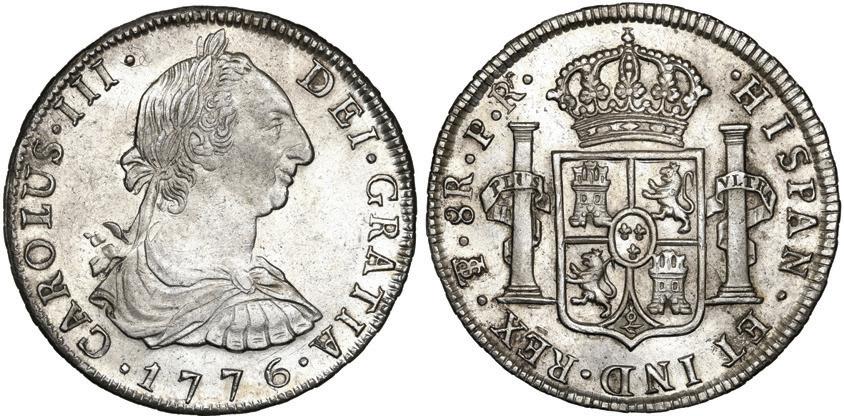
774. Potosí, Bolivia, bust 8 reales, Charles III, 1776 PR, NGC MS 62. Janson-63.5; KM-55; Cal-1173. Brightly lustrous with faint traces of light golden toning, trifle hairlines, popular date with U.S. collectors, tied with three others for second finest in current NGC census behind a single MS 63. NGC #6610347-001. Estimate: $2,000-$3,000.

775. Potosí, Bolivia, bust 8 reales, Charles IV, 1805 PJ, NGC


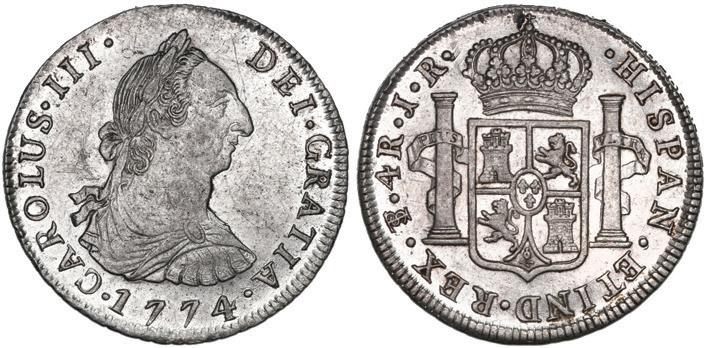

MS 60. Janson-76.17.2; KM-73; Cal-1010. Strong luster for the grade, very lightly gold-toned over faint surface hairlines, high points on reverse a trifle weak. NGC #6445262-003. Estimate: $300-$450.
778. Potosí, Bolivia, bust 4 reales, Charles III, 1774 JR, NGC AU 58 (“top pop”). Janson-64.2.1; KM-54; Cal-931. Frosty with luster but a few too many light marks to make MS, currently tied with two others for finest in the NGC census. NGC #6474385-002. Estimate: $200-$300.

776. Potosí, Bolivia, bust 8 reales, Charles IV, 1808 PJ, NGC
MS 62. Janson-76.20; KM-73; Cal-1014. Well toned over muted luster, with traces of rainbow colors around details, minor natural edge-flaw at top. As pointed out by Cunietti and Janson, mintage figures for 1809-12 include coins struck with 1808 Charles IV dies while Ferdinand VII coins dated 1808 and 1809 were struck in 1813. NGC #6443032-002. Estimate: $300-$450.

779. Potosí, Bolivia, bust 4 reales, Charles III, 1779 PR, NGC AU 53. Janson-64.8.2; KM-54; Cal-941. Deeply rainbow toned with underlying luster, the reverse more like MS but the bust a bit weak and worn. NGC #6475053-002. Estimate: $200-$300.
777. Potosí, Bolivia, bust 4 reales, Charles III, 1773 JR, with dot above mintmark, NGC MS 62, finest known in NGC census. Janson-64.1.4; KM-54; Cal-929. With mirror luster and light gold toning, just a bit weakly struck in the crown, this is the sole finest for the desirable first year of issue, also a scarce variety (not noted by NGC). NGC #6474385-003. Estimate: $300-$450.
780. Potosí, Bolivia, bust 2 reales, Charles III, 1773 JR, NGC MS 61, finest known in NGC census. Janson-65.1.1; KM53; Cal-712. Bold strike with frosty luster, some areas of dark toning near reverse rim, desirable first date of issue. NGC #6474385-004. Estimate: $250-$375. 781. Potosí, Bolivia, bust 1 real, Charles III, 1775 JR, NGC MS 63+, finest known in NGC census. Janson-66.3.1; KM-53; Cal-716. Broad flan with full rims, gorgeous full luster, traces of rainbow toning around details, far and away the finest graded by NGC (next best being AU 58). NGC #6474385-005. Estimate: $200-$300.
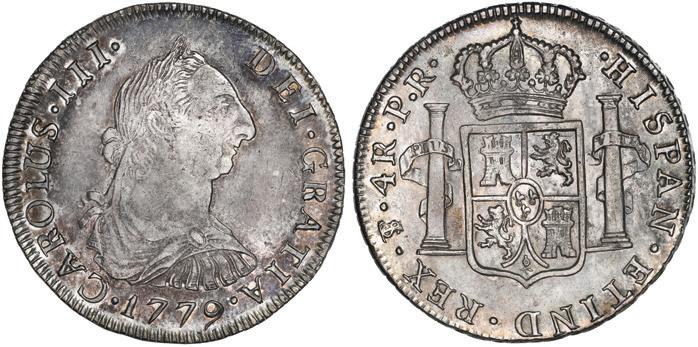
782. Potosí, Bolivia, bust 1/2 real, Ferdinand VII, 1821 PJ, NGC MS 65. Janson-90.6; KM-90; Cal-436. Bold strike and satin-smooth fields graced with light rainbow toning over luster, currently tied with one other for second finest in the NGC census behind a single MS 66. NGC #3155432-001. Estimate: $200-$300.
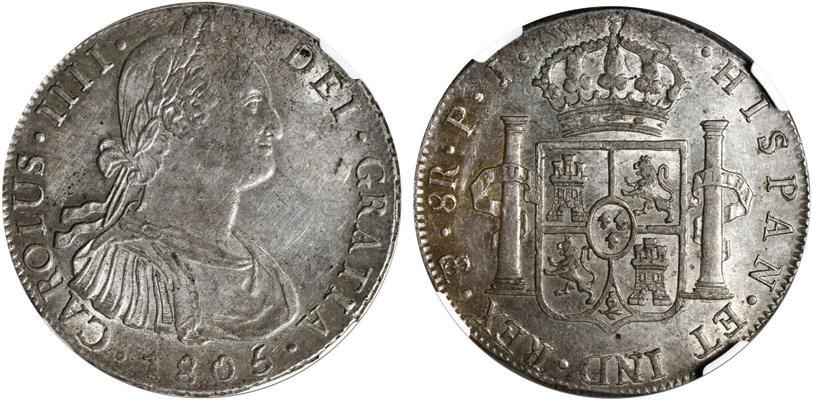
783. Potosí, Bolivia, 1/4 real, 1799, PCGS MS 65, finest known in the PCGS census. Jan son-81.6.3; KM-82; Cal-147. Deeply rainbow toned with much blue color over luster, boldly re-punched final digit 9 in date, currently the sole finest of eight entries in the PCGS census, exceeded only by a single MS 66 at NGC. PCGS #29207127. Estimate: $200-$300.
784. Potosí, Bolivia, 1/4 real, 1800, NGC MS 62. Janson-81.7.2; KM-82; Cal-149. Bold strike except for parts of rims, good luster with traces of faint toning, currently tied with one other for second finest in the NGC census behind a single MS 63. NGC #6477718-002. Estimate: $200-$300.
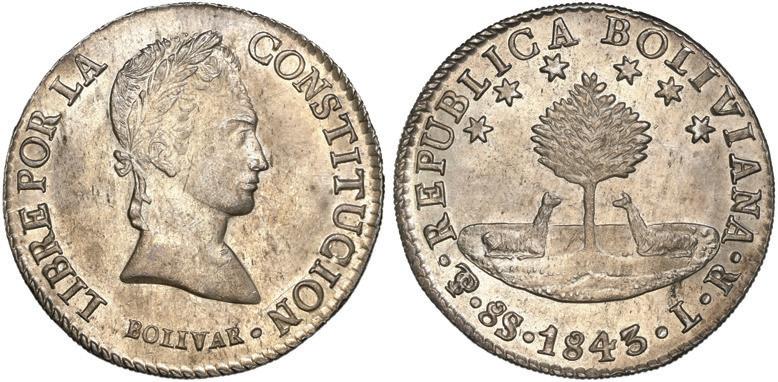


785. Potosí, Bolivia, 8 soles, 1843 LR, NGC MS 62 (“top pop”), ex-Millennia. Eliz-95; KM-103. 27.06 grams. Beautifully goldtoned over luster, with sharp details due to strong and deep strike, currently tied with two others for finest in the NGC census, desirable pedigree. Pedigreed to the Millennia Collection (stated on label). NGC #6476361-002. Estimate: $1,000-$1,500.
788. Potosí, Bolivia, 1 sol, 1853 FP, NGC MS 64. KM-119.1. Bold strike with sharp details, faintly toned over strong luster, currently tied with two others for second finest in NGC census behind a single MS 65. NGC #4209305-001. Estimate: $250-$375.
786. Potosí, Bolivia, 8 soles, 1859 F.J., with “Po. 400 Gs.” below bust, very rare, NGC MS 61 (“top pop”). KM-138.1. Lustrous and well struck, with pretty rainbow toning (light) on reverse but light hairlines on Bolívar side, also with interesting struck-throughfiber error on reverse, considered the rarest of several varieties for this date, currently tied with the Lissner example for top grade in the NGC census but with much better strike than that coin has. NGC #6610677-001. Estimate: $2,000-$3,000.

789. Potosí, Bolivia, 1 boliviano, 1872 FE, elaborate shield variety, NGC MS 63. KM-155.4. Lightly rainbow toned over cart wheel luster, popular Bolivian crown, earlier variety with REPUB LICA DE BOLIVIA in legend around a more elaborate shield. NGC #6447373-002. Estimate: $200-$300.
787. Potosí, Bolivia, tin uniface reverse trial 1 sol, 1852 FM, very rare. Deep strike with choice full details with some luster, a couple minor rim nicks, the other side with circular lapping marks, reeded edge, probably unique as we have not encountered another. Estimate: $200-$300.
790. Potosí, Bolivia, piefort pattern 1/20 boliviano, 1865/4 FP, very rare, NGC MS 65. KM-PA3. 2.35 grams. Fully detailed strike with highly lustrous fields, totally devoid of wear or marks except on the relatively high rims, lightly toned, struck in almost double weight (as a 1/20 boliviano should weigh 1.25 grams) but not noted as such by NGC, only the second example we have seen. NGC #4700529-003. Estimate: $700-$1,000.


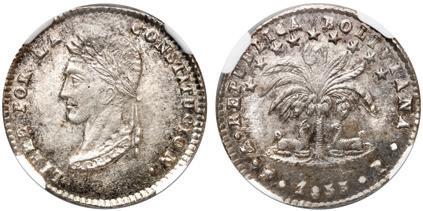


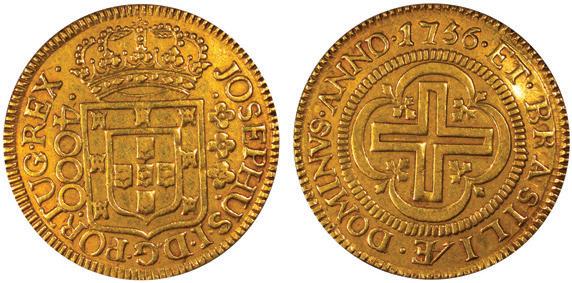

791. Brazil (Minas mint), gold 12800 reis, João V, 1728/7-M, NGC MS 61, finest known in NGC census. LMB-unl (cf 284); Gomes-140.03; KM-unl (139 for type). Full rims and generally sharp strike except for a diagonal part just below the crown / on the bust, aligned with light adjustment marks on both sides (as well as a single deep line on reverse), muted luster, bold overdate that is listed in Gomes but not in LMB (formerly Russo) or KM, hence probably rare, popular type (known as a dobra) that has the distinction of being the largest regular-issue gold coin made in the Americas. NGC #6476361-001. Estimate: $5,000-$7,500.
792. Brazil (Lisbon mint), gold 4000 reis, José I, 1756, PCGS XF45, finest and only example in the PCGS census. LMB-312; KM-171.1. Richly toned and fully detailed, lacking luster but otherwise arguably low AU, finest at PCGS but inferior to several at NGC (including MS examples), with traces of die-clashing on reverse. PCGS #30972758. Estimate: $600-$900.
793. Brazil (Lisbon mint), gold 2000 reis, Maria I and Pedro III, 1778, low crown, NGC AU 58. LMB-450a; KM-209. Touch of toning over luster, minimal high-point wear for the grade. NGC #4251436-014. Estimate: $500-$750.
794. Brazil (Rio mint), 640 reis, Pedro II, 1699/8, unlisted overdate. LMB-unl (cf 136); Gomes-24.02; KM-unl (90.1 for type). 18.77 grams. Bold AU- with deep toning around details, very clear overdate that is listed in Gomes but not in LMB (formerly Russo) or KM but several examples are known. Estimate: $350-up.

795. Brazil (Rio mint), 960 reis, João VI, 1818-R, struck over a Mexico City, Mexico, bust 8 reales of Ferdinand VII dated 1811 HJ, NGC MS 64. LMB-476; KM-326.1. Lightly gold-toned over luster, several areas of clear under-coin details including date, denomination and mintmark (scarce thus, but not noted by NGC), choice grade. NGC #6440471-013. Estimate: $250-$375.

796. Brazil, gold 20000 reis, Pedro II, 1851, small bust, NGC MS 62. LMB-635; KM-463. Scarce two-year type, well-detailed strike and ample luster, minor marks. NGC #5783029-009. Estimate: $700-$1,000.
797. Brazil (Rio mint), 960 reis, Pedro I, 1823-R, SIGNO variety, struck over an Argentina (River Plate Provinces) 8 reales or 8 soles, (1813 or 1815), NGC AU 55. LMB-504; KM-368. Deeply toned, lacking luster but fully detailed, with some of the scarce under-coin details in centers (not noted by NGC), including rays of sunface and arms, just not the date or assayer or denomination. NGC #6610345-006. Estimate: $300-$450.

798. Brazil (Rio mint), 960 reis, Pedro I, 1826-R, struck over a Santiago, Chile, bust 8 reales of 1815 FJ, rare. LMB-507; KM368. Richly toned XF with one small dark spot, much bold under-coin details including 1815 date and oS mintmark, the overstrike date 1826 only partially visible with what appears to be the lower-right loop of the 6 superimposed on the Santiago mintmark to left of mintmark R. Estimate: $300-$450.


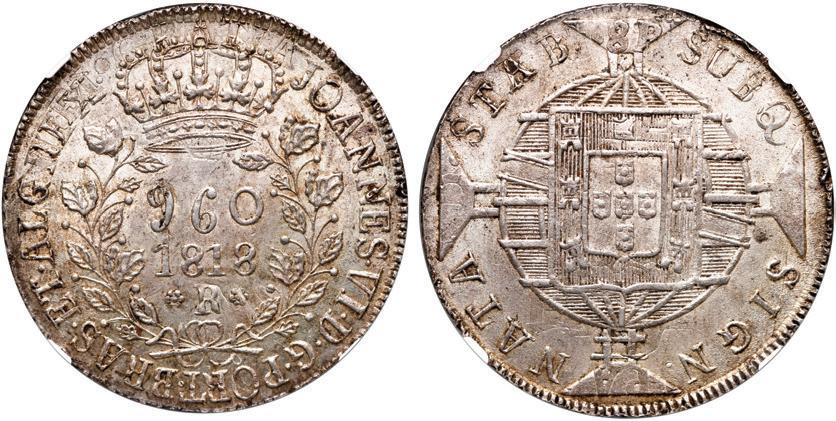
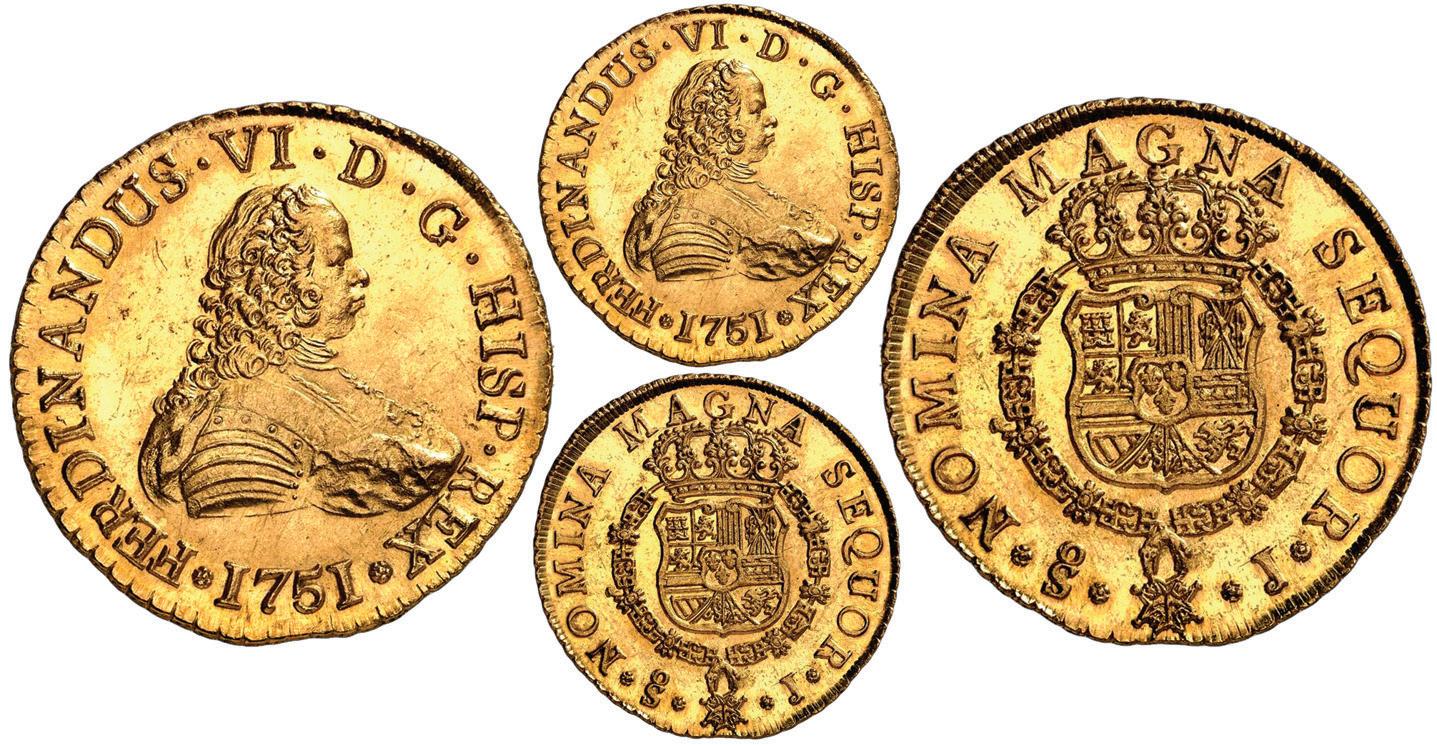
799. Santiago, Chile, gold bust 8 escudos, Ferdinand VI, 1751 J, NGC MS 65, ex-Canovas. KM-3; Cal-824. Superb strike with 100% full details including centers (which are usually weak), bountifully lustrous with minimal hairlines, typical natural depression on edge below date, near top grade (currently tied with three others for second finest in NGC census behind a single MS 66*), certainly the best we have handled and most likely from the Luz shipwreck of 1752. Pedigreed to the Manuel Canovas collection (Vinchon auction of May 1994, lot 156). NGC #6462497-001. Estimate: $10,000-$15,000.
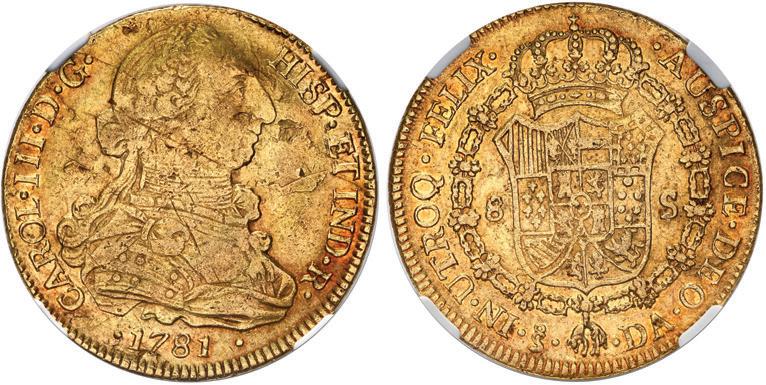
800. Santiago, Chile, gold bust 8 escudos, Charles III, 1761 J, NGC AU 53. KM-20; Cal-2127. Lovely red toning over luster in leg ends, well-detailed strike but with lots of tiny bagmarks, scarce type. NGC #6471433-004. Estimate: $2,000-$3,000.
802. Santiago, Chile, gold bust 8 escudos, Charles IV (bust of Charles III), 1796 DA, PCGS AU58. KM-54; Cal-1761. Brightly lustrous with splashes of vivid color (mostly red), also choice strike, just a touch of high-point wear and underlying surface hairlines. PCGS #45094838. Estimate: $1,500-$2,250.


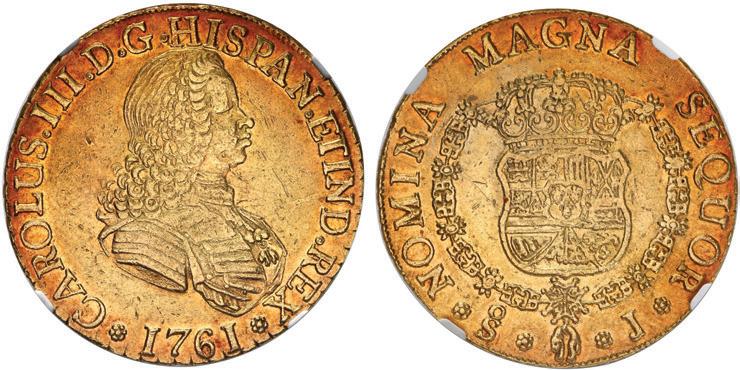
801. Santiago, Chile, gold bust 8 escudos, Charles III, 1781 DA, NGC AU 50. KM-27; Cal-2164. Lustrous, with some red toning in legends, the obverse slightly off-center and with several minor flaws (laminations, etc.). NGC #3958434-045. Estimate: $1,250-$2,000.
803. Santiago, Chile, gold bust 8 escudos, Ferdinand VII transitional (“admiral” bust), 1811 FJ, NGC AU details / obverse cleaned. KM-72; Cal-1865. Choice rims and nice luster, a few light marks in obverse fields but hardly enough to justify the limiter from NGC, attractive example of a popular type. NGC #6611627-001. Estimate: $3,000-$4,500.
804. Santiago, Chile, gold bust 8 escudos, Ferdinand VII (bust of Charles IV), 1814 FJ, NGC MS 64+, finest known in NGC census. KM-78; Cal-1871. Satin-smooth surfaces with spectacular luster, choice rims (except for minor natural flaw at E of FELIX) and generally sharp strike save for slight central weakness and adjustment marks, overall very flashy and impressive. NGC #6445267-001. Estimate: $10,000-$15,000.


805. Santiago, Chile, gold bust 8 escudos, Ferdinand VII (bust of Charles IV), 1817 FJ, NGC AU 53. KM-78; Cal-1876. Choice reverse with Mint State luster, off-center obverse with small marks and natural flaws at top. NGC #6471433-003. Estimate: $1,500-$2,250.
806. Santiago, Chile, bust 8 reales, Ferdinand VII (“admiral” bust), 1811 FJ, NGC MS 62. KM-752; Cal-1404. Broad flan with superbly detailed portrait, brilliant luster, slight flan-bulge on reverse, popular transitional type. NGC #5935281-006. Estimate: $600-$900.
807. Santiago, Chile, bust 8 reales, Ferdinand VII, 1816 FJ, NGC XF 45. KM-80; Cal-1409. Slightly off-center strike on broad flan, with splashes of dark rainbow toning all over, somewhat lustrous for the assigned grade. NGC #4484011-005. Estimate: $250-$375.

Watch and bid LIVE on the Internet at www.auction.sedwickcoins.com

808. Santiago, Chile, bust 1 real, Charles IV, 1804 FJ/AJ (unlisted over-assayer), NGC VF details / cleaned. Cal-unl (Type 63); KM-unl (58 for type). Broad flan with full rims despite slightly off-center strike, weak in centers and with a few minor flaws (as made), some natural luster as opposed to the stated cleaning, but most important is the bold and clear FJ/AJ over-assayer (decidedly not FJ/JJ, which is listed), missing in all references and indicative of a muling with a two-year-old die. NGC #6610345-002. Estimate: $600-$900.

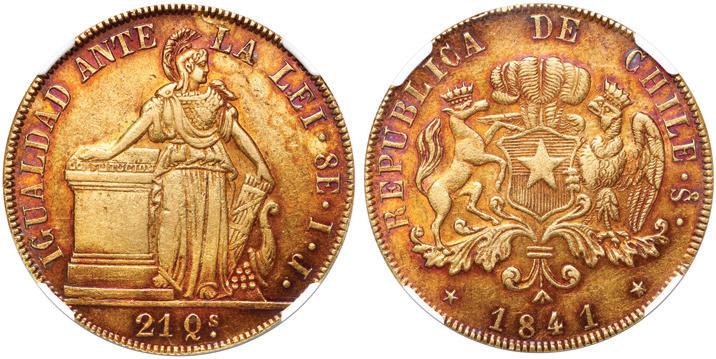

809. Santiago, Chile, bust 1/2 real, Ferdinand VII (bust of Charles IV), 1813 FJ. KM-64; Cal-457. Bold but off-center strike with die-crack in center of reverse, AU with light toning over luster. Estimate: $400-$600.


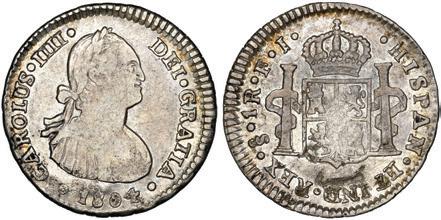
811. Santiago, Chile, “volcano” peso, 1819 FD, NGC XF details / cleaned. KM-82.2. Richly toned over faintly hairlined sur faces, the iconic volcano full and well detailed but parts of the legends weak. NGC #6443463-008. Estimate: $1,000-$1,500.
810. Santiago, Chile, 1/4 real, 1790, NGC MS 64 (“top pop”). Cal-181; KM-43. Bold full details with muted luster, slightly offcenter strike, highly desirable top-grade example of a popular two-year transitional type within a rare series of bust-bearing cuartillos, currently tied with one other for finest in the NGC census. NGC #3594446-003. Estimate: $1,000-$1,500.
812. Santiago, Chile, gold 8 escudos, 1841 IJ, NGC AU 58. KM-104.1; Fr-41. Gorgeous reddish purple toning all over, nice strike, just some light high-point wear for the grade. NGC #5710263-002. Estimate: $1,500-$2,250.
813. Santiago, Chile, gold 2 pesos, 1874, NGC MS 62, exBarros Franco. KM-143. Brightly lustrous in white-yellow gold, bold strike and rims. Pedigreed to the José Miguel Barros Franco Collection (stated on label). NGC #5965898-004. Estimate: $300-$450.
814. Santiago, Chile, 1 peso, 1855, PCGS AU50. KM-129. Splashes of very light rainbow toning over muted luster, minor marks and high-point wear. PCGS #45430369. Estimate: $300-$450.
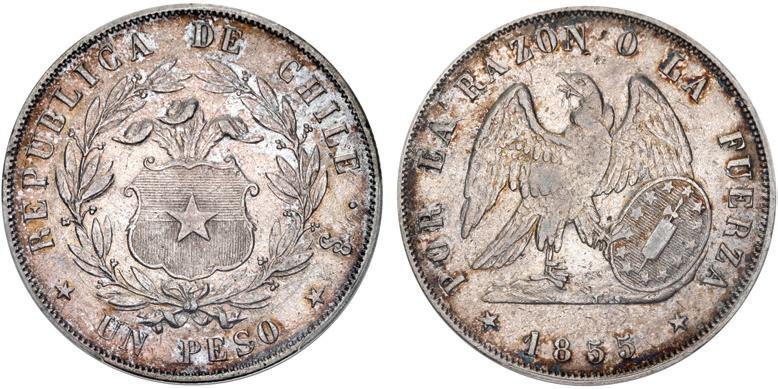
815. Copiapó, Chile, 1 peso, 1865, NGC AU 55. KM-4. Deep toning inside incuse lettering, the raised fields all smooth and clean with minimal marks. It is interesting to note that NGC (and some catalogers) continue to attribute this issue erroneously as a restrike due to a misreading of Medina’s reference work Las Mone das Obsidionales de Chile (1919), in which he mentions someone (probably him) finding the dies for the 50 centavos and making “just a few” restrikes, whereas the pesos (which are more common) are original to 1865 and the Blockade of Puerto de Caldera in the war against Spain. NGC #6476168-005. Estimate: $200-$300.
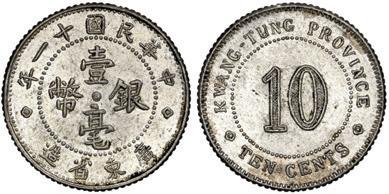
816. China (Empire), Chihli Province (Pei Yang), 7 mace 2 canda reens (1 dollar), Kuang-hsu (Guangxu), year 25 (1899), Tientsin (East Arsenal) mint, NGC AU 58. L&M-454; KM-Y73. Subtly lustrous with light and colorful toning all over, scarce and desirable issue that always garners a premium, especially for straight-number grades like we see here. NGC #6610346-002. Estimate: $2,000-$3,000.
817. China (Republic), 50 cents, Yuan Shih-kai, year 3 (1914), Tientsin mint, NGC AU details / obv stained. L&M64; KM-Y328. Low-contrast obverse (just faintly toned, in our opinion), bold and lustrous reverse with faint light marks, popular type. NGC #6478430-001. Estimate: $1,250-$2,000.
819. China (Republic), 1 dollar (yuan), Sun Yat-sen “me mento dollar,” (1927), six-point stars, NGC MS 63. L&M-49; KM-Y318a. Subtle luster with incipient rainbow toning around rims, competent grade and very popular. NGC #6610346-005. Estimate: $200-$300.
818. China (Republic), 10 cents, year 11 (1922), Kwangtung mint, rare, NGC AU 58. L&M-153; KM-Y422. Frosty luster punctuated with light toning around details, with just a minor mark or two to keep it from MS (at least according to NGC). NGC #6610681-003. Estimate: $400-$600.
820. China (Republic), Yunnan Province, 1/2 tael, Hanoi mint, struck in 1943-44 for the French Indo-Chinese opium trade, NGC AU 55. L&M-434; KM-A1.2. Richly toned (mostly on obverse) with traces of luster, minimal marks, well struck except for parts of rims, highly popular issue. NGC #6610346-007. Estimate: $500-$750.




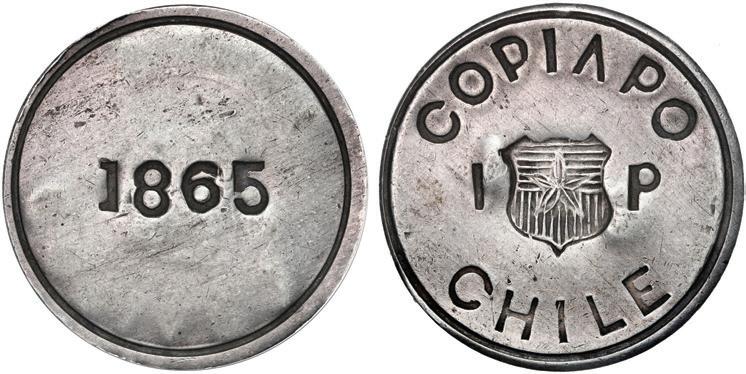
821. Bogotá, Colombia, cob 8 reales, 1622 A, rare. Restrepo-M42.1; S-B1; KM3.2; Cal-1534. 22.53 grams. Choice full cross-lions-castles (slightly doubled) and shield with 100% sharp details (including pomegranate in center, presumably indicative of the second set of dies and once believed to be the difference between Cartagena and Bogotá), bold full assayer A to right, clear 22 of date, nicely toned AU but with light corrosion all over and some minor edge-loss as undoubtedly from one of the Span ish 1622 Fleet shipwrecks (Atocha or Santa Margarita). Estimate: $1,250-$2,000.
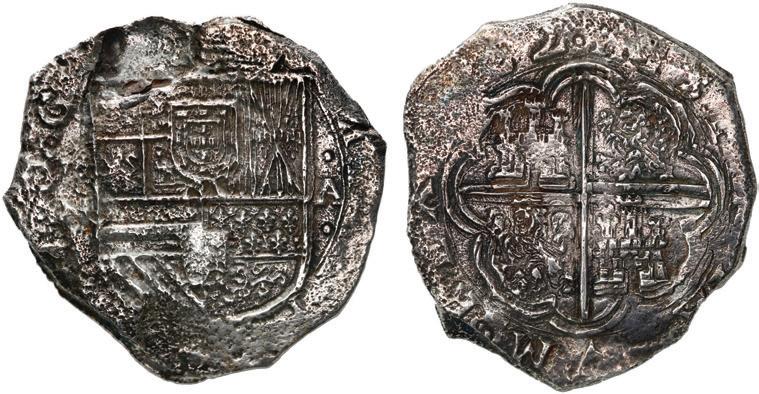
822. Bogotá, Colombia, gold bust 8 escudos, Charles III, 1785 J.J, NGC AU 58. Restrepo-72.30; KM-50.1a; Cal-2119. Nice strike with full rims and traces of toning over luster, a few light marks and slightly grainy texture for the grade. NGC #6455791-002. Estimate: $1,250-$2,000.

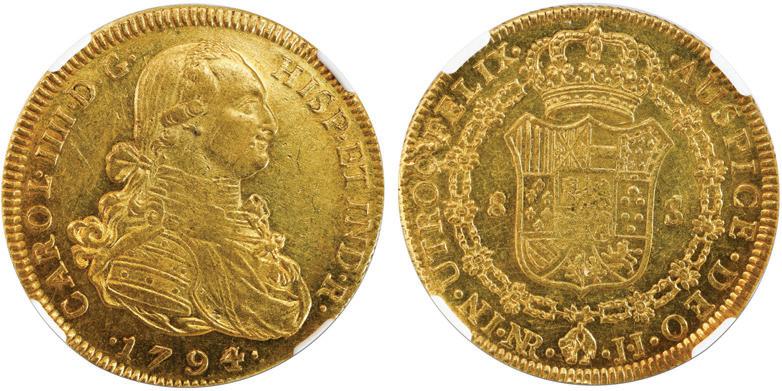


824. Bogotá, Colombia, gold bust 8 escudos, Charles IV, 1794/3 J.J, rare, NGC AU 58, finest and only example in NGC census. Restrepo-unl (Type 97); Cal-1725; KM-unl (62.1 for type). Choice luster and strike except for minor central weakness, also slightly offcenter obverse with perhaps too many light surface hairlines to make MS in NGC’s estimation, bold overdate that is unlisted in Restrepo and KM (but four examples seen in recent years, this being the finest). NGC #4688930-001. Estimate: $1,500-up.
823. Popayán, Colombia, gold bust 8 escudos, Charles IV transitional (bust of Charles III, ordinal IV), 1790 SF, NGC
AU 55. Restrepo-96.4; KM-53.2; Cal-1659. Nice luster and bright yellow color with minor marks, high-point wear and grainy texture, also slightly out-of-round flan. NGC #6467085-003. Estimate: $1,250$2,000.
825. Bogotá, Colombia, gold bust 8 escudos, Charles IV, 1808 JF, no dot between IN and the mintmark, NGC MS 61. Restrepo-98.38c; KM-62.2; Cal-unl (Type 189). Scarce final issue for this king (the rarity of the variety not yet determined), with choice full details on both sides, rich gold color and ample luster, minimal surface hairlines, slightly off-center strike. NGC #4882399-006. Estimate: $1,250-$2,000.
826. Popayán, Colombia, gold bust 8 escudos, Ferdinand VII (bust of Charles IV), 1817 F.M. Restrepo-128.29; KM-66.2; Cal1821. 26.92 grams. Broad flan with sharp rims, lustrous UNC with light scratches next to king’s ponytail, several minor die-cracks on obverse. Estimate: $1,250-$2,000.

827. Popayán, Colombia, gold bust 1 escudo, Charles III, 1772 JS, NGC AU 50. Restrepo-54.2; KM-48.2; Cal-1415. Desirable first year of type, broad flan with full rims, traces of toning and luster, the centers slightly weak. NGC #5985742-005. Estimate: $200-$300.
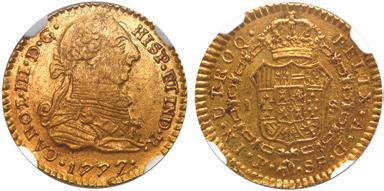
828. Popayán, Colombia, gold bust 1 escudo, Charles III, 1777 SF, NGC AU 58, finest known in NGC census. Restrepo-54.10; KM-48.2; Cal-1420. Bold strike with full rims and strong luster for the stated grade, some light hairlines and high-point wear. NGC #5985271-003. Estimate: $400-$600.
829. Bogotá, Colombia, gold bust 1 escudo, Charles IV, 1796 JJ, NGC AU 53. Restrepo-84.10; KM-56.1; Cal-1203. Deeply toned (mostly red but with some rainbow colors) over luster around strong details, quite pretty for the grade, currently tied with one other for second finest in the NGC census behind a single MS 62. NGC #6471344-002. Estimate: $400-$600.

830. Bogotá, Colombia, 1/4 real, 1803/2, NGC AU 58, finest known in NGC census. Re strepo-75.16; KM-63; Cal-174. Deeply toned with bold full details, the rims also full but partially irregular (as made), scarce overdate, the finer of just two in the NGC census (the other VF). NGC #3594446-007. Estimate: $600-$900.
831. Bogotá, Colombia, 1/4 real, 1812, NGC MS 63, finest known in NGC census. Restrepo-100.7; KM-67.1; Cal-291. Bold but off-center strike with attractive light toning over luster, scarce, currently the finest at NGC by four grades. NGC #3594446-008. Estimate: $600-$900.
832. Popayán, Colombia, 1/4 real, 1816, wide reeded border, NGC MS 64. Restrepo-101.1b; KM-67.2; Cal-283. Super flashy luster and sharply detailed strike, no toning, currently tied with one other for second finest in the NGC census behind a single MS 65. NGC #3594446-009. Estimate: $200-$300.
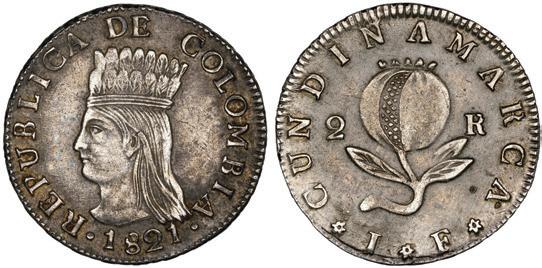


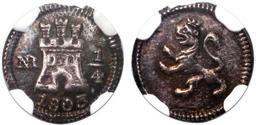
833. Popayán, Colombia, copper provisional 2 reales, 1813. Restrepo-116.1; Cal-907; KM-B2. Bold AU with light brown fields but darkly toned around details, full rims, scarce necessity issue struck in the royalist style (hence its listing in Calicó) but by patriots (according to Fernando Barriga del Diestro). Estimate: $200-$300.


834. Bogotá, Colom bia, 2 reales, 1821 JF, Cundinamarca, no BA, stars on reverse, very rare, NGC AU 55, finest known in NGC census. Restrepo-155.5; KM-C5. Choice bold strike with full details, deeply toned, just parts of the rims weak (as made) and a few minor divots on reverse, currently the finest at NGC by many grades (the others grading only Fine and not necessarily all of this same variety, as others have dots instead of hollow six-point stars on the reverse like on this coin) but also numerically superior to the single PCGS entry at XF40 (Eldorado example). NGC #6480715-007. Estimate: $800-$1,200.
835. Bogotá, Colombia (Cundinamarca), 2 re ales, 1823 J.F, very rare, NGC VG 10 (“top pop”). Restrepo-155.8; KM-C5. Very rare “final” date of Cundina marca coinage, ironically struck BEFORE the 1821 coins with mintmark BA (as there is a known overdate 1/3), this example with bold and lustrous legends but center of obverse very weak due to a flan-bulge, nicely toned all over, tied with one other for finest in the current NGC census and in some ways superior to the Eldorado specimen at the same grade (PCGS), which is one of just two other examples sold publicly in recent years, the other being ex-Dana Roberts / ex-Esmeralda. NGC #6480715-008. Estimate: $2,000-$3,000.
836. Bogotá, Colombia, 1/4 real, 1820, rare, NGC VF 30, ex-Bernal. Restrepo-145.1; KM-79.1. Nicely toned, evenly circulated and problem-free, a decent example of this scarce first date of the Republic type struck in the old Nueva Granada design with Phrygian cap splitting denomination 1-4 and no mintmark. Pedigreed to the Bernal Collec tion (stated on label). NGC #6442565-038. Estimate: $200-$300.
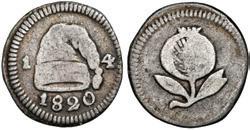

837. Bogotá, Colombia, 1/4 real, 1821, no mintmark, rare, NGC XF 40. Restrepo-145.2; KM-79.1. Toned fields, off-center obverse with incomplete rim as a result, scarce issue in the old Nueva Granada design with Phrygian cap splitting denomination 1-4 and no mintmark, second finest in current NGC census behind a single MS 63. NGC #6480715-010. Estimate: $800-$1,200.
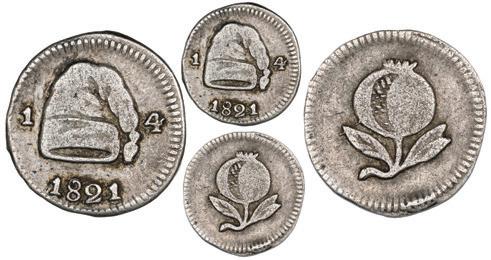
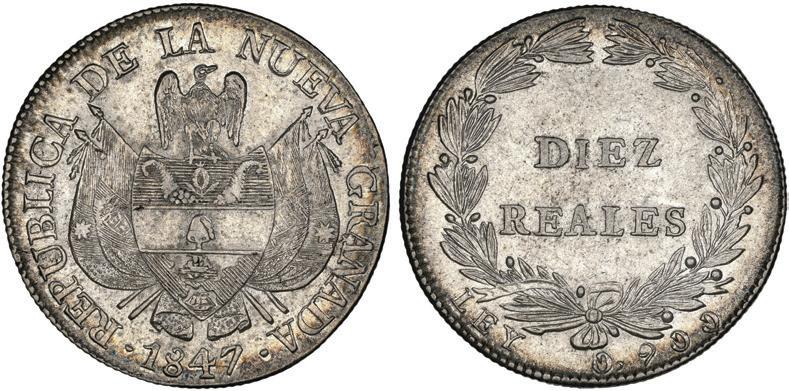
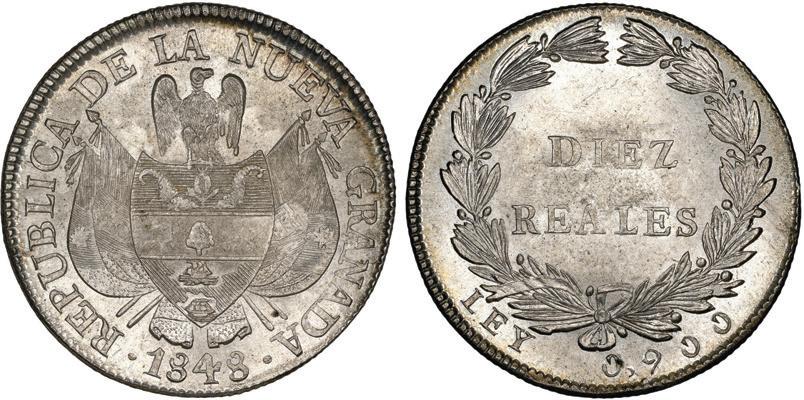
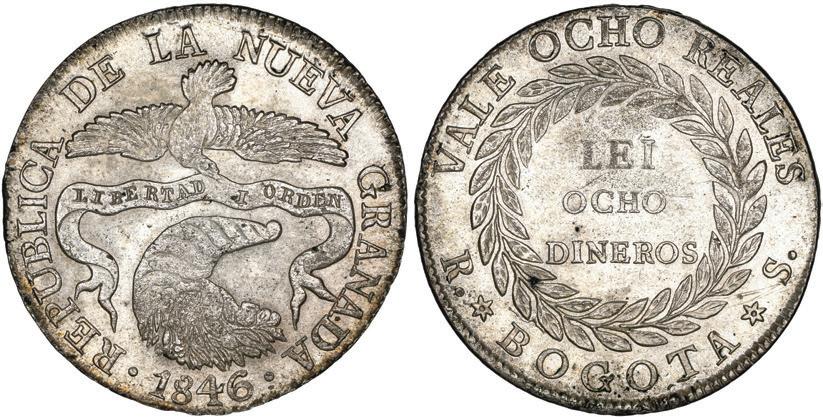
839. Bogotá, Colombia, gold 8 escudos, 1830 R.S, PCGS MS63. Restrepo-165.19. Choice luster and strike save for some slight weakness and diagonal streaks across centers (as made), full rims, very flashy for the issue, near top grade (finest being 64+). PCGS #45598638. Estimate: $4,000-$6,000.

838. Bogotá, Colombia, 1/4 real, 1821, mintmark BA (no dot), NGC AU 53. Restrepo-145.3; KM-79.2. Deeply toned over muted luster, with full but crude rims and small edge-crack (as made), second variety (with mintmark added) of the scarce early Phrygian cap type. NGC #6480715-011. Estimate: $800-$1,200.

840. Bogotá, Colombia, 8 reales, 1846 R.S., NGC MS 64, finest known in the NGC census. Restrepo-194.15; KM-98. Amazingly full strike (even the typically weak parts near centers clear and sharp) with ample luster, hint of toning, a dazzling grade for this type. NGC #6480715-001. Estimate: $1,500-$2,250.
842. Bogotá, Colombia, 10 reales, 1847, NGC MS 62.

Restrepo-196.1; KM-107. Thoroughly lustrous and sharply detailed with incipient toning at rims, scarce grade. NGC #6480715-002. Estimate: $1,000-$1,500.
841. Bogotá, Colombia, 8 reales, 1847, small diameter, NGC
AU 53. Restrepo-195.1; KM-106. Deeply rainbow toned over luster, scarce one-year issue in higher-fineness silver but smaller size that replaced the condor-over-cornucopia type (previous lot) before beginning the new 10 reales (next lot). NGC #6480715-012. Estimate: $800-$1,200.
843. Bogotá, Colombia, 10 reales, 1848, NGC MS 64+.
Restrepo-196.3; KM-107. Blazingly lustrous and sharply detailed all over, probably imperceptibly close to the MS 65 at NGC to which this coin is currently second finest in the census (also tied with an MS64+ at PCGS). NGC #6480715-003. Estimate: $1,250-$2,000.
844. Bogotá, Colombia, 10 reales, 1850, NGC MS 65+, finest known in the NGC census. Restrepo-197.1; KM-111. Bold full strike with blazing luster, pristine surfaces, partially toned rims. NGC #6480715-005. Estimate: $1,250-$2,000.
845. Bogotá, Colombia, gold 20 pesos, 1868, NGC AU 55. Restrepo-336.4; KM-142.1. Lustrous and choice in strike but with too many minor handling marks for MS, still currently second finest in NGC census behind a single MS 62, popular type as the largest gold coin of pre-modern Colombia. NGC #4678256-001. Estimate: $2,000-$3,000.

846. Popayán, Colombia, 1 peso, 1863, very rare, NGC XF details / cleaned. Restrepo-316.1; KM-139.2. Very rare and important one-year type (effectively the only silver 1 peso of this mint) of which only a handful are known, several of them sold publicly in recent years (like the ones from the Eldorado and Nueva Granada collections), none of which is significantly better or worse than the present piece, which shows dark but subtle rainbow toning over what look to us like natural surfaces (no evidence of cleaning that we can tell save for a gentle rub on the high points), notably lacking the minor flaws that the others possess (like rim bruises and weak strike). As Restrepo mentions, the date shows evidence of re-punching over something else, but also this coin in particular displays the ghost of an E in the field after DE. NGC #6480715-004. Estimate: $3,500-$5,000.


847. Costa Rica (Central American Republic), gold 2 escudos, 1850 JB, NGC AU details / cleaned. KM-15. Brightly lustrous and sharply struck, popular type. NGC #6476169-002. Estimate: $1,000-$1,500.



848. Costa Rica (Central American Republic), gold 1 escudo, 1849 JB, NGC AU 58.
KM-14. Sharp and fully detailed strike, strong luster overlain with a light streak of red across AMER, popular type that is somewhat rare without a lion countermark for Costa Rica as its own republic. NGC #6610345-008. Estimate: $600-$900.
849. Costa Rica (Central American Republic), gold 1/2 escudo, 1846 JB, NGC AU 58.
KM-13.1. Choice luster, nice details despite slightly uneven strike, erroneously described as “CRESCA” by NGC and therefore placed on its own line in the census as finest and only known, even though the legend clearly shows CREZCA. NGC #6610345-009. Estimate: $800-$1,200.
850. Costa Rica (Central American Republic), 1 real, 1849 JB, very rare, NGC AU details / rev spot removed, ex-O’Brien. KM-21a. Unlike the 1849 “Madonna and child” type under Costa Rica as its own republic (see lot 863 in this auction), this final date of the sun-and-mountains C.A.R. type is extremely elusive, at least without a lion countermark, with fewer than ten known and only one other (that we know of) sold publicly in the past decade or so, this one lightly toned and fairly well struck except for a hairline edgesplit, with evidence of scraping in field between CREZCA and FECUNDO. Pedigreed to the John O’Brien Collection (stated on label) and with his tag. NGC #6614418-001. Estimate: $1,000-$1,500.

851. Costa Rica, 2 reales, female head / ceiba tree counterstamp (Type III, 1845) on a Madrid, Spain, bust 2 reales, Charles IV, 1797 MF, NGC VG 10, c/s UNC standard. KM-37. Superior-grade counterstamp with fully detailed head and leaves, also with bold COSTA, the host itself well detailed for the grade (actually better than Fine on reverse) and nicely toned. NGC #6476168-002. Estimate: $200-$300.
852. Costa Rica, 2 reales, female head / ceiba tree counterstamp (Type III, 1845) on a Madrid, Spain, bust 2 reales, Charles IV, 1798 MF, NGC G 4, c/s VF strong. KM-37. Choice full counterstamp (all details clear) on a lightly toned host with partially weak rims due to centering issues. NGC #6476168-003. Estimate: $200-$300.
853. Costa Rica, 2 reales, female head / ceiba tree counterstamp (Type III, 1845) on a Madrid, Spain, bust 2 reales, Charles IV, 1799 MF, NGC VG 10, c/s XF standard. KM-37. Richly toned host, the counterstamp nearly full with bold central details. NGC #2883645-003. Estimate: $200-$300.


854. Costa Rica, 2 reales, female head / ceiba tree counterstamp (Type III, 1845) on a Madrid, Spain, bust 4 reales de vellon, Ferdinand VII, 1822 SR, rare, NGC VG 10, c/s VF standard. KM-43. Nearly full countermark (the tree and head 100% complete) on a rare host of a brief type that mentions the restored Constitution of Spain in the legend, lightly toned all over. NGC #6476168-004. Estimate: $1,000-$1,500.




855. Costa Rica, 2 reales, female head / ceiba tree counterstamp (Type III, 1845) Seville, Spain, bust 2 reales, Ferdinand VII, 1832 JB, NGC F 15, c/s VF strong. KM-42. Better-grade host, richly toned, with traces of luster around details, full counterstamp. NGC #6477716-005. Estimate: $700-$1,000.
856. Costa Rica, 2 reales, female head / ceiba tree counterstamp (Type III, 1845) on a Seville, Spain, bust 2 reales, Ferdinand VII, 1833 JB. KM-42. Deeply toned, the counterstamp VF and the host Fine, with some central flaws and abrasions (also on rims). Estimate: $200-$300.
857. Costa Rica, 2 reales, female head / ceiba tree counterstamp (Type III, 1845) on a Cuba (Trinidad / Santiago / Principe) 2 reales lattice countermark (1841) on a Madrid, Spain, bust 2 reales, 1797 MF, Charles IV, NGC VG details / cleaned, c/s VF standard. KM-44. Strong lattice mark with bold eight-point star in center, the counterstamp nearly full and the lightly toned host still with clear details despite wear and hairlines. NGC #6477716-002. Estimate: $500-$750.
858. Costa Rica, 2 reales, female head / ceiba tree counterstamp (Type III, 1845) on a Cuba (Trinidad / Santiago / Principe) 2 reales lattice countermark (1841) on a Madrid, Spain, bust 4 reales de vellon, Joseph Napoleon, 1812, NGC VG details / cleaned. KM-unl (cf 44). Lightly rainbow toned, with bold star-in-lattice and weaker but nearly full counterstamp, the host of a later type than indicated in KM. NGC #6477716-003. Estimate: $500-$750.
859. Costa Rica, 2 reales, female head / ceiba tree counterstamp (Type III, 1845) on a Cuba (Trinidad / Santiago / Prin cipe) 2 reales lattice countermark (1841) on a Seville, Spain, bust 2 reales, Ferdinand VII, 1833 JB, NGC AU 55, c/s UNC standard, finest known in NGC census. KM-unl (cf 44). Extremely high-grade host for this type, without equal or precedent (also a later date than specified in KM), lightly toned over patent luster, the counterstamp also in superior grade and nearly full, a truly amazing survivor considering its use in multiple countries (the collectors of all of which should be interested), literally the only example in the NGC census above VF grade for any host. NGC #6477716-001. Estimate: $2,000-up.

860. Costa Rica, 1 real, 1846 JB counterstamp (Type IV) on a Potosí, Bolivia, cob 1 real, date and assayer not visible, NGC Fair 2, c/s F standard. KM-47. Nearly full countermark, darkly toned in crevices for strong contrast, the host with little detail besides a P mintmark to left of cross and denomination I at top of pillars side. NGC #6323718-006. Estimate: $200-$300.
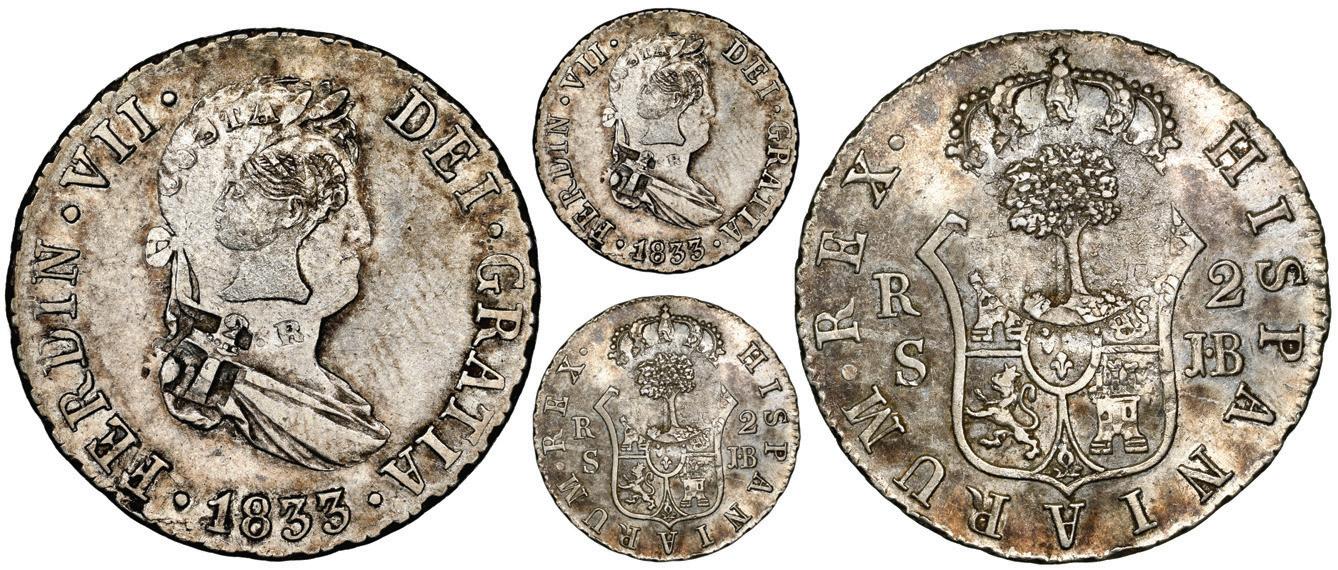
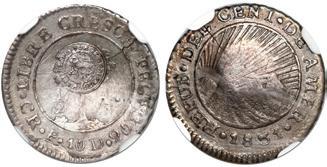
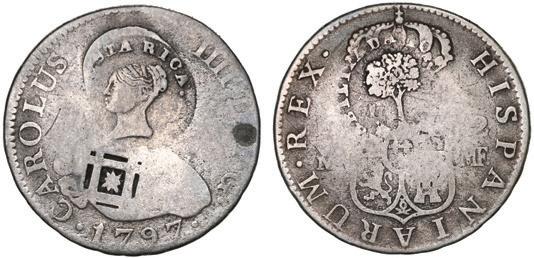
861. Costa Rica, 1 real, “lion” countermark (Type VI, 1849-57) on a Costa Rica (Central American Republic) 1 real of 1831 F, NGC XF 40, c/s XF standard. KM-72. Lightly rainbow toned over muted luster, with hairline edge-split from application of countermark, nice grade on both countermark and host (which is the desirable first date, by the way). NGC #5957120-014. Estimate: $200-$300.
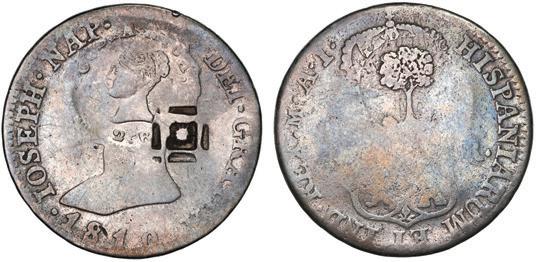
862. Costa Rica, 50 centimos, 1923 counterstamp (Type VIII) on a Costa Rica 25 centavos, 1893-HEATON, NGC MS 66 (“top pop”). KM-159. Frosty white with blazing luster, just about as flawless as a counterstamped coin could ever get, currently tied with three others for top honors at NGC. NGC #3640880-010. Estimate: $300-up.

863. Costa Rica, 1 real, 1849 JB, “Madonna and child” issue, NGC AU 50. KM-66. Very lightly toned over strong luster for the assigned grade, all details full and sharp with just a light rub on the high points only. NGC #3812011-010. Estimate: $200-$300.

864. Costa Rica, gold 1 peso, 1866 GW, small “UN,” with fineness, NGC MS 62. KM-107.1. Choice luster and sharp details but with parts of rims crude and several radial die-cracks (as made), rare in Mint State (second highest grade in NGC census). NGC #2882754-001. Estimate: $1,500-$2,250.
865. Cuba (struck at the Philadelphia Mint), gold 10 pesos, 1915, José Martí, NGC MS 61. KM-20. Low-mintage key date of a two-year type, lightly bagmarked per the grade, typically lustrous and rich gold in color. NGC #6348236-003. Estimate: $700-$1,000.
868. Cuba (struck at the Philadelphia Mint), gold 5 pesos, 1915 José Martí, NGC MS 63.
866. Cuba (struck at the Philadelphia Mint), gold 10 pesos, 1916, José Martí, NGC MS 61. KM-20. Typically lustrous with rich gold color, the obverse (only) lightly bagmarked. NGC #5985718-001. Estimate: $600-$900.
867. Cuba (struck at the Philadelphia Mint), gold 10 pesos, 1916, José Martí, PCGS MS61. KM-20. Lustrous and rich gold in color, as usual, with lots of tiny bagmarks (especially the obverse). PCGS #44113651. Estimate: $600-$900.



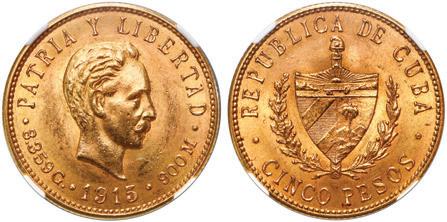

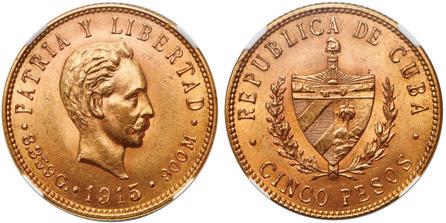


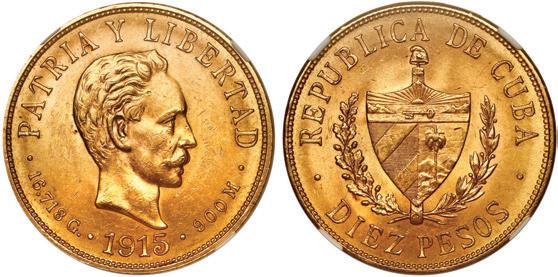
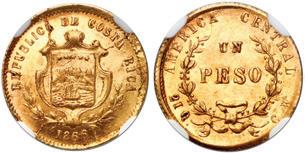
KM-19. Bold strike, with rich gold color and usual luster, minimal bagmarks, lower-mintage year of a two-year type. NGC #6449803-002. Estimate: $500-$750. 869. Cuba (struck at the Phila delphia Mint), gold 5 pesos, 1915 José Martí, NGC MS 62. KM-19. Slightly more lustrous and in brighter yellow gold than most, a few light bagmarks on obverse only, lower-mintage year of a two-year type. NGC #6435264-002. Estimate: $500-$750. 870. Cuba (struck at the Phila delphia Mint), gold 5 pesos, 1915 José Martí, NGC MS 62. KM-19. Lustrous and rich in color as usual, with a few bagmarks and tiny nicks in the bold-relief bust, lower-mintage year of a two-year type. NGC #2127605-008. Estimate: $500-$750. 871. Cuba (struck at the Phila delphia Mint), gold 5 pesos, 1915, José Martí, PCGS MS62. KM-19. Choice luster and light color for the type, very light bagmarks only, lower-mintage year of a twoyear type. PCGS #44113647. Estimate: $500-$750. 872. Cuba (struck at the Philadelphia Mint), gold 5 pesos, 1916, José Martí, NGC MS 63. KM-19. Choice luster, light gold color, minimal bagmarks. NGC #5935137-004. Estimate: $500$750.
873. Cuba (struck at the Phila delphia Mint), gold 5 pesos, 1916, José Martí, NGC MS 62. KM-19. Bright luster and color, very few bagmarks, begs a higher grade (note the lower slab number). NGC #2878769-004. Estimate: $400-$600.
874. Cuba, “souvenir” peso, 1897, Type II (star below baseline of 97), NGC MS 62. KM-XM2. Frosty luster and details with traces of rainbow toning at rims, light bagmarks only, struck by Gorham in Rhode Island for the Cuban Revolutionary Junta in New York. NGC #2878770-005. Estimate: $250-$375.

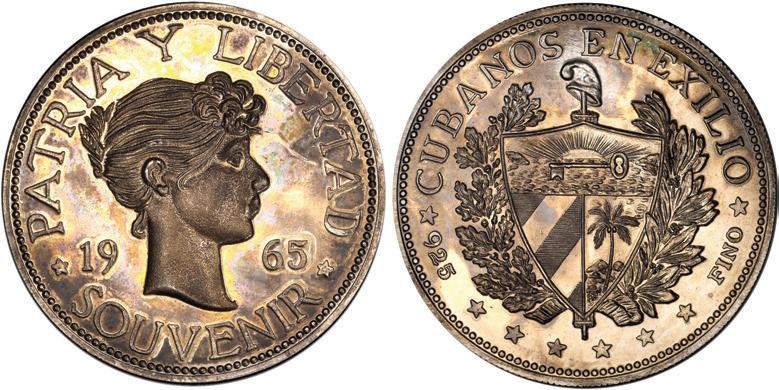



877. Cuba, proof silver “souvenir” peso (Bay of Pigs exile issue), 1965, reeded edge, PCGS PR66. KM-XM4. Splashy gold toning all over, with hints of rainbow hues, trace of odd fiber in front of face, scarce issue struck as a fund-raiser by U.S. coin dealers for the Agency for Cuban Numismatics in Exile in the design of the famous 1897 “souvenir peso” issued by the Cuban Revolutionary Junta in New York but with 1965 date. PCGS #45430362. Estimate: $250-$375.
875. Cuba, “souvenir” peso, 1897, Type II (star below base line of 97), NGC MS 61. KM-XM2. Lightly rainbow toned over cartwheel luster, lightly bagmarked, struck by Gorham in Rhode Island for the Cuban Revolutionary Junta in New York. NGC #2878770-003. Estimate: $200-$300.
878. Cuba, proof silver “souvenir” peso (Bay of Pigs exile issue), 1965, lettered edge, NGC PF 67 Ultra Cameo. KM-XM6. Gem proof with frosty design elements against deep mirror fields, spot of red-gold toning along the reverse rim, scarce issue struck by U.S. coin dealers as a fund-raiser for the Agency for Cuban Numismatics in Exile in the design of the famous 1897 “souvenir peso” issued by the Cuban Revolutionary Junta in New York but with 1965 date and incuse lettering on edge EN MEMORIA LA BAHIA DE LOS COCHINOS 1961 1965 (In Memory of the Bay of Pigs 1961-1965), apparently scarcer than the reeded-edge variety (previous lot), with a plain-edge version also known. NGC #5913131-005. Estimate: $250-$375.
876. Cuba, “souvenir” peso, 1897, Type III (star above base line of 97), NGC MS 62. KM-XM3. Frosty with luster and rainbow toned at rims, light bagmarks, struck by Gorham in Rhode Island for the Cuban Revolutionary Junta in New York. NGC #2878770-011. Estimate: $250-$375.
879. Czechoslovakia, gold ducat, 1933, Kremnitz mint, NGC MS 63. KM-8; Fr-2. Lustrous and free of marks except for a scuffy bagmark to left of knight, popular issue with a decidedly clas sic look despite its modern minting. NGC #6354751-006. Estimate: $1,000-$1,500.

880. Dominican Republic, gold 200 pesos, 1977, Juan Pablo Duarte centennial, NGC MS 66. KM-47; Fr-4. Superbly lustrous and lacking any of the cloudiness that tends to plague this scarce commemorative of the centennial of Duarte’s death, reportedly 1000 struck and many melted. NGC #3236065-001. Estimate: $1,500-$2,250.

881. Dominican Republic (struck at the San Francisco mint), six-coin silver proof set of pattern 1, 5, 10, 25 centavos, 1/2 and 1 peso, 1978, extremely rare, all NGC Ultra Cameo (PF 68 and PF 69). KM-PS9. A brilliant set with hardly any flaws (the 25c and 5c in PF 68, all the others PF 69 and “top pop”), with deeply mirrored fields and frosted arms and bust of Duarte, all struck in the requisite sizes for the stated denominations but in silver instead of copper and copper-nickel (per the regular issues, which is why the 10c is actually smaller than the 5c) and without the reverse legend on preceding issues, reportedly one of only fifteen sets issued and just two full sets to be sold publicly in the last decade or so. NGC #2884170002, 003, 004, 005, 006, 007. Estimate: $4,000-$6,000.

882. Dominican Republic, silver proof pattern 100 pesos (off-metal strike), 1980, Enriquillo, pillar dollar reverse, NGC PF 67 Ultra Cameo, finest known in NGC census. KM-cf X3a. Large and lovely cameo with traces of cloudiness in fields but nice frosty details, including the bust of the Taino cacique Enriquillo, from an unofficial pattern issue that was struck with two reverses (the other with a Santo Domingo 1500s pillar design, per the KM listing) with an estimated total of 40 struck, this one the finest graded by NGC in silver for non-piefort. NGC #6611629-002. Estimate: $600-$900.
883. Dominican Republic, gilt copper proof piefort pattern 100 pesos (off-metal strike), 1980, Enriquillo, pillar dollar reverse, NGC PF 67 Ultra Cameo. KM-cf XP6. Rich gold color as thickly gilt (XRF tested at 5% gold) with some cloudiness in fields but nice frosty details, including the bust of the Taino cacique Enriquillo, from an unofficial pattern issue that was struck with two reverses (the other with a Santo Domingo 1500s pillar design, per the KM listing) with an estimated total of 40 struck, unlisted in piefort for this metal, one of just two in the NGC census (but on different lines), the other PF 68. NGC #6611629-003. Estimate: $400-$600.

884. Dominican Republic (struck at the Mexico City mint), silver proof 1 centavo (off-metal strike), 1984, Caonabo, NGC PF 67 Cameo (“top pop”). KM-64a. Brilliant Proof with virtually no cloudiness, frosty portrait of the Taino cacique Caonabo, tied with one other for finest in current NGC census (plus three at same grade in Ultra Cameo), from a reported mintage of just 100 pieces. NGC #2884170001. Estimate: $500-$750.

885. Quito, Ecuador, 4 reales, 1862, Barré bust, PCGS VF25 (“top pop”). KM-41. Lightly toned and flaw-free, just honest wear (tied with one other for finest in PCGS census), one-year type designed by French engraver Albert Barré, whose name appears to the left of the date. PCGS #13381485. Estimate: $300-$450.
887. Quito, Ecuador, 5 francos, 1858 GJ, PCGS AU53, ex-Eldorado. KM-39. Bold and attractive example within grade constraints, with toning and light encrustation around details, small lamination flaw in center of bust, popular New World crown struck in one year only. Pedigreed to the Eldorado Collection (Stack’s Bowers auction of January 2018), with original lot-tag 11398 and original col lector’s cardboard holder. PCGS #84936977. Estimate: $900-$1,350.


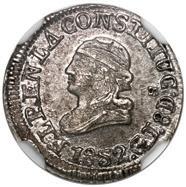



886. Quito, Ecuador, 1/4 real, 1852, NGC MS 65. KM-36. Lightly toned over luster, with rusty-die surfaces and slightly off-center bust side, near top grade. NGC #5878318-020. Estimate: $300-$450.
888. Ecuador (struck in Philadelphia), copper-nickel 2-1/2 centavos, 1917, NGC MS 63. KM-61. Nice luster with light gold toning, one-year type, second highest grade in current NGC census (behind three at MS 64). NGC #6611626-002. Estimate: $250-$375.
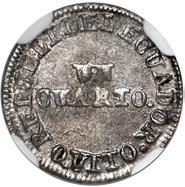
889. Ecuador (struck in Birmingham, England), gold 1 condor, 1928, NGC MS 63. KM-74; Fr-11. Cartwheel luster and minimal bagmarks, scarce one-year type of which only 55,000 pieces were released for circulation. NGC #6478033-002. Estimate: $700-$1,000.
890. San Salvador, El Salvador (under Spanish Guatemala), silver 1R-sized proclamation medal, Ferdinand VII, 1808. Fonrobert-7464; Herrera-76; Medina-378; Grove-F179. Choice grade for the issue (essentially Mint State), with light toning over ample luster, spot of extra metal on last I of ordinal (as made), a few faint hairlines on obverse but no more than typical. Estimate: $200-$300.




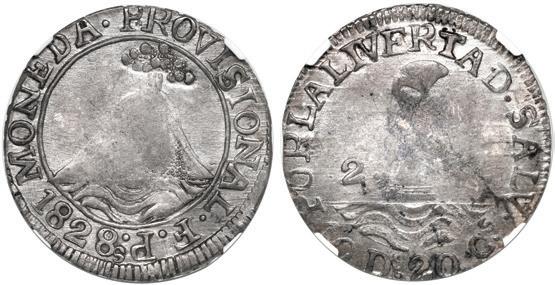

891. San Salvador, El Salvador, provisional 2 reales, 1828 F.Ps., LIVERTAD, NGC AU 50. KM-4. Richly toned, with much luster in bold legends, somewhat weak in centers, very rare grade (second finest in current NGC census behind a single AU 53), Jovel-Yonaka Type C, Villavicencio A4/R4. Pedigreed to the John O’Brien collection, with his envelope. NGC #3072743013. Estimate: $1,000-$1,500.

892. San Salvador, El Salvador, provisional 1 real, 1833, ESTADO DEL SALVADOR, rare, NGC XF 45 (“top pop”). KM-17. Bold strike with rich toning, slightly doubled on reverse, rare and desirable first 1R issue of El Salvador, currently tied with one other for finest known in the NGC census, Jovel-Yonaka Type A, Villavicencio A2. Pedigreed to the John O’Brien collection, with his envelope. NGC #3838703-006. Estimate: $1,000-$1,500.
893. San Salvador, El Salvador, provisional 1 real, 1834, SALV, rare, NGC AU details / harshly cleaned, finest and only example in NGC census, ex-O’Brien. KM-18.5. Bold and nearly full strike with lustrous surfaces (perhaps cleaned, but certainly not harshly so, as stated by NGC, in whose census this is the one and only entry for any grade), rare date and denomination (in fact the first we have seen on the market since 2009), this example noted by O’Brien as “finest seen, far superior to KM plate,” Jovel-Yonaka Type B (“one example observed”), Villavicencio A2 (but with no trace of over-assayer claimed by that author). Pedigreed to the John O’Brien Collection (stated on label), with his envelope. NGC #6614418-004. Estimate: $500-up.
894. San Salvador, El Salvador, provisional 1 real, 1834, SAL with retrograde S, rare, NGC XF details / reverse tooled, ex-O’Brien. KM-18.5. Full and bold details with light toning all over, a few heavy scratches in field near center of reverse but still “way better than KM plate coin” (O’Brien), rare date and denomination (none offered publicly since 2009, also notably one of just two 1834 1R in the NGC census, the other being the previous lot, a different variety), unlisted in Jovel-Yonaka (Type A but with retrograde S on both sides), Villavicencio A1b. Pedigreed to the John O’Brien Collection (stated on label), with his envelope. NGC #6614418-005. Estimate: $500-up.
895. El Salvador, 2 reales, 1839 volcano countermark (Type III) on a Lima, Peru, 2 reales, 1829 JM, rare, NGC VF details / obv tooled, env damage, c/s F strong, ex-O’Brien. KM-36. Mostly deeply toned, with centers a bit weak and abraded (also with diagonal gouge at Liberty’s head), full countermark with clear 3 over retrograde 3 in date, rare as a type but also we can find no other instances of this host date (or any from 1829-34, for that matter) being offered in recent years. Pedigreed to the John O’Brien Collection (stated on label), with his envelope. NGC #6614418-008. Estimate: $600-$900.
896. El Salvador, copper pattern 1 peso (off-metal strike), 1893 CAM, reeded edge, Columbus, NGC PF 62 Brown. KM-Pn38. Dark brown with rainbow overtones, faint surface hairlines (as made), second finest in the current NGC census behind a single MS 63, interesting second-year pattern of a popular multi-year design originally struck to commemorate the 400th anniversary of Columbus’ discovery of the Americas. NGC #3931136001. Estimate: $2,000-$3,000.

897. Carolingian France (Quentovic mint), denier, Charles the Bald (840-875 AD), NGC MS 62. MG-716; Prou-191. 1.69 grams. Bold full details, choice luster with traces of toning. NGC #6213282001. Estimate: $200-$300.

898. France, gold ecu d’or, Charles VI (1380-1422), no dots below letters, NGC MS 62. Dupl-369; Fr-291. 3.87 grams. Full and sharp legend and inner details, the reverse slightly off-center, with luster throughout. NGC #6289905-006. Estimate: $800-$1,200.

899. France (Limoges mint), gold double louis d’or a tête nue, Louis XVI, 1786-I, NGC AU details / cleaned. Gad-363; KM-592.7. Traces of red toning around bold details, light surface hairlines on obverse, adjustment marks on parts of reverse rim, rated R5 in Gadoury. NGC #6354751-004. Estimate: $600-$900.

900. France (Paris mint), bronze 2 décimes, l’an 4 (1795-6), mintmark A,

NGC MS 63 Brown. Gad-300; KM-638.1. Bold strike with light red fields and purplish details, traces of original luster, technically second finest in NGC census behind a single MS 64 (for Paris mint) but listed as mintmark D in error. NGC #6281247-002. Estimate: $600-$900.
901. France (Limoges mint), 5 francs, Louis XVIII, 1815-I, PCGS
MS64, finest known in PCGS census. Gad-591; KM-702.6. Bold strike with choice luster and traces of rainbow toning around details, very rare grade, the sole finest at PCGS and far superior to NGC’s finest at AU 53. PCGS #41320474. Estimate: $1,500-$2,250.
902. France (Paris mint), 5 francs, Louis XVIII, 1822-A, NGC MS 62.
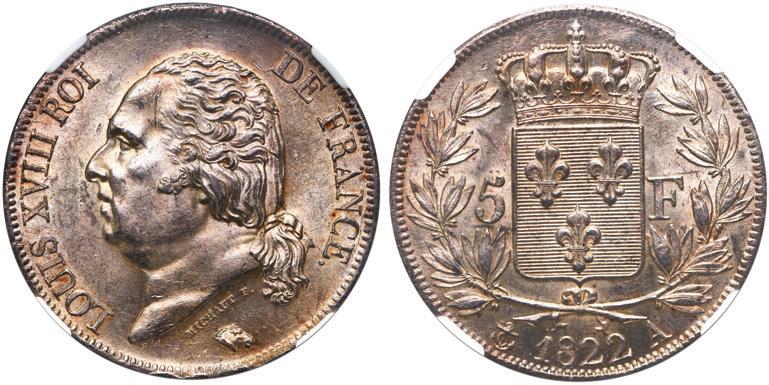
Gad-614; KM-711.1. Super-sharp strike with brilliant luster and very faint golden toning, minimal marks, looks higher grade to us. NGC #4216432-002. Estimate: $400-$600.

903. France (Bayonne mint), 5 francs, Charles X, 1829-L, PCGS MS62. Gad-644; KM-728.8. Ample luster and traces of light toning, light adjust ment marks in centers, currently tied with two others for second finest in PCGS census behind a single MS63 (which is also the top grade at NGC). PCGS #34150244. Estimate: $250-$375.
904. France (Paris mint), gold 50 francs, Napoleon III, 1865-A, NGC MS 62. Gad-1112; KM-804.1. Rich gold color and cartwheel luster, minor bagmarks only. NGC #6351114004. Estimate: $900-$1,350.
905. France (Paris mint), gold 50 francs, 1904-A, angel writing on tablet, PCGS MS64. Gad-1113; KM-831. Bright cartwheel luster and somewhat frosty details, light bagmarks only. PCGS #43278610. Estimate: $2,000-$3,000.
906. Schwarzburg-Sondershausen (German States), taler, Christian Wilhelm I and Anton Günther II, 1681 HM, death of Ludwig Günther, rare, NGC AU 55. Fischer-273; Dav-A7690; KM-112. Large coin (51mm) with sharp and intricate details draped with rich toning over muted luster punctuated by an occasional spot of brownish residue, a rarely seen issue that commands a premium, struck in commemoration of the death of Anton Günther II’s brother Ludwig, Count of Schwarzburg-Ebeleben and regent of Schwarzburg-Arnstadt in 1681. NGC #6323494-001 (large holder). Estimate: $3,500-$5,000.


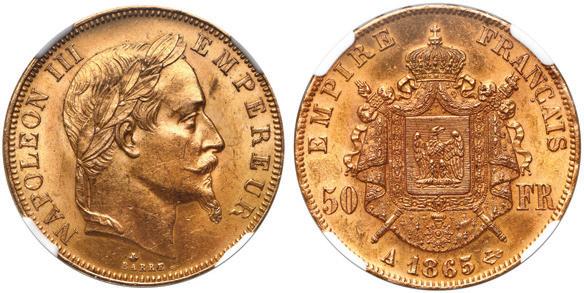

907. Great Britain (London, England), half crown, George II, 1745, LIMA below bust, NGC AU 55. Sp-3695; KM-584.3. Richly rainbow toned with traces of luster, a true AU as damage-free but with some high-point wear, pretty and popular as commemorating the capture of tons of Spanish Peruvian silver and gold on the French ships Louis Erasmus and Marquis d’Antin in the North Atlantic by English Captains Morecock and Talbot on their privateer ships Duke and Prince Frederick (not, as commonly told, related to Commodore Anson’s successes in the Pacific). NGC #5965113-008. Estimate: $400-$600.
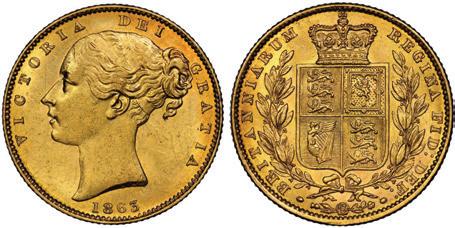
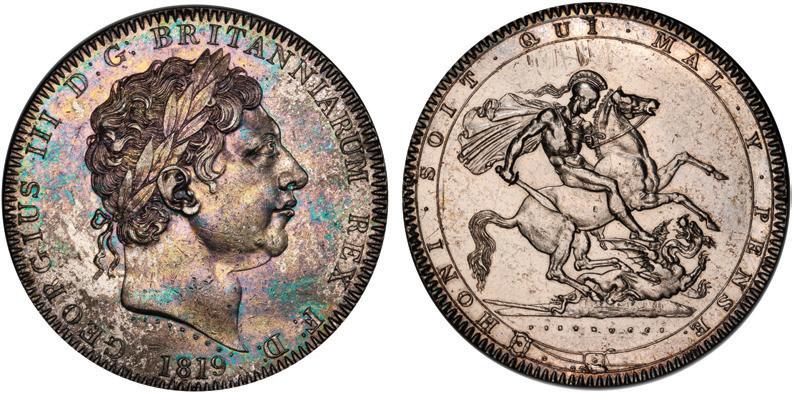
910. Great Britain, dollar, octagonal George III countermark (ca. 1804) on obverse of a Mexico City, Mexico, bust 8 reales, Charles IV, 1802 FT, PCGS AU58, c/m AU details. Sp-3766; KM656. Lustrous host with vivid toning at rims, fully detailed countermark (deeply impressed for the type), choice grade (second finest in PCGS census). PCGS #42177274. Estimate: $2,500-$3,750.
908. Great Britain, dollar, oval George III countermark (ca. 1797) on obverse of a Mexico City, Mexico, bust 8 reales, Charles IV, 1791 FM, NGC AU 55. Sp-3765A; KM-634. Very bold and deep countermark filled with toning, the host with lighter toning and faint luster throughout, popular issue in desirable grade. NGC #1874111-003. Estimate: $1,000-$1,500.
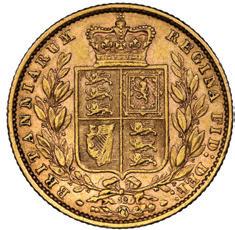

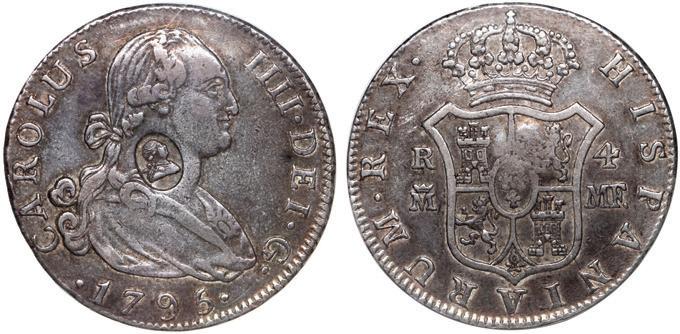


911. Great Britain, crown, George III, 1819, LIX on edge, PCGS UNC detail / cleaned. Sp-3787; KM-675. Eye-catching ex ample with splashy blue and magenta toning on obverse, the reverse brightly lustrous (maybe a trifle hairlined), with bagmarks throughout but nothing egregious. Pedigreed to a banker’s collection from the early 1900s. PCGS #44782637. Estimate: $400-$600.
909. Great Britain, 1/2 dollar, oval George III countermark (ca. 1797) on obverse of a Madrid, Spain, bust 4 reales, Charles IV, 1795 MF, NGC AU 53. Sp-3767; KM-622.1. Richly rainbow toned over luster, the countermark full and not too deeply punched, far scarcer than the dollar size. NGC #1875727-001. Estimate: $1,000-$1,500.
912. Great Britain (London, England), gold sovereign, Victoria (young head), 1863, NGC MS 61. Sp-3852D; KM-736.1. Lustrous and relatively free of bagmarks but with faint surface hairlines on obverse. NGC #6477169-004. Estimate: $400-$600.

913. Great Britain (London, England), gold sovereign, Victoria, 1874, shield reverse with die 32 below wreath, obverse lamination error, NGC Mint Error AU 50. Sp-3853B; KM-736.2. Bagmarked and lightly worn on high points, with apparent lamina tion flaw on neck, very rare to see on this type. NGC #6354751-007. Estimate: $2,000-$3,000.

914. Great Britain (Bombay Mint), trade dollar, George V, 1912-B, NGC MS 62. KM-T5. Cartwheel luster, a few minor bagmarks and cloudy spots, also some light red toning in center of reverse. NGC #6611629-004. Estimate: $500-$750.
916. Guatemala, cob 8 reales, 1737 (J). JP-8R5; S-G1; Cal-1241; KM-6. 26.72 grams. Full and bold pillars-and-worlds with 100% full but weaker date below, off-center shield, Fine with toning in crevices, scarce as non-salvage and non-holed. Pedigreed to the Ponterio auction of February 1997, with original lot-tag 1408. Estimate: $250-$375.

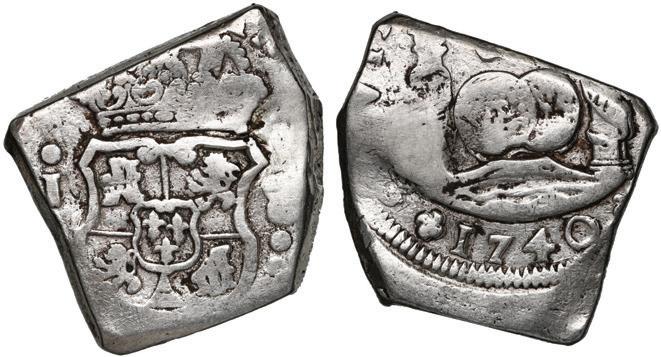


915. Great Britain (Bombay Mint), trade dollar, George V, 1929-B, NGC MS 64. KM-T5. Spectacular cartwheel luster, light golden toning on rims only, minimal bagmarks. NGC #6611629-005. Estimate: $800-$1,200.
917. Guatemala, cob 8 reales, 1738 (J). JP-8R6; S-G1; Cal-1242; KM-6. 26.53 grams. Bold full globes and waves with weak and prob ably lightly tooled date below, nice bold crown and shield, Fine with toning in crevices, scarce as non-salvage and non-holed. Pedigreed to the Ponterio auction of February 1997, with original lot-tag 1409. Estimate: $200-$300.


918. Guatemala, cob 8 reales, 1740 J. JP-8R8c; S-G1; Cal-1246; KM-6. 26.94 grams. Off-center pillars side with choice full date (and odd extra metal at left pillar), well-centered full shield with clear assayer to left, AVF with toning in crevices, scarce as non-salvage and non-holed. Pedigreed to the Ponterio auction of February 1997, with original lot-tag 1411. Estimate: $350-$500.
919. Guatemala, cob 8 reales, 1746 (J), rare, with sun-overmountains countermark (Guatemala, Type II, 1839) on pil lars side. Host: JP-8R14b; S-G1; Cal-1253; KM-6. 26.59 grams. Full globes with bold full countermark (AXF) above and very clear date below, full crown on shield side, non-holed VG with toning in crevices. Pedigreed to the UBS auction of January 2003, with original lot-tag 3424. Estimate: $700-$1,000.
920. Guatemala, cob 8 reales, 1747 J, rare, with sun-overmountains countermark (Guatemala, Type II, 1839) on shield side. Host: JP-8R15; S-G1a; Cal-418; KM-12. 26.57 grams. Curiously rectangular flan, very richly old-toned all over, relatively high grade (XF) but holed at one end, with 100% full date, the countermark (AU) crude but deep and full. Estimate: $500-$750.
924. Guatemala, cob 4 reales, 1736 J. JP-4R4; S-G1; Cal-1007; KM-5. 13.39 grams. Well-centered full pillars-and-globes with full date below, choice full crown on other side with bold full denomination 4 and clear assayer J, toned and lightly encrusted XF+ (possibly ex-Reijgersdaal wreck of 1747), no hole. Estimate: $350-$500.
921. Guatemala, cob 8 reales, 1752 (J). JP-8R20b; S-G1a; Cal-426; KM-12. 26.13 grams. Very broad flan with natural bubble-hole near edge, choice VF with very bold full date and crown and globes, darkly toned in crevices for nice contrast. Pedigreed to the Ponterio auction of February 1997, with original lot-tag 1417. Estimate: $500-$750.
925. Guatemala, cob 4 reales, 1737 J. JP-4R5b; S-G1; Cal-1008; KM-5. 13.23 grams. Odd squarish shape, with bold full 737 of date and full denomination, toned XF+ with light surface pitting (probably exReijgersdaal wreck of 1747), no hole. Estimate: $300-$450.
922. Guatemala, cob 8 reales, 1753 J. JP-8R21; S-G1a; Cal-427; KM12. 26.40 grams. Broad flan with bold full date below full pillars-globeswaves, also full crown and assayer and denomination on other side, toned Fine with no hole. Pedigreed to the Ponterio auction of February 1997, with original lot-tag 1419. Estimate: $300-$450.
926. Guatemala, cob 4 reales, 1738 J. JP-4R6b; S-G1; Cal-1009; KM-5. 13.57 grams. Neat shape with flat bottom, bold full date and assayer, toned VF with a few pits as probably ex-Reijgersdaal (1747), no hole. Estimate: $300-$450.









927. Guatemala, cob 2 reales, 1736 (J). JP-2R4; S-G1; Cal-680; KM-4. 6.41 grams. Well-centered AVF with choice full castles-and-lions and bold denomination 2, bold full date and mintmark, no hole, rated as scarce in Jara-Paiz. Estimate: $200-$300.
923. Guatemala, cob 8 reales, 1753 (J). JP-8R21; S-G1a; Cal-427; KM-12. 26.38 grams. Thicker (smaller) flan in a sharply five-sided cut, richly toned AXF with no hole, full date and assayer, full crown and globes. Estimate: $250-$375.
928. Guatemala, cob 2 reales, 1737 (J). JP-2R5b; S-G1; Cal-681; KM-4. 6.54 grams. Bold full date, off-center shield with full denomi nation 2, non-holed Fine with contrasting toning, rated as scarce in Jara-Paiz. Estimate: $200-$300.
929. Guatemala, cob 2 reales, 1744 (J). JP-2R12; S-G1; Cal-688; KM-4. 6.49 grams. Sharply four-sided cut with bold full date, nice toning, non-holed Fine+, rated as scarce in Jara-Paiz. Estimate: $200-$300. 930. Guatemala, cob 2 reales, 1751 J. JP-2R19; S-G1a; Cal-248; KM10. 6.55 grams. Bold full date located somewhat off-center compared to the globes, full but weaker shield, deeply toned Fine with no hole, rated as scarce in Jara-Paiz. Estimate: $200-$300. 931. Guatemala, cob 2 reales, 1752 J. JP-2R20; S-G1a; Cal-249; KM-10. 6.70 grams. Relatively large flan with choice full crown-globeswaves above bold full date (with old scratches), also full mintmark and assayer and denomination as well as a well-centered full shield, no hole, VF with contrasting toning. Estimate: $200-$300. 932. Guatemala, cob 1/2 real, 1735/4 (J), denomination “+”, rare. JP-MR3a; S-G1; Cal-unl (Type 46); KM-unl (2 for type). 1.18 grams. Full pillars and globes, nearly full date with messy but certain overdate, full denomination, toned Good with no hole, rated as rare in Jara-Paiz. Estimate: $250-$375.
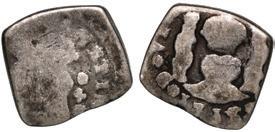

933. Guatemala, cob 1/2 real, 1744 J, de nomination “1/2”. JP-MR12a; S-G1; Cal-126; KM-2. 1.51 grams. Bold full date and mintmark below well-detailed pillars and crown and globes, choice full shield with bold assayer to left inside king’s ordinal V, unusually high grade at XF+ but with faint surface porosity, nicely toned, no hole, rated as scarce in Jara-Paiz. Estimate: $200-$300.
934. Guatemala, cob 1/2 real, 1747 J, denomination “1/2”, very rare. JP-MR15 var; S-G1a; Cal-unl (cf 21); KM-unl (cf 8). 1.53 grams. Choice full crown and right pillar, clear date, bold full assayer inside king’s ordinal VI, just enough of the left side of the denomination to confirm it is “1/2” and not “+” (noted in Jara-Paiz as “reported”), deeply toned VF for the type, no hole. Estimate: $350-$500.
935. Guatemala, cob 1/2 real, 1752 J. JPMR20; S-G1a; Cal-26; KM-21. 1.62 grams. Bold full date (with possible 2/1 for final date, which is unlisted), also choice full pillars-and-globes and crown and shield, full assayer J, lightly toned VF with no hole, rated as scarce in Jara-Paiz. Estimate: $250-$375.




936. Guatemala, pillar 8 reales, Ferdinand VI, 1756 J, normal N in king’s name, very rare. Yonaka-G8.56b; JP-8R24b; Cal-433; KM-18. 26.67 grams. Small-flan VF with lightly toned fields (dark area on left pillar), slight central flan-bulge on pillars side, noted in Yonaka as a very rare variety (R2) without ligature of NA in FERDIND (not mentioned in Jara-Paiz, the date itself rated as scarce). Estimate: $350-$500.

937. Guatemala, pillar 8 reales, Charles III, 1768 P. YonakaG8.68a; JP-8R37; Cal-1000; KM-27.1. 26.78 grams. Attractive, broad-flan XF with full rims, nice toning, odd metal-flow lines radiating from crown to QUE. Estimate: $400-$600.



938. Guatemala, gold bust 1 escudo, Ferdinand VII, 1817 M, NGC AU 53. Cal-1495; KM-74. Broad flan with full rims, much luster for the grade, just some light high-point wear, desirable singleyear type. NGC #2125603-001. Estimate: $600-$900.
939. Guatemala, bust 8 reales, Charles IV, 1794 M, NGC MS 62 (“top pop”). Cal-884; KM-53. Choice luster with rainbow toning at rims, very rare grade, tied with one other for finest in the current NGC census. NGC #6469750-001. Estimate: $1,500-$2,250.
940. Guatemala, bust 8 reales, Ferdinand VII, 1816 M, NGC MS 60. Cal-1229; KM-69. Incredibly sharp strike on a broad flan with full rims, deeply rainbow toned all over, the obverse with noticeable surface hairlines (net graded). NGC #2816926-002. Estimate: $200-$300.
941. Guatemala, 1 real proclamation medal, Ferdinand VII, 1808, FERDIN variety, no PGA, NGC AU 58. Cal-545; Herrera-16 var; Medina-297; Grove-F60. The 1R 1808 proclamation medals of Guatemala come in several varieties, covered by Herrera and Medina and Grove but oddly not all of them in any one reference, this one being the type with FERDIN . HISP . VII . GUAT . II . in the obverse legend but without the engraver’s initials PGA below the bust (note the NGC label and census do not distinguish between absence and presence of the PGA, this being just one of two in the census, curiously listed under Mexico). Bold strike with deep rims, nice toning, light hairlines to right of bust, somewhat scarce as non-holed. NGC #6475694-001. Estimate: $300-$450.
942. Guatemala (Central American Republic), gold 1/2 escudo, 1825 M, PCGS

MS64. KM-5. Sharp, bold strike with lovely luster and traces of toning at rims, faint adjust ment marks at base of mountains, choice grade, second finest in PCGS census behind a single MS64+ (with just one higher at MS 65 at NGC). PCGS #40234112. Estimate: $2,000-$3,000.
943. Guatemala (Central American Republic), 8 reales, 1826
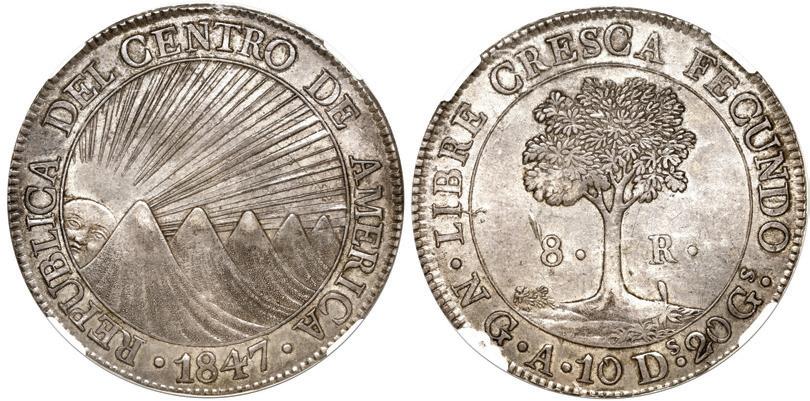



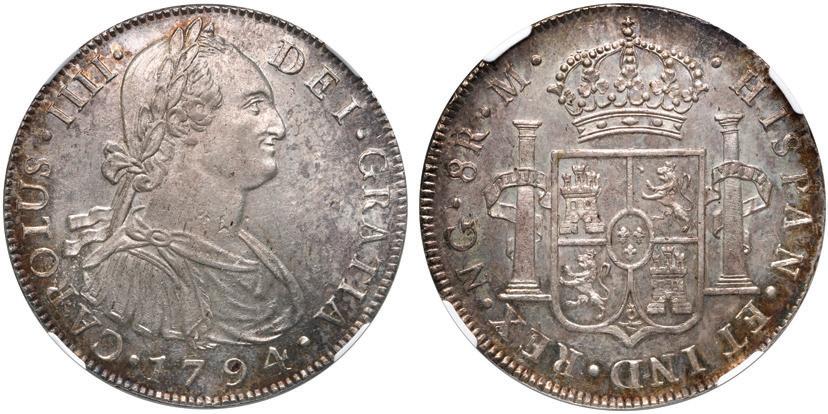
M, NGC MS 62. KM-4. Nice luster, faintly toned, fully detailed but slightly off-center strike, popular type in choice grade, currently second finest in the NGC census behind a single MS 63. NGC #6611408-009. Estimate: $1,000-$1,500.
944. Guatemala (Central American Republic), 8 reales, 1847
A, NGC AU 53. KM-4. Well struck and richly toned over muted luster, minor rim-bruise on mountains side, final date of a popular series. NGC #4821118-004. Estimate: $700-$1,000.
945. Guatemala (Central American Republic), 1 real, 1824 M, PCGS MS65, finest known in PCGS census. KM-3. Super flashy and frosty (almost prooflike), with sharp full details and bold full rims, diagonal die-crack across mountains, the single finest at PCGS, exceeded only by a lofty MS 67 at NGC, incredible quality for this popular type (first year of issue). PCGS #36269111. Estimate: $2,000-$3,000.


946. Guatemala, 8 reales, sun-over-mountains countermark (Type II, 1839) on cross side of a Potosí, Bolivia, cob 8 reales Royal (galano), 1683 V, NGC VF details / holed, c/s XF weak. KM-96.1. 24.8 grams. Broad-flan host with cracks to edge from the crude but very deep countermark, holed to left of cross / near top of pillars, attractively toned, cross side appears to be a die-match with Lázaro 210 (rated R2) but Lázaro’s pillars side is too doubled to confirm a match. NGC #2845861-001. Estimate: $2,000-$3,000.
948. Guatemala, 8 reales, sun-over-mountains (Type II, 1839) countermark on cross side of a Potosí, Bolivia, cob 8 reales, 1754 C. KM-99. 26.74 grams. Full and deep countermark (XF+) in one quadrant of nearly full cross on AXF host with good full pillars, bold full date and assayer, deeply toned all over, somewhat scarce without a hole. Estimate: $250-$375.



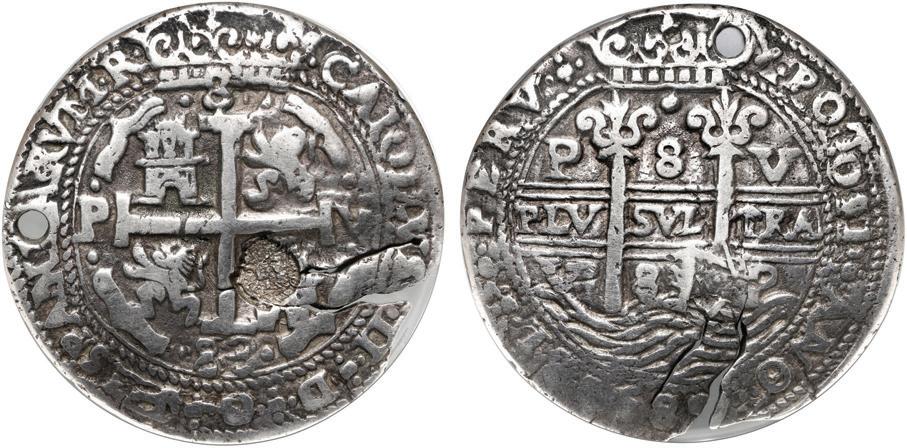
947. Guatemala, 8 reales, sun-over-mountains (Type II, 1839) countermark on pillars side of a Potosí, Bolivia, cob 8 reales, 1740 M. KM-97.3. 25.76 grams. Choice VF host with full pillars-and-waves and cross-lions-castles, well centered on a typically fat planchet, the XF countermark full but slightly doubled, attractively toned all over, somewhat scarce without a hole. Estimate: $250-$375.
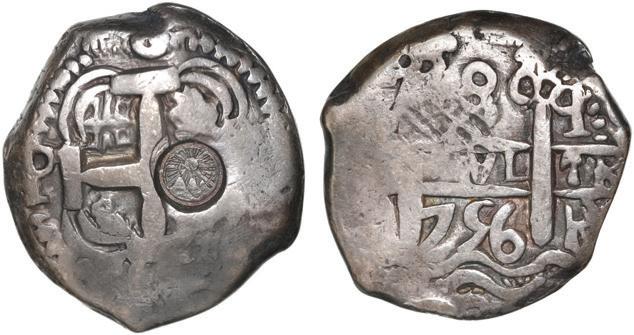
949. Guatemala, 8 reales, sun-over-mountains (Type II, 1839) countermark on cross side of a Potosí, Bolivia, cob 8 reales, 1756 q. KM-99. 26.87 grams. Choice full countermark (XF+) very deeply impressed near center of VF host with nearly full cross, one full pillar, bold date and assayer, richly toned all over, somewhat scarce without a hole. Estimate: $250-$375.
950. Guatemala, 4 reales, sun-over-mountains countermark (Type II, 1839) on cross side of a Potosí, Bolivia, cob 4 reales, 1771 (V-Y), NGC Fine details / holed, c/s XF standard. KM-85.6. Host with well-centered pil lars, off-center cross with fully detailed countermark in lower left quadrant, richly toned and lightly scratched long ago, the hole distended from extensive use. NGC #6610345-005. Estimate: $200-$300.
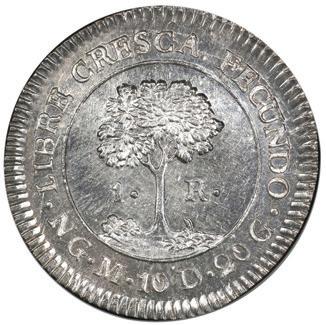
951. Guatemala, 4 reales, sun-over-mountains countermark (Type II, 1839) on obverse of a Cuzco, Peru, 4 reales, 1835 B, with El Salvador zigzag countermark (1835), very rare, NGC VF details / rev tooled, ex-O’Brien. cf KM-91. Fascinating piece that circulated in three different countries (Peru, then El Salvador, then Guatemala), the two countermarks both full and well detailed on the obverse of a well-toned host (reverse struck slightly off-center, with heavy old scratches near center), only the third we have seen of this combination (not listed in KM) and the first with this host date, also the only one listed in the NGC census. Pedigreed to the John O’Brien Collection (stated on label) and with his envelope. NGC #6614418-006. Estimate: $1,000-up.
952. Guatemala, 2 reales, sun-over-mountains countermark (Type II, 1839) on obverse of a Lima, Peru, 2 reales, 1833/2/1 MM (unique), with El Salvador zigzag countermark (1835), very rare, NGC VG 10, c/s VF standard, ex-O’Brien. cf KM-82. Like the previous lot, this coin is unusual for having circulated in three different countries (Peru, then El Salvador, then Guatemala), the coun termarks both full and well detailed on the obverse of a well-toned host (reverse struck slightly off-center), first of this combination we have seen in this denomination (not listed in KM, although NGC census does list one other at VF), clear 3/2/1 overdate that is unlisted and presumably unique (not noted by NGC). Pedigreed to the John O’Brien Collection (stated on label) and with his envelope. NGC #6614418-007. Estimate: $500-up.
953. Guatemala, 8 reales, Type III double countermark (1840) on a Lima, North Peru, 8 reales, 1838 MB. KM-120.5. 27.34 grams. Bold, full, well-detailed but double-struck countermarks (AU), the host VF+ with light golden toning in legends, parts of rims slightly crude (as made). Estimate: $200-$300.

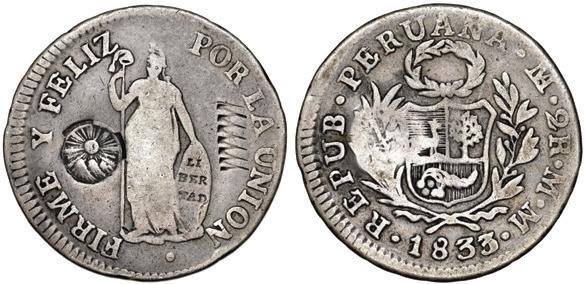

954. Guatemala, gold 20 pesos, Carrera, 1869 R, NGC
AU 58. KM-194. Popular largest gold coin of pre-modern Guatemala (32.258 grams in 0.900 fineness), with choice luster for the grade and a partial ring of light red toning on obverse, some light hairlines and bagmarks but practically no wear. NGC #6475661-006. Estimate: $3,000-$4,500.
955. Guatemala (struck at the Philadelphia mint), gold 20 quetzales, 1926, PCGS MS63. KM-246. Brilliant cartwheel luster, rich gold color, small bagmarks all over, popular one-year type. PCGS #34158566. Estimate: $2,500-$3,750.


956. Haiti (struck in Paris), 1 gourde, 1887, NGC MS 61. KM-46. Deeply and vividly toned in a full spectrum of rainbow colors over ample luster, very pretty and aesthetically more attractive than its grade indicates. NGC #6610345-010. Estimate: $600-$900.
957. Haiti, gold proof 1000 gourdes, 1974, USA bicenten nial, rare error without country name, NGC PF 68 Ultra Cameo (“top pop”). KM-118.2. An interesting and artistically pleasing issue (this example nearly free of flaws) in which the designer opted to put BICENTENAIRE DES U.S.A. at top instead of REPUBLIQUE D’HAITI, thereby unintentionally leaving this coin without a stated country of issue. While the non-error comes in higher grades, this example is currently tied with three others in the NGC census for the error without country name. With original case of issue. NGC #6323255-001. Estimate: $1,000-$1,500.

958. Olancho, Honduras, silver 8R-sized proclamation medal, Ferdinand VII, 1808, La Oficina del Batallón de Milicias, by Pedro García Aguirre, very rare. Herrera-44; Medina-335; Grove-F70. 26.41 grams; 40 mm. XF with deep, rich, old toning all over, crudely holed at top (with some associated gouges on reverse), officially an issue under the Captaincy General of Guatemala as a part of Mexico but specifically for the mining region of Olancho in what is now the country of Honduras. This is one of only two examples we can trace. Pedigreed to the Ponterio auction of November 2009, with original lot-tag 9543. Estimate: $1,000-$1,500.




959. Tegucigalpa, Honduras, provisional 4 reales, 1856 G, rare, NGC AU 58 Brown, finest known in NGC census. KM-20d. Typically crudely struck (lots of flat or weak areas) but with much bold legend including date, and with traces of original color and luster to prove the grade, otherwise dark. Pedigreed to the John O’Brien Collection (stated on label) and with his envelope. NGC #6614418-002. Estimate: $500-$750.
960. Honduras, gold 1 peso, 1902, NGC MS 62, finest known in NGC census. KM-56. Bold but slightly crude strike as usual, with full details but some irregularity in obverse fields, brightly lustrous in light yellow gold, very low mintage. NGC #4537342-123. Estimate: $800-$1,200.
961. Honduras, 1 peso, 1896/4, PCGS AU50, finest and only example in PCGS census. KM-62. Very weakly struck from old dies (normal for this date, the overdate very bold) but with traces of luster emanating from lightly toned surfaces, finest at PCGS with none higher at NGC. PCGS #39840004. Estimate: $350-$500.

962. Honduras, bronze 1 centavo, 1890, denomination UN/10, no wreath on obverse, NGC MS 63 BN, finest known in NGC census, ex-Dana Roberts. KM-59. 4.44 grams. From a chaotic period of mixed and concurrent dies, this with denomination UN punched over 10 on reverse (KM-49) but with new obverse, this exceptional specimen with choice details and traces of original copper color and luster, crude rims as usual (as made). Pedigreed to the Dana Roberts collection (stated on label). NGC #2741447-003. Estimate: $700-$1,000.
963. Honduras, bronze 1 centavo, 1910, 5c obverse die and 1/2c reverse die, NGC MS 64 BN, exDana Roberts. KM-66 (KM-48 obverse, KM-45 reverse). Another testament to the troubles at the Tegucigalpa mint, which created this coin from dies meant for two other, different denominations (5c obverse, 1/2c reverse), the modification to denomination and date on the reverse quite obvious here, this specimen rather choice in strike (despite a rim-cud on reverse and corresponding weakness on other side) and preservation, with much original color and luster and no wear or marks at all, in fact tied with two others for second finest in the current NGC census behind a single MS 65. Pedigreed to the Dana Roberts collection. NGC #3313001-018. Estimate: $350-$500.
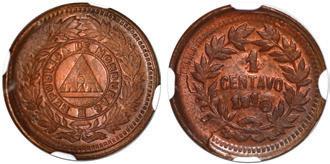

964. Ragusa (Italian States), 1/2 scudo, 1748 SB, thirteen stars around, PCGS VF detail / cleaned, ex-FNB of Mabel, MN Collection. KM-10. Grainy surfaces but with luster on obverse, the reverse richly toned, a scarce and desirable issue showing St. Blasius on obverse and Christ on reverse. Ragusa today is known as Dubrovnik, in Croatia, but was its own republic under Habsburg Austria, and for all of the 16th to 18th centuries followed Italian tradition and language (hence its numismatic placement under Italian States). Pedigreed to a banker’s collection from the early 1900s. PCGS #44782601. Estimate: $500-$750.

965. Sardinia (Italian States), Turin mint (eagle mintmark), gold 20 lire, 1820-L, Vittorio Emanuele I, NGC AU 58. KM-114. Rich gold color with muted luster, bold strike, slightly crude rims with evidence of adjustment marks. NGC #6354751-005. Estimate: $600-$900.
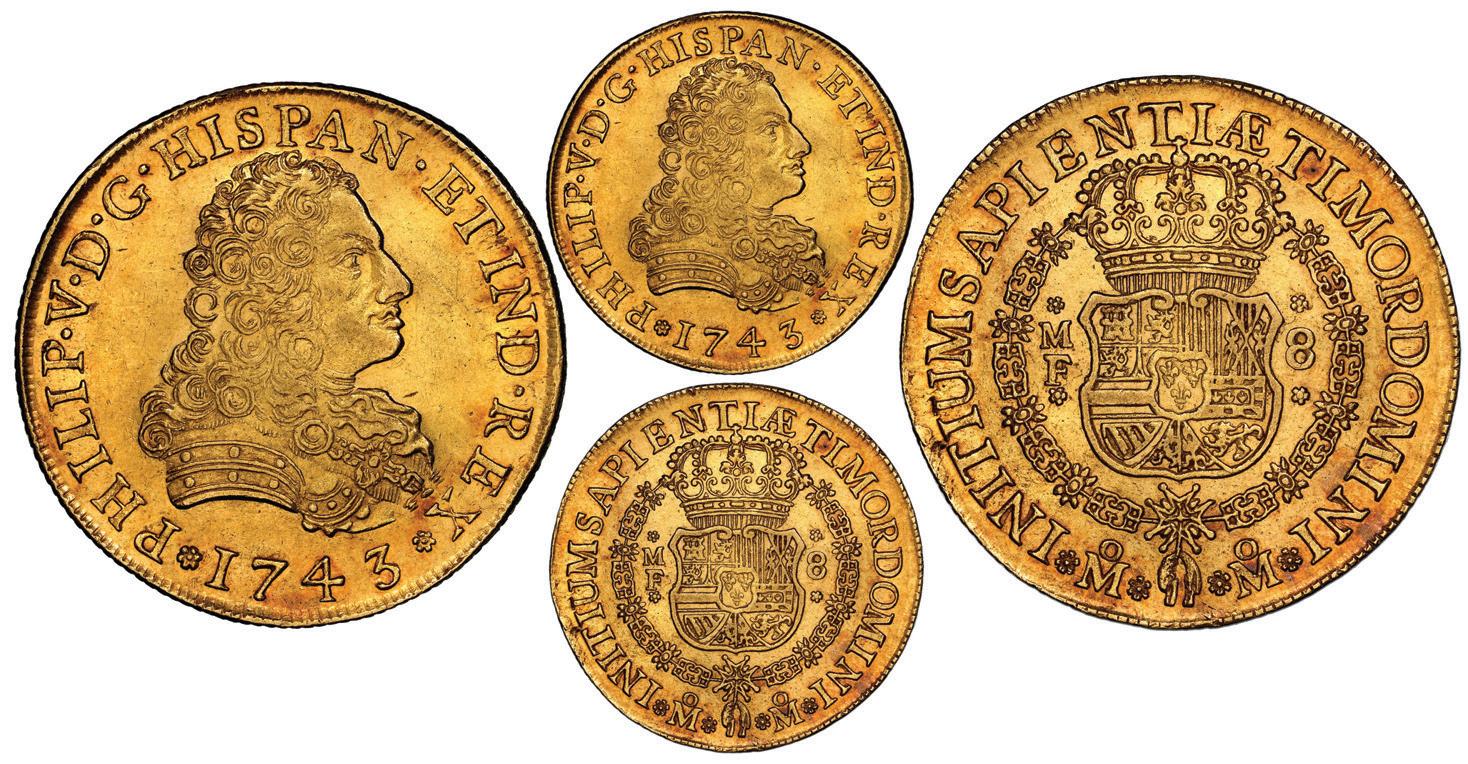

966. Mexico City, Mexico, gold bust 8 escudos, Philip V, 1743 MF, NGC AU 58. Cal-2247; KM-148. 26.99 grams Choice, sharp strike with high rims containing lustrous fields with a tinge of light red toning, faint surface hairlines on obverse, scarce early type. NGC #6476175003. Estimate: $8,000-$12,000.
967. Mexico City, Mexico, gold bust 8 escudos, Charles IV transitional (bust of Charles III, ordinal IIII), 1790 FM, NGC AU 58. Cal-1629; KM-158. Rich golden color over luster, muted luster, slightly weak centers, desirable one-year transitional type with ordinal IIII combined with bust of previous king. NGC #3958434050. Estimate: $2,000-$3,000.

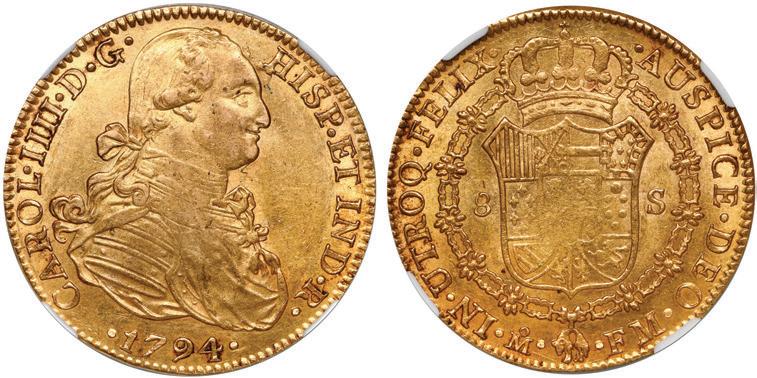

971. Mexico City, Mexico, gold bust 8 escudos, Ferdinand VII transitional (“armored bust”), 1808 TH, NGC AU 58. Cal-1781; KM-160. Lustrous and choice for the assigned grade, the center of reverse slightly weak but the rims full, desirable first date of type. NGC #5783003-015. Estimate: $2,000-$3,000.
968. Mexico City, Mexico, gold bust 8 escudos, Charles IV, 1794 FM, NGC AU 58. Cal-1633; KM-159. Strong luster for the as signed grade, with slightly weak centers but bolder toward rims. NGC #5783003-013. Estimate: $1,750-$2,500.


972. Mexico City, Mexico, gold bust 8 escudos, Ferdinand VII transitional (“armored bust”), 1809 HJ, NGC AU 58. Cal1782; KM-160. Colorfully toned in legends, brightly lustrous, the centers just slightly weak. NGC #5710282-003. Estimate: $2,000-$3,000.
969. Mexico City, Mexico, gold bust 8 escudos, Charles IV, 1805 TH, NGC AU 58. Cal-1649; KM-159. Choice reverse with strong luster for the assigned grade, the obverse slightly weak in center and with bagmarked fields. NGC #6467085-002. Estimate: $1,750-$2,500.
973. Mexico City, Mexico, gold bust 8 escudos, Ferdinand VII transitional (“armored bust”), 1810 HJ, NGC AU 55. Cal1783; KM-160. Strong luster for the assigned grade, with bold bust but weakness and minor flaws in center of reverse, light surface hairlines in obverse fields. NGC #6467085-004. Estimate: $2,000-$3,000.
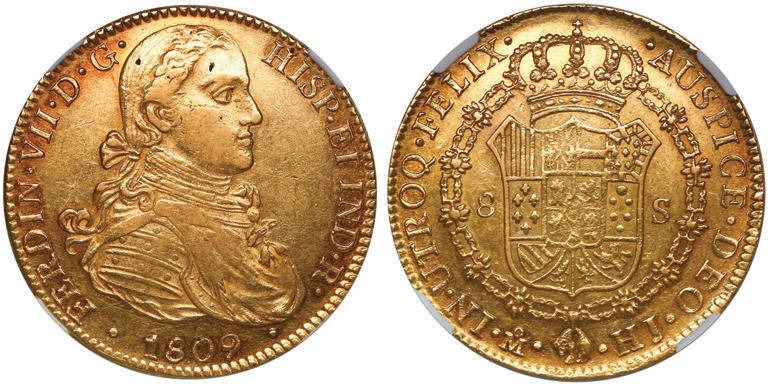
970. Mexico City, Mexico, gold bust 8 escudos, Charles IV, 1807 TH, NGC AU 55. Cal-1653; KM-159. Colorfully toned over luster in legends, the bust a bit weaker but rather nice overall for the assigned grade. NGC #6469747-002. Estimate: $1,500-$2,250.

974. Mexico City, Mexico, gold bust 8 escudos, Ferdinand VII transitional (“armored” bust), 1811 JJ, NGC MS 64+, finest known in the NGC census. Cal-1786; KM-160. Intense lus ter and superb strike (just the center of the shield slightly weak), so pristine that die-polish lines can be seen in obverse field, very flashy and impressive, far and away the finest on record (note: there is a light scratch on the top of the plastic capsule). NGC #6610351-001. Estimate: $10,000-up.




975. Mexico City, Mexico, gold bust 8 escudos, Ferdinand VII, 1817 JJ, NGC AU 58. Cal-1795; KM-161. Some luster and wear, the bust a bit weak in strike, also some surface hairlines, better date. NGC #6469744-004. Estimate: $1,750-$2,500.
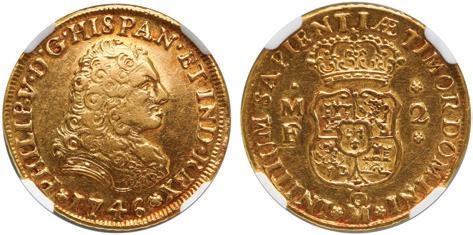

976. Mexico City, Mexico, gold bust 4 escudos, Ferdinand VII transitional (“armored” bust), 1810 HJ, NGC AU 50. Cal-1720; KM-145. Toned around details, traces of luster, slightly weak centers, scarce type. NGC #6289380-007. Estimate: $1,000-$1,500.
977. Mexico City, Mexico, gold bust 2 escudos, Philip V, 1746 MF, NGC XF 45. Cal-1915; KM-124. Bold strike with very nice luster for the assigned grade, bold bust with flattened high points, light marks in fields, nicely toned in legend. NGC #2787539-002. Estimate: $1,750-$2,500.
978. Mexico City, Mexico, pillar 8 reales, Philip V, 1739 MF, NGC MS 62. Yonaka-M8.39; KM-103; Cal-1453. Richly rainbow toned over luster, bold strike, satin-smooth fields, natural flaw in pillars-side rim, scarce as non-salvage. NGC #6469745-002. Estimate: $1,500$2,250.

979. Mexico City, Mexico, pillar 8 reales, Ferdinand VI, 1754 MM/F, dissimilar crowns, PCGS MS61. Yonaka-M8.54d1; Cal-486; KM-104.1; Cal-483. Bold strike with very light adjustment marks on shield side, frosty white as non-toned with pristine fields, uncommon variety with lower assayer M punched over previous F (not noted by PCGS). PCGS #45872946. Estimate: $800-$1,200.



982. Mexico City, Mexico, pillar 2 reales, Philip V, 1746/5 M, mint error edge-clip (full weight). Yonaka-M2.46a; KM-85; Cal-835. 6.70 grams. Non-toned AU- with boldly struck details, the overdate faint but certain, with straight clip on edge as it came from the mint, one of very few such errors known for this issue. Estimate: $200-up.
983. Mexico City, Mexico, pillar 2 reales, Philip V, 1751 M, NGC MS 62. Yonaka-M2.51; KM-86.1; Cal-291. Bold strike with natural depression in center of shield, deeply rainbow toned all over, light adjustment marks on pillars, tied with one other for second finest in current NGC census behind a single MS 63. NGC #6284505-002. Estimate: $400-$600.
980. Mexico City, Mexico, pillar 8 reales, Charles III, 1763 MF, PCGS AU50. Yonaka-M8.63c; KM-unl (104.2 for type); Cal-486. Nice luster for the assigned grade, with very light toning, a bit soft in strike but with some light wear on high points as well. PCGS #44876632. Estimate: $400-$600.
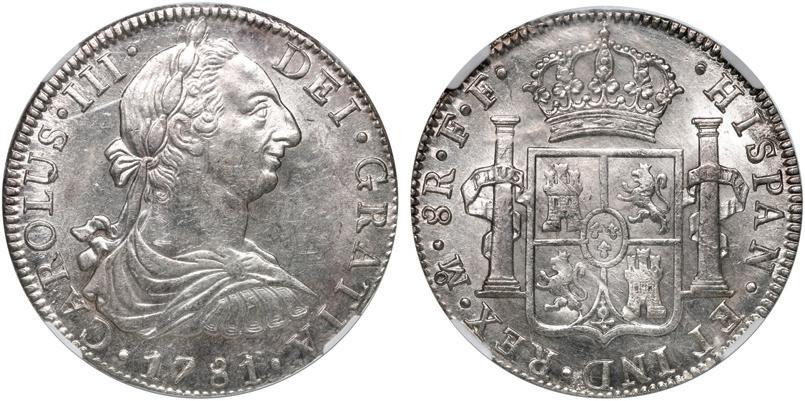


981. Mexico City, Mexico, pillar 8 reales, Charles III, 1771 FM, NGC UNC details / cleaned. Yonaka-M8.71; KM-105; Cal-1103. Super sharp strike with all details fully rendered, even the rims full and choice, also with original luster but the pillars side fields lightly hairlined as well. NGC #6062392-017. Estimate: $300-$450.

984. Mexico City, Mexico, bust 8 reales, Charles III, 1781 FF, NGC MS 62 (“top pop”). Yonaka-M8.81; Cal-1121; KM-106.2. Well struck and highly lustrous, with faint adjustment marks on reverse, tied with two others for finest in the current NGC census (1779 to 1787 being particularly rare in high grade). NGC #4274528-008. Estimate: $2,000-$3,000.
985. Mexico City, Mexico, bronze 8 reales proclamation medal, Charles IV, 1789, rare, NGC MS 61 Brown. Grove-C9a; Cal-948. Light chocolate brown in color, with smooth fields and lacking any high-point wear, the assigned grade probably due to lack of luster. NGC #6276094-001. Estimate: $700-$1,000.
986. Mexico City, Mexico, bust 8 reales, Charles IV, 1799

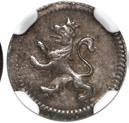
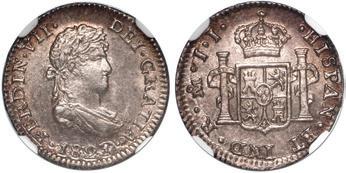





FM, NGC MS 63 (“top pop”). Yonaka-M8.99; KM-109; Cal-963. Muted luster under light rainbow toning, no wear at all, the strike a bit soft and low in contrast, currently tied with one other for finest in NGC census. NGC #5985744-001. Estimate: $700-$1,000.
987. Mexico City, Mexico, bust 8 reales, Charles IV, 1799
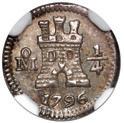
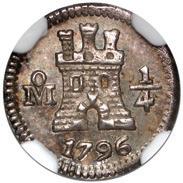

FM, NGC MS 62. Yonaka-M8.99; KM-109; Cal-963. Broad flan, bold strike, much luster, toned at rims, hairlines on obverse. NGC #6445264-002. Estimate: $300-$450.
988. Mexico City, Mexico, bust 8 reales, Charles IV, 1808
TH, NGC MS 62. Yonaka-M8.108; KM-109; Cal-988. Brightly lustrous and sharply struck, almost prooflike overall (begging for a higher grade), clear evidence of die-clashing on obverse. NGC #6066493-002. Estimate: $350-$500.
989. Mexico City, Mexico, bronze 4 reales proclamation medal, Charles IV, 1789, rare, NGC AU 55 Brown, finest and only example in NGC census. Grove-C10a; Cal-792. Well struck but dark in color and lacking luster, minimal high-point wear, a few very light obverse rim-bruises. NGC #4698016-001. Estimate: $300-$450. 990. Mexico City, Mexico, bust 1/2 real, Charles III, 1772 FM (initials facing rim), NGC MS 62 (“top pop”). Yonaka-M05.72; KM-69.1; Cal-192. Broad flan, choice strike with very light toning over muted luster, traces of die-clashing on obverse, tied with one other for finest in the NGC census (that one listed on a different line). NGC #6097117-002. Estimate: $300-$450. 991. Mexico City, Mexico, bust 1/2 real, Charles IV, 1798 FM, NGC MS 63. Yonaka-M05.98; KM-72; Cal-282. Rain bow toned over muted luster (the reverse splashed with a bright blue), bold rims, the obverse surface slightly grainy (as made). NGC #6450851-003. Estimate: $300-$450. 992. Mexico City, Mexico, bust 1/2 real, Ferdinand VII, 1819/8 JJ, rare, NGC MS 63. Yonaka-M05.119a; KM-74; Cal409. Superb strike and pristine fields that even show light die-polish lines in the luster, very faintly gold-toned, the overdate fairly clear (rated R2 by Yonaka). NGC #6354696-006. Estimate: $300-$450. 993. Mexico City, Mexico, bust 1/2 real, Ferdinand VII, 1821 JJ, NGC MS 62. Yonaka-M05.121; KM-74; Cal-412. Strong luster and bold details with light red-gold toning all over. NGC #3075373-013. Estimate: $300-$450.
994. Mexico City, Mexico, 1/4 real, 1796, NGC MS 63. Yonaka-M04.96; KM-62; Cal-120. Bold strike with satin-smooth fields, very lightly rainbow toned. NGC #3594446-018. Estimate: $200-$300.
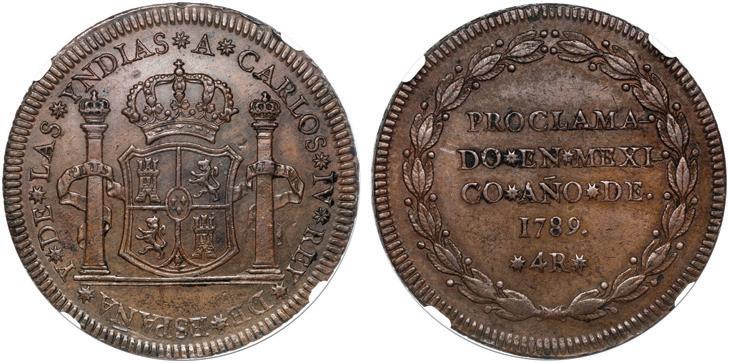
995. Mexico City, Mexico, 1/4 real, 1799/8, NGC MS 64. Yonaka-M04.99a; KM-62; Cal-126. Sharp strike, muted luster under light toning, the overdate quite clear (and apparently the norm for this date). NGC #3594446-019. Estimate: $200-$300.
996. Mexico City, Mexico, 1/4 real, 1800, NGC MS 63. Yonaka-M04.100; KM-62; Cal-128. Bold strike and rims, deeply toned over muted luster. NGC #3594446-020. Estimate: $200-$300.
1000. Durango, Mexico, bust 8 reales, Ferdinand VII, 1821 CG, NGC MS 61. Cal-1199; KM-111.2. Choice details (very sharp in centers) but with much crudeness on rims (as made), lustrous all over, currently tied with one other for second finest in the NGC census be hind a single MS 63. NGC #3706981-013. Estimate: $1,000-$1,500.
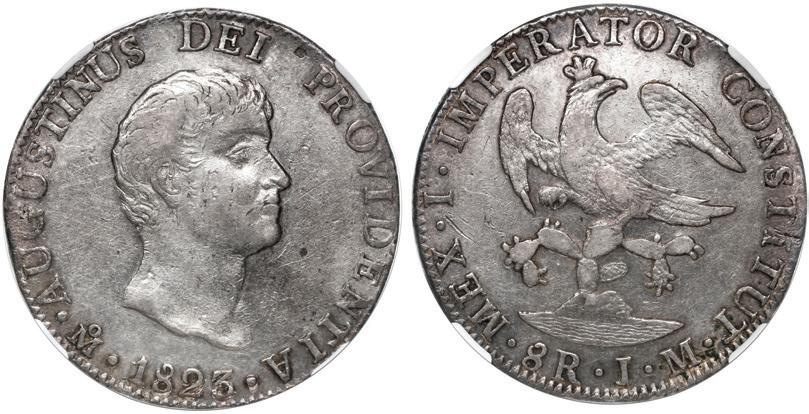
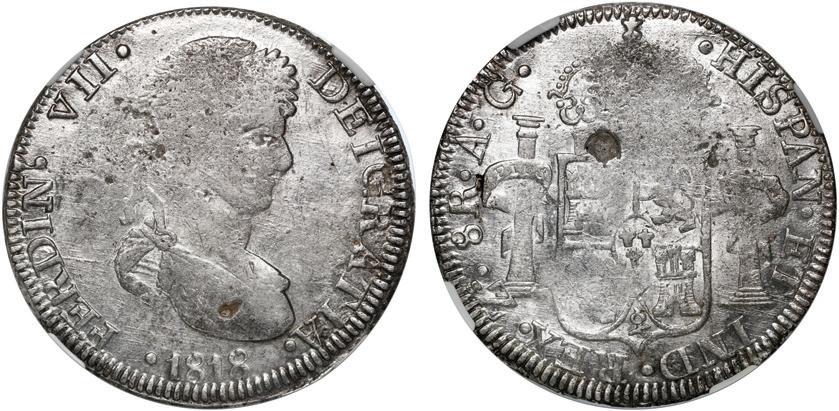

997. Mexico City, Mexico, 1/4 real, 1801/791, very rare, NGC MS 65, finest known in NGC census. Yonaka-M04.101b; KM-unl (62 for type); Cal-129. Choice bold strike and rims, lightly toned with underlying luster, strong overdate that Yonaka rates as R3. NGC #3594448-001. Estimate: $600-$900.
1001. Zacatecas, Mexico, bust 8 reales, Ferdinand VII, 1818 AG, NGC MS 61. Cal-1459; KM-111.5. Broad flan with stronger rims than usual, the centers rather weak and with a couple natural flaws, some heavy die-polish lines, lustrous all over. NGC #6205470-015. Estimate: $250-$375.




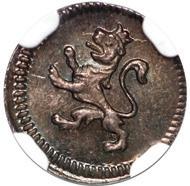













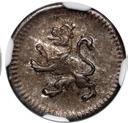

998. Mexico City, Mexico, 1/4 real, 1813, NGC MS 65. Yonaka-M04.113; KM-62; Cal-279. Incredible smooth fields with luster and deep rich toning, also choice sharp strike, rather lovely. NGC #3594448-012. Estimate: $300-$450.
999. Mexico City, Mexico, 1/4 real, 1816, rare, NGC MS 65, finest known in NGC census. Yonaka-M04.116; KM-62; Cal-282. Choice strike and ample luster with rich toning all over, the finest example of the rare final date of issue, rated R2 by Yonaka. Curiously, the final digit of the date appears to be a low 6 over a high 6 (decidedly not 6/5), a variety that is not listed in Yonaka. NGC #3594448-014. Estimate: $600-$900.
1002. Mexico City, Mexico, 8 reales, 1823 JM, Iturbide, short uneven truncation, 8RJM below eagle, NGC XF 45, ex-Foxlair. KM-310. Decent luster with nice but uneven toning, light high-point wear and small marks in fields. Pedigreed to the Foxlair Col lection (stated on label). NGC #4250907-001. Estimate: $250-$375.
1003. Mexico City, Mexico, “hookneck” 8 reales, 1824 JM, NGC MS 62. KM-A376.2; DP-Mo03. Nice luster with light toning, weak centers as usual, very popular type in a choice grade (just three higher at NGC from a current population of 123 graded). NGC #6478425-001. Estimate: $1,500-$2,250.
1004. Guanajuato, Mexico, gold 8 escudos, 1862 YE, NGC MS 60. KM-383.7. Choice strike and nice luster for the grade, no doubt assigned based on hairlines and small marks in obverse field. NGC #6286862-011. Estimate: $2,000-$3,000.


1006. Guanajuato, Mexico, cap-and-rays 8 reales, 1868 YF, PCGS MS64. KM377.8; DP-Go50. Flashy with brilliant luster, choice strike (some light die-cracks between rays). PCGS #35077515. Estimate: $300-$450.
1005. Guanajuato, Mexico, cap-and-rays 8 reales, 1840/30 PJ, NGC MS 62. KM-377.8; DP-Go22. Strong luster and sharp strike despite some graininess in fields, also with evidence of die-clashing on eagle side, some faint toning, clear overdate. NGC #2801351-003. Estimate: $250-$375.


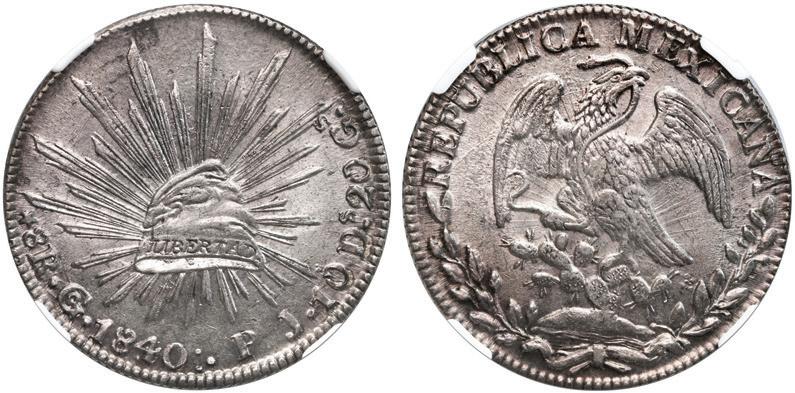
1007. Mexico City, Mexico, cap-and-rays 2 reales, 1861 CH, PCGS MS64+. KM-374.10. Lightly rainbow toned over cartwheel lus ter, choice strike with curious fiber strike-through around eleven o’clock on cap-and-rays side. PCGS #34514481. Estimate: $200-$300.

1009. Mexico City, Mexico, gold 1 peso, 1903 M, small date variety, NGC MS 64. KM-410.5. Highly lustrous (especially on the eagle side) with tall rims and sharp details, low mintage of 10,000 coins for both varieties. NGC #6454914-004. Estimate: $300-$450.


1010. Oaxaca, Mexico, gold 10 pesos, 1915 TM, fifth bust, NGC MS 65. KM-752. Well struck in light yellow gold (0.175 fine) with brilliant luster, no toning but with small black arc in front of Juarez’s chin, scarce revolutionary issue in choice grade, tied with two others for second finest in the NGC census behind a single MS 66+. NGC #4537342-107. Estimate: $1,000-$1,500.
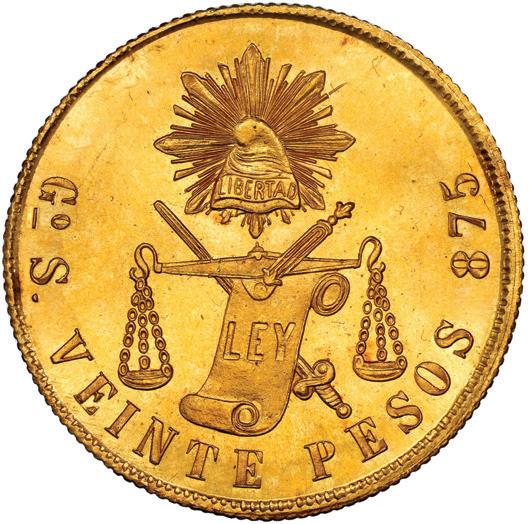
1008. Guanajuato, Mexico, gold 20 pesos, 1872 S, NGC
MS 66, finest known in NGC census. KM-414.4. Out of currently 615 Mexican gold 20 pesos coins of any date and mint in the NGC census (struck 1866-1905, including the Maximilian issues of 1866), only two are MS 66 and one is MS 66+, none finer, which places this finest-for-the-date piece (mintage 18,000) within the top 0.5% of all NGC-graded examples, a staggering honor for such a classic and popular type! This status is well deserved, as this coin’s strike is flaw less and its fields are almost all satin-smooth, with brilliant cartwheel luster, all in a lovely, rich gold color. A quick scan shows that no other 20 pesos of this type above MS 64 grade has sold publicly since 2018. For the Mexican numismatic connoisseur who can afford the best! NGC #6610351-002. Estimate: $20,000-up.


1011. Guerrero, Mexico, silver 2 pesos, 1914-GRO, NGC
AU 58. KM-643. Dark gray-gold toning over muted luster, decent strike, some minor surface graininess. NGC #6354695-016. Estimate: $300-$450.
1012. Brabant, Spanish Netherlands (Antwerp Mint), 1 real d’espagne, CharlesJoanna, 1517, rare. 2.76 grams. Typically broad, thin flan with fine, intricate features, toned AU with light surface corrosion, edge-split. This important and rarely offered issue was struck to fund Charles’ travel from what is now Belgium to Spain in order to claim the throne he shared with his mentally incompetent mother, Queen Joanna. Most of the coinage was subsequently melted. Featured on the reverse is the famous “fire steel” of the Order of the Golden Fleece superimposed over the Cross of Burgundy, a motif that appears in some tax stamps on gold bars from the “Tumbaga Wreck” (ca. 1528). Estimate: $500-$750.


1013. Gelderland, United Netherlands, “lion” daalder, 1649, NGC MS 64, finest known in NGC census. Dav-4850; KM-36. Broad flan with full legends including date and mint, lustrous and devoid of wear, some details lightly struck but the lion fully detailed, really incredible quality for this popular type. NGC #6447762-014. Estimate: $1,000-$1,500.
1014. Panama, cob 1 real, Philip II, assayer oB to left, mintmark AP over denomination I to right, very rare, NGC AU details / environmental damage. S-AP4; Cal-236; KM-2. 3.33 grams. Fully detailed but slightly doubled shield lacking Aragon per the variety, with bold full A-P-I to right, left side of assayer oB to left, part of king’s name in legend followed by an annulet (no ordinal), choice full crosslions-castles (also doubled) with full tressure in typically rotated position (characteristic of this rare mint), nicely toned all over, with minimal surface porosity. NGC #6478409-001. Estimate: $3,000-$4,500.



1015. Panama, proof 25 centimos, 1904, very rare, NGC PF 64. KM-4. Frosty details and mirror surfaces with clear die-polish lines, starting to tone at rims, second highest grade in NGC census behind a pair of MS 65’s, from a reported mintage of just twelve pieces from this first year of Panama’s own national coinage, the first example we have seen offered publicly in about a dozen years. NGC #2126243-001. Estimate: $8,000-$12,000.
1016. Panama (struck at the Stuttgart Mint), copper-nickel proof pattern 1 balboa, 1986, Type 2 variety, NGC PF 64. KM-Pn5. At tractively gold-toned over luster with minimal marks on the satin-smooth fields, from a reportedly tiny mintage of just ten pieces. NGC #2816100-002. Estimate: $1,250-$2,000.
1017. Paraguay (War of the Triple Alliance), 1 real, countermark “1” in rounded hexagonal field of horizontal lines (1865-70) on a wavy-edge 1/4 cut of a Bolivian Republic 4 soles, rare, NGC F 15, c/s VF standard, ex-Pomato, Janson Plate. Janson-13; Pratt-MR2; KM-B2. 3.21 grams. Bold full countermark situated below the full word LIBRE in the host’s legend, the other side with bold (RE)PUBLICA, giving the overall effect of symbolizing a “free republic,” sharply sloping edge-cuts, all well toned, with desirable pedigree. Pedigreed to the Mario Pomato Collection, Plate Coin on page 546 of La Moneda Circulante En El Territorio Argentino 1574-2019, by Hector Carlos Janson (2020). NGC #6610345-004. Estimate: $600-$900.

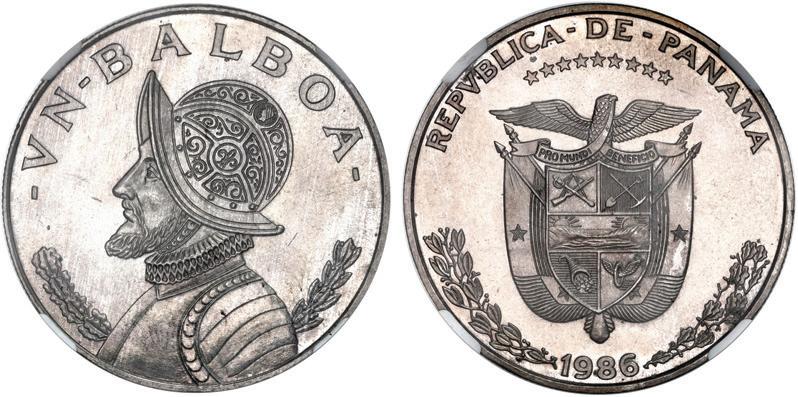
1018. Asunción, Paraguay, copper 4 centimos, 1870, rare, NGC AU 58 Brown. KM-4.2. Light chocolate brown in color, with typically grainy surfaces and minor flaws per the mint (many times rarer than the SHAW issues struck in Birmingham, England), traces of exposed bright metal from recent friction. NGC #6611408-002. Estimate: $1,000-$1,500.

1019. Paraguay (struck in Brazil), gold proof denomination set, 1978, rare: 10 guaranies, NGC PF 67 Ultra Cameo; 5 guaranies, NGC PF 67 Ultra Cameo; 1 guaraní, NGC PF 69 Ultra Cameo. KM-Ps10. Lovely lustrous proofs in rich red gold, only ten sets struck so quite rare from the outset, first set we have seen offered in a decade. NGC #6610350-001, -002, -003. Estimate: $7,000-$10,000.

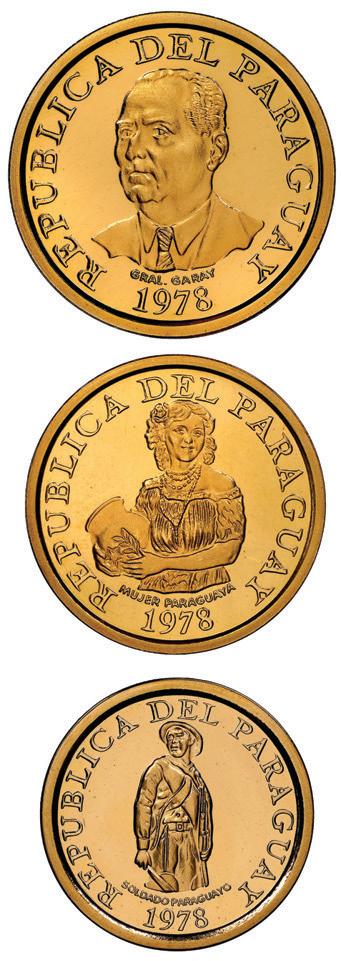
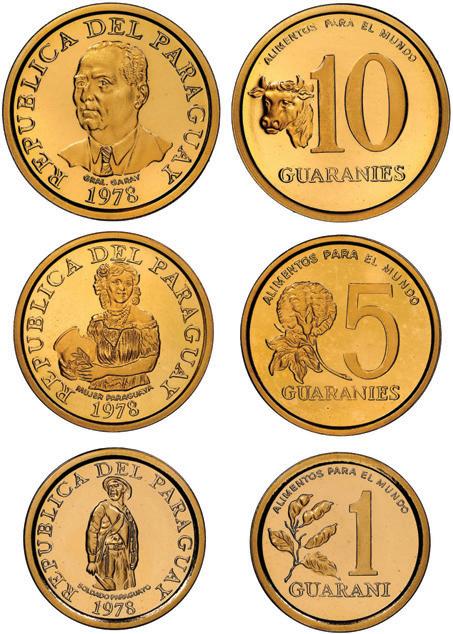


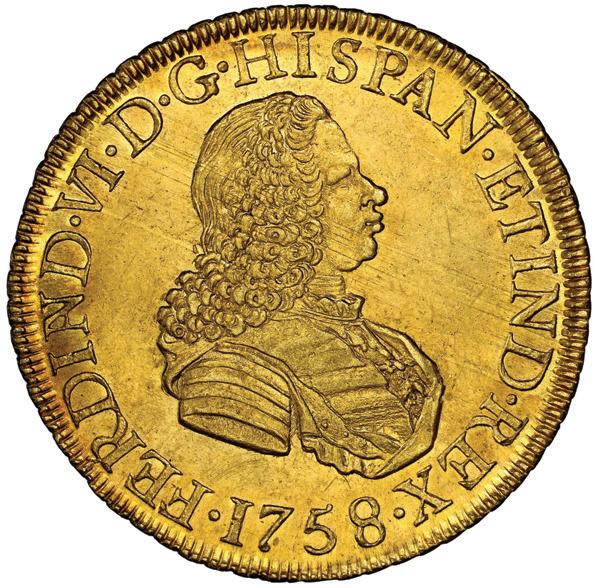

1020. Lima, Peru, bust 8 escudos, Ferdinand VI, 1758 JP, NGC MS 63, ex-Karon, ex-Segarra. Cal-774; KM-59.2. Choice strike and rims, rich gold color, with almost prooflike luster and only the faintest of adjustment marks on the bust, a well-pedigreed coin, among the very finest examples of the type, second finest in the NGC census behind a single MS 63+. Pedigreed to the Paul Karon Collection of 8 Escudos (Superior auction of December 1992, lot 9), previously acquired by Fernando Segarra (Madrid) by private treaty, both stated on the label. NGC #6475661-007. Estimate: $10,000-$15,000.


1021. Lima, Peru, gold bust 8 escudos, Charles III, 1765 JM, “rat nose” type, NGC AU 58, finest known in NGC census. Cal-1918; KM-70. Fully detailed strike in light yellow gold with ample luster, some tiny marks and light hairlines, rims a bit thin (as made), desirable first issue of Charles III with regrettably accurate portrait displaying a rat-like nose, somewhat scarce as a type but quite rare in this grade. NGC #6358993-002. Estimate: $3,500-$5,000.
1022. Lima, Peru, gold bust 8 escudos, Charles III, 1780
MI, NGC AU 58. Cal-1942; KM-82.1. Rich gold color with small red spots, muted luster, nice strike but with flan flaw in front of face. NGC #6469744-005. Estimate: $2,000-$3,000.

1023. Lima, Peru, gold bust 8 escudos, Charles IV, 1807 JP, NGC MS 62 (“top pop”), ex-Karon. Cal-1614; KM-101. Rather strong luster for the type, with fully detailed strike, the obverse fields perhaps slightly hairlined but hardly detracting from the atypical beauty of this coin, tied with two others for finest known in the current NGC census. Pedigreed to the Paul Karon Collection of 8 Escudos (Superior auction of December 1992, lot 41), stated on the label. NGC #6475661-008. Estimate: $10,000-$15,000.


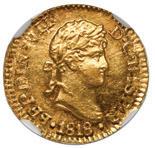


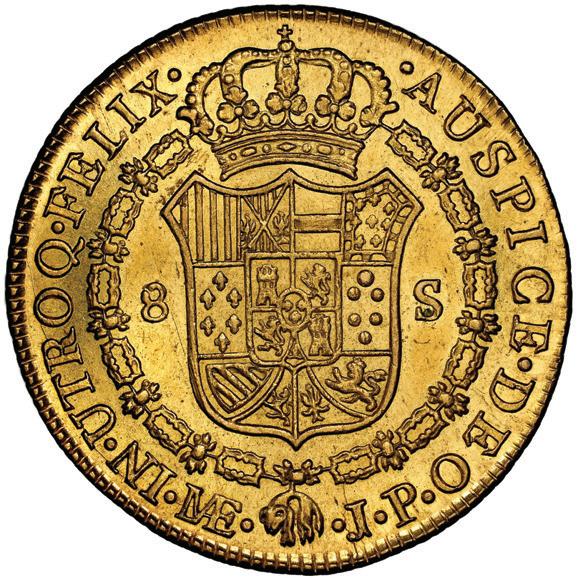


1024. Lima, Peru, gold bust 8 escudos, Ferdinand VII tran sitional (“imaginary” bust), 1808 JP, NGC AU 53. Cal-1753; KM-107. Deeply purple-toned against bold details, with minor natural flaw in cheek and obvious light wear, desirable transitional type. NGC #2885627-001. Estimate: $1,500-$2,250.
1026. Lima, Peru, pillar 8 reales, Ferdinand VI, 1753 J, dots over both mintmarks, NGC AU 53. Yonaka-L8.53; Cal-455; KM-55.1. Lightly toned with underlying luster, minor high-point wear but overall rather pretty for the assigned grade. NGC #6610679-001. Estimate: $500-$750.


1025. Lima, Peru, gold bust 1/2 escudo, Ferdinand VII, 1818 JP, NGC MS 62 (“top pop”). Cal-1481; KM-125. Superb luster and strike, with full obverse rim, partially straight edge at bottom (as made), tied with one other for finest in the current NGC census. NGC #6358993-001. Estimate: $700-$1,000.
1027. Lima, Peru, bust 8 reales, Charles III, 1784 MI, NGC AU 55. Cal-1053; KM-78. Good luster for the grade, with light golden toning, but some light wear and hairlines, also minor lamination flaw on reverse, right next to a squiggly struck-through fiber. NGC #4428703-011. Estimate: $200-$300.

1028. Lima, Peru, bust 8 reales, Ferdinand VII transitional (“imaginary” bust), 1811 JP, long ribbons, NGC MS 61. Cal-1242; KM-106.2. Attractively lustrous with very light gold toning, fully detailed bust but weak in center of reverse, incomplete rims, faint surface hairlines, scarce and desirable type. NGC #6451438-001. Estimate: $400-$600.

1032. Lima, Peru, 1/4 real, 1818, PCGS MS 64. Cal-269; KM-108. Choice details despite slightly off-center strike, light purplish blue toning over muted luster, tied with one other for finest in current PCGS census. PCGS #29207109. Estimate: $200-$300.
1029. Lima, Peru, bust 8 reales, Ferdinand VII 1820 JP, NGC MS 63. Cal-1074; KM-117.1. Frosty with luster and mostly full details (weak in parts of legends), incipient rainbow toning. NGC #5985270-004. Estimate: $300-$450.
1033. Cuzco, Peru, gold 8 escudos, 1831 G, NGC MS 61. KM-148.2. Bold strike with full details and rims and much luster, rich gold color all over, light hairlines in obverse fields. NGC #6475661009. Estimate: $2,000-$3,000.
1030. Lima, Peru, bust 4 reales, Ferdinand VII (imaginary bust), 1811 JP, rare. Cal-1064; KM-105.2. Bold AU- details with very deep, rich, uneven rainbow toning, parts of rims slightly crude, a few areas of light surface corrosion. Estimate: $300-$450.

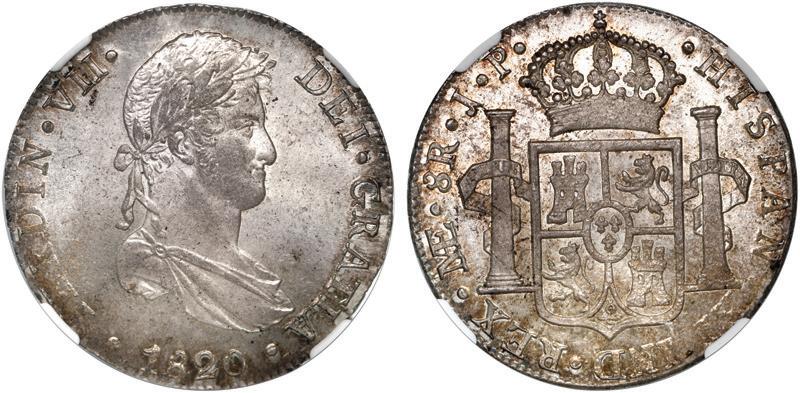

1034. Cuzco, Peru, 8 reales, 1833 BoAr, NGC AU 58. KM142.4. Choice strike and rims with light toning around details, much luster for the grade (old label), light surface hairlines in obverse fields. NGC #1754623-015. Estimate: $200-$300.

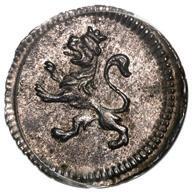



1031. Lima, Peru, bust 2 reales, Ferdinand VII, 1820 JP, NGC MS 64. Cal-820; KM-115.1. Choice broad flan with strong luster, bold details but with some evidence of rusty dies, rare grade, second finest in current NGC census behind a single MS 65. NGC #4489254014. Estimate: $300-$450.

1035. Cuzco, Peru (State of South Peru), gold 8 escudos, 1837 BA, FEDERACION, raised edge-lettering, rare, NGC AU 53, ex-Farouk. KM-167; Fr-91. Some of the most beautifully designed coinage of South America can be found in the issues of the three-year entity known as South Peru. These coins display a conscious effort (some would even say overkill) to combine Peru’s rich cultural and political symbols all in one place. The present coin, with earlier legend ESTADO SUD PERUANO on the obverse along with four stars representing the four constituent departments of South Peru (Ayacucho, Cuzco, Arequipa and Puno) above a sunface-topped flag presentation, features on the reverse a volcano on the right and the Inca fortress Qorikancha on the left, with a galleon on waves at top in between and a horn of plenty at bottom above the word FEDERACION. All of these elements are clear against a lustrous background, with just a few typical flaws near the rims. But perhaps its best feature is its pedigree, which puts it in the company of some of the greatest coins of the 19th century. Pedigreed to the King Farouk Collection (Sotheby’s [London] auction of February-March 1954, lot 171). NGC #4495918-001. Estimate: $5,000-up.
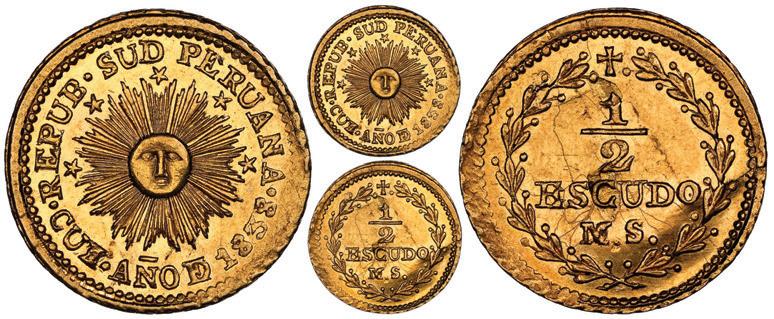

1036. Cuzco, Peru (Republic of South Peru), gold 1 escudo, 1838 MS, very rare, NGC MS 63+, ex-Garrett, ex-Goodman. KM-174; Fr-93. A spectacular piece, its artistic design limited to a sunface with five stars as from the newer REPUB. SUD PERUANA that added the Litoral Department (Tacna) to the previous four (see previous lot for comparison), with super-sharp rims and details all over, the fields thoroughly lustrous and nearly devoid of marks or hairlines, in fact second finest in the NGC census by a barely higher MS 64, with a stellar multiple pedigree. Pedigreed to the John Work Garrett Collection (Bank Leu / Numismatic Fine Arts auction of May 1984, lot 1333) and to the Irving Goodman Collection (Superior auction of June 1996, lot 1415), both stated on the label. NGC #6475661-004. Estimate: $6,000-$9,000.


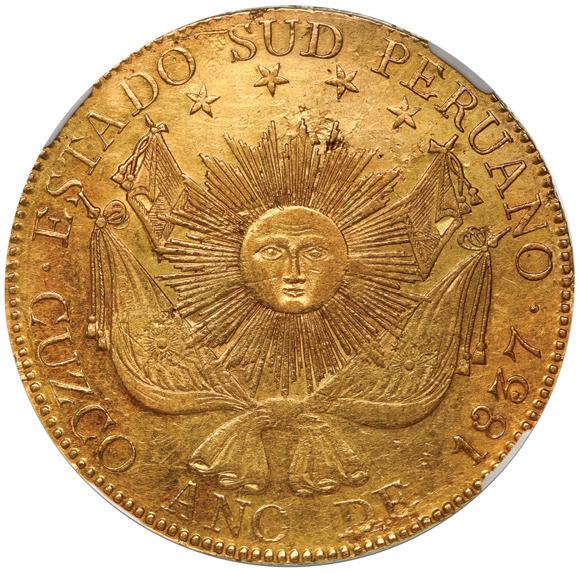
1037. Cuzco, Peru (Republic of South Peru), gold 1/2 escudo, 1838 MS, very rare, NGC MS 63. KM-173; Fr-94. The perfect companion-piece to the previous lot, as the design and quality are nearly identical, this one perhaps a hair bolder in strike and stronger in luster but with slightly cruder rim, also with fascinating strike-through error in center of reverse where debris (fibers and grease) were not removed from the die before striking. Pedigreed to the Biur Collection. NGC #6358937-001. Estimate: $4,000-$6,000.

1038. Cuzco, Peru (Republic of South Peru), 8 reales, 1837 BA, FEDERACION, incuse edge-lettering, NGC XF 45. KM-170.1. The symbolic artistry that characterizes this series is even more substantial on the silver, like we see here, with the volcano-Qorikancha motif encircled with a wreath and well toned for contrast, the sunface on the obverse with just rays (no flags) and on this issue topped with five stars as from the REPUB. SUD PERUANA (see the previous three lots) and with rosy-toned fields, traces of encrustation around details. NGC #3809000-020. Estimate: $200-$300.

1039. Cuzco, Peru (Republic of South Peru), 8 reales, 1838 MS, CONFEDERACION, NGC MS 61. KM-170.4. Nice luster with light ton ing, beautiful artistic-symbolic design (see previous four lots) rendered with full details and rims, in our opinion every bit of MS 62. NGC #6610679-003. Estimate: $2,000-$3,000.

1040. Lima, Peru (State of North Peru), gold 4 escudos, 1838 M, extremely rare, NGC AU 53, finest known in NGC census, ex-Hammel, ex-Goodman. KM-142.1. One of only three examples known and the finest known in private hands of this legendary rarity, once a highlight of the Latin American section of the famous Hammel Collection, whose cataloger described it as “a choice example of an extremely rare coin difficult to find in any condition. All the relevant sources simply say RARE” (still an accurate statement today). While it does have some light wear (as the assigned grade implies), the surfaces are lustrous and relatively free of marks, the reverse in particular showing a lovely red toning around the details, the finer of just two graded by NGC by three grades. It is a fitting finale for the illustrious-pedigreed suite of three-year South Peru-North Peru trophies in this auction (starting with lot 1035). Pedigreed to the Mortimer Hammel Collection (Stack’s auc tion of September 1982, lot 904) and to the Irving Goodman Collection (Superior auction of June 1996, lot 1412), both stated on the label. NGC #6475661-002. Estimate: $20,000-up.


1041. Lima, Peru, gold 20 soles, 1863 YB, NGC MS 61. KM-194. Scarce and desirable (almost) one-year type (see next lot) with choice luster, full details, light surface hairlines on Liberty side only. NGC #6476175-006. Estimate: $2,000-$3,000.
1042. Lima, Peru, gold 20 soles, 1869/3 YB, NGC AU 55. KM-unl (194 for type); Fr-unl (70 for type). Struck from identical dies as the 1863 in the previous lot but with the last digit over-punched with a 9 (traces of the 3 still visible), once believed to be an error, as stated in the only reference to mention it (La Amonedación En Oro De Las Cecas De Lima, Cuzco Y Potosí, by Pedro E. de la Puente Jeri [1994], “Error de cuño, es un ejemplar de 1863 con una falla que da la impresión que apareciera un 9 en vez de un 3”), but now known for certain to be a legitimate overdate and in fact represented by three pieces, the other two being an example permanently impounded in the Banco de Peru and an NGC MS 62 in private hands (previously sold as PCGS AU58, admittedly higher grade but with egregious flaws around the head of Liberty). (Note that NGC refers to both that coin and this one as 1863/9 for unknown reasons.) Further research shows that the Lima mint report (cuenta de hacienda) for 1869 mentions a small amount of gold minted (in addition to plenty of silver) but does not specify the denomination. The present example shows ample luster in a rich gold color, with minor bagmarks on both sides, an attractive piece and an incredible opportunity for the Peruvian specialist or trophy collector. NGC #6475661-010. Estimate: $20,000-$30,000.



1043. Manila, Philippines (under Spain), 8 reales, 1828 countermark (Type I) on a Lima, Peru, 8 reales, 1826 JM, very rare. KM-33; Cal-1303. Typically weakly struck XF, one side with MANILA above date and lined border design only partially covering the host’s legend (that side possibly lightly cleaned), the other side with bolder crowned arms and less border but with (parts of) legend HABILITADO POR EL REY N.S.D. FERN. VII., also with more host details visible, including mintmark, denomination, assayer and date, that side also darker in tone, rather nice overall for this highly sought first crown-sized issue of the Philippines. It is worth noting that it was the lack of minting pressure and subsequent failure of the border design to efface the peripheral host details that this Type I striking was discontinued early on, which is why it is so rare. With NGC tag XF details / cleaned. Estimate: $5,000-up.

1044. Philippines (under Spain), 8 reales, Ferdinand VII, crowned “F.7.o” countermark (Type V, 1832-4) on a Potosí, Bolivia, bust 8 reales, Charles III, 1773 JR, NGC VF details / chopmarked, graffiti, c/s XF standard. KM-47; Cal-1305. A nicely toned piece with numerous fascinating aspects, including a fully detailed and deeply impressed countermark OVER one of several chopmarks on the obverse, with some other chops on reverse including one that was flattened out by the countermark on the other side (the stated graffiti in fields probably Malay script from its time), plus the fact that the host date is first-of-issue, a unique and important numismatic item for Asian collectors. NGC #6472679-001. Estimate: $2,000-$3,000.


1045. Philippines (under Spain), 8 reales, Ferdinand VII, crowned “F.7.o” countermark (Type V, 1832-4) on an Argen tina (River Plate Provinces), 8 reales, 1813 J, Potosí mint, rare, NGC VF 20, c/s VF standard, ex-Derman, ex-Pomato. KM-44.1; Cal-1305. Bold full countermark placed just east of the central sun design (ostensibly the same diameter) on a fully detailed host that displays evidence of a slightly shifted double-strike in the legends (very rare for this type), nicely toned but with some small dark spots near rims (a bit weak, as made), second finest of just two in the NGC census, desirable Argentine pedigree. Pedigreed to the Mario Pomato Collection and to the Alberto “Coco” Derman Collection (Cayón auction of Decem ber 2007, lot 179). NGC #6610345-011. Estimate: $2,000-$3,000.
1046. Philippines (under Spain), 8 reales, Ferdinand VII, crowned “F.7.o” countermark (Type V, 1832-34) on a Lima, Peru, 8 reales, 1831 MM. KM-83; Cal-1305. 27.14 grams. Choice full countermark (AU) on richly toned XF host that bears unusually substantial luster on the fields, well struck with nice rims. Estimate: $400-$600.

1047. Philippines (under Spain), 8 reales, Ferdinand VII, crowned “F.7.o” countermark (Type V, 1832-4) on a Lima, Peru, 8 reales, 1832 MM, NGC VF 30, c/s VF strong. KM-83; Cal1305. Full countermark and full host details nicely set off by dark, con trasting toning all over. NGC #6610345-012. Estimate: $400-$600.

1048. Philippines (under Spain), 8 reales, Isabel II, crowned “Y.II” countermark (Type VI, 1834-37) on an Argentina (River Plate Provinces), 8 soles, 1815 FL, Potosí mint, very rare, NGC AU 53, c/s AU standard. KM-94; Cal-668. Choice bold countermark and spectacular grade, with light toning over muted luster, clear denomination (but misattributed as 8 reales by NGC, hence its “top pop” status cannot be 100% confirmed), first we have offered of this type and only the second one we have seen, the 8R host being more common. NGC #6472679-002. Estimate: $3,000-$4,500.

1049. Philippines (under Spain), 8 reales, Isabel II, crowned “Y.II” countermark (Type VI, 1834-7) on an Argentina (River Plate Provinces), 8 soles, 1826 F, La Rioja mint, NGC XF details / cleaned, c/s AU strong, ex-Pomato. KM-95; Cal-668. Very bold countermark and host details, with light contrasting toning and strong strike all over, very attractive for this scarce and desirable hosttype, the countermark desirably applied precisely over the sunface (same diameter), as if it were designed specifically for this host! Pedigreed to the Mario Pomato Collection and to the Cayón auction of December 2008 (lot 3046). NGC #6610345-013. Estimate: $700-$1,000.
1050. Philippines (under Spain), 8 reales, Isabel II, crowned “Y.II” countermark (Type VI, 1834-37) on a Mexico City, Mexico, cap-and-rays 8 reales, 1834 ML, NGC AU details / cleaned, c/s AU strong. KM-unl; Cal-668. Bold full countermark and host details, all richly toned over muted luster, this host-type very scarce and in fact unlisted in KM. NGC #6477139-002. Estimate: $800-$1,200.
1051. Philippines (under Spain), gold 4 pesos, 1863, NGC AU 58. KM-144; Cal-856. Lustrous and only moderately bagmarked, popular issue that ran alongside an equivalent 100-reales issue in Spain proper. NGC #5985742-004. Estimate: $700-$1,000.

1052. Philippines (under Spain), 10 centavos, Alfonso XII, 1885, NGC MS 66+. KM-148; Cal-102.


Superb luster and strike, no marks or wear, with lovely toning around rims, frozen date (struck 1885-98, i.e., well into the reign of Alfonso XIII), tied with two others for second finest known in the NGC census behind a single MS 67. (Note: KM and many catalogers refer to this issue as 10 centimos in error.) NGC #6443583-004. Estimate: $200-$300.
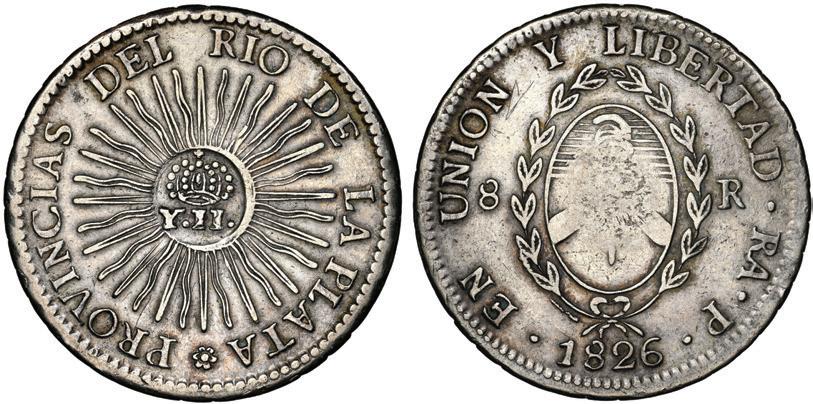
1053. Philippines (under Spain), 1 peso, Alfonso XIII, 1897 SG-V, NGC MS 62. KM-154; Cal-122. Nice luster, faintly toned, minimal bagmarks, popular one-year type. NGC #6476175-005. Estimate: $2,000-$3,000.
1054. Puerto Rico (under Spain), 1 peso, Alfonso XIII, 1895 PG-V, PCGS MS63. KM-24; Cal-128. Splashy rainbow toning over strong luster, minimal bagmarks, very popular one-year type sought by U.S. and Spanish buyers alike. PCGS #06626150. Estimate: $3,000-$4,500.

1055. Puerto Rico (under Spain), 5 centavos, Alfonso XIII, 1896 PG-V, NGC MS 66 (“top pop”). KM-20; Cal-124. Blast white and blazingly lustrous, virtually no bagmarks, top grade among well over 200 total entries at NGC. NGC #5979506-005. Estimate: $800-$1,200.
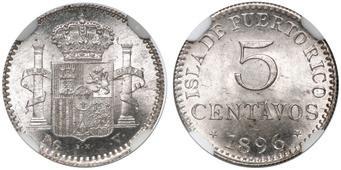
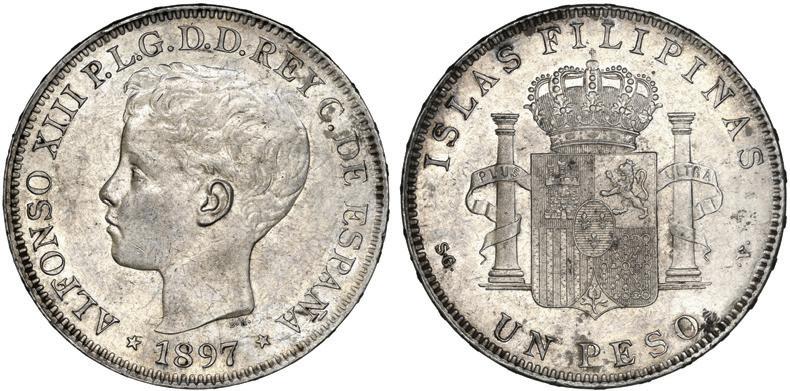

1056. Russia (Moscow mint), 1 rouble, Peter I (“the Great”), 1723 OK, small cross on chest, continuous obverse legend with rosettes, PCGS XF detail / repaired. Bitkin-884; KM-162.3; Dav-1658. Unevenly toned obverse with old digs behind head, minor repair at one o’clock on obverse rim, the reverse somewhat lustrous, a scarce and desirable type that comes in several varieties. Pedigreed to a banker’s collection from the early 1900s. PCGS #44782641. Estimate: $1,000-$1,500.

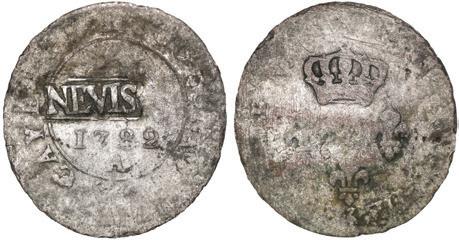
1057. Russia (St Petersburg mint), 50 kopecks, Nicholas II, 1914 (BC), NGC MS 63. Bitkin-94; KM-Y58.2. Lightly toned over ample luster, a few tiny rim-bumps but practically no bagmarks. NGC #6611408-003. Estimate: $200-$300.
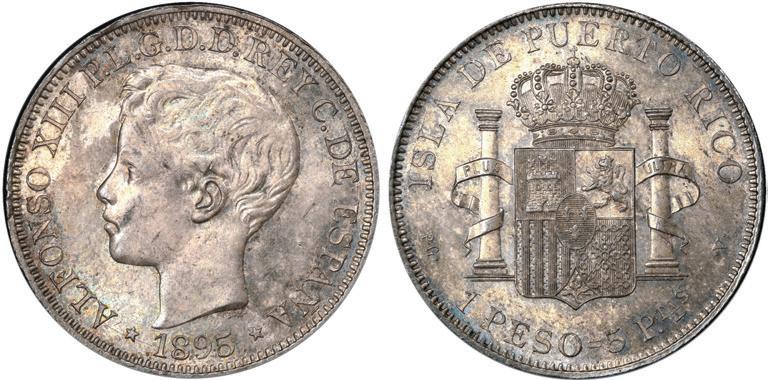
1058. Nevis, black dogg (three halfpence), rectangular countermark NEVIS on a genuine Cayenne 2 sous 1782-A, rare. Prd-5; KM-1. 1.57 grams. Choice full XF countermark above 1782 date and A mintmark on genuine but well-worn host (XRF tested at 62.98% silver and 36.12% copper), also with CAYENNE mostly visible, a rare and desirable issue that commands a premium for the host date (most seen are 1789, if visible at all), the formerly French island of Nevis somewhat famous for being the birthplace of Alexander Hamilton. Estimate: $800-$1,200.
1059. South Africa (under Great Britain), gold sovereign, George V, 1927, NGC MS 63. Sp-4004; KM-21. Rich gold color, minimal bagmarks on very slightly grainy surfaces (as made) resulting in muted luster. NGC #2740779-006. Estimate: $400-$600.

1060. Southern Rho desia, 2 shillings, 1944, NGC MS 62. KM-19a. Very light rain bow toning over muted luster with a few bag marks, choice grade, currently tied with two others for second finest in NGC census behind a single MS 63. NGC #4740391-005. Estimate: $200-$300.
1061. Seville, Spain (Castile and León), gold dobla of 35 maravedís, Pedro I (“the Cruel,” 1350-1369), P below lion, NGC MS 65-star, finest known in NGC census. Cay-1280; Fr-108. 4.54 grams. Incredibly sharp and well-preserved details justifying the extreme high grade and “star” designation for choiceness, with full legends and in rich gold color, scarcer type with P below the lion, the sole finest of eight in the current NGC census (also superior to any of the earlier bust type). NGC #6476175-004. Estimate: $5,000-$7,500.


1062. Seville, Spain (Castile and León), 1 real of 3 maravedís, Enrique II (136979), NGC AU 58. Cay-1313. 3.46 grams. Choice full details (well struck) with deep, rich and even toning, practically no wear but somewhat low in luster, second finest in NGC census behind a single MS 62. NGC #6289983-003. Estimate: $200-$300.


1063. Seville, Spain (Castile and León), 1 real, Enrique III (1390-1406), S and three stars around cross, NGC MS 64. Cay-1489. 3.46 grams. Broad flan with bold full details, bright white as nearly pristine and non-toned. NGC #6289980-005. Estimate: $400$600.

1064. Seville, Spain (special issue struck for the Americas), 1 real, Ferdinand-Isabel, three dots vertically flanking shield, mintmark S on reverse, arrows to left of crowned F, very rare, NGC XF details / damaged. Lopez de la Fuente-F8.5; Cal-443. 3.36 grams. Broad flan with full legends, nicely toned, with light scuff on obverse and heavier scratches on reverse (all old), desirable type. Before coins were made in the New World, Ferdinand and Isabel attempted several importations of coins from Spain, starting with this special issue with a crowned F inserted between the yoke and arrows on reverse. NGC #6476148-001. Estimate: $1,250-$2,000.
1065. Segovia, Spain, gold 4 excelentes, Ferdinand-Isabel, mintmark at top, denomination Arabic 4 above K at bottom be tween busts, rare, NGC AU 53. Cal-772; Fr-125. 13.93 grams. Impressively broad flan with well-detailed facing portraits, choice full crowned shield, nearly full legends in Latin lettering (later variety), rich gold color with light high-point wear and hairlines on obverse, a rare and desirable type, second finest in NGC census behind a single AU 55 (with one higher at MS62 at PCGS). NGC #6476175002. Estimate: $8,000-$12,000.
1066. Seville, Spain, 8 reales, Ferdinand-Isabel, S to left, denomination o-VIII to right, assayer Gothic D on reverse between yoke and arrows, legends ending in DEI and ARA, NGC AU 55. Lopez de la Fuente-I5.1.31; Cal-577. 27.21 grams. Broad, round flan with choice full legends and inner details, deeply toned (low contrast) with hints of red and blue, desir able first “crown” of Spain. NGC #6445262-002. Estimate: $1,000-$1,500.



1067. Seville, Spain, cob 4 reales, Ferdinand-Isabel, mintmark S to left, denomination o-IIII to right, assayer Gothic D on reverse, NGC MS 61. Lopez de la Fuente-H5.6.26; Cal-564. 13.92 grams Sharply detailed centers and most of legends, rather lustrous (especially on the reverse) with small spots of light toning, no wear. NGC #5911099-013. Estimate: $500-$750.
1068. Burgos, Spain, 1 real, Ferdinand-Isabel, mintmark B on reverse with as sayer X to left of cross potent in legend, NGC XF 40. Lopez de la Fuente-F1.6.1.12; Cal-317. 3.23 grams. Deeply toned and fully detailed, including legends, the high points evenly worn. NGC #5845924-005. Estimate: $200-$300.
1069. Seville, Spain, 1/4 real, Ferdinand-Isabel, assayer o below mintmark S below yoke, rare, NGC VF 25, ex-Huntington. Lopez de la Fuente-D6.1; Cal-172. Broad flan with 100% full legends (Gothic) and inner details, with deep rich toning and honest even wear, rare denomination, desirable pedigree. Pedigreed to the A.M. Huntington Collection (stated on label). NGC #3843095015. Estimate: $1,000-$1,500.
1070. Mallorca, Spain, gold 1 ducat, Charles I (1516-56), stars flanking bust, assayer not visible, NGC XF 45, finest and only example in NGC census. Cal-108; Fr-54. 3.36 grams. Bold portrait of king, full but off-center shield enabling a full MAIORICARVM in legend before an unclear assayer-mark (supposedly a small shield with crescents), nicely toned around the details, overall a rather decent example of this rarely seen type from the island of Mallorca. NGC #6281272-014. Estimate: $2,000-$3,000. 1071. Gerona, Spain, billon dinero, Charles I (1516-56), right-facing bust, mintmark G above shield, NGC AU 58, finest and only example in NGC census. Cal-6. 0.79 gram. Oblong flan with bold central design (bust and shield) highlighted with nice luster, the legends cruder and darker, listed in references as a copper issue but XRF tests indicate 15% silver. NGC #6213213-011. Estimate: $200-$300.

1072. Seville, Spain, cob 8 reales, 1590 date to right, assayer Gothic D below denomination o-VIII and mintmark S to left, NGC MS 62. Cal-728. 27.23 grams Choice full cross-lions-castles, the shield also full and well-detailed but slightly doubled, full date and mintmark and assayer, some legend on a broad flan with very light toning over muted luster, second finest in current NGC census behind a single MS 63. NGC #6445262-001. Estimate: $600-$900.

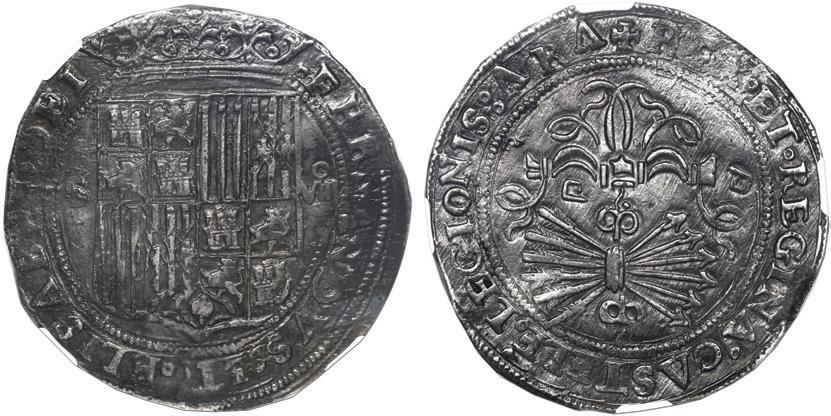
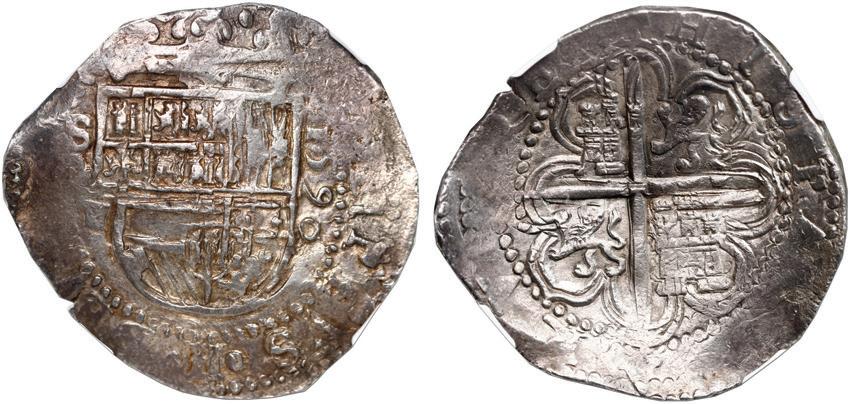
1073. Seville, Spain, cob 8 reales, 1593/2 date to right, assayer B below denomination o-VIII and mintmark S to left. Cal-737. 27.52 grams. Super full cross and shield, the latter with bold full S-oVIII-B to left and 1593 date to right (the 3/2 rather weak), lightly toned AU with traces of surface corrosion on reverse. Estimate: $200-$300.
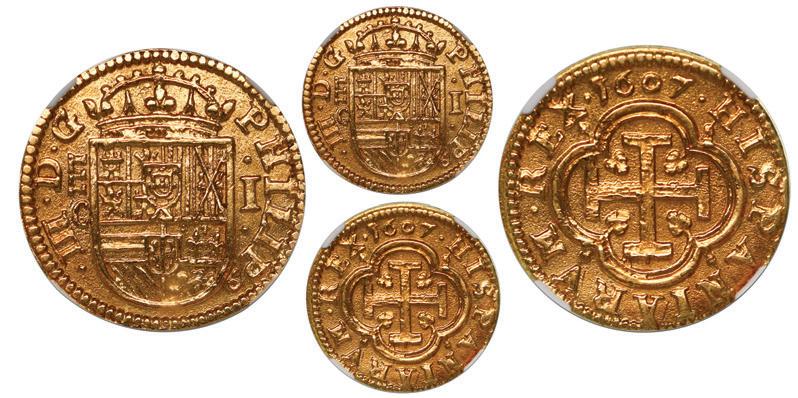
1074. Seville, Spain, cob 4 reales, Philip II, fleur above shield, assayer Gothic D at four o’clock outside tressure on reverse, NGC MS 61. Cal-576. 13.62 grams. Excellent full crown, shield and cross-lions-castles, full mintmark and bold full denomi nation and assayer (which appears to be a squared C, as is seen on some 8 reales but is unlisted in this denomination), nearly full legends, attractively toned. NGC #6213267002. Estimate: $350-$500.
1075. Segovia, Spain, gold milled 1 escudo, Philip III, 1607 C, king’s name as PHILIP, NGC MS 65. Cal-1015; KM-29. Scarce and desirable first milled gold of Spain (second variety with 9-shaped ornament after abbreviated king’s name), with razor-sharp and pristine details, muted luster on unblemished fields, second highest grade in NGC census behind a pair of MS 66’s. NGC #6323076-013. Estimate: $4,000-$6,000.
1076. Seville, Spain, cob 8 reales, 1622 D, NGC AU 58, finest known in NGC census. Cal-1631; KM-80. Bold full cross-lions-castles with full date above, nearly full but doubled shield with S-D to left above full king’s ordinal IIII, much peripheral flatness with small edge-crack, lightly toned, currently the finest of four in the NGC census. NGC #6212890-019. Estimate: $300-$450.


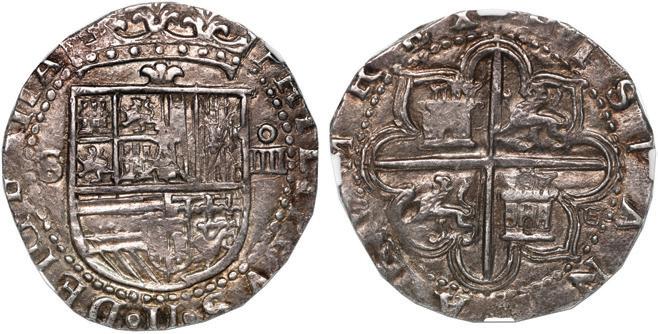

1077. Seville, Spain, cob 8 reales, 1633 R. Cal-1646; KM-80. 26.65 grams. Good full shield with clear •S-R• to left, full cross-lions-castles with bottom parts of all four digits of date above, XF with toning in crevices, large edge-crack. Estimate: $250-$375.
1078. Barcelona, Spain, 5 sueldos (revolutionary issue), 1641, NGC MS 62, finest and only example in NGC census. KM-17. 5.63 grams. Boldly struck and deeply rainbow toned, with full and clear date outside of full cross and V-S flanking full crowned shield, one edge-crack, choice grade (possibly finest known), interesting and desirable type struck during a revolt by the Duke of Olivares over taxation by the crown, scarce one-year issue struck in the name of the Spanish king Philip IV prior to a new type with bust of the French king Louis XIII under his protectorate. NGC #6213215-012. Estimate: $1,000-$1,500.

1079. Segovia, Spain, milled 4 reales, Charles II, 1683 BR, three-arch aqueduct, dots at mintmark, NGC MS 65, ex-Moore. Cal-558; KM-200. Oversized flan with incredibly sharp details draped in deep rainbow toning with much underlying luster, virtually as struck but with several small die-cracks (late die-state), very rare grade, second finest in current NGC census behind a single MS 66. Pedigreed to the D. Moore Collection (stated on label). NGC #2062762-050. Estimate: $1,000-$1,500.

1080. Seville, Spain, gold milled 8 escudos, Philip V, 1701 M, florets flanking fleece, 8-S-8-M in tressure-dimples, NGC MS 65, finest known in NGC census. Cal-2267; KM-260. Fully detailed strike (evenly impressed, perhaps just a hair weak in centers) with superb luster, incomplete rims (slightly off-center), bright yellow color, gem quality that is about as original as you can get for this type, desirable first date that is variety-rich, this being the finest in the NGC census for all the varieties. NGC #6440465-001. Estimate: $20,000-$30,000.

1081. Seville, Spain, gold milled 8 escudos, Philip V, 1703 J, 8-S-8-J in tressure-dimples, NGC AU 58, finest known in NGC census. Cal-2270; KM-260. Bold and well-centered strike with rich red toning all over, light wear and no luster, finest in the NGC census for this variety. NGC #2131204-001. Estimate: $6,000-$9,000.
1082. Seville, Spain, gold milled 8 escudos, Philip V, 1723 J, NGC XF details / removed from jewelry. Cal-2296; KM-315. Rare and desirable type with nice full details, albeit with polished surfaces and some small marks, slightly off-center obverse, traces of die-clashing on reverse. NGC #6611408-001. Estimate: $3,000-$4,500.


1083. Seville, Spain, gold bust 1/2 escudo, Philip V, 1742 PJ, NGC MS 62. Cal-1644; KM-361.2. Tremendous luster and choice full details, slight flan-bulge in center of reverse, impressively flashy, second finest in NGC census behind a single MS 64. NGC #6445275-009. Estimate: $400-$600. 1084. Seville, Spain, gold bust 1/2 escudo, Philip V (third bust), 1744 PJ, NGC MS 62. Cal-1649; KM-361.2. Nice luster with hint of reddish toning, fully detailed strike (centers slightly soft), listed as “top pop” in NGC census but technically tied for second finest behind another example under a different listing (the varieties for this date being second or third bust, not with or without rosettes in legend). NGC #6445270-004. Estimate: $400-$600. 1085. Seville, Spain, milled 2 reales, Philip V, 1734 PA, NGC MS 64, finest known in NGC census. Cal-990; KM-355. Near-mirror luster with prooflike details, light toning, one long adjustment mark on reverse but otherwise as close to perfect as you can get for this lower-weight type known as “pistareen.” NGC #5927544-001. Estimate: $300-$450.
1086. Madrid, Spain, gold bust 1/2 es cudo, Ferdinand VI, 1754 JB, NGC AU 55. Cal-557; KM-378. Nice strike with smooth fields (but not lustrous), toned around details. NGC #4835107-001. Estimate: $200-$300.
1088. Madrid, Spain, gold bust 4 escudos, Charles III, 1780/79 PJ, NGC AU 58. Cal-1783; KM-418.1. Strong luster and choice strike, the bust particularly sharp (fully detailed), with practically no wear but with faint surface hairlines on obverse. NGC #6289380008. Estimate: $900-$1,350.
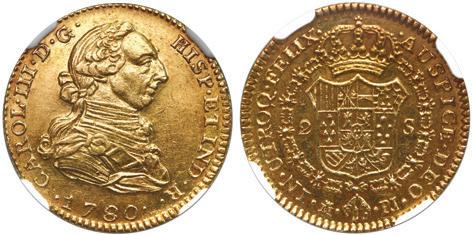



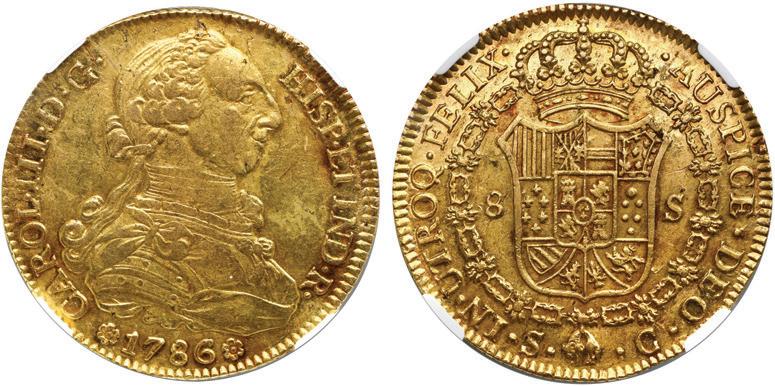
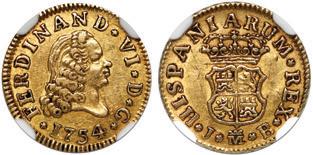



1089. Madrid, Spain, gold bust 4 escudos, Charles III, 1786 DV, PCGS AU58. Cal-1791; KM-418.1a. Fully detailed strike with rich color, muted luster, faint hairlines in obverse fields. PCGS #83559564. Estimate: $900-$1,350.
1087. Seville, Spain, gold bust 8 escudos, Charles III, 1786 C, NGC AU 55. Cal-2191; KM-409.2a. Flashy luster in legends and on reverse, the bust with high-point wear, minor marks and flaws in fields, full rims. NGC #6469748-003. Estimate: $2,000-$3,000.
1090. Madrid, Spain, gold bust 2 escudos, Charles III, 1773 PJ, PCGS MS61, finest known in PCGS census. Cal-1544; KM-417.1. Incredibly flashy with luster and razor-sharp details, almost prooflike, surely MS63 on a better day but probably downgraded for some wispy hairlines in front of face, finest at PCGS in any case, exceeded only by a (no doubt comparable) MS 63 at NGC. PCGS #45458838. Estimate: $700-$1,000.
1091. Madrid, Spain, gold bust 2 escudos, Charles III, 1780 PJ, NGC MS 60, finest known in NGC census. Cal-1558; KM417.1. Bold strike with satin-smooth reverse field, the obverse fields lightly hairlined but with luster in legend, traces of red toning here and there. NGC #2879520-002. Estimate: $700-$1,000.
1092. Madrid, Spain, gold bust 2 escudos, Charles III, 1788/78 M/PJ, NGC AU 58. Cal-1573; KM-unl (417.1a for type). Nice luster (especially on reverse), choice full rims, high-point wear on bust only, bits of black encrustation in crevices of shield, the overdate clear but the over-assayer harder to discern, second finest in NGC census behind a single MS 62. NGC #6447372-002. Estimate: $300-$450. 1093. Madrid, Spain, gold bust 1 escudo, Charles III, 1787/6 DV, NGC AU 58. Cal-1369; KM-416.1a. Bold strike with reddish toning, minimal luster, fairly clear overdate (not noted by NGC). NGC #4377356-006. Estimate: $250-$375.



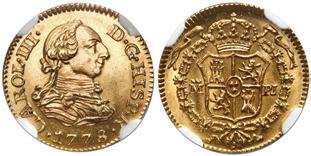



1094. Madrid, Spain, gold bust 1/2 escudo, Charles III, 1759 JP, NGC MS 63, finest known in NGC census. Cal-1241; KM-389.1. Very bold strike with strong luster, light yellow color, adjustment marks on shield, first date of “rat nose” type. NGC #6446167-003. Estimate: $500-$750. 1095. Madrid, Spain, gold bust 1/2 escudo, Charles III, 1772 PJ, NGC MS 62+. Cal-1256; KM-415.1. Nice strike with ample luster, first date of new type with a more flat tering rendering of the king’s profile. NGC #2127605-011. Estimate: $400-$600. 1096. Madrid, Spain, gold bust 1/2 es cudo, Charles III, 1778 PJ, NGC MS 64. Cal-1267; KM-415.1. Perfect strike and surfaces, without even a trace of marks or wear, one of three at this second highest grade in the NGC census. NGC #6446167-002. Estimate: $500-$750.

1097. Barcelona, Spain, gold 80 reales, Isabel II, 1846 PS, NGC MS 63. Cal-715; KM-578.1. Brightly lustrous on satin-smooth surfaces, tied with one other for second finest behind a single MS 64 in the current NGC census. NGC #2127605-009. Estimate: $300-$450.

1098. Barcelona, Spain, gold 40 reales, Isabel II, 1863, NGC MS 63, finest known in NGC census. Cal-677; KM-618.1. Satin-smooth surfaces with brilliant cartwheel luster, absolutely lovely and well deserving of its finest-known status, one-year type with bannerless arms. NGC #6449240-006. Estimate: $300-$450. 1099. Madrid, Spain, gold 40 reales, Isabel II, 1864, NGC MS 62. Cal-678; KM-618.1. Choice strike and brilliant luster, with trivial bagmarks only, bright gold color. NGC #6449240-007. Estimate: $200-$300. 1100. Jubia, Spain, copper 2 maravedís, Isabel II, 1844, NGC MS 61 Brown, finest and only example in NGC census. Cal-41; KM-532.2. Bold strike, somewhat dark but with traces of colorful luster around details, choice grade. NGC #6611408-008. Estimate: $300-$450.
1101. Madrid, Spain, 1 peseta, 1869 SN-M, GOBIERNO PROVISIONAL, NGC MS 63. Cal-16; KM-652. Flashy luster, start ing to tone at rims, minimal bagmarks only, first type with GOBI ERNO PROVISIONAL instead of ESPANA at top of obverse. NGC #6610681-004. Estimate: $200-$300.

1102. Madrid, Spain, gold 25 pesetas, Alfonso XII, 1877(77) DE-M, second 7 appearing as a 5 in right-hand star, NGC MS 66. Cal-69; KM-673. Satin surfaces with prominent die-polish lines, much luster, near top grade but star variety not noted by NGC. NGC #5783025-007. Estimate: $300-$450.
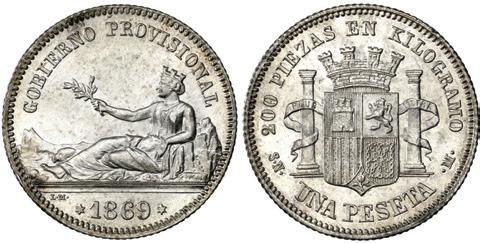
1103. Madrid, Spain, gold 25 pesetas, Alfonso XII, 1878(78) EM-M, NGC MS 63. Cal-71; KM-673. Rich gold color with strong luster and bold strike (almost prooflike), minimal tiny bagmarks. NGC #6454905-010. Estimate: $250-$375.
1106. Madrid, Spain, gold 25 pesetas, Alfonso XII, 1881(81) MS-M, bust with beard, NGC MS 65. Cal-82; KM-687. Nearpristine surfaces with nice, soft luster, first date of new bust with sideburns, second highest grade in NGC census. NGC #5783028-009. Estimate: $400-$600.

1104. Madrid, Spain, gold 25 pesetas, Alfonso XII, 1879(79) EM-M, NGC MS 66. Cal-74; KM-673. Strongly lustrous and rich in color, also perfectly struck, with practically pristine surfaces, currently tied with two others for second finest in the NGC census behind a single MS 67. NGC #6454914-006. Estimate: $300-$450.


1105. Madrid, Spain, gold 25 pesetas, Alfonso XII, 1880(80) MS-M, PCGS MS64 Prooflike, finest known in PCGS census. Cal-79; KM-673. With deeply mirrored fields and nearly frosted details (and only trivial tiny bagmarks), this is the sole example of this date designated as Prooflike by PCGS (with none so designated at NGC, whose highest grade is MS 66). PCGS #37176026. Estimate: $400$600.
Sweden
1107. Madrid, Spain, gold reverse proof 1.5 euros (1 oz), 2021, Iberian lynx, NGC Reverse PF 70 (‘top pop”). KM-unl.

With an actual gold weight of 0.9999 troy oz, this is a new product from the Madrid Mint, showcasing its ability to craft perfect specimens, the reverse-proof effect (frosted fields, mirror details) quite eye-catching, intentionally oriented in the NGC holder so that the pillar-dollar de sign so familiar to Spanish colonial collectors is front and center, the other side displaying the head of an Iberian Lynx. NGC #6447375-002. Estimate: $1,250-$2,000.
1108. Sweden, riksdaler, Adolf Fredrik, 1753 HM, F under bust, rare, PCGS AU detail / cleaned. KM-464.1; Dav-1731. Vivid

peacock toning on obverse only, tiny nicks on both sides but no big damage, scarce and popular Scandinavian crown. Pedigreed to a banker’s collection from the early 1900s. PCGS #44782640. Estimate: $750-$1,100.
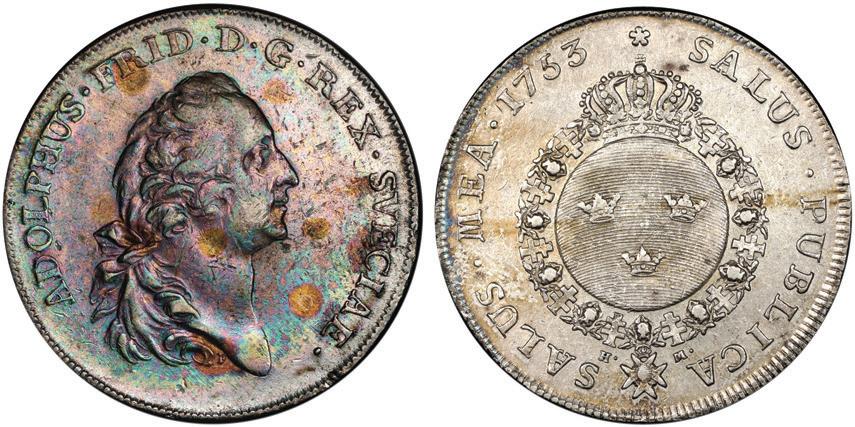
1109. Caracas, Venezuela, “imitation cob” 2 reales, date “184” (early 1800s), NGC AU details / reverse scratched. Cal-747; KM-C13.1; Stohr-9. 5.00 grams. Large choice planchet with most details visible including full pillars-and-waves and cross-lions-castles (transposed quadrants), all three M’s and L’s in the “mintmark” and “assayer” positions, respectively (relative to colonial cobs), lightly toned over traces of muted luster. NGC #6478033-003. Estimate: $300-$450.
1110. Caracas, Venezuela, 4 reales, Ferdinand VII, 1819 BS, castles and lions in proper quadrants, very rare, NGC XF 40. Cal-1027; KM-C7.2; Stohr-12. 10.22 grams. All details full except for rims, with light even toning all over, very rare and highly sought type known as a “toston,” usually found holed or at least damaged (which this is not), and made in small numbers, this example in fact second finest in the current NGC census behind a single AU 58. NGC #6476307-001. Estimate: $3,000-$4,500.
1111. Caracas, Venezuela, 2 reales, Ferdinand VII, 1818 BS, F-7 flanking cross, lions and castles transposed. Cal-729; KM-C6.1; Stohr-11. 5.44 grams. VF+ with choice strike, nice toning, a few minor marks and some porosity at rims but overall rather nice for this brief type. Estimate: $300-$450.
1112. Caracas, Venezuela, 2 reales, Ferdinand VII, 1820 BS, F-7 flanking cross, lions and castles in proper quadrants. Cal738; KM-C6.1; Stohr-11. 4.69 grams. Boldly struck VF+ with deep toning around details for excellent contrast, some odd bubbly porosity on pillars side, possibly lightly shaved on edge. Estimate: $300-$450.


1113. Maracaibo, Venezuela (now attributed to Cuba), 1 real, Ferdinand VII, (1813), very rare, NGC VF 35. Cal-598; KM-4.1 (under Santo Domingo). 2.26 grams Off-center bust with clear 7 to right, weaker F to left, unevenly struck but well-centered crowned shield (lions and castles transposed) with full R to right, deeply toned, with minor lamination and areas of flatness. The latest archival research by Luis Ponte, presented at the MMXXI Cartagena conference, has determined that this issue (traditionally attributed to Santo Domingo or Maracaibo, the former per KM and the latter per Calicó [as “incierta”] and NGC, along with related copper 1 and 2 cuartos) was actually made in Cuba. NGC #6454907-001. Estimate: $1,500-$2,250.



1114. Venezuela (struck at the Paris Mint by Barré), silver essai 1/2 real, 1863 E, extremely rare, NGC SP 61. KM-E3; StohrE23. A highly desirable and very important piece for Venezuelan numismatists, with deeply toned fields and legends outside of bright silver centers that make the bust of Páez (inside the legend CIUDADANO ESCLARECIDO) really stand out, strong die-polish lines on obverse (easily mistaken for hairlines), from an anachronistic series in Spanish reales. Only ten essais of this denomination were minted (a Paris Mint tradition) of which only three are known in private hands, the most recently auctioned being the Count Ferrari-Wayte Raymond-RosenmanBadler example sold in June 2019 by Numismática Maracaibo (graded slightly higher as SP 62 at NGC), plus at least three in museums. It is unknown whether any of the recorded specimens was sold in Schulman in 1911 (Salbach) and 1966. The present piece is being auctioned for the first time. General José Antonio Páez was a prominent figure in the War of Colombian Independence but also fought successfully to separate Venezuela from Gran Colombia in 1830, serving as its first president until 1863. The 1863 essais were for coinage struck as a pro paganda measure by the dictator toward the end of the Guerra Federal (1859-63), before Páez stepped down and left the country. The actual coins were sent back to Paris and melted. NGC #6472562-001. Estimate: $20,000-$30,000.

1115. Venezuela (struck at the Paris Mint by Barré), gold essai (5 venezolanos), 1875 A, reeded edge, extremely rare, NGC PF 62 Cameo. KM-E20; Stohr-E37; Fr-4a. Lovely satin proof with lightly frosted bust of Bolívar on obverse and national arms on reverse, strong die-polish lines inhabiting brightly lustrous fields, perhaps the faintest hint of high-point friction but really not enough to keep this from higher grade in our opinion. This essai is a keystone in Venezuelan numismatics, from a minuscule mintage of ten coins, of which the positive locations of all (or almost all) are known—four in private hands, presumably four in museums (including the Banco Central and Banco de Maracaibo in Venezuela), plus one buried in the cornerstone of a statue of Bolívar in Caracas, and now the present piece, which has never been auctioned before. The only examples auctioned publicly since 1954 have been Farouk-Pittman (Akers auction of August 1999, lot 3691) and Clapp-Eliasberg-Millennia (Goldberg auction of May 2008, lot 1211), neither of which is the present coin. NGC #6472558-002. Estimate: $30,000-$45,000.

1116. Venezuela, vulcanite (rubber) 1 centavo hacienda token of General Joaquín Crespo, 1889, very rare. Rulau-p. 428. 0.96 gram. Tokens like this one made in a reddish rubber known as “gutta-percha” were issued in several denominations of 10 reales down to 1 centavo, all at least scarce but the smaller denominations apparently the rarest, by the Venezuelan General Joaquín Crespo (whose bust appears on the obverse) during his exile between presidencies, for use at his various haciendas in the states of Aragua and Guarico. While Rulau states that each denomination was a different color, the present piece appears to be the same red color as the 5 reales, just smaller in size (24mm vs. 32mm), with choice UNC details and no noticeable damage, first we have ever seen in this denomination. Estimate: $1,000-$1,500.

West Indies
1117. West Indies, imitation Brazil (Rio mint) gold 6400 reis, Maria I and Pedro III, 1784-R, PCGS AU details / tooled. LMB-466 (original). Bold full details in good gold (the dies probably cast from an original) but with new edge applied (shorter flan), some light marks and hairlines on fields, plus light file-marks on edge, but no outright tooling that we can see. PCGS #46005875. Estimate: $1,000-$1,500.


1118. Potosí, Bolivia, 10 soles-sized monetary medal, 1825, Bolívar, NGC AU details / reverse scratched. Burnett-3A1; Fonrob ert-9464. 42mm; 38 grams. Obverse with military portrait of Bolívar facing right inside legend SIMON BOLIVAR LIBERTADOR DE COLOMBIA Y DEL PERU .; reverse with Cerro de Potosí with city at base and radiant sunface above within legend POTOSI MANIFIESTA SU GRATITUD AL GENIO DE LA LIBERTAD . 1825. Die-variety with vertical sun ray under T of GRATITUD (incorrectly labeled by NGC as Fonrobert-9465, which is another variety). Attractively toned with sharp details and nice contrast, a few heavier scratches on reverse but also with hairlines on ob verse, none of which detract from the patent beauty of this piece without magnification. NGC #6611380-001. Estimate: $1,000-$1,500.



1119. British Guiana, silver medal, Victoria, no date (ca. 1871), local exhibition award, by J.S. and A.B. Wyon, engraved with date on edge to recipient, NGC MS 61. 38 mm. Obverse with crowned and veiled bust facing left with legend VICTORIA / REGINA; reverse with sailing ship and another in background above DAMUS PETIMUSQUE / VICISSIM (“We give and take in return,” the colony’s motto), all within decorated border with crown at top inside legend BRITISH GUIANA / LOCAL EXHIBITION; edge engraved with recipient’s name PIETER VAN EEDEN and 1871 date. Choice peacock toning, especially on the reverse and around the high-relief details, the fields lightly hairlined but overall rather choice and apparently very rare, quite superior to the only other one we can trace (Rudman-Stack’s Bowers-DNW-Plante), possibly finest known. NGC #6289286-012. Estimate: $500-$750.

1120. Colombia (Venezuela), large silver medal, dated 1828 (struck 1829), Bolívar saved from assassination, rare, NGC AU 58. Urdaneta Braschi-I.A.12. 41.47 grams; 44mm. Obverse with Bolívar bust right atop a pedestal; reverse with all-seeing eye in radiant pyramid above L.D.P. / SALVO LA VIDA / DEL LIBERTADOR / SIMON BOLIVAR / LA NOCHA DEL 25. DE SEP. / DE 1828. A rare and important medal, reportedly two of which were made in gold and originally ten in silver but probably ten to fifteen more exist, most cleaned or damaged, hence this straight-graded AU 58 example is very rare. Until recently, this famous medal (nicknamed “septembrina” because the assassination attempt was in September) was thought to have been made in Venezuela (as the NGC label states), but a presentation by Carlos Bacalao at the 2019 NUMISCOL convention in Bogotá revealed that it was actually made in Colombia, and its dies are housed in the Museo Nacional de Bogotá. Also, as a series of soon-to-be published articles will show, the meaning of L.D.P. has been linked to a Masonic lodge (note the all-seeing eye in radiant pyramid) instead of standing for “La Divina Providencia” or Bolívar’s aide, L.D. Palacios. Nicely toned over lightly hairlined surfaces, no major marks or flaws save for a slight buckle to left of Bolívar. NGC #6477982-002. Estimate: $3,000-$4,500.


1121. Colombia (struck in Italy), large silver medal, 1846, Inauguration of the statue of Simón Bolívar in the Plaza Mayor (now Plaza Bolívar) in Bogotá / Bolívar freeing slaves, by Tenerani, NGC UNC details / cleaned. Fonrobert-8106; Urdaneta Braschi-I.B.2. 57.59 grams; 48mm. Obverse with standing Bolívar in high relief on pedestal (showing AL LIBERTADOR) between AMICI-TIAE / MONV-MENTVM within legend SIMONI BOLIVAR LIBERATORI, signed at bottom by creator (“INV”) TENERANI and maker (“FECIT”) C. VOIGT; reverse with standing Bolívar at right with kneeling male slave at his feet in front of female slave holding suckling infant within legend SERVITVTIS to left and ABROGATIO to right, E BOGOTANO SIM. BOLIVAR / MONVMENTO / MDCCCXXXXVI [1846] in exergue. Attractive and impor tant medal in choice UNC condition with rainbow toning over luster throughout, some light markings and hairlines as usual. Another example, donated by Joseph Lasser, can be found in the Colonial Williamsburg collection. NGC #2132601-001. Estimate: $1,000-$1,500.
1122. Quito, Ecuador (Potosí, Bolivia), oval silver medal, no date (ca. 1825), Bolívar / to the Liberators of Quito (Battle of Pichincha, May 22, 1822), rare, NGC UNC details / obv tooled. Fonrobert-8330. 41x35mm. Obverse with uniformed Bolívar standing atop a scaffolding of cannons and flags above POTOSI. with the Cerro de Potosí and radiant sun in background, legend PREMIO ALA / APLICATION; reverse with A LOS / LIBERTA / DORES / DE QUITO inside cornucopiae and flags below a sunface with caduceus at bottom, all within decorated border. A muling of issues for Ayacucho (Potosí) and Pichincha (Quito), listed in Fonrobert but missing in Derman (Cayón auction of December 2007) and no other examples seen in recent auctions. Brilliant white with non-toned luster, some hairlines on fields but also with a series of scratches (called “tooling” by NGC who also call this an “application award” due to a strict translation of the wording, in actuality more of a military medal for merit) below the caduceus. NGC #6358466-001. Estimate: $2,000-$3,000.
1123. Great Britain, cast silver Carib War combatant’s medal, George III, 1773, by G.M. Moser, with original suspension loop and ribbon. Eimer-750; Betts-529. 58.36 grams; 52 mm. Obverse with bust facing right under legend GEORGIVS. III. M B. REX; reverse with Britannia standing with shield and of fering olive branch to defeated Carib, whose musket lies at his feet, under legend PEACE AND PROSPERITY TO ST. VINCENTS, date MDCCLXXIII in exergue. The politically unpopular First Carib War (1769-73) pitted the Carib natives of St. Vincent against the British military defending colonists and ended in a stalemate and peace agreement allowing the Caribs to keep the windward side of the island. Estimate: $2,000-$3,000.



1124. Great Britain (struck at the Soho Mint in Birmingham), bronze medal, 1798, Rear-Admiral Nelson / Victory of the Nile, by C.H. Küchler. Eimer-890; BHM-447; Bucket-890. 40.18 grams; 48 mm. Obverse with facing Hope, head left, standing on a rocky promontory and holding an olive branch and shield bearing the leftfacing bust of Rear Admiral Horatio Nelson within EUROPE’S HOPE AND BRITAIN’S GLORY, anchor flukes to right, all inside legend REAR-ADMIRAL LORD NELSON OF THE NILE.; reverse with British fleet assembled in Aboukir Bay, preparing to engage the French, within legend ALMIGHTY GOD HAS BLESSED HIS MAJESTY’S ARMS., with M.B.SOBO / C.H.KUCHLER.FEC on exergue line above VICTORY OF THE NILE / AUGUST 1.1798; edge with A TRIBUTE OF REGARD. FROM ALEXR. DAVISON ESQR. ST. JAMES’S SQUARE. AU details with light rainbow toning over faint surface hairlines. The Battle of Aboukir Bay was a major victory for the British and gave them control of the Mediterranean by containing Napoleon and his army in Egypt. Bronze examples like this one were given to the British seamen and marines who took part in the battle. Estimate: $300-$450.
1125. Great Britain, silver-plated bronze medal, dated 1801 (struck ca. 1820), Major General Lord Hutchinson / Egypt Delivered, by T. Webb and A. Dupré. Eimer-934; BHM509; Mudie-9. 35.94 grams; 41 mm. Obverse with uniformed bust half left, WEBB.F. on shoulder truncation, within legend MAJOR GEN. LORD HUTCHINSON; reverse with Hutchinson standing, at right, receiving Peace Treaty from the Bey of Egypt, who holds the bridle of a rearing horse, with EGYPT DELIVERED above and SEPT II MDCCCI below, DUPRE F and MUDIE D at bottom rim. Choice AU with very light rainbow toning in spots, muted luster in fairly clean fields. Upon the final surrender of French troops at Alexandria on September 2, 1801, Major General John Hely-Hutchinson ended the French campaign in Egypt, and it is at this time that the British seized the famous Rosetta Stone that resides in the British Museum today. Estimate: $250-$375. 1126. Lot withdrawn.
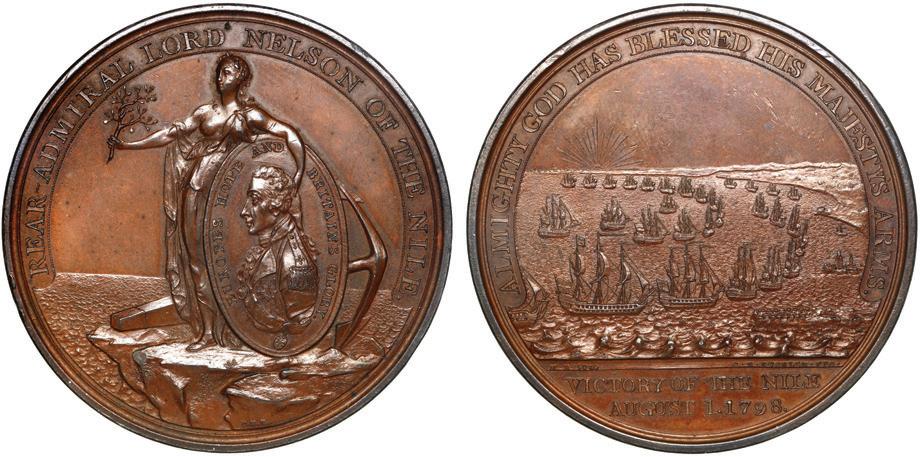

After a dozen years of very active collecting, I sold my U.S. large cents through Bowers and Merena in 1982. Ted Craige, an engineer by day and a voracious medal collector in his spare time, had just died. John Ford knew Craige’s widow, Miriam, and he knew me, so he put the two of us together. John then compiled a ten-page inventory of Ted’s collection and put on his best sales job. Best or not, it was good enough to launch me into the world of “Betts” medals, so called because C. Wyllys Betts wrote the definitive book on the subject.
Of the 623 medals described by Betts, no less than 167 of them are Admiral Vernon medals. Indeed, the Vernon chapter is the largest single section of the book. So compelling has the subject proved over the years that no less than fifteen serious authors have been drawn to it, this list including such numismatic luminaries as William Sumner Appleton, Malcolm Storer, Alejandro Rosa, J. T. Medina, the Earl of Sandwich and Jorge Ferrari. Alert readers will note the mix of both English and Latin authors: Admiral Vernon medals have the unusual distinction of attracting intense interest in both hemispheres.
I fell victim to the same siren song as did the “luminaries,” with the bug biting me perhaps the hardest of all. After my purchase from Ted Craige’s widow, I moved swiftly to purchase the entire collections of Leonard Finn, Dr. Paul Patterson and an anonymous Canadian. To anyone vigorously pursuing the Vernon medals, the lodestar is the collection of the British Museum, put together by Edward Hawkins, Admiral Lord Milford Haven, and sundry contributors over several centuries. Today, the BM’s vast collection numbers 241 distinct Admiral Vernon varieties. I blush to say that my collection totals 248 varieties, a number that may never be surpassed.
Speaking of “both hemispheres,” it was in the process of writing Medallic Portraits that I came across a gentleman from Argentina, Fernando Chao. In speaking of Fernando, let me emphasize the word “gentleman,” being a person not only with good table manners but also sensitive at all times to the wants and feelings of those around him. Having Fernando as a house guest for two weeks, I can say from experience that he was a gentleman from the moment he got up in the morning until bidding us a warm “good night” before trundling off to bed.
Beneath this veneer of politesse there dwelt a warm human being with a keen mind. With the exception of the sport of soccer, which Fernando detested despite being from Argentina, he could talk intelligently on a wide range of subjects. In his company, the conversation never lagged, nor was it ever dull in the least.
My strong relationship with Fernando exemplifies how Admiral Vernon medals have been collected ardently in both hemispheres from at least the 19th century on. The medals served as the tie that bound us in friendship. Fernando had long since sold his collection, but I was able to track it down and purchase it from a dealer in Spain. This put a glorious seal on our relationship: I did not have Fernando by my side, but I did have in my possession the medals which had meant so much to him. Fernando passed away this January, a victim of COVID-19, and it made me think: Collecting is a mundane activity whereas true friendships are sublime. Fernando’s passing had no effect on my collection, other than to make it seem trivial when weighed against the worth of a great man.
Two years ago, I had little thought of parting with my beloved Vernon medals. I was willing to dispense with duplicates and, as I was contemplating this possibility, along came Dan Sedwick to give me a hand. His providential arrival was rewarded with a series of consignments which he handled with great skill and energy. Now it is time for him to ferry my main collection across the River Styx.
Note: New XRF technology allows us give exact percentages of metallic content, as opposed to the old method of measuring specific gravity, which cannot discriminate the amount of each metal in the mix. Each of the listings to follow states percentages of metals from XRF testing (only those above 1%, no trace elements). Since these readings are taken from the center of one side of each medal, and most likely other locations would give slightly different results, these numbers should not be taken as absolutes so much as a general idea of the alloys. The great majority are copper-zinc, but there are some surprises. We hope this information will facilitate future analysis of specific methods and location of manufacture.
Follwing Parts I (Auction 30) and II (Auction 31), now it is our honor to present Part III of the John Adams Collection of Admiral Vernon Medals here in the next 75 lots, many of them plated in John’s book with Fernando Chao, Medallic Portraits of Admiral Vernon (2010) and many also with important pedigrees. Enjoy!
1127. Great Britain, medium-sized copper alloy Admiral Vernon medal, (ca. 1739), Vernon / Satan and Walpole, ex-Adams (Plate). AC-NLv6E. 8.63 grams; 30 mm. Matte, dark-olive UNC without any marks or wear, rated scarce in AC, apparently the only version of this “Satan” reverse in a small diameter. XRF: 43.31% copper, 49.31% zinc, 5.31% lead. Pedigreed to the John Adams Collec tion (with his handwritten tag), plated on page 40 of Medallic Portraits of Admiral Vernon (2010), by Adams and Chao. Estimate: $500-up.


1130. Great Britain, copper alloy Admiral Vernon medal, (ca. 1739), Argyll / Satan and Walpole, ex-Adams, ex-Phillips. AC-NLa1A. 11.09 grams; 38 mm. Dark bronze color, bold AU- with traces of minor die-rust here and there. XRF: 62.97% copper, 29.96% zinc, 4.77% lead. Pedigreed to the John Adams Collection (with his handwrit ten tag) and to the M.B. Phillips Collection (Melnick auction of February 1983, lot 1220). Estimate: $350-$500.

1128. Great Britain, copper alloy Admiral Vernon medal, (ca. 1739), Vernon and Brown / Satan and Walpole, ex-Adams, ex-Craige. AC-NLv8G. 12.57 grams; 37 mm. Nice XF+ in dark bronze color, with very light X scratch between heads of Satan and Walpole but no other damage. XRF: 58.31% copper, 35.42% zinc, 4.93% lead. Pedigreed to the John Adams Collection (with his handwritten tag) and to the Ted Craige Collection. Estimate: $350-$500.
1131. Great Britain, copper alloy Admiral Vernon medal, 1739, arms / Porto Bello, rare, ex-Adams. AC-PB2B. 13.87 grams; 40 mm. Dark brown XF with hints of luster but also some die-rust around details, rated rare in AC. XRF: 61.69% copper, 28.54% zinc, 5.69% lead. Pedigreed to the John Adams Collection (with his handwritten tag). Estimate: $500-up.
1129. Great Britain, copper alloy Admiral Vernon medal, (ca. 1739), Vernon and Brown / Argyll, rare, ex-Adams, exChao, ex-Ferrari. AC-NLv9F. 11.35 grams; 37 mm. With engraver’s name I:GILES in exergue, XF with bright brassy surfaces, no damage, rated rare in AC, which also says: “Only specimen seen appears to have been cast and, in any event, crumbled gilding makes the details tenuous,” no doubt in reference to the plated example from the Na tional Maritime Museum, although Adams’ example here also appears cast and gilt, the latter belied by XRF results. XRF: 44.61% copper, 50.08% zinc, 3.02% lead. Pedigreed to the John Adams Collection (with his handwritten tag), the Fernando Chao Collection, and the Jorge Ferrari Collection. Estimate: $500-up.


1132. Great Britain, copper alloy Admiral Vernon medal, 1739, arms / Porto Bello, ex-Adams. AC-PB2D. 16.21 grams; 40 mm. Light bronze color, AXF for wear. XRF: 37.56% copper, 54.68% zinc, 4.72% lead. Pedigreed to the John Adams Collection (with his handwritten tag). Estimate: $250-$375.

1133. Great Britain, small copper alloy Admiral Vernon medal, 1739, Vernon / Porto Bello, ex-Adams (plate). ACPBv5D. 5.42 grams; 27 mm. Choice AU+ with original luster and color on fields and around details for an almost prooflike effect, rated scarce in AC. XRF: 39.72% copper, 53.05% zinc, 5.83% lead. Pedigreed to the John Adams Collection (with his handwritten tag), plated on page 54 of Medallic Portraits of Admiral Vernon (2010), by Adams and Chao, acquired from Jim King in June 1984. Estimate: $500-up.
1136. Great Britain, copper alloy Admiral Vernon medal, 1739, Vernon / Porto Bello, ex-Adams (plate). AC-PBv19N. 21.53 grams; 38 mm. Dark coppery VF struck from worn dies, a few small marks. XRF: 41.98% copper, 52.83% zinc, 3.79% lead. Pedigreed to the John Adams Collection (with his handwritten tag), plated on page 62 of Medallic Portraits of Admiral Vernon (2010), by Adams and Chao. Estimate: $350-$500.
1134. Great Britain, copper alloy Admiral Vernon medal, 1739, Vernon / Porto Bello, ex-Adams (plate). AC-PBv10H. 21.09 grams; 38 mm. AU with traces of mint luster and original color, especially on the stippled-field obverse, the reverse darker, one minor rim-chip (as made?). XRF: 40.15% copper, 54.15% zinc, 3.63% lead. Pedigreed to the John Adams Collection (with his handwritten tag), plated on page 57 of Medallic Portraits of Admiral Vernon (2010), by Adams and Chao. Estimate: $500-up.

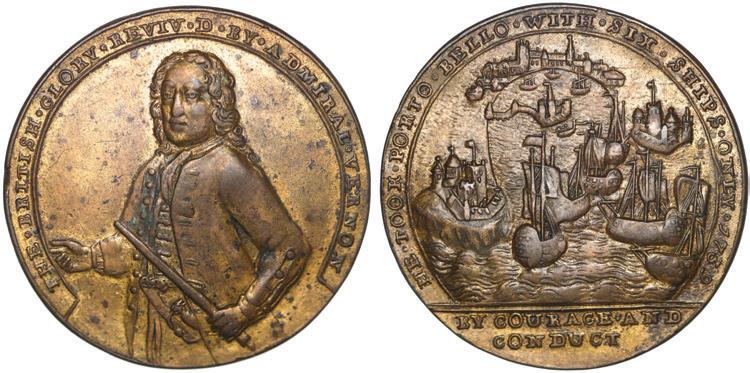


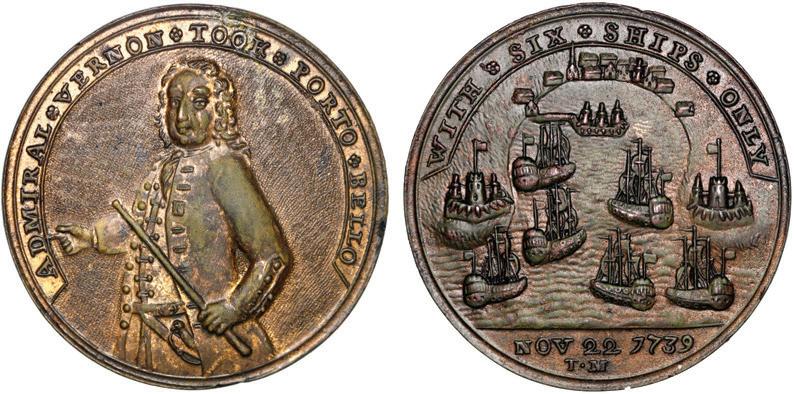

1137. Great Britain, copper alloy Admiral Vernon medal, 1739, Vernon / Porto Bello, ex-Adams (plate). AC-PBv21Q. 17.49 grams; 37 mm. Choice XF+ with much original luster and brassy color. XRF: 41.75% copper, 52.08% zinc, 4.54% lead. Pedigreed to the John Adams Collection (with his handwritten tag), plated on page 63 of Medallic Portraits of Admiral Vernon (2010), by Adams and Chao. Estimate: $500-up.
1135. Great Britain, small copper alloy Admiral Vernon medal, 1739, Vernon / Porto Bello, ex-Adams. AC-PBv16M. 5.12 grams; 27 mm. Dark AU- with faint luster on fields, superior to the piece plated on page 60 of AC. XRF: 44.34% copper, 49.31% zinc, 4.55% lead. Pedigreed to the John Adams Collection (with his handwritten tag). Estimate: $350-$500.
1138. Great Britain, tin-plated copper alloy Admiral Vernon medal, 1739, Vernon / Porto Bello, ex-Adams, ex-Chao, exFerrari. AC-PBv25U. 18.59 grams; 37 mm. Bold UNC with bright silvery color against light brassy background. Adams’ tag says “silver wash or plate” but XRF shows the wash is actually tin, about which the tag goes on to accurately assert “lovely effect on rev.” XRF: 46.21% cop per, 42.07% zinc, 7.46% tin, 3.11% lead. Pedigreed to the John Adams Collection (with his handwritten tag), the Fernando Chao Collection, and the Jorge Ferrari Collection. Estimate: $500-up.
1139. Great Britain, copper alloy Admiral Vernon medal, 1739, Vernon / Porto Bello, ex-Adams, ex-Craige. AC-PBv26V. 16.47 grams; 37 mm. Matte AU- in light brown color with traces of original luster (bright in places). XRF: 41.65% copper, 50.60% zinc, 5.81% lead. Pedigreed to the John Adams Collection (with his handwritten tag) and to the Ted Craige Collection. Estimate: $350-$500.
1142. Great Britain, copper alloy Admiral Vernon medal, 1739, Vernon / Porto Bello, ex-Adams (plate). AC-PBv32X. 14.08 grams; 37 mm. Matte AU- with choice details and satin-smooth surfaces, noticeably high rims. XRF: 42.97% copper, 51.05% zinc, 4.31% lead. Pedigreed to the John Adams Collection (with his handwritten tag), plated on page 71 of Medallic Portraits of Admiral Vernon (2010), by Adams and Chao. Estimate: $500-up.
1140. Great Britain, copper alloy Admiral Vernon medal, 1739, Vernon / Porto Bello, ex-Adams. AC-PBv29Y. 16.70 grams; 38 mm. Chocolate brown with bold details, some crust on ships’ high points, appears to be superior to the plate piece on AC page 68, clearly XF by modern U.S. grading standards, but graded VF by Adams, whose tag says “For some reason, this variety never comes in XF.” XRF: 43.81% copper, 46.46% zinc, 7.18% lead. Pedigreed to the John Adams Collection (with his handwritten tag). Estimate: $350-$500.


1143. Great Britain, copper alloy Admiral Vernon medal, 1739, Vernon / Porto Bello, ex-Adams (plate), ex-Craige. ACPBv36II. 17.53 grams; 39 mm. Choice AU with some original color and luster, mostly on obverse, neatly struck with smooth surfaces. XRF: 41.19% copper, 51.66% zinc, 5.44% lead. Pedigreed to the John Adams Collection (with his handwritten tag) and to the Ted Craige Collection, plated on page 73 of Medallic Portraits of Admiral Vernon (2010), by Adams and Chao. Estimate: $750-up.


1141. Great Britain, copper alloy Admiral Vernon medal, 1739, Vernon / Porto Bello, ex-Adams (plate), ex-Craige. ACPBv31CC. 14.40 grams; 38 mm. AU with some original color and luster, appropriate for a plate piece, but with odd disturbances in fields that appear to be scratches and corrosion, which tag refers to simply as “troubled surface.” XRF: 53.40% copper, 40.07% zinc, 4.25% lead. Pedigreed to the John Adams Collection (with his handwritten tag) and to the Ted Craige Collection, plated on page 70 of Medallic Portraits of Admiral Vernon (2010), by Adams and Chao. Estimate: $500-up.

1144. Great Britain, small copper alloy Admiral Vernon medal, 1739, Vernon / Porto Bello, ex-Adams, ex-Chao, ex-Ferrari. AC-PBv38KK. 4.62 grams; 27 mm. Bold AU-, slightly out of round, with much original color and luster, visibly superior to the plate piece on page 74 of AC. XRF: 39.82% copper, 52.99% zinc, 5.95% lead. Pedigreed to the John Adams Collection (with his handwrit ten tag), the Fernando Chao Collection, and the Jorge Ferrari Collection. Estimate: $500-up.

1145. Great Britain, silver Admiral Vernon medal, 1739, Vernon / Porto Bello, rare, ex-Adams, ex-Chao, ex-Ferrari. AC-PBv41NN. 18.66 grams; 38 mm. Brightly polished XF (some of the polish itself still caked in the crevices) with lovely toning around details, rated scarce in AC but really in a different class of rarity as struck in high-grade silver. XRF: 97.21% silver. Pedigreed to the John Adams Collection (with his handwritten tag), the Fernando Chao Collection, and the Jorge Ferrari Collection. Estimate: $1,000-up.
1148. Great Britain, copper alloy Admiral Vernon medal, 1739, Vernon / Porto Bello, ex-Adams, ex-Craige. AC-PBv44UU. 15.06 grams; 38 mm. XF with traces of original color and luster on reverse, the obverse somewhat matte with a light olive sheen. XRF: 41.09% copper, 50.50% zinc, 6.48% lead. Pedigreed to the John Adams Collection (with his handwritten tag) and to the Ted Craige Collection. Estimate: $250-$375.
1146. Great Britain, copper alloy Admiral Vernon medal, 1739, Vernon / Porto Bello, ex-Adams. AC-PBv41U. 17.75 grams; 37 mm. Light brown XF, matte on obverse but the reverse with traces of original color and luster. XRF: 38.57% copper, 52.47% zinc, 6.38% lead. Pedigreed to the John Adams Collection (with his handwritten tag) and to the Jeffrey Hoare Auction 73 of April 2012, lot 297. Estimate: $250-$375.


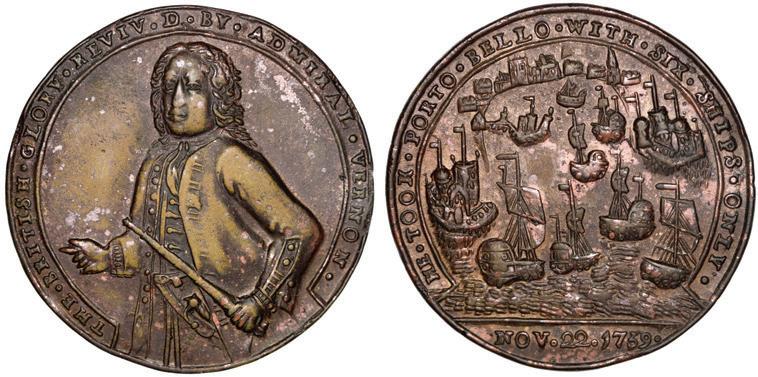

1149. Great Britain, copper alloy Admiral Vernon medal, 1739, Vernon / Porto Bello, ex-Adams. AC-PBv45VV. 13.60 grams; 38 mm. Golden brass color with some crusty toning in legends, oth erwise problem-free VF. XRF: 38.71% copper, 53.08% zinc, 6.39% lead. Pedigreed to the John Adams Collection (with his handwritten tag) and to the DNW auction of April 2019, with original lot-tag 990. Estimate: $200-$300.
1147. Great Britain, small copper alloy Admiral Vernon medal, 1739, Vernon / Porto Bello, ex-Adams (plate). ACPBv43SS. 5.02 grams; 27 mm. Dark AXF with bold details but flat face, the obverse rim higher than usual, described on tag as “struck on cast flan.” XRF: 62.97% copper, 27.14% zinc, 7.86% lead. Pedigreed to the John Adams Collection (with his handwritten tag), plated on page 78 of Medallic Portraits of Admiral Vernon (2010), by Adams and Chao. Estimate: $400-$600.

1150. Great Britain, copper alloy Admiral Vernon medal, 1739, Vernon / Porto Bello, ex-Adams. AC-PBv47VV. 11.11 grams; 38 mm. AXF with bits of original color and faintly lustrous fields, probably a late die-state, rated scarce in AC, which says: “If one were collecting Vernon medals by type, this ‘gauntlet’ portrait would pose a challenge.” XRF: 41.70% copper, 52.46% zinc, 4.56% lead. Pedigreed to the John Adams Collection (with his handwritten tag). Estimate: $350-$500.
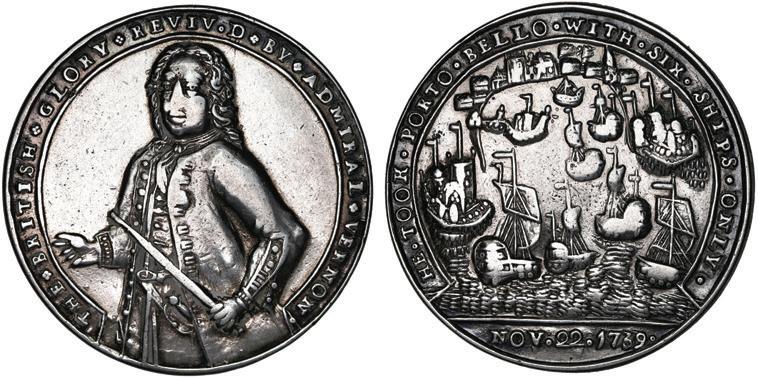
1151. Great Britain, copper alloy Admiral Vernon medal, 1739, Vernon with anchor fluke / Porto Bello, ex-Adams, ex-Craige. AC-PBvi1A. 12.41 grams; 39 mm. Dark XF with smooth surfaces, high rims, and well-executed details, as AC says: “this variety is especially well made.” It also boasts a diagonally milled edge, which is quite unusual for this series. XRF: 41.24% copper, 51.80% zinc, 5.10% lead. Pedigreed to the John Adams Collection (with his handwritten tag) and to the Ted Craige Collection. Estimate: $250-$375.
1154. Great Britain, silver Admiral Vernon medal, 1739, Vernon with ship and cannon / Porto Bello, rare, ex-Adams. AC-PBvi11P. 16.82 grams; 39 mm. Beautifully toned AU+, possibly pol ished at one point, with choice sharp details all over, its tag stating “Old English Coll’n via Peter Thompson / 1/15” and giving a measured specific gravity of 8.26, certainly one of the most beautiful silver Vernon medals in existence. XRF: 84.53% silver. Pedigreed to the John Adams Collection (with his handwritten tag). Estimate: $1,000-up.
1152. Great Britain, copper alloy Admiral Vernon medal, 1739, Vernon with cannon and ship / Porto Bello, ex-Adams. AC-PBvi3C. 12.71 grams; 37 mm. Choice AU with much original brassy color and luster but also some encrustation here and there on reverse. XRF: 40.09% copper, 50.98% zinc, 6.12% lead. Pedigreed to the John Adams Collection (with his handwritten tag). Estimate: $400-$600.
1155. Great Britain, copper alloy Admiral Vernon medal, 1739, Vernon with ship and cannon / Porto Bello, ex-Adams. AC-PBvi13Q. 17.53 grams; 38 mm. AU- with much original color and muted luster, bits of encrustation in legends. XRF: 41.02% copper, 55.06% zinc, 2.10% lead. Pedigreed to the John Adams Collection (with his handwritten tag) and to the Stack’s auction of January 2008, with original lot-tag 7111. Estimate: $350-$500.
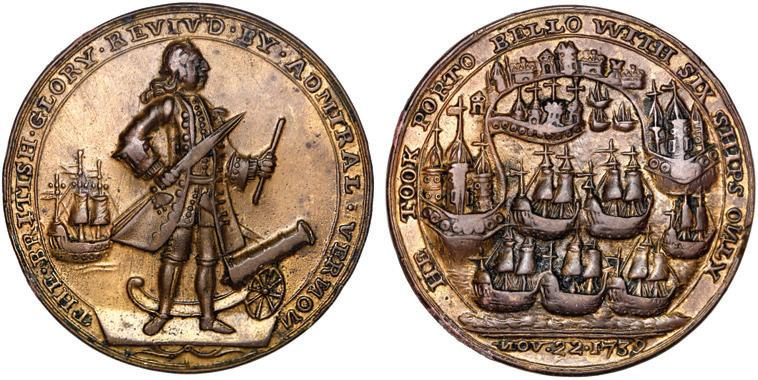

1153. Great Britain, copper alloy Admiral Vernon medal, 1739, Vernon with cannon and anchor / Porto Bello, exAdams. AC-PBvi6G. 12.62 grams; 39 mm. Very sharp AU with choice details and much original color and luster, its obverse shared with one in the Cartagena issues. XRF: 40.28% copper, 52.95% zinc, 5.65% lead. Pedigreed to the John Adams Collection (with his handwritten tag). Estimate: $400-$600.
1156. Great Britain, small copper alloy Admiral Vernon medal, 1739, Vernon with ship and cannon / Porto Bello, ex-Adams (plate). AC-PBvi14R. 6.33 grams; 27 mm. Scarce issue with misspelled word BRITIS, technically XF or better, with some original copper color and luster (especially on reverse) but rather weakly struck, which the tag summarizes thus: “Hard to grade. VG for sharpness but much original color.” XRF: 45.96% copper, 47.94% zinc, 4.49% lead. Pedigreed to the John Adams Collection (with his handwritten tag), plated on page 98 of Medallic Portraits of Admiral Vernon (2010), by Adams and Chao. Estimate: $500-up.

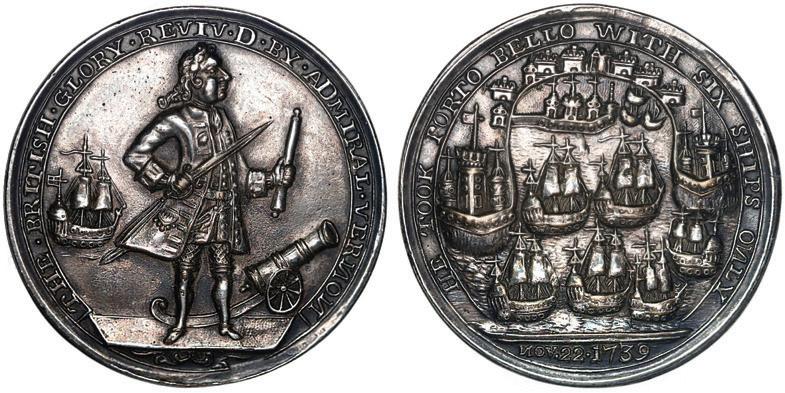
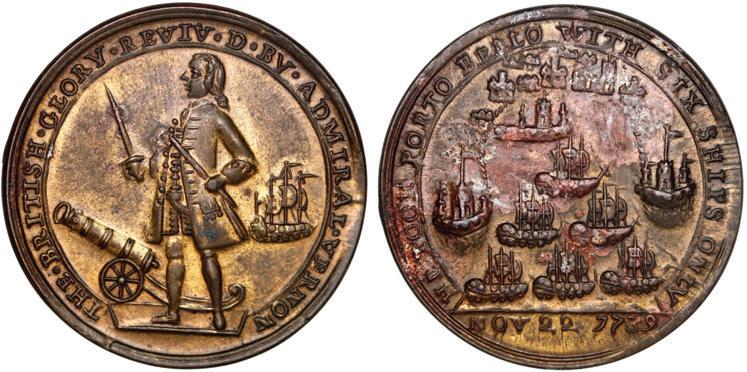

1157. Great Britain, copper alloy Admiral Vernon medal, 1739, Vernon with ship and cannon / Porto Bello, ex-Adams (plate), ex-Craige. AC-PBvi16V. 14.85 grams; 40 mm. Dark AU with sharp details, traces of original luster on reverse, high rims, rated scarce in AC, with raised hump behind head described on the tag as “damaged obv die.” XRF: 40.41% copper, 50.08% zinc, 7.46 lead. Pedigreed to the John Adams Collection (with his handwritten tag) and to the Ted Craige Collection. Estimate: $500-up.

1160. Great Britain, copper alloy Admiral Vernon medal, 1739, Vernon with ship and cannon / Porto Bello, ex-Adams, ex-Craige. AC-PBvi20HH. 12.52 grams; 37 mm. Dark XF+ with slightly lustrous fields but weakly struck centers, dentillated rims. XRF: 40.38% copper, 51.98% zinc, 6.25% lead. Pedigreed to the John Adams Collection (with his handwritten tag) and to the Ted Craige Collection. Estimate: $250-$375.

1158. Great Britain, copper alloy Admiral Vernon medal, 1739, Vernon with ship and cannon / Porto Bello, ex-Adams. AC-PBvi18CC. 15.28 grams; 37 mm. Super-sharp AU with some original luster and color around details. XRF: 40.95% copper, 52.56% zinc, 4.30% lead. Pedigreed to the John Adams Collection (with his handwritten tag). Estimate: $350-$500.
1161. Great Britain, copper alloy Admiral Vernon medal, 1739, Vernon with ship and cannon / Porto Bello, ex-Adams. AC-PBvi23LL. 11.25 grams; 38 mm. AU with much original color and lus ter, notably superior to the plate piece on page 109 (“Peck Collection”), dentillated rims. XRF: 40.91% copper, 52.92% zinc, 4.81% lead. Pedigreed to the John Adams Collection (with his handwritten tag) and to the Stack’s auction of January 2013 (lot 10010). Estimate: $400-$600.
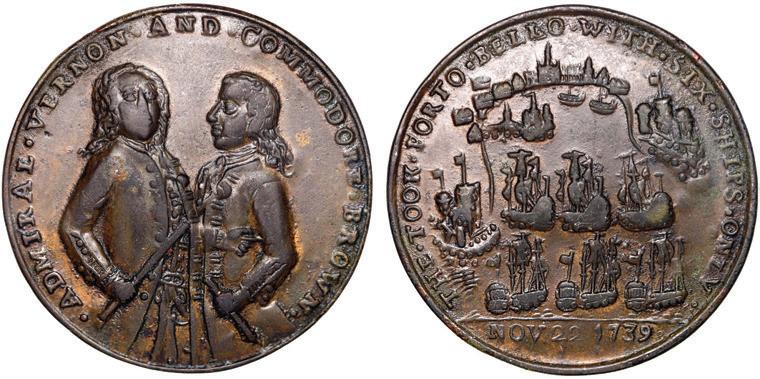


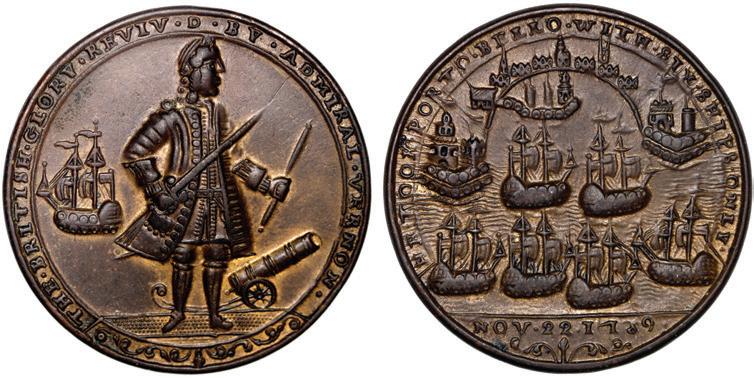
1159. Great Britain, heavily gold-plated copper alloy Admi ral Vernon medal, 1739, Vernon with ship and cannon / Porto Bello, unique, ex-Adams, ex-Craige. AC-PBvi19FF. 13.31 grams; 37 mm. Bright, sharp UNC with neatly dentillated rims, its tag stating “nicely gilt” to describe a heavy gilding that rings up as 16K gold, but the weight is clearly too light to be solid gold. Regarding the population of gold medals, AC says (page 201): “Although many examples were gilded, only a single Vernon medal is known in gold (an example of PBvi 25-OO in the British Museum).” XRF: 65.67% gold, 13.11% copper, 17.91% zinc. Pedigreed to the John Adams Collection (with his handwritten tag) and to the Ted Craige Collection. Estimate: $1,500-up.
1162. Great Britain, copper alloy Admiral Vernon medal, 1739, Vernon and Brown / Porto Bello, ex-Adams, ex-Craige. AC-PBvb1C. 14.48 grams; 37 mm. Dark but with somewhat lustrous fields, net XF+ with flat high points. S in AC. XRF: 40.15% copper, 52.25% zinc, 5.79% lead. Pedigreed to the John Adams Collection (with his hand written tag) and to the Ted Craige Collection. Estimate: $400-$600.
1163. Great Britain, copper alloy Admiral Vernon medal, 1739, Vernon and Brown / Porto Bello, ex-Adams. AC-PBvb4G. 15.54 grams; 37 mm. Dark brassy XF with faint traces of original color, stippled obverse field. XRF: 44.17% copper, 49.27% zinc, 4.76% lead. Pedigreed to the John Adams Collection (with his handwritten tag). Estimate: $250-$375.
1166. Great Britain, copper alloy Admiral Vernon medal, 1739, Vernon and Brown / Porto Bello, ex-Adams (plate), ex-Craige. AC-PBvb11S. 15.66 grams; 38 mm. Sharply detailed AU-, with nicely contrasting fields in olive green color, faint die-crack at top of obverse. XRF: 40.67% copper, 50.65% zinc, 4.93% lead. Pedigreed to the John Adams Collection (with his handwritten tag) and to the Ted Craige Collection, plated on page 124 of Medallic Portraits of Admiral Vernon (2010), by Adams and Chao. Estimate: $500-up.
1164. Great Britain, heavily gold-plated copper alloy Admiral Vernon medal, 1739, Vernon and Brown / Porto Bello, ex-Adams. AC-PBvb6J. 14.08 grams; 38 mm. AU details in bright gold color but with bubbly (cast) surfaces, high rims, described on tag as having “Lovely gilding!!” XRF: 46.79% gold, 22.04% copper, 28.17% zinc. Pedigreed to the John Adams Collection (with his handwritten tag). Estimate: $500-up.

1167. Great Britain, copper alloy Admiral Vernon medal, 1739, Vernon and Lezo / Porto Bello, ex-Adams, ex-Craige. AC-PBvl2B. 13.38 grams; 38 mm. XF+ with some light olive color and traces of faint luster, light scratches on obverse, dentillated rims. XRF: 37.56% copper, 54.68% zinc, 4.72% lead. Pedigreed to the John Adams Collection (with his handwritten tag) and to the Ted Craige Collection. Estimate: $250-$375.
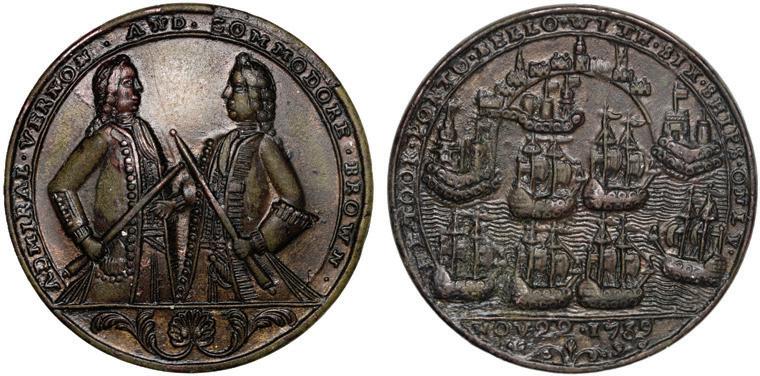

1165. Great Britain, silver alloy Admiral Vernon medal, 1739, Vernon and Brown / Porto Bello, ex-Adams (plate), ex-Ford. AC-PBvb7L. 14.78 grams; 39 mm. Very nice details with very high rims, XF+ in bright silver color but with some scratches above Vernon’s head. AC: “…this variety is intentionally upgraded, with very high double rims and with many examples made in silver alloys as well as silver. In short, it was made for an upscale market.” XRF: 10.22% silver, 39.47% copper, 37.51% zinc, 11.09% tin. Pedigreed to the John Adams Collection (with his handwritten tag) and to the John J. Ford Jr. Collection (Stack’s auction of January 2006, with original lot-tag 552), plated on page 120 of Medallic Portraits of Admiral Vernon (2010), by Adams and Chao. Estimate: $1,000-up.
1168. Great Britain, copper alloy Admiral Vernon medal, 1739, Vernon and Lezo / Porto Bello, ex-Adams, ex-Stuart. AC-PBvl3B. 11.70 grams; 37 mm. Choice AU+ with much original color and luster, dentillated rims, described on Adams’ tag as having “perfect strike and lovely color.” XRF: 39.49% copper, 52.29% zinc, 5.47% lead. Pedigreed to the John Adams Collection (with his handwritten tag) and to the Richard Stuart Collection (Sedwick Auction 22, with original lot-tag 1262). Estimate: $500-up.



1169. Great Britain, cast small silver Admiral Vernon medal, 1739, Vernon and Lezo / Porto Bello, rare, ex-Adams. ACPBvl5D. 7.37 grams; 28 mm. Very sharp details in high-grade silver, nice AU with contrasting toning, this variety described in AC as “… the best executed of the DON / BLASS varieties… from a sophisticated ship [and] a model form which many of its peers were copied.” XRF: 97.34% silver. Pedigreed to the John Adams Collection (with his hand written tag). Estimate: $1,000-up.


1172. Great Britain, copper alloy Admiral Vernon medal, 1739, Vernon, Ogle and Wentworth / Porto Bello, ex-Adams. AC-PBvow1A. 14.44 grams; 38 mm. AU- with some original color and lus ter, dentillated rims, rated scarce in AC, single-known obverse die with portraits of Vernon, Ogle and Wentworth (and lion cubs, supposedly in reference to a pair that were born at the Tower of London menagerie at the time and named Vernon and Ogle), similar to Cartagena issue CAvow1. XRF: 41.12% copper, 51.17% zinc, 6.00% lead. Pedigreed to the John Adams Collection (with his handwritten tag), acquired from Hedley Betts in December 1992. Estimate: $400-$600.
1170. Great Britain, copper alloy Admiral Vernon medal, 1739, Vernon and Lezo / Porto Bello, ex-Adams. AC-PBvl8G. 12.40 grams; 38 mm. Choice XF+ with much original copper color (possibly higher grade but with high points not fully struck up), nice design with dentillated rims. XRF: 44.51% copper, 49.80% zinc, 4.61% lead. Pedigreed to the John Adams Collection (with his handwritten tag). Estimate: $300-$450.
1173. Great Britain, cast silvered copper alloy Admiral Ver non medal, 1739, Vernon, Lezo and Brown / Porto Bello, ex-Adams, ex-Craige. AC-PBvlb1A. 10.49 grams; 40 mm. Weakly struck Fine with crude dark patches peeking through the silvering, single-known obverse die with portraits of Vernon, Lezo and Brown, similar to Cartagena issue CAvlb1. XRF: 2.25% silver, 44.53% cop per, 47.91% zinc, 3.27% lead. Pedigreed to the John Adams Collection (with his handwritten tag) and to the Ted Craige Collection. Estimate: $250-$375.
1171. Great Britain, copper alloy Admiral Vernon medal, 1739, Vernon and Lezo / Porto Bello, ex-Adams (plate). ACPBvl9K. 11.29 grams; 38 mm. Sharply detailed AU- with muted luster throughout, dentillated rims, rated scarce in AC. XRF: 40.74% copper, 52.27% zinc, 5.11% lead. Pedigreed to the John Adams Collection (with his handwritten tag), plated on page 135 of Medallic Portraits of Admiral Vernon (2010), by Adams and Chao. Estimate: $500-up.
1174. Great Britain, copper alloy Admiral Vernon medal, 1739, Vernon and Fort Chagre / Porto Bello, ex-Adams (plate). AC-FCv3B. 18.05 grams; 40 mm. Sharply detailed AU+ with traces of luster, nice chocolate brown color, dentillated rims, unusually broad flan for this series. XRF: 41.91% copper, 53.63% zinc, 2.88% lead. Pedigreed to the John Adams Collection (with his handwritten tag), plated on page 142 of Medallic Portraits of Admiral Vernon (2010), by Adams and Chao. Estimate: $500-up.
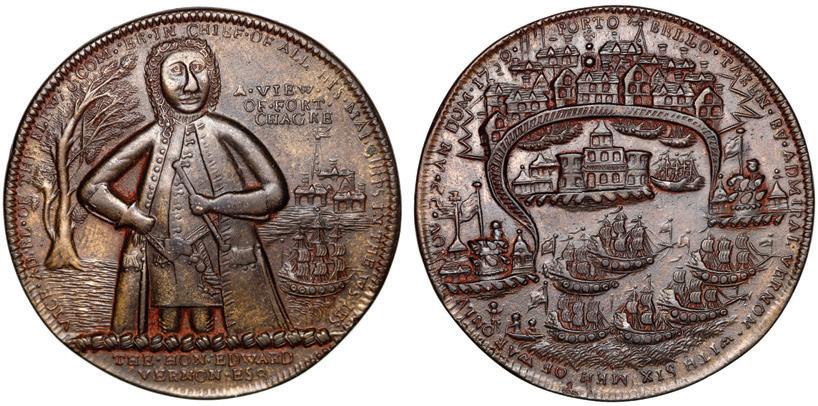


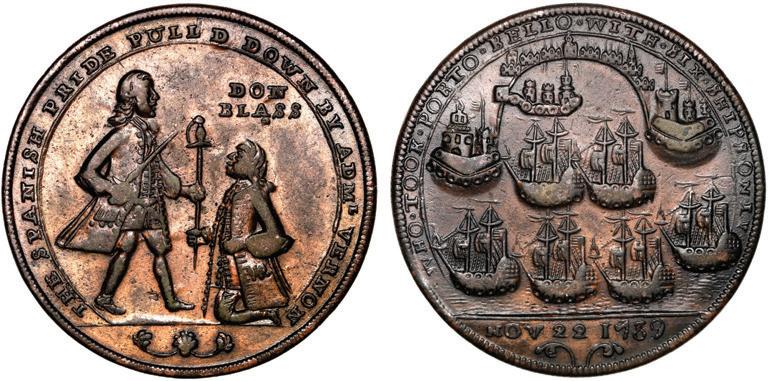
1175. Great Britain, gilt copper alloy Admiral Vernon medal, 1739, Vernon and Fort Chagre / Porto Bello, ex-Adams. ACFCv5D. 16.54 grams; 40 mm. Bold XF details with very bright gold gilding all over except where worn away on coppery high points, dentillated rims. XRF: 11.85% gold, 38.96% copper, 44.52% zinc, 2.82% lead. Pedigreed to the John Adams Collection (with his handwritten tag). Estimate: $500-up.

1178. Great Britain, copper alloy Admiral Vernon medal, 1739, Vernon and Fort Chagre / Porto Bello, ex-Adams, exChao, ex-Ferrari. AC-FCv13R. 14.87 grams; 38 mm. Mint State (even by Adams’ standards) with much original copper color and luster, completely devoid of wear or marks, dentillated rims. XRF: 42.19% copper, 48.81% zinc, 6.04% lead. Pedigreed to the John Adams Collec tion (with his handwritten tag), the Fernando Chao Collection, and the Jorge Ferrari Collection. Estimate: $750-up.
1176. Great Britain, copper alloy Admiral Vernon medal, 1739, Vernon and Fort Chagre / Porto Bello, ex-Adams (plate), ex-Craige. AC-FCv6G. 15.01 grams; 38 mm. UNC with bright original luster and color around details, which are particularly sharp, also high rims. XRF: 39.50% copper, 53.72% zinc, 4.29% lead. Pedigreed to the John Adams Collection (with his handwritten tag) and to the Ted Craige Collection, plated on page 146 of Medallic Portraits of Admiral Vernon (2010), by Adams and Chao. Estimate: $500-up.




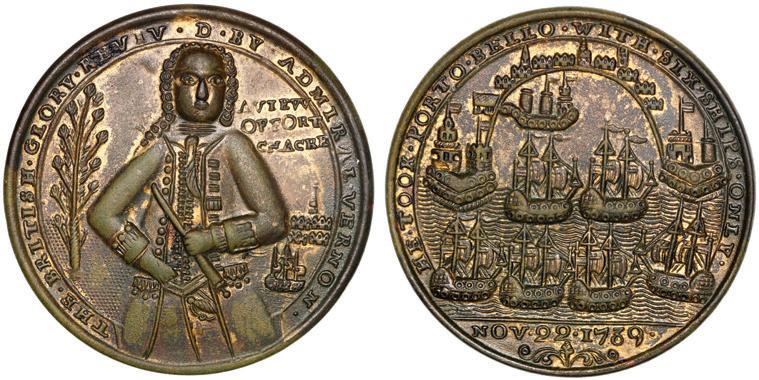
1179. Great Britain, copper alloy Admiral Vernon medal, 1739, Vernon and Fort Chagre / Porto Bello, ex-Adams. ACFCv14S. 13.85 grams; 38 mm. Matte XF+ with bold details, light in color. XRF: 40.69% copper, 55.94% zinc, 1.41% lead. Pedigreed to the John Adams Collection (with his handwritten tag). Estimate: $350-$500.
1177. Great Britain, copper alloy Admiral Vernon medal, 1739, Vernon and Fort Chagre / Porto Bello, ex-Adams, exChao, ex-Ferrari. AC-FCv11N. 12.60 grams; 38 mm. AU with original brassy color and luster, some high points weak, stippled obverse fields, dentillated rims, overall superior to the AC plate piece on page 151 (British Museum). XRF: 38.58% copper, 52.73% zinc, 6.34% lead. Pedigreed to the John Adams Collection (with his handwritten tag), the Fernando Chao Collection, and the Jorge Ferrari Collection. Estimate: $350-$500.
1180. Great Britain, copper alloy Admiral Vernon medal, 1739, Vernon and Fort Chagre / Porto Bello, ex-Adams. ACFCv15V. 14.33 grams; 38 mm. Mint State but with very muted luster and no original color, still visibly superior to the AC plate piece on page 155, described on Adams’ tag thus: “Mint color faded but no apparent wear. Lovely surfaces.” XRF: 39.35% copper, 53.32% zinc, 5.33% lead. Pedigreed to the John Adams Collection (with his handwritten tag) and to the Stack’s auction of January 2012 (lot 6017). Estimate: $750-up.
1181. Great Britain, medium-sized copper alloy Admiral Vernon medal, 1739, Vernon and Fort Chagre / Porto Bello, ex-Adams (plate). AC-FCv18Y. 11.99 grams; 34 mm. AU with original luster around bold details on obverse, the reverse a bit weaker, smallest diameter of the Fort Chagre type. XRF: 41.45% copper, 51.72% zinc, 4.94% lead. Pedigreed to the John Adams Collection (with his handwrit ten tag), plated on page 157 of Medallic Portraits of Admiral Vernon (2010), by Adams and Chao. Estimate: $500-up.



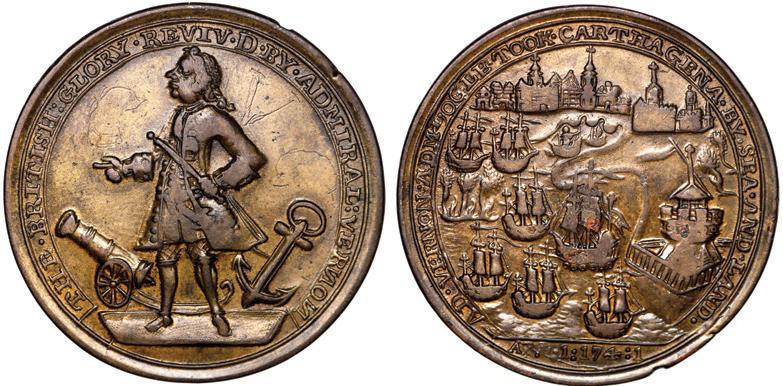


1184. Great Britain, copper alloy Admiral Vernon medal, 1741, Vernon / Cartagena, ex-Adams, ex-Finn. AC-CAv4E. 13.78 grams; 38 mm. Coppery AU- with traces of original color and luster around details, described in AC as: “A well-composed, neatly executed piece of work, distinguished by a unique legend.” XRF: 46.08% cop per, 47.51% zinc, 4.70% lead. Pedigreed to the John Adams Collection (with his handwritten tag) and the Leonard Finn Collection. Estimate: $400-$600.
1182. Great Britain, cast silver Admiral Vernon medal, 1741, Vernon / Cartagena, rare, ex-Adams. AC-CAv2B. 14.15 grams; 38 mm. AXF with lovely toning, probably polished long ago, the flan somewhat convex, with minor rim-bruise and tiny nicks, fairly highgrade silver. XRF: 94.15% silver. Pedigreed to the John Adams Collection (with his handwritten tag). Estimate: $1,000-up.
1185. Great Britain, medium-sized gilt copper alloy Admiral Vernon medal, 1741, Vernon / Cartagena, ex-Adams. AC-CAv5F. 10.47 grams; 36 mm. Boldly detailed XF+ with bright gold gilding all over except where worn off the highest points (which are dark copper in color), high rims. XRF: 38.30% gold, 25.70% copper, 32.72% zinc. Pedigreed to the John Adams Collection (with his handwritten tag). Estimate: $500-up.
1183. Great Britain, copper alloy Admiral Vernon medal, 1741, Vernon / Cartagena, ex-Adams (plate). AC-CAv3D. 11.82 grams; 39 mm. Dull brass-colored XF with muted luster, interesting old graffiti “C-VC” in obverse field, die-break below date as noted in AC. XRF: 41.99% copper, 50.54% zinc, 6.37% lead. Pedigreed to the John Adams Collection (with his handwritten tag), plated on page 164 of Medallic Portraits of Admiral Vernon (2010), by Adams and Chao. Estimate: $350-$500.
1186. Great Britain, medium-sized copper alloy Admiral Ver non medal, 1741, Vernon / Cartagena, ex-Adams, ex-Craige. AC-CAv6G. 10.64 grams; 38 mm. Matte UNC with satin-smooth fields, traces of muted luster. XRF: 40.16% copper, 53.38% zinc, 5.55% lead. Pedigreed to the John Adams Collection (with his handwritten tag) and to the Ted Craige Collection. Estimate: $500-up.
1187. Great Britain, medium-sized copper alloy Admiral Vernon medal, 1741, Vernon / Cartagena, ex-Adams, ex-Finn. AC-CAv6G. 10.61 grams; 38 mm. Copper-colored XF+ with original color and luster around details, minor rim-bruise. XRF: 41.12% copper, 51.83% zinc, 5.64% lead. Pedigreed to the John Adams Collection (with his handwritten tag) and the Leonard Finn Collection. Estimate: $400-$600.
1190. Great Britain, copper alloy Admiral Vernon medal, 1741, Vernon and Ogle / Cartagena, ex-Adams (plate). ACCAvo1A. 12.75 grams; 39 mm. Brass-colored Mint State with original luster (bright on reverse), dentillated rims, rated scarce in AC, probably an early die-state as lacking characteristic reverse die failures mentioned in AC. XRF: 40.37% copper, 50.55% zinc, 7.66% lead. Pedigreed to the John Adams Collection (with his handwritten tag), plated on page 170 of Medallic Portraits of Admiral Vernon (2010), by Adams and Chao. Estimate: $500-up.

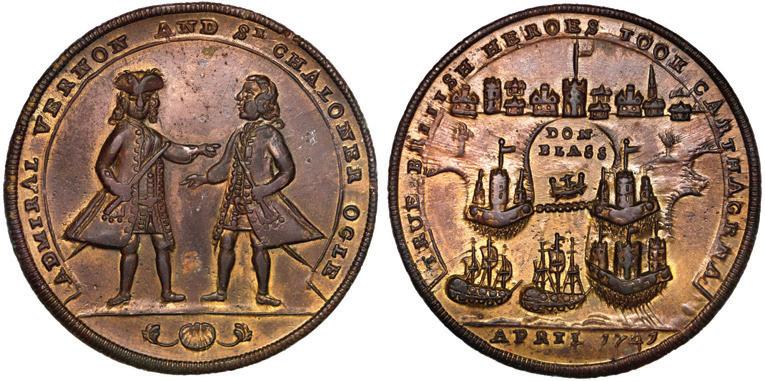

1188. Great Britain, copper alloy Admiral Vernon medal, 1741, Vernon and Lezo / Cartagena, ex-Adams, ex-Craige. AC-CAvl1A. 14.91 grams; 39 mm. Dark XF with slightly porous surfaces, dentillated rims. XRF: 46.85% copper, 45.65% zinc, 4.68% lead. Pedigreed to the John Adams Collection (with his handwritten tag) and to the Ted Craige Collection. Estimate: $250-$375.
1191. Great Britain, copper alloy Admiral Vernon medal, 1741, Vernon and Ogle / Cartagena, ex-Adams. AC-CAvo2B. 11.27 grams; 38 mm. Choice AU with much original color and luster, especially on reverse, the rims high and neatly dentillated, described in AC as: “A well-balanced piece of work.” XRF: 40.74% copper, 52.65% zinc, 5.47% lead. Pedigreed to the John Adams Collection (with his handwritten tag), acquired from Richard August in January 1985. Estimate: $400-$600.

1189. Great Britain, copper alloy Admiral Vernon medal, 1741, Vernon and Lezo / Cartagena, ex-Adams, ex-Chao, ex-Ferrari. AC-CAvl2C. 12.25 grams; 38 mm. Very sharply detailed Mint State with original luster, reverse struck using a very late-stage die showing abundant radial flow-lines around devices. XRF: 40.19% copper, 52.40% zinc, 5.32% lead. Pedigreed to the John Adams Collec tion (with his handwritten tag), the Fernando Chao Collection, and the Jorge Ferrari Collection. Estimate: $500-up.

1192. Great Britain, copper alloy Admiral Vernon medal, 1741, Vernon and Ogle / Cartagena, ex-Adams. AC-CAvo4F. 13.71 grams; 38 mm. Sharp XF+ with muted luster on fields but some die-rust in details, nice chocolate color, dentillated rims. XRF: 39.68% copper, 52.33% zinc, 5.47% lead. Pedigreed to the John Adams Collection (with his handwritten tag). Estimate: $350-$500.

1193. Great Britain, copper alloy Admiral Vernon medal, 1741, Vernon and Ogle / Cartagena, ex-Adams (plate). ACCAvo5G. 14.04 grams; 37 mm. Dark XF with very high rims, rated scarce in AC, the tag from Adams describing it as: “Excellent condition for this rarity.” XRF: 49.74% copper, 34.44% zinc, 12.52% lead. Pedigreed to the John Adams Collection (with his handwritten tag), acquired from Christopher Eimer in October 2007, plated on page 173 of Medallic Portraits of Admiral Vernon (2010), by Adams and Chao. Estimate: $500-up.


1196. Great Britain, gilt copper alloy Admiral Vernon medal, 1741, Vernon, Ogle and Wentworth / Cartagena, ex-Adams, ex-Finn. AC-CAvow3C. 13.31 grams; 41 mm. AU- details with grainy but bright gold gilding mostly remaining (a few dark spots), the obverse apparently somewhat scratched before gilding. S in AC. XRF: 31.50% gold, 32.41% copper, 29.57% zinc, 5.17% lead. Pedigreed to the John Adams Collection (with his handwritten tag) and the Leonard Finn Col lection. Estimate: $500-up.

1194. Great Britain, copper alloy Admiral Vernon medal, 1741, Vernon, Lezo and Ogle / Cartagena, ex-Adams. ACCAvlo1B. 14.53 grams; 39 mm. XF with traces of original color and luster around details on reverse, high double rims that AC calls “a new feature on these medals.” XRF: 44.55% copper, 49.58% zinc, 4.53% lead. Pedigreed to the John Adams Collection (with his handwritten tag), acquired from Richard Margolis in August 1983. Estimate: $350-$500.
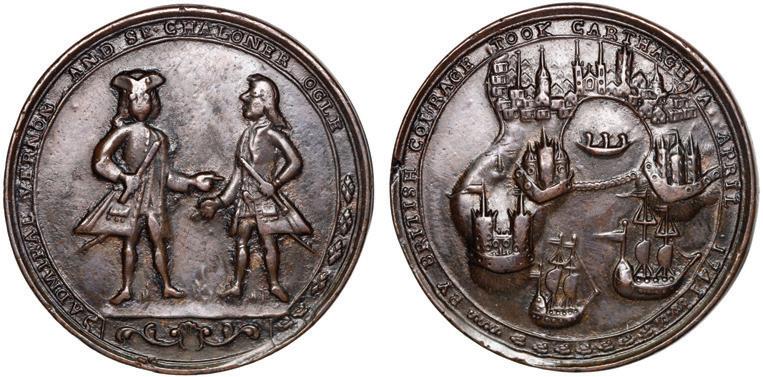
1197. Great Britain, copper alloy Admiral Vernon medal, 1741, Vernon and Havana / Porto Bello, ex-Adams. AC-HAv1B. 15.18 grams; 37 mm. Attractive UNC with choice brassy color and luster, dentillated rims. XRF: 41.41% copper, 51.58% zinc, 4.64% lead. Pedigreed to the John Adams Collection (with his handwritten tag). Estimate: $500-up.
1195. Great Britain, copper alloy Admiral Vernon medal, 1741, Vernon, Ogle and Wentworth / Cartagena, ex-Adams. AC-CAvow1A. 14.10 grams; 39 mm. Dark AU- with satin-smooth fields exhibiting muted luster, high dentillated rims, similar obverse as Porto Bello issue with lion cubs in reference to ones born at the Tower of London menagerie at the time and named after Vernon and Ogle. XRF: 42.79% copper, 50.57% zinc, 5.30% lead. Pedigreed to the John Adams Collection (with his handwritten tag), acquired from Richard Margolis in August 1983. Estimate: $400-$600.

1198. Great Britain, uniface copper alloy Admiral Vernon medal (button), (ca. 1739), Vernon and cannons, extremely rare, ex-Adams. AC-UNI4. 4.72 grams; 25 mm. Bold VF details but crusty and corroded and low in contrast, the loop on back unusu ally intact, described on Adams’ tag as simply “dug”. XRF: 45.48% copper, 33.66% zinc, 11.53% lead, 5.06% tungsten. Pedigreed to the John Adams Collection (with his handwritten tag). Estimate: $500-up.

1199. Great Britain, uniface tin alloy Admiral Vernon medal (button), (ca. 1739), Vernon alone, extremely rare, ex-Adams. AC-UNI8. 7.59 grams; 34 mm. Weak VG with edge-piece missing and interior hole, very leaden in appearance with orange sediment as “metal detected by Jason Koos,” accord ing to Adams’ tag, and probably discovered after publication because AC says: “The only specimen seen, which is badly disfigured, is in the British Museum.” XRF: 60.76% tin, 36.90% lead, 2.00% antimony. Pedigreed to the John Adams Collection (with his handwritten tag). Estimate: $500-up.
1200. Great Britain, uniface copper alloy Admiral Vernon medal (button), (ca. 1739), Vernon with ship and cannon, extremely rare, ex-Adams. AC-UNI9. 4.72 grams; 29 mm. Dark with bold VF details but somewhat crusty and corroded from burial, traces of the back-loop remaining. XRF: 66.34% copper, 18.18% zinc, 12.50% lead. Pedigreed to the John Adams Collection (with his handwritten tag). Estimate: $500-up.



1201. Great Britain, uniface copper alloy Admiral Vernon medal (but ton), (ca. 1739), Vernon with cannon and anchor, extremely rare, exAdams. AC-UNI11. 5.90 grams; 29 mm. Worn VG but at least not corroded from burial, nice chocolate color, with loop on back 100% intact. Curiously, Adams’ tag says “Adams plate example,” but it is not the one plated on page 191 of AC. XRF: 46.44% copper, 46.51% zinc, 5.67% lead. Pedigreed to the John Adams Collection (with his handwritten tag), acquired from Jim King in December 1984. Estimate: $500-up.

1202. Guatemala (Central American Republic), silver 2R-sized medal, 1837, “trial by jury.” Fonrobert-7227. 6.68 grams; 25 mm. Obverse with standing Jus tice holding pomegranate and two snakes under legend EL PUEBLO JUEZ.; reverse with radiant all-seeing eye above scales and sword on pedestal that says GUATA. / 1837. under legend JUICIO POR JURADOS. Attractively rainbow-toned AU with lustrous fields, a few edge-cracks, slightly off-center strike. Estimate: $200-$300.

1203. Haiti (Northern Haiti), tin medal, Henri Christophe, Haitian Constitution of 1807, by E. Thomason, extremely rare, NGC MS 62. Fonrobert-unl; Guttag-unl. 43mm. Obverse with military portrait of Christophe inside legend HENRI CHRISTOPHE PRESI DENT ET GENERALISSIME DES ETATS DE HAYTI LE 17E FEVRIER 1807; reverse with seventeen-line inscription LA LUMIERE / A ECLATE SUR NOUS / ET UNE CONSTITUTION / BIENFAISANT A MIS / FIN AUX COMPLOTS / ET MACHINATIONS / DEQUELS NOUS ETIONS / SUR LE POINT DE DEVENIR / LES VICTIMES. / UN CODE NOUVEAU, ADAPTE / POUR NOS MANIERES, / NOTRE CLIMAT ET NOS / COUTUMES, EST SORTI, / COMME POUR AINSI / DIRE, DU CHAOS, ET / A FIXE LA DESTINEE / DE HAYTI; reeded edge. Made in England by E. Thomason, with a bust of Christophe that is similar to that on the somewhat available copper pattern 1 centime dated 1807, this medal struck to celebrate the (North) Haitian Constitution promulgated on February 17, 1807. Lustrous around details, choice piece (far superior to the Gibbs example, Schulman March 1966 lot 2045), possibly unique without a hole, one of only three known to us. NGC #5746367-004. Estimate: $4,000-$6,000.


1204. Mexico City, Mexico, brass uniface “cliché” (trial strike) of a large medal, Charles III, no date, engraved by Geronimo A. Gil, very rare (probably unique), ex-Hubbard. Obv trial of Grove-K92. 13.00 grams; 58mm. Bust of Charles III above GERONIMO.A.GIL. within legend CARLOS III. REY DE ESP EMP. DE LAS INDIAS. A large, thin shell of metal, AU (or better) with toning around details, struck as a trial for the obverse of a merit medal known in gold (Medina collection), silver (no reference), and bronze (Museo Nacional de Mexico), all very rare, with legend matching some Spain medals by Prieto but with different bust. Notably, the Mexican engraver Gerónimo Antonio Gil responsible for this piece was the father of J. Gabriel Gil, both of whom were known for engraving the rare (and very similar) medals of Manila, Philippines. Desirable pedigree. From the Clyde Hubbard Estate, pedigreed to the El Mundo de la Moneda auction of February 26, 2022, with original lot-tag 51. Estimate: $2,000-up.
1205. Mexico City, Mexico, bronze proclamation medal, Charles IV, 1789, normal date, Archbishop issue, portraits of King Charles IV and Queen Maria Luisa, by G.A. Gil, PCGS MS 62+, finest and only example in PCGS census. Herrera-166; Medina-193; Grove-C21c. 44mm. Obverse with bust of king with G.A. GIL below inside legend * CAROLO * IV * HISP * ET * IND * REG * MEX * PROCL * AN * / * 1789 *; reverse with bust of queen inside legend * LVDOV * REG * / * AUSPICE * / * ALF * ARCH * MEX *. Lightly toned around details, tiny marks only, no luster but technically very high grade for this issue. PCGS #43144310. Estimate: $600-$900.
1206. Mexico City, Mexico, bronze proclamation medal, Charles IV, 1789, Royal Tribunal of Mines issue, by G.A. Gil, PCGS MS 62 Brown, finest and only example in PCGS census. Herrera-169; Medina-196; Grove-C33c. 45mm. Obverse with bust of king with GIL below inside legend CAROLO * IV * HISP * ET * IND * REGI * FELICITER * INAUGURATO *; reverse with arms inside Golden Fleece garter in crowned shield topped with ribbon that says PLUS VLTRA, with mining operations in background, all within legend REG. FOB. TRIB. NOV. HISP. PRIM. HPC. FIDELIT. MONUM. CUDI. FECIT. MEXIC. CIC. IC. CC. LXXXIX. Choice condition, with reddish brown surfaces all over (no luster), the second and third “C’s” in the date backwards to make 1000 (CIC) and 500 (IC). PCGS #43769334. Estimate: $800-$1,200.

1207. Mexico City, Mexico, bronze proclamation medal, Charles IV, 1789, Royal Tribunal of Mines issue, by G.A. Gil. Herrera-169; Medina-196; Grove-C33c. 44.69 grams; 45 mm. Obverse with bust of king with GIL below inside legend CAROLO * IV * HISP * ET * IND * REGI * FELICITER * INAUGURATO *; reverse with arms inside Golden Fleece garter in crowned shield topped with ribbon that says PLUS VLTRA, with mining operations in background, all within legend REG. FOB. TRIB. NOV. HISP. PRIM. HPC. FIDELIT. MONUM. CUDI. FECIT. MEXIC. CIC. IC. CC. LXXXIX. Evenbrown XF with trivial marks, curious minting error with weakness and doubling in about half the legend on each side, the date with second and third “C’s” backwards to make 1000 (CIC) and 500 (IC). Estimate: $200-$300.


1208. Peru, small oval uniface silver military decoration, no date, Ayacucho, struck by Bolívar decree of 1825, very rare. Rev of Fonrobert-9180. 5.52 grams; 26x22mm. Two olive branches below AYACUCHO, per the reverse of Fonrobert-9180, whose obverse re lates to the Colombian Battle of Boyacá of 1819, first we have seen of this type and among a popular series struck right after Independence. Lustrous Mint State (or nearly so) with toning at rims, minor flan laminations. Estimate: $2,000-$3,000.
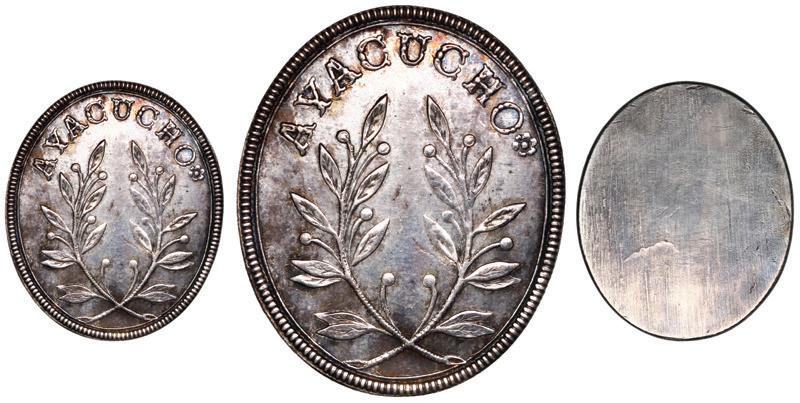
1209. Peru, silver military decoration with wreath suspender, dated 1824, Bolívar / Ayacucho, by Atanasio Dávalos. Fonrobert-9178. 18.78 grams; 32mm. Obverse with uniformed bust of Bolívar right, A.DAVALOS G. below, legend .A SU LIBERTA DOR SIMON BOLIVAR.; reverse with arms of Peru, wreath above and olive/palm branches below, within legend EL PERU RESTAURADO EN AYACUCHO ANO DE 1824.; diagonally reeded edge; loop and wreath hanger at top. Lightly toned AU+ with muted luster, suspended so that the Bolívar obverse is upside-down (struck in coin axis). Estimate: $600-$900.


1210. Peru, oval copper-alloy (off-metal) trial pattern of a military decoration, dated 1824, Bolívar / Ayacucho, by Atanasio Dávalos, very rare, NGC MS 62 Brown, finest and only example in NGC census. Fonrobert-9179 (but in copper). 8.88 grams; 33x28mm. Obverse with uniformed bust of Bolívar, A D below, legend .A SU LIBERTADOR SIMON BOLIVAR.; reverse with arms of Peru with wreath above and olive/palm branches below, within legend EL PERU RESTAURADO EN AYACUCEO [sic] ANO DE 1824.; plain edge; integrated loop at top. This elegant medal commemorates Bolívar’s campaign in Peru, starting with the Battle of Pichincha in 1822 and ending with the Battle of Ayacucho in 1824. It was created by decree under José Maria Galdiano on February 12, 1825, for the Congress of El Peru. Two different dies were used to make about 100 medals in gold and 1100 in silver, from which 1000 pieces were given to the public on the day of San Simón. Note: This copper-alloy version (unlisted in Fonrobert, XRF-tested at 73.17% copper, 26.27% zinc and 0.24% lead) is possibly a unique trial, notably with spelling error AYACUCEO; we have seen only one other in copper but on a round planchet, not oval like the present lot (attributed to the round version in error by NGC). Even dark color with very muted luster. NGC #6477982-003. Estimate: $1,000-$1,500.
1211. Philippines (First Republic), bronze medal, 1899, President Aguinaldo / Malolos Constitution Proclamation, very rare. Honeycutt-62. 10.37 grams; 28mm. Obverse with bust of Emilio Aguinaldo above PROCLAMADA ENERO / 18 MALOLOS 99, with REPUBLICA to left and FILIPINA to right; reverse with LOS / HERUES / FILIPINA inside wreath. Matte-brassy AU with traces of bright luster around details. The First Philippine Republic, with Aguinaldo as president, was established on January 21, 1899, at Malolos, Bulacan, succeeding the previous Revolutionary Government of the Philippines and lasting until 1901, while actually under sovereignty by the United States. Estimate: $200-$300.
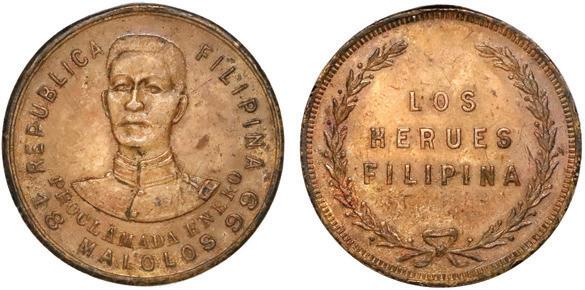
1212. Spain, gold proof medal, (1970), inauguration of the Simón Bolívar monument in the Parque del Oeste de Madrid by the Instituto de Cultura Hispánica. 10.42 grams; 28mm. Obverse with uniformed bust of Bolívar below legend SIMON BOLIVAR 1783-1830; reverse with Bolívar on horse, holding sword handle up to the sun, with frosted silhouette of South America in the background, legend EL LIBERTADOR to left, tiny hallmark and fineness marking 917 (22K gold) at bottom. Brightly lustrous UNC with bagmarks and light hairlines, also a curious strike-through-fiber error between EL and LIB Estimate: $600-$900.


1213. USA (Philadelphia mint), gold $20 Coronet Liberty double eagle, 1904, NGC MS 64, with green CAC sticker. A brilliant and choice coin with radiant luster on both sides, finely executed details from a sharp strike particularly noticeable in Liberty’s hair curls. NGC #6466081-017. Estimate: $2,000-$3,000.
1214. USA (Philadelphia mint), gold $10 Coronet Liberty eagle, 1899, NGC MS 64, with green CAC sticker. Satiny golden surfaces with a touch of rose-gold toning around the rims, well struck devices and free from any obtrusive marks. NGC #6462476001. Estimate: $1,250-$2,000.
1216. USA (Philadelphia mint), gold $5 Coronet Liberty half eagle, 1894, NGC MS 64. Well struck devices against satiny golden fields with a tinge of pink coloration, very minimal contact marks for the grade. NGC #6475733-001. Estimate: $750-$1,100.
1215. USA (Philadelphia mint), gold $10 Indian Head eagle, 1932, NGC MS 63, with green CAC sticker. Lustrous piece with golden surfaces touched by light pink-gold hues around the central devices, sharply rendered Indian Head and eagle design from a strong striking. NGC #6467083-001. Estimate: $1,250-$2,000.
1217. USA (Philadelphia mint), gold $2-1/2 Coronet Liberty quarter eagle, 1843, NGC XF 40. Modestly circulated example of this earlier Liberty Head design with plentiful luster remaining. NGC #6354750-001. Estimate: $300-$450.
1218. USA (Philadelphia mint), gold $2-1/2 Coronet Liberty quarter eagle, 1854, NGC XF 45. Circulated yet still lustrous and nicely detailed, spots of red-gold toning around the eagle. NGC #6474853-004. Estimate: $300-$450.

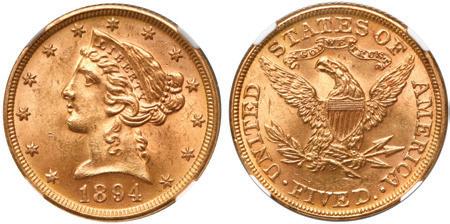


1219. USA (Philadelphia mint), gold $2-1/2 Coronet Liberty quarter eagle, 1854. 4.15 grams. AU with light cleaning, light redgold toning around the rims. Estimate: $300-$450.

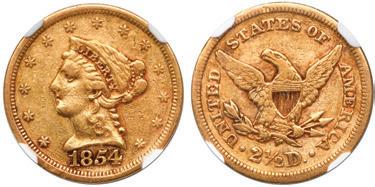
1220. USA (San Francisco mint), gold $2-1/2 Coronet Lib erty quarter eagle, 1857-S, NGC VF details / cleaned. A scarce, San Francisco-minted date with a mintage of just 69,200. Well detailed obverse for the grade, surfaces appearing to have more handling friction than actual cleaning. NGC #6474853-003. Estimate: $300-$450.
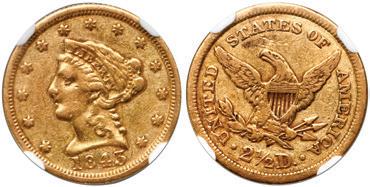
1221. USA (San Francisco mint), gold $2-1/2 Coronet Liberty quarter eagle, 1860-S, NGC VF details / cleaned. Another difficult San Francisco date struck just prior to the Civil War with a mintage of only 35,600 coins. Lightly polished surfaces from cleaning yet still well-detailed. NGC #6474853-001. Estimate: $500-$750.
1222. USA (San Francisco mint), gold $2-1/2 Coronet Liberty quarter eagle, 1860-S, NGC VF details / cleaned. As with the prior lot, the 1860-S quarter eagle mintage was a tiny batch of 35,600 coins. Very lightly cleaned with some marks behind Liberty’s hair bun, some russet gold toning around the devices. NGC #6474853-002. Estimate: $500-$750.
1223. USA (Philadelphia mint), gold $2-1/2 Coronet Liberty quarter eagle, 1878. 4.17 grams. XF with cleaned surfaces, small scratches on the bust and above the eagle, red-gold toning highlights around the devices. Estimate: $300-$450.
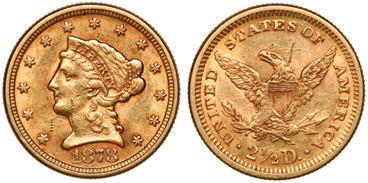


1224. USA (Philadelphia mint), gold $1 Indian Princess, 1854, Type Two. 1.65 grams. Popular first year of issue for this design. Detailed XF with surface hairlines from past cleaning. Estimate: $250-$375.
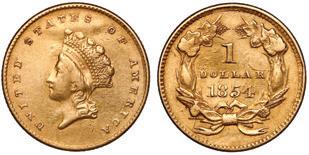
1225. USA (San Francisco Mint), Seated Liberty silver trade dollar, 1877-S, crafted into a box dollar. 18.64 grams. Box dollars like this were made using genuine Trade dollars found in circulation in the late 1800s, and it’s suggested some were sold as souvenirs during the 1893 World’s Fair in Chicago. This example is fully intact and works by pressing down on the date; the action of the hinge mechanism is smooth. Its interior is plain with a smaller circular compartment and three tiny screw holes. The coin itself grades VG+ with dark cameo contrast from circulation. Estimate: $300-$450.

1226. USA (San Francisco Mint), silver Morgan dollar, 1881S, NGC MS 65. Sharply struck with well-defined Liberty details and nearly prooflike fields (noticeable especially on the reverse), bright cartwheel luster on both sides, substantial hues of blue and red ton ing all over the obverse. NGC #6297015-002. Estimate: $125-$200.
1227. USA (New Orleans Mint), silver Morgan dollar, 1883O, PCGS MS65 (old green label). Superb blast-white surfaces with ample cartwheel luster across satin smooth fields, great eye appeal for the grade. PCGS #1418229. Estimate: $125-$200.
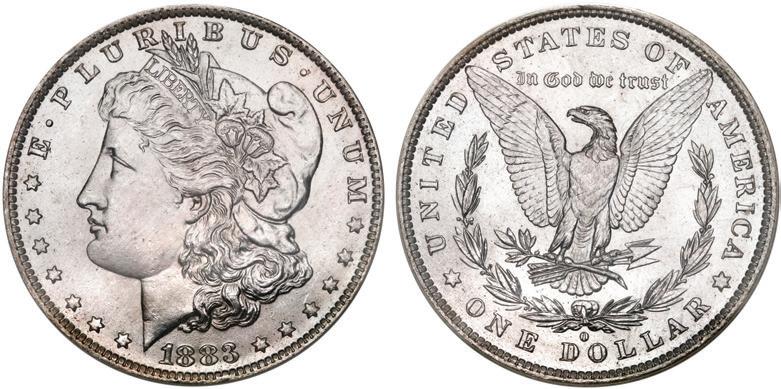
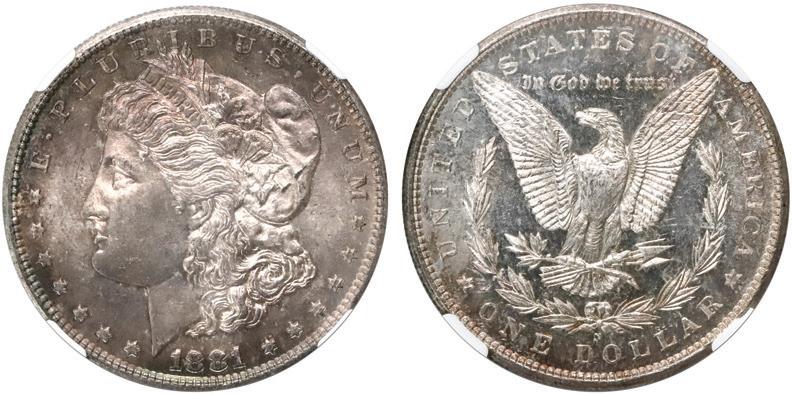
1228. USA (New Orleans Mint), silver Seated Liberty half dollar, 1846-O, medium date, WB-20, Doubled Die Obverse, PCGS XF40, only known example of this variety in the PCGS census. The first recognized example of this die pairing by PCGS, notable for the clear doubling along the ribbon near the base of the shield (Rarity 4 in Bugert). In our opinion, this piece is a bit under-graded as the surfaces exhibit substantial luster and the details for both Liberty and the eagle are especially sharp. The fields possess a dusty russet toning with more silvery-blue color around the devices. Excellent opportunity for the die variety collector. PCGS #41210300. Estimate: $500-$750.

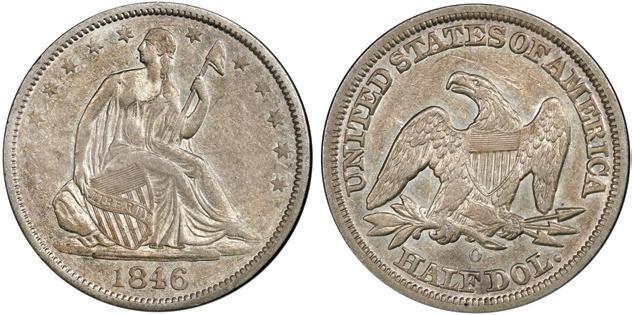

1229. USA (New Orleans Mint), silver Seated Liberty half dollar, 1853-O, arrows and rays, WB-21, PCGS VF detail / cleaned. Popular, one year design plus a tough die pairing listed as Rarity 3 in Bugert with clear die diagnostics including thick die crack through E in AMERICA. Possibly the only recognized example graded by PCGS as well. Nicely struck with light cleaning, certainly on the higher end of VF if not closer to XF with plentiful Liberty and eagle detail plus retained luster, some spots of dark red toning. PCGS #41210302. Estimate: $400-$600.
1230. USA (Philadelphia Mint), copper Fugio cent, 1787, four cinquefoils, pointed rays, STATES UNITED, NGC VF 30 Brown. Attractive example of this early American coinage designed by Benjamin Franklin himself. The obverse depicts a radiant sunface over a sundial with FUGIO and 1787 flanking and the motto MIND YOUR BUSINESS below; the reverse depicts a great chain of 13 links representing the 13 colonies around a ring with UNITED STATES and WE ARE ONE at center. Modestly circulated example with nice design details showing including especially bold date and FUGIO, great surface quality with rich dark brown toning around the legends and devices. NGC #6358465-001. Estimate: $1,000-$1,500.


1231. USA (Philadelphia mint), copper 1 cent, 1909 VDB, NGC MS 64 Red. Popular first date of the Lincoln cent design featuring engraver Victor David Brenner’s initials at bottom on reverse. Brilliant copper red surfaces with well struck details, nicer than the assigned grade suggests. NGC #5933564-023. Estimate: $100-$150.
1232. USA (Philadelphia mint), copper 1/2 cent, 1804, plain 4, no stems, die rotation error, NGC VF 35 Brown. Rich and even dark brown surfaces with nicely ren dered details showing off modest circulation for the grade, interesting 45-degree die rotation error. NGC #5933564-005. Estimate: $200-$300.
1233. USA, round California fractional gold token, dated 1858, Indian, wreath 4a, NGC MS 66 (“top pop”). 10.1 mm. Sharply struck token with golden luster throughout, tied with one other for finest known in the NGC census. NGC #5959573-008. Estimate: $200-$300.
1234. USA, octagonal California fractional gold token, dated 1858, Indian, wreath, 13 stars, NGC MS 65 (“top pop”). 9.6 mm. Small token with lustrous surfaces possessing spots of red-gold toning, tied with one other for finest known in the NGC census. NGC #5959573-007. Estimate: $200-$300.
1235. USA, octagonal California fractional gold token, dated 1860, Indian, wreath 4a, 13 stars, NGC MS 64, finest and only example in the NGC census. 11.3 mm. Well struck with bright, almost prooflike fields and ample die polish lines showing. NGC #6474853-006. Estimate: $200-$300.
1236. USA, octagonal California fractional gold token, dated 1860, Indian, wreath 4b, NGC MS 66. 9.8 mm. Gem example of this type with lustrous golden surfaces and nice design details. NGC #6474853-005. Estimate: $200-$300.
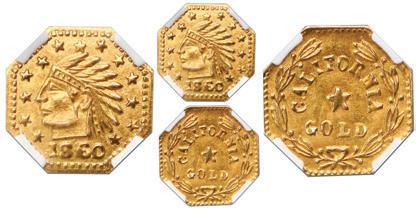
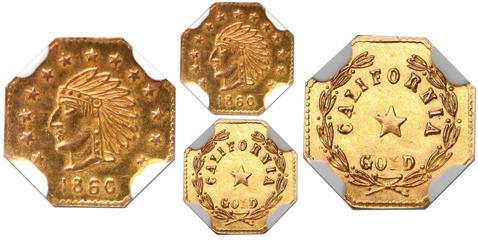

1237. USA, large high relief bronze medal, dated 1815 (struck ca. 1824), Major General Andrew Jackson / Battle of New Orleans, by Moritz Fürst. Julian-MI-15b. 130.17 grams; 65 mm. Obverse with high relief, uniformed bust of Andrew Jackson facing right with MAJOR GENERAL - ANDREW JACKSON around; reverse with Fame inscribing ORLEANS on to a tablet but stopped by Peace with RESOLUTION OF CONGRESS FEBRUARY 27. 1815. around, and BATTLE OF NEW-ORLEANS / JANUARY 8. 1815. in exergue. Choice UNC with rich brown surfaces. Estimate: $250-$375.
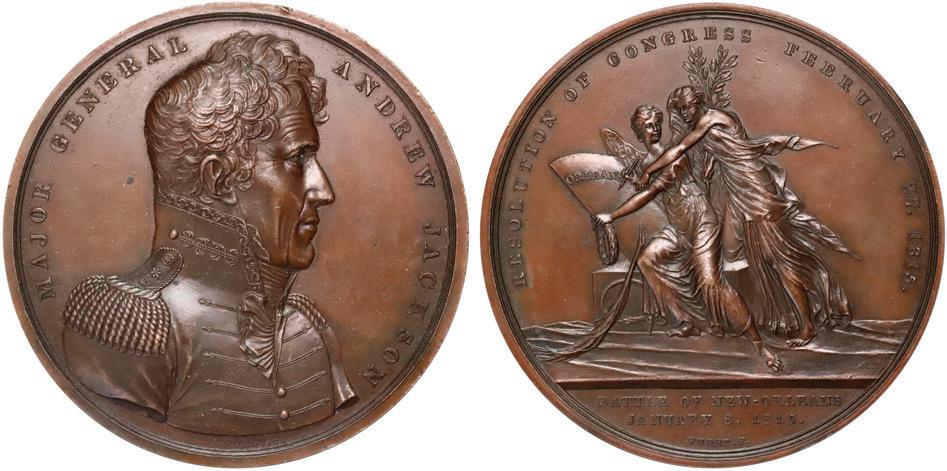
Any questions? Please email us at office@sedwickcoins.com or call (407) 975-3325
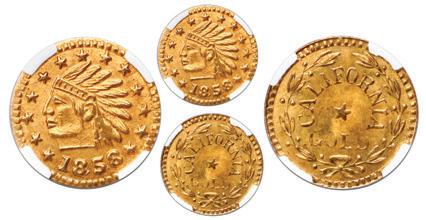
Manmade beauty comes in many forms. As numismatists we discern artistic beauty in a handheld piece of history. The beauty of a coin or medal starts with its engraver; next its striking, which is critical as a bad strike can ruin a beautiful design. Finally, the toning of the metal, which takes many years to happen, is a process over which we have much less control. For some pieces, there is one final distinction, a coup de grâce known as pedigree, for only a piece that was held and admired by the greatest collectors can have such psychological beauty.
When this medal was designed and struck sometime in 1852 to 1854 by Charles Cushing Wright, only a bronze version was advertised, first published in Norton’s Literary Letter in 1857. The first auction appearance of one of these bronzes (of which only two to four are known today), was in the Edward Cogan (Philadelphia) sale of March 25-26, 1862, from a collection billed as “The Property of a Private Gentleman [John K. Wiggan], Collected Without Regard to Expense,” lot 757, described as “extremely rare” (consider how many ten-year-old numismatic items today could be considered “extremely rare”). The next known auction offering of a bronze example was in June 20-24, 1882 (lot 1275), when the Chapman Brothers (Samuel Hudson Chapman and Henry Chapman, also in Philadelphia) handled the collection of the estate of Charles Ira Bushnell, the medal again described as “extremely rare,” but with a note that it was the same as the lot above it, lot 1274, in silver. That lot was the same silver piece you see now, with a brief description ending in “Silver. Proof. Unique in this metal.”

Why did they believe it was unique? The answer lies in the owner, Bushnell, who was a known patron of Wright’s work and presumably had it struck for himself as a specimen. It is inconceivable that the Chapmans would have made that assertion if Bushnell himself had not told them. Note it was also described as Proof by the Chapmans, another term that they would only state if true (a fact that was recognized by PCGS when this piece was graded as SP63 by that firm, its current designation of MS 62 by NGC a bit indefensible).
The design itself was not unique, however. Not only were there identical versions in bronze, as noted, but also its scene of the presentation of the draft of the Declaration of Independence to the Continental Congress on June 28, 1776 (based on the famous 1818 painting by John Trumbull that hangs in the rotunda of the U.S. Capitol and graces the back of our $2 bill) was used by Wright to make other medals with the bust of George Washington on the other side. It is interesting to note that even as long ago as 1882 the Chapman Brothers erroneously described this scene as the signing of the Declaration of Independence, whereas in fact the image shows the five-man drafting committee (consisting of John Adams, Richard Sherman, Robert R. Livingston, Thomas Jefferson, and Benjamin Franklin) presenting their draft to a seated John Hancock. Each man pictured in the scene was a real person, 47 in all, of which 42 were actual signers of the Declaration (fourteen signers were not depicted, as Trumbull could not find accurate likenesses of them, the remaining five “extras” being luminaries who were present for the debates but not for the signing). The scene itself, however, is a fantasy, as these 47 men were never all in that room at the same time, “that room” being none other than Independence Hall in Philadelphia. It is amazing how well the painting lent itself to a medal format, the depth of perspective and finely detailed portraits faithfully rendered down to the last detail, even showing the right foot of the preternaturally tall Jefferson almost stepping on the comparatively short Adams’ left foot, once believed to have been symbolic of their legendary post-Independence rivalry. Above the scene is DECLARATION / OF and below is INDEPENDENCE and the date of the signing, July 4, 1776.
The other side of the medal bears a square tablet with a veritable curriculum vitae of the United States, listing eighteen events that led up to the momentous occasion of our Independence, as follows:
DISCOVERY OF NORTH AMERICA BY THE ENGLISH.JLY.3.1497
DISCOVERY OF FLORIDA BY THE SPANIARDS.APRIL.6.1512
FIRST SETTLEMENT IN VIRGINIA. MAY. 23.1607
HUDSON RIVER DISCOVERED BY THE DUTCH.SEP.21.1609
DUTCH SETTLEMENT AT NEW YORK.1614
LANDING OF THE PILGRIMS AT PLYMOUTH.DEC.22.1620
FIRST WAR WITH THE INDIANS (PEQUOTS) 1637
UNION OF THE NEW ENGLAND COLONIES.MAY.29.1643
NEW YORK TAKEN BY THE ENGLISH.OCT.4.1664
WAR WITH THE FRENCH AND INDIANS.1754
TREATY OF PEACE BETWEEN FRANCE & ENGLAND.FEB10.1763
STAMP ACT PASSED IN ENGLAND.MARCH22.1765
STAMP ACT CONGRESS MEET AT NEW YORK.OCT7.1765
MASSACRE OF AMERICANS AT BOSTON.MARCH.5.1770
FIRST CONTINENTAL CONGRESS AT PHILADA SEP.5.1774
FIRST REVOLUTIONARY BATTLE AT LEXINGTON.APRL.19.1775
BATTLE AT BUNKERS HILL.JUNE.17.1775
ASSAULT ON QUEBEC BY AMERICANS.DEC.31.1775
Scenes at top and bottom depict a small boat of Europeans landing at a rocky promontory guarded by an Indian (often described as Columbus’ landing in the New World, but that is doubtful considering the list of events) above, and a wharf scene with building, ships and lighthouse at bottom (perhaps Boston Harbor, but the design of the lighthouse is different). As with the other side, the artistry is par excellence
Well designed and well struck, yes… but the third aesthetic factor is the icing on the cake: As a silver medal, this piece was subject to whatever mysterious chemical forces cause colorful toning on silver only, such that in the right light the surfaces positively radiate with a supernova burst of blue, green, purple and golden orange, all with underlying luster from proof-quality preparation. The wire rims are high, with just a small nick or two, and the struck details are thoroughly raised and devoid of weakness or wear. Much like the Liberty Bell, this gem bears a dignified flaw in the form of a meandering die-crack, from just right of the top to the middle on the reverse (considered a possible explanation for the extreme rarity of this issue), in addition to a small flaw or mark just to the right of the date 1643 and faint hairlines that any medal like this would have, all mere beauty spots on the alabaster countenance of a proper lady.
But as we said, there is one more quality that creates psychological beauty, a pride of ownership achieved by the desire to fight to own something so pleasing in artistry and preservation, namely its pedigree. Here we can trace this very same medal from its sponsoring first owner, Bushnell; thence to T. Harrison Garrett and his son, John Work Garrett, whose collection was sold by Bowers & Ruddy, this piece auctioned as lot 1910 in Part 4 (April 26, 1981); subsequently sold by Bowers & Merena as part of the Julian Leidman Collection on April 12, 1986 (lot 4126); next in the Charles A. Wharton Collection auctioned by Stack’s Bowers Galleries March 26-April 1, 2014 (lot 2077), where it was finally given the entire page it deserved; and finally the Stack’s Bowers auction of August 22, 2018, this time on the cover of the catalog and monopolizing two pages, as lot 46. The buyer in that auction was our own John Adams, in fact an indirect descendant of the John Adams who is shown “front and center” on this medal—what a fitting pedigree! But as any seasoned numismatist knows, it is not we humans but the items we collect that live on, and now this monumental opus will find a new home. Surely its next pedigree will be another name of collecting distinction.
Pedigreed to the John Adams Collection, with entire ownership pedigree dating back to Charles Ira Bushnell (Chapman auction of June 1882, lot 1274), Garrett Estate (Bowers & Ruddy auction of April 1981, lot 1910), Julian Leidman (Bowers & Merena auction of April 1986, lot 4126), and Charles A. Warton (Stack’s Bowers auction of March 2014, lot 2077), subsequently purchased by Adams in the Stack’s Bowers auction of August 2018 (lot 46). NGC #6481717-001. Estimate: $25,000-up.


1239. USA, small gilt bronze medal with original red ribbon, ca. 1869, George Washington / Lord’s Prayer, Golden Spike ceremony souvenir. Baker-651, GW-926. 1.56 grams. This small medal featuring the bust of Washington on one side and the Lord’s Prayer on the other was a souvenir from the Golden Spike ceremony connecting the Transcontinental Railroad held on May 10, 1869, at Promon tory Summit, Utah, according to the John W. Barriger III National Railroad Library. Choice UNC with golden luster. Estimate: $100-$150.

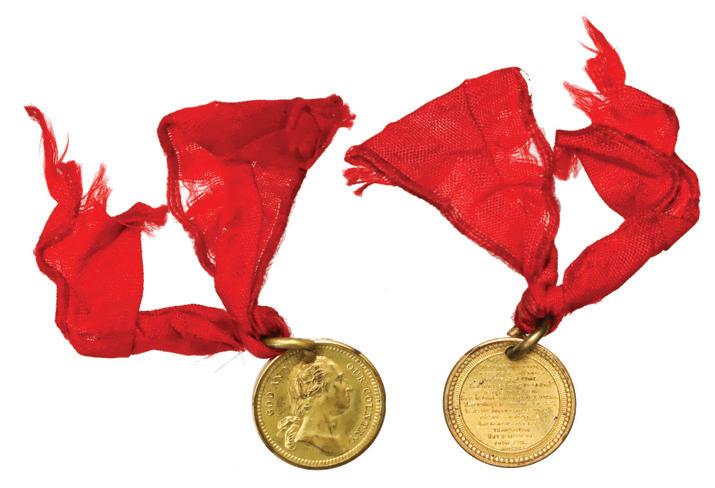
1240. USA, bronze military decoration, 1898, U.S Naval Campaign West Indies (Spanish-American War), awarded to Fireman Second Class George A. Hewitt of the battleship USS Indiana, with bars U.S.S. Indiana, San Juan P.R. (May 12), Santiago (June 22) (July 2) (July 4). 60.02 grams; 39 mm. Phase II Sampson medal (bust of Rear Admiral William E. Sampson on obverse, naval soldiers on reverse, SANTIAGO DE CUBA / JULY 2 in exergue), the edge engraved with GEORGE A HEWITT F. 2d. C. (the seaman this medal was presented to). The USS Indiana shelled the harbor of San Juan, Puerto Rico, on May 12th, then joined in the blockade of Santiago de Cuba in late June before playing a role on July 3rd in the decisive Battle of Santiago de Cuba. Choice condition with sharp high relief details and intact original ribbon. Estimate: $500-$750.


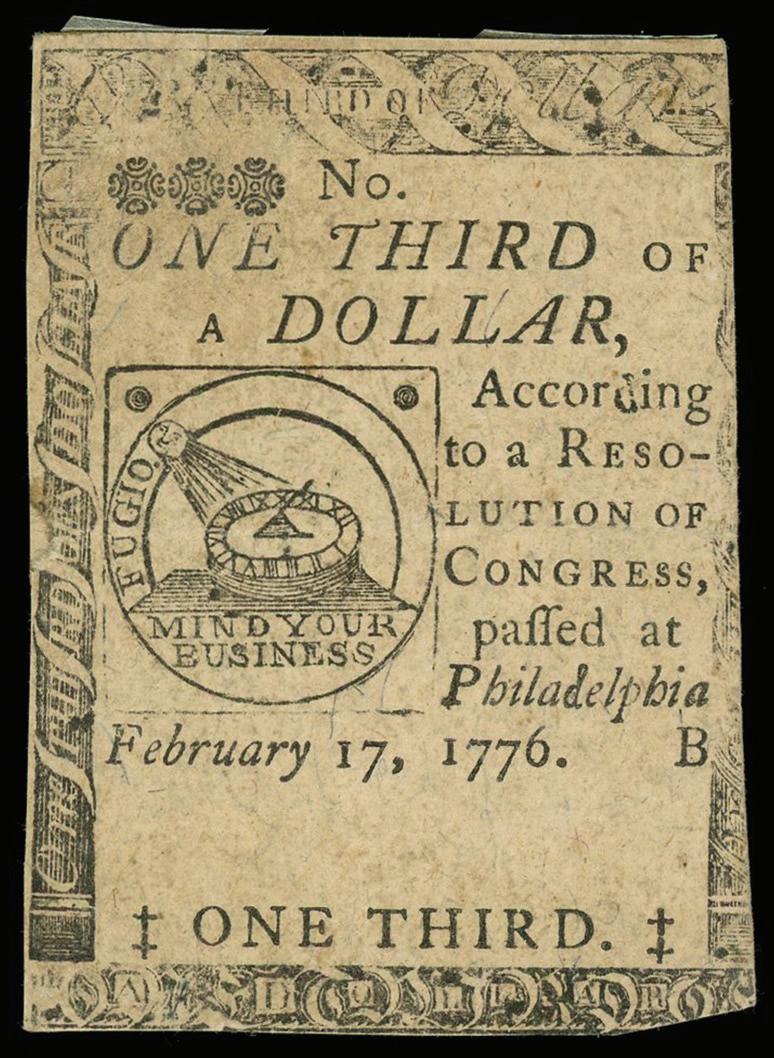
1241. South Carolina, 7 shillings 6 pence, April 10, 1778, serial 317. Fr-SC-148. A nice, XF example of this rare “beehive” note named for the vignette at lower right depicting bees buzzing around their hive. Fully framed with complete design visible unlike the New man specimen which had some design fading. Although the signatures are a little faded, they remain illegible. A single pinhole is noted at left and the back shows two mounting removal spots though these do little to detract from the eye appeal of this difficult South Carolina note. Estimate: $500-$750.
1242. Philadelphia, Continental Congress, $1/2, Feb. 17, 1776, serial 147397. Fr-CC-21. Bold example of this type using a design created by Benjamin Franklin and utilized on the Continental dollar. The obverse vignette depicts a sunface shining down on a sundial with the legend FUGIO to left and MIND YOUR BUSINESS below; the large reverse vignette depicts each of the colonies as links in a great chain around a radiant sun containing the legends AMERICAN CON GRESS and WE ARE ONE. Nice VF+ with good framing plus bold signature and serial, hinge mounts on back. Estimate: $700-$1,000.
1243. Philadelphia, Continental Congress, $1/3, Feb. 17, 1776, serial not visible. Fr-CC-20. As with the prior lot, this Con tinental $1/3 shares the same FUGIO and colonial chain vignettes designed by Benjamin Franklin. VF with faded signatures / serial yet boldly inked design, hinge mounts and a small stain on the back. Estimate: $200-$300.

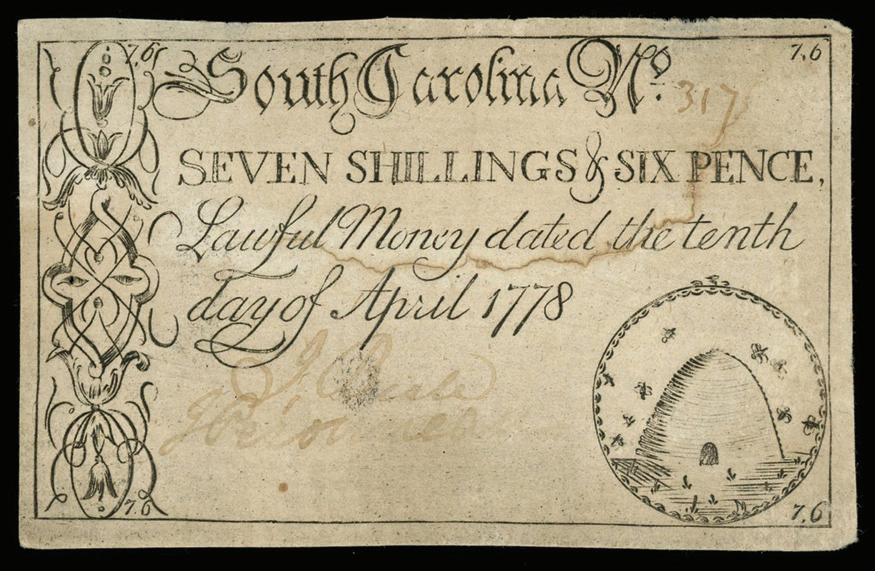
1244. New Haven, Connecticut, Elm City Bank, $1, Oct. 20, 1855, serial 9228, extremely rare. Haxby-CT275C2. A very rare note in any form; a status only reinforced by Haxby stating, “Surviv ing Example Not Confirmed.” Likewise, PMG has yet to grade an issued example of this denomination. The Elm City Bank of New Haven became the Second National Bank of New Haven in 1864; redemption of the Elm City Bank notes, in addition to usual loss or destruction, resulted in this important obsolete rarity. VF with bold signatures and serial, upper left corner missing, mounting remnants on the back. Estimate: $500-$750.
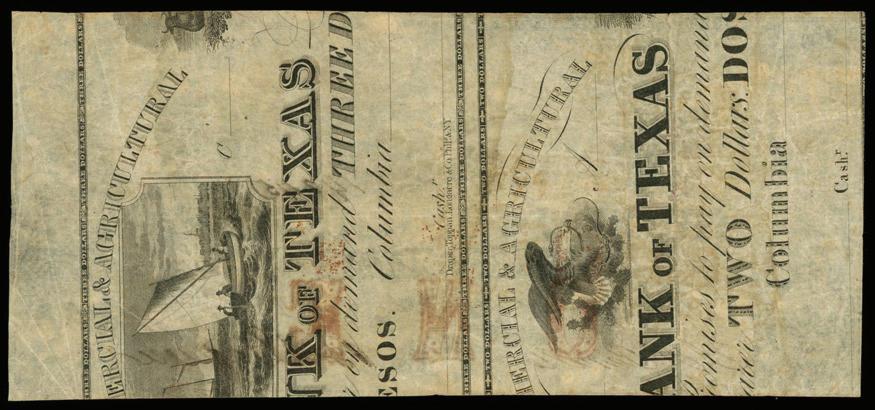
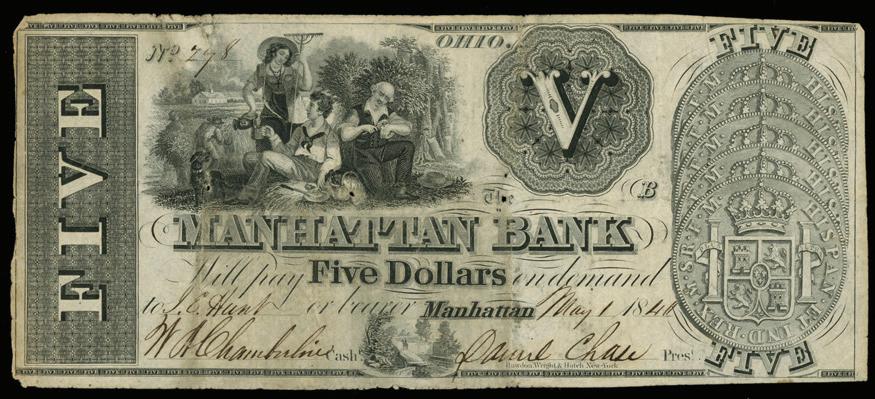

1246. Baton Rouge, Louisiana, State of Louisiana, $1, 242-1862, serial 14245, printed on Bank of Texas remainders. Interesting Civil War note printed on the back of uncut Commercial and Agricultural Bank of Texas remainders; the back of this note shows the centers of 2 dollars/2 pesos and 3 dollars/3 pesos notes. VF with bold ink colors. Estimate: $100-$150.



Louisiana
1245. Baton Rouge, Louisiana, State of Louisiana, $2, 242-1862, low serial 97, printed on Bank of Texas remainders. Interesting Civil War note printed on the back of uncut Commercial and Agricultural Bank of Texas remainders; the back of this note shows the rightmost side for two 2 dollars or 2 pesos notes. About VF with minor gutter fold error. Estimate: $100-$150.
1247. Wilmington, North Carolina, Bank of Cape Fear, $10, Oct. 1, 1855, serial 4502. Haxby-NC90G114a. In 1804, Bank of Cape Fear was the first bank to be incorporated in North Carolina; it would operate for 62 years before closing in 1866. About VF with nice eye appeal and framing. Estimate: $125-$200.

1248. Manhattan, Ohio, Manhattan Bank, $5, May 1, 1840, serial 278. A tougher Ohio obsolete note that should appeal to Span ish colonial collectors for the large vignette of five stacked Mexican bust 8 reales of assayer FM. VF, about 1” tear near top right corner, some pinholes. Estimate: $125-$200.
1249. Nashville, Bank of Tennessee, 5 cents, Dec. 1, 1861. Continuing the Spanish colonial coinage influence on American banknotes, this Civil War era Bank of Tennessee small change note bears a depiction of a Mexican bust 1/2 real of assayer TH. XF with hinge mounts on back, small stain in bottom left corner. Estimate: $125-$200.

1250. Jamaica, Vermont, West River Bank, $5 remainder, 1860s, PMG Choice AU 58 EPQ. Haxby-VT115G8b. The central vignette on this popular obsolete type depicts five cherubs playing on five Seated Liberty dollar coins, an element shared with the following three lower denominations. Very nice eye appeal and framing for this remainder with just a touch of handling in the upper left corners. PMG #2089276-001. Estimate: $125-$200.
1252. Jamaica, Vermont, West River Bank, $2 remainder, 1860s, PMG Choice UNC 64. Haxby-VT115G4b. Two cherubs fight around two Seated Liberty half dollars, one of which is dated to the 1850s. A single pinhole is noted in the upper left corner. PMG #2089276-003. Estimate: $125-$200.
1251. Jamaica, Vermont, West River Bank, $3 remainder, 1860s, PMG Choice AU 58 EPQ. Haxby-VT115G6b. Three cher ubs—Writing, Painting, and Sculpture—are shown amongst three Seated Liberty dollar coins on this odd denomination obsolete. Nicely margined note with no handling readily apparent. PMG #2089276002. Estimate: $125-$200.



1253. Jamaica, Vermont, West River Bank, $1 remainder, 1860s, PMG AU 53. Haxby-VT115G2b. A single cherub grasps an 1854-dated Seated Liberty half dollar on this obsolete with minor handling. PMG #2089276-004. Estimate: $100-$150.

1254. Washington D.C., Mercantile Bank, $2 remainder, no date (1860s). Haxby-DC27G4. Popular obsolete type from the nation’s capital which utilized a color fading technique to transition from red to green across the design. AU+ with spurious serial, date, and signatures, hinge mounts on back. Estimate: $125-$200.

1255. Austin, Republic of Texas, Treasury Department, $25 Texas Navy warrant, April 23, 1841, serial 1118, payable to chief engineer George Beatty of the steamship Zavala. According to Republic of Texas Navy records, George Beatty was the chief engineer on the Zavala, the first steamship-of-war in the Texas Navy. The Zavala was built in 1836 as the Charleston, then purchased by Texas in 1838, renamed, and armed; after two years of service, she was laid up and eventu ally sunk in Galveston. In 1986, the wreck of the Zavala was discovered by author and explorer Clive Cussler. AU with three crosscut cancellations as usual; bold ink signatures and decent paper quality. Estimate: $200-$300.
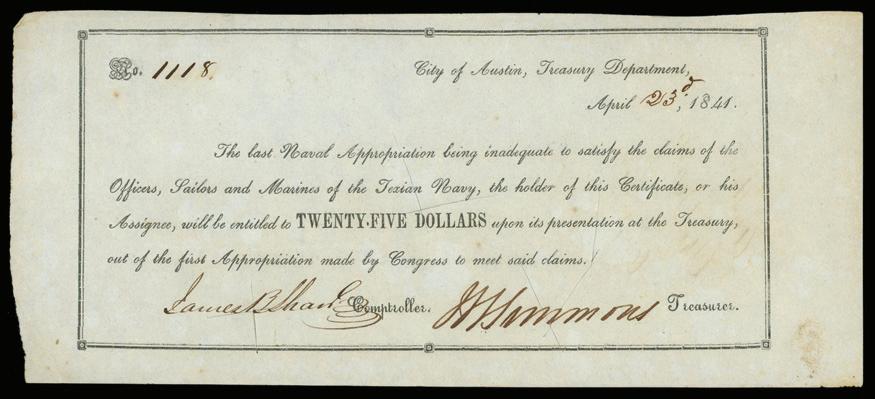
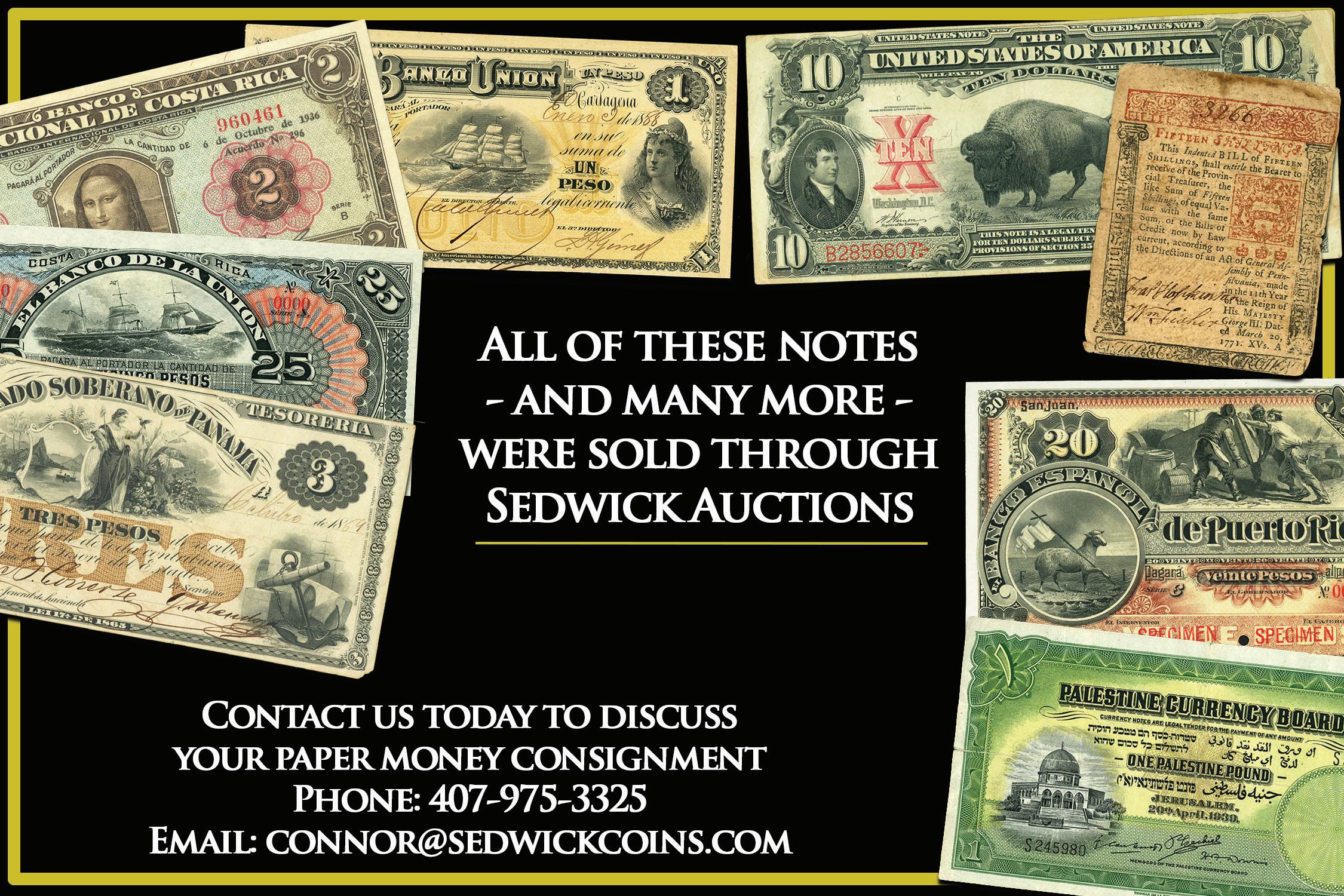
1256. Washington, D.C., USA, Federal Reserve Note, $5, series of 1914, serial B55889181B, White-Mellon. Fr-851a. Nice, well-centered VF note with great paper quality. Estimate: $100-$150.

1257. Rosario, Argentina, Banco del Rosario de Santa Fe, 1 real, 1-10-1869, serial 45760. SCWPM-S1851a. Tougher note denominated in reales; VF with some handling yet bold ink colors and serial. Estimate: $150-$225.


1259. Belgian Congo, Banque du Congo Belge, 100 francs, 13-3-1951, serial N532939, PCGS VF 20, finest and only known example in the PCGS census. SCWPM-17d. Circulated yet boldly colored note printed by Waterlow and Sons with a front vignette of people riding elephants, annotation noted on the reverse. PCGS #37397290. Estimate: $125-$200.

1258. Rosario, Argentina, La Caja de Ahorros, 1 real, 1870, with oval Monasterio y CA overprint on back. SCWPM-S1931; Bauman-SFE188b. Very tough note not priced in any grade in the Standard Catalog. AU with nice centering and margin, no problems. Estimate: $125-$200.
1260. Brazil, Banco Central do Brasil, specimen 1 cruzeiro, no date (1970), MODELO 002462 perforation, PMG Gem UNC 65 EPQ, finest known in the PMG census. SCWPM-191s2; CDB-C129m. Liberty head in brown, signatures of Antonio Delfim Netto and Ernane Galveas, with asterisk after serial number. A Gem note and deserving of the EPQ designation. PMG #1886484-002. Estimate: $100-$150.

1261. Bogotá, Colombia, Banco Nacional, 5 pesos, 28-101899, series E, serial 897233, PMG VF 30. SCWPM-255; DP-222. Printed by the Litografía Nacional as part of the third and final emis sion. Crude printing with inconsistent ink color yet all details fully visible, nice note with a few light stains but no major problems. PMG #8053596-005. Estimate: $125-$200.
1263. Barranquilla, Colombia, Banco de Barranquilla, 50 pesos, 26-7-1900, series O, serial 14575, PMG Very Good 8 net / paper damage, tape, ex-Eldorado. SCWPM-S260; DP-6140. Very rare note from this issuer and in a typical condition for Colom bian bills of this time period. Notes from Colombian private banks in the early 1900s were traded often and printed on sub-par paper, hence most rare types are seen with heavy circulation. PMG holder notes paper damage and tape. Still possesses colorful ink, the serial and signatures faded yet with serial number fully visible. Pedigreed to the Eldorado Collection. PMG #8044294-014. Estimate: $300-$450.
1262. Bogotá, Colombia, República de Colombia, 10 pesos oro, 1-1-1928, series N, serial 0993784, PMG VF 25. SCWPM373b. Circulated yet still colorful with bold inking throughout; a scarce type note that was denominated in gold pesos. PMG #8059653-007. Estimate: $125-$200.


1264. Barranquilla, Colombia, Banco de Barranquilla, 20 pesos, 26-7-1900, series P, serial 05638, very rare, PMG Good 4 net / paper damage, tape repairs, ex-Eldorado. SCWPM-S258, DP-7497. Colombia private bank issues of 1900 are typically heavily circulated. PMG holder mentions paper damage and tape repairs as some interior splits have been repaired with paper on the reverse. Oth erwise, the ink colors are still bold and the serial number, while faded, is still visible. Printed by local printer Armenta & Prieto. Pedigreed to the Eldorado Collection. PMG #8044294-013. Estimate: $800-$1,200.
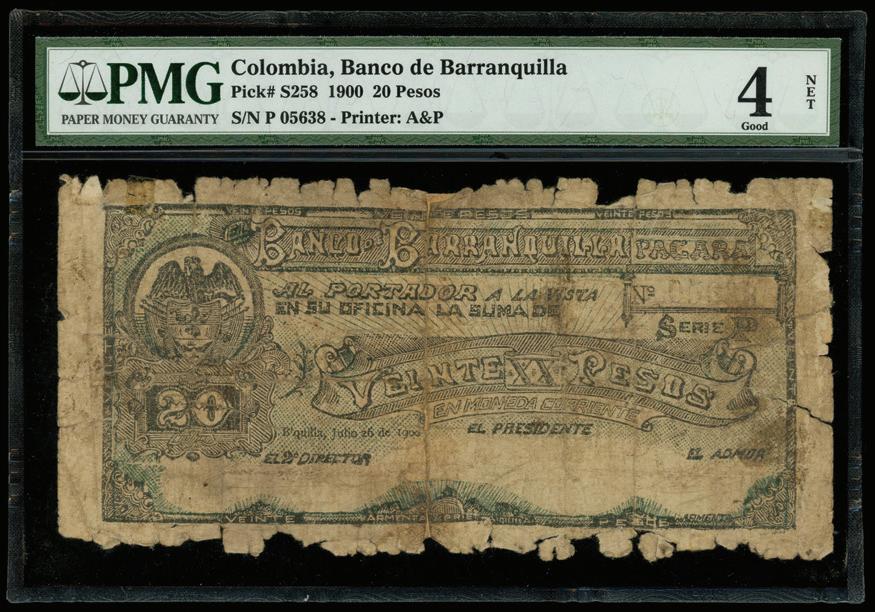
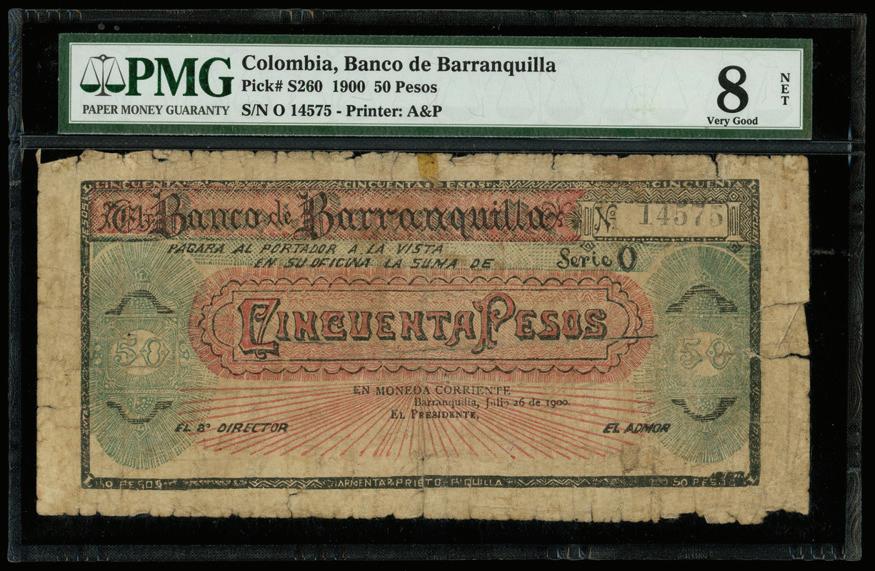

1265. Medellín, Colombia, Correos Nacionales, certificación con contenido, 50 centavos, 14-5-1876. AU with two pinholes at left, very popular design with bold, colorful Colombian flag. Estimate: $100-$150.

1266. Sogamoso, Colombia, Banco de Sogamoso, 50 pesos remainder, 15-8-1882, series D, serial 0610, PMG AU 50. SCWPM-S844r; DP-7700. Highest denomination printed for this private bank; Parra notes this issue is only known in remainder form. Nicely centered with bold ink colors throughout its design, some paper ton ing. PMG #8044303-014. Estimate: $250-$375.
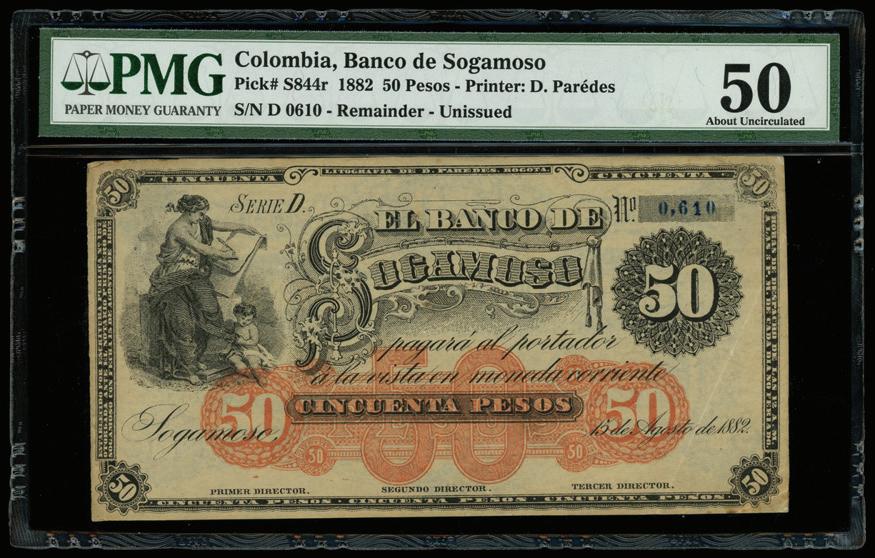
1267. Costa Rica, 1000 colones reverse paired with a Venezuela, Banco Central, 10 bolívares progress proof dated 18-31986, PMG Gem UNC 65 EPQ. SCWPM-256a (Costa Rica), 61a (Venezuela). Fascinating printer’s scrap or test piece with two different country’s bank note designs combined into one note! Colorful design (for both countries) with excellent paper quality. PMG #1619894-003. Estimate: $500-$750.


1268. Cuba, República de Cuba, 1000 pesos, 6-9-1869,
ex-EMO
Carlos Manuel de Céspedes whose
lower left
of Cuba
In 1873, Céspedes was
from his posi tion; Spanish troops eventually caught and killed him on Feb. 27th, 1874. This large format 1000 pesos note is the highest denomination issued for the series. It faces up nicely for its assigned grade with bold ink signatures and great centering, the margins are toned from age rather than staining as noted by the PMG comment. Pedigreed to the EMO collection (stated on the label). PMG #8006670-002. Estimate: $1,000-$1,500.


1269. Cuba, Junta Central Republicana de Cuba y Puerto Rico, 10 pesos, 1869, serial Z 1257, PMG VF 25 net / previously mounted, toning, ink burn, ex-EMO collection. SCWPM-63. The Junta Central Republicana de Cuba y Puerto was a New York City-based revolutionary group formed to support Cuban and Puerto Rican independence from Spain; the signatures of the group’s president, José Morales Lemus, and its secretary, Dr. José Francisco Basora, are found on the lower right. They were arrested shortly after issuing these notes for violating US neutrality laws. Circulated yet possessing a bold green design with seal at lower left faded yet signa tures quite illegible, toned paper with small ink burn in top margin, light mounting remnants on back. Rare high denomination note that is not priced above Fine in the Standard Catalog. Pedigreed to the EMO collection (stated on the label). PMG #8009194-009. Estimate: $1,500-$2,250.

1270. Cuba, Junta Central Republicana de Cuba y Puerto Rico, 5 pesos, 1869, serial L 4517, PMG VF 30, ex-EMO collection. SCWPM-62. Boldly printed with clear red seal at lower left (difficult to find on this series of notes) and clear signatures, nice paper quality and color. Pedigreed to the EMO collection (stated on the label). PMG #8009194-005. Estimate: $200-$300.

1271. Guayaquil, Ecuador, Banco Comercial y Agrícola, 1 sucre, 15-7-1917, series AG, serial 386470. SCWPM-S126b. Somewhat tougher ABNCo-printed Ecuador private bank note. VF with nice ink colors throughout, small stain in upper left margin. Estimate: $100-$150.
1272. Falkland Islands, 5 pounds, 30-1-1975, Elizabeth II, serial C62657, PMG Gem UNC 66 EPQ. SCWPM-9b. Vibrant, contrasting red/green ink colors, good embossing, and great original paper quality. PMG #1741373-006. Estimate: $400-$600.


1273. Guatemala, Banco Agrícola Hipotecario, 1 peso, 30-61920, serial 1616416, PMG Choice UNC 64. SCWPM-S101b. A very beautiful note from this private Guatemalan bank with gorgeous pink and baby blue undertones on the front populated with several large vignettes while the reverse bears the large portrait of a woman crafted in bold red ink. PMG #2021536-002. Estimate: $200-$300.

1274. Guatemala, Banco Agrícola Hipotecario, 1 peso, 306-1920, serial 1616417, PMG Choice UNC 64. SCWPM-S101b. Consecutive example to the prior lot with well-crafted and colorful design by Waterlow & Sons for this private Guatemalan bank. PMG #2021536-003. Estimate: $200-$300.
1275. Haiti, Republique d’Haiti, 2 gourdes, 22-12-1914, series AA, serial 195094, PMG Fine 12. SCWPM-132a. Moderate circulation wear, common for Haitian notes of the time period, but overall intact paper quality. PMG #1743585-004. Estimate: $250$375.

Honduras
1276. Trujillo, Honduras, Aguan Navigation and Improvement Company, 5 pesos, 25-6-1896, serial A2995. SCWPMS104. The Aguan Navigation & Improvement Company attempted to build an Atlantic-Pacific canal through Honduras but folded before the project could be realized. Many high denomination notes issued by the company are scarce today due in part to redemption. F/VF with some pinholes, minor rust stain on back margin. Estimate: $350-$500.

1277. India (British), Reserve Bank, 5 rupees, no date (1937), George VI, serial J/33 640247, PMG Choice UNC 64. SCWPM-18a. Bust of King George VI, at that time the Emperor of India. Well-centered design, two staple holes in left margin. PMG #2510148-002. Estimate: $100-$150.

1278. Iran, Bank Melli, 10 rials, AH1320 (1937), serial A/K 290453, blue date stamp on back, PMG Choice UNC 64. SCWPM-33Ac. Bold design with choice margins, bust of Reza Shah to right (forced to abdicate in 1941 by British and Russian forces). PMG #8089103-081. Estimate: $100-$150.
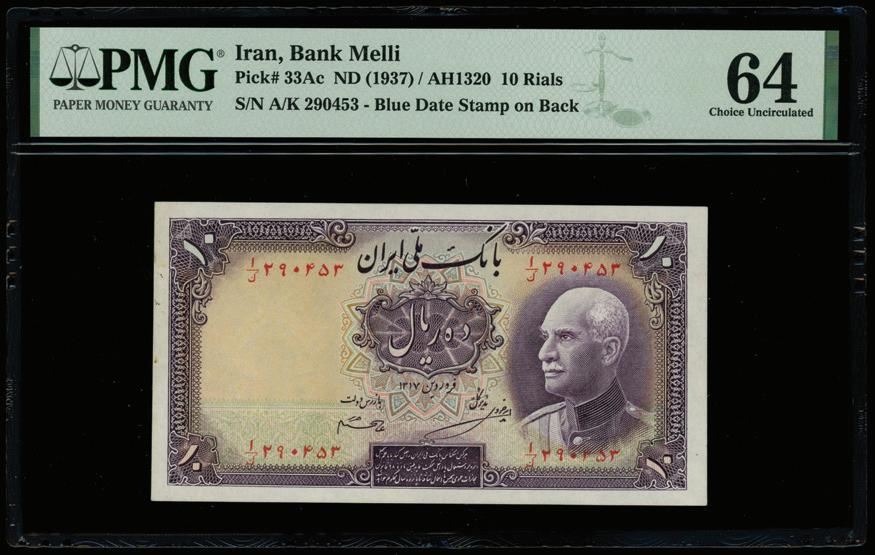
1279. Nicaragua, Banco Central, 500 córdobas, 6-8-1984, series F, serial 0000095, PMG Gem UNC 66 EPQ. SC WPM-142. Nice, low serial number on this gem Nicaraguan note. PMG #8067298-003. Estimate: $100-$150.
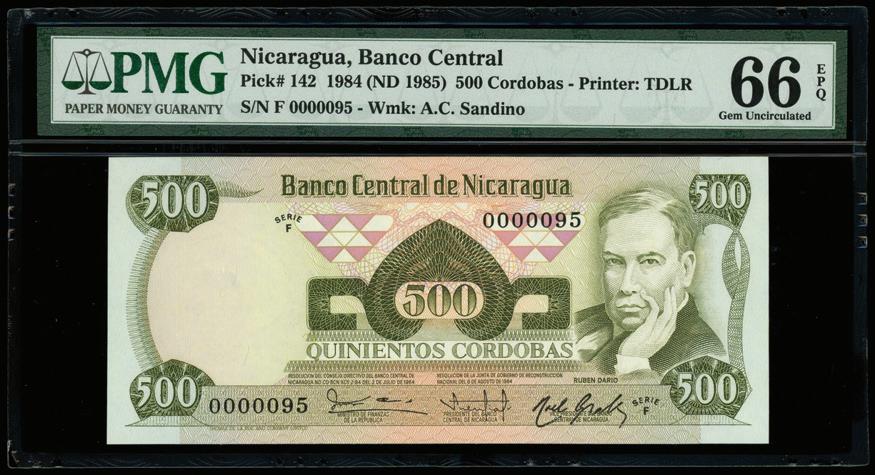

1280. Panama, specimen $1,000 35-year 6½-percent external secured gold bond, 1-6-1926. Unsigned bond specimen dated 1926 and due in 1961. Nice paper quality with strong embossing and color, light staining around edges, folded in center. Estimate: $250-$375.

1281. Paraguay, Tesoro Nacional, 4 pesos, (1865), serial 53542, PCGS Choice UNC 63. SCWPM-24. Strong, well-inked blue design with wide margins cut somewhat unevenly as is typical for this type, which is among the first banknotes of Paraguay. PCGS #42600285. Estimate: $100-$150.
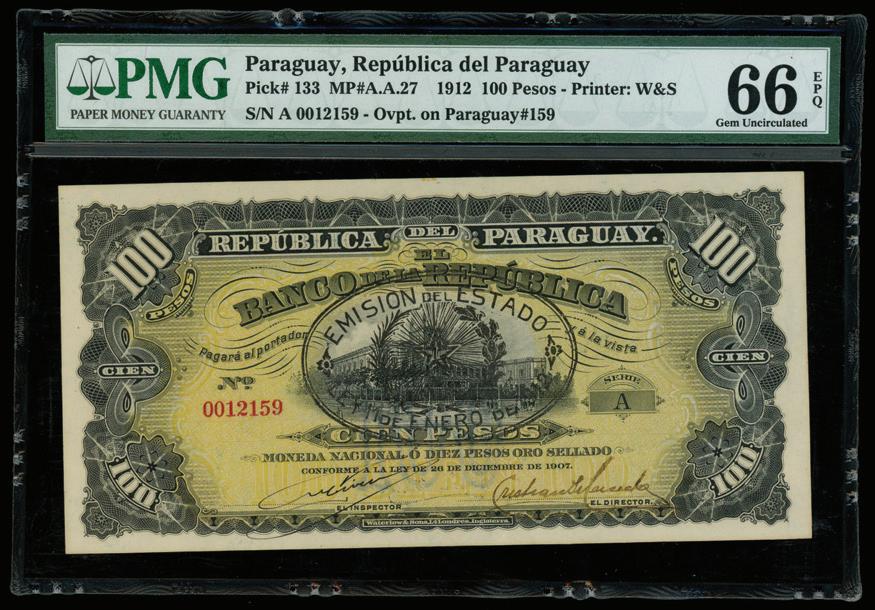

1282. Paraguay, Tesoro Nacional, 2 reales, no date (1865), serial 94654, PCGS XF 40. SCWPM-19. Bold black design on nice paper featuring a cross watermark, nice margins and sharp edges, nice eye appeal for the grade. PCGS #59051519. Estimate: $100-$150.
1283. Paraguay, República del Paraguay, provisional 100 pesos, 26-12-1907, serial 0012159, with black oval overprint dated 11-1-1912, with Junta Fiscalizadora overprint on back, PMG Gem UNC 66 EPQ, “top pop.” SCWPM-133; MP-A.A.27. Wellcentered design with good margins, great paper quality with substantial paper wave and embossing visible. Tied with two others for finest known in the PMG census. PMG #1720765-021. Estimate: $200-$300.

1284. Paraguay, República del Paraguay, provisional 100 pesos, 26-12-1907, serial 0026431, with black oval over print dated 11-1-1912. SCWPM-134. Boldly printed UNC note with strongly embossed design and clear overprint, small spot in right margin. Estimate: $100-$150.

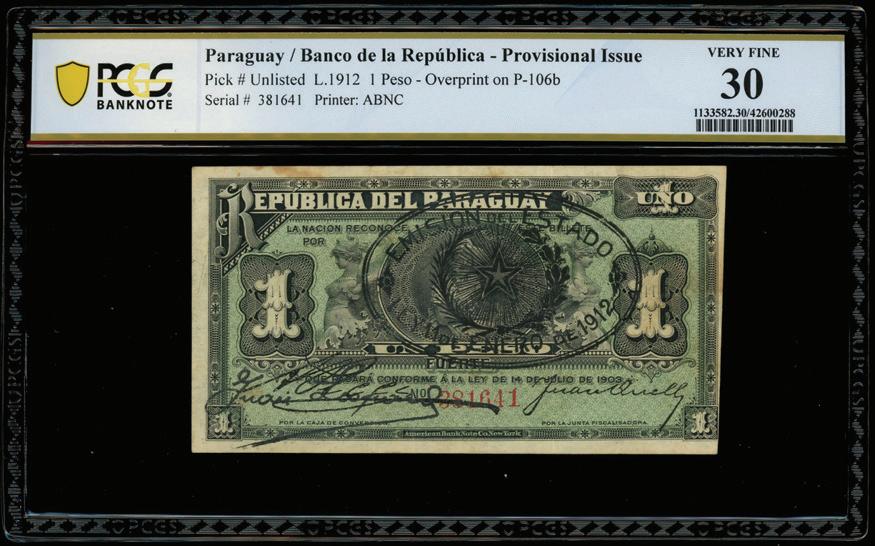

1285. Paraguay, República del Paraguay, front and back 50 pesos proofs on cardstock, 18-11-1899, rare. SCWPM-101p. Rare, American Bank Note Company produced proofs for Paraguay’s 50 pesos note of 1899. AU with minor handling in the margins (more so on the reverse proof than the other), nice embossing seen through the cardstock. Estimate: $150-$225.

1286. Paraguay, República del Paraguay, provisional 1 peso, 14-7-1903, serial 381641, with black oval overprint dated 11-1-1912, PCGS VF 30, finest and only known example in the PCGS census. SCWPM-unlisted. A very rare discovery piece with bold 1912 overprint on the front of a 1903-dated 1 peso fuerte. Prior to seeing this note, the 2 pesos with overprint was the smallest denomination known for this provisional series; thus, the Standard Catalog currently has no classification number for this type. Modestly circulated with minor stains in the upper margin, very bold overprint and signatures. PCGS #42600288. Estimate: $200-up.
1287. Paraguay, Banco Central del Paraguay, 50 guaranies, 25-3-1952 (1963), serial A6466025, with additional inverted signatures error, PCGS Gem UNC 66 PPQ. SCWPM-197b. A Gem error note with bold inverted signatures across the bank’s title at top. PCGS #43495311. Estimate: $125-$200.
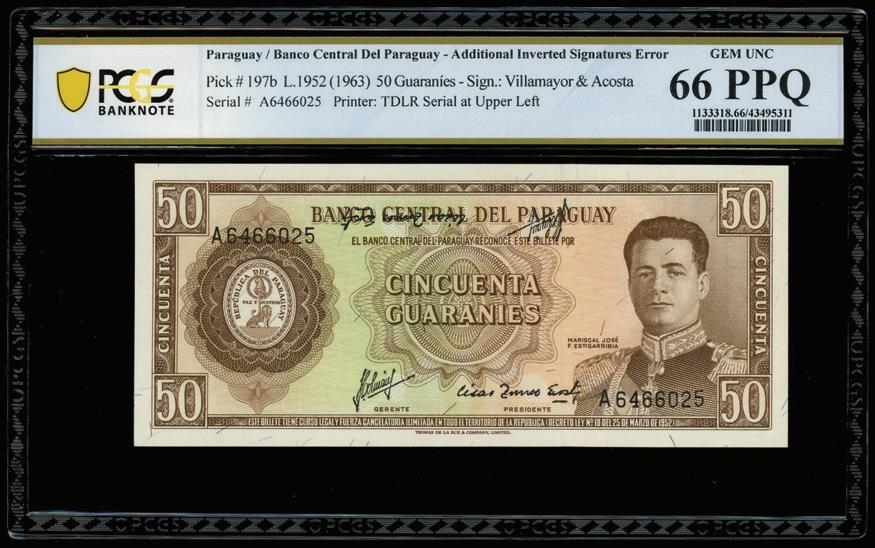
1288. Asunción, Paraguay, Lezica y Lanus, 50 centimos remainder, no date (187X), PMG Choice UNC 64 EPQ. SCWPM-S181r; MP-P.P.1r. Black ink design featuring a resting dog as its central vignette printed on dark blue paper. Choice note with some wide margins. PMG #1886484-005. Estimate: $150-$225.
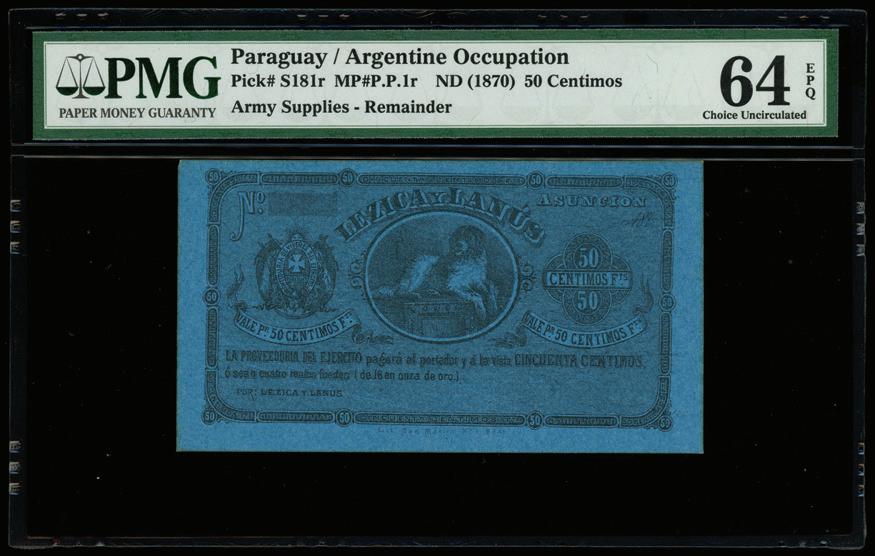
1289. Lima, Peru, Junta del Crédito Nacional, 200 pesos, 16-11-1836, serial 18791. Among the first payment documents of the relatively young Republic of Peru. Large Peruvian coat of arms at top along with embossed stamp at bottom plus two black printed stamps, multiple signatures at bottom along with several penned an notations on back. VF+ with punch hole cancellation at center, three pinholes, toned paper. Estimate: $100-$150.
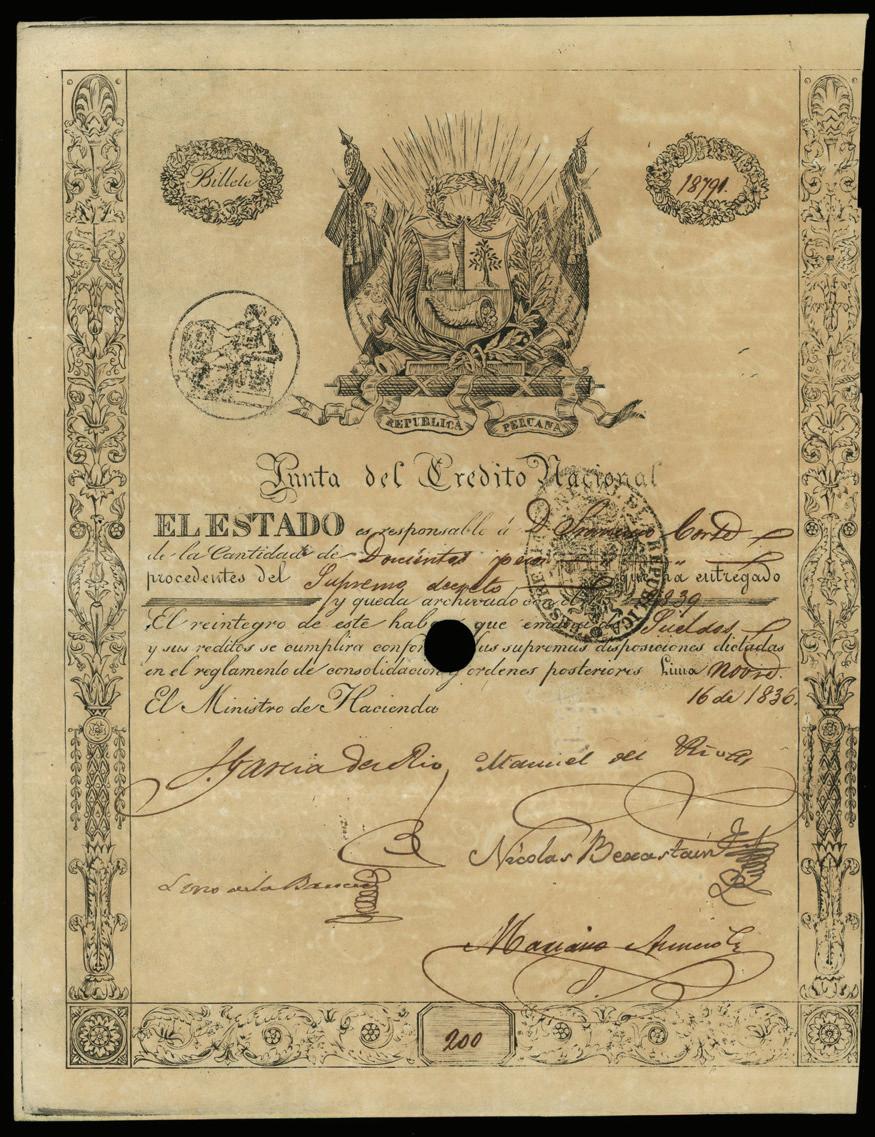
1290. Caracas, Venezuela, Banco Central, 500 bolívares, 23-7-1953, serial B980382, PMG VF 20. SCWPM-37b. Highest denomination issued for this series. Evenly circulated with bold ink colors. PMG #1523629-015. Estimate: $125-$200.
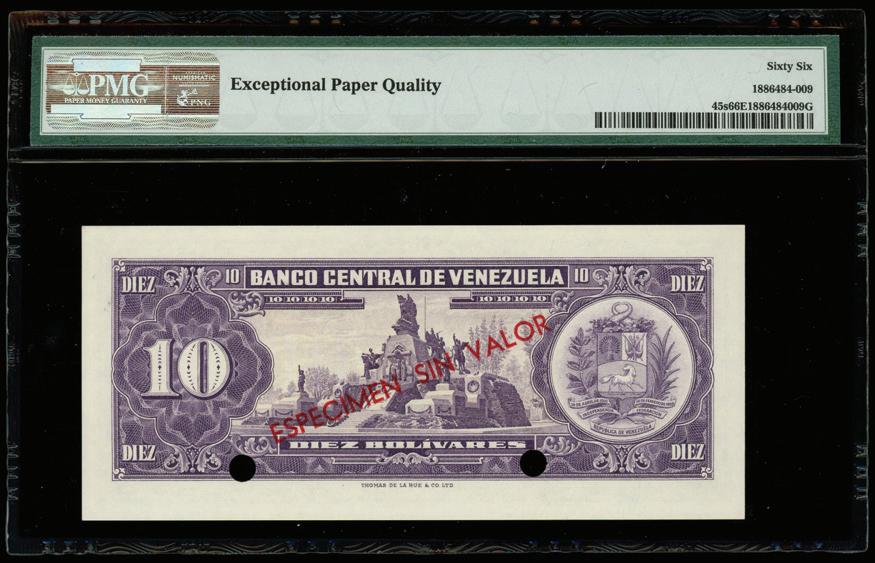

1291. Caracas, Venezuela, Banco Central, 10 bolívares speci men, (1963-70), PMG Gem UNC 66 EPQ. SCWPM-45s. Two POCs. Bold and well centered design with busts of Bolívar (at left) and Sucre (at right), red ESPECIMEN SIN VALOR overprint across both sides. PMG #1886484-009. Estimate: $100-$150.


1292. Lima, Peru, gold cob 8 escudos, Philip V, assayer M (date not visible, 1720s), mounted pillars-side out in 18K gold pendant with snap-close bail. 38.29 grams total. Interesting multi-layer round bezel (not contour-mounted) with three fleur-type prongs and larger bail (snap-close type) around a lightly toned XF coin with bold denomination and assayer and tops of pillars but rest of coin double-struck, to the extent that the date is unclear. Estimate: $6,000-$9,000.
1293. Bogotá, Colombia, gold cob 2 escudos, Charles II posthumous, no assayer (Arce), ex-1715 Fleet, mounted shield-side out in fancy 14K gold anchor pendant. 12.89 grams total. Ornate pendant consisting of rope-wrapped anchor fluke at bottom and double-headed sea serpent at top, the coin itself inside a contour mount with four small prongs in front, all around a typical “Bogey” whose cross is off-center but with nearly full shield, mounted 90 degrees counterclockwise. From the 1715 Fleet, with Mel Fisher photo-certificate GS-347. Estimate: $2,500-$3,750.

Atocha, sunk in 1622 west of Key West, Florida
1294. Potosí, Bolivia, cob 8 reales, Philip III, assayer R (curved leg), Grade 1, ex-Atocha (1622), mounted cross-side out in ornate 18K gold pendant with diamonds embedded in skull design at top, swivel bail. 35.23 grams total. Choice coin with full and uncorroded cross-lions-castles and shield with P-R to left (assayer not mentioned on tag or certificate), mounted 90 degrees clockwise in a flat round bezel with engraving on back and sides, appliques on front including scrolls, stars and skulls, with larger skull at top bearing VVS diamonds for eyes. From the Atocha (1622), with original Fisher tag and certificate 85A-175291. Estimate: $1,500-$2,250.

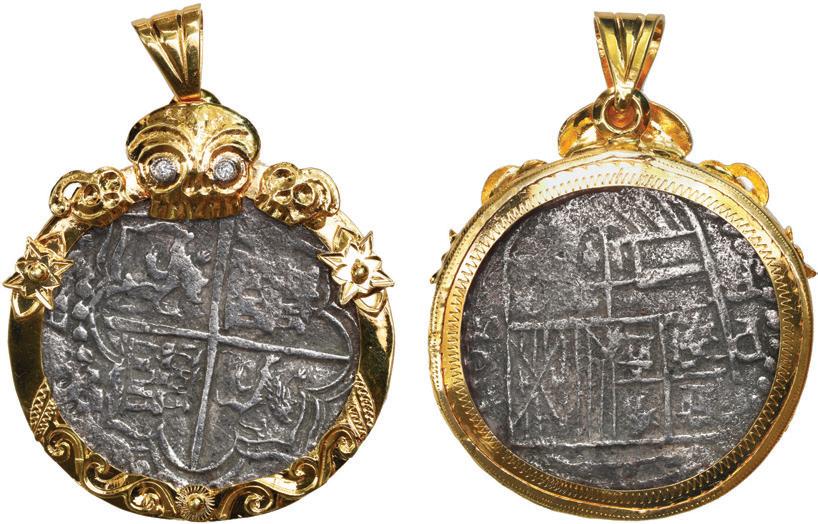

1295. Potosí, Bolivia, cob 8 reales, Philip III, assayer Q, Grade 1, ex-Atocha (1622), mounted cross-side out in heavy silver pendant with 14K gold prongs, shackle bail and pirateface embellishments. 35.41 grams total. Smooth and nearly round silver bezel with gold pirate face at bottom and two prongs near top, the coin itself with off-center cross (mounted 90 degrees clockwise) but nice full shield with clear P-Q, nicely toned. From the Atocha (1622), with original Fisher certificate 85A-155966 (tag missing). Estimate: $1,250-$2,000.



1297. Potosí, Bolivia, cob 8 reales, Philip III, assayer T, Grade 1, ex-Atocha (1622), mounted cross-side out in custom 14K gold-wire pendant with shackle bail. 33.10 grams total. Aged mounting with tendrils of gold wire surrounding the choice coin with full and bold shield, clear P-T and o-VIII, full but slightly doubled cross on back (in X pattern), held in with four tiny prongs, the extrawide gold-wire bail at top continuing the rustic look. From the Atocha (1622), with original Fisher photo-certificate 85A-300321 (tag missing). Estimate: $1,250-$2,000.

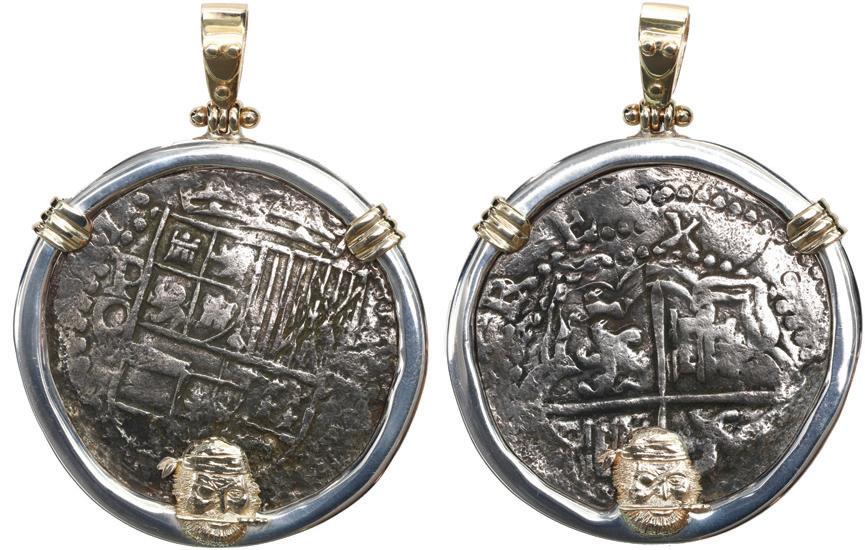
1296. Potosí, Bolivia, cob 8 reales, Philip III, assayer Q, Grade 4, ex-Atocha (1622), mounted in 14K gold pendant with shackle bail. 21.95 grams total. Brightly cleaned coin with faint outlines of cross and shield mounted with shield side up and cross side in X pattern in a wide, flat, custom, contour-mounted gold setting. From the Atocha (1622), with Fisher and photo-certificate 01A-62183 (tag missing). Estimate: $350-$500.
1298. Potosí, Bolivia, cob 8 reales, Philip III, assayer T, Grade 2, ex-Atocha (1622), mounted cross-side out in heavy silver pendant with 14K gold prongs, shackle bail and pirateface embellishment. 41.93 grams total. Very smooth round-gauge mount with prongs at two and six o’clock, the pirate face at ten, with good full shield and cross (mounted 90 degrees counterclockwise), minor corrosion only (choice for the assigned Grade). From the Atocha (1622), with original Fisher tag and certificate 85A-264712. Estimate: $1,000-$1,500.
1299. Potosí, Bolivia, cob 8 reales, Philip III, assayer T, quad rants of cross transposed, Grade 2, ex-Atocha (1622), mounted cross-side out in heavy silver pendant with 14K gold prongs, shackle bail and pirate-face embellishment. 38.72 grams total. Smooth, contour-mounted bezel with prongs at two, six and ten o’clock, pirate face at five, the coin with bold full shield and cross (which is mounted 90 degrees clockwise), with fairly clear denomination o-VIII and mintmark-assayer P+T (assayer not mentioned on tag or certificate). From the Atocha (1622), with original Fisher tag and certificate 85A-159939. Estimate: $900-$1,350.
1300. Potosí, Bolivia, cob 8 reales, Philip III, assayer not visible, Grade 4, ex-Atocha (1622), mounted in 14K gold pendant with shackle bail. 25.56 grams total. Partially corroded cross and shield with few visible details, the jagged edges of the coin exaggerated by the wide, flat, custom, contour-mounted setting. From the Atocha (1622), with Fisher and photo-certificate 99A-56996 (tag missing). Estimate: $300-$450.
1302. Mexico City, Mexico, cob 2 reales, Philip IV, assayer not visible, ex-Concepción (1641), mounted cross-side out in 14K gold pendant with fixed bail. 10.86 grams total. Cool-shaped coin with many angles mounted in custom, flat-edged gold bezel. From the Concepción (1641). Estimate: $400-$600.
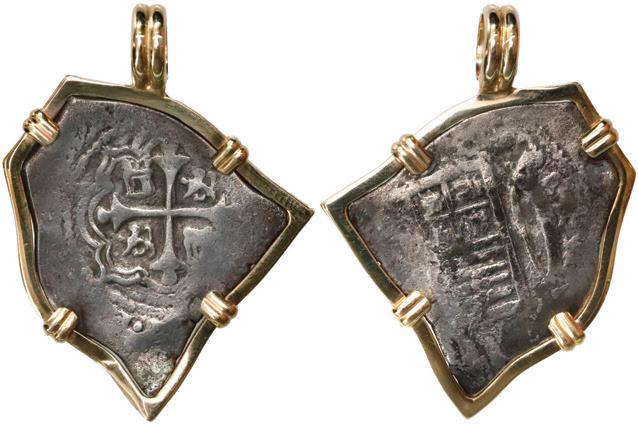
1301. Potosí, Bolivia, cob 2 reales, Philip III, assayer not visible, Grade 3, ex-Atocha (1622), mounted cross-side out in ornate 18K gold pendant with diamonds embedded in skull design at top, swivel bail. 11.38 grams total. Unusual locketlike mounting in bright gold with intricate engraving, the coin deeply toned and somewhat pitted though cross and shield are visible, oriented in mount with cross as an X and two VVS diamonds as eyes on skull. From the Atocha (1622), with original Fisher certificate 85A-126094 (tag missing). Estimate: $800-$1,200.

1303. Potosí, Bolivia, cob 8 reales, 1654 E, •PH• at top, ex-Capitana (1654), mounted pillars-side out in custom sterling silver twisted-wire bezel with a double antique dolphin embellishment. S-P37a; KM-21. 36.40 grams total. Struck on a choice large flan with full cross and shield details, mounted in an unusual silver twisted-wire setting, dolphin embellishments on either side which double as prongs. From the Capitana (1654), with photo-certificate. Estimate: $600-$900.


1304. Mexico City, Mexico, cob 8 reales, Philip IV, assayer not visible (P), ex-Maravillas (1656), mounted cross-side out in heavy silver pendant with 14K gold prongs, shackle bail and pirate-face embellishment. 37.29 grams total. Heavy custom silver and gold mounting around a somewhat oblong, corroded coin with some cross and shield visible, pirate-face embellishment at bottom right. From the Maravillas (1656), with original MAREX tag 91-8R1074. Estimate: $250-$375.

1305. Mexico City, Mexico, cob 8 reales, Philip V, assayer not visible (J), ex-1715 Fleet, mounted cross-side out in heavily silver pendant with 14K gold prongs, shackle bail and pirate-face embellishment. 40.72 grams total. Oval-shaped coin with some cross and shield visible, dark toning at top of shield, heavy custom silver-and-gold bezel, pirate-faced embellishment at bottom right. From the 1715 Fleet, with photo-certificate. Estimate: $250-$375.

1306. Mexico City, Mexico, cob 4 reales, Philip V, assayer J (“new” style of 1714-5), ex-1715 Fleet, mounted cross-side out in heavily silver pendant with 14K gold prongs, shackle bail and pirate-face embellishment. 23.45 grams total. Uneven dark toning with well-centered cross, mounted in custom gold-and-silver setting with pirate-face embellishment at bottom. From the 1715 Fleet, with photo-certificate. Estimate: $200-$300.
1307. Potosí, Bolivia, cob 2 reales, 1732 M, ex-Princess Louisa (1743), mounted cross-side out in 14K gold pendant with shackle bail. 5.48 grams total. Dainty setting of custom rounded gold bezel with three prongs, coin rather corroded but cross and shield details visible. From the Princess Louisa (1743), with certificate and booklet. Estimate: $200-$300.
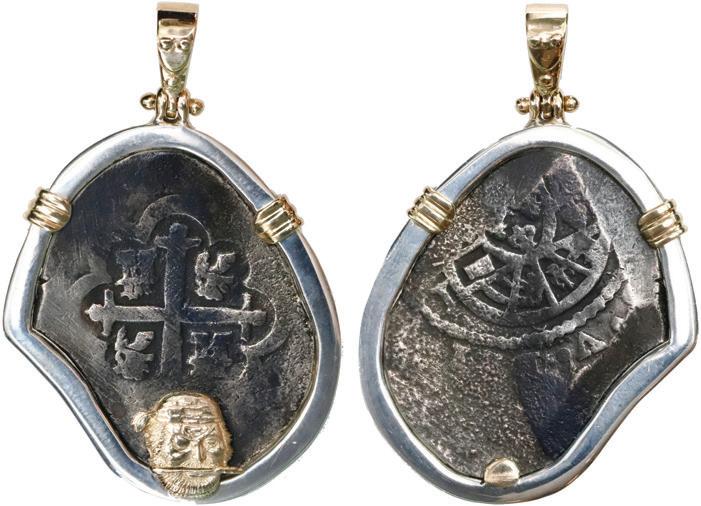

1308. Mexico City, Mexico, cob 8 reales, Philip III, assayer F (pre-1607), mounted cross-side out in 14K gold bezel with swivel bail. 32.89 grams total. Well-toned coin struck on a wavy flan with king’s ordinal and GR(ATIA) visible on shield, nicely centered cross side set in a flat-edged custom gold mounting. Estimate: $250$375.
1309. Mexico City, Mexico, cob 2 reales, Philip III, assayer F, pre-1607 type (diamond-shaped stops in legend), mounted cross-side out in 14K gold pendant with fixed bail. 10.65 grams total. Broad-flan coin with much detail on cross and shield, nicely toned, in a somewhat dainty flat-edged custom gold bezel. Estimate: $250-$375.
1311. Potosí, Bolivia, cob 8 reales, Philip IV, assayer not vis ible, mounted cross-side out in heavy silver pendant with 14K gold prongs and shackle bail. 35.28 grams total. Oval-shaped coin with some cross and shield visible, pinkish sedimentation in crevices, perhaps lightly rounded on edge to fit in the heavy, rounded silver bezel with three gold prongs. With photo-certificate. Estimate: $250-$375.
1310. Mexico City, Mexico, cob 2 reales, Philip III, assayer not visible, mounted cross-side out in heavy silver pendant with 14K gold prongs and shackle bail, backside covered with silver galleon embellishment. 20.58 grams total Lightly toned coin with small flan-crack at bottom of cross side, set in a wide, flat, silver bezel and wearable either side out. With photo-certificate. Estimate: $200-$300.
1312. Potosí, Bolivia, cob 4 reales, Philip IV, assayer T, mounted cross-side out in 14K gold pendant with shackle bail. 22.20 grams total. Very attractive setting of a mostly round coin, perhaps lightly rounded on edge to fit the custom gold bezel, with three ornate prongs, cross and shield visible but cross side slightly off-center. Estimate: $500-$750.
1313. Potosí, Bolivia, cob 8 reales, 1670 E, mounted crossside out in heavy silver pendant with 14K gold prongs and shackle bail. 36.58 grams total. Clearly dated in all three places and impressively well toned with much detail, mounted in a heavy, rounded silver bezel with four gold prongs. Estimate: $300-$450.






1314. Potosí, Bolivia, cob 1/2 real, Ferdinand VI, date not visible, mounted cross-side out in heart-shaped 14K gold pendant with fixed bail. 5.72 grams total. Small heart-shaped coin, deeply toned, in a custom gold setting reminiscent of the Sacred Heart of Jesus coins. Estimate: $300-$450.
1315. Akarnania, Leukas, AR stater, “pegasus,” 320-280 BC, mounted pegasusside out in 14K gold pendant with fixed bail. 11.47 grams total. Pegasos flying left, AV below / Helmeted head of Athena left. Light gray, matte finish with nicely centered pegasos, in a custom, flat-sided mount with three prongs. Estimate: $400-$600.
1316. Attica, Athens, AR tetradrachm “owl,” 449-413 BC, mounted owl-side out in 14K gold pendant with fixed bail. 24.56 grams total. Helmeted head of Athena right, with frontal eye / Owl standing right, head facing; olive sprig and crescent to left; all within incuse square. Heavy-gold custom setting with flat-sided bezel surrounding XF silvery coin. Estimate: $800-$1,200.
1317. Calabria, Tarentum, AR nomos (didrachm), “boy on dolphin,” mounted horse-side out in 14K white gold and 18K yellow gold bezel in a heavy-link bracelet of alternating white and yellow gold. 46.09 grams total, 7-1/2” long. Nude youth riding horse walking right, raising his right hand to crown himself / Phalanthos, holding serpent in his right hand and whip in his left, riding dol phin left. Richly rainbow-toned XF coin encased in custom setting of white gold bezel and yellow gold prongs, the bracelet made of hollow rectangular links, rounded on tops with raised gold dots as embellishment, heavy and impressive. Estimate: $2,500-$3,750.


1318. Calabria, Tarentum, AR nomos (didrachm), “boy on dolphin,” mounted dolphin-side out in 14K gold pendant with shackle bail. 11.96 grams total. Taras astride dolphin left / Helmeted nude warrior on horse prancing right. Nicely toned VF coin in a simple, three-pronged custom setting with a rounded bezel. Estimate: $600-$900.



1319. Calabria, Tarentum, AR didrachm, “boy on dolphin,” 235-228 BC, mounted dolphin-side out in 14K gold pendant with fixed bail. 9.72 grams total. Taras astride dol phin left / Helmeted nude warrior on horse prancing right. XF coin on a very round planchet, in a custom, flat-sided bezel with three prongs. Estimate: $500-$750.
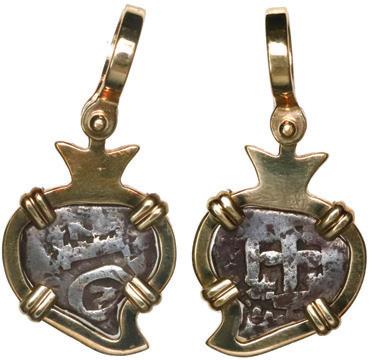
1320. Kingdom of Macedon, AR drachm, Alexander III (the Great), 336-323 BC, mounted portrait-side out in heavy silver pendant with14K gold prongs and shackle bail. 25.07 grams total. Head of Herakles right, wear ing lion’s skin headdress / Zeus seated left, holding eagle in right hand, sceptre in left. Slightly off-center but richly detailed XF coin in a heavy custom setting of a silver rounded bezel and three gold prongs and bail. With photo-certificate. Estimate: $600-$900.
1321. Kingdom of Thrace, AR tetradrachm, Lysimachus, aligned axis, mounted portrait-side out in heavy silver pendant with 14K gold prongs and shackle bail. 30.22 grams total. Diademed head of deified Alexander III right / Athena seated left, Nike in right hand, left arm resting on grounded shield. Well-centered, somewhat porous XF coin in sturdy, custom-made rounded silver bezel and three gold prongs and bail, effectively reversible due to aligned axis. Estimate: $350-$500.



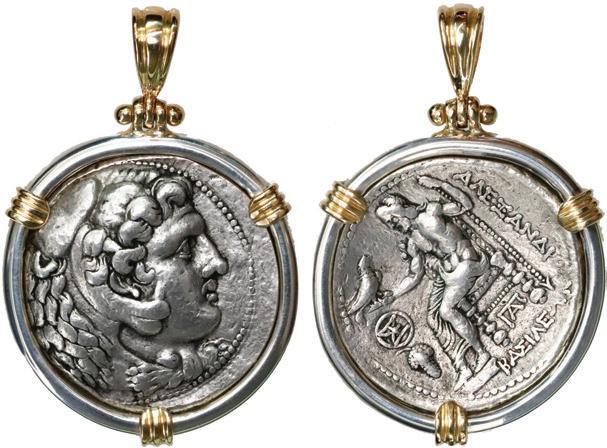
1322. Macedon under Roman Rule, AR tetradrachm, ca. 167-148 BC, mounted portrait-side out in heavy silver pendant with 14K gold prongs and shackle bail. 28.38 grams total. Diademed and draped bust of Artemis, right, bow and quiver over shoulder, all within tondo of Macedonian shield / Horizontal club, monograms above and below, all within oak wreath, thunderbolt to left. Very attractive and eye-catching XF coin in sturdy, custom-made, rounded silver bezel with three gold prongs and bail. Estimate: $800-$1,200.

1323. Seleukid Kings of Syria, AR tetradrachm, Antiochos VII Euergetes, ca. 138-129 BC, aligned axis, mounted portrait-side out in heavy silver pendant with 14K gold prongs and shackle bail. 26.60 grams total. Diademed head of Antiochus VII right / Athena standing left, holding Nike and sceptre. Beautifully toned XF coin in heavy, custom-made, rounded silver bezel with three gold prongs and bail, effectively reversible due to aligned axis. With photo-certificate. Estimate: $350-$500.
1324. Roman Imperatorial, AR denarius, Julius Caesar, military mint trav eling with Caesar mounted in 18K pendant with shackle bail. 9.29 grams total. Elephant advancing right, trampling on horned serpent / Emblems of the pontificate: simpulum, aspergillum, securis, and apex. A well-struck XF coin of numismatic im portance in a simple, custom-made, high-karat gold bezel, three prongs and bail. With photo-certificate. Estimate: $1,250-$2,000.
1325. Byzantine Empire, AV solidus, Constans II, 641-668 AD, Constantinople mint, mounted head-side out in 18K gold pendant with fixed bail. 7.95 grams total. Crowned and draped bust facing, holding globus cruciger / Cross potent set on three steps. Lovely XF coin mounted in dainty custom setting of a high-karat gold flat-sided bezel, four prongs and bail. Estimate: $300-$450.
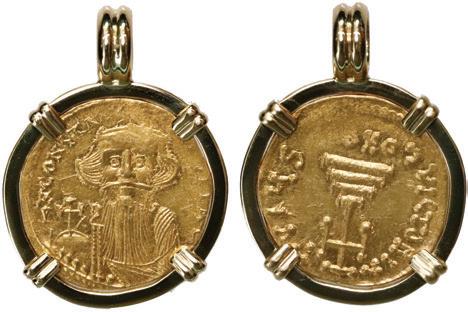
1326. Popayán, Colombia, gold bust 1 escudo, 1795 JF, mounted bust-side out in 18K gold pendant with fixed bail. 6.98 grams total. Custom flat-edged setting in high-karat gold around an XF coin with full details, light scratches on bust. Estimate: $250-$375.
1327. Costa Rica, gold 1 escudo, double lion counter mark (Type VI, 1849-57) on a Central American Republic 1 escudo 1849 JB mounted in an elaborate gold-plated brooch with a Costa Rica, gold 1/2 escudo, double lion countermark (Type VI, 1849-57) on a Central American Republic 1/2 escudo 1846 JB and a Costa Rica, gold 1/2 escudo, 1851 JB, hanging on chain below. 11.04 grams total. Unusual setting with loops soldered directly onto the two 1/2E, the 1E housed in a pre-made bezel, the coins bright gold as from being cleaned, could be an opportunity to liberate the coins from this setting to make earrings and a pendant. Estimate: $800-$1,200.
1328. Lisbon, Portugal, gold 1000 reis, João V, 1714, mounted cross-side out in 18K gold pendant with fixed bail. 5.88 grams total. Dainty, custom, flat-edged setting in high-karat gold around a dated XF coin with full details. Estimate: $300-$450.
1329. Madrid, Spain, gold bust 2 escudos, Charles IV, 1800 MF, mounted in 18K gold pendant with shackle bail. 10.99 grams total. Custom flat-edged bezel in high-karat gold around an XF coin with light scratches on bust, nicely medal-aligned to be worn with either side out. Estimate: $400-$600.




1330. Segovia, Spain, milled 4 reales, Philip IV, 1628 P, mounted cross-side out in 14K gold bezel. 20.89 grams total. Richly detailed shield and cross, some dark staining on cross side, very eye-catching and solid, wrapped in a flat-edged custom gold bezel, medal-aligned to be worn with either side out. Estimate: $600-$900.

1331. Gold chain, 297 links, 18.6 grams total, tested at 20.31K fine gold, ex-Atocha (1622). 20-1/4” long. A necklace-wearable length of dainty round links in relatively thin gauge of richly colored gold, no damage or issues, highly desirable as a useable gold artifact from the Atocha, especially in this year of the 400th anniversary of the sinking of the 1622 Fleet. From the Atocha (1622), with Fisher photo-certificate 01A-51485-2 (joined with identical type of chain from 51488-1c). Estimate: $10,000-up.
1332. Gold chain, 67 links, 23 grams total, tested at 21K fine gold, ex-Atocha (1622), with hand-signed certificate from 1976. 22.80 grams; 8” long. A bracelet-wearable length (great companion for the previous lot) of heavier round links of high-grade gold, no damage or issues, particularly desirable for its original plastic tag dated 1975 (around the time the Fishers were fighting the State of Florida for the rights to the wreck) and certificate bearing original signatures of people who are now considered gods in the pantheon of wreck-diving history. From the Atocha (1622), with original Fisher plastic tag and photo-certificate 569 from 1976 (Cape Coral Bank), hand-signed by Eugene Lyon, Duncan Mathewson, Austin Fowles, Melvin (Mel) and Dolores (Deo) Fisher, pedigreed to the J.P. Silberman Estate. Estimate: $7,500-up.


1333. Lot of 37 pieces of nephrite jade (jadeite), 77.6 grams total, ex-Atocha (1622). Various sizes from 1” x 1” to 1/4” x 1/4” Per Carol Tedesco in an online article about similar finds from this wreck, “the precious mineral jade and other similar hard green stones were prized — above gold and above emeralds — among the Olmec, Maya, Aztec, Toltec and other pre-Columbian New World inhabitants... the stones were symbolic of water, fertility, rulership, young green maize, and of wind breath and the soul.” This collection of various shapes and sizes demonstrates a range of color, from gray to green, all slightly translucent with a matte finish. From the Atocha (1622), with original Fisher photo-certificate 86A-P074, pedigreed to the J.P. Silberman Estate. Estimate: $1,000-$1,500.
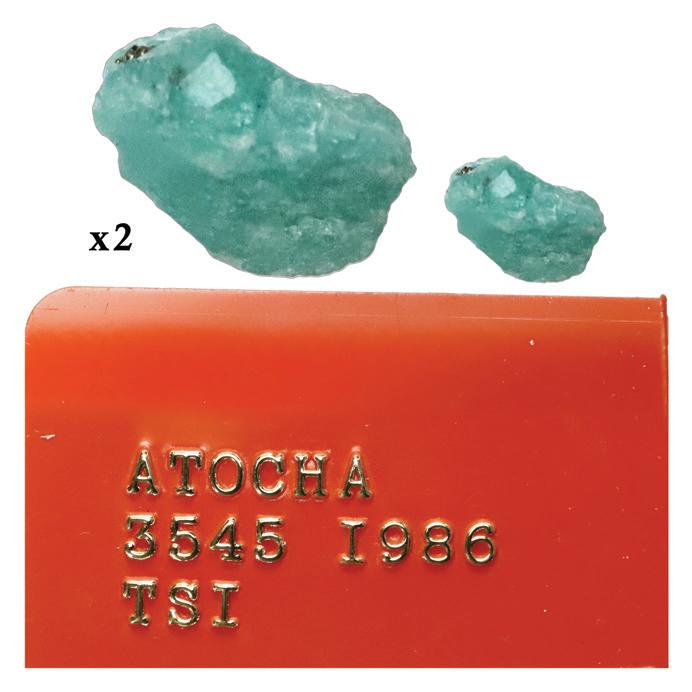
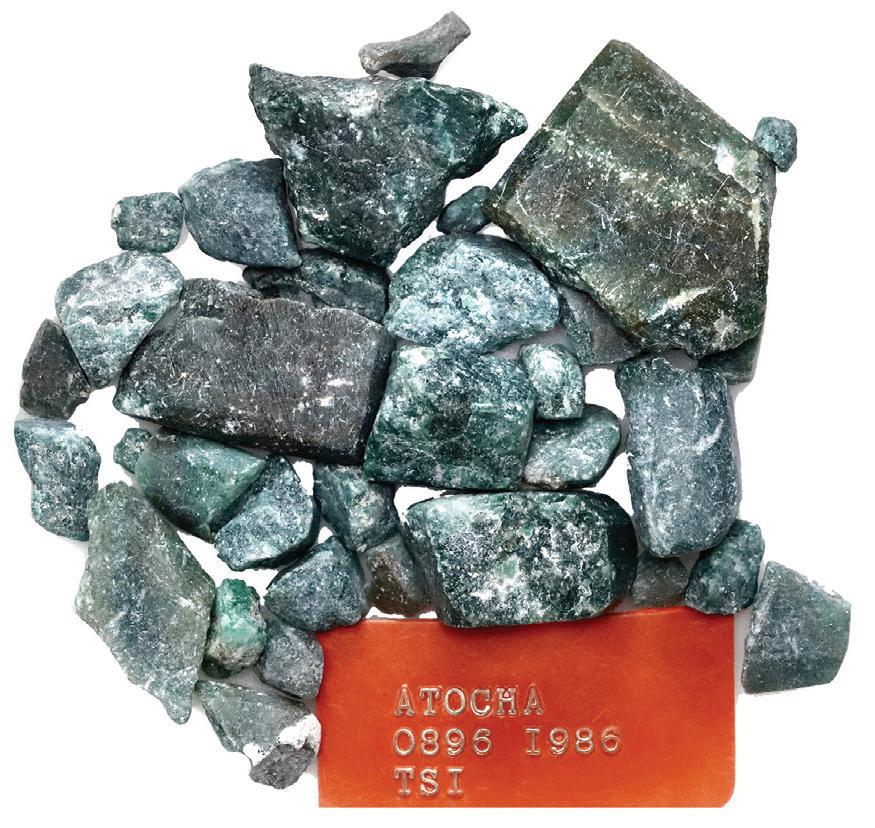
1334. Spherical gold bead, 0.21 gram, tested at 20K fine gold, ex-Atocha (1622). 1/4” long. Tiny, smooth-surfaced spheri cal gold bead with small holes at each end, undoubtedly once part of some larger piece of jewelry. From the Atocha (1622), with original Fisher plastic tag and photo-certificate 86A-P048, pedigreed to the J.P. Silberman Estate. Estimate: $600-$900.


1335. Small gold bead (half), 0.45 gram, ex-Atocha (1622). 1/4” diameter. Very small half-bead with wavy edges, very similar in appearance to the previous lot. From the Atocha (1622), with original 1984 Fisher photo-certificate 3940-A-82 and 1976-1977 plastic tag. Estimate: $300-$450.
1336. Natural emerald, 2.34 carats, ex-Atocha (1622). roughly 3/8” x 1/4”. Large, medium-green, translucent stone with a frosty ap pearance on one side, a bit of metal embedded in one end. From the Atocha (1622), with original Fisher plastic tag and photo-certificate LE0033, pedigreed to the J.P. Silberman Estate. Estimate: $400-$600.
1337. Large, intricate gold bead, 7.65 grams, tested at 22K fine gold, ex-Santa Margarita (1622) 1-3/8” long. Beautiful, ornate and intact, with small holes at either end connected by a gold tube through the middle of the bead, the hollow basket-weave design a cylinder with a higher point in the middle, the central ring decorated with six four-petaled flowers, overall a masterpiece of goldsmithing and one of the most beautiful artifacts we have ever seen from this wreck. From the Santa Margarita (1622), with original Fisher photocertificate 182 from 1982, pedigreed to the J.P. Silberman Estate. Estimate: $3,000-$4,500.
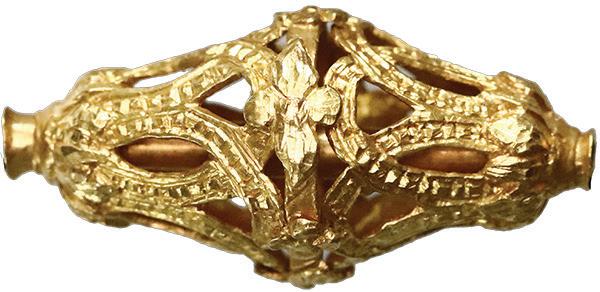
1338. Silver candlestick holder (stem), ex-Santa Margarita (1622). 306 grams; 6-1/4” long. Solid, albeit corroded, with a threaded bottom for screwing into a heavy base, cast in two parts with an obvious seam down both sides, now slightly separated here and there, almost identical in design to others from the Atocha like lot 144 in our Auc tion 17. From the Santa Margarita (1622), with original Fisher plastic tag and photo-certificate 2004 from 1983, hand-signed by Dolores (Deo) Fisher, pedigreed to the J.P. Silberman Estate. Estimate: $1,000-$1,500.

1339. Bronze candelabra segment, ex- Santa Margarita (1622). 114 grams; 3” long. Short, bulbous section of a candlestick holder with a threaded bottom for screwing into a base, lightly pitted with a gold patina. From the Santa Margarita (1622), with original Fisher plastic tag and certificate 2046 from 1983, pedigreed to the J.P. Silberman Estate. Estimate: $700-$1,000.

1340. Conserved iron signal cannon, intact, with yoke, ex-1715 Fleet, very rare. 98 lb av; 29-1/2” long, widest diameter 6”, 1-1/2” bore. It is hard to imagine a more important iron artifact from the 1715 Fleet except perhaps an anchor, this cannon small enough to justify salvaging and conserving, also so well preserved that every ring and feature is still clear as day through the heavy black coating. Remarkably, the yoke is also intact (no doubt conserved separately), as are also the lifting-handle “dolphins,” cascabel and touch-hole, but no emblems or other markings (if there ever were any) remain. For the ultimate 1715 Fleet collec tor, fully certified and ready for display. (Special shipping applies.) From the 1715 Fleet (Corrigans site), with original Fisher photo-certificate 19916 and retail promotional photocertificate. Estimate: $15,000-up.


1341. Baltic amber with preserved spider and spider-web, approx. 44 million years old, from Kaliningrad, Russia. 27 mm x 17 mm. Transparent, light-orange dollop of amber with folded-legged spider (about 5mm in length), web and other bits of plant life here and there. With photo enlargement of inclusions. Estimate: $300-$450.

1342. Baltic amber with preserved beetle, approx. 44 mil lion years old, from Kaliningrad, Russia. 41 mm x 24 mm. Thick piece of cut and polished amber forever containing a beetle (Order Coleoptera) along with a small fly and bits of plant matter. With photo enlargement of inclusions. Estimate: $250-$375.

1343. Ornate Spanish officer’s miquelet pistol, 1700s. 632 grams, 13-1/2” long, 8” barrel. High-quality, polished-walnut stock, .50-cali ber pistol with tapered octagonal-to-round barrel containing ring turnings and light decorative engraving, skillfully decorated brass mounts with silver portrait busts in five places (trigger guard, butt plate and cap, escutcheon plate), finely crafted round butt cap, original horn-tipped ramrod, all in excellent condition, with crisp action and minimal surface wear. With photo-certificate. Estimate: $1,000-$1,500.

1344. Pair of eastern European flintlock holster pistols, 1700s. 2284 grams total for two, 20” long, 12” barrel. Ornately carved and deco rated pair with long tapered-round barrels with silver inlays and gold-filled touchmarks, owner’s initials “DID” on top of each gun, engraved locks with S-shaped cocks, carved walnut stock, silver wire inlays, carved faux ramrods, ornate cast brass mounts, silver cast thumb-plates, functional locks, tight springs, overall fine condition. With photo-certificate. Estimate: $2,000-$3,000.


1345. European flintlock sea-service pistol, ca. 1800. 1221 grams, 16” long, 9” barrel. German or Dutch .75-caliber hefty pistol with a tapered round barrel, S-shaped cock, “ON” touchmark topped by a crown, polished walnut stock showing signs of use with patinated brass mounts and lanyard ring in butt, lock does not hold at full cock, overall an attractive piece. With photo-certificate. Estimate: $600-$900.
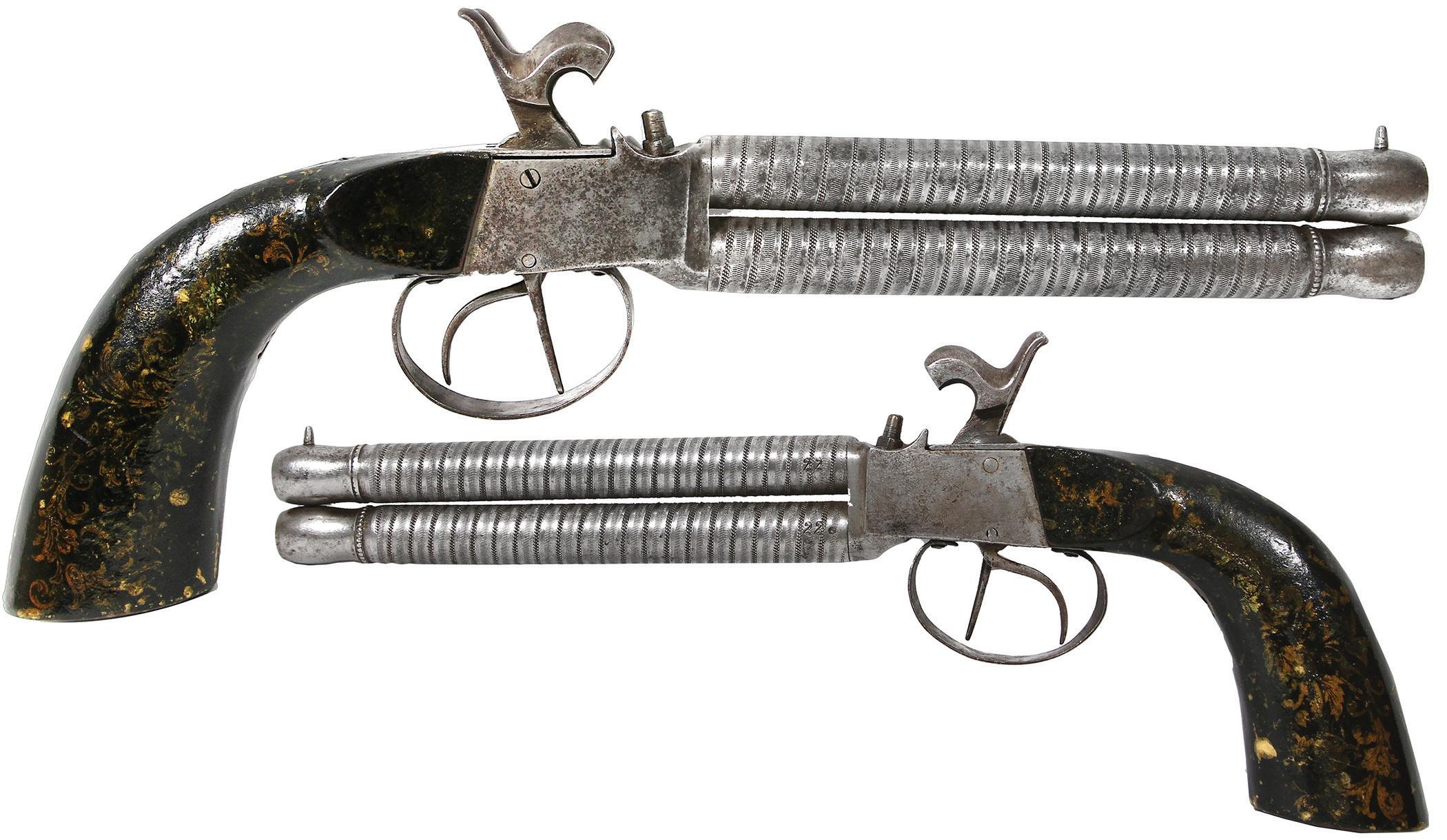
1346. European over-and-under double barrel percussion pistol, mid-1800s. 536 grams, 12-1/2” long, 6” barrel. Likely made for the Anglo-Indian market, a .45-caliber pistol with spiral-engraved decoration on barrels, “cannon”-tuned muzzles, functioning locks, polished wood stock with attractive enameled gilt-paint floral decorations. With photo-certificate. Estimate: $500-$750.

1347. Small English flintlock pocket pistol, 1800s, signed Geo E Jones, London. 256 grams, 6-1/8” long. Petite, solid gun with .50-caliber barrel which unscrews for loading, pop-out trigger, engraved frame engraved with military motifs and proof marks on barrel, pati nated walnut stock and oval silver inlay thumbpiece, all in overall good (cleaned) condition, functioning lock. With photo-certificate. Estimate: $500-$750.


1348. Spanish colonial plug bayonet/dirk, late 1800s. 188 grams, 13-1/2” long. Turned horn-handled double-edged dirk or bayonet with simple brass mounts, circular bone pommel and engraved “Bacolar Pampanga,” “F Joven,” and “4-6-98” (a possible capture date in the Philippine-American War of 1899-1902) on one side of blade and a sun-over-mountain motif on the other. With photo-certificate. Estimate: $250-$375.
1349. Original 16 mm film from the early 1970s entitled “Treasure Salvors of the Florida Keys.” Metal canister 12-1/2” in diameter. This is an original color film (16 mm), about a half hour long, written by Joseph Keyerleber and produced by Mel Fisher and his company in the early 1970s to attract investors in the search for the Atocha by providing an overview of their work to that point. The film starts with narrative about the 1733 Fleet disaster against a background of Spanish guitar music, then alternates with dialogue between Fisher and his divers, starting with their original operation on the 1715 Fleet in Vero Beach, Florida, and then their move to Key West to search for the Atocha, during which time they salvage a 1733 Fleet ship (with cameo performances by Tom Gurr and Mendel Peterson), featuring numerous underwater scenes. Also included is the original metal canister containing the film. Pedigreed to Sedwick Auction 2 with original lot-sticker 508. Estimate: $700-$1,000.

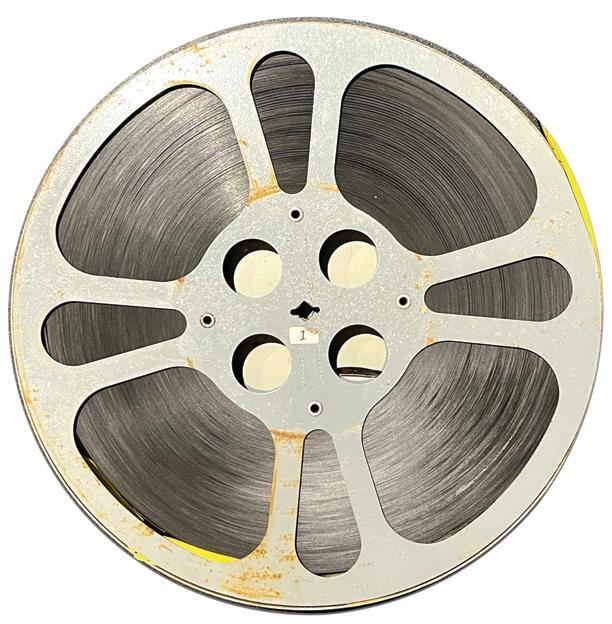

1350. Seville, Spain, gold 1 escudo, Charles-Joanna, assayer * to right, mintmark S to left, NGC AU details / edge filing. Cal196. Nice full shield and cross with partial legends, surfaces indicative of previous mounting. NGC #6476382-033. Estimate: $900-$1,350. 1351. Seville, Spain, gold 1 escudo, Charles-Joanna, assayer * to right, mintmark S to left. Cal-196. 3.34 grams. AU with plentiful sharp (if slightly doubled) details including full cross and most of shield plus legends visible, minor edge-split as made at 4 o’clock, struck on a broad planchet. Estimate: $800-$1,200. 1352. Seville, Spain, gold 1 escudo, Charles-Joanna, assayer Gothic D to left, mintmark S to right, NGC UNC details / removed from jewelry. Cal-199. Choice full shield and cross along with much legend detail, bright surfaces from prior jewelry mounting and cleaning. NGC #6476382-034. Estimate: $900-$1,350.
1353. Seville, Spain, gold 1 escudo, Charles-Joanna, assayer Gothic D to left, mintmark S to right. Cal-199. 3.34 grams. Boldly struck AU with full shield and cross, spot of edge damage at top from mount removal. Estimate: $700-$1,000.
1354. Seville, Spain, gold cob 2 escudos, Philip II, assayer Gothic D to left, mintmark S to right, NGC AU details / removed from jewelry. Cal-Type 259. Nice strong design details throughout with partial legends, loop removed from top. NGC #6476382-014. Estimate: $900-$1,350.
1355. Seville, Spain, gold cob 2 escudos, Philip II, assayer Gothic D to left, mintmark S to right. Cal-Type 259. 6.59 grams. Cleaned AU with scrape above shield, decent cross detail. Estimate: $800-$1,200.
1356. Seville, Spain, gold cob 2 escudos, 1595 date to right, assayer B below mintmark S and denomination II to left, NGC AU details / removed from jewelry. Cal-852. 6.67 grams. Cleaned piece with clear date yet somewhat doubled resulting in “15955,” full cross on reverse showing ample die rust (as made) along with some old scratches. NGC #6476382-016. Estimate: $1,000$1,500.
1357. Seville, Spain, gold cob 2 escudos, Philip II, assayer B, NGC XF details / cleaned. Cal-Type 259. 6.56 grams. Nice cross and bold partial shield on an irregular-shaped planchet with large thin edge-crack as made. NGC #6476382-017. Estimate: $800-$1,200.
1358. Seville, Spain, gold cob 1 escudo, Philip II, assayer Gothic D to left, mintmark S to right. Cal-785. 3.26 grams. Choice full shield and cross along with ample legend detail, unexplained series of rings punched into bottom edge on both sides, hairlined reverse. Estimate: $600-$900.
1359. Seville, Spain, gold cob 1 escudo, Philip II, assayer Gothic D to right, mintmark S to left, NGC Clipped. Cal-784. 2.79 grams. Bold strike detail on partial shield and cross alongside minor strike weakness, dark sedimentation in recessed areas, lightly clipped on edge. NGC #6476382-005. Estimate: $600-$900.
1360. Toledo, Spain, gold cob 2 escudos, Phillip II, assayer M above mintmark T to left, NGC Clipped. Cal-859. 5.46 grams. Interesting effect showing a clear “3 escudos” denomination as •III due to doubling, really nice and bold full shield and cross with ample luster all around, lightly clipped on edge. NGC #6476382-036. Estimate: $1,000-$1,500.
1361. Seville, Spain, gold cob 2 escudos, Philip II or III, assayer not visible. 6.71 grams. XF+ with nearly complete shield and cross, struck using rusty dies on an irregular planchet with a long thin edge-crack (as made). Estimate: $800-$1,200. 1362. Seville, Spain, gold cob 2 escudos, Phillip II or III, assayer not visible. 6.67 grams. XF with detailed shield and full cross, punchmark on reverse. Estimate: $600-$900.
1363. Seville, Spain, gold cob 1 escudo, Philip III, assayer not visible (B), OMNIVM variety. Cal-1017. 3.35 grams. XF with bold partial shield and cross, minor surface friction on flat area. Estimate: $700-$1,000. 1364. Seville, Spain, gold cob 1 escudo, Philip III, assayer V, NGC XF details / edge filing. Cal-Type 186. 3.19 grams. Bold S-V to left of nearly complete shield, almost full cross too, some old surface marks and edge filing. NGC #6476382-006. Estimate: $600-$900. 1365. Seville, Spain, gold cob 1 escudo, Phillip III, assayer not visible, NGC AU details / damaged. Cal-Type 186. 3.39 grams. Lustrous escudo with nice, well centered full cross and sharp shield detail, test-cut in edge. NGC #6476382-007. Estimate: $700-$1,000.
1366. Seville, Spain, gold cob 4 escudos, Philip IV, assayer
R. Cal-Type 396. 13.09 grams. Cleaned XF and probably ex-jewelry but with a strong crown and shield plus choice bold cross, clear mintmark and assayer. Estimate: $1,250-$2,000.
1367. Seville, Spain, gold cob 2 escudos, Charles II, assayer M, NGC XF details / removed from jewelry. Cal-154. 6.71 grams. Bold shield and nice full and centered cross, surfaces cleaned with some small marks from past mounting. NGC #6476382-019. Estimate: $700-$1,000.
1368. Mexico City, Mexico, gold cob 1 escudo, Philip V, assayer not visible (style of 1711-13 J), ex-1715 Fleet. S-M30; KM-51.1. 3.36 grams. Well-detailed Mint State cob with light sandwashed surfaces still giving off plenty of luster, strong partial shield and choice full cross. From the 1715 Fleet. Estimate: $1,250-$2,000.
1369. Cuzco, Peru, gold cob 2 escudos, 1698 M, small flan, NGC MS 63. S-CZ1; KM-28; Cal-855. 6.76 grams. High-grade example with full and well-struck pillars-and-waves and cross with only minimal doubling plus some legend detail struck up, a little edge crudity as is typical, substantial surface luster with pleasing golden surfaces (early die-state), a choice coin in every sense, inexplicably listed in a separate category from the other graded 1698 M 2 escudos. NGC #6477728001. Estimate: $10,000-$15,000.
1370. Lima, Peru, gold cob 8 escudos, 1725 M, (Louis I), rare, NGC XF details / removed from jewelry. S-L28a; KM-40; Cal-62. 26.45 grams. Rare one-year type struck well after the short seven-month reign of Louis I in 1724. Bold full pillars and cross with smooth surfaces from jewelry cleaning. NGC #6476382-002. Estimate: $4,000-$6,000.
1371. Lima, Peru, gold cob 8 escudos, 1748 R, NGC AU details / removed from jewelry. S-L31; KM-47; Cal-758. 26.72 grams. Strongly struck piece with bold pillars and cross plus portions of the legends on both sides, cleaned surfaces indicative of past jewelry mount ing. NGC #6476382-003. Estimate: $4,000-$6,000.
1372. Bogotá, Colombia, gold cob 2 escudos, (1636) A, oneyear type with dots inside ringlets, NGC AU details / mount removed, ex-Mesuno Hoard. Restrepo-M50.15; S-B20; KM-4.1; Cal-1792. 6.45 grams. Distinctive type from 1636 only with dots inside ringlets (incorrectly stated on the label as 1636-38), full shield and cross (the former with some doubling) plus king’s ordinal IIII visible, some minor marks from prior mounting, thin edge-crack as made. From the ca.-1636 “Mesuno Hoard” (stated on label). NGC #6476382-028. Estimate: $1,500-$2,250.
1373. Bogotá, Colombia, gold cob 2 escudos, Philip IV, assayer not visible (NR-A to left), distinctive style of 1639 only with dots inside and outside the tressure around the cross. Restrepo-M50.16; S-B20; KM-4.1; Cal-1795. 6.75 grams. Nice AU with some surface marks, very nice luster and rich gold color throughout, sharp shield and cross detail. Estimate: $1,250-$2,000.
1374. Bogotá, Colombia, gold cob 2 escudos, Philip IV, assayer R below domination II to right (early to mid-1650s), mintmark NR to left, NGC AU details / reverse damage, exMaravillas (1656). Restrepo-M50.25; S-B21; KM-4.1. 6.69 grams. Choice AU with pleasing golden luster throughout, bold bottom half of shield plus partial king’s name visible, nice strong cross, only a small scrape on the reverse to note. From the Maravillas (1656). NGC #6476385001. Estimate: $1,250-$2,000.
1375. Bogotá, Colombia, gold cob 2 escudos, Philip IV, assayer R below domination II to right (early to mid-1650s), mintmark NR to left, NGC UNC details / obverse scratched, ex-Maravillas (1656). Restrepo-M50.25; S-B21; KM-4.1. 6.73 grams. Lustrous piece with defined and nearly complete shield, choice cross, rather unobtrusive thin scratch to left of shield. From the Maravillas (1656). NGC #6476385-004. Estimate: $1,250-$2,000. 1376. Bogotá, Colombia, gold cob 2 escudos, 1732 M, rare. Restrepo-M80.12; S-B26; KM-17.2; Cal-1949. 6.58 grams. First year for assayer Molano at the Bogotá Mint as well as the first example of this rare date that we have offered. Holed VF with bold shield and cross detail plus some of the reverse legend including the date showing, cleaned surfaces. Estimate: $1,000-$1,500. 1377. Bogotá, Colombia, gold cob 1 escudo, Phillip V, assayer to right not visible, mintmark F to left, NGC AU details / reverse scratched. KM-22. 3.37 grams. Bold upper quadrants of shield alongside clear mintmark, choice cross on back with some legend detail, nice luster and color, several old scratches on reverse. NGC #6476382-025. Estimate: $800-$1,200.
S.S. Central America, sunk in 1857 off North Carolina
1378. Pinch of gold (dust and nuggets), 1.5 grams, ex-S.S. Central America, in PCGS slab. Wide assortment of fine Cali fornia gold dust plus several larger nuggets (around 2 to 4 mm each). From the S.S. Central America (1857), housed in PCGS-type plastic slab (Collectors Universe) with special label 5333. Estimate: $150-$225.
Concepción, sunk in 1641 off Hispaniola
1379. Small silver “splash” ingot, encrusted as found, 285 grams, no markings, ex-Concepción (1641). 3” x 3-1/4”. Heavily encrusted irregular disk of silver with no markings and thus probably smuggler’s contraband, solid bits of coral and rust across its surfaces. From the Concepción (1641). Estimate: $500-$750.
1380. Neatly formed silver ingot, 1061 grams, about 98.5% fine, no stamps visible, ex-Bredenhof (1753). 5-1/2” x 1-1/2” x 3/4” to 1”. One side corroded smooth from saltwater immersion yet the other three sides show the original sides of ingot, all darkly toned with minor pits. From the Bredenhof (1753). Estimate: $800-$1,200.
1387. Potosí, Bolivia, cob 4 reales, Philip III, assayer Q, Grade 4. S-P17; KM-9; Cal-770. 8.70 grams. Some shield detail plus clear assayer Q (not mentioned on tag or certificate), silvery corroded surfaces. With original Fisher tag and certificate 86A-137300, pedigreed to the J.P. Silberman Estate. Estimate: $200-$300.
1388. Potosí, Bolivia, cob 4 reales, Philip III, assayer not visible, Grade 4. KM-9. 5.42 grams. Thin and with irregular edges from saltwater corrosion, some shield and cross detail still visible though. With original Fisher tag and certificate 86A-135645, pedigreed to the J.P. Silberman Estate. Estimate: $200-$300.
1389. Potosí, Bolivia, cob 4 reales, Philip III, assayer not visible, Grade 4. KM-9. 7.84 grams. Corroded surfaces with typical silvery appearance from cleaning after salvage. With original Fisher tag and certificate 86A-189252, pedigreed to the J.P. Silberman Estate. Estimate: $200-$300.
1381. Potosí, Bolivia, cob 8 reales, Philip III, assayer R (curved leg), ex-Horner. S-P15; KM-10; Cal-912. 19.14 grams. Irregular seawater corrosion with some bold areas of shield and cross detail, faint assayer visible, fairly scarce wreck. Pedigreed to the David Horner collection. Estimate: $150-$225.
1390. Potosí, Bolivia, cob 4 reales, Philip III, assayer not visible, Grade 4. KM-9. 6.90 grams. Silvery, corroded surfaces with faint shield and cross detail showing. With original Fisher tag and cer tificate 86A-190478, pedigreed to the J.P. Silberman Estate. Estimate: $200-$300.
1382. Potosí, Bolivia, cob 8 reales, Philip II, assayer not vis ible, Grade 4. KM-5.1. 15.66 grams. Well-centered strike on a circular planchet in the style of Philip II (not Philip III as stated in error on the tag and certificate), some shield and cross detail visible. With original Fisher tag and certificate 86A-133526, pedigreed to the J.P. Silberman Estate. Estimate: $300-$450.
1383. Potosí, Bolivia, cob 8 reales, Philip III, assayer T, Grade 4. S-P21; KM-10. 17.12 grams. Corroded yet with strong partial shield detail and clear mintmark and assayer P+T. With original Fisher tag and certificate 86A-133721, pedigreed to the J.P. Silberman Estate. Estimate: $250-$375.
1384. Potosí, Bolivia, cob 8 reales, Philip III, assayer not visible, Grade 4. KM-10. 19.08 grams. Obverse significantly corroded yet with some cross detail including lions-and-castles, solid coin overall. With original Fisher tag and certificate 86A-134072, pedigreed to the J.P. Silberman Estate. Estimate: $200-$300.
1385. Potosí, Bolivia, cob 8 reales, Philip III, assayer not visible, Grade 4. KM-10. 14.96 grams. Saltwater-corroded yet solid piece with some shield and cross detail. With original Fisher tag and certificate 86A-135300, pedigreed to the J.P. Silberman Estate. Estimate: $200-$300.
1386. Potosí, Bolivia, cob 4 reales, Philip III, assayer not visible, Grade 3. KM-9. 7.26 grams. Corroded surfaces yet with full cross and nearly complete shield, slight bend in planchet. With original Fisher tag and certificate 86A-134979, pedigreed to the J.P. Silberman Estate. Estimate: $400-$600.
1391. Potosí, Bolivia, cob 4 reales, Philip III, assayer not visible, Grade 4. KM-9. 5.92 grams. Corroded and thin around the edges with some shield and cross detail showing. With original Fisher tag and certificate 86A-194332, pedigreed to the J.P. Silberman Estate. Estimate: $200-$300.
1392. Seville, Spain, cob 4 reales, Philip III, assayer not visible, Grade 4. KM-33.4. 10.55 grams. A scarce type coin from this wreck accompanied by, strangely enough, two identical certificates, both with mint as Potosí in error. Darkly toned with edges a bit thin from corrosion, bottom half of shield and partial cross visible. With original Fisher tag and photo-certificate 7892 from 1982, pedigreed to the J.P. Silberman Estate. Estimate: $200-$300.
1393. Overijssel, United Netherlands, “lion” daalder, 1616. KM-12; Dav-4860. 21.20 grams. Corroded yet fully detailed with silvery surfaces. Estimate: $150-$225.
1394. Mexico City, Mexico, cob 8 reales, Philip IV, assayer not visible. KM-45. 24.43 grams. Strong partial shield, some cross detail within minor corrosion, dark silvery toning all over. Estimate: $150-$225.
1395. Mexico City, Mexico, cob 4 reales, Philip IV, assayer D. S-M18a; KM-38. 11.98 grams. Nearly complete shield and cross with spotty dark toning, nice full mintmark and assayer. Estimate: $150-$225.
San Martín (“Green Cabin Wreck”), sunk in 1618 off the east coast of Florida
Atocha , sunk in 1622 west of Key West, Florida
1396. Mexico City, Mexico, cob 4 reales, Philip IV, assayer not visible. KM-38. 12.73 grams. Dark gray-toned and slightly corroded obverse with some shield detail yet rather nice reverse and much of the cross visible. Estimate: $150-$225.
1397. Mexico City, Mexico, cob 4 reales, Philip IV, assayer not visible. KM-38. 12.57 grams. Partial shield, full denomination 4, and nearly complete cross visible amidst dark surface encrustation. Estimate: $150-$225.
1398. Denomination set of three cobs of Philip IV: Mexico City, Mexico, 8 reales and 4 reales (assayer P), and Potosí, Bolivia, 2 reales. 42.78 grams total. All solid coins with plentiful shield and cross detail, the 8 reales darkly toned while the 4 and 2 reales are silvery from post-salvage cleaning. Housed in large wallet-style certificate. Estimate: $500-$750.
1399. Mexico City, Mexico, cob 4 reales, Philip IV, assayer
D. S-M18a; KM-38. 12.76 grams. XF with light surface corrosion, partial cross and shield, unusual shape with small edge-crack as made. Estimate: $150-$225.
1400. Potosí, Bolivia, cob 8 reales, 1643 TR, rare provenance. S-P29a; KM-19a; Cal-unl. 18.06 grams. Rare provenance (salvaged by Arqueonautas) and one of very few dated cobs we have seen from this wreck (also a very rare date and assayer). Corroded yet plentiful remaining detail including nice full cross and date With Sedwick cer tificate from 2002. Estimate: $150-$225.
1401. Potosí, Bolivia, cob 8 reales, 1649 (O/Z), king’s name as PHELIPVS, with crown-alone countermark (rare variety) on cross, ex-Mastalir (Plate). S-P35; KM-19b; Cal-1486. 13.40 grams. Thin with smooth surfaces from saltwater corrosion yet with all the important details visible, from the over-assayer to the full date and bold countermark, two small edge-cracks as made. Pedigreed to the Robert Mastalir Collection and plated on page 235 of Part B of his book The Great Transition at the Potosí Mint, 1649-1652: The 1649-1652 Crowned Shield Coinage and the Countermarks of 1652 (2021), with original Herman Moro certificate. Estimate: $175-$250. 1402. Potosí, Bolivia, cob 4 reales, Philip IV, assayer O, with crowned-? countermark on cross. S-P35; KM-17b. 7.35 grams. Dark and thin due to saltwater immersion, bold partial shield, some cross and countermark detail yet the full countermark obscured. Estimate: $150-$225.
1403. Potosí, Bolivia, cob 1 real, (1649) O, flattened O, rare, ex-Mastalir. S-P35; KM-12b; Cal-743. 2.73 grams. VF+ with no readily apparent corrosion beyond spots of dark encrustation, rare variety with flattened assayer O to left of the shield, nice cross if slightly off-center. Pedigreed to the Robert Mastalir Collection. Estimate: $125-$200.
1404. Mexico City, Mexico, cob 8 reales, Philip IV, assayer not visible. KM-45. 24.83 grams. Solid if somewhat corroded piece with nice cross and most shield detail, small edge-crack and thin edge-split as made. Estimate: $150-$225. 1405. Lot of two Mexico City, Mexico, cob 8 reales, Philip IV, assayers not visible. KM-45. 33.30 grams total. Both dark and corroded, one with interesting natural bubble-hole in center and wormy traces of encrustation plus a partial date (16)5(?). Estimate: $150-$225. 1406. Mexico City, Mexico, cob 4 reales, Philip IV, assayer not visible. KM-38. 12.49 grams. Quite nice from this wreck with light surface corrosion, struck with much flatness on both sides though the cross is quite bold. good cross Estimate: $150-$225.
1407. Potosí, Bolivia, cob 8 reales, 1658 E, denomination 8 above cross. S-P37a; KM-21; Cal-1522. 19.70 grams. Dark and corroded with smooth pillars side yet nice cross with full date and most of the king’s name visible, scarcer variety for this date. Estimate: $150-$225. Consolación, sunk in 1681 off Santa Clara Island, Ecuador
1408. Lima, Peru, cob 1 real, 1659 V, “Star of Lima,” date as “159.” S-L5; KM-15; Cal-676. 2.31 grams. One of the nicer examples we’ve seen from this wreck for this desirable variety with missing 6 in date plus the middle column separated by two horizontal lines (like on pillars-and-waves types), minimal surface corrosion, clear assayer and nice cross. With ROBCAR photo-certificate M180168. Estimate: $150-$225.
1409. Potosí, Bolivia, cob 1 real, (1649) O/Z, undotted O, very rare, ex-Mastalir (Plate). S-P35; KM-12b; Cal-unl. 3.28 grams. Choice coin from this wreck with partial shield, cross, and date, clear over-assayer 0/Z (rare thus), slate gray surfaces with practically no corrosion. Pedigreed to the Robert Mastalir Collection and plated on page 244 of Part A of his book The Great Transition at the Potosí Mint, 1649-1652: The 1649-1652 Crowned Shield Coinage and the Coun termarks of 1652 (2021), with ROBCAR photo-certificate M100391. Estimate: $150-$225.
1410. Mexico City, Mexico, cob 8 reales, Charles II, assayer L. S-M21; KM-46. 19.58 grams. Very odd shape (as made) with irregular thickness, bold bottom half of shield plus some cross detail, nice quality from this wreck. Estimate: $125-$200.
Capitana, sunk in 1654 off Chanduy, Ecuador
1411. Large lot of 29 Mexico City, Mexico, cob 4 reales, Philip IV and Charles II, assayers P, G and L (where visible), ex-Katz. 324.20 grams total. All solid coins, some with a fair amount of detail including visible assayers, one with canvas bag imprint. Pedigreed to the Estate of Wallace Katz. Estimate: $1,500-$2,250.
1412. Mexico City, Mexico, cob 8 reales, Philip V, 1713 (J). S-M22; KM-47; Cal-1400. 25.61 grams. Dark surfaces with patches of encrustation, fair amount of shield and cross detail, bottom part of last two digits of date visible. Pedigreed to the J.P. Silberman Estate. Estimate: $150-$225.
1413. Mexico City, Mexico, cob 8 reales, Philip V, assayer not visible, ex-Real Eight. KM-47. 19.57 grams. Corroded obverse yet some sharp cross and legend detail on the reverse, spotty dark en crustation. With original Real Eight Co. certificate signed by Bob Johnson. Estimate: $150-$225.
1414. Mexico City, Mexico, cob 8 reales, Philip V, assayer not visible. KM-47. 25.21 grams. Thick coin with bold shield and cross detail, dark coloration throughout. Pedigreed to the J.P. Silberman Estate. Estimate: $150-$225.
1415. Mexico City, Mexico, cob 8 reales, Philip V, assayer not visible. KM-47. 26.18 grams. Darkly toned surfaces yet very minimally corroded with partial shield and cross. Pedigreed to the J.P. Silberman Estate. Estimate: $150-$225.
1416. Mexico City, Mexico, cob 8 reales, Philip V, assayer not visible. KM-47. 25.85 grams. Solid piece with most of the shield and cross visible amid patches of dark encrustation. Pedigreed to the J.P. Silberman Estate. Estimate: $150-$225.
1417. Mexico City, Mexico, cob 8 reales “greenie” (un cleaned, as found), Philip V, assayer not visible. KM-47. 25.37 grams. Partial shield and cross showing through dark encrustation and some horn silver, one corner bent up as made. Pedigreed to the J.P. Silberman Estate. Estimate: $150-$225.
1418. Lot of five Mexico City, Mexico, cob 8 reales, Philip V, assayers not visible. KM-47. 117.18 grams total. All solid with some shield and cross detail, one particularly choice with nearly full cross. Pedigreed to the J.P. Silberman Estate. Estimate: $500-$750. 1419. Lot of five Mexico City, Mexico, cob 8 reales, Philip V, assayers not visible. KM-47. 115.63 grams total. Nice, solid examples with partial shields and crosses, one with full denomination 8 showing. Pedigreed to the J.P. Silberman Estate. Estimate: $500-$750. 1420. Mexico City, Mexico, cob 4 reales, Philip V, assayer not visible. KM-40. 13.50 grams. Choice, high-grade details with sharp edges, most of shield and cross visible, spotty toning all over. Pedigreed to the J.P. Silberman Estate. Estimate: $125-$200. 1421. Mexico City, Mexico, cob 4 reales, Philip V, assayer not visible. KM-40. 12.08 grams. Corroded shield side but with a very nice, complete cross. Pedigreed to the J.P. Silberman Estate. Estimate: $125-$200.
1422. Mexico City, Mexico, cob 4 reales, Philip V, assayer not visible. KM-40. 11.09 grams. Irregular shape with bold partial shield and cross, some cleaning hairlines. Pedigreed to the J.P. Silberman Estate. Estimate: $125-$200.
1423. Mexico City, Mexico, cob 4 reales, Philip V, assayer not visible. KM-40. 12.80 grams. Dark surfaces but quite nice with very minor corrosion, partial yet strong shield and cross detail. Pedigreed to the J.P. Silberman Estate. Estimate: $125-$200. 1424. Mexico City, Mexico, cob 4 reales, Philip V, assayer not visible. KM-40. 12.96 grams. Matte surfaces from minimal saltwater corrosion, patchy dark coloration, good amount of visible shield and cross detail. Pedigreed to the J.P. Silberman Estate. Estimate: $125-$200. 1425. Mexico City, Mexico, cob 4 reales, Philip V, assayer not visible, ex-Katz. KM-40. 12.86 grams. Somewhat dark and corroded with partial shield and cross detail. Pedigreed to the Estate of Wallace Katz. Estimate: $100-$150. 1426. Lot of five Mexico City, Mexico, cob 4 reales, Philip V, assayers not visible. KM-40. 61.27 grams total. Decent coins with some bold shield and cross detail on each. Pedigreed to the J.P. Silber man Estate. Estimate: $400-$600. 1427. Lot of five Mexico City, Mexico, cob 4 reales, Philip V, assayers not visible. KM-40. 61.20 grams total. Nice, thick cobs with plenty of shield and cross detail, one with mintmark oM showing. Pedigreed to the J.P. Silberman Estate. Estimate: $400-$600. 1428. Lot of five Mexico City, Mexico, cob 4 reales, Philip V, assayers not visible. KM-40. 60.57 grams total. All solid with variable degrees of corrosion, some rather nice, one struck using 8 reales dies (a scarce mint error). Pedigreed to the J.P. Silberman Estate. Estimate: $400-$600.
1429. Lot of five Mexico City, Mexico, cob 4 reales, Philip V, assayers not visible. KM-40. 59.94 grams total. Nice group with much shield and cross detail showing, Pedigreed to the J.P. Silberman Estate. Estimate: $400-$600.
1430. Mexico City, Mexico, cob 1 real, Charles II, assayer not visible. KM-29. 2.18 grams. Lightly corroded with bold partial shield and cross, spotty dark encrustation, rare provenance. With original (generic) certificate from the salvor. Estimate: $100-$150.
1431. Utrecht, United Netherlands, gold ducat, 1724, NGC UNC details / bent. KM-7.1; Fr-284. High grade piece and, in our opinion, struck on a wavy planchet (as is typical for the type) rather than being bent since it lacks corresponding damage. Nice golden satiny surfaces, choice knight with sharp detail. With promotional clamshell box printed with name of shipwreck. NGC #6478395-003. Estimate: $600-$900. 1432. Holland, United Netherlands, 2 stuivers, 1724, NGC UNC details / sea salvaged. KM-48. Sharp Mint State details plus some original luster, light surface corrosion. NGC #4826737-011. Estimate: $100-$150. 1433. Holland, United Netherlands, 2 stuivers, 1724. KM-48. 1.35 grams. Lustrous Mint State coin with very minor saltwater corro sion, small edge-flaw. Estimate: $80-$120.
1434. Utrecht, United Netherlands, gold ducat, 1729, NGC
MS 61 / Vliegenthart (Shipwreck Label). KM-7.1; Fr-284. 3.41 grams. Lustrous and lightly toned, choice strike with fully detailed knight’s head, very slightly wavy flan (as made). NGC #6481454-002. Estimate: $600-$900.
1435. Mexico City, Mexico, cob 8 reales, Philip V, date not visible, assayer F. S-M26; KM-47a. 25.88 grams. Solid piece with partially visible date due to strike, bold full cross, minimal surface corrosion. With (small) promotional certificate. Estimate: $150-$225.
1436. Gelderland, United Netherlands, “rider” ducatoon, 1730, rare provenance, ex-Jaggers. KM-95.3; Dav-1824. 31.55 grams. Nice AU details with matte surface corrosion, rare wreck provenance (only the second we have offered). Pedigreed to the Tony Jaggers collec tion, with his photo-certificate. Estimate: $150-$225.
1437. Lima, Peru, cob 1 real, 1699 R. S-L14; KM-20; Cal-231. 3.03 grams. Corroded yet solid and nicely detailed with two bold dates show ing, both pillars visible, and a full cross. With original Arqueonautas certificate MAI-006/98/PL6123. Estimate: $100-$150.
1438. Potosí, Bolivia, cob 2 reales, 1737 E, ex-Pat Johnson. S-P46; KM-29a; Cal-916. 4.75 grams. Sharp AU details on most of the pil lars side despite the saltwater corrosion, two dates and assayers visible. With Pat Johnson tag and certificate from November 2000. Estimate: $100-$150.
1439. Mexico City, Mexico, pillar 8 reales, Ferdinand VI, 1754 MF, dissimilar crowns. Yonaka-M8-54c; KM-104.2; Cal-485. 22.09 grams. Bent and corroded yet plenty of detail remaining particularly on the obverse, scarce variety and scarce provenance with desirable original certification. With original certificate 298 from the salvagers (personally countersigned by Pierre Leclerc). Estimate: $200-$300.
1440. Mexico City, Mexico, bust 8 reales, Charles III, 1783
FF. Yonaka-M8-83; KM-106.2; Cal-1124. 24.0 grams. Very nice quality from this wreck with only a touch of corrosion around the rims, surfaces typically shiny from post-salvage cleaning. Estimate: $125-$200.
1441. Great Britain (London, England), gold “spade” guinea, George III, 1793, very rare provenance. Sp-3729; KM-609. 8.31 grams. F/VF with grainy surfaces as salvaged and to date the only specimen we have seen from this wreck. Pedigreed to Sedwick Auction 20, with original lot-tag 134. Estimate: $800-$1,200.
1442. India (Madras Presidency), Arkot mint, 1 rupee, regnal year 6 (frozen date / ca. 1759-82), open lotus mintmark, ex-Sebring. KM-384. 8.78 grams. Corroded and silvery surfaces still showing plenty of original design detail, the first coin we have auc tioned from this shipwreck. With certificate (photocopy), pedigreed to the Tom Sebring Collection (ANR auction of January 2004, lot 1640). Estimate: $125-$200.
1443. Japan, bronze 100 mon (Tempo Tsuho), shogunate, no date (1835-1870), very rare provenance. KM-7. 14.46 grams. Very rare provenance (the first we have offered from this wreck) and probably from a passenger’s effects. A rather impressive survivor given the effect of saltwater on bronze with some surface pitting yet most of the detail still visible. With Ponterio photo-certificate from 1994. Estimate: $125-$200.
1444. Lot of thirteen Calcutta, British India, 10 rupees, 25-11-1916, series AC, consecutive serial numbers 85332 to 85344. SCWPM-A10H. A consecutive run of shipwreck paper money, essentially as recovered with similar edge degradation (all generally 60-70% intact) and mild staining. With original (generic) certificates from the salvor. Estimate: $300-$450. 1445. Lot of fourteen Calcutta, British India, 10 rupees, 25-11-1916, series AC, various serial numbers (some con secutive). SCWPM-A10H. Several consecutive runs of shipwreck paper money, essentially as recovered with similar edge degradation (all generally 60-70% intact) and mild staining. With original (generic) certificates from the salvor. Estimate: $300-$450. 1446. Lot of nine Calcutta, British India, 10 rupees, 2511-1916, series AC, various serial numbers (where visible). SCWPM-A10H. A variable group, each between 35-50% intact, with minor stains, a few consecutive notes. With original (generic) certificates from the salvor. Estimate: $200-$300.
1447. Mexico City, Mexico, 4 reales, Charles-Joanna, “Late Series,” assayer G to right, mintmark oM to left (oM-G), king’s name as CHAROLVS, rare, NGC AU details / envi ronmental damage. Nesmith-54 type; Cal-125; S-M5; KM-18. 13.08 grams. Rare spelling error of IMDIARVM in pillars-side legend (unlisted in Nesmith and not mentioned on the NGC label). The oM-G combina tion is rarer than others, this one beautifully centered and well struck despite the staining and porosity. Pedigreed to the Clyde Hubbard Col lection of Mexican Charles-Joanna Coinage (stated on label). Accompanied by original tag or holder. NGC #6478181-007. Estimate: $500-$750. 1448. Mexico City, Mexico, 4 reales, Charles-Joanna, “Late Series,” assayer G to left, mintmark M to right (G-M), NGC AU details / cleaned. Nesmith-46 type; Cal-128; S-M5; KM-18. 13.42 grams. Darkly toned, struck on an ample-sized planchet, full legends and details, probably from the “Golden Fleece wreck” (ca. 1550). Pedigreed to the Clyde Hubbard Collection of Mexican Charles-Joanna Coinage (stated on label). Accompanied by original tag or holder. NGC #6478181-002. Estimate: $400-$600. 1449. Mexico City, Mexico, 4 reales, Charles-Joanna, “Late Series,” assayer L to left, mintmark oM to right (L-oM), rare, ex-Rumbel. Nesmith-94b; Cal-136; S-M9; KM-18. 13.45 grams. NGC did not grade this example because it had been lightly plated, but despite that limiter, it is deeply struck on a full planchet with full legends and inner details. Nesmith cataloged only one coin of this variety, perhaps this very one since it originally belonged to O.K. Rumbel (a contributor to Nesmith’s book) before it was purchased by Hubbard in the Henry Christensen sale of Rumbel’s coins. Pedigreed to the Clyde Hubbard Collection of Mexican Charles-Joanna Coinage. Accompanied by original tag or holder. Estimate: $400-$600. 1450. Mexico City, Mexico, 2 reales, Charles-Joanna, “Late Series,” assayer G to right, mintmark M to left (M-G), king’s name as CHAROLVS, spelling error INDLARVM in legend, NGC VF details / environmental damage. Nesmith-49 for type; Cal93; S-M5; KM-12. 6.68 grams. Unusual use of an L punch for the second I in INDIARVM as well as rare use of o+cross+o at top of pillars legend, the coin a bit worn and showing signs of corrosion with light scratches but legends and interiors readable. Pedigreed to the Clyde Hubbard Col lection of Mexican Charles-Joanna Coinage (stated on label). Accompanied by original tag or holder. NGC #6478181-017. Estimate: $300-$450. 1451. Mexico City, Mexico, 2 reales, Charles-Joanna, “Late Series,” assayer G to left, mintmark oM to right (G-oM), rare, NGC XF 40. Nesmith-41; Cal-94; S-M5; KM-12. 6.65 grams. Nice example for this assayer with typically full legends and inner details, struck on a full planchet. Pedigreed to the Clyde Hubbard Collection of Mexican Charles-Joanna Coinage (stated on label). Accompanied by original tag or holder. NGC #6478181-011. Estimate: $300-$450.
1452. Mexico City, Mexico, 2 reales, Charles-Joanna, “Late Series,” assayer G to right, mintmark oM to left (oM-G), rare, NGC VF details / bent. Nesmith-53b; Cal-93; S-M5; KM-12. 6.71 grams. Nesmith noted only one example of this variety, perhaps this very coin since Hubbard’s envelope has what is probably Nesmith’s handwriting on it, this type (oM-G, CAROLVS, 2 reales) not com mon anyway, the coin itself with porosity and scratches, small part of edge bent, the legends and interiors mostly visible. Pedigreed to the Clyde Hubbard Collection of Mexican Charles-Joanna Coinage (stated on label). Accompanied by original tag or holder. NGC #6478181-018. Estimate: $250-$375.
1453. Mexico City, Mexico, 2 reales, Charles-Joanna, “Late Series,” assayer L to right, mintmark M to left (M-L), NGC AU details / obv tooled, ex-Rumbel. Nesmith-85a; Cal-101; S-M9; KM-12. 6.40 grams. We see no evidence of the tooling noted by NGC, although there is some environmental damage and horn silver here and there, while the strike is strong and the legends and interiors are virtu ally full. Pedigreed to the Clyde Hubbard Collection of Mexican CharlesJoanna Coinage (stated on label) and to the Henry Christensen Auction of October 1959 of the O.K. Rumbel collection, lot 481. Accompanied by original tag or holder. NGC #6478237-005. Estimate: $200-$300. 1454. Mexico City, Mexico, 2 reales, Charles-Joanna, “Late Series,” assayer O/L to left, mintmark oM to right (O/LoM), very rare, NGC XF details / scratches. Nesmith-105a; Calunl; S-M10; KM-12. 6.68 grams. Nesmith noted only one example of this variety and it might be this very coin since a note on envelope says it was purchased in 1953 and there is handwriting on it that could be Nesmith’s. Regardless, it is the third one we have catalogued (see lot 349 in this auction for another example) and important as showing alternations between L and O as assayers of the mint. NGC did not note the over-assayer on the label but it is very clear. There are scratches on both sides, some rather severe, and the smaller planchet makes parts of the legends hard to read. Pedigreed to the Clyde Hubbard Collection of Mexican Charles-Joanna Coinage (stated on label). Accompanied by original tag or holder. NGC #6478237-023. Estimate: $250-$375. 1455. Mexico City, Mexico, 2 reales, Charles-Joanna, “Late Series,” assayer O to left, mintmark M to right (O-M), rare, NGC XF details / tooled, ex-Rumbel. Nesmith-97; Cal-103; S-M10; KM-12. 6.75 grams. Nesmith noted only one example of this variety, but we have catalogued others. This coin is darkly toned with scratches in the pillars legend, loss of metal on edges (possibly clipped), some cor rosion, and a planchet crack at 5 o’clock on the shield side. Pedigreed to the Clyde Hubbard Collection of Mexican Charles-Joanna Coinage (stated on label) and to the Henry Christensen Auction of October 1959 of the O.K. Rumbel collection, lot 489. Accompanied by original tag or holder. NGC #6478237-020. Estimate: $250-$375. 1456. Mexico City, Mexico, 1 real, Charles-Joanna, “Late Series,” no assayer (G) to right, mintmark M to left (M-), motto as PLV-SVL-TR, very rare, NGC XF details / envi ronmental damage. Nesmith-unl; Cal-unl: S-M5; KM-unl. 3.32 grams A curiosity missing the assayer-mark G to the right of the shield. The die is consistent with Nesmith’s 48, so we presume the coin comes from this assayer. One of three we know about (see lot 362 for a bet ter specimen), this one showing signs of corrosion and horn silver over a low-toned background, the legends and inner details visible. Pedigreed to the Clyde Hubbard Collection of Mexican Charles-Joanna Coinage (stated on label). Accompanied by original tag or holder. NGC #6478181-026. Estimate: $400-$600.
1457. Mexico City, Mexico, 1/2 real, Charles-Joanna, “Late Series,” assayer A to right, o to the left, mintmark oMo be low monogram, motto PL-V-S, legend as HISPANIARVM. ET.INDIAR on both sides (very rare error), flowers instead of crosses at top on both sides, NGC VF 30. Nesmith-63; Cal-49; S-M6; KM-6.5. 1.58 grams. Very rare but known to Nesmith, this variety contains a mint error in the use of the same legends of HISPANIARV MoEToINDIARVM on both sides of the coin, one of six we have seen, including another in this auction (lot 387), the present example with visible legends and interiors (those rather soft) and some old scratches. It seems that Nesmith did not note the flowers instead of crosses at the top on both sides, but we have observed this on all assayer-A coins of this denomination. Pedigreed to the Clyde Hubbard Collection of Mexican Charles-Joanna Coinage (stated on label). Accompanied by original tag or holder. NGC #6478181-039. Estimate: $400-$600.
1458. Mexico City, Mexico, cob 8 reales, Philip IV or Charles
II, assayer G. 24.46 grams. Lightly pitted and silvery surfaces from unknown salvage (probably Joanna), full mintmark and assayer plus partial shield, very nice cross. Estimate: $150-$225. 1459. Mexico City, Mexico, cob 4 reales, Philip II, assayer F below mintmark oM to left, denomination 4 (Arabic) to right. S-M12; KM-36; Cal-509. 13.64 grams. Difficult late-Philip II issue. AU with bold, nearly complete shield and cross, some scrapes on shield side. Estimate: $125-$200.
1460. Mexico City, Mexico, cob 4 reales, Philip III, assayer F (pre-1607). S-M12a; KM-37.1; Cal-745. 13.73 grams. Scarce early-Philip III issue with bottom of king’s ordinal partially visible. AU with very nice full cross and clear assayer, minor hairlines on reverse, natural edge-crack at 4 o’clock. Estimate: $125-$200.
1461. Mexico City, Mexico, cob 4 reales, Philip IV, assayer D (ca. 1632), with 8R-sized castles and lions. S-M18a; KM-38. 13.89 grams. Very rare variety and the first we have seen with large, 8 reales-sized castles and lions on the reverse, the time period confirmed by exaggerated fleurs at the ends of the cross. Dark gray-toned XF with bold partial shield (slightly doubled) and strong cross. Estimate: $150-$225.
1462. Mexico City, Mexico, cob 4 reales, Charles II, assayer not visible. KM-39. 13.66 grams. Interesting shape for this early-style piece. AU with dark silver-toned surfaces, bold shield along with C of king’s name and denomination 4 visible, complete cross. Estimate: $150-$225.
1463. Mexico City, Mexico, cob 4 reales, Philip V, assayer L. S-M21a; KM-40. 13.29 grams. Scarce type struck in 1702-5 only. VF with minor surface marks, bold and nearly complete shield and full cross, some adjustment marks on back. Estimate: $125-$200.
1464. Mexico City, Mexico, cob 2 reales, Philip III, assayer F (pre-1607). S-M12a; KM-32.1; Cal-610. 6.94 grams. Difficult type with distinctive lions. XF with off-center strike but with full shield and cross visible, patchy dark toning throughout. Estimate: $125-$200.
1465. Mexico City, Mexico, cob 2 reales, Philip III, assayer F, rare variety with three 1/2R-sized castles in upper-left and bottom-right quadrants of cross. S-M12a; KM-unl; Cal-unl. 6.61 grams. Rare design-type with three small 1/2 real-sized castles used for each castle quadrant on the back. XF with spotty dark toning (prob ably salvaged), weak yet nearly full shield, nice bold cross. Estimate: $100-$150.
1466. Mexico City, Mexico, cob 2 reales, Philip V, assayer L. S-M21a; KM-35. 6.62 grams. Rare four-year type struck from 1702 to 1705 only. AU with irregular shape yet bold design details where struck up including clear assayer, small crack along edge as made. Estimate: $100-$150.
1467. Mexico City, Mexico, cob 1/2 real, 1620/19 D, very rare. S-M18; KM-unl; Cal-unl. 1.61 grams. Very rare variety with a retro grade z for the 2 in date. XF with corroded and cleaned surfaces yet most details readily visible including date, mintmark and full mono gram. Estimate: $125-$200.
1468. Southeast Asia, two round chopmarks on reverse of a Mexico City, Mexico, cob 8 reales, Philip V, assayer D. Host: S-M23a; KM-47. 26.69 grams. VF with two countermarks nearly flank ing a rather complete cross, interesting assayer D punched over what appears to be an upside-down D (first we have seen, decidedly not a J). Estimate: $150-$225. 1469. Southeast Asia, single round chopmark on reverse of a Mexico City, Mexico, cob 8 reales, Philip IV, assayer not visible, with test-cuts. Host: KM-45. 26.62 grams. High AU coin with several test-cuts from Asian circulation along the edges plus a detailed round chopmark and a small-character mark near upper left castle, very nice full shield and cross. Estimate: $125-$200.
1470. Lot of two Lima, Peru, cob 1/2R, Philip II, assayer Diego de la Torre, two different varieties. S-L4; KM-5. 3.30 grams total. Choice coins with substantial detail, both from previous Sedwick auctions (with tags) with one pedigreed to the Mark Bir collection. Estimate: $200-$300.
1471. Potosí, Bolivia, cob 8 reales, Philip II assayer B (3rd period). S-P10; KM-5.1; Cal-672. 26.28 grams. XF with some dark en crustation yet fully detailed shield and cross, irregular edge-crack. Estimate: $175-$250. 1472. Potosí, Bolivia, cob 8 reales, Philip IV, assayer T (mid1630s), PCGS VF detail / edge damaged. S-P26; KM-19a. 25.81 grams. Slightly underweight from edge clipping, almost complete shield with bold denomination 8, full cross. PCGS #37554702. Estimate: $100-$150.
1473. Potosí, Bolivia, cob 4 reales, Philip IV, assayer P (mid1620s), quadrants of cross transposed. S-P23; KM-17. 13.31 grams. XF with light cleaning, bold full shield and cross (the latter with lions and castles transposed). Estimate: $150-$225. 1474. Potosí, Bolivia, cob 2 reales, (1649) O/Z, undotted O, early castles, rare, ex-Mastalir (Plate Coin). S-P35; KM-14b; Cal-unl. 3.54 grams. Fine with off-center shield though clear bottom of Z showing under the O assayer, nice and nearly complete cross, spotty dark toning, thin natural edge-crack. Pedigreed to the Robert Mastalir Collection and plated on page 245 of Part A of his book The Great Transi tion at the Potosí Mint, 1649-1652: The 1649-1652 Crowned Shield Coinage and the Countermarks of 1652 (2021). Estimate: $175-$250. 1475. Potosí, Bolivia, cob 2 reales, (1649) O/Z, undotted O, rare, ex-Mastalir (Plate Coin). S-P35; KM-14b; Cal-unl. 4.31 grams. Fine with dark encrusted fields and some old scratches, nearly complete shield and full cross, denomination as small z to right. Pedigreed to the Robert Mastalir Collection and plated on page 245 of Part A of his book
The Great Transition at the Potosí Mint, 1649-1652: The 1649-1652 Crowned Shield Coinage and the Countermarks of 1652 (2021). Estimate: $175-$250.
1476. Potosí, Bolivia, cob 1 real, (1649) O/Z, undotted O, very rare, ex-Mastalir (Plate Coin). S-P35; KM-12b; Cal-unl. 2.67 grams. Nice VF piece with bold but off-center shield. Pedigreed to the Robert Mastalir Collection and plated on page 245 of Part A of his book The Great Transition at the Potosí Mint, 1649-1652: The 1649-1652 Crowned Shield Coinage and the Countermarks of 1652 (2021). Estimate: $100-$150.
1477. Potosí, Bolivia, cob 1 real, (1649) O/Z, dotted O, very rare, ex-Mastalir (Plate). S-P35; KM-12b; Cal-unl. 3.33 grams. Clear over-assayer O/Z, VF overall with most of shield showing plus nice full cross, partial digits visible in date. Pedigreed to the Robert Mastalir Collection and plated on page 245 of Part A of his book The Great Transi tion at the Potosí Mint, 1649-1652: The 1649-1652 Crowned Shield Coinage and the Countermarks of 1652 (2021). Estimate: $125-$200. 1478. Potosí, Bolivia, cob 1 real, (1649) O, dotted O, rare, ex-Mastalir (Plate). S-P35; KM-12b; Cal-743. 3.18 grams. VF with most of shield and cross showing quite boldly, partial date, clear mintmark and dotted-O assayer. Pedigreed to the Robert Mastalir Collection and plated on page 246 of Part A of his book The Great Transition at the Potosí Mint, 1649-1652: The 1649-1652 Crowned Shield Coinage and the Countermarks of 1652 (2021). Estimate: $125-$200.
1479. Potosí, Bolivia, cob 8 reales, 1704 Y, ex-Byers. S-P43a; KM-31; Cal-1539. 21.09 grams. Salvaged from an unspecified shipwreck with decent pillars side showing a bold date and both assayers, cross side corroded with spotty dark encrustation. Pedigreed to the P.J. Byers Collection (Ponterio auction of March 1998, with original lot-tag 1282). Estimate: $200-$300.
1480. Potosí, Bolivia, cob 4 reales, 1752 q. S-P52; KM-39; Cal-406. 12.47 grams. Chunky AU piece with full pillars and cross plus bold date, crusty surfaces from past burial. Estimate: $175-$250. 1481. Potosí, Bolivia, cob 2 reales, 1688 VR. S-P40; KM-24; Cal421. 7.18 grams. XF with luster and colorful toning in fields plus full king’s name and ordinal, some minor surface-marks on high points. Estimate: $150-$225.
1482. Belgian Congo (struck at the Philadelphia Mint), brass 2 francs, Leopold III, 1947, NGC MS 65. KM-28; Y-25. Popular two-year type with elephant design. Satiny luster throughout. NGC #6271794-003. Estimate: $150-$225.
1483. Potosí, Bolivia, bust 8 reales, Charles IV, 1800 PP, PCGS AU58 (“top pop”). Janson-76.12; Cal-723; KM-72. Lustrous surfaces with minor friction for the grade, centers a bit weakly struck yet with sharp details around legends, speckled toning across the re verse, tied with one other for finest known in the PCGS census. PCGS #32982560. Estimate: $125-$200. 1484. Potosí, Bolivia, bust 2 reales, Ferdinand VII, 1823
PJ, NGC AU 58. Janson-88.13; Cal-921; KM-83. Well struck with just a touch of wear on the bust, lustrous fields with gold toning around details. One of just two in the NGC census. NGC #6474385-006. Estimate: $125-$200.
1485. Potosí, Bolivia, 1/4 real, 1798, PCGS MS 65, finest and only example in the PCGS census. Janson-81.5; Cal-145; KM82. Radiant cartwheel luster plus sharply struck details on both sides. PCGS #29303891. Estimate: $150-$225.
1486. Potosí, Bolivia, 1/4 real, 1799, PCGS MS 63. Jan son-81.6.3; Cal-147; KM-82. Patches of dark blue toning (particularly on the obverse) across lustrous surfaces, nice details. PCGS #29207129. Estimate: $100-$150.
1487. Potosí, Bolivia, 8 soles, 1843 LR, NGC AU 58. KM-103. Sharply detailed and lustrous piece with light wear on the high points of the design, orange-gold toning on the reverse reminiscent of a set ting sun. NGC #6286838-004. Estimate: $200-$300. 1488. Potosí, Bolivia, 1 boliviano, 1865 FP, PCGS MS62, ex-Sedillot. KM-152.1. Lustrous piece with minor weakness of strike in central areas (typical for the type). Pedigreed to the Joe Sedillot Col lection (stated on label). PCGS #43247465. Estimate: $150-$225. 1489. Potosí, Bolivia, 1/4 sol, 1852, PCGS MS65 (“top pop”). KM-111. A superior example of this type for the grade and, in our opinion, better than some other examples in the same grade on the market, well struck and with plentiful silver luster covered by a layer of faint gold toning, tied with four others for finest known in the PCGS census. PCGS #3517263. Estimate: $150-$225.
Watch and bid LIVE on the Internet at
1490. Lima, Peru, bust 8 reales, Ferdinand VII, 1816 JP, chopmarked from trade in China, NGC VF details / chopmarked, Oliveira Plate. KM-117.1; Cal-1070. Fascinating example of the use of Spanish colonial 8 reales throughout Asia with numerous bold chopmarks, most highlighted with ink, on both sides, including three small “swastikas” that are not Chinese characters and believed to have been applied in India or Indochina, plus a peanut-shaped assayer’s “bite” at center of obverse, most host-coin details still legible and much sharper than the details grade suggests. The book that features this coin lists a transcription of its individual chopmarks (words and meanings). Plate Coin on pages 44 and 46 of Contramarcas Chinas en las Monedas Coloniales de Hispano America Siglos XVII-XIX (1992), by Eduardo de Oliveira Cezar. NGC #6474385-008. Estimate: $150-$225.
1491. Singapore, gold 1.5 grams proof Panda / Yin-Yang medal, 1984-SM, NGC PF 69 Ultra Cameo, ex-Gansu. KMMB12. Frosted details against mirror proof fields, a few spots of red-gold toning on the reverse, struck by the Singapore Mint in the tradition of the Chinese Panda Coinage, low mintage of 1,500 coins. Pedigreed to the Gansu Collection of Chinese Panda Coinage. NGC #3711888-252. Estimate: $150-$225.
1492. China (People’s Republic), silver 1 oz proof official Panda issue, 1984, 3rd Hong Kong Exposition, NGC PF 68 Ultra Cameo, ex-Gansu. KMX-MB1; PAN-21A. Anthony notes this medal as rare and states: “Also new for 1984 was the first Panda medal to celebrate the 3rd Hong Kong International Coin Exposition.” Excel lent frosted devices against deep proof fields. Mintage: 1,000 (planned; actual and surviving unknown). Pedigreed to the Gansu Collection of Chinese Panda Coinage. NGC #6472672-005. Estimate: $175-$250. 1493. China (People’s Republic), gold 5 yuan (1/20 oz) proof Panda, 1990-P, NGC PF 69 Ultra Cameo, ex-Gansu. KM-268; PAN-128A. Anthony: “The following years would bring tumbling gold and silver prices and lower demand for Pandas. This goes far to explain why we have fewer 1990 than 1989 Pandas today.” Frosted panda / Temple of Heaven design along with reflective surfaces. Mint age: 5,000 (planned; actual and surviving unknown). Pedigreed to the Gansu Collection of Chinese Panda Coinage. NGC #6472458-006. Estimate: $100-$150.
1494. China (People’s Republic), gold 10 yuan (1/10 oz) proof Panda, 1990-P, NGC PF 69 Ultra Cameo, ex-Gansu. KM-269; PAN-127A. As with the prior lot, lower demand in 1990 resulted in a mintage 3,000 coins smaller than the 1989 proof gold 10 yuan Panda. Well struck with frosty devices and mirror proof fields. Mint age: 5,000 (planned; actual and surviving unknown). Pedigreed to the Gansu Collection of Chinese Panda Coinage. NGC #6472458-007. Estimate: $200-$300.
1495. China (People’s Republic), gold 25 yuan (1/4 oz) proof Panda, 1990-P, NGC PF 67 Ultra Cameo, ex-Gansu. KM-270; PAN 126A. Sharply struck on both sides. Mintage: 5,000 (planned; actual and surviving unknown). Pedigreed to the Gansu Collection of Chinese Panda Coinage. NGC #6472458-008. Estimate: $350-$500.
1496. Lot of two China (People’s Republic), silver 10 yuan (1 oz) Pandas, 1990, small and large date varieties, NGC MS 69, ex-Gansu. KM-276; PAN-136A, 136B. Anthony: “1990 marks the first year that silver Pandas appear with both large and small dates.” A pair illustrating the two date varieties for this type with matching, near-perfect grades. Mintage: 200,000 planned; estimated extant: <69,000 (large date), <28,000 (small date). Pedigreed to the Gansu Collection of Chinese Panda Coinage. NGC #3596989-008, 3498113045. Estimate: $200-$300.
1497. China (People’s Republic), silver 10 yuan (1 oz) proof Panda, 1990-P, NGC PF 69 Ultra Cameo, ex-Gansu. KM-276; PAN-137A. Impressive rendered frosted details plus radiant proof fields. Mintage: 20,000 (planned; actual and surviving unknown). Pedigreed to the Gansu Collection of Chinese Panda Coinage. NGC #3596989-009. Estimate: $150-$225. 1498. Lot of two China (People’s Republic), silver 10 yuan (1 oz) Pandas, 1991-P, small and large date varieties, NGC MS 69, ex-Gansu. KM-386.1; PAN-155A, 155B. 1991 was the tenth an niversary of the Panda coin series. The large date has prooflike fields while the small date possesses a more satiny appearance. Unknown mintage planned; estimated extant: <38,000 (large date), <35,000 (small date). Pedigreed to the Gansu Collection of Chinese Panda Coinage. NGC #2787891-024, 3479725-007. Estimate: $200-$300. 1499. China (People’s Republic), silver 10 yuan (1 oz) proof Panda, 1991-P, NGC PF 69 Ultra Cameo, ex-Gansu. KM-386.3; PAN-156A. Choice proof with nicely frosted design. Mintage: 20,000 (planned; actual and surviving unknown). Pedigreed to the Gansu Collection of Chinese Panda Coinage. NGC #3596989-012. Estimate: $150-$225.
1500. Lot of two China (People’s Republic), silver 10 yuan (1 oz) Pandas, 1992, small and large date varieties, NGC MS 69, ex-Gansu. KM-397; PAN-182A, 182B. The small date is more prooflike in appearance while the large date has radiant satiny luster throughout. Anthony writes that the “difference between Large and Small date 1992 versions is subtler than for most years. For this reason the estimated surviving population numbers have yet to be accurately calculated. Unknown mintage planned; estimated extant population for both varieties <60,000. Pedigreed to the Gansu Collection of Chinese Panda Coinage. NGC #2777922-004, 3596989-013. Estimate: $200-$300. 1501. China (People’s Republic), silver 10 yuan (1 oz) proof Panda, 1992-P, NGC PF 69 Ultra Cameo, ex-Gansu. KMA397; PAN-183A. Anthony notes that there are “no common coins or medals from this year” and that the silver 10 yuan proof are “among the more desirable dates in their series.” Gem proof Panda with silky frosted cameo devices. Mintage: 20,000 (planned; actual and surviving unknown). Pedigreed to the Gansu Collection of Chinese Panda Coinage. NGC #3596989-015. Estimate: $150-$225. 1502. Lot of two China (People’s Republic), silver 10 yuan (1 oz) Pandas, 1993, small and large date varieties, NGC MS 69, ex-Gansu. KM-484; PAN-204A, 204B. The design of the small date is particularly impressive with small panda and rock details showing through light frosting; the large date is more heavily frosted. Unknown mintage planned; estimated extant: <13,000 (large date), <33,000 (small date). Pedigreed to the Gansu Collection of Chinese Panda Coinage. NGC #3622141-008, 2755757-014. Estimate: $200-$300.
1503. China (People’s Republic), silver 10 yuan (1 oz) proof Panda, 1993-P, NGC PF 69 Ultra Cameo, ex-Gansu. KM-478; PAN-205A. Well deserving of the Ultra Cameo designation. Mintage: 20,000 (planned; actual and surviving unknown). Pedigreed to the Gansu Collection of Chinese Panda Coinage. NGC #3220342-007. Estimate: $200-$300.
1504. Lot of two China (People’s Republic), lot of 2 silver 10 yuan (1 oz) Pandas, 1994, small and large date varieties, NGC MS 69, ex-Gansu. KM-623; PAN-227A, 227B. Anthony: “The silver 10 Yuan is tied for second place as the scarcest date in its series. The 1994 Large Date is the most common type, but both varieties are desirable.” Both near-perfect business strikes showing two varieties for the date, light rose toning around the rims of the large date coin. Unknown mintage planned; estimated extant: <32,000 (large date), <22,000 (small date). Pedigreed to the Gansu Collection of Chinese Panda Coinage. NGC #3498162-009, 3769486-012. Estimate: $200-$300. 1505. China (People’s Republic), silver 10 yuan (1 oz) proof Panda, 1994-P, NGC PF 69 Ultra Cameo, ex-Gansu. KM-616; PAN-228A. Choice proof with frosted design against deep mirror fields, free of any spots or fog. Mintage: 20,000 (planned; actual and surviving unknown). Pedigreed to the Gansu Collection of Chinese Panda Coinage. NGC #3596989-021. Estimate: $200-$300.
1506. China (People’s Republic), silver 10 yuan (1 oz) Panda, 1995, short twig, micro date, NGC MS 69, ex-Gansu. KM732.2; PAN-248C. A product of the Shenyang Mint with short twig in the Panda’s grasp and a noticeably very small date on the other side (stated on the label as “small date”); Anthony calls the micro dates “among the rarest coins in the entire silver series.” Brilliant, prooflike fields and frosty design elements. Unknown mintage planned; estimated extant population for this variety <4,000. Pedigreed to the Gansu Collection of Chinese Panda Coinage. NGC #2779470-001. Estimate: $200-$300.
1507. China (People’s Republic), silver 10 yuan (1 oz) proof Panda, 1995, NGC PF 69 Ultra Cameo, ex-Gansu. KM-723; PAN-249A. Clear ultra cameo contrast between frosty devices and mir ror fields, lightly toned rims. Mintage: 10,000 (planned; actual and surviving unknown). Pedigreed to the Gansu Collection of Chinese Panda Coinage. NGC #4157888-012. Estimate: $400-$600.
1508. China (People’s Republic), silver 1 oz proof official Panda issue, 1995, Munich International Coin Show, NGC PF 69 Ultra Cameo, ex-Gansu. KMX-MS82; PAN-255A. Intricately detailed design with frosted devices against deep mirror fields. Mint age: 2,500 (planned; actual and surviving unknown). Pedigreed to the Gansu Collection of Chinese Panda Coinage. NGC #6472672-002. Estimate: $200-$300.
1509. China (People’s Republic), silver 10 yuan (1 oz) proof Panda, 1996, NGC PF 69 Ultra Cameo, ex-Gansu. KM-900; PAN-271A. Frosted design elements against brilliant devices and mir ror fields, light golden toning around rim. Mintage: 8,000 (planned; actual and surviving unknown). Pedigreed to the Gansu Collection of Chinese Panda Coinage. NGC #2750744-004. Estimate: $200-$300.
1510. Lot of two China (People’s Republic), silver 10 yuan (1 oz) Panda, 1998, small and large date varieties, NGC MS 69, ex-Gansu. PAN-309A, 309B. Nice, high-grade pair of two differ ent date varieties. Mintage for both mints: 250,000 (planned; actual unknown); estimated extant: <39,000 (small date), <14,000 (large date). Pedigreed to the Gansu Collection of Chinese Panda Coinage. NGC #3596989-032, 3481232-156. Estimate: $200-$300. 1511. Lot of three China (People’s Republic), silver 10 yuan (1 oz) Pandas, 1999, NGC MS 69, ex-Gansu: small date, large date plain 1, large date serif 1. PAN-323A, 323B, 323C. Anthony: “For Panda variety collectors, this is a very interesting year. There are three distinct date varieties that reflect the coins’ mints of origin: Shanghai (small date), Shenyang (large date with plain 1), and Shenzhen GuoBao (large date with serif 1).” A matched-grade set of three different varieties for the type, all choice for the grade with no toning. Unknown mintage planned; estimated extant: <35,000 (small date), <23,000 (large date with plain 1), <7,000 (large date with serif 1). Pedigreed to the Gansu Collection of Chinese Panda Coinage. NGC #3596989-035, 3596989-034, 3596989-036. Estimate: $400-$600. 1512. Lot of three China (People’s Republic), silver 10 yuan (1 oz) proof Pandas, 1997, 1998 and 1999, colorized designs, NGC PF 69 Ultra Cameo, ex-Gansu. PAN-290A, 310A, 324A. All with colorfully enhanced designs, mild toning on the 1997 and 1998 reverses. Mintages (planned): 100,000 (1997), 100,000 (1998), 100,000 (1999). Pedigreed to the Gansu Collection of Chinese Panda Coinage. NGC #4157886-023, 2762422-006, 3139060-035. Estimate: $400-$600. 1513. China (People’s Republic), silver 10 yuan Panda, 2000, frosted ring, NGC MS 69, ex-Gansu. KM-1310; PAN-333A. Highgrade example of this more available variety for the 2000-dated 10 yuan Pandas. Unknown mintage planned; estimated extant population for this variety: <73,000. Pedigreed to the Gansu Collection of Chinese Panda Coinage. NGC #3682587-024. Estimate: $200-$300. 1514. China (People’s Republic), silver 10 yuan (1 oz) Panda, 2000, mirrored ring, rare, NGC MS 68, ex-Gansu. KM-1310; PAN-333B. Anthony writes that the mirrored ring 10 yuan Panda “ranks among the scarcest silver varieties and there is far more demand than supply.” Only about 4,000 Pandas are known with a mirrored ring around the Temple of Heaven versus some 73,000 pieces with a frosted ring. Gem piece with deep mirror reverse fields. Pedigreed to the Gansu Collection of Chinese Panda Coinage. NGC #6472528-002. Estimate: $300-$450.
1515. China (People’s Republic), silver 10 yuan (1 oz) Panda, 2001 D, NGC MS 70 (“top pop”), ex-Gansu. KM-1365; PAN-348A. This one year type features a large D to left of the panda, a symbol indicating its striking for a domestic Chinese distribution. Anthony indicates that the D marked Pandas are rare worldwide, especially so in very high grades. Nicely crafted design with frosted white elements against brilliant highlights, difficult to find with this perfect MS 70 grade. Unknown mintage for this variety, estimated extant <33,000. Pedigreed to the Gansu Collection of Chinese Panda Coinage. NGC #2772991-013. Estimate: $500-$750.
1516. China (People’s Republic), gold 100 yuan (1/4 oz) Panda, 2004, Industrial and Commercial Bank of China 20th Anniversary, NGC MS 70 (“top pop”), ex-Gansu. Fr-B16; KM-1540; PAN-384A. Perfect example of this commemorative Panda, tied with just five others for finest known in the NGC census. Mint age: 50,000 (planned; actual and surviving unknown). Pedigreed to the Gansu Collection of Chinese Panda Coinage. NGC #6472528-008. Estimate: $400-$600.
1517. Popayán, Colombia, gold bust 1 escudo, Charles III, 1783 SF. Restrepo-54.24; KM-48.2; Cal-1428. 3.36 grams. VF+ with nice bust detail, no problems. Estimate: $200-$300.
1518. Popayán, Colombia, gold bust 1 escudo, Charles III, 1785 SF. Restrepo-54.28; KM-49.2a; Cal-1430. 3.32 grams. VF, a few thin marks on bust. Estimate: $200-$300.
1519. Pasto, Colombia, bust 2 reales, Ferdinand VII (bust of Charles IV), 1822 O, two dots between date and CONST. Restrepo-115.1; KM-74; Cal-894. 6.70 grams. Popular one-year issue made from Popayán-mint equipment but struck by royalists on the run somewhere closer to Ecuador (believed to be Pasto), reflected in the quality of strike but this example at least with full details, also a unique type for the Americas with CONST in legend referring to the new Constitution in Spain. Obverse cleaned, some dark encrustation in reverse fields. Estimate: $200-$300.
1520. Bogotá, Colombia, 1/4 real, 1808, NGC AU 58. Re strepo-75.25; KM-63; Cal-205. Lustrous surfaces with rich gunmetal toning, impressively well-struck castle and lion, last date of issue for this type under Charles IV who abdicated in March of 1808. NGC #6454906002. Estimate: $200-$300.
1521. Popayán, Colombia, 1/4 real, 1816, NGC MS 63. Re strepo-101.1; KM-67.1; Cal-1521. Only year of issue for this denomination from the Popayán Mint. Strong strike details, pale green-gold toning, difficult to acquire in higher grades, tied with one other behind a single finer MS64 in the PCGS census. PCGS #29303888. Estimate: $100-$150.
1522. Bogotá, Colombia, gold 16 pesos, 1844 RS, NGC AU 55. Restrepo-211.15; Fr-74; KM-94.1. Lightly circulated with scrape in bust’s hair curls, bright luster all over. NGC #2711902-007. Estimate: $1,000-$1,500.
1523. Bogotá, Colombia, gold 1 peso, 1844 RS, NGC UNC details / obverse planchet flaw. Restrepo-200.12; Fr-77; KM-93. Brilliant and well-detailed Mint State coin with natural planchet flaw to left of bust, planchet-adjustment lines on reverse. NGC #6454914-005. Estimate: $150-$225.
1524. Costa Rica (Central American Republic), gold 1/2 escudo, 1846 JB, CREZCA variety, NGC AU 58. KM-13.1. Bright gold luster across both sides, well-struck details with only light wear on the central high points to mark the grade. NGC #6471433-001. Estimate: $800-$1,200.
1525. Costa Rica, 5 centavos, 1872 GW, NGC VG 10. KM110. Nice example of a very scarce type that saw heavy circulation in its time, die-match with lot 917 in Sedwick Auction 27 (May 2020) with corresponding die-break and weakness of strike above arms as made. NGC #6289284-009. Estimate: $125-$200.
1526. Cuba (struck at the Philadelphia Mint), gold 4 pesos, 1916, José Martí, NGC AU details / cleaned. KM-18. High AU details, some hairlines. NGC #5935137-009. Estimate: $200-$300.
1527. Santo Domingo, Dominican Republic, copper 4 maravedís, Charles-Joanna, assayer F to left, denomination 4 to right, mintmark S-P, with key countermark on pillars side denoting devaluation to 2 maravedís (1577). S-SD1; KM-45; Cal33. 4.73 grams. Choice full key countermark on an XF host with much strike weakness, a few small spots of verdigris. Estimate: $100-$150. 1528. Santo Domingo, Dominican Republic, copper 4 maravedís, Charles-Joanna, assayer F to left, denomination 4 to right, mintmark S-P, with key countermark on pillars side denoting devaluation to 2 maravedís (1577). S-SD1; KM-45; Cal-33. 3.45 grams. Bold pillars with choice full countermark and clear mintmark, clear assayer and denomination on other side as well, dark brown Fine with traces of verdigris. Estimate: $100-$150. 1529. Santo Domingo, Dominican Republic, copper 4 maravedís, Charles-Joanna, assayer F to left, denomination 4 to right, mintmark S-P, with anchor countermark on pillars side denoting export to Jamaica (1611-16). S-SD1; KM-45; Cal-33. 3.66 grams. Bold countermark on a VF+ host coin with partial yet strong design details, flat area due to strike weakness. Estimate: $150-$225. 1530. San Pedro de Macoris, Dominican Republic, brass 20 centavos token, no date (late 1800s), Colonia Esperanza J.T. Escarraman sugar plantation, ex-Byrne. Rulau-Dom-60. 1.77 grams. Cut square token with COLONIA ESPERANZA at top and J.T. ESCARRAMAN at bottom around central 25 / IGo PORVENIR with a 0 stamped over the 5 to devalue the token to 20 centavos (related to the square-cutting, according to Rulau), also with 20 stamped on the otherwise blank reverse, Fine with some dark areas against dull brass color, desirable pedigree. Pedigreed to the Ray Byrne collection with his tag (indicating it was purchased from Jess Peters). Estimate: $125-$200.
1531. Dominican Republic, gold 30 pesos, 1955, 25th an niversary of the Trujillo era. KM-24; Fr-1. 29.66 grams. AU+ with radiant golden luster, minor bagmarks. Estimate: $1,000-$1,500.
1532. Ecuador (struck in London or Germany), coppernickel 2 sucres, 1973, NGC MS 65. KM-82. This unassuming coin has an interesting backstory: Some 2 million pieces were struck by either VGM Metals in Germany (Llantrisant Mint) or the Royal Mint in London for general circulation in Ecuador. However, the design was not approved, the order retracted, and the bulk of the mintage was melted down. Very few are known to have survived this mass melting; sources suggest around a 100 or fewer extant pieces. A Gem coin with faint golden toning. NGC #6478033-001. Estimate: $200-$300.
1533. Egypt, 5 piastres, Fuad, AH1348 (1929), mintmark BP, NGC MS 64. KM-349. Choice piece with ample cartwheel luster. NGC #2874888-003. Estimate: $150-$225.
1534. Great Britain (London, England), sixpence, George III, 1787, NGC MS 62. S-3748; KM-606.1. Brilliant piece with sharp details and original mint luster, light golden toning around the rims. NGC #6271301-009. Estimate: $150-$225.
1535. Great Britain (London, England), gold sovereign, Victoria (young head), 1855, with WW incuse, NGC UNC details / obverse cleaned. KM-736.1; S3852D. Some hairlines across the obverse, popular type with incuse WW (found both incuse and raised in 1853-55). NGC #6477169-002. Estimate: $400-$600.
1536. Great Britain (London, England), gold sovereign, Victoria (young head), 1856, NGC UNC details / obverse cleaned. KM-736.1; S-3852D. Lustrous golden piece, surface hairlines on obverse. NGC #6477169-003. Estimate: $400-$600.
1537. Great Britain (London, England), gold sovereign, Victoria (young head), 1865, die number 12, NGC UNC details / obverse cleaned. KM-736.2; S-3853. Obverse with surfaces hairlines plus some mechanical doubling around the date and legends. NGC #6477169-005. Estimate: $400-$600.
1538. Guatemala, cob 8 reales, 1752 J, NGC VF details / holed. JP-8R20b; S-G1a; Cal-426; KM-12. 26.38 grams. On the higher end of VF as far as Guatemala cobs come, with much central design detail showing, date a bit weak but visible, holed at top. NGC #6454906001. Estimate: $200-$300.
1539. Guatemala, cob 2 reales, 1736 (J). JP-2R4; S-G1; Cal-680; KM-4. 6.31 grams. Fine with nicely detailed shield side and a bold date, also very scarce without hole. Estimate: $150-$225. 1540. Guatemala, cob 2 reales, 1738 (J). JP-2R6; S-G1; Cal-682; KM-4. 7.00 grams. Choice VF cob and scarce as having no hole, struck a bit off-center though the final digit of the date is visible. Estimate: $175-$250.
1541. Guatemala, cob 2 reales, 1753 J. S-G1a; JP-2R21; Cal-250; KM-10. 6.42 grams. Toned About Good with clear final two digits of date, difficult to encounter without a hole like this piece. Estimate: $175-$250.
1542. Guatemala, cob 1 real, 1736 J. JP-1R4; S-G1; Cal-357; KM3. 2.97 grams. Fine with a nice full date and scarce as having no hole, struck on a crude planchet. Estimate: $150-$225. 1543. Guatemala, cob 1 real, 1738 J. JP-1R6; S-G1; Cal-359; KM-3. 3.00 grams. Good+ with a cool arrowhead shape and strong full date, also scarce with no hole. Estimate: $150-$225. 1544.
Guatemala, cob 1 real, 1741 J. JP-1R9; S-G1; Cal-362; KM-3. 2.98 grams. Tough to find with no hole plus a bold full date, VG+ over all with dark contrasting toning in the fields. Estimate: $150-$225. 1545. Guatemala, cob 1 real, 1742(?) J. Cal-Type 68. 3.34 grams. VG with mostly clear date though last digit partially off planchet (pos sibly 1742), scarce without a hole. Estimate: $100-$150. 1546. Guatemala, cob 1 real, 1751 J. JP-1R19; S-G1a; Cal-130; KM9. 3.20 grams. Fine with bold full date, scarce piece with no hole in it. Estimate: $150-$225. 1547. Guatemala, cob 1/2 real, 1751 J. JP-MR19; S-G1a; Cal-25; KM-8. 1.55 grams. About VG with some hairlines, scarce as a non-holed piece. Estimate: $175-$250.
1548. Guatemala City, Guatemala, 1/2 real, 1878, with fineness 0.835, NGC MS 66 (“top pop”). KM-147. Essentially as made with frosty surfaces showing off much luster, tied with one other for finest known in the NGC census. NGC #6286823-009. Estimate: $100-$150. 1549. Guatemala, copper 1 centavo, 1871, NGC MS 62 Brown. KM-196. Mostly rich brown in color though some red luster highlights the Guatemala banner at top. NGC #2885629-004. Estimate: $100-$150.
1550. Haiti, copper essai 20 centimes, 1877-IB, NGC PF 64 Red-Brown. KM-Pn75. Choice proof with plentiful original red mint luster. NGC #6269564-007. Estimate: $125-$200.
1551. Honduras, gold 1 peso, 1871. Fr-3; KM-39. 1.79 grams. Rare one-year type. AU with heavy hairlines. Estimate: $200-$300. 1552. Honduras, gold 1 peso, 1919. Fr-7; KM-56. 1.80 grams. AU, well struck for this crude type with only surface hairlines to note. Estimate: $200-$300.
1553. Honduras, gold 1 peso, 1919. Fr-7; KM-56. 1.79 grams. AU with nice bust details despite the typical crude strike, some surface hairlines. Estimate: $200-$300.
1554. Mexico City, Mexico, gold bust 8 escudos, Ferdinand VII transitional (“armored bust”), 1809 HJ, NGC AU 58. Fr47; KM-160; Cal-44. High-grade example of this popular “armored bust” type with minor wear across the bust yet otherwise possessing sharp de tail and flashy fields. NGC #6452540-008. Estimate: $2,000-$3,000.
1555. Mexico City, Mexico, pillar 2 reales, Ferdinand VI, 1751 M, NGC AU 55. Yonaka-M2-51; KM-86.1; Cal-291. Vibrantly toned with fields of gold and deep blue colors over original mint luster, planchet-adjustment lines on both sides. NGC #6062671-002. Estimate: $150-$225.
1556. Mexico City, Mexico, pillar 2 reales, Ferdinand VI, 1753 M, PCGS VF35. Yonaka-M2-53; KM-86.1; Cal-294. Nice eye appeal for the grade with minor wear, richly toned and somewhat lustrous. PCGS #20810658. Estimate: $125-$200.
1557. Mexico City, Mexico, bust 8 reales, Charles IV, 1808
TH, NGC MS 61. Yonaka-M8-108; KM-110; Cal-1308. Silvery surfaces with significant luster and nice strike detail (particularly around the legends), small bagmark on reverse, final year of issue for this type under Charles IV who abdicated in March of 1808. NGC #6354696-010. Estimate: $200-$300.
1558. Mexico City, Mexico, bust 8 reales, Charles IV, 1808
TH, NGC MS 61. Yonaka-M8-108; KM-110; Cal-1308. Nicely struck de tails (see full PLVS VLTRA) and semi-prooflike fields with interesting spot of die damage to right of bust, faint russet toning on the reverse, final year of issue for this type under Charles IV who abdicated in March of 1808. NGC #6443032-001. Estimate: $200-$300.
1559. Mexico City, Mexico, bust 8 reales, Charles IV, 1808
TH, NGC MS 61. Yonaka-M8-108; KM-110; Cal-1308. Frosty white appearance with well-struck bust and castles-and-lions detail, minor strike weakness around the edges, final year of issue for this type under Charles IV who abdicated in March of 1808. NGC #6451438-002. Estimate: $200-$300.
1560. Mexico City, Mexico, bust 2 reales, Charles III, 1773
FM, NGC XF 45. Yonaka-M2-73a; KM-88.2; Cal-659. Nice circulation cameo with golden centers contrasting against dark gunmetal-toned fields, well-detailed piece with a better eye appeal than the grade sug gests, first year of issue for this type. NGC #6354696-007. Estimate: $150-$225.
1561. Mexico City, Mexico, 1/4 real, 1815, NGC AU 58. Yon aka-M04-115; KM-62; Cal-280. Boldly struck with full design and denticles, subdued silvery luster. NGC #6450851-004. Estimate: $100-$150.
1562. Zacatecas, Mexico, bust 8 reales, Ferdinand VII, 1814 AG, ex-Calbetó. KM-111.5; Cal-1454. 26.21 grams. Very crude Fine struck with partially broken dies, dark rose toning with gold hues, desirable pedigree. Pedigreed to the Gabriel Calbetó collection (duplicates), with his envelope. Estimate: $150-$225.
1563. Zacatecas, Mexico, bust 8 reales, Ferdinand VII, 1821 RG. KM-111.5; Cal-1465. 26.72 grams. Attractively toned XF with light abrasions on high points, strong strike and rims. Estimate: $125-$200. 1564. Zacatecas, Mexico, bust 8 reales, Ferdinand VII, 1821 RG. KM-111.5; Cal-1465. 27.07 grams. Well-struck AU with sharp details and lustrous surfaces, minor scattered hairlines. Estimate: $125-$200.
1565. San Luis Potosí, Mexico, cap-and-rays 8 reales, 1881 MH, PCGS MS62. KM-377.12; DP-Pi70. Radiant, lustrous surfaces with faint golden-toned centers and purple hues around the rims, sec ond finest in PCGS census behind a single MS63. PCGS #38637174. Estimate: $150-$225.
1566. Mexico City, Mexico, 1 peso “caballito,” 1911, long ray, ANACS AU 58 details / cleaned. KM-453. High AU details with scattered hairlines in the fields, popular design. ANACS #6134594. Estimate: $150-$225.
1567. Lima, Peru, gold 8 bust escudos, Charles III, 1780 MI, NGC AU 55. Fr-32; KM-82.1; Cal-1942. Brilliant example with lustrous golden fields and well-defined details (particularly on the reverse), some natural lamination flaws around the bust. NGC #2127605-001. Estimate: $1,750-$2,500.
1568. Lima, Peru, bust 8 reales, Ferdinand VII transitional (large “imaginary” bust), 1809 JP, king’s name as FERDIN, NGC AU 58. KM-106.2; Cal-1239. Bright, silver-white surfaces with light rub on the high points to denote the grade, only one finer in MS 62 on the NGC census. NGC #6443033-003. Estimate: $150-$225. 1569. Lima, Peru, bust 8 reales, Ferdinand VII 1813 JP, NGC MS 61. KM-117.1; Cal-1246. Scarce Mint State piece with original mint luster accented by golden toning on the obverse and brilliant silver fields on the reverse, sharp peripheral detail with center design a little flat on high points due to strike weakness. NGC #6324295-001. Estimate: $200-$300.
1570. Philippines (under Spain), 10 centavos, Alfonso XII, 1885, NGC MS 66. KM-148. Impressive gem coin with brilliant luster across silvery white surfaces possessing hints of golden toning around the rims. (Note: KM and many catalogers refer to this issue as 10 centimos in error.) NGC #3168233-002. Estimate: $200-$300.
1571. Puerto Rico, 20 centavos, Alfonso XIII, 1895 PG-V, NGC AU 55. KM-22; Cal-126. Very lustrous surfaces with minor fric tion for the grade, well struck with sharp details throughout. NGC #6289287-005. Estimate: $125-$200.
1572. Burgos, Spain, denomination set of copper 1-2-4 maravedís, Ferdinand-Isabel, “crowned F” type struck for New World use. 10.98 grams total. All corroded from probable burial but somewhat rare early New World coins with some detail showing on each. Estimate: $600-$900.
1573. Madrid, Spain, gold bust 1/2 escudo, Ferdinand VI, 1758 JB, NGC VF 35. Fr-274; KM-378; Cal-564. Evenly circulated with nice details against rich gold-toned fields. NGC #6354751-008. Estimate: $125-$200.
1574. Madrid, Spain, gold bust 4 escudos, Charles III, 1781/79 PJ. Fr-284; KM-418.1; Cal-unl (cf. 1785). 13.39 grams. AU with prior cleaning, lustrous fields, unlisted overdate in the Calicó reference. Estimate: $600-$900.
1575. Madrid, Spain, gold bust 1 escudo, Charles III, 1788 M. Fr-288; KM-416.1a; Cal-1108. 3.42 grams. XF with a few surface hair lines, small natural lamination flaw across bust. Estimate: $175-$250. 1576. Madrid, Spain, gold bust 1/2 escudo, Charles III, 1774/3 PJ, NGC XF 40. Fr-290; KM-415.1; Cal-1259. Well-struck details with minor circulation friction, red-gold toning in fields, clear overdate. NGC #6354751-010. Estimate: $125-$200. 1577. Madrid, Spain, gold bust 1/2 escudo, Charles III, 1776 PJ. Fr-290; KM-415.1; Cal-1264. 1.75 grams. VF with rich goldentoned fields, edge bump on back, popular date as the year of U.S. independence. Estimate: $125-$200.
1578. Madrid, Spain, gold bust 1/2 escudo, Charles III, 1783 JD, NGC XF 45. Fr-290; KM-415.1; Cal-1275. Lightly circulated with bright golden luster in fields. NGC #6354751-009. Estimate: $125-$200.
1579. Segovia, Spain, copper 4 maravedís, Charles III, 1785, NGC MS 64 Brown, finest and only example in the NGC census. Cal-64. Exceptional grade with choice, original surfaces toned chocolate brown with hints of red luster, sharp design details, thin edge-crack through top as made. NGC #6453525-002. Estimate: $200-$300.
1580. Madrid, Spain, gold bust 4 escudos, Charles IV, 1792 MF. Fr-294; KM-436.1; Cal-1475. 13.40 grams. XF with cleaned surfaces, no big problems. Estimate: $600-$900.
1581. Cuba, Junta Central Republicana de Cuba y Puerto Rico, 1 peso, 1869, serial U 5988, PMG AU 55, ex-EMO collection. SCWPM-61. Nicely framed and lightly handled example of this Ten Years’ War note issued in New York City as a means of raising funds for the independence forces led by Céspedes. Pedigreed to the EMO collection (stated on the label). PMG #8009123-042. Estimate: $70-$100.
1582. Cuba, Junta Central Republicana de Cuba y Puerto Rico, 1869, serial U 6075, PMG AU 53 net / edge damage, small stains, ex-EMO collection. SCWPM-61. Decent Cuban In dependence note with minor edge damage and toning spots as noted on the label. Pedigreed to the EMO collection (stated on the label). PMG #8009123-043. Estimate: $60-$90.
Guatemala
1583. Guatemala, Banco de Guatemala, 1 quetzal, 3-11968, serial A4623728Z, PMG Choice UNC 64. SCWPM-52e. Strongly embossed note with bold ink colors and nice margins. PMG #2021536-013. Estimate: $50-$75.
1584. Guatemala, Banco de Guatemala, 1/2 quetzal, 22-11958, serial K600733, PMG Choice AU 58 EPQ. SCWPM-35. Well-centered and bold design, trivial handling in the upper margin for the grade. PMG #2021536-014. Estimate: $30-$45.
1585. Paraguay, Banco Central del Paraguay, 1 guarani re placement note, 25-3-1952, serial Z012498, PCGS Choice UNC 63 PPQ (“top pop”). SCWPM-193b. Scarce replacement note as identified by the Z prefix letter. Choice note with strong emboss ing, tied with two others for finest known in the PCGS census. PCGS #43498950. Estimate: $50-$75.
1586. Akarnania, Thyrrheion, AR stater, “pegasus,” 350-250 BC. Calciati 8. 8.35 grams. Pegasos flying left / Helmeted head of Athena right; earring with pendants behind and y below chin. Choice example with well-struck details (somewhat softer on obverse than reverse), well centered and lightly toned. Estimate: $100-$150.
1587. Attica, Athens, AR tetradrachm, “owl,” ca. 440-404 BC, NGC MS-star, strike 5/5, surface 4/5. SNG Copenhagen 31-40; Kroll 8. 17.22 grams Helmeted head of Athena right, with frontal eye / Owl standing right, head facing; olive sprig and crescent to left; all within incuse square. Brightly toned example with impressive detail, full Athena design visible. Coins minted in Athens were among the most trusted throughout the ancient world. NGC #4938345-005. Estimate: $2,000-$3,000.
1588. Attica, Athens, AR tetradrachm “owl,” ca. 440-404 BC, NGC Ch AU, strike 4/5, surface 3/5, ex-Parliament. SNG Copenhagen 31-40; Kroll 8. 17.15 grams Helmeted head of Athena right, with frontal eye / Owl standing right, head facing; olive sprig and crescent to left; all within incuse square. Brightly toned but more matte-like finish. Coins minted in Athens were among the most trusted throughout the ancient world Pedigreed to the Parliament Collection (stated on label). NGC #5873634-011. Estimate: $1,000-$1,500.
1589. Calabria, Tarentum, AR didrachm, ca. 281-240 BC, “boy on dolphin,” NGC AU, strike 4/5, surface 3/5. Vlasto 894-898; HN Italy 1038. Helmeted, nude warrior on horse prancing right / Taras astride dolphin left. Flan flaw on horse flank, mottled toning and bits of corrosion on reverse. NGC #4253971-006. Estimate: $300-$450.
1590. Dynasts of Lycia, AR 1/3 stater, Vekhssere II, ca. 410380 BC, NGC XF. SNG Copenhagen Supp. 468; Podalia 9. Facing lion scalp / Triskeles; monogram in center WE-XS-SE (in Lycian) around. Brightly toned, well-centered lion with triskeles off-center but with full details. NGC #6290528-009. Estimate: $100-$150.
1591. Roman Republic, AR denarius, C. Porcius Cato, 123 BC. Sydenham 417; Crawford 274/1. 3.71 grams. Helmeted head of Roma right; X behind / Victory in biga right holding reins and whip; C CATO below, ROMA in exergue. Darkly toned VF with some corrosion and sedimentation. Estimate: $100-$150.
1592. Roman Imperatorial, AR denarius, Julius Caesar, military mint traveling with Caesar, ca. 44 BC, NGC VF, strike 5/5, surface 3/5. Crawford 443/1. 3.77 grams Elephant advancing right, trampling on horned serpent; CAESAR in exergue / Emblems of the pontificate: simpulum, aspergillum securis, and ape. Slightly off-center strike with very small edge-cut on reverse. Julius Caesar crossed the Rubicon in 49 B.C. and issued this coin from his military mint. NGC #6556117-001. Estimate: $1,250-$2,000.
1593. Roman Empire, AR denarius, Diva Faustina II, wife of Marcus Aurelius, 147-175/6 AD, NGC Ch AU, strike 5/5, surface 4/5. RIC 506b; BMC 1049; Sear 4705. 3.32 grams FAVSTINAE AVG PII AVG FIL, draped bust of Faustina right / LAETITIAE PV BLICAE, Laetitia standing left, holding wreath and sceptre. High-relief strike, brightly toned. NGC #6556117-002. Estimate: $350-$500.
1594. Byzantine Empire, AV solidus, Justinian I, 527-565 AD, Constantinople mint. MIBE 6; DOC 8g. 4.50 grams. Helmeted, draped, and cuirassed facing bust, holding globus cruciger / Angel standing facing, holding staff terminating in staurogram and globus cruciger, star in right field. Softly struck VF with flat toning and mul tiple scratches, coin orientation. Estimate: $600-$900.
1595. Byzantine Empire, AV tremissis, Justinian I, 527-565
AD, Constantinople mint. MIBE 19; DOC 19. 1.41 grams. Diademed, draped and cuirassed bust right / Victory advancing right, her head turned left, holding wreath and globus cruciger, star in right field. A somewhat wavy flan, VF, with small gouge above cruciger on reverse. Estimate: $175-$250.
1596. Byzantine Empire, AV solidus, Maurice Tiberius, 582-602 AD, Constantinople mint, NGC AU. Sb 478. Hel meted, draped, and cuirassed facing bust, holding globus cruciger / Angel standing facing, holding staff terminating in staurogram and globus cruciger. Lustrous with some flat areas near edges, clipped, coin orientation. NGC #6056106-145. Estimate: $250-$375.
1597. Byzantine Empire, AV histamenon nomisma, Constantine X, 1059-1067 AD, Constantinople mint, NGC AU. Sb 1847. Christ, nimbate, enthroned on straight-backed throne / Con stantine, bearded, standing facing on footstool, holding labarum with no pellet on shaft, and cross on globe. Light scratch at 10 o’clock on obverse, but otherwise well centered on a round planchet and beauti fully struck. NGC #6062701-018. Estimate: $350-$500.
1598. Byzantine Empire, AV histamenon nomisma, Michael VII, 1071-1078 AD, Constantinople mint. Sear 1869. 4.37 grams. Christ, nimbate, enthroned on straight-backed throne / Michael VII facing, wearing loros and crown, holding labarum in his right hand and globus cruciger in his left. XF condition and well centered. Estimate: $275-$400.
Ancient Greek
1599. Kingdom of Macedon, AR drachm, Alexander III (the Great), 336-323 BC, aligned axis, mounted portrait-side out in 14K gold pendant with fixed bail. 5.49 grams total. Head of Herakles right, wearing lion’s skin headdress / Zeus seated left, hold ing eagle in right hand, sceptre in left. Struck on a small flan with soft details, in a dainty, custom, flat-sided mount with three prongs, wearable either side out. Estimate: $300-$450.
Ancient Roman
1600. Roman Republic, AR denarius, L. Julius, 141 BC, mounted head-side out in 14K gold pendant with fixed bail. 5.35 grams total. Helmeted head of Roma right; XVI behind / Dioscuri galloping right, L IVLI below, ROMA in exergue. Attractively toned with nice detail in a dainty, custom, flat-sided mount. Estimate: $100-$150.
Atocha, sunk in 1622 west of Key West, Florida 1601. Potosí, Bolivia, cob 8 reales, Philip III, assayer R (curved leg), Grade 4, ex-Atocha (1622), mounted in 14K gold-wire pendant with fixed bail. 17.62 grams total. Unusual, lightweight, wrapped-wire bezel and bail with appealing design, compensating for lack of detail in the sand-washed, bright silver coin. From the Atocha (1622), with Fisher and photo-certificate 00A-61940 (tag missing). Estimate: $350-$500.
1602. Potosí, Bolivia, cob 8 reales, Philip III, assayer not visible, Grade 4, ex-Atocha (1622), mounted shield-side out (no bezel) with 14K gold shackle bail and galleon embellish ment. 20.46 grams total. Novel setting for a coin without much detail remaining, now rather like a piece of art with a bright gold sailing ship affixed to cross side, topped with a gold bail mounted to a silver loop soldered to the coin. From the Atocha (1622), with original Fisher certificate 85A-167260 (tag missing). Estimate: $350-$500.
1603. Mexico City, Mexico, cob 4 reales, Philip V, assayer J, ex-1715 Fleet, mounted cross-side out in heavy silver pendant with 14K gold prongs, shackle bail and pirate-face embel lishment. 21.84 grams total. Heavy custom silver bezel with rounded edges, three gold prongs, sturdy bail and pirate face on cross side with cross turned 90 degrees, oMJ visible to left of shield on reverse. From the 1715 Fleet, with photo-certificate. Estimate: $175-$250.
Akerendam, sunk in 1725 off Norway
1604. Holland, United Netherlands, 2 stuivers, 1724, exAkerendam (1725), mounted in 14K gold pendant with fixed bail. 2.69 grams total. Lightweight, simple, custom gold mount sur rounding coin, clear legends on both sides (HOL / LAN / DIA / 1724 and 2-S flanking crowned lion), very attractive and dainty, wearable either side out. From the Akerendam (1725). Estimate: $100-$150.
Princess Louisa, sunk in 1743 off the Cape Verde Islands, west of Africa
1605. Lima, Peru, cob 2 reales, Philip V or Louis I (date and assayer not visible), ex-Princess Louisa (1743), mounted cross-side out in 14K gold pendant with shackle bail and pirate-face embellishment on both sides. 12.22 grams total. Interior details of coin visible, clear 2 of denomination, set in a thick custom gold bezel, three prongs, bail and pirate-faces on either side, essentially making it wearable either side out (although the cross side is rotated 90 degrees). From the Princess Louisa (1743), with certificate and booklet. Estimate: $200-$300.
1606. Mexico City, Mexico, cob 1 real, Philip II, assayer O to right, mounted cross-side out in 14K gold pendant with swivel bail and dolphin and seahorse embellishments. 6.06 grams total. Worn, holed coin with two flan cracks (visible only from reverse side), set in an attractive pre-made bezel with dolphins and seahorse. Estimate: $150-$225. 1607. Mexico City, Mexico, cob 1 real, Philip III, assayer F, mounted cross-side out in heavy silver pendant with 14K gold prongs and shackle bail. 8.11 grams total. Good full shield and cross, both nicely toned, probably lightly rounded on edge to fit the nearly round custom bezel of silver with gold prongs and bail. With photo-certificate. Estimate: $125-$200.
1608. Lima, Peru, cob 1 real, assayer Diego de la Torre, *-I to left, P-oD to right, mounted cross-side out in 14K gold pendant with fixed bail. 4.68 grams total. Lightweight, simple, gold custom mount surrounding coin with full shield and cross, attractively toned. Estimate: $200-$300.
1609. Potosí, Bolivia, cob 8 reales, 1620 T, mounted crossside out in 14K gold pendant with shackle bail. 12.93 grams total. Pitted and corroded but with clear 0 of date followed by x in legend, wrapped in gold wire, four prongs and lightweight bail. Estimate: $150-$225.
1610. Potosí, Bolivia, cob 2 reales, 1754 C+q, mounted cross-side out in 14K gold pendant with fixed bail. 10.29 grams total. Shaped like a guitar pick, with much detail visible on pillars side, mounted in a custom, flat-sided gold bezel. Estimate: $150-$225. 1611. Lot of two Potosí, Bolivia, small cobs in gold pendants with fixed bails: 1R, Ferdinand VI, assayer q (175?), 14K; 1/2R Charles III, no assayer (V-Y), 18K. 9.28 grams total. The 1R with partial date, set in a gold square-wire bezel in sort of a bell shape, the 1/2R with few details, mounted in a chunky, custom gold setting, both coins wearable either side out. Estimate: $150-$225. 1612. Potosí, Bolivia, cob 1/2 real, 1684, mounted crossside out in 14K gold pendant with fixed bail. 2.24 grams total. Nicely centered coin (some scratches on reverse) with much detail including the date, mounted in a dainty custom gold bezel. Estimate: $100-$150.
1613. Guatemala, cob 8 reales, 1753 J, mounted in silver pendant with swivel bail. 32.50 grams total. Holed and brightly polished AVG coin mounted in wide, rectangularly shaped silver be zel, three prongs and simple bail affixed to soldered loop. Estimate: $150-$225.
1614. Guatemala, cob 2 reales, Philip V or Ferdinand VI, assayer J, mounted in 14K gold pendant with swivel bail above emerald (approx. one-quarter carat). 9.47 grams total. Eyeappealing, heart-shaped gold setting with three prongs (and possibly cemented at top left), some scratches on pillars side of coin, holed, but with clear assayer J. Estimate: $100-$150.
1615. Mexico City, Mexico, pillar 1/2 real, Philip V, 1746 M, mounted in 18K gold pendant with fixed bail. 3.40 grams total. Well-centered XF coin, full legends and inner details, set in a wide custom and flat-sided bezel in higher-karat gold, may be worn either side out. Estimate: $100-$150.
1616. Zeeland, United Netherlands, 6 stuivers, “ship shilling,” 1769, mounted in 14K gold pendant. 8.45 grams total. Popular type-coin with well-detailed ship on one side, lightly toned XF, set in a custom gold flat-sided bezel, may be worn either side out. Estimate: $200-$300.
1617. Seville, Spain, 1 real, Ferdinand-Isabel, no assayer, mintmark S on reverse, mounted shield-side out in 14K gold pendant with shackle bail. 7.33 grams total. Well-toned XF coin with small pucker toward edge, mounted in custom gold rounded bezel, three prongs and bail. Estimate: $175-$250.
1618. Seville, Spain, cob 8 reales, Philip IV, assayer R be low mintmark S to left, mounted in 14K gold pendant with swivel bail. 29.39 grams total. Predictably heavy coin with clear assayer R below less-visible S, toned and mounted in a thin, flat-sided goldwrapped setting, three prongs, and simple bail atop a soldered loop. Estimate: $125-$200.
1619. Madrid, Spain, cob 8 reales, Philip IV, assayer A below mintmark MD (vertical) to left (1650s), mounted in 14K gold pendant with swivel bail. 30.48 grams total. Deeply toned and chunky with deep but off-center strike, wrapped in thin, flat-sided gold bezel with three prongs and simple bail atop a soldered loop. Estimate: $125-$200.

1620. Spanish Netherlands (mint not visible), patagon, Charles II, 1679, mounted in 14K gold pendant with fixed bail. 36.06 grams total. Large and impressive VF coin with some scratches and small gouges on shield, mounted in thick gold customrounded bezel with sturdy prongs and bail. Estimate: $175-$250.
1621. Lot of two small, conserved iron items, ex-Atocha (1622): one scabbard “frog” and one small spike. Frog is 27.69 grams, 1-1/4” x 1-3/4”; spike is 8.58 grams, 3” long. Despite its attribution as a “frog,” which is a piece to attached a sword to a belt without a full-on scabbard, we believe this piece is the pointed tip of a leather scabbard, included with a corroded-thin small spike, both profession ally conserved and still bearing the tag numbers painted onto them, the spike housed in a small Riker box if desired (special shipping may apply). From the Atocha (1622), with original Fisher photo-certificates 00A-57869 and 09A-82004-790. Estimate: $200-$300.
Cannons / cannonballs / artillery
1622. Lot of two Spanish colonial bronze signal cannons (“thundermugs”) with handles, 1700s. 16 lbs, 6-1/2” tall, 4” diam eter at widest; 11 lbs; 5-3/4” tall; 4-1/4” diameter at widest A pair of sturdy flat-based cannons used as powder-testers and/or signaling guns with side lift handles, tapered bodies with ring-turned decorations, bases with powder receptacle and vent, both in good but heavily patinated condition. Estimate: $200-$300.
Signature
Your signature here indicates that
Buyer’s fee of 20% will be
have
limits per bidder: Zelle and PayPal, $2,500;
Commercial references:
$10,000;
printed
the catalog for this auction
4% if paid by PayPal)
$100,000; bank transfer, no limit.
OR (check one) Deposit enclosed (check/money order)
# (with 3 digits on back)
Expiration date
Billing address
How will you be paying (please check one)?
on card
Established client Credit card:
card (above)
PLEASE BID IN U S DOLLARS ONLY (NO CENTS) AND FOLLOW THE INCREMENT TABLE IN THIS CATALOG PLEASE TYPE OR PRINT CLEARLY IN BLACK OR DARK BLUE INK
Lot# Max bid Lot# Max bid Lot# Max bid Lot# Max bid Lot# Max bid
Please check here
This is a live Internet auction. Anyone not bidding live must submit bids via this form before the closing date and time. On any given lot, the winning bid will be reduced to the next increment above the second-highest bid. In the case of tie winning bids, preference will be given to whichever bid was submitted first.
P Plea s e remember tha t a 20% Bu yer ’ s Fee will be add ed to the w inning bid amo unt for ea ch lot Sales tax will be added where applicable, in addition to shipping/insurance cost (plus packing fees in some cases). A 2% surcharge on the total will be applied if you pay by credit/debit card or 4% if by PayPal. Payments by wire transfer from outside the U.S. are subject to a bank fee as well.
All new clients must provide financial or numismatic references (with contact phone number) or supply a 25% deposit by wire, check or money order, which will be applied toward payment for lots won or refunded in case the bids are unsuccessful. Credit card details may be submitted for deposit in lieu of check or money order. A Any bidd ers w ith an ov erdu e bala nce with D aniel Fra nk S edw ic k or D aniel Frank Sedwic k, LLC mus t complete pa yment of their prev iou s b ala nc e before their bids w ill be acc epted We reserve the right to reject any bids we feel
not submitted in good faith.

